Early Los Angeles Historical Buildings (1900 - 1925)
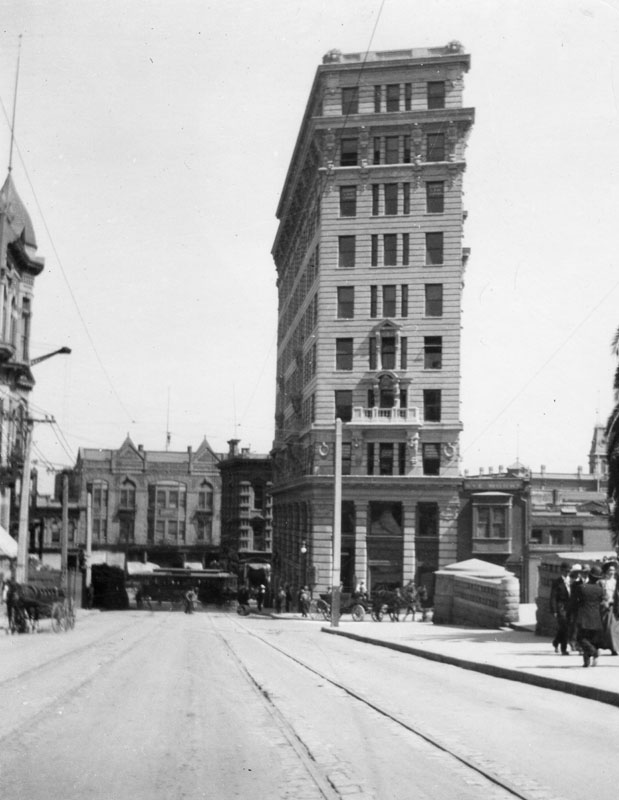 |
|
| (ca. 1907)* - View of the International Bank Building at the corner of Spring Street and Temple Street. The Los Angeles County Courthouse is seen on the right, with the Temple Block in the background. |
Historical Notes The International Savings and Exchange Bank Building was completed in 1907 in what was then the heart of Los Angeles’s financial district. The ten story structure was designed in the Renaissance Revival and Italianate styles and quickly became a prominent landmark along Spring Street. Designed by architect H. Alban Reaves, the building reflected the city’s rapid growth and ambition at the turn of the century. Its location near Temple Square placed it among banks, courts, and government offices that defined early downtown Los Angeles. |
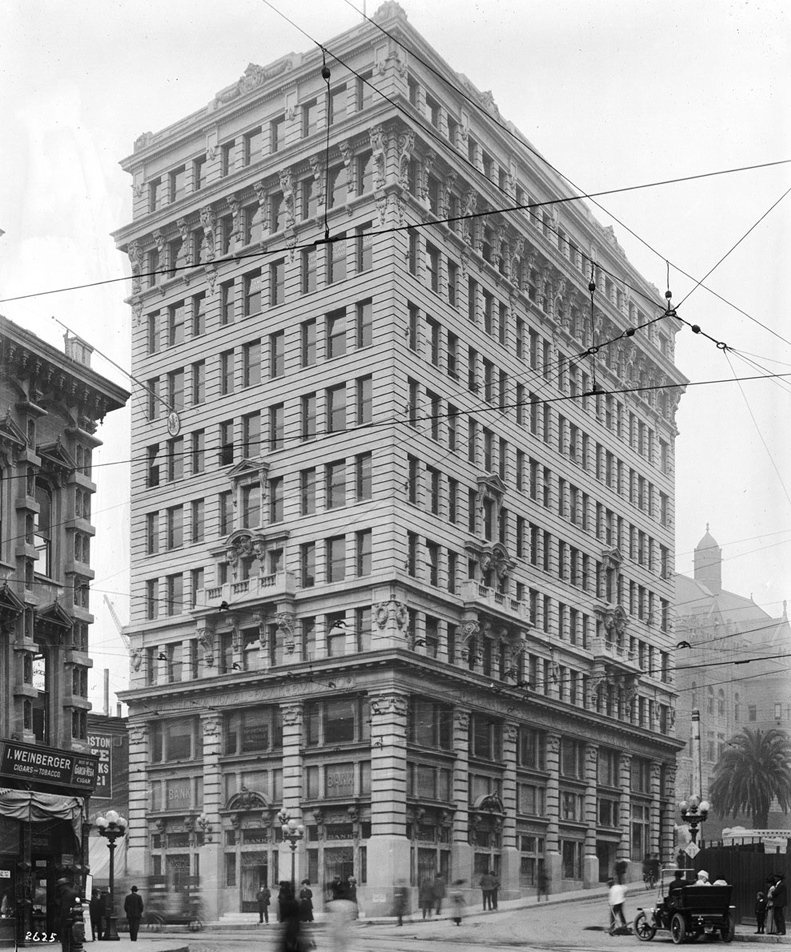 |
|
| (1910)* - The International Bank Building on the southwest corner of Spring and Temple streets. The Los Angeles County Courthouse appears in the background on the right, with the Temple Block on the left. |
Historical Notes By 1910, the International Bank Building had become a familiar feature of the downtown skyline. Its height and ornate exterior made it stand out among nearby commercial and civic buildings clustered around Temple Square. This area served as a major crossroads where business, transportation, and government activity converged. The steady flow of pedestrians, streetcars, and early automobiles reflected the city’s fast-paced development during this period. |
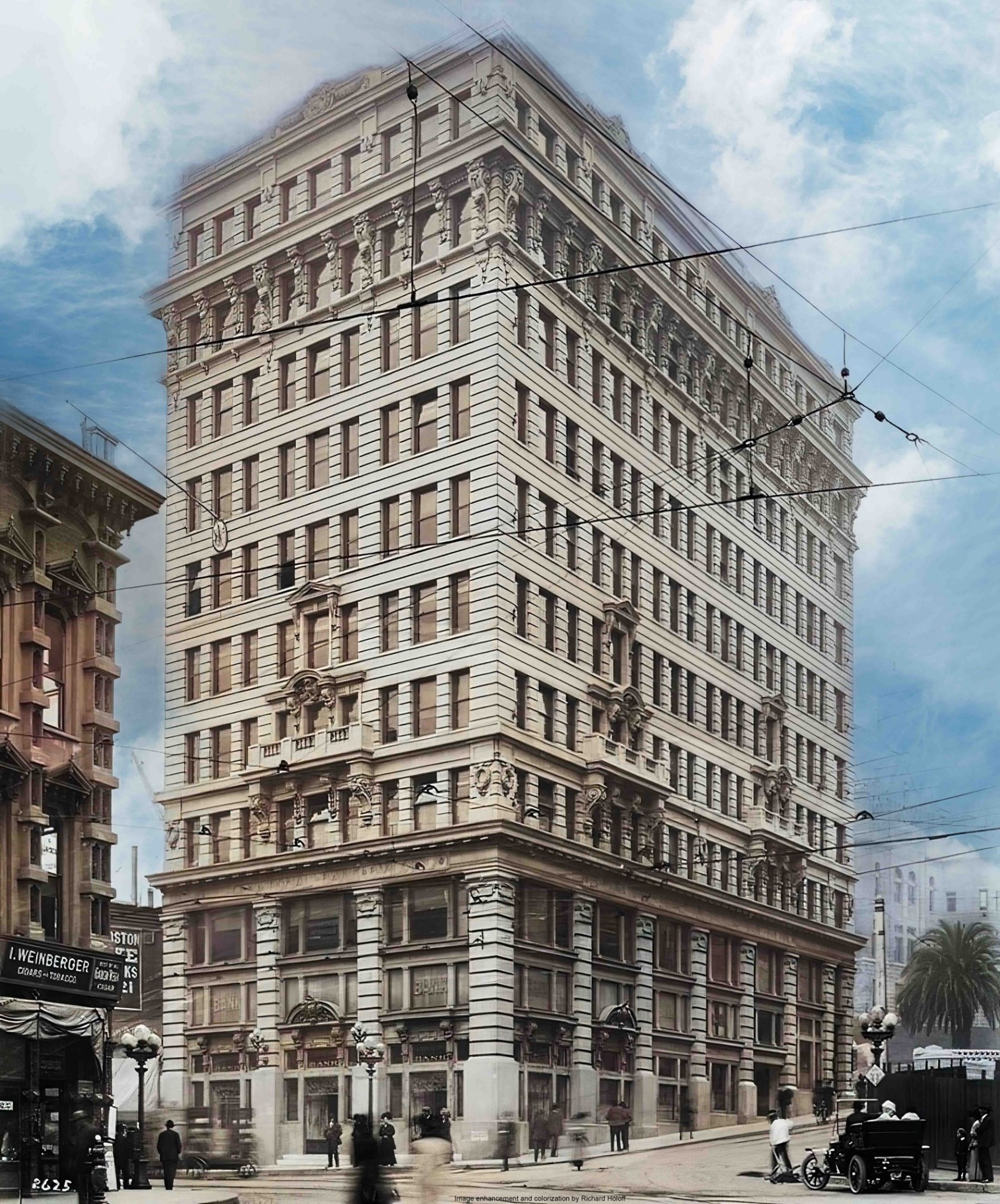 |
|
| (1910)* - The International Bank Building at Spring and Temple streets. The Los Angeles County Courthouse is visible on the right. Image enhancement and colorization by Richard Holoff. |
Historical Notes This enhanced view highlights the building’s architectural detailing, including its strong vertical lines and decorative stonework. The design emphasized both stability and elegance, qualities expected of major financial institutions at the time. Although colorized, the image remains consistent with the building’s original appearance and massing. It offers a clearer sense of scale and materials that were sometimes lost in early black and white photography. |
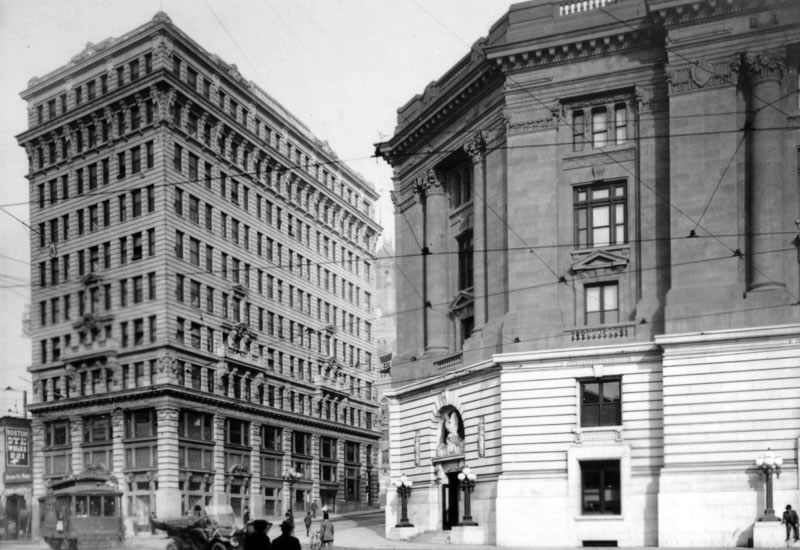 |
|
| (ca. 1910)* - Temple Street at the junction of Spring and Main Streets. The International Bank Building stands at left across from the Federal Building and Post Office. An early automobile and a streetcar are visible. |
Historical Notes The intersection of Spring, Main, and Temple streets was known as Temple Square and functioned as the commercial center of Los Angeles. Offices overlooking this triangle were highly sought after by bankers, lawyers, and other professionals. The presence of streetcars and early automobiles shows how transportation shaped downtown life. This busy junction connected the financial district with civic buildings and nearby neighborhoods. |
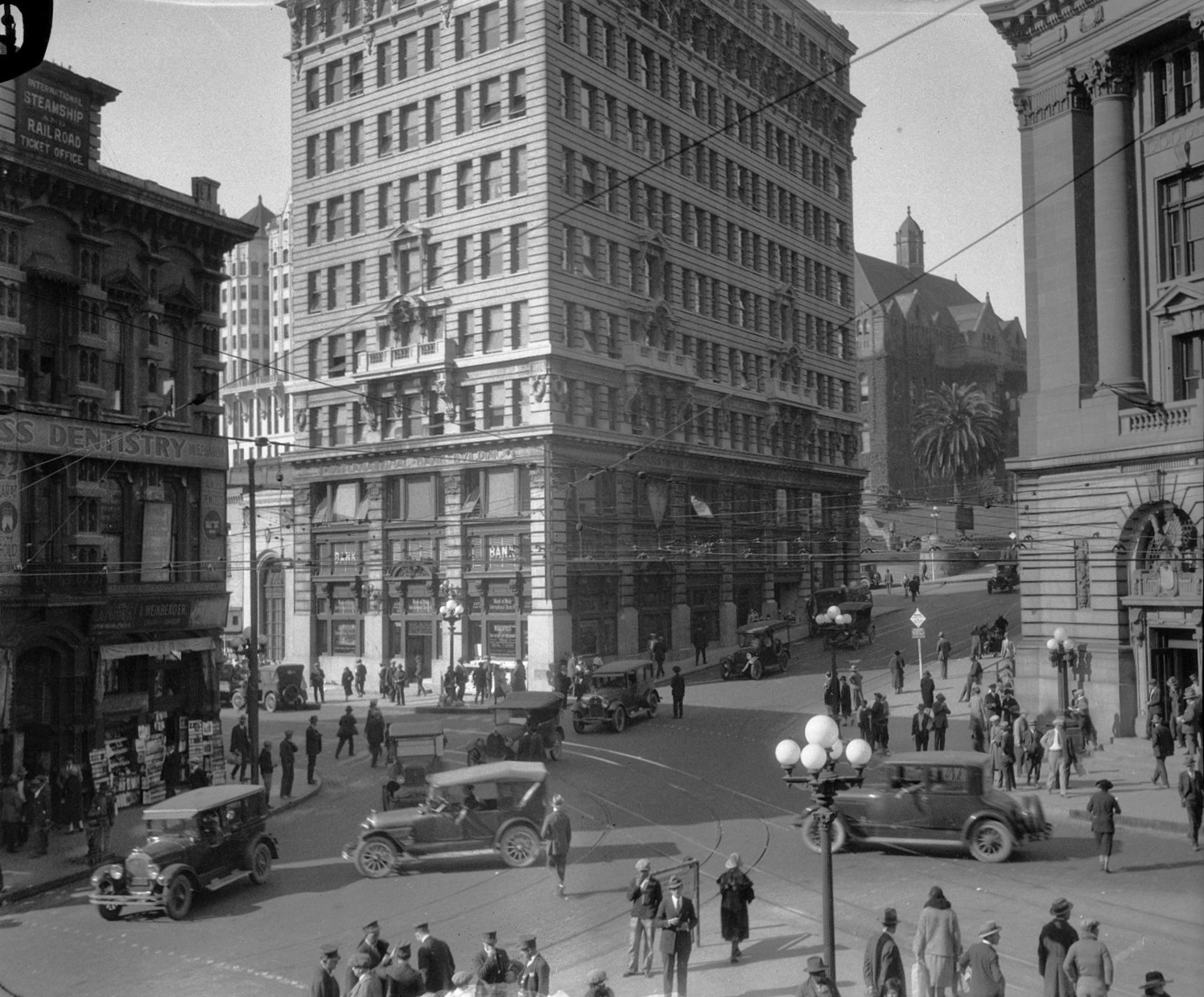 |
|
| (ca. 1924)* - The Temple Block area with the International Bank Building at center. Ornate five lamp streetlights line the streets. |
Historical Notes By the 1920s, Temple Square was surrounded by some of the city’s most important buildings. The International Bank Building stood among the Temple Block, the County Courthouse, and the Federal Post Office, forming a dense civic and commercial core. None of the buildings shown in this image survive today. The photograph captures a streetscape that would soon be transformed by large scale civic redevelopment. |
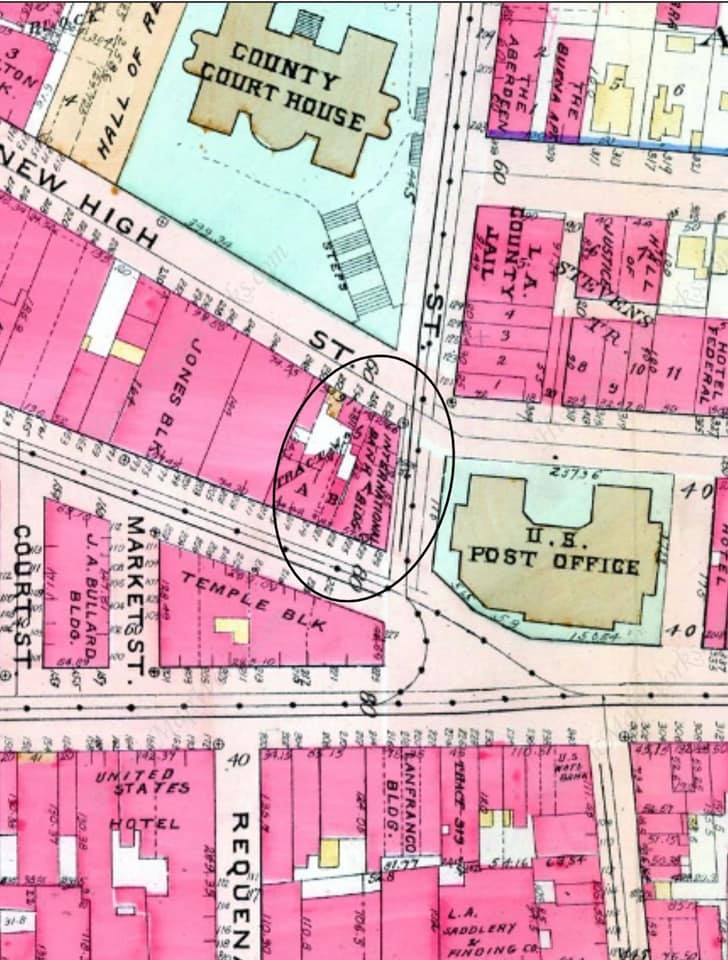 |
|
| (1920s)* - Map of the Temple Square area highlighting the International Bank Building. Courtesy of Mary Rice Schuyler. |
Historical Notes This map illustrates how the International Bank Building fit within the tightly packed street grid of early downtown Los Angeles. Temple Square served as a focal point where business and government activities overlapped. The map also shows how close the building stood to major institutions, reinforcing its importance during the height of Spring Street’s role as the city’s financial center. |
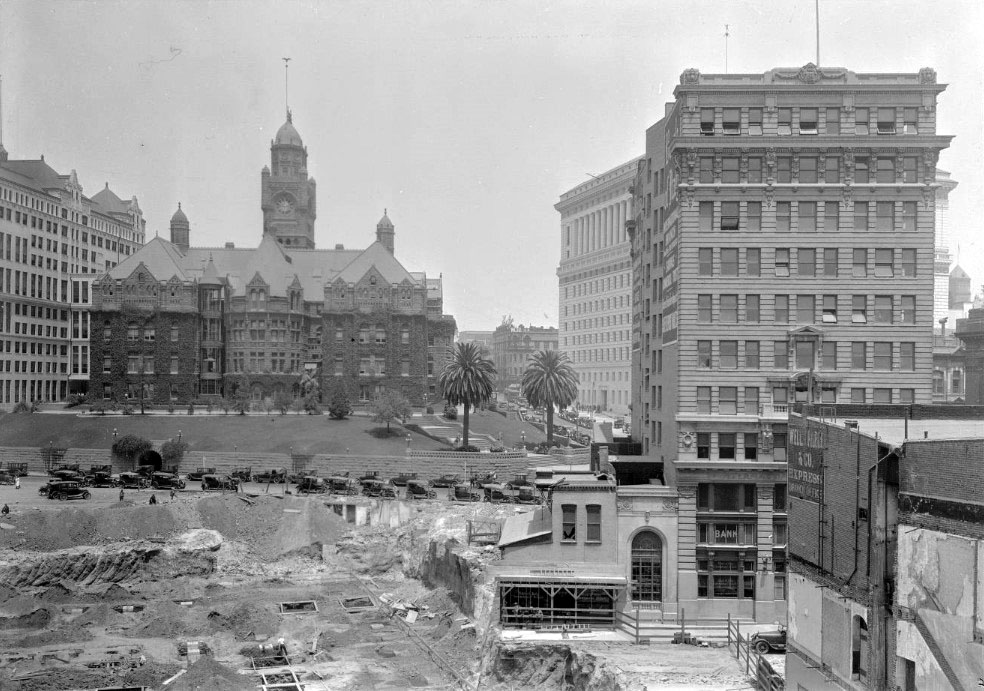 |
|
| (ca. 1926)* - View looking west showing the International Bank Building beside the construction site of the new Los Angeles City Hall. The Hall of Records, County Courthouse, and Hall of Justice appear in the background. |
Historical Notes As construction of the new City Hall began, the International Bank Building found itself surrounded by massive civic projects. These changes signaled a shift in downtown priorities from commerce to government administration. Although still in use, the building was beginning to lose its visual dominance as taller and more modern structures reshaped the skyline. |
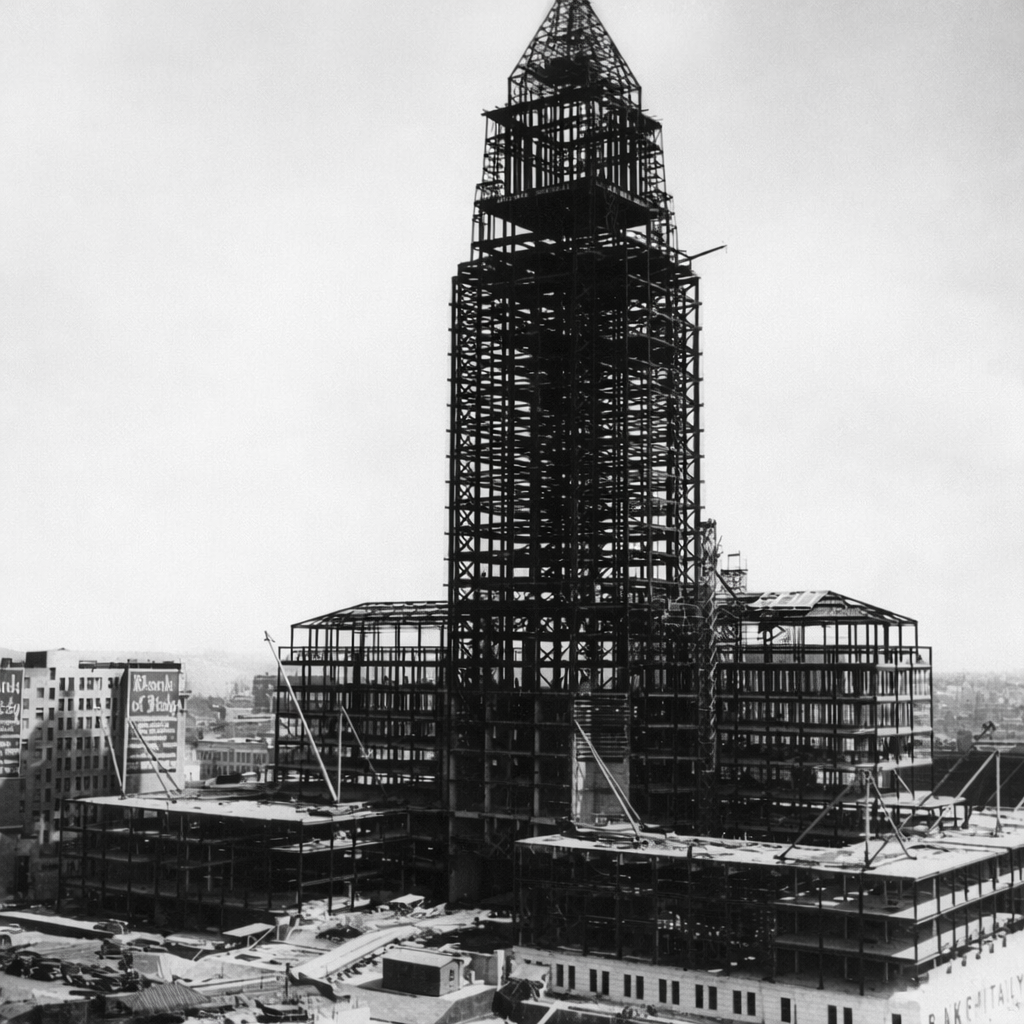 |
|
| (1927)* - View looking northeast showing Los Angeles City Hall under construction. The International Bank Building stands to the south. A sign on the building reads Bank of Italy. |
Historical Notes By the late 1920s, the building housed the Bank of Italy, which would later become Bank of America. Its proximity to the rising City Hall highlighted the dramatic contrast between early twentieth century commercial architecture and newer civic monuments. The growing scale of government buildings reduced the building’s prominence and foreshadowed its eventual removal. |
 |
|
| (1929)* - The International Bank Building beside the completed Los Angeles City Hall. |
Historical Notes When City Hall was completed in 1928, it towered over the International Bank Building, making the older structure appear small by comparison. Calls for modernization and redevelopment of the civic center soon followed. Although still standing, the building was increasingly viewed as outdated within the rapidly changing downtown landscape. |
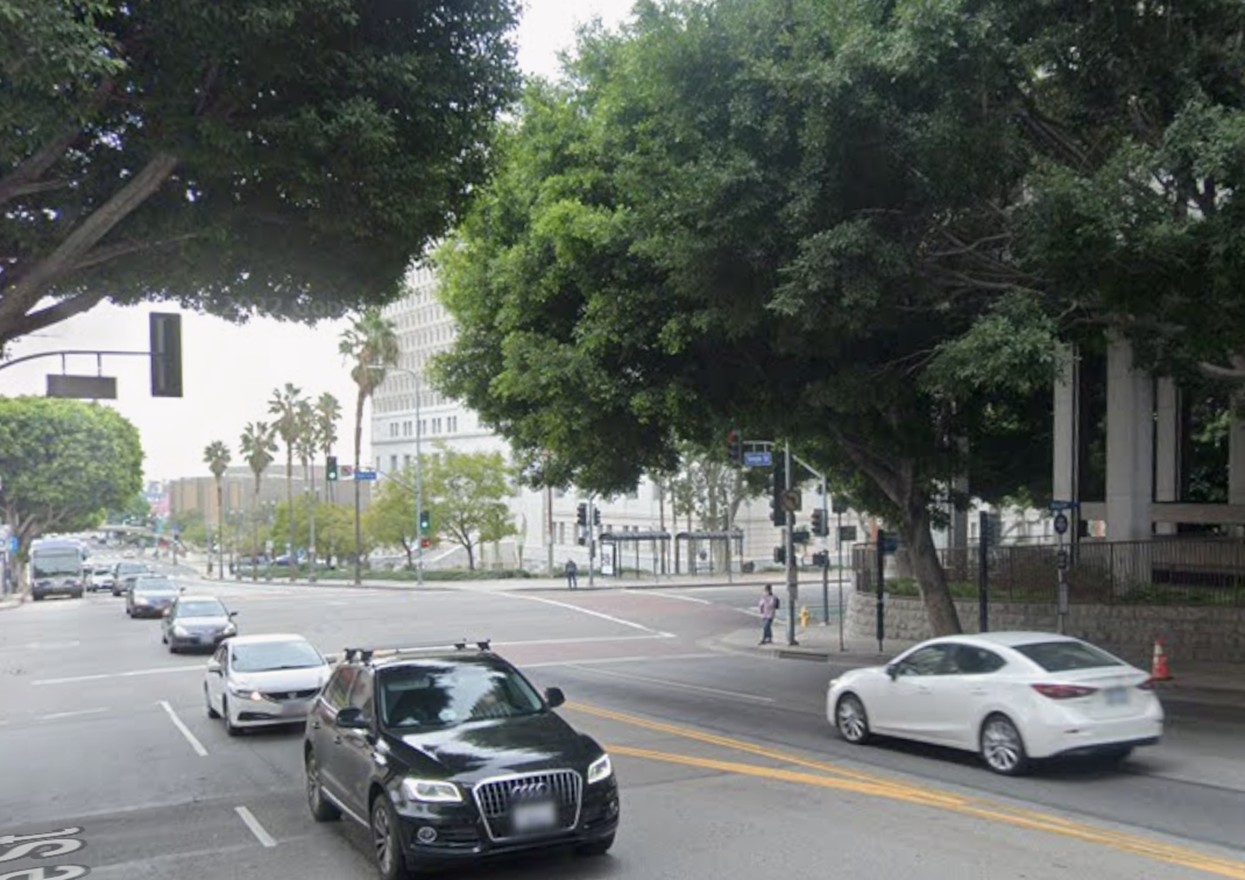 |
|
| (2021)* – Looking east on Temple Street at Spring Street. This view closely matches the scene shown in the 1929 photograph above. |
Historical Notes In the 1929 image, the International Bank Building stands prominently at left beside the recently completed Los Angeles City Hall. By 2021, that entire streetscape had been transformed, with the bank building long gone following its demolition in 1954. The modern view reflects decades of civic redevelopment that replaced dense early commercial buildings with government complexes, open space, and widened roadways. Mature trees, modern traffic patterns, and set-back structures mark a very different chapter in the history of downtown Los Angeles. |
Then and Now
 |
|
| (1929 vs 2021)* – Then and now view looking east on Temple Street at Spring Street. The International Bank Building once stood at left; today, the view opens to the Civic Center and a side entrance to Los Angeles City Hall. Photo comparison by Jack Feldman. |
Historical Notes This then and now comparison shows how dramatically the Temple and Spring streets area has changed over time. In 1929, the International Bank Building stood prominently along Temple Street, just before it was overshadowed by the newly completed Los Angeles City Hall. By 2021, the bank building was long gone, having been demolished in 1954 as part of Civic Center redevelopment. What was once a dense mix of commercial and civic buildings is now a more open streetscape focused on government offices, reflecting the city’s continued growth and changing priorities. |
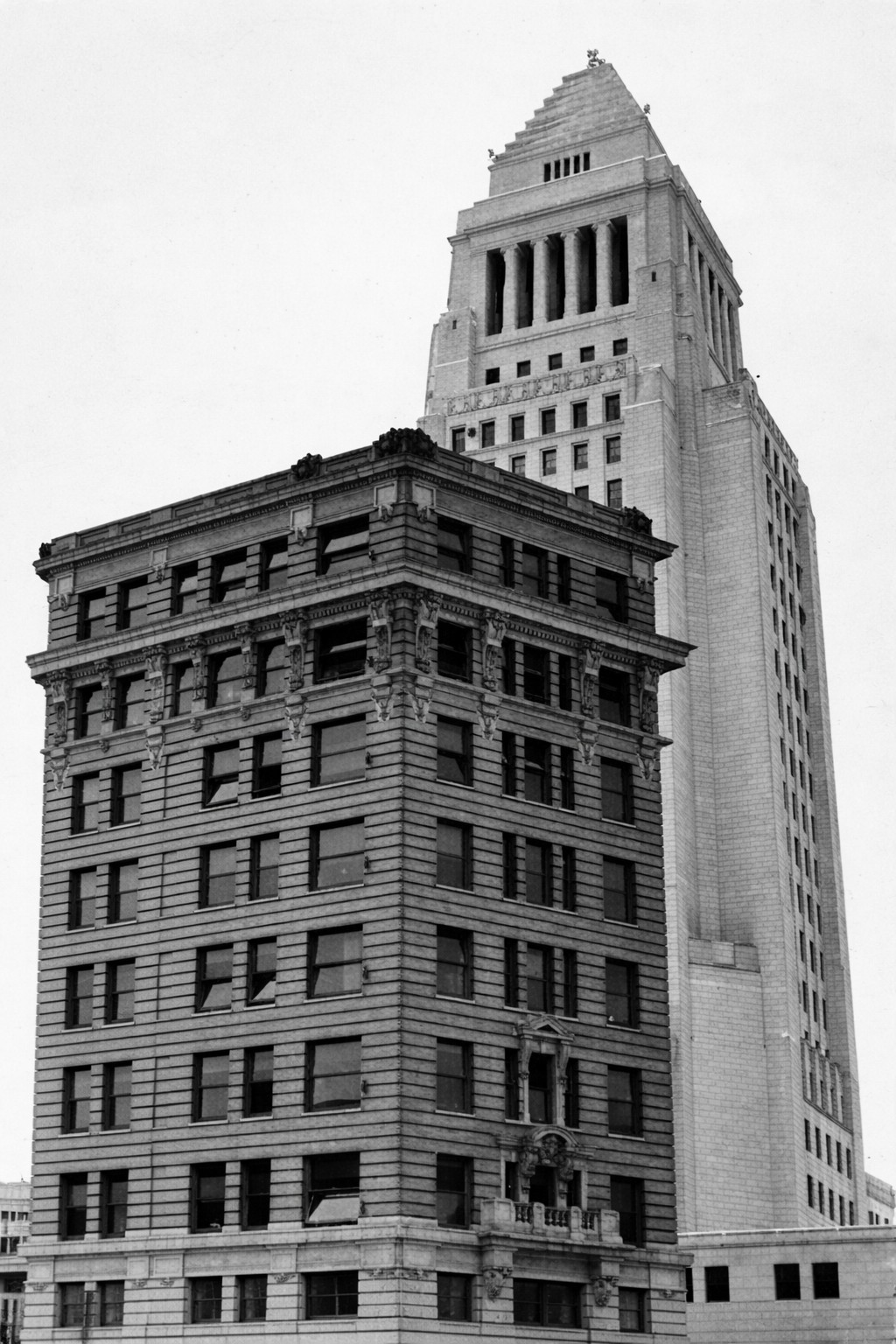 |
|
| (1934)* – The International Bank Building standing in front of Los Angeles City Hall. |
Historical Notes By 1934, the International Bank Building had lost much of its earlier prominence as a financial landmark. The completed Los Angeles City Hall, rising behind it, now dominated the skyline and reshaped the Civic Center area. At this point, the building was no longer used primarily for banking and had begun serving various municipal functions. Its smaller scale and older design stood in sharp contrast to the monumental civic architecture that defined downtown Los Angeles during the 1930s. |
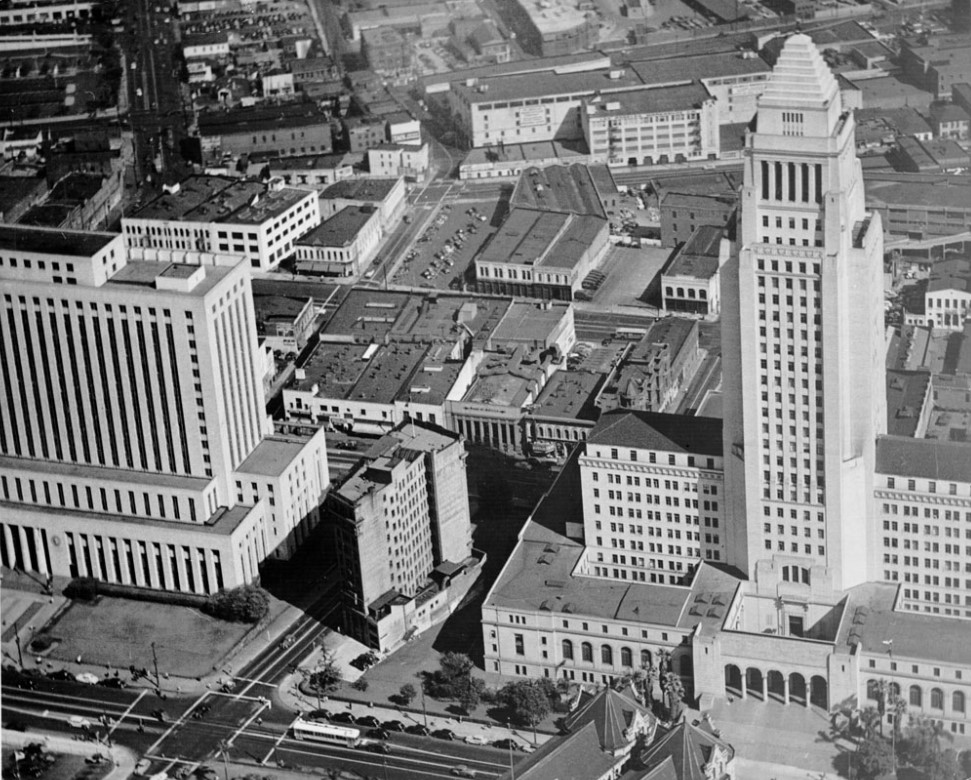 |
|
| (1947)^ - Aerial view showing the International Bank Building between City Hall and the Federal Courthouse and U.S. Post Office Building. |
Historical Notes By the mid 1940s, the International Bank Building was tightly surrounded by large government buildings. It had been repurposed for city use and was commonly known as the Old City Health Building. Its cramped position reflected the pressures of civic expansion in downtown Los Angeles. |
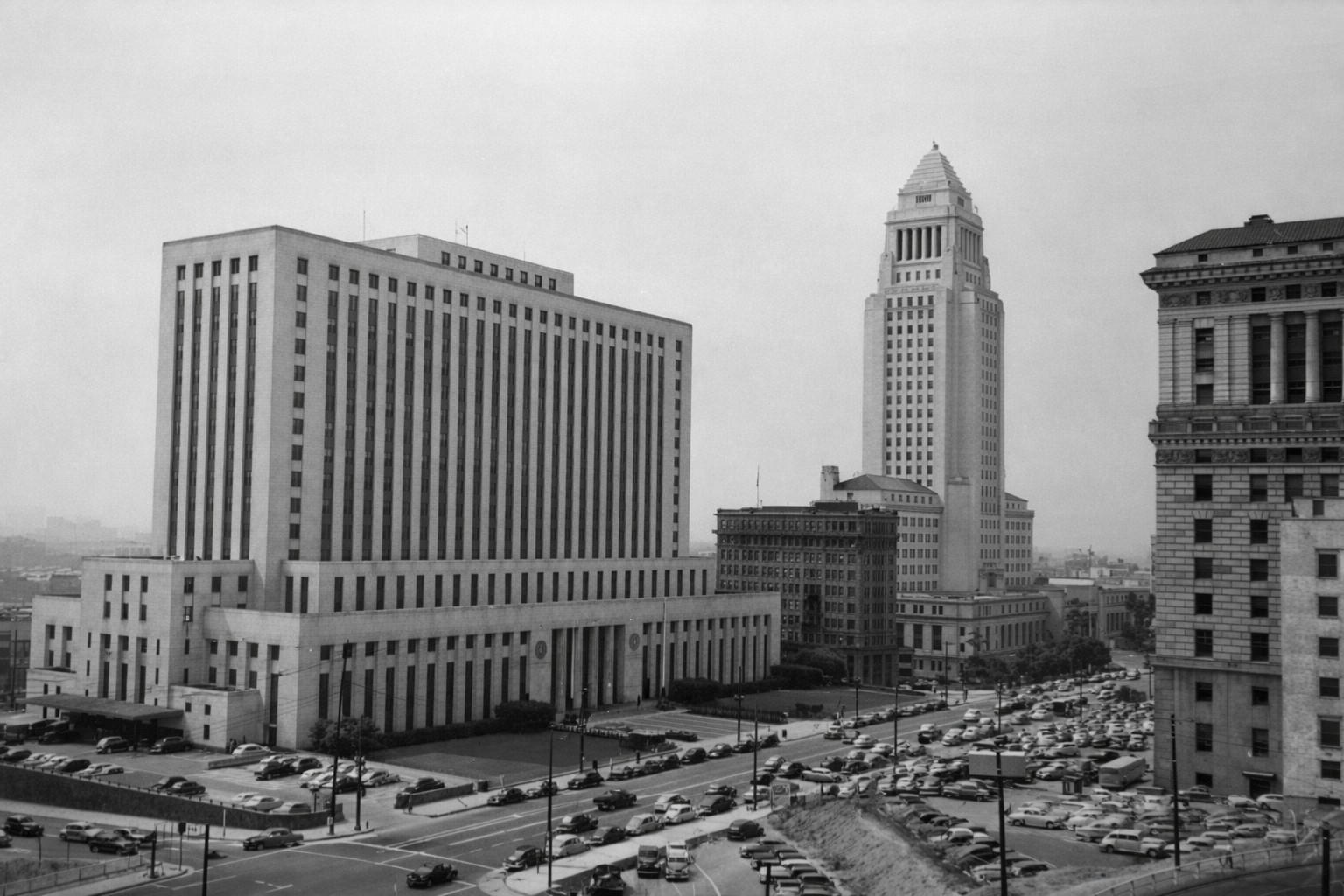 |
|
| (1949)* - View of the Civic Center showing the International Bank Building dwarfed by City Hall and the Federal Courthouse and Post Office Building. The Hall of Justice is visible on the right. |
Historical Notes This image shows how completely the building had been overshadowed by newer construction. Once a landmark, it now appeared as a leftover from an earlier era. Urban renewal plans increasingly favored open space and larger civic structures, leaving little room for older commercial buildings. |
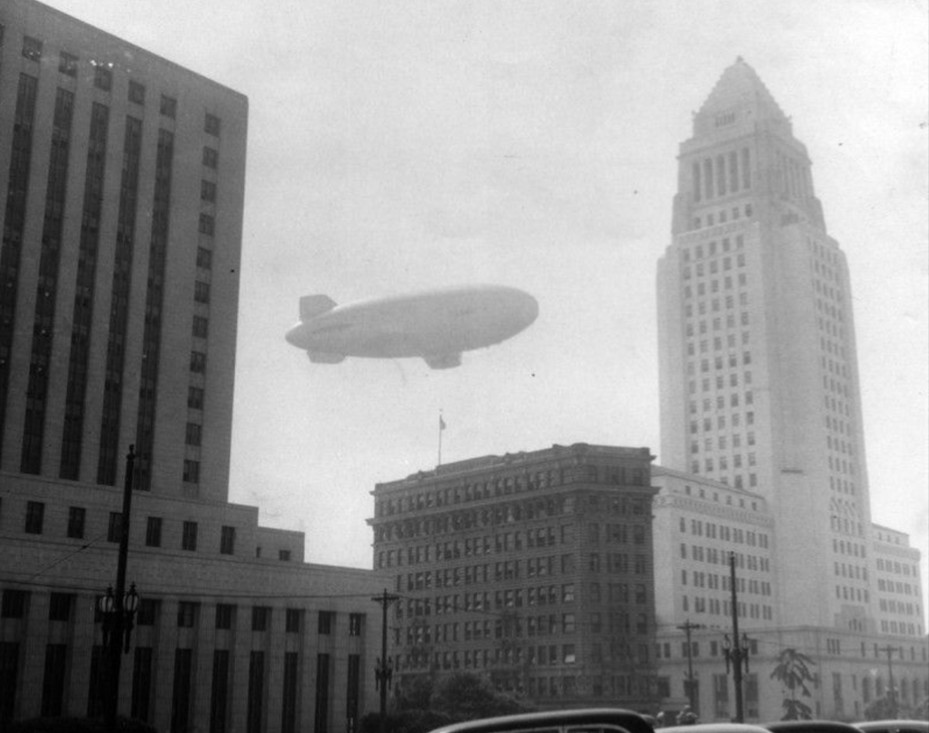 |
|
| (1954)* - Closer view of the International Bank Building between City Hall and the Federal Courthouse and U.S. Post Office Building. A Goodyear Blimp flies overhead in the hazy skyline. |
Historical Notes In 1954, the International Bank Building was demolished, ending nearly fifty years of service. Its removal was part of a broader effort to reshape the Civic Center. Today, the site forms part of the expanded City Hall complex. The building’s disappearance reflects the constant reinvention of downtown Los Angeles. |
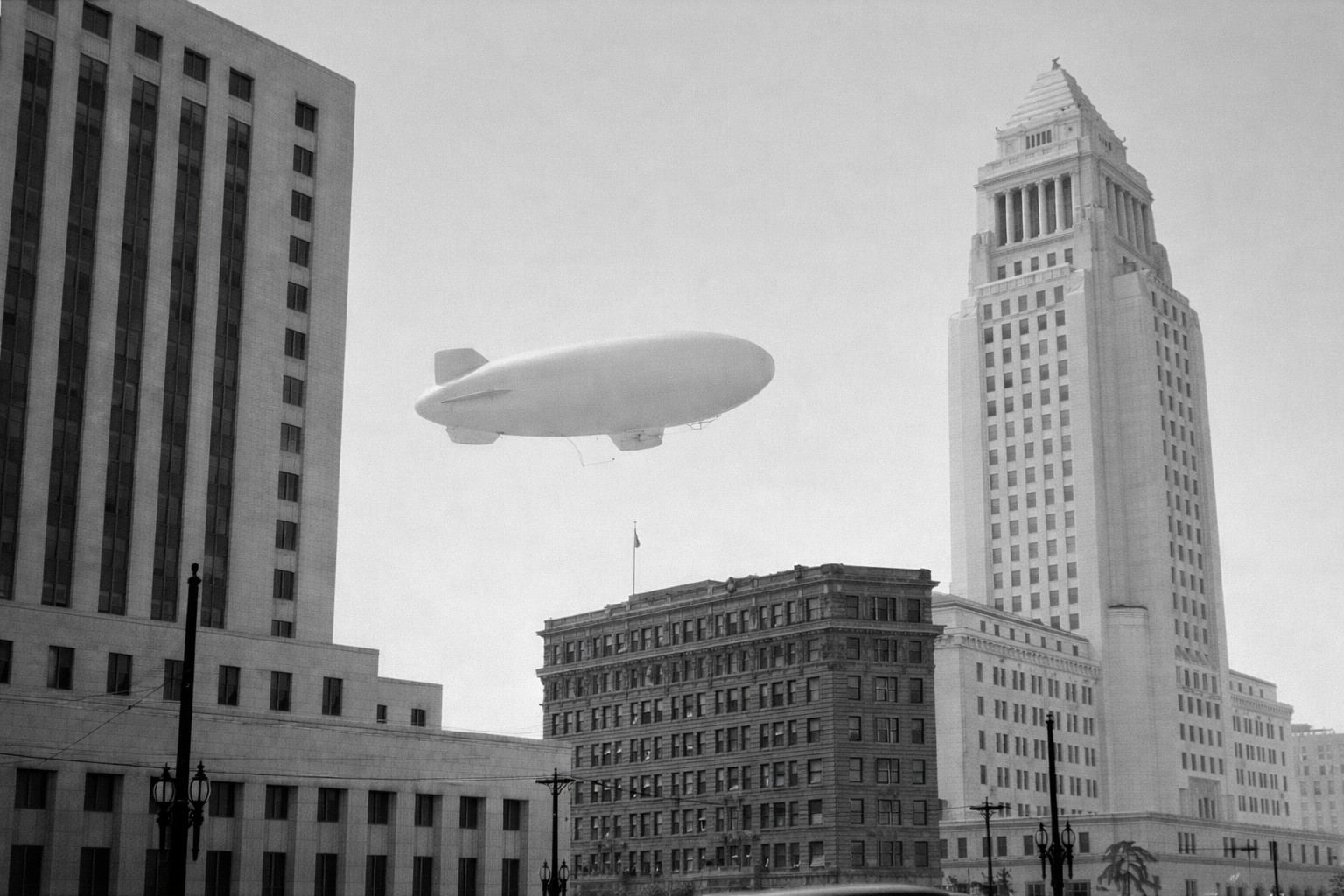 |
|
| (1954)* - Enhanced view of the International Bank Building between City Hall and the Federal Courthouse and U.S. Post Office Building. |
Historical Notes This enhanced image provides a clearer view of the International Bank Building shortly before its demolition. The original photograph was taken on a heavily smog-filled day, a common condition in Los Angeles during the mid twentieth century. Smog was a serious and growing problem in the city by the 1940s and 1950s, caused largely by automobile emissions and industrial activity. While the building itself soon disappeared, the image also serves as a reminder of environmental challenges that shaped daily life in Los Angeles during this period and would later lead to major air quality reforms. |
* * * * * |
Stimson Building
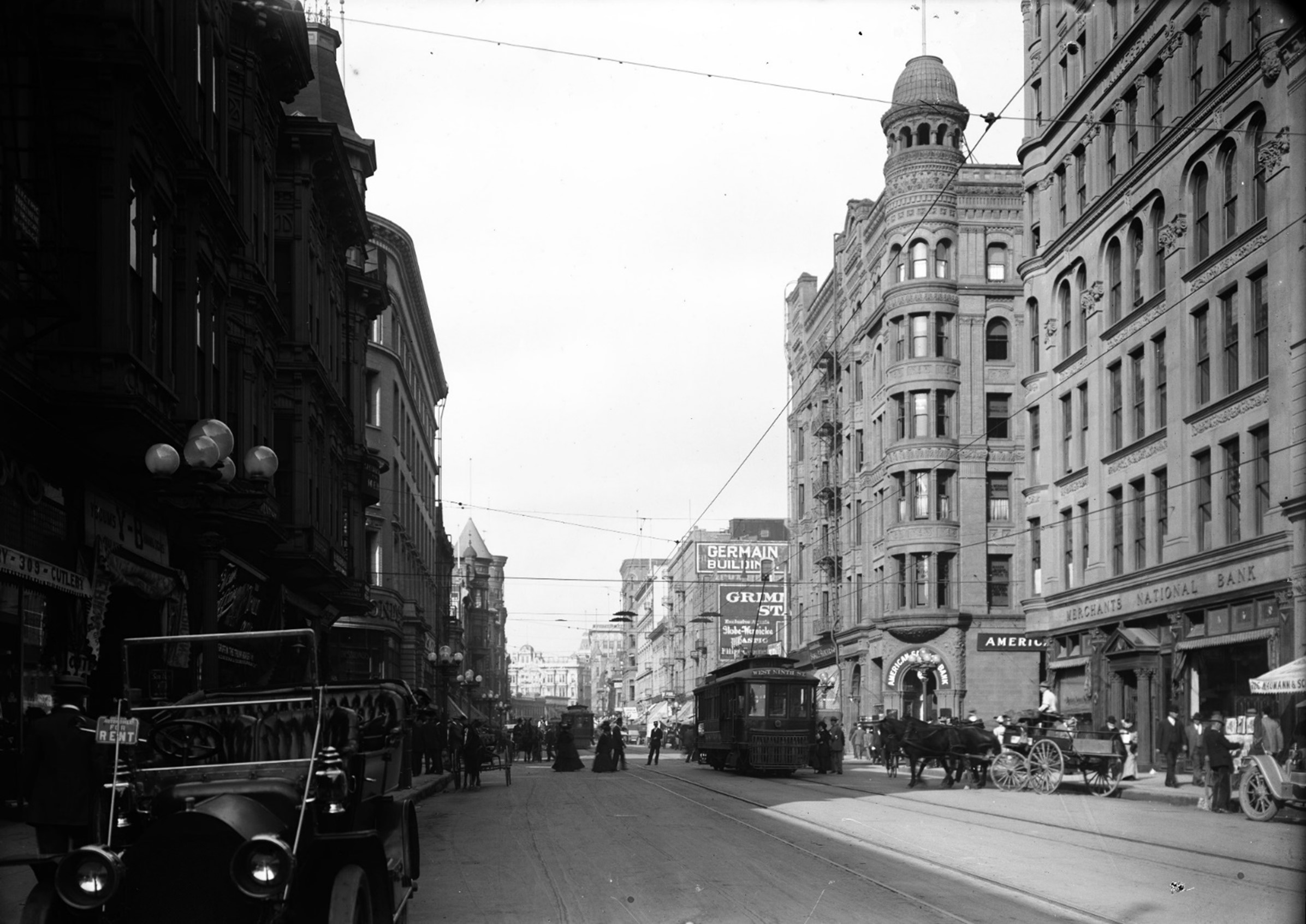 |
|
| (ca. 1907)* - Looking north on Spring Street toward Third Street. The Stimson Building stands on the northeast corner. |
Historical Notes The Stimson Building was completed in 1893 and quickly became one of the most recognizable structures in early downtown Los Angeles. Designed in the Richardsonian Romanesque style, the six story stone building featured heavy masonry, arched windows, projecting bays, and a distinctive observation tower. Located at the busy intersection of Spring and Third streets, the building stood near the southern edge of the Spring Street Financial District. This area was rapidly developing into the city’s commercial core during the late nineteenth and early twentieth centuries. |
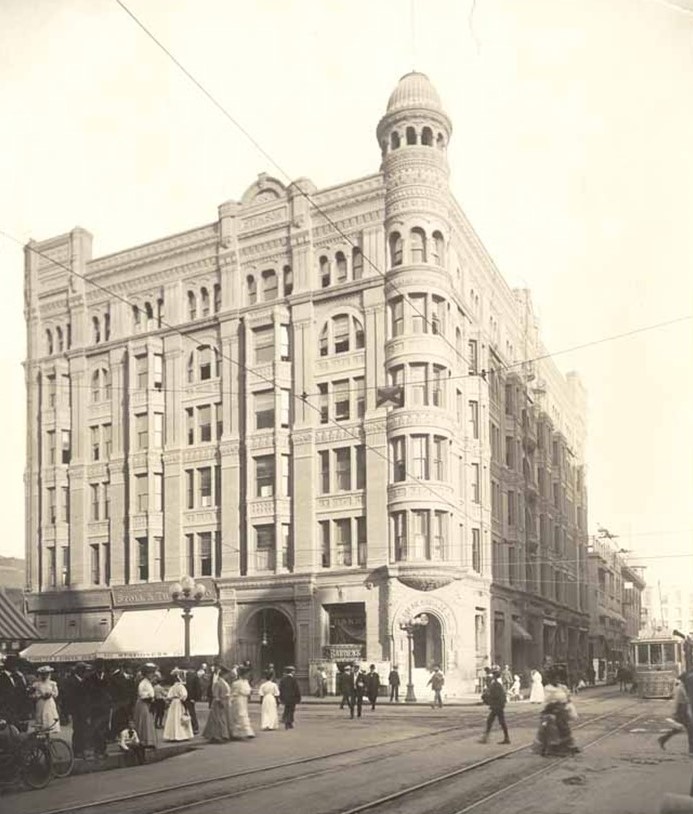 |
|
| (ca. 1908)*- Looking east on Third Street at Spring Street showing the Stimson Building on the northeast corner at 256 South Spring Street. |
Historical Notes The building was commissioned by Thomas D. Stimson, a prominent lumber magnate who had relocated to Los Angeles from Michigan. Architect Carroll H. Brown designed the structure in 1893, and it was considered one of the city’s earliest high rise office buildings. Originally constructed at a cost of about one hundred fifty thousand dollars, the Stimson Building reflected both wealth and confidence in Los Angeles’s future. Its commanding presence made it a visual anchor at one of downtown’s busiest intersections. |
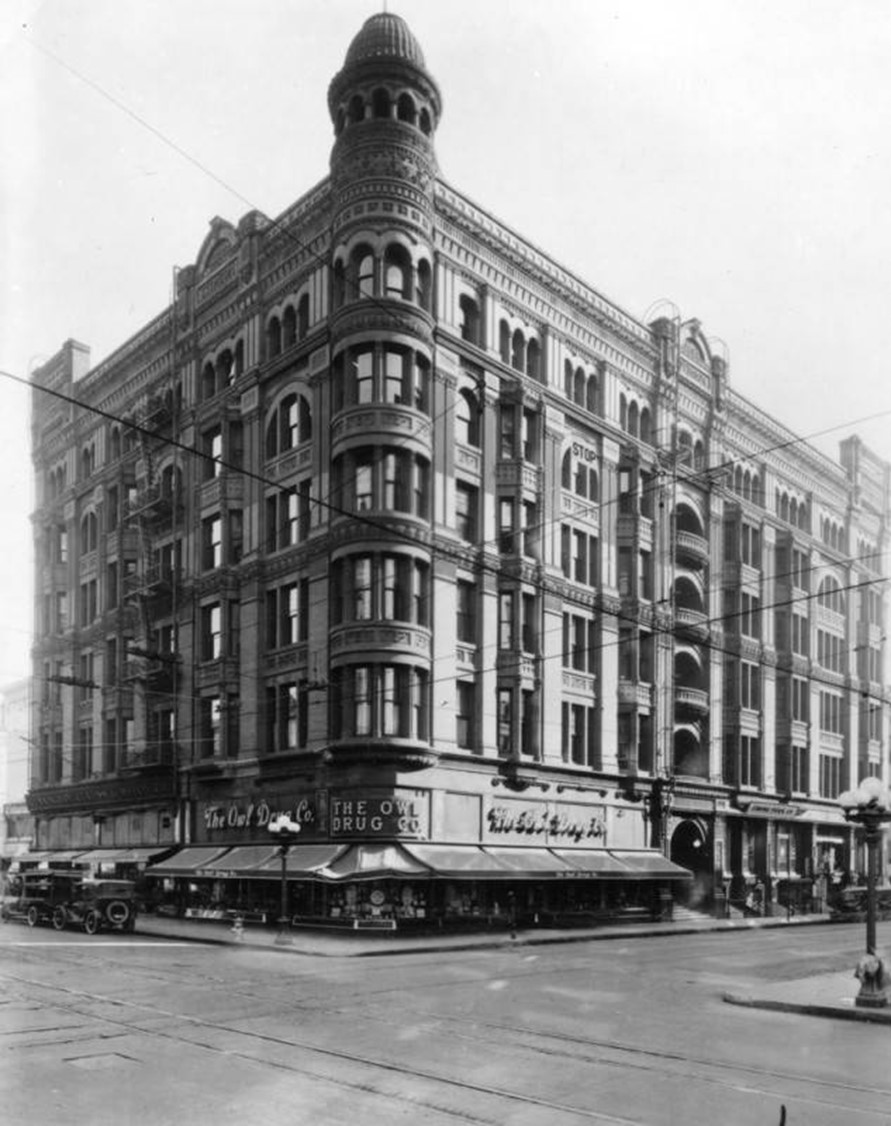 |
|
| (1920)* - The Stimson Building on the northeast corner of Third and Spring streets with Owl Drug Company occupying the ground floor. |
Historical Notes By the 1920s, the Stimson Building had transitioned fully into commercial use, housing offices above street level retail. National chains such as Owl Drug Company occupied prominent corner storefronts during this period. Spring Street had become a destination for banking, shopping, and entertainment. Streetcars, automobiles, and pedestrians passed continuously through this intersection, making it one of the most active locations in the city. |
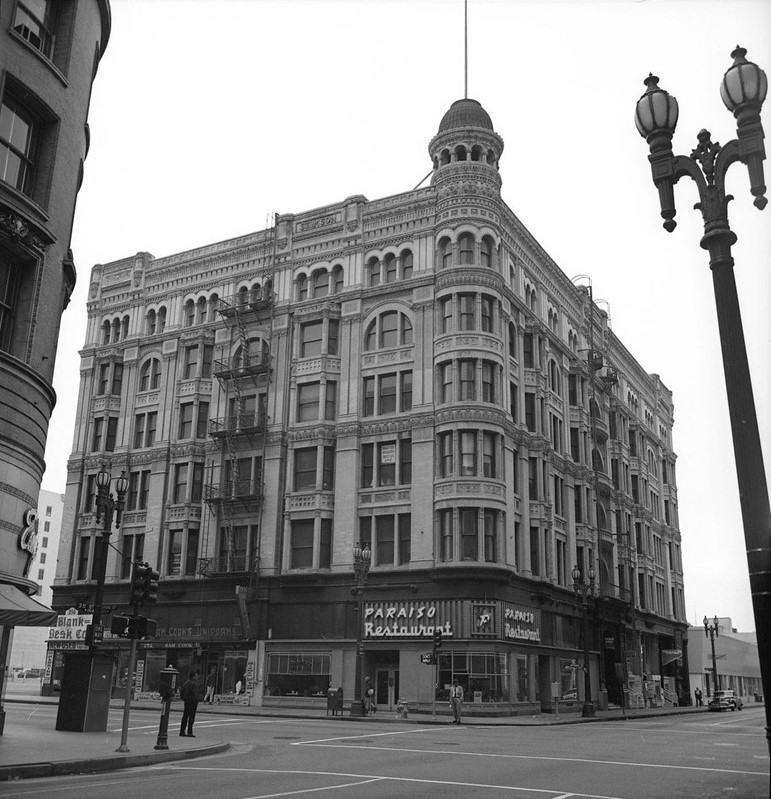 |
|
| (1950)* - View of the Stimson Building at the northeast corner of Third and Spring streets. Paraiso Restaurant occupies the ground floor. |
Historical Notes In the postwar years, the Stimson Building remained in use but was increasingly seen as outdated. Newer buildings nearby reflected modern architectural styles and changing expectations for office space. Restaurants and small businesses on the ground floor helped keep the building active, even as downtown Los Angeles began to experience shifting economic patterns and early signs of decline. |
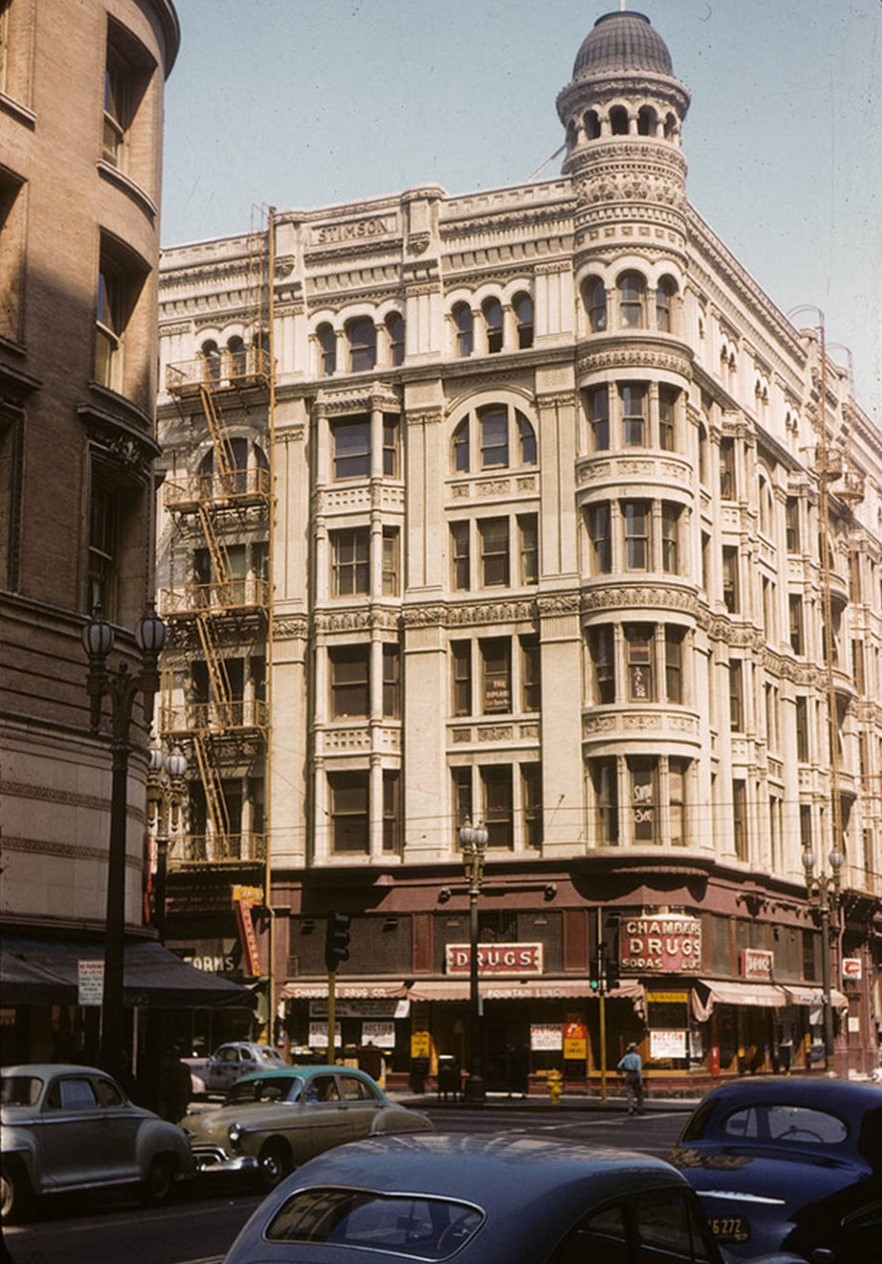 |
|
| (1955)* - The Stimson Building at 256 South Spring Street. |
Historical Notes By the mid 1950s, the Stimson Building stood as a reminder of an earlier era of downtown development. Its heavy stone construction contrasted sharply with newer steel and glass buildings rising elsewhere in the city. Despite its architectural significance, preservation was not a priority at the time. Plans for redevelopment increasingly favored demolition over reuse. |
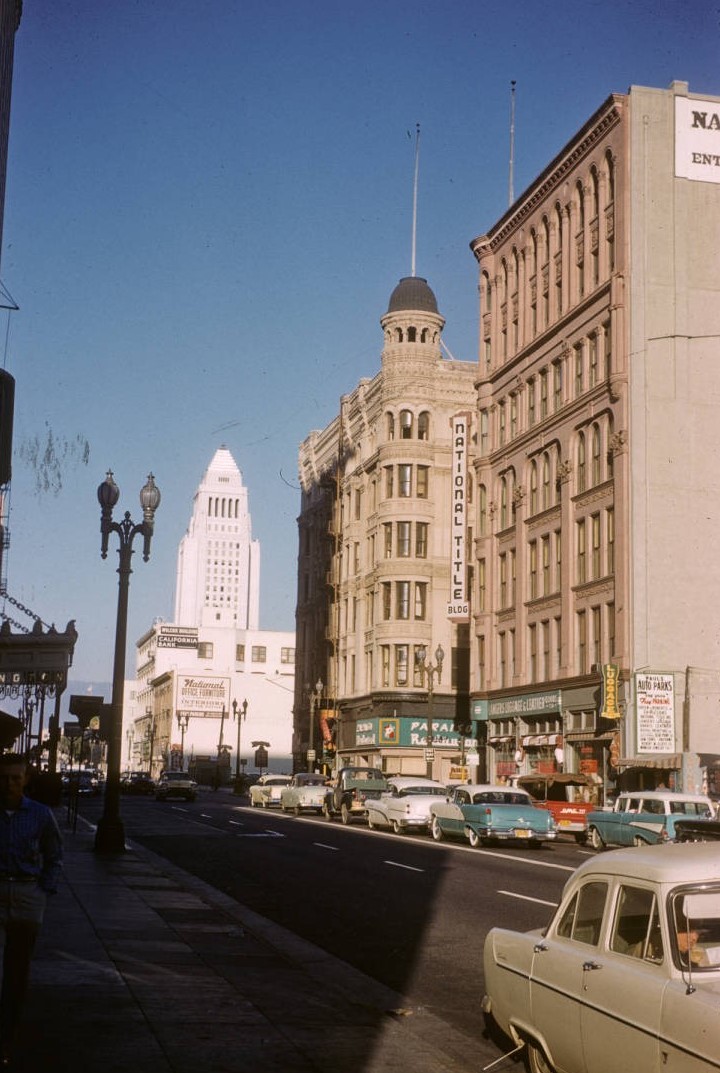 |
|
| (1959)* - Looking north on Spring Street showing the Stimson Building on the northeast corner of Third Street. The National Title Building stands across the street on the southeast corner. |
Historical Notes This view captures the Stimson Building shortly before its demolition. Although still structurally sound, it was surrounded by newer commercial buildings that reflected mid twentieth century design trends. The intersection of Spring and Third streets remained busy, but the character of downtown was changing. Older landmarks were increasingly seen as obstacles to modernization. |
Then and Now
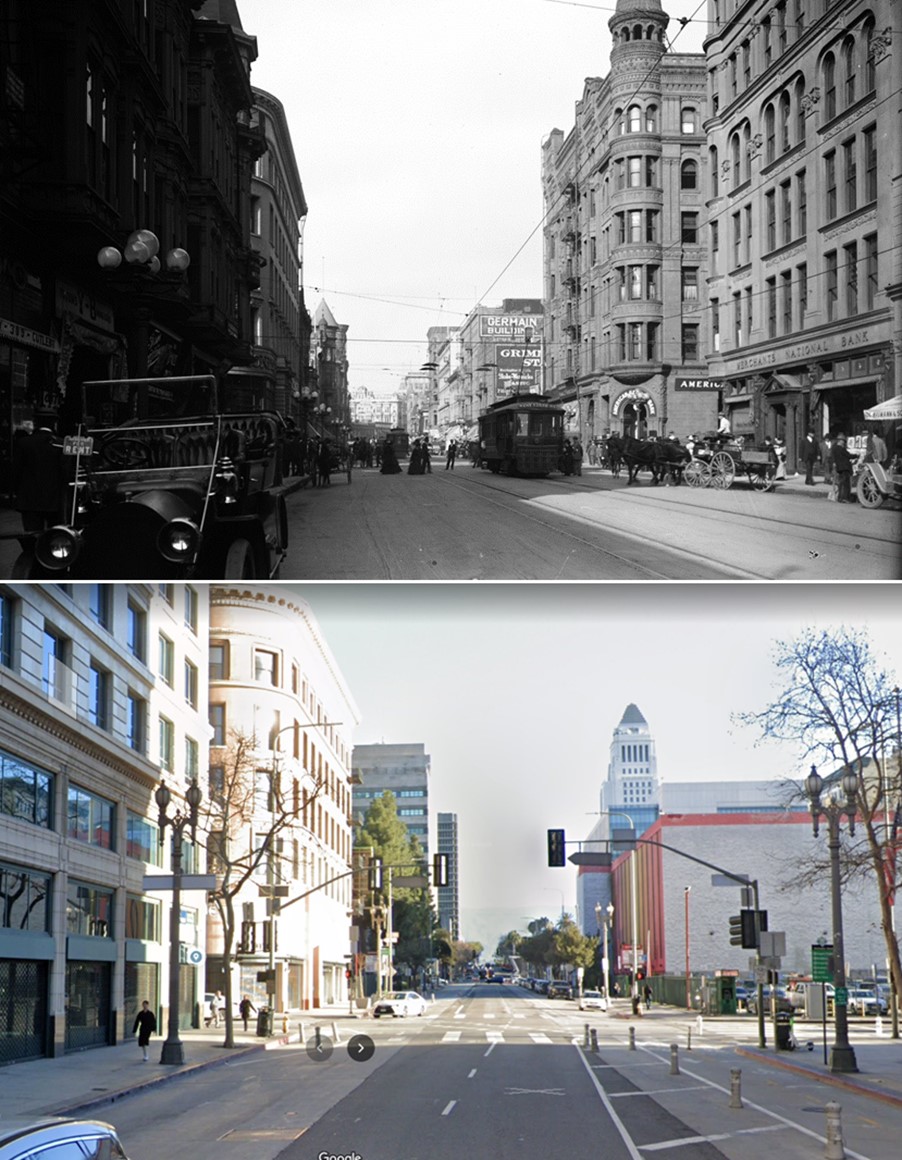 |
|
| (1907 vs 2023)* - Looking north on Spring Street toward Third Street. Photo comparison by Jack Feldman. |
Historical Notes For roughly seventy year, the Stimson Building occupied the northeast corner of Spring and Third streets, serving as a landmark during Los Angeles’s rise as a major city. Completed in 1893, it witnessed the transition from streetcars and horse drawn vehicles to automobiles and modern traffic. The building was demolished in 1963 and replaced by a parking lot. Its absence reflects a period when historic structures were routinely removed in favor of redevelopment, leaving few physical traces of early downtown Los Angeles at this intersection. |
* * * * * |
Hall of Records
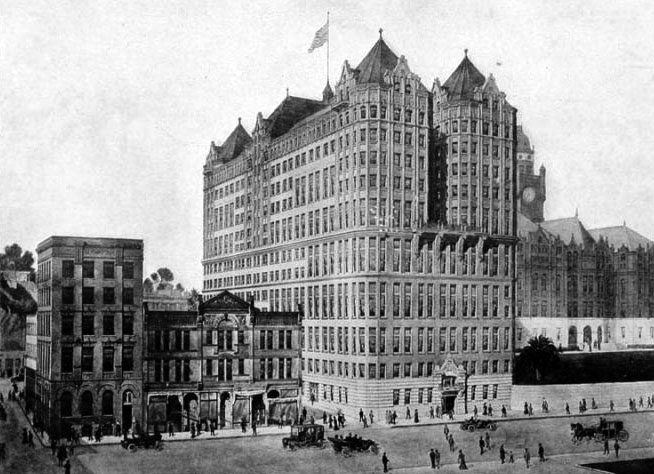 |
|
| (1910)*#^# - Postcard view of the Hall of Records Building. The LA County Courthouse Building is seen to the right. |
Historical Notes Built between 1909 and 1912 to relieve overcrowding next door in the county’s red-sandstone courthouse, the Hall of Records consolidated most county offices under one lavishly ornamented roof—a showy headpiece that featured finials, pyramidal gables, and copper ribbing. Architects Frank Hudson and William Munsell divided its upper floors into two pairs of wings, which joined at a central elevator shaft, and clad the walls in brick and terra cotta above a granite base.* |
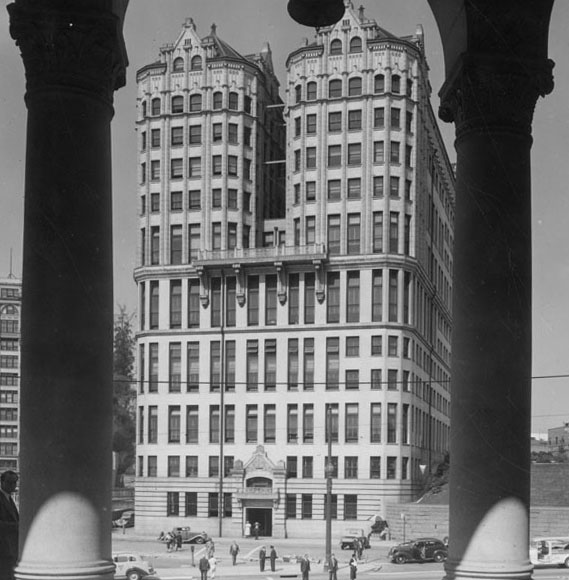 |
||
| (ca. 1935)* - The Hall of Records as framed by the arches of City Hall across Spring Street. |
Historical Notes Los Angeles County's 12-story Hall of Records Building was utilitzed by the County of Los Angeles from 1911 until 1976. Designed by the Los Angeles tandem of Hudson and Munsell, Architects, the skyscraper government building cost approximately $1.5 million to erect. |
Click HERE to see more Early Views of the Hall of Records |
New Hotel Broadway
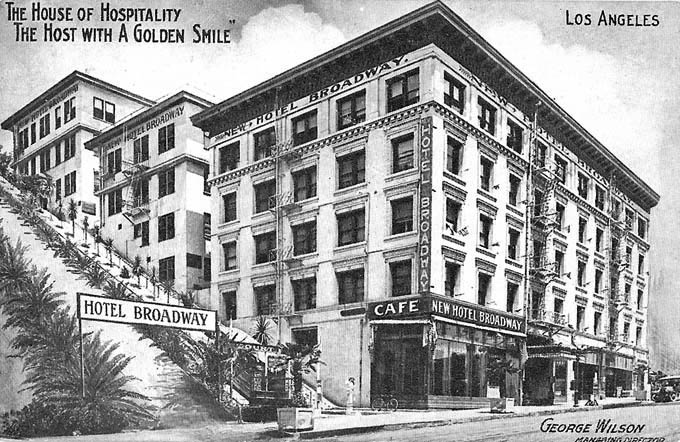 |
|
| (1916)^*## - Postcard view of the New Hotel Broadway adjacent to Court Flight. Card reads: "The House of Hospitality, The Host with A Golden Smile" - George Wilson, Managing Director. |
Historical Notes Opened on September 24, 1905, the Court Flight was built by Attorney R. E. Blackburn of the McCarthy real estate firm and Samuel G Vandegrift, to serve the wealthy residents of Bunker Hill. The line was entirely double tracked, using a pair of thirty-inch gauge counterbalanced cars, and ran for a distance of 180 feet up a 42 per cent grade between Broadway and Court Streets, in the middle of the block between Temple and First Streets. A fire on October 20, 1943 damaged the line and put it out of commission.* |
 |
|
| (Early 1900s)* - View of the New Hotel Broadway, located next to the Court Flight Cable Railway, at 205 North Broadway, opposite the Hall of Records and County Courthouse. |
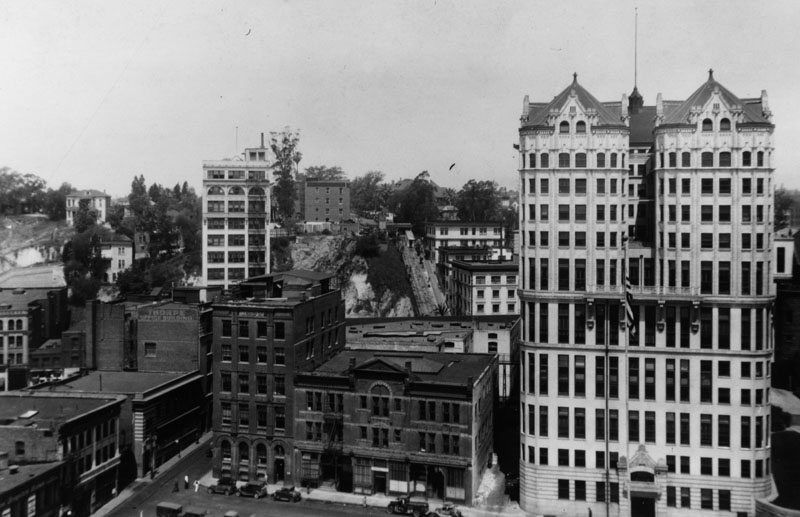 |
|
| (Early 1900s)^ - Looking west from the Hall of Records (right) towards Bunker Hill. The Court Flight funicular is present in the center. There is also a partial view of the Hotel Broadway. |
Westmoore Hotel
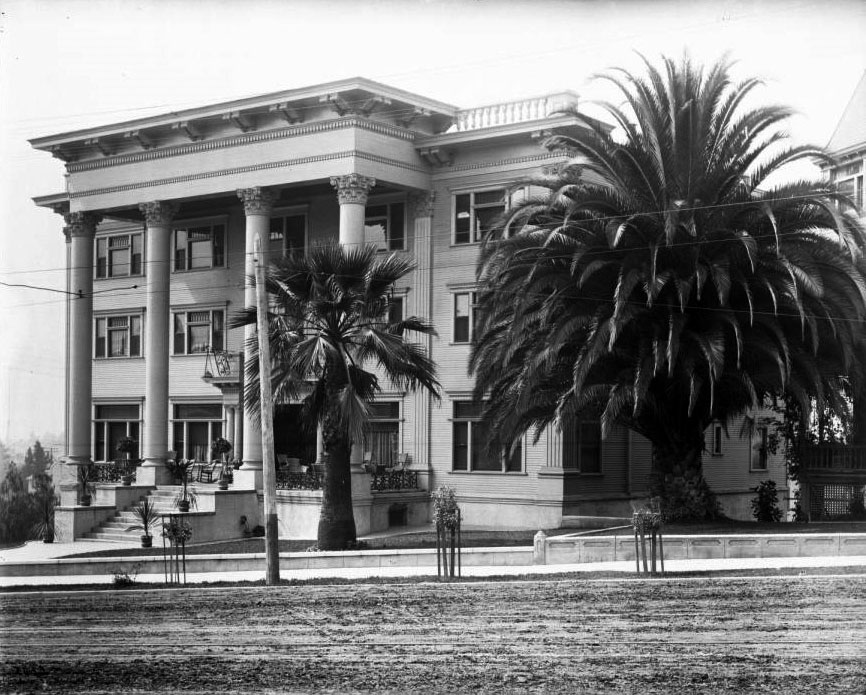 |
|
| (1910)^ - Exterior view of the Westmoore Hotel located at 1000 W. Seventh Street. Tall palm trees flank the grand portico entrance to this three-story Greek revival building. Stairs lead to the front entrance and patio at left, while an unpaved Seventh Street runs in front of the building in the foreground. |
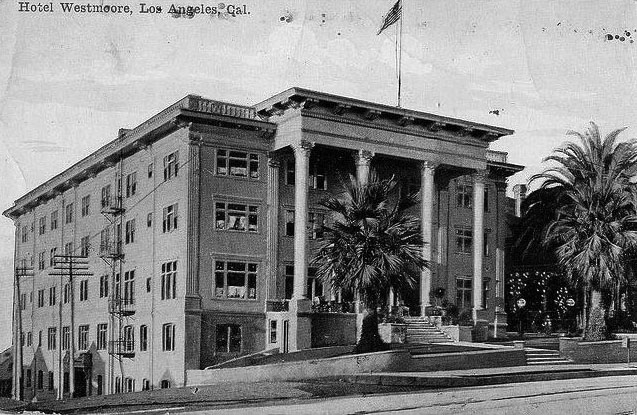 |
|
| (1910)**# - Postcard view of the Westmoore Hotel, located on the southwest corner of Seventh and Francisco streets. |
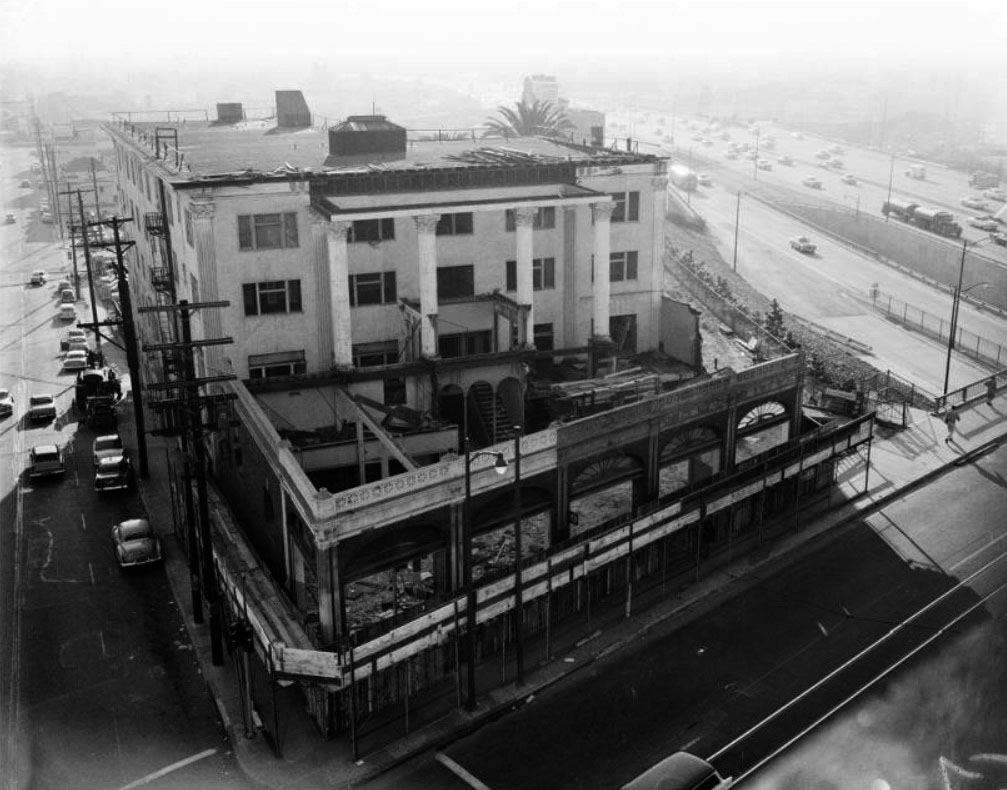 |
|
| (1957)^ - View showing the demolition of the Westmoore Hotel at 1000 W. Seventh Street. Francisco Street is on the left. The Harbor Freeway, built in 1953, is seen on the right. |
Historical Notes It appears that somewhere along the line there was an addition to the Westmoore Hotel with included a new structure between the Greek-style columns of the original building and the front property line at 7th Street. |
Old Shrine Auditorium (Al Malakah Temple)
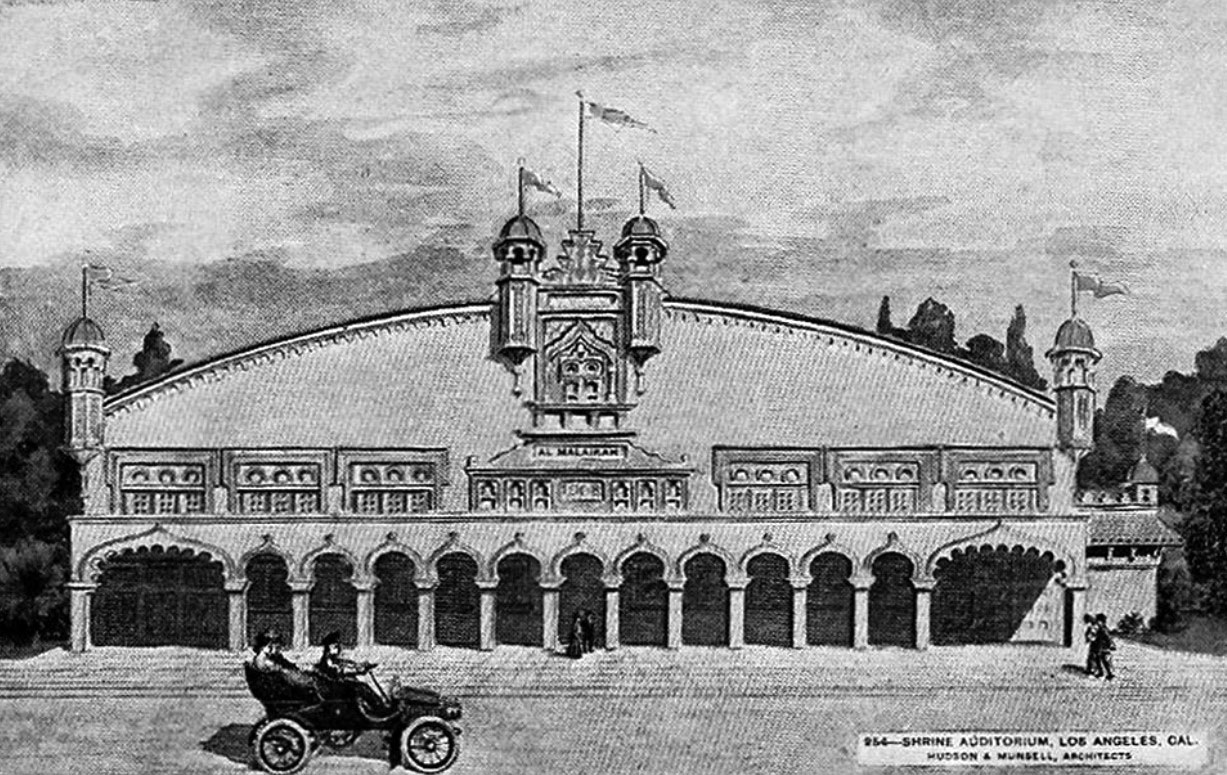 |
|
| (1910)^*^# – Postcard view of the original Shrine Auditorium (Al Malaikah Temple). |
Historical Notes The original Shrine Auditorium was built in 1906 and served as the Shriner's Al Malaikah Temple until it burned in 1920 and was replaced by the current incarnation.* The Shriners, or Ancient Arabic Order of the Nobles of the Mystic Shrine (A.A.O.N.M.S.), were established in the U.S. in 1870 as an appendant body to Freemasonry.^* |
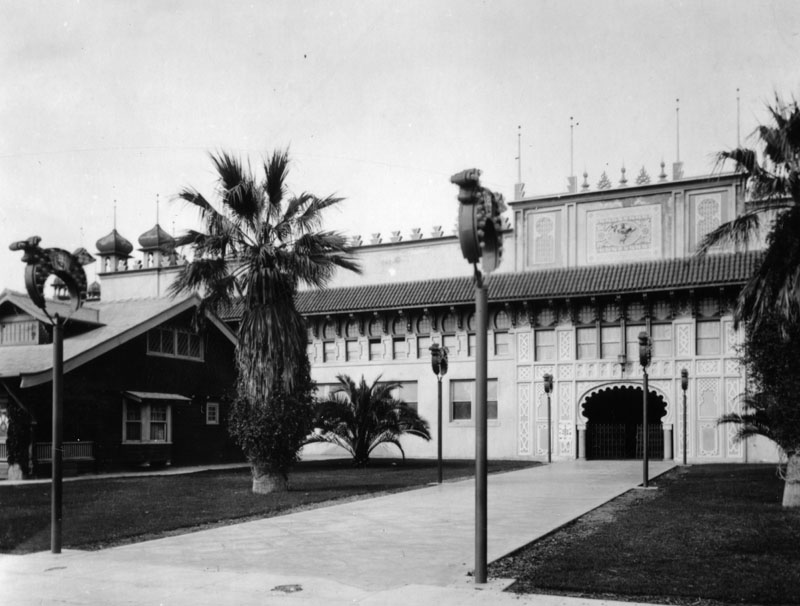 |
|
| (1910)* - Exterior view of the Old Shrine Auditorium on Jefferson Boulevard, built in 1906. |
Historical Notes The Al Malaikah Shriners built the original Shrine Auditorium to serve as a civic center as well as their home base and clubhouse. The building was designed by Frank D. Hudson and William Munsel who also designed the Museum of Science and Industry, the first museum built in the city's Exposition Park.^* |
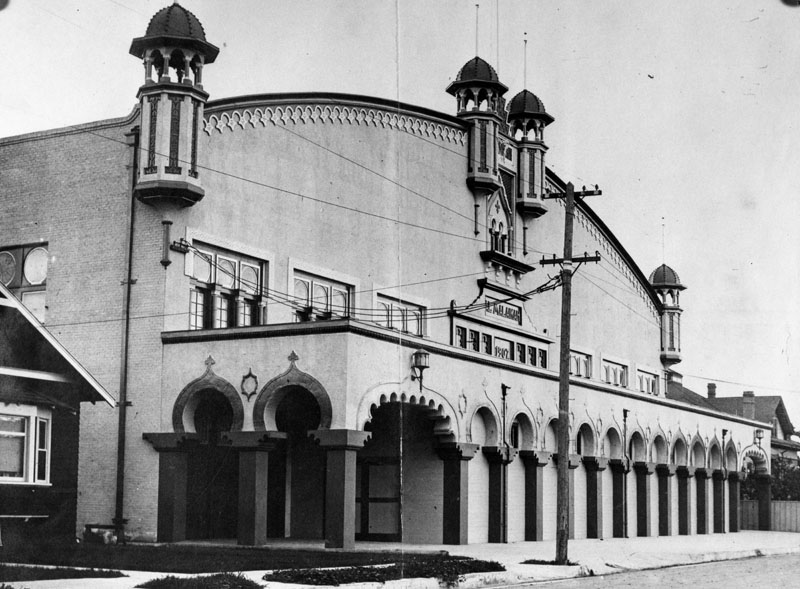 |
|
| (1920)* - Another view of the Old Shrine Auditorium as seen from the corner of Royal and Jefferson. |
Historical Notes In 1920 a fire burnt the building down in just 45 minutes. With plans to add an attached expo hall, The Shriners began rebuilding almost immediately. In January 1926 the new Shrine Auditorium and Expo Hall opened and quickly became the center of entertainment in Los Angeles.^* |
Click HERE to see more on the New Shrine Auditorium built in 1926. |
Early Fire Stations
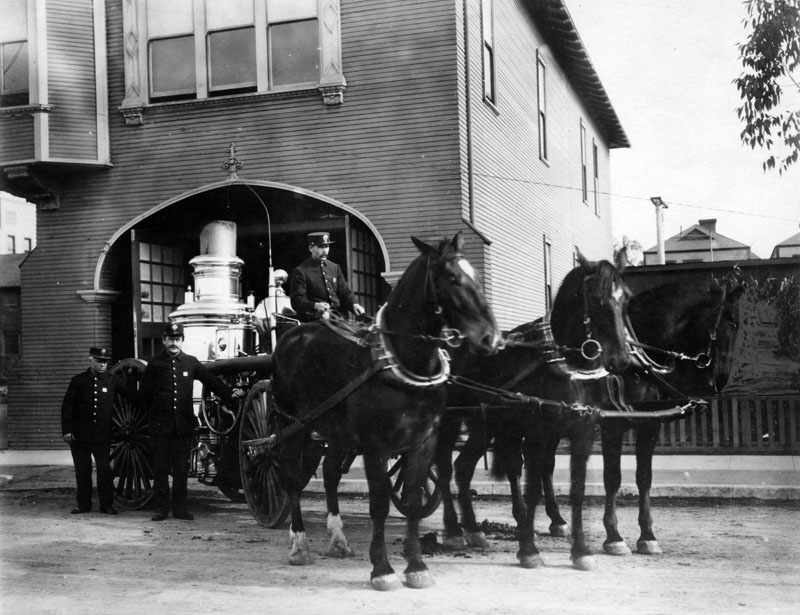 |
|
| (ca. 1910)* - View of a fire fighter maneuvering a horse-drawn fire engine, as two other firemen stand next to it; the station visible in the background is Engine Company No. 9. |
Historical Notes Engine Company No. 9, formed on November 27, 1899 and was located at 916 S. Santee Street until 1960 when It was relocated to 430 E. Seventh Street. It has operated from that location since then. Engine Company No. 23 and Squad #23 moved into the building formerly occupied by No. 9.* |
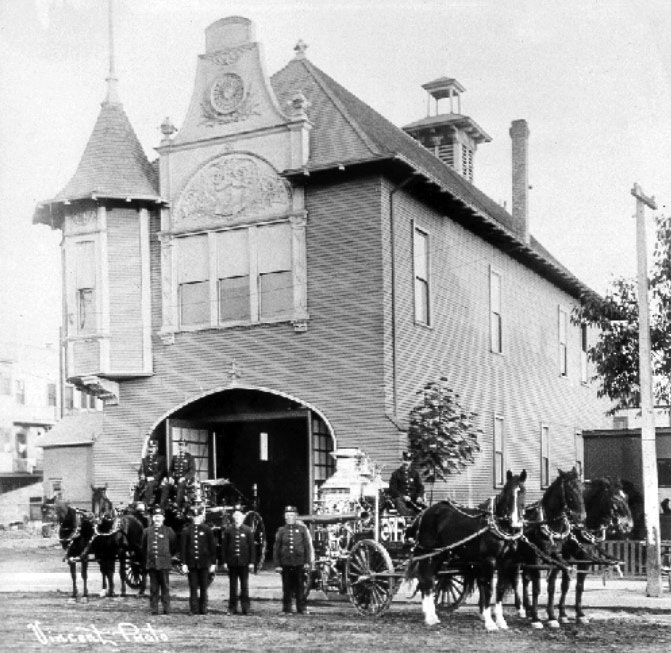 |
|
| (ca. 1910)^##* – View of firemen posing in front of Engine Company No. 9, located at 916 South Santee Street. |
Engine Company No. 23
_B.jpg) |
||
| (ca. 1915)^##* - Group photo of Engine Company 23 and Truck Company 5 located at 225 E. 5th Street. |
Historical Notes Late in September, 1910, the new engine house for Co. 23 was finished and dedicated. It contained three stories, and on the ground floor, in addition to space for the new auto truck with 65-foot ladders (which had not arrived) it had ten stalls for horses--the reason for having quarters for horses when the equipment was to be motorized not being clear either at that time or now.^##* |
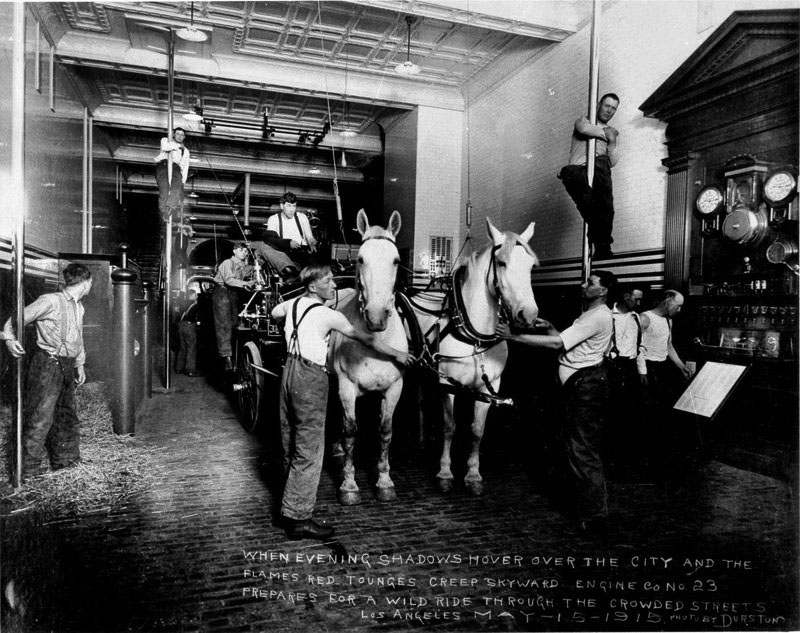 |
|
| (1915)**# - Interior view of Engine Company No. 23. Inscription on photo reads: WHEN EVENING SHADOWS HOVER OVER THE CITY AND THE FLAME'S RED TONGUES CREEP SKYWARD, ENGINE CO. NO. 23 PREPARES FOR A WILD RIDE THROUGH THE CROWDED STREETS OF LOS ANGELES. |
Historical Notes Fire Station No. 23 remained an active firehouse from 1910-1960. When it opened, it was manned by fifteen firefighters and ten horses. The original equipment included a horse wagon, chief's buggy, and a pumper that used a vertical tube boiler. The company's first major call was a fire in the old Byrne Building that took ten hours to extinguish.^* |
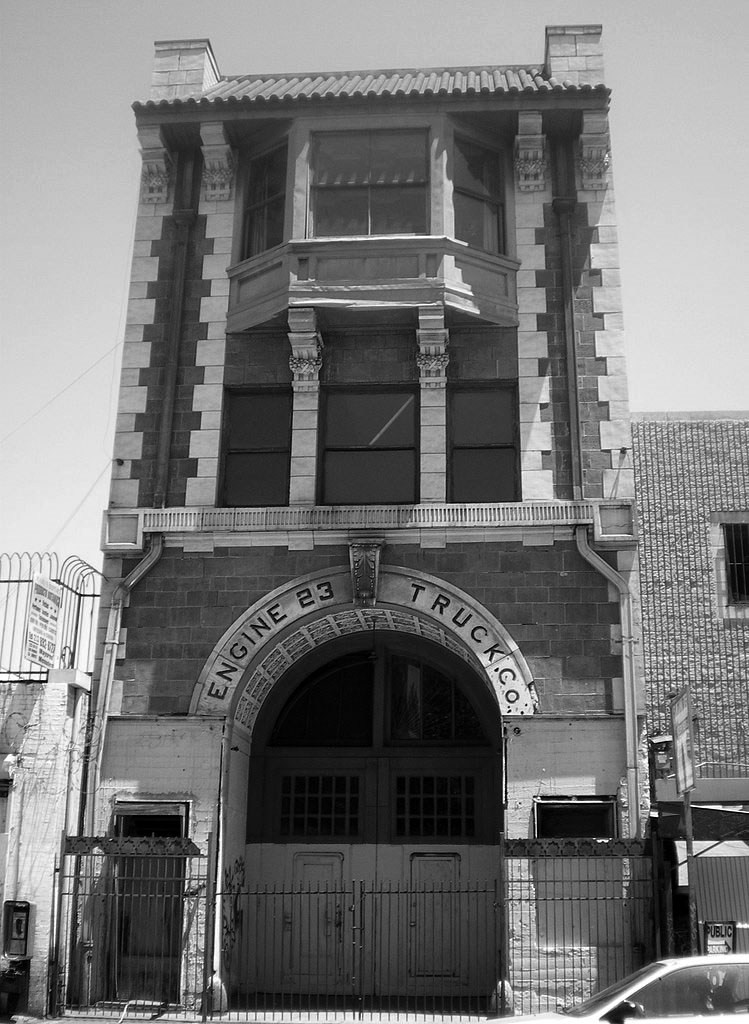 |
|
| (2008)^* - View showing the abandoned Fire Station No. 23 in Downtown Los Angeles. |
Historical Notes Fire Station No. 23 was built in 1910 as an operating fire station. It was also the Los Angeles Fire Department's headquarters until 1920 and the residence of every fire chief from 1910-1928. When it opened, it spawned a political firestorm due to the ornate interior and expensive imported materials, leading to its being called the "Taj Mahal" of firehouses. Through the 1960s and 1970s, the station deteriorated. The surrounding neighborhood became part of the city's Skid Row and the station became "a hangout for the street people." Looters stole most of the copper tubing and brasswork, banisters, doorknobs, firebells, and even the five brass firepoles. By the mid-1970s, concerns were raised that the building had become a hazard, and some proposed tearing it down. However, in 1979, the Fire Commission announced plans to restore the rooms back to their 1910 condition and turn the station into a museum. The City Council placed the station under control of the fire department, but provided that no city funds were to be used in creating the museum. In 1981, officials of the fire department set up a nonprofit organization called Olde 23 to raise funds to build the museum, but sufficient funds were never raised. The projected cost of the museum, even in 1982, was $1 million, and critics questioned the wisdom of building a museum in Skid Row. In 1988, the city settled on a different location for the Los Angeles Fire Department Museum—Engine Co. No. 27 in Hollywood.^* |
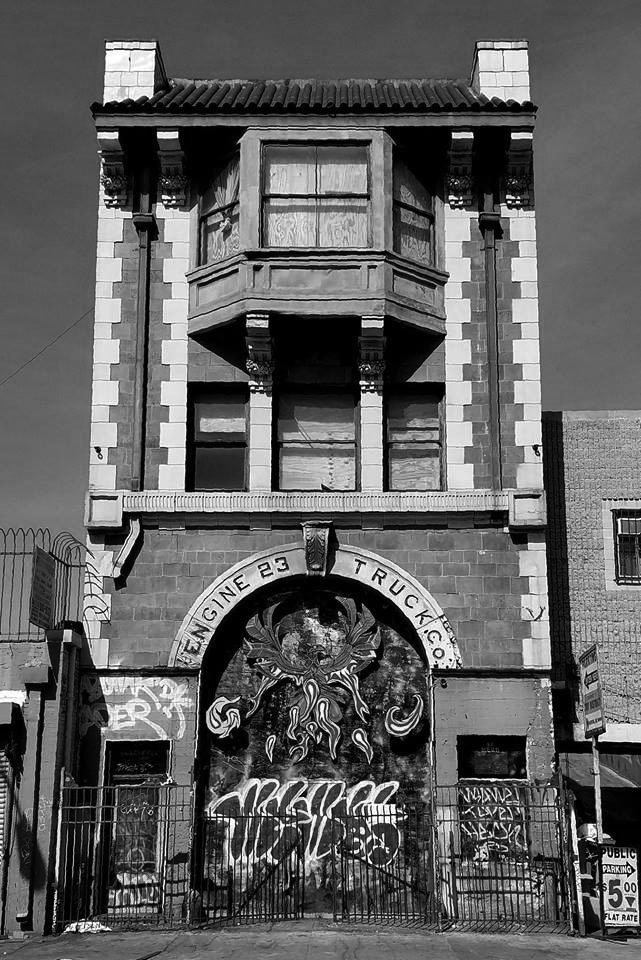 |
|
| (2018)^.^ - View showing an abandoned and deteriorated Fire Station No. 23, located at 225 E. 5th Street. |
Historical Notes In 1966, the station was declared a Historic Cultural Monument by the Los Angeles Cultural Heritage Commission; at the time of the declaration the Los Angeles Times called it the "Taj Mahal of fire stations." A Library of Congress survey of 250 firehouses concluded that Station 23's interior was "unmatched in its beauty." It was added to the National Register of Historic Places in 1980.^* Fire Station No. 23 is currently being repurposed as a community arts center by City of LA Cultural Affairs Department. |
Engine Company No. 24
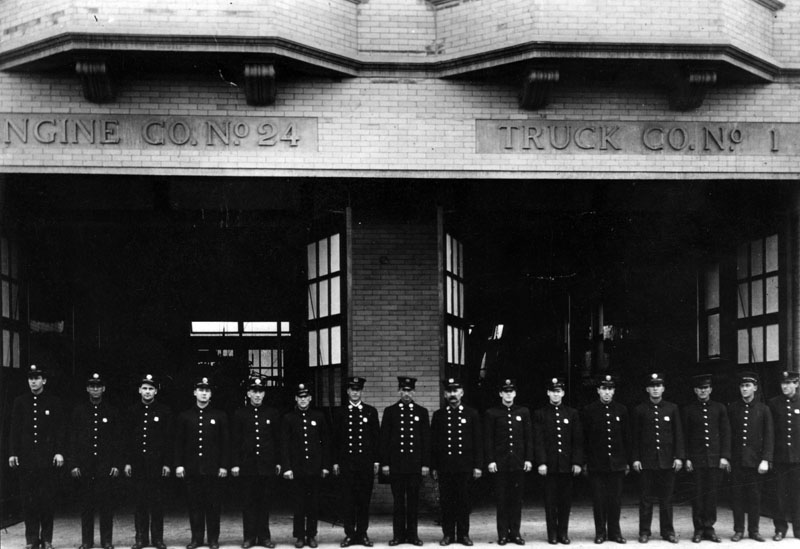 |
|
| (ca. 1910)* - Sixteen fire fighters in full uniform stand in a single-file line in front of Engine Company No. 24, which is located at 204 S. Hewitt, near Second Street. Truck Co. No. 1 (pictured on right) was headquartered in the same building. |
Historical Notes Engine Company No. 24 and Water Tower 1 opened August 16, 1910. The 13,800 square foot site had an 11,140 square foot floor area. Cost of the land was $16,000 and the building cost was $30,464. This station moved to its new home at 9411 Wentworth Street in Sunland on July 10, 1969, and has operated from that location since. |
* * * * * |
Hotel Snow (later Hotel Southland)
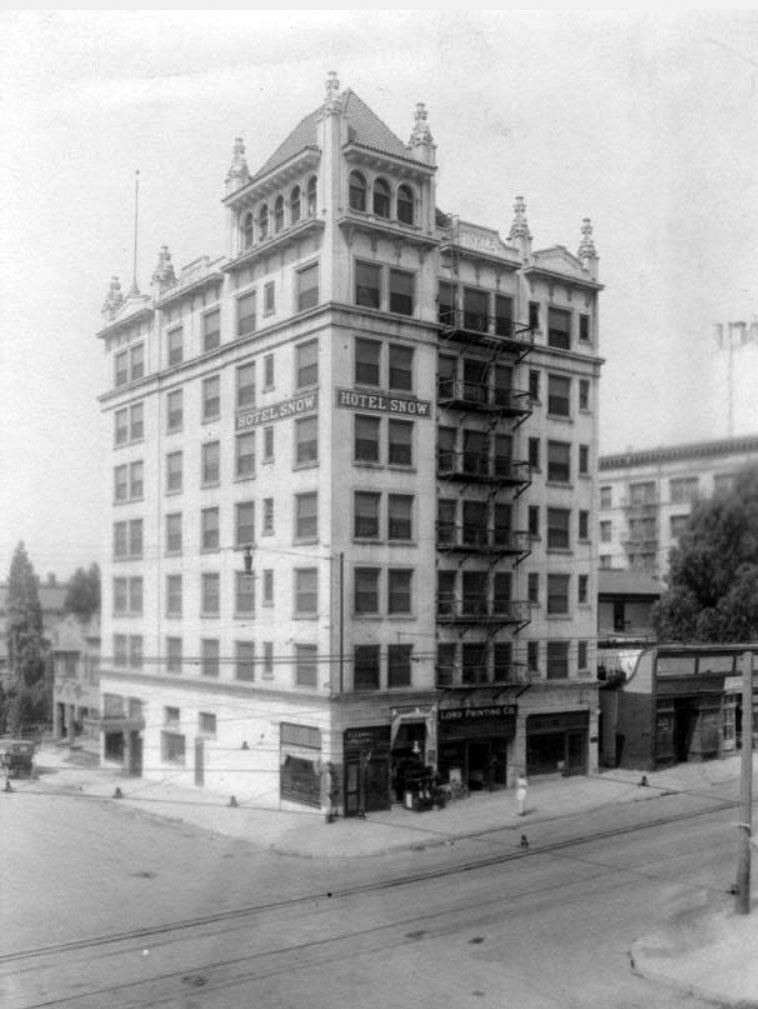 |
|
| (ca. 1910)* – View looking at the SW corner of 6th and Flower streets showing the Hotel Snow. The name “FINKLE" is carved on the top front of the building. |
Historical Notes The Snow was opened by Frank C. Finkle in December 1910. It was designed by architect H. M. Patterson, best known for his churches, especially Immanuel Presbyterian (that imposing Gothic structure at Wilshire and Berendo. Rooms rented rooms for $1.00-$2.00 without bath (for 1-2 people) and $1.50-$2.50 with bath (1-2 people). |
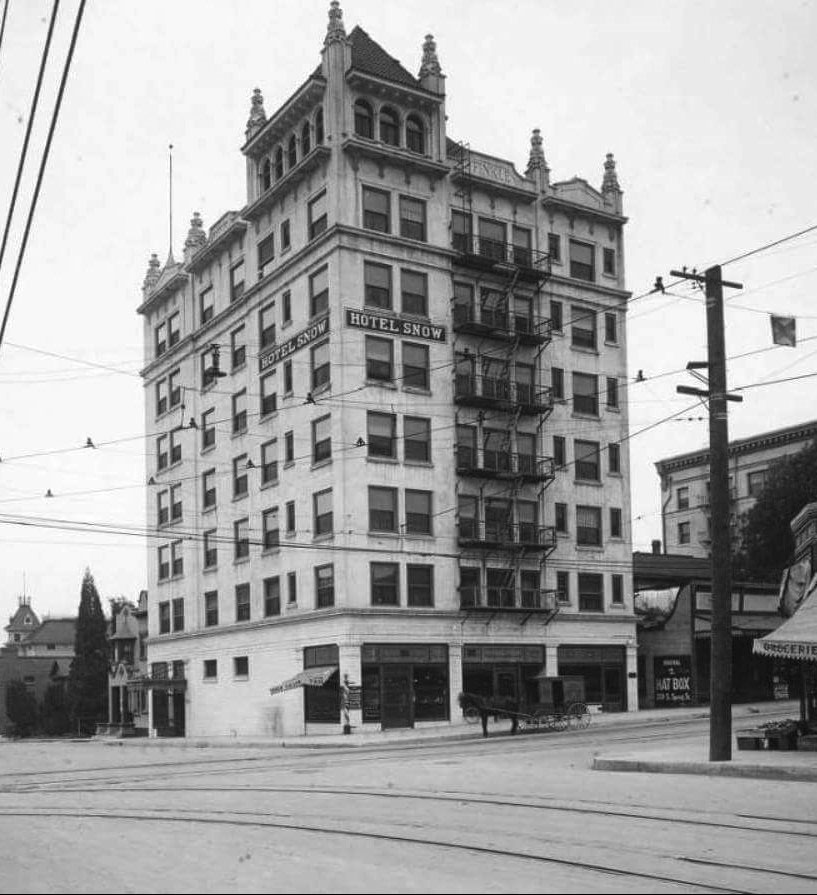 |
|
| (1912)* – View of the Hotel Snow, 6th & Flower, with a horse-drawn wagon parked in front on the 6th street side. It would be renamed Hotel Southland in 1916. The small grocery store across the street (bottom right) is on the future site of the Richfield Tower. |
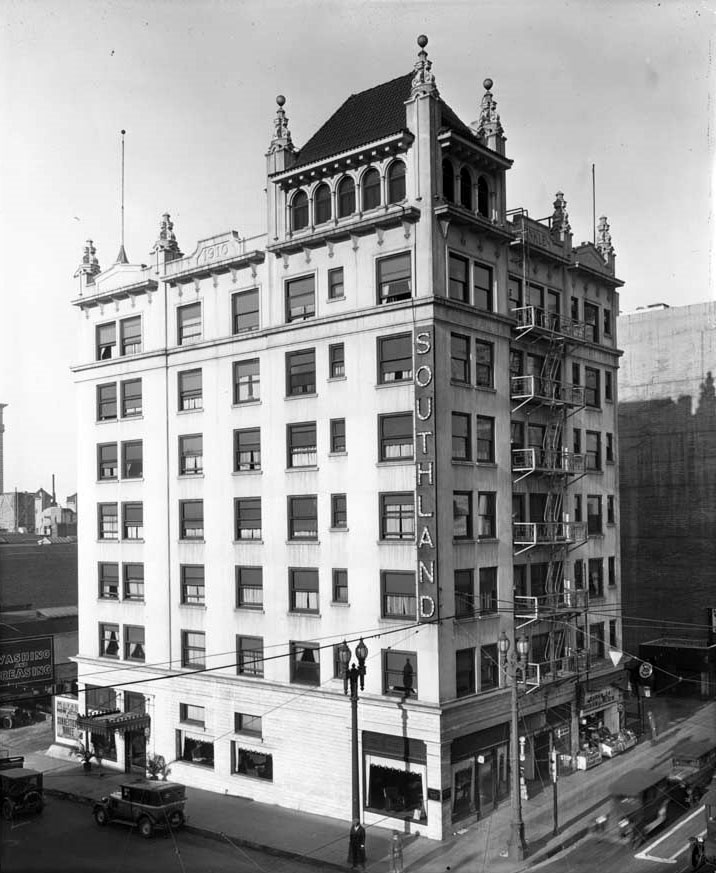 |
|
| (ca. 1929)* - View of Southland Hotel (previously Hotel Snow) with a Peerless Cab Company taxi parked in front (lower left), 804 W. 6th Street. |
Historical Notes The seven-story stucco building had Spanish style Gothic Revival trim along roofline and penthouse. The mixed-use building had a barber shop, beauty parlor, and grocery store on ground floor. Originally the Hotel Snow, it was renamed Southland in 1916. |
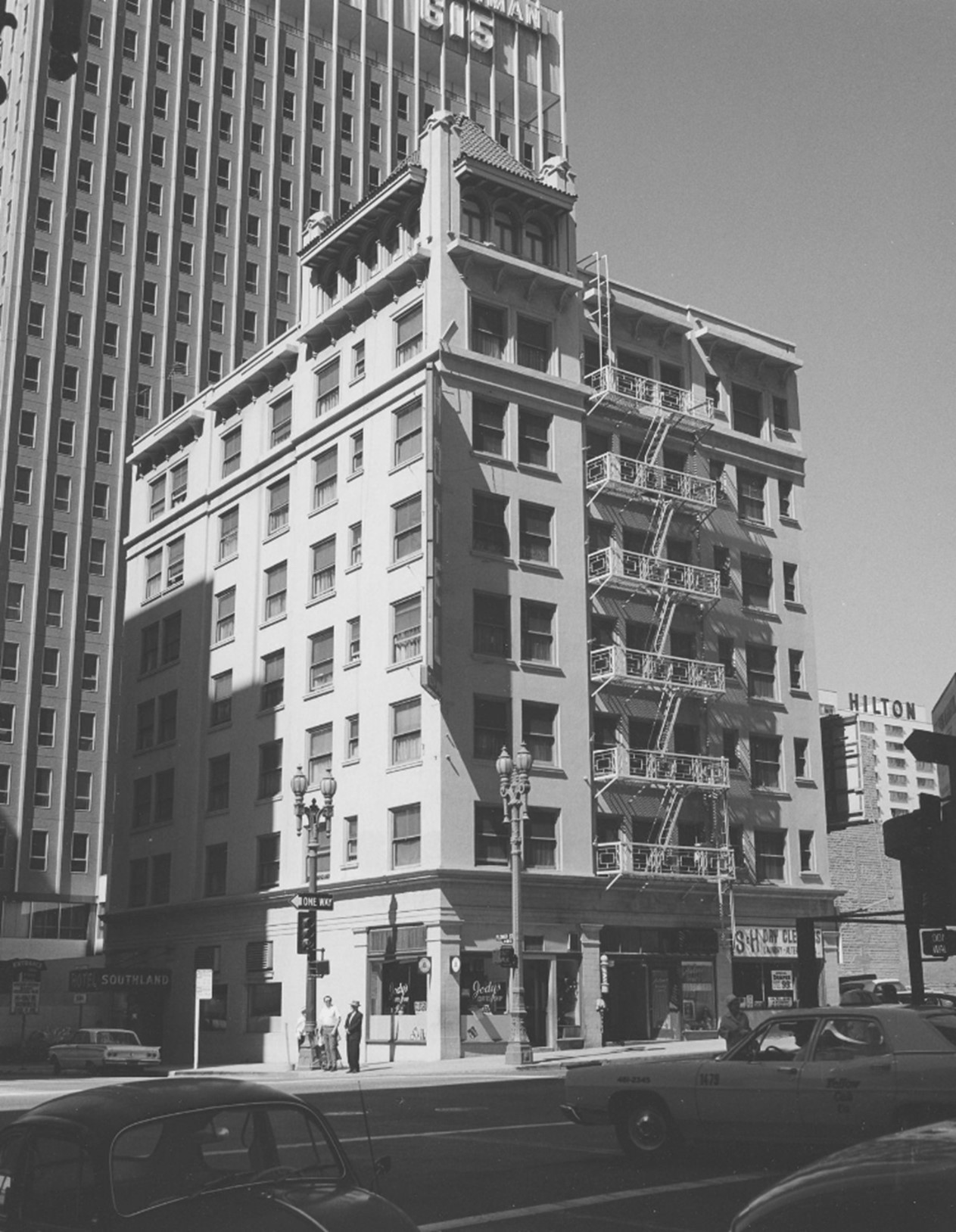 |
|
| (1969)* – Southland Hotel with fire escape above the entryway and two ornate lampposts on the sidewalk. Photo by William Reagh. |
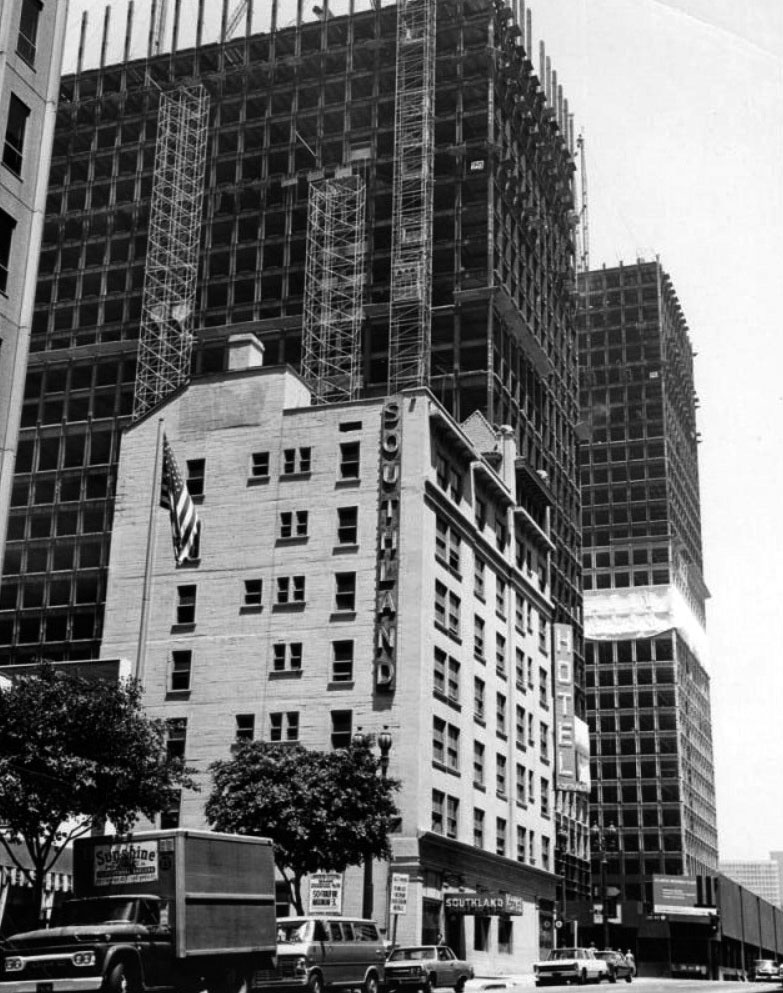 |
|
| (ca. 1970)* – View looking NW showing the Southland Hotel with the construction on the twin towers of Arco Plaza taking place above and behind it on the norh side of 6th Street. |
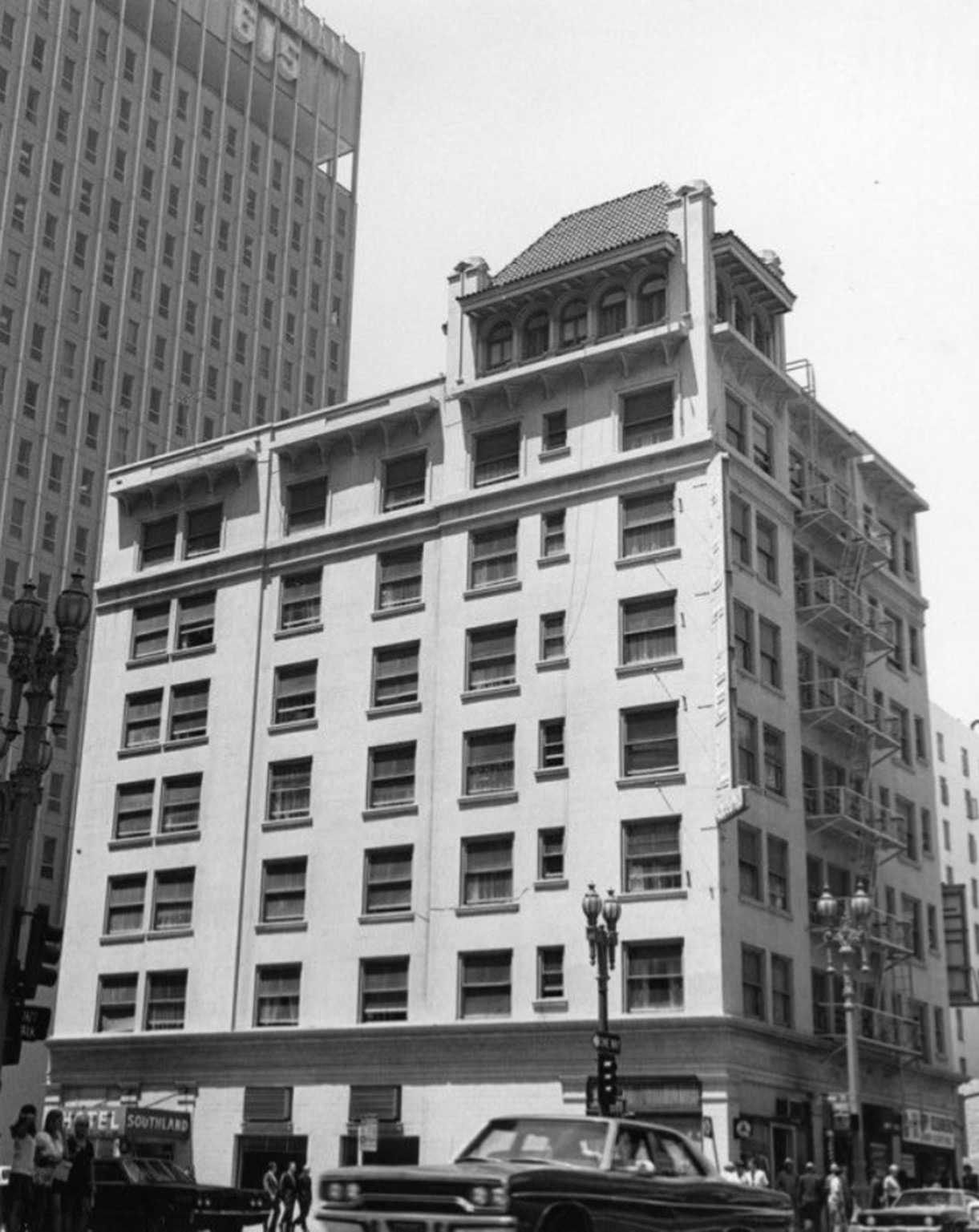 |
|
| (1970)* – The Southland Hotel on the southwest corner of Flower and 6th Streets. This image was taken close to the time of the building's demolition. |
Historical Notes The Southland Hotel met its end in 1971 and was replaced by the William L. Pereira-designed Pacific Financial Center. |
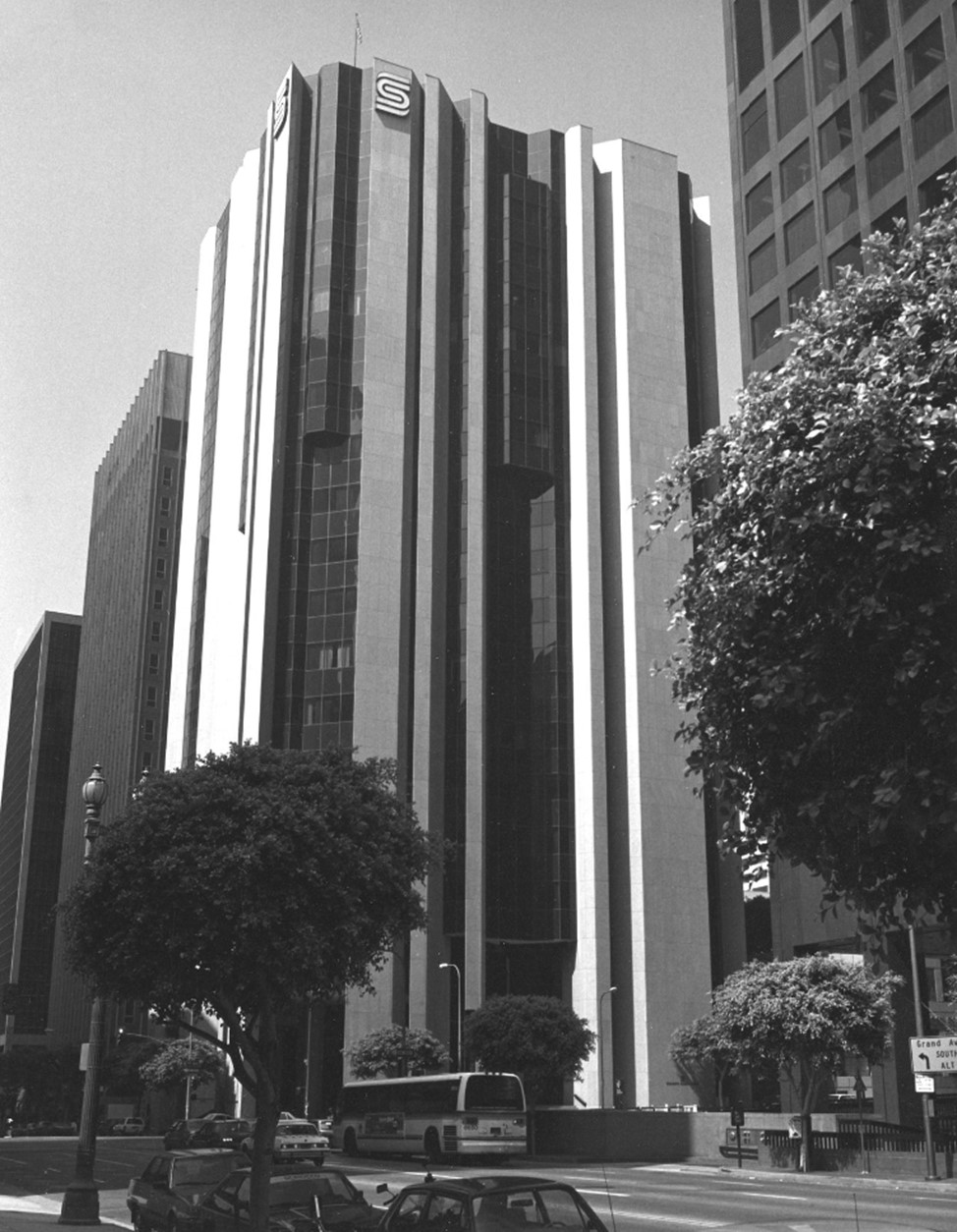 |
|
| (1986)* – View showing the Security [Pacific National] Bank standing where the Southland Hotel once stood. Photo by William Reagh. |
Historical Notes The current Pacific Financial Center was built in 1973, replacing the Southland Hotel. |
Before and After
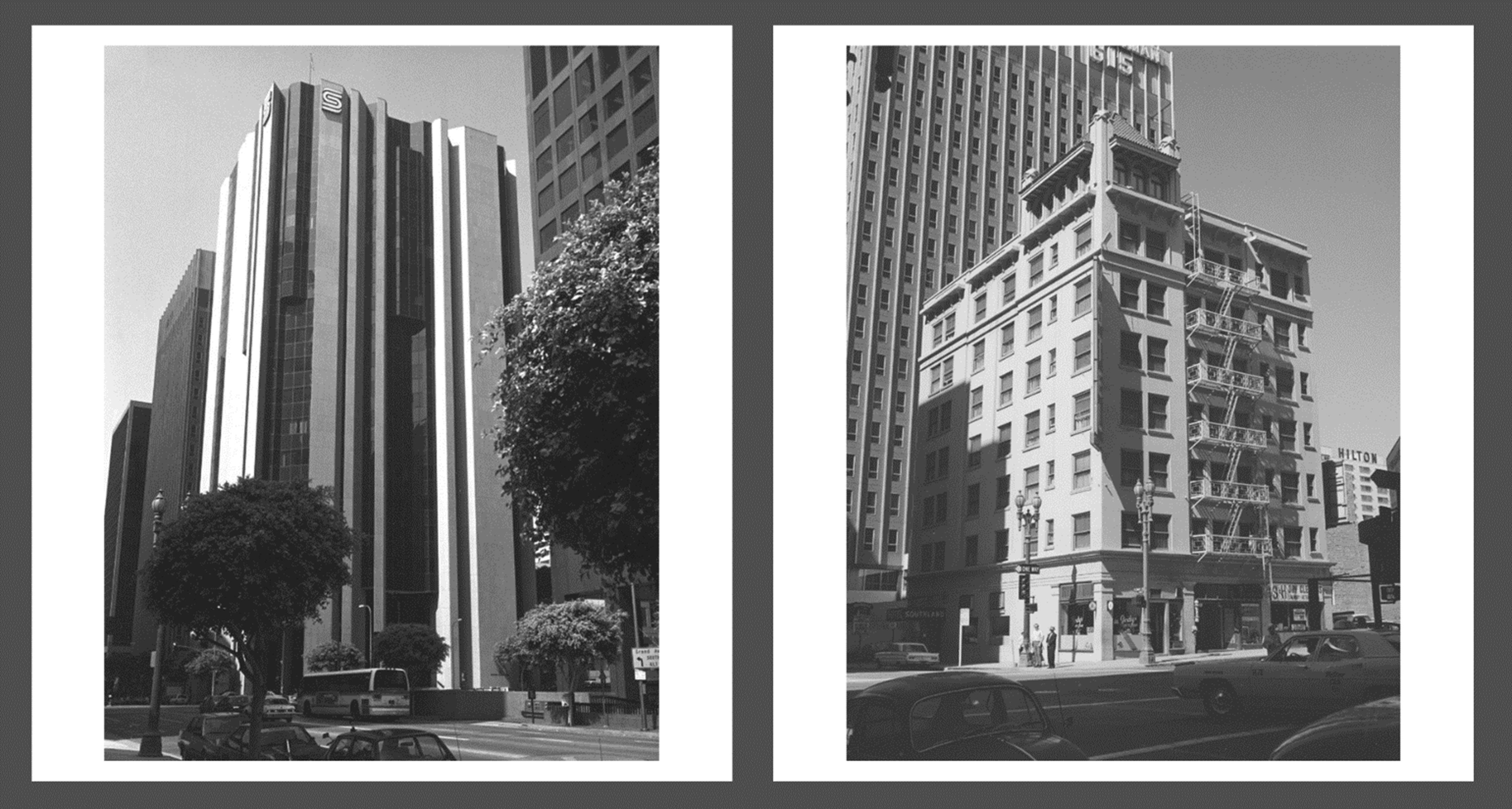 |
|
| (1969 vs 1986)* - View showing the Security [Pacific National] Bank where the Southland Hotel once stood, southwest corner of Flower and 6th Streets. |
* * * * * |
Newmark Building - Blanchard Music Hall
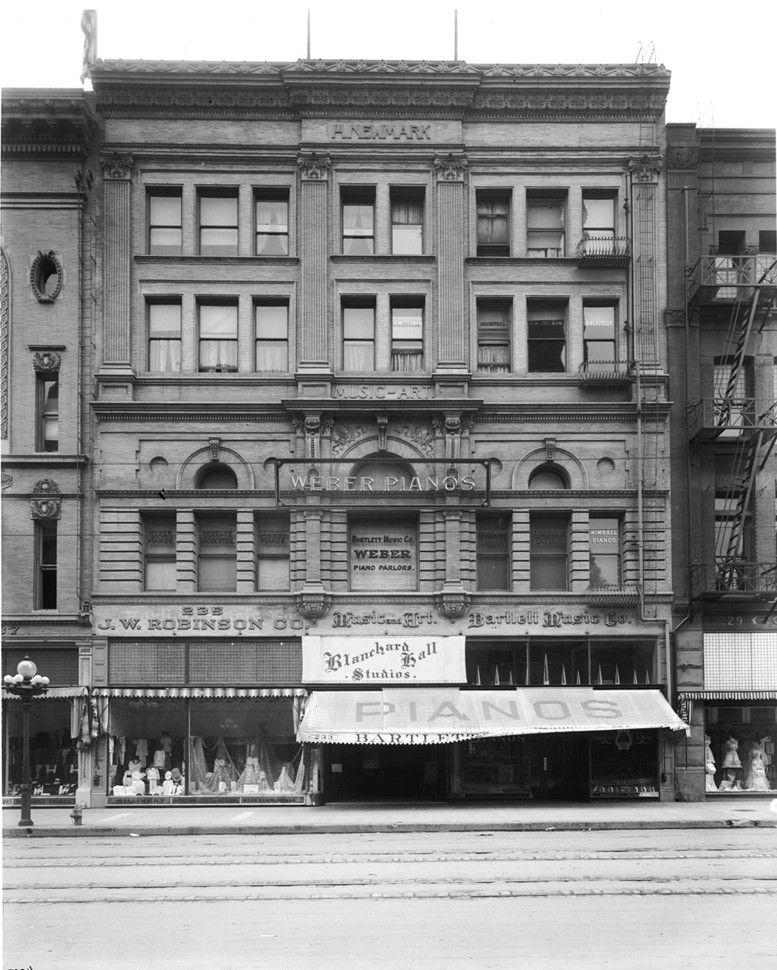 |
|
| (1910)^ - View of the H. Newmark Building located at 233 South Broadway. The five-story building, designed by A. M. Edelman, housed Blanchard Music Hall, J. W. Robinson Company, and Bartlett Music Company, dealers in Weber Pianos. |
Historical Notes The building went by the name of Blanchard Music Hall but was also known as the H. Newmark Building as it was built by and on the site of Harris Newmark's former residence. Harris Newmark emigrated to the United States in 1853 from Germany. He sailed from Europe to New York City to San Francisco, and finally settled in Los Angeles. The Newmark clan was one of the founding families of the Los Angeles area. Newmark developed several successful businesses, which employed most if not all of a near-inexhaustible list of Newmark family members. Newmark was chiefly a grocer and dry goods merchant, but he also dabbled in other fields. He even tried sheep farming, but he was preoccupied with the burgeoning real estate opportunities to be had in the Los Angeles area. Newmark bought and sold properties throughout southern California, and made a fortune in the process. |
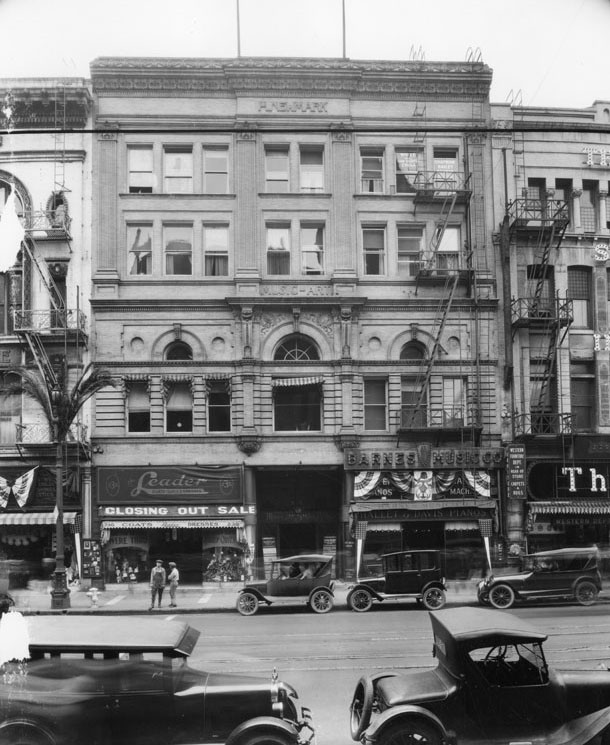 |
|
| (ca. 1928)* - View showing the original Harris Newmark Block. A sign on the building reads, "Music-Art." On the street level is the Leader clothing store and Barnes Music Co. Street address on the clothing store is 235. |
Historical Notes The building had a large hall (Blanchard Music Hall) with a seating capacity of 800. It was used for chamber music concerts and other programs. There was another smaller hall seating 150 and a banquet hall for 300. There was also an "Assembly Hall" of unknown capacity. There was also space in the Music and Art Building for studios for 150 musicians and artists as well as a fourth floor art gallery. Blanchard Music Hall was named for Frederick W. Blanchard, who had been influential in the music business in Los Angeles and went on to become the first president of the Hollywood Bowl. The building went all the way through to Hill St. On the 1910 Baist Real Estate Survey map the Hill St. end of the skinny building is marked "Blanchard Hall Bldg." while the Broadway end is labeled "Newmark Bldg." |
* * * * * |
Blanchard Music Hall - Newmark Building
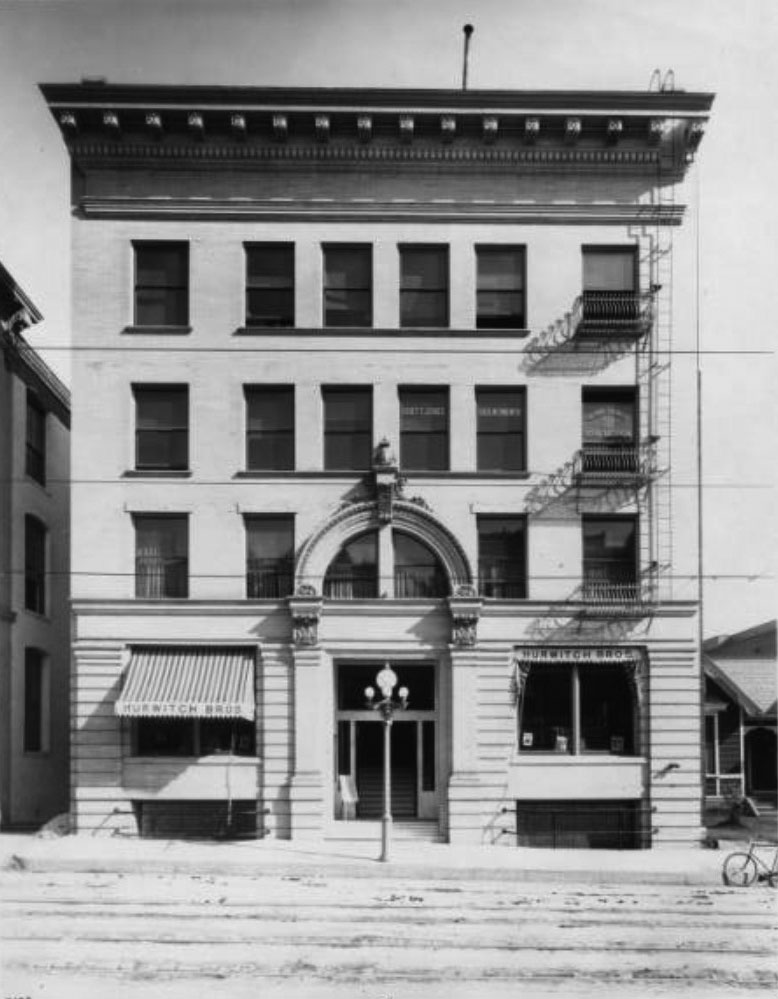 |
|
| (1910)* – View of the Hill Street entrance to the Blanchard Music Hall and art gallery, located on the east side of Hill Street between 2nd and 3rd streets. Note the ornate 6-lamp lamppost in front of the building. Click HERE to see more in Early Los Angeles Streetlights. |
Historical Notes Blanchard Hall contained the first art gallery west of Chicago. The building went all the way through to Broadway (previous photo). On the 1910 Baist Real Estate Survey map the Hill St. end of the skinny building is marked "Blanchard Hall Bldg." while the Broadway end is labeled "Newmark Bldg." |
* * * * * |
Grand Central Hotel
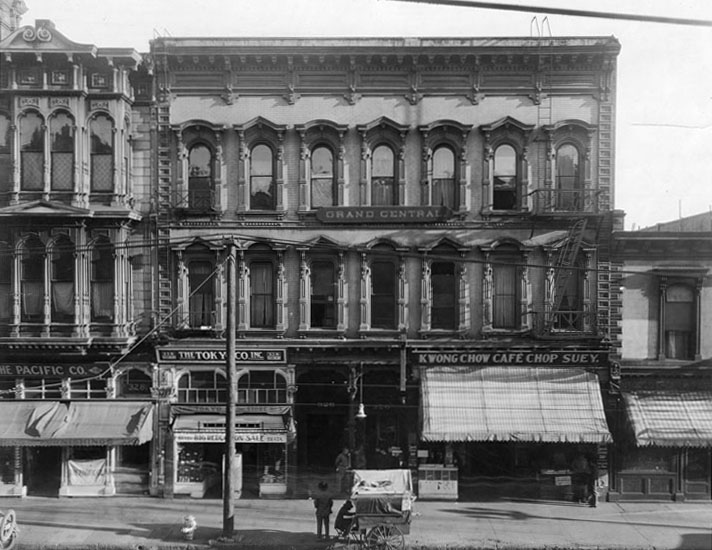 |
|
| (ca. 1910s)* - View showing the Grand Central Hotel, at 326 N. Main Street, with businesses on the ground floor such as Tokyo Co. Inc. and Kwong Chow Cafe. A man in a push cart is directly in front. To the left ia the 3-story Downey Building and further to the left (out of view) is the Baker Block. To the right is the 2-story Pico Building. |
Historical Notes The three-story Grand Central Hotel at 326 North Main Street was completed around 1877. Major construction came to its climax on the 300 blk of Main Street in the following year with the opening of the Baker Block, on the left. The slim, three-story building nestled between the Baker Block and Gand Central Hotel was developed by the ever active Governor Downey, and finished around 1878. +# |
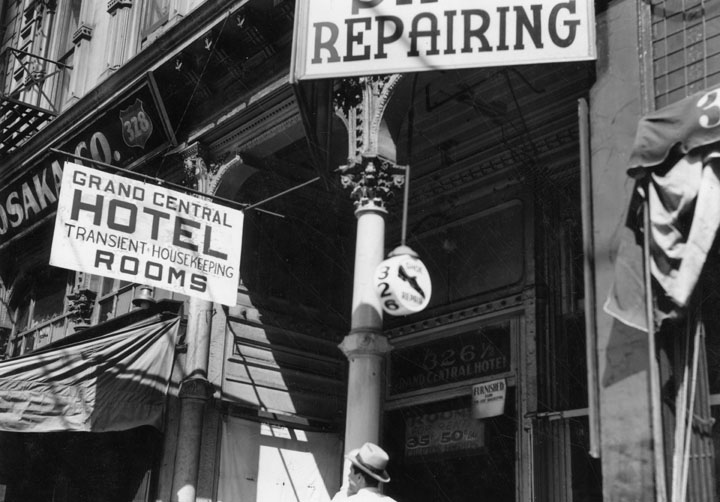 |
|
| (ca. 1930s)* - Looking at the upper part of the doorway into the Grand Central Hotel, you can see a sign advertising transient-housekeeping rooms, the bottom half of a shoe repairing sign, a hanging globe with the number 326 (for 326 N. Main Street) on it and in the background the sign reading "furnished". |
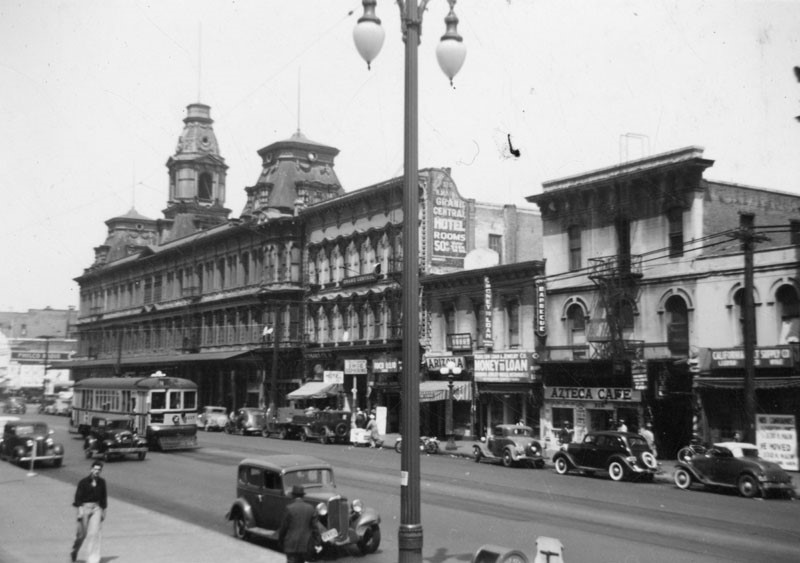 |
|
| (ca. 1940)* - Looking northeast showing the buildings on the 300 block of North Main Street shortly before their demoliton. The Grand Central Hotel sits at center with large sign on side of building. |
Historical Notes Well into the 20th century, the old buildings on the 300 block of North Main Street were a vivid testament to Los Angeles’ early history, from its humble beginnings to its astonishing growth during the Reconstruction years. Behind the “Azteca” sign on the right side of the top photograph is the Bella Union Hotel, considered to be the city’s first hotel. Completed sometime during the 1840s, it was one of downtown’s greatest landmarks for several decades, and was later expanded to two, then three stories. The two-story building to its left is the Pico Building, built by Pio Pico in 1868 (two years before the Pico House). In 1871, the building became home to the Farmers & Merchants Bank, the first incorporated bank in the Los Angeles, directed by former California Governor John G. Downey. +# |
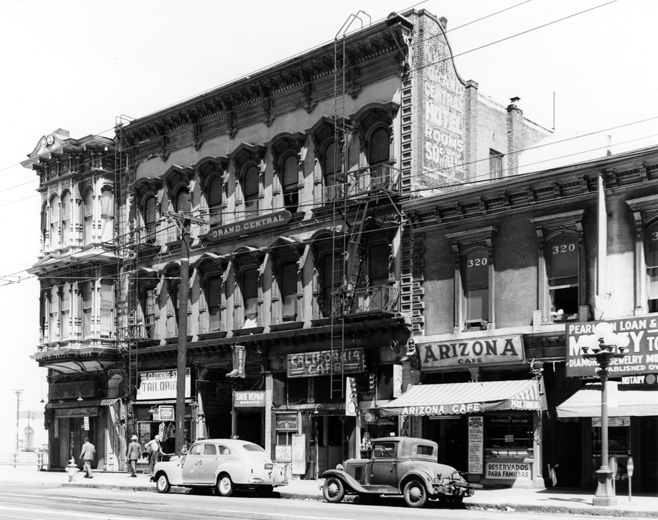 |
|
| (1940s)^*# - View of Maint Street north of Commercial Street showing (L to R): the slim Downey Building, Grand Central Hotel and Pico Building (original home of Farmers and Merchants Bank). |
Click HERE to see more in Early Views of the Historic 300 Block of N. Main Street |
* * * * * |
Avila Adobe
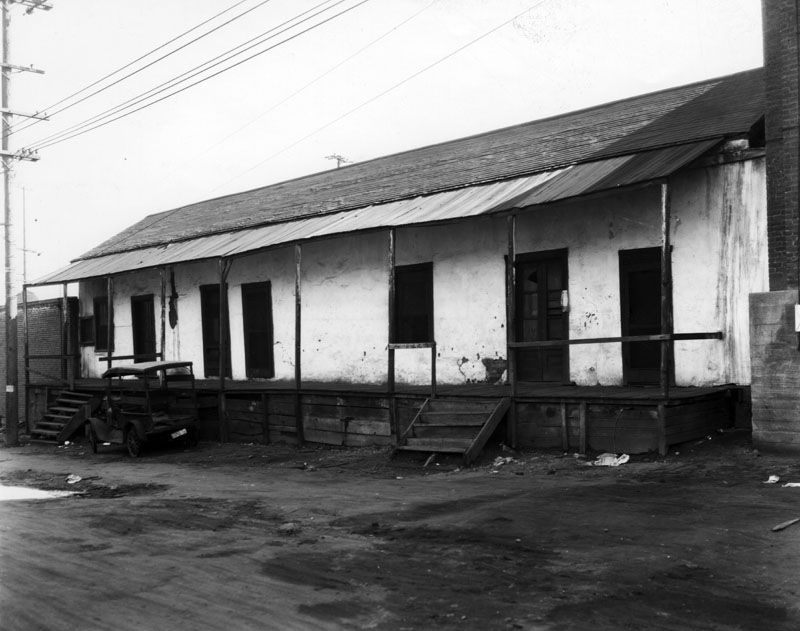 |
|
| (ca. 1910s)* - View of the Avila Adobe house on Olvera Street; a small car is parked along the front of the wooden porch next to one of the staircases. |
Historical Notes Don Francisco Avila, a wealthy cattle rancher and one-time Mayor of the pueblo of Los Angeles, built the Avila Adobe in 1818. The Avila Adobe, presently the oldest existing residence within the city limits, was one of the first town houses to share street frontage in the new Pueblo de Los Angeles.* |
.jpg) |
|
| (1935)* - Avila Adobe as seen from a building across Olvera Street. In front of the house is a wooden cart, and a Mexican flag is by the entrance. It is located at 14-16-18 Olvera Street and was used by the Avila and Rimpau families. |
Historical Notes The above photo of the Avila Adobe house was taken just after Olvera Street was converted to a colorful Mexican marketplace - as made evident by the small vendor stands. The original porch was given a much-needed face-lift with the addition of a long veranda and steps and a short brick planter the length of the house.* |
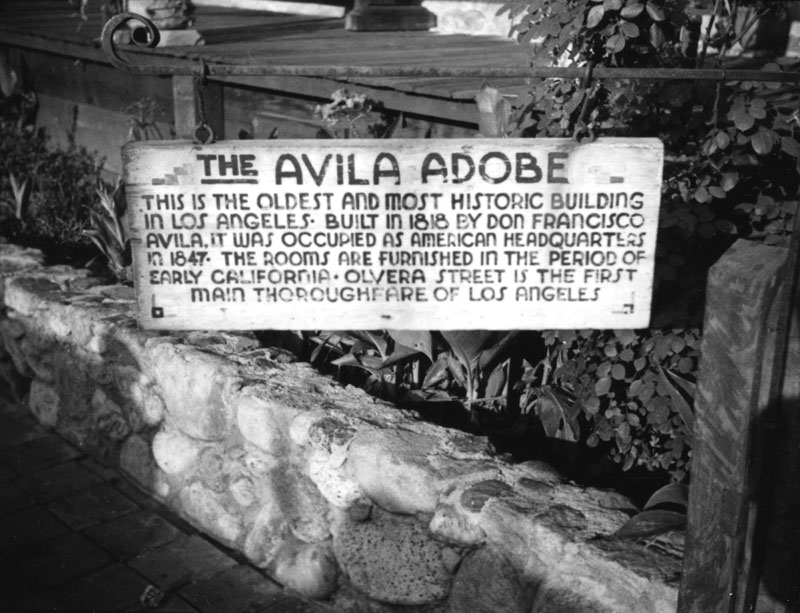 |
|
| (ca. 1935)* - View of the sign in front of the Avila Adobe, the oldest existing residence within the city limits. |
Historical Notes In 1847, this adobe became the temporary headquarters for Commodore Robert Field Stockton and General Stephen Watts Kearny during the American occupation of Los Angeles.* Click HERE to see more in Early LA Plaza. |
* * * * * |
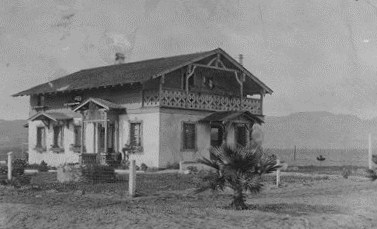 |
|
| (1912)^* - The Knapp home at Owensmouth Avenue and Cohasset Street in Canoga Park. View looking north west. |
Historical Notes Knapp Park in West Hills is named for these same Knapps. The men of the Knapp family were stone builders and did much of the stone work at Orcutt Ranch, also located in West Hills on Roscoe Boulevard near Valley Circle Boulevard. |
Click HERE to see more Early Views of the San Fernando Valley |
* * * * * |
Vogel Block
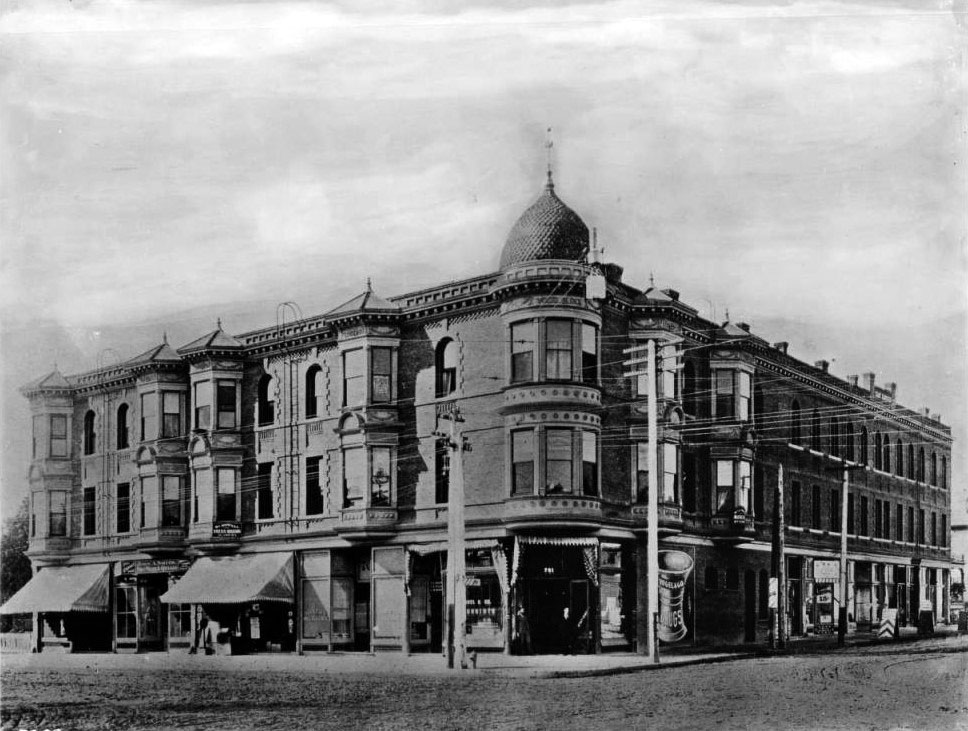 |
|
| (ca. 1910)^ – View of the Vogel Block building, constructed in 1893, on the southwest corner of Seventh Street and Broadway. A cylindrical collection of windows extends out from the corner of the three-story building over the entrance, topped by a spired dome. The architecture is reminiscent of the Victorian style, and all of the box window are decoratively molded. Signs are displayed along the shop fronts that comprise the lower level along the sidewalk. The street is unpaved, and utility poles can be seen. |
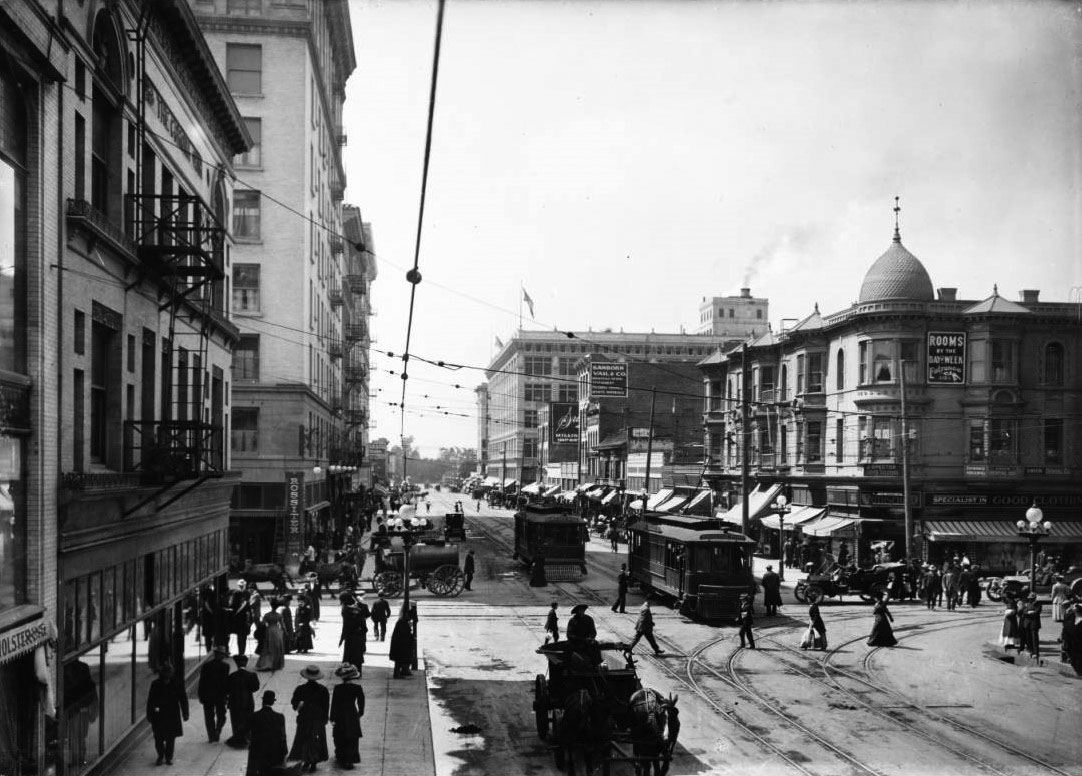 |
|
| (ca. 1910)^ – View looking down Broadway at 7th Street. The Vogel Block building, with its onion-shaped roof, stands on the southwest corner. The large building with Rossiter sign, across Broadway to the left, is the Lankershim Hotel (built in 1905); the building in the extreme foreground at left is the Hotel Corona; the large white building with two flags on its top (in the close background at center) is the Hamburgers Department Store (south-west corner with 8th Street, where it had moved after leaving the Phillips Block). |
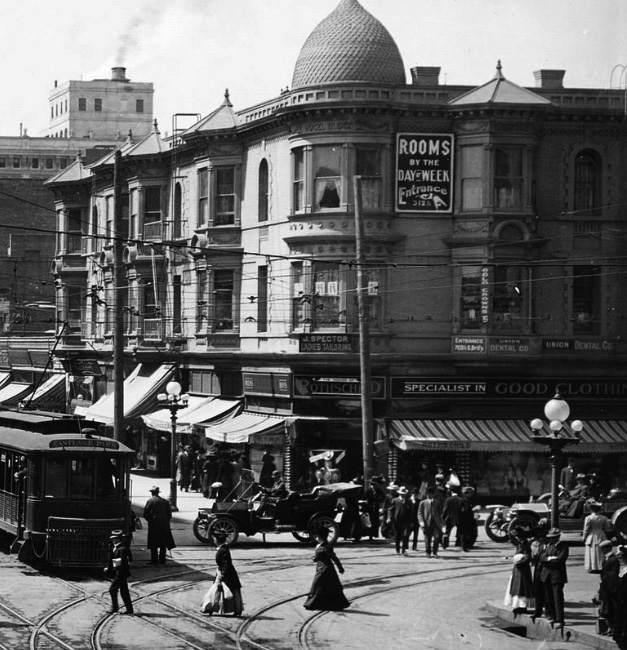 |
|
| (1910)^ - Close-up view of the southwest corner of Broadway and 7th Street showing the Vogel Block with its onion-shaped tower. Sign on the side of building reads: “Rooms by the Day or Week”. |
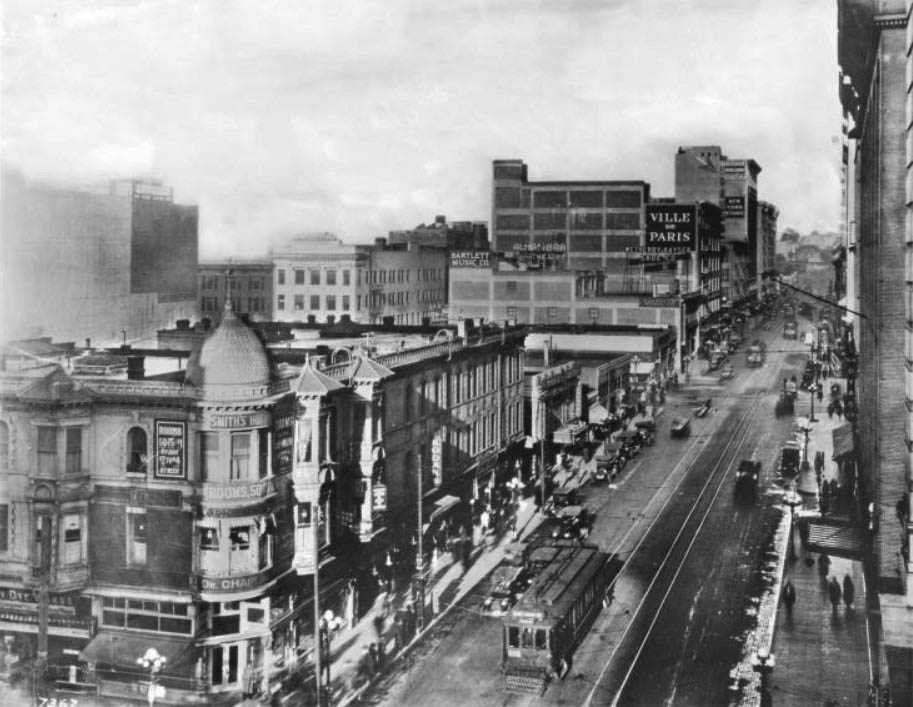 |
|
| (1921)^ - Birdseye view of Seventh Street looking west from Broadway, showing the Vogel Block on the corner at left. The three-story building is topped by a spired dome and covered with signs. Its windows have molding reminiscent of Victorian architecture. |
Historical Notes In 1921 the 1893-built Vogel Block would be demolished to make room for Loew's State Theatre (currently United Building). |
* * * * * |
Hyman Theatre (later Garrick Theatre)
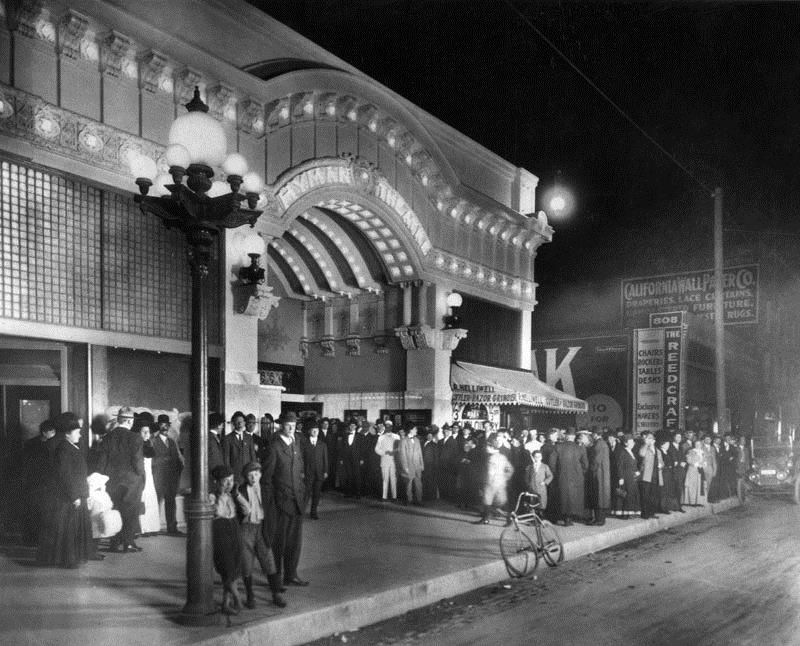 |
|
| (1910)* - An evening crowd gathers under the marquee of the Hyman Theater at 802 S. Broadway, on the southeast corner of 8th and Broadway. A lone bicycle leans on the curb in front. One boy is seen leaning against an ornate 7-bulb streetlight. Click HERE to see more in Early Los Angeles Streetlights. |
Historical Notes The theater was built in 1910 by Los Angeles theatrical promoter Arthr S. Hyman. Within just one year, 1911, the theater became the Garrick, a motion picture theater. The original facade was by the Los Angeles architect firm, Train & Williams. In 1921 it was remodeled to a design by architect George Edwin Bergstrom. The building was replaced by the Tower Theatre in 1927.* |
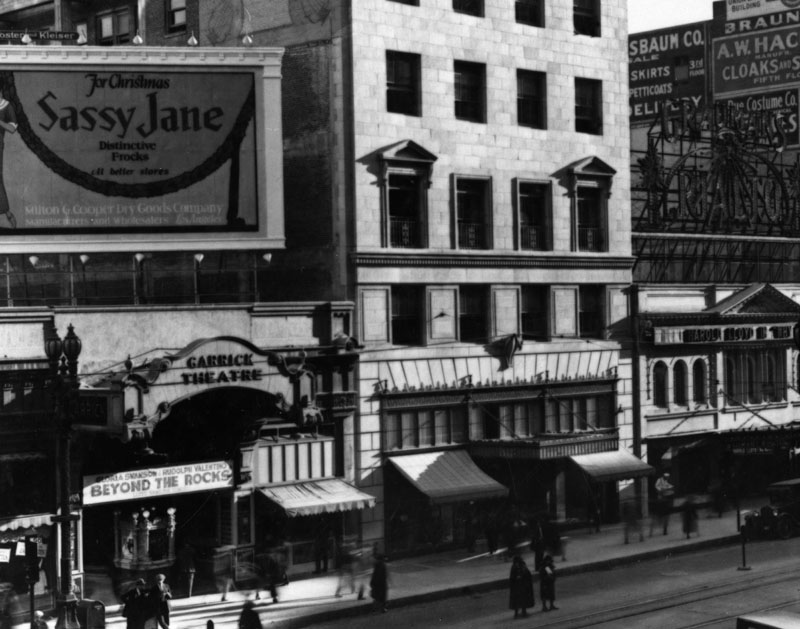 |
|
| (ca. 1922)* - "Sassy Jane" billboard sits atop the Garrick Theatre on Broadway in downtown Los Angeles as pedestrians pass the marquee. |
Historical Notes In 1921, the Garrick Theater was remodeled to a design by architect George Edwin Bergstrom. The building was demolished in 1927 to make way for the Tower Theatre.* |
Tally's New Broadway Theatre (also Kinemacolor Theatre)
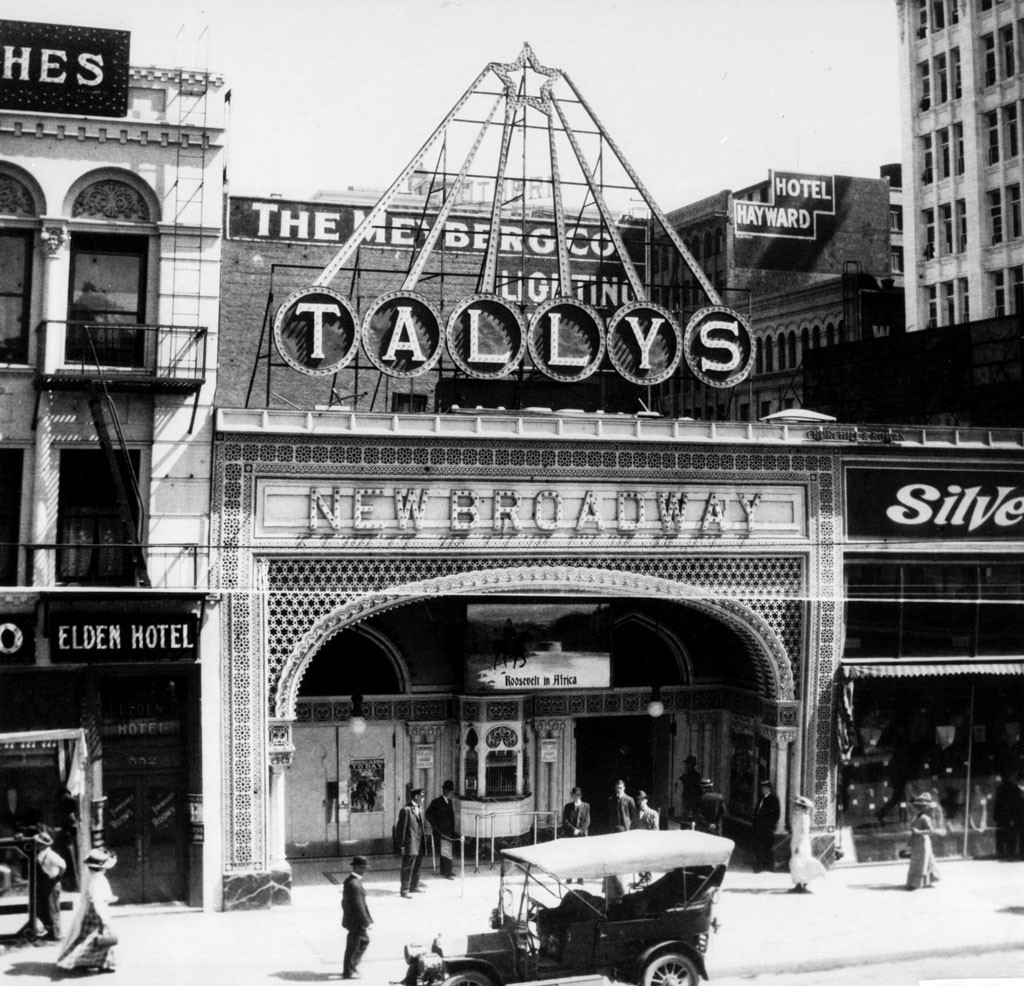 |
|
| (ca. 1911)^ - Tally's New Broadway Theater located on the 800 block of South Broadway. |
Historical Notes Opened on May 2, 1910 by Thomas L. Tally, the theatre was constructed in 30 days. Located on the west side of Broadway between 8th and 9th, it was just south of Hamburger's Department Store (later the May Co.) and two doors north of the Majestic Theater. The 1910 city directory gives a listing at 833 S. Broadway for both Tally's Film Exchange and Tally's New Broadway. Tally had earlier used that latter name for his New Broadway Theatre at 554 S. Broadway, a house he took over in 1905. In 1911 Tally's Broadway was known as the Kinemacolor Theatre while showing color films in the Kinemacolor process but then went back to the Tally's Broadway name.**^ |
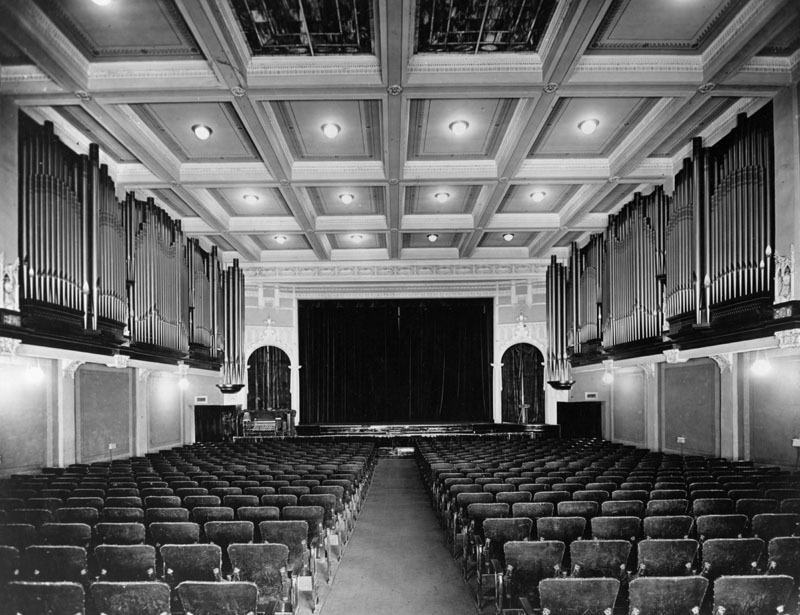 |
|
| (ca. 1911)* - Interior view of Tally’s Theatre. Picture faces the curtained stage, with walls on the right and left lined with pipe organ pipes. |
Historical Notes An article in Moving Picture World for July 15, 1916 says " The chief feature of this house is the music. It has a splendid orchestra and a simply wonderful organ." In 1916 the admission prices were 10, 20 and 30 cents. The house manager at the time was Seymour Tally, son of Thomas. The article noted that the 30 cent price got you a wicker chair back in the elevated loge section.**^ |
 |
|
| (1916)^*# - View of Tally's Theatre in 1916. The sign over the front entrance reads: "The World's Finest Theatre Pipe Organ". |
Historical Notes Just two doors south of Tally's was the Majestic Theater. Across the street was the Mission and later the still surviving Orpheum. The Mission was demolished for construction of the Orpheum in 1926. |
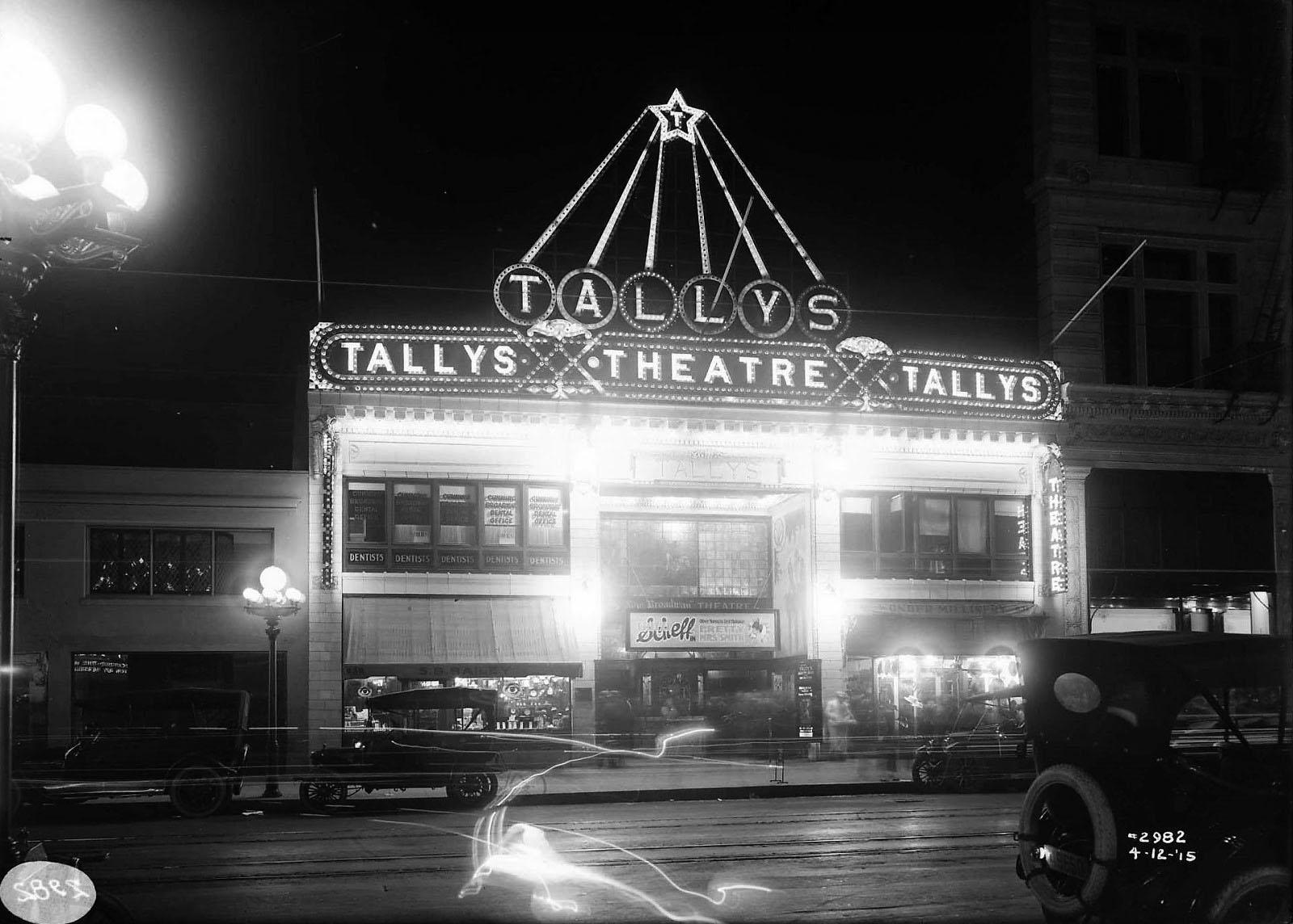 |
|
| (1915)#^* - A terrific view by G. Haven Bishop of Tally's running "Pretty Mrs. Smith." The photo is part of a set commissioned by Southern California Edison Co. documenting electric signs. |
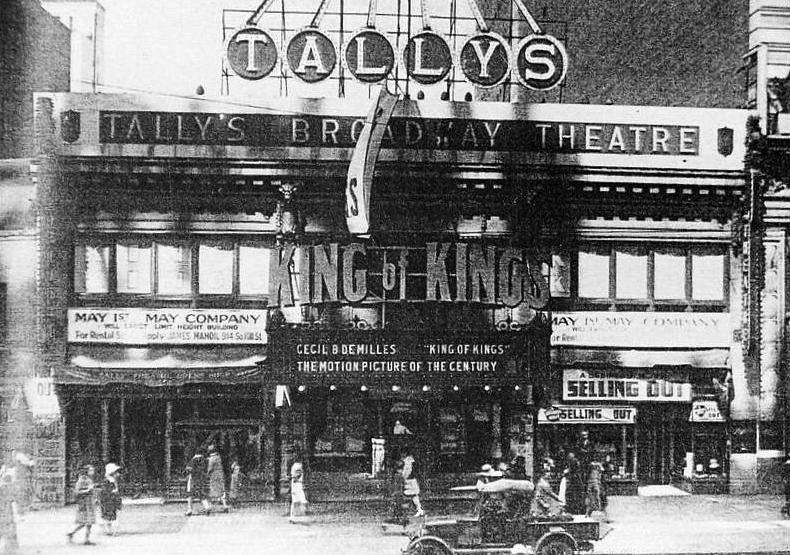 |
|
| (1928)* - "King of Kings" playing Tally's near the end. Note the signs saying that the May Co. was going to erect their new building on the site starting May 1. "King of Kings" was the film that opened Grauman's Chinese in May 1927. It ran there until October 30. |
Historical Notes The building was demolished for a 1928 expansion of the May Co. department store (originally Hamburger's) just to the north. |
* * * * * |
Orpheum Theatre (Today the Palace Theatre - 3rd Home of the Orpheum Circuit)
 |
|
| (1911)* – View looking at the east side of Broadway between 6th and 7th streets showing the Orpheum Theatre #3. Further north on the left can be seen the Walter P. Story Building with "Mullen & Bluett Clothing Co." painted on its south face. |
Historical Notes The 3rd Orpheum in Los Angeles opened on June 26, 1911 with two-a-day vaudeville. Sophie Tucker was on the inaugural program. Many famous performers appeared on the stage here including Al Jolson, Sarah Bernhardt (1913), the Marx Brothers, W.C Fields and Will Rogers. There were four Orpheum theatres in downtown Los Angeles: ◆ 110 S. Main St. -- Grand Opera House was the home of Orpheum vaudeville from 1894 to 1903. ◆ 227 S. Spring St. -- The Los Angeles Theatre, later called The Lyceum, was known as the Orpheum from 1903 to 1911. ◆ 630 S. Broadway -- Now the Palace Theatre -- this was the Orpheum between 1911 and 1926. ◆ 842 S. Broadway -- Orpheum Theatre from 1926 to Today |
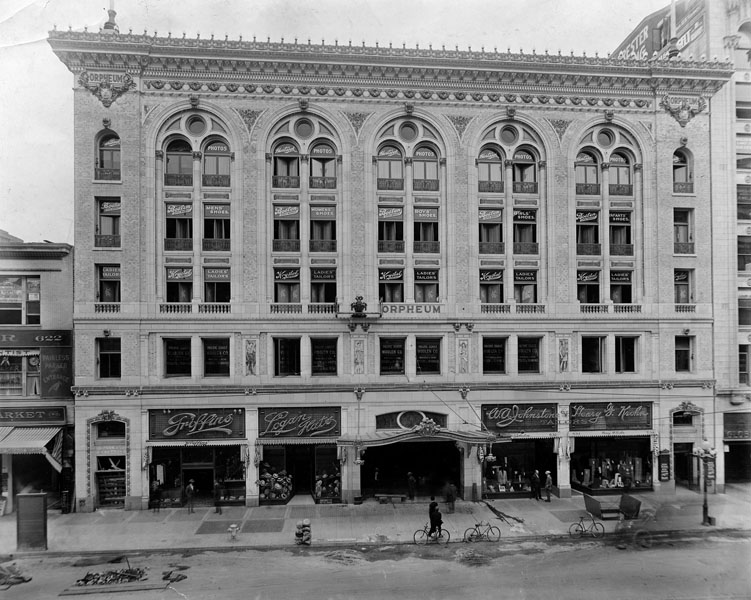 |
|
| (ca. 1910s)* - View showing several bicycles parked along the sidewalk at the entrance to the Orpheum Theatre located at 630 S. Broadway. |
Historical Notes Architects G. Albert Lansburgh and Robert Brown Young designed this French renaissance palazzo. Lansburgh would later design the 1926 Orpheum down the street. Sculpture on the striking brick and polychrome terra cotta facade is by Domingo Mora, whose son would later do the sculpture for the Million Dollar Theatre. The four figures on the facade represent the muses of vaudeville: music, song, dance and drama. The building was designed with fire safety in mind. There are 22 exits and one of the city's first sprinkler systems. |
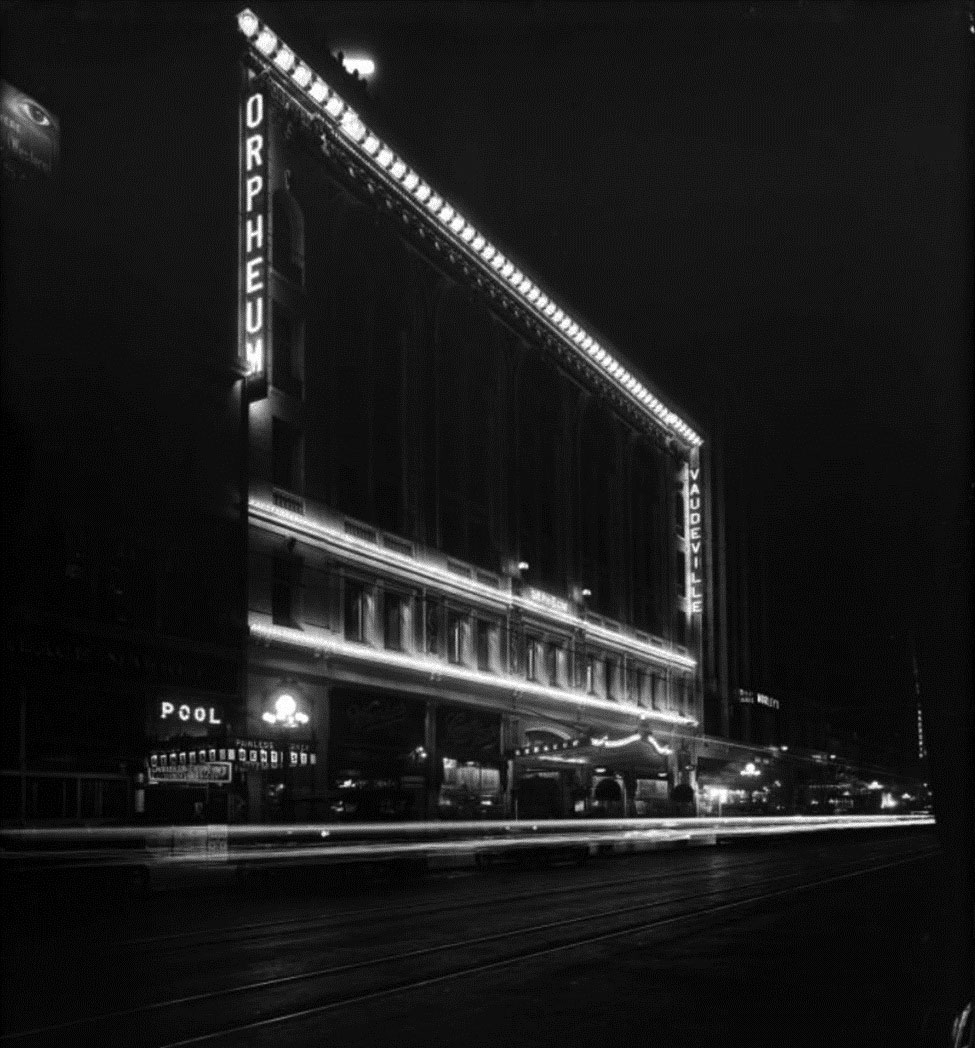 |
|
| (1913)#^* - A night photo of the Orpheum Theater, advertising Vaudeville. Located at 630 S. Broadway. |
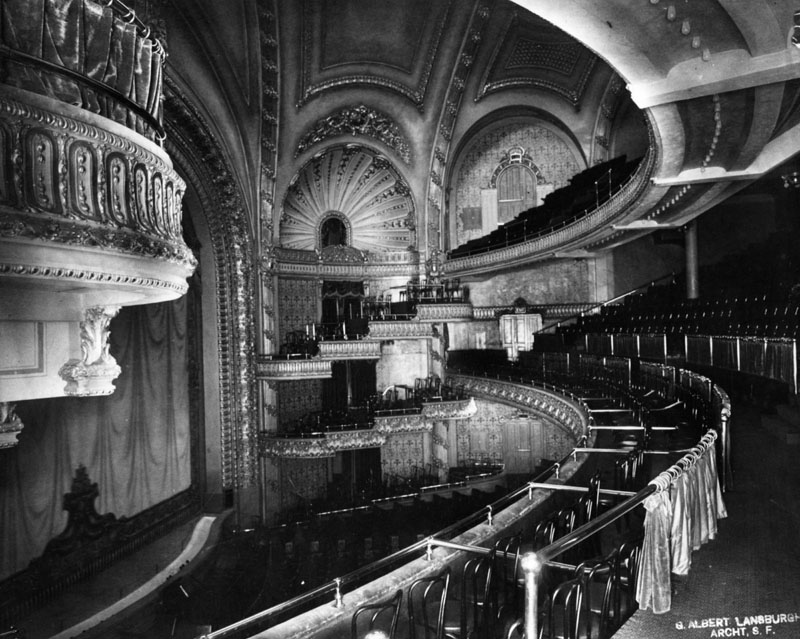 |
|
| (n.d.)* - The interior auditorium of the third Orpheum Theatre, looking across the balcony towards the box seats on the opposite wall. Another balcony is on the upper right and the stage on the left. |
Historical Notes The cheap seats in the upper balcony were actually benches. While terrific for vaudeville, the section is less desirable for film viewing and hasn't been used since the 1930s. Originally the entrance to the second balcony was from separate stairwells with no access to the rest of the theatre, typical of two balcony theatre construction at the time.**^ |
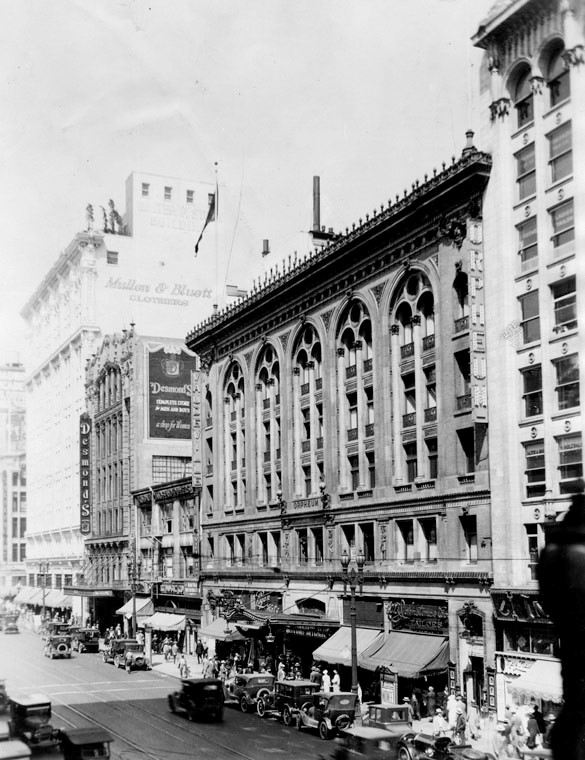 |
|
| (1933)* – View looking north on Broadway showing the 3rd Orpheum in Los Angeles, which opened June 26, 1911. |
Historical Notes On February 20, 1926 this theatre reopened as the Broadway Palace. The new Orpheum Theatre had opened down the street February 15, 1926. The Palace, as a film only operation, was still run by the Orpheum circuit into the summer of 1928. The Variety issue of August 18, 1928 had a little story titled "Orpheum Loses Lemon" noting it had been a big liability for the circuit since their new house had opened. The Palace was taken over by Harry Strere's Pacific Amusement Co., a firm that also operated the Rialto at the time. Sol Lesser, long involved with West Coast Theatres (soon to become Fox West Coast) was a minor stockholder in Pacific Amusement. By 1929, Fox West Coast was running the house, calling it the Fox Palace.**^ |
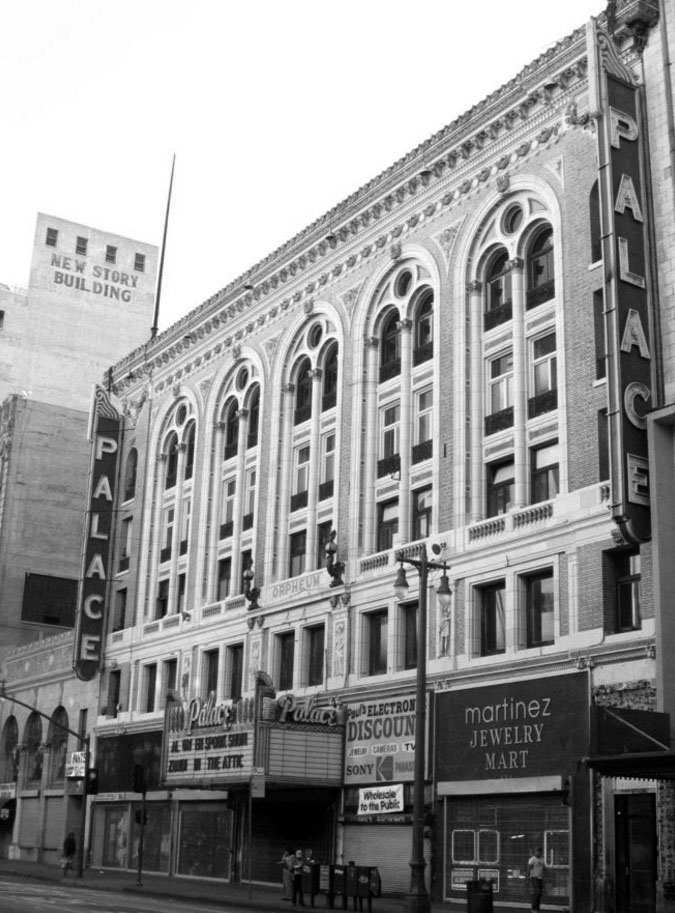 |
|
| (2007)**^ – View of the Palace Theatre located at 630 S. Broadway. Photo by Bill Counter. |
Historical Notes Today, the Palace is owned by the Delijani family. They also own the Los Angeles, State and Tower theatres. The theatre interests are operated by an entity known as the Broadway Theatre Group with Shahram Delijani heading the firm and Ed Baney as general manager. The Palace is currently available for theatrical productions, concerts, film shoots, and special events. |
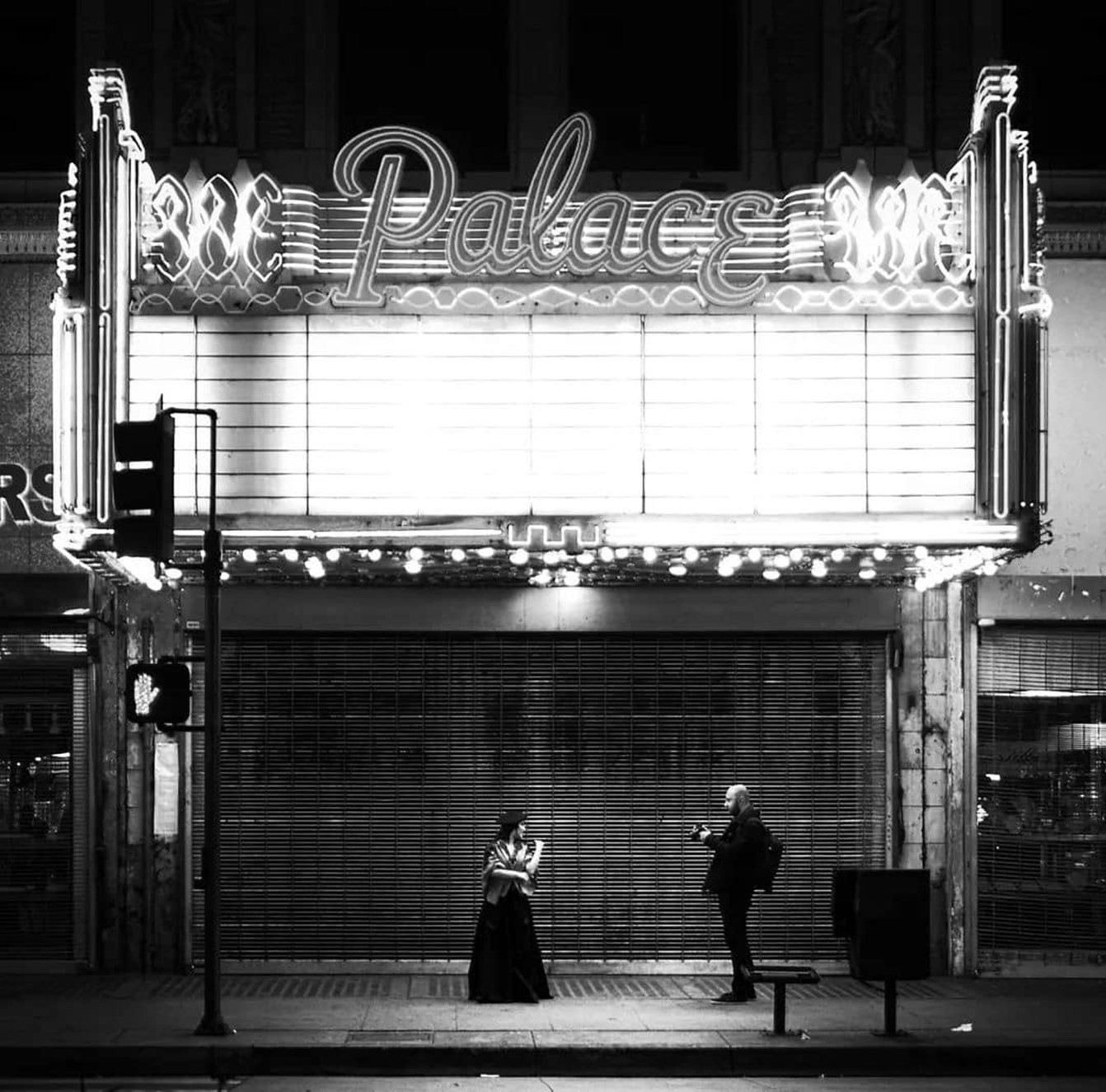 |
|
| (2010s) - Photo-op in front of the Palace Theatre, originally the Orpheum Theatre. |
Historical Notes The theatre unveiled a $1 million restoration to celebrate its 100th birthday on June 26, 2011. The restoration work was begun in 2007 with cleaning and facade repair of both the Palace and the Tower.**^ Click HERE to see contemporary view. |
* * * * * |
Liberty Theatre
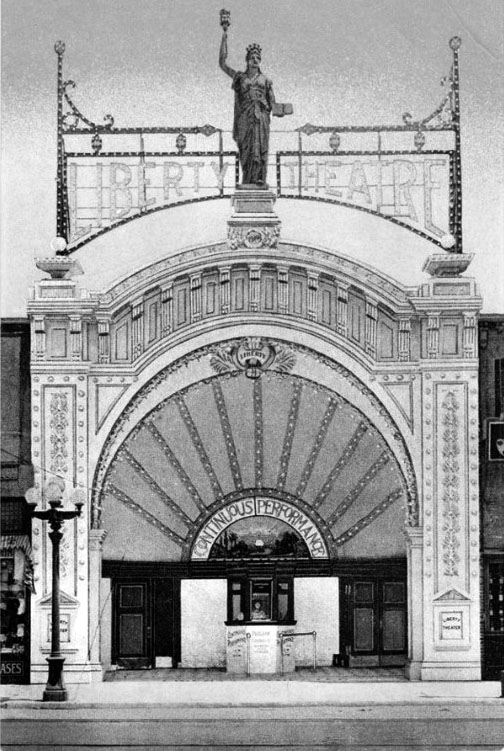 |
|
| (ca. 1911)#^*^ – Postcard view showing the Liberty Theatre located at 266 S. Main Street. |
Historical Notes Built in late 1910 and opened in 1911, the Liberty Theatre was designed by A. C. Martin (also designed the Million Dollar Theatre). The 540 seat theatre was constructed by the firm of P.J. Bolin and built for proprietors Kaiser, Sturm and Hughes.**^ |
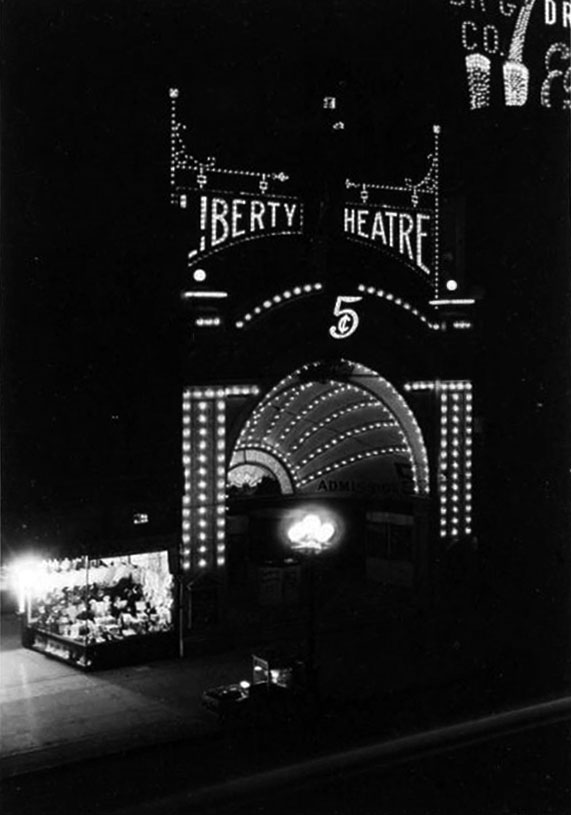 |
|
| (1912)*^*# – Night view showing the well-lit entrance to the Liberty Theatre. |
Historical Notes The building is described at length in the Moving Picture World article: The front facade is of stucco and plaster-covered brick, the paneling and cornices outlined in small electric lights at night. The gold leaf statue crowning the cornice is ten feet in height, and, symbolizing liberty, holds aloft an electric torch. At the base of the statue in a laurel leaf gilded shield is the date of erection, 1910. Below this, on the crown of the shell-shaped lobby ceiling, is a second shield in gold leaf with the theater name 'Liberty.' The theatre is showing four first-run licensed films, and one illustrated song, except on Saturdays and Sundays, when two songs are used. The theater employs ten people. Girl ushers look after the seating arrangements. Five cents admission is charged to all parts of the house.**^ |
.jpg) |
|
| (1929)**^** – View of the Liberty Theatre bookended by the Harris Hardware Company and the Gray Hotel. |
Historical Notes The Liberty Theatre at 266 S. Main Street closed by 1930. It is not to be confused with the Liberty Theatre at 136 S. Main Street which had the earlier names of Novelty Theatre and Chinese Theatre and operated into the 1950’s.^^^* |
.jpg) |
|
| (2015)#^^* – Google street showing the northeast corner of 3rd and Main streets and what’s left of the original Liberty Theatre Building. |
Historical Notes The triangular building remaining at 3rd and Main (seen above) is what's left of the Liberty Theatre. The angled deco facade is obviously grafted on to a much older building. The building now houses a wholesale merchandise distributor. The current address of the building is 103 E. 3rd St. as it no longer has much frontage (or an entrance) on Main St. The City Planning Department lists the building as being constructed in 1910 with substantial remodeling in 1926.**^ |
* * * * * |
Brock & Feagans Building
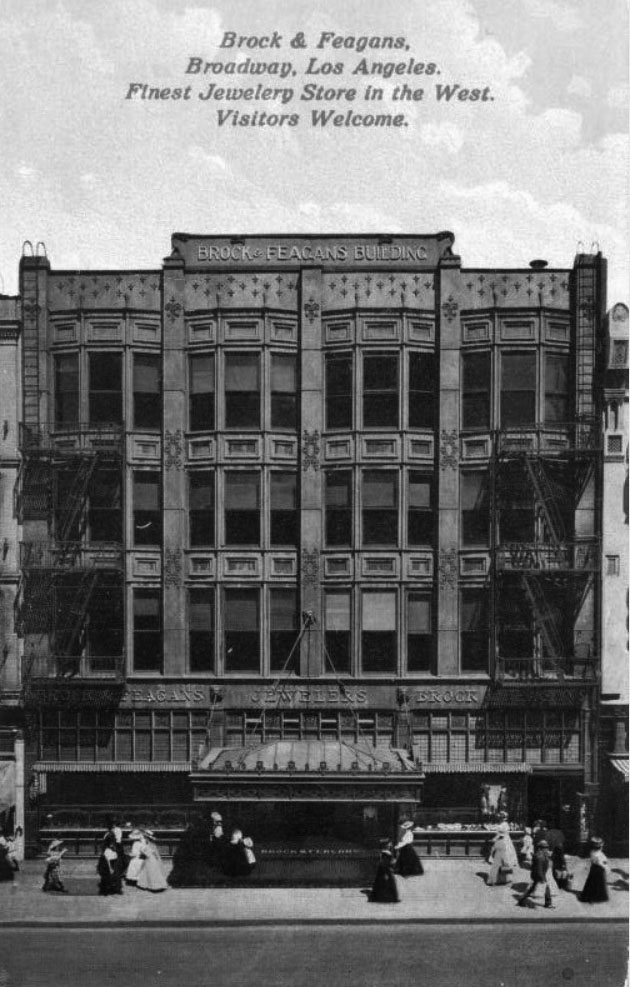 |
|
| (ca. 1910)^##^ – Postcard view showing the Brock and Feagans Jewelry Store located on the west side of Broadway between 4th and 5th streets. Sign on top facia reads Brock & Feagans Building. Click HERE for another street view. |
Historical Notes George E. Feagans was a jeweler from Illinois, and he established Brock & Feagans in the 1880s with a partner. After the partnership broke up, Feagans opened a new store in the Alexandria Hotel located at 5th and Spring streets. |
* * * * * |
The Yamato
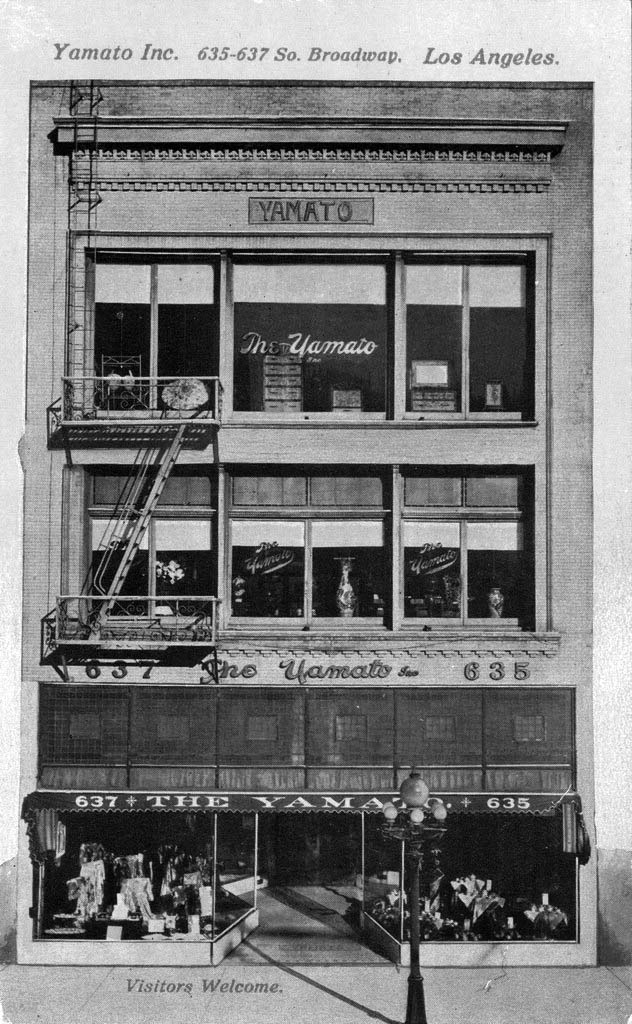 |
|
| (ca. 1910)^##^ – View of the Yamato Inc. store, located at 635-637 South Broadway in Downtown Los Angeles, showing furniture in the windows of the uppermost floor, vases in the second floor windows, and assorted goods on the ground floor. |
Historical Notes The Yamato, Inc., was a Japanese Bazaar that served tea and cake to customers, as early as 1908. One of its famous customers was female impersonator Julian Eltinge. In 1917, the three story building became Harry Fink & Co., an apparel store for women's clothing.^*^# |
* * * * * |
Five Points Building
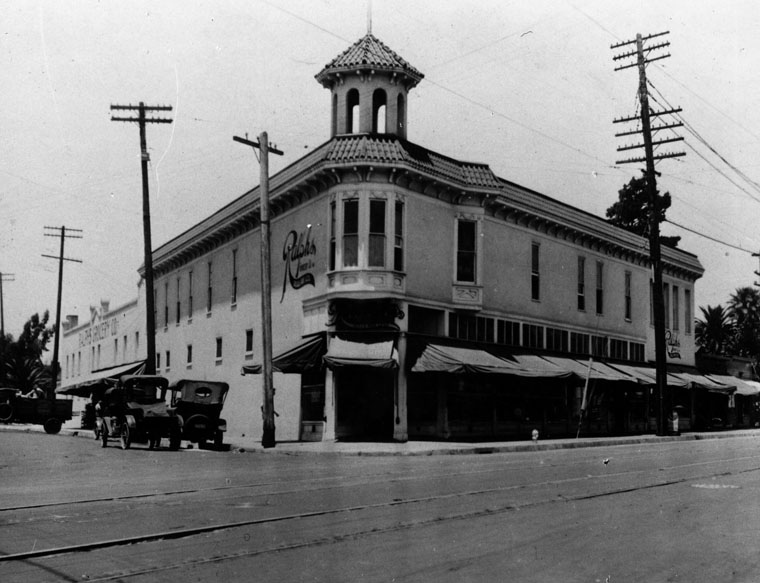 |
|
| (ca. 1911)* - Five Points Building at 2601 Pasadena Avenue, Lincoln Heights, housing at this time a Ralphs Market. |
* * * * * |
Lindley Building
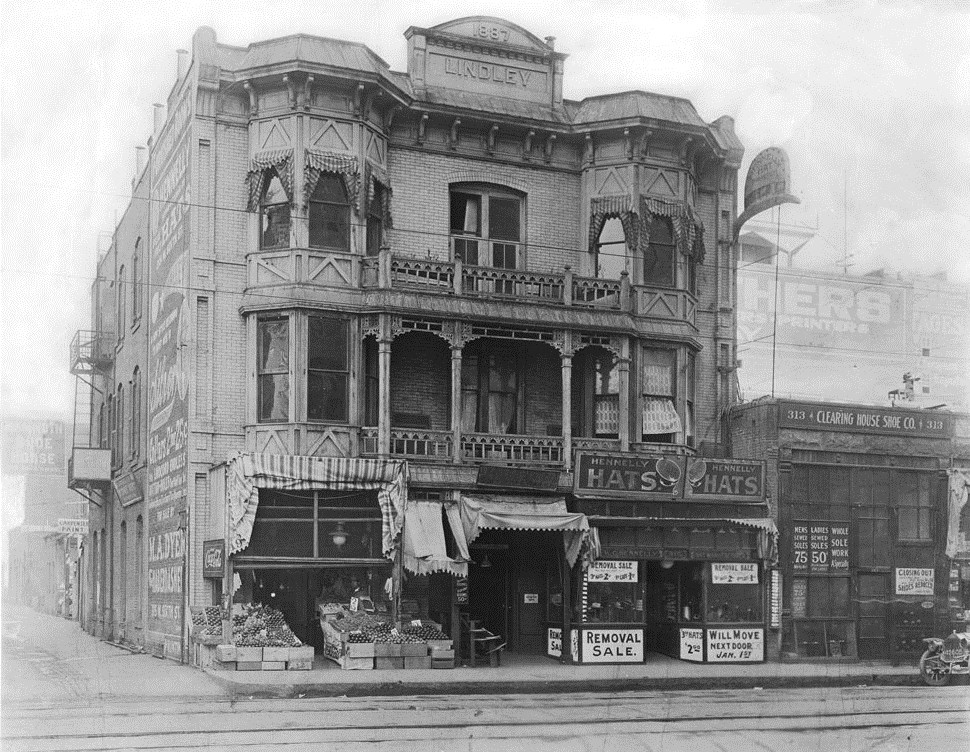 |
|
| (1912)^ - Exterior view of "The Lindley", a Victorian building on the corner of Sixth Street between Broadway and Hill Street. |
Historical Notes In 1887, Dr. Walter Lindley paid $1,825 for the property at 315 West Sixth Street in Los Angeles to open the first California Hospital. Known as Dr. Lindley’s Private Hospital, it had only 6-8 beds and served a carriage trade clientele. In 1898, Dr. Lindley conceived of a hospital owned and operated by physicians. He erected the first building especially designed for medical purposes in California at 1414 South Hope Street. California Hospital became known as the largest, best-equipped hospital west of Chicago entirely owned and operated by physicians and surgeons.^^^# |
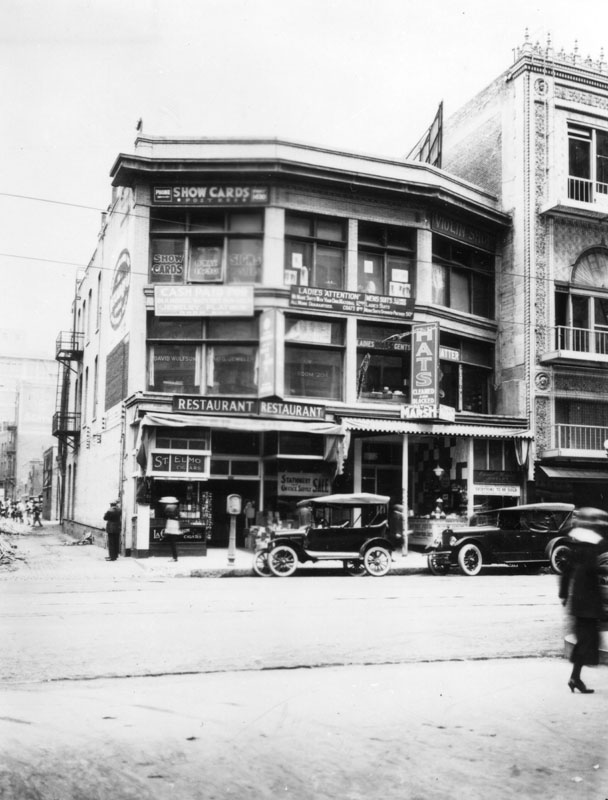 |
|
| (ca. 1920)* - Exterior view of the Lindley Building, with remodeled facade circa 1920. |
* * * * * |
Locke Hotel
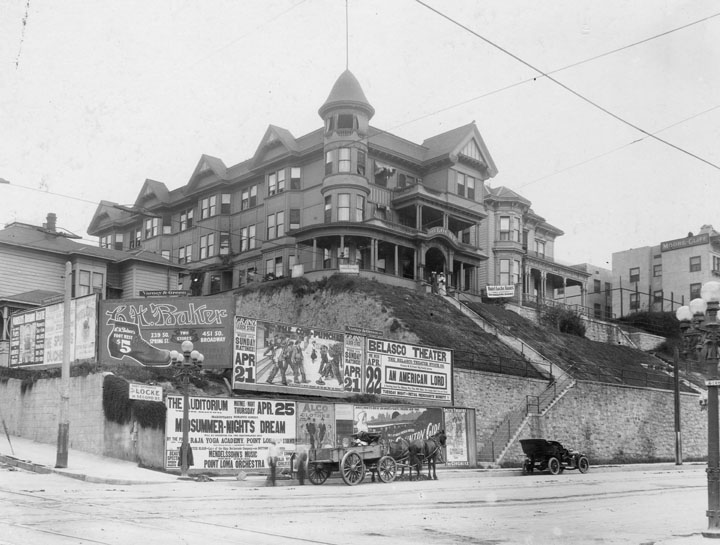 |
|
| (1912)* - Looking northwest across the intersection of 2nd and Hill Streets at the Locke Hotel at 139 S. Hill. 2nd Street runs up Bunker Hill to the left, Hill Street continues to the right toward the tunnels at 1st Street. The hotel & annex sit up on the hill while advertising placards are pasted all over the wall at street level. Ads for "Midsummer Nights Dream" at the Auditorium, "An American Lord" at the Belasco Theater, "G.H. Baker" shoes stories, can be seen. The Moore Cliff Hotel can be seen at the right edge just above the Five-Globe Llewellyn.*##^ |
* * * * * |
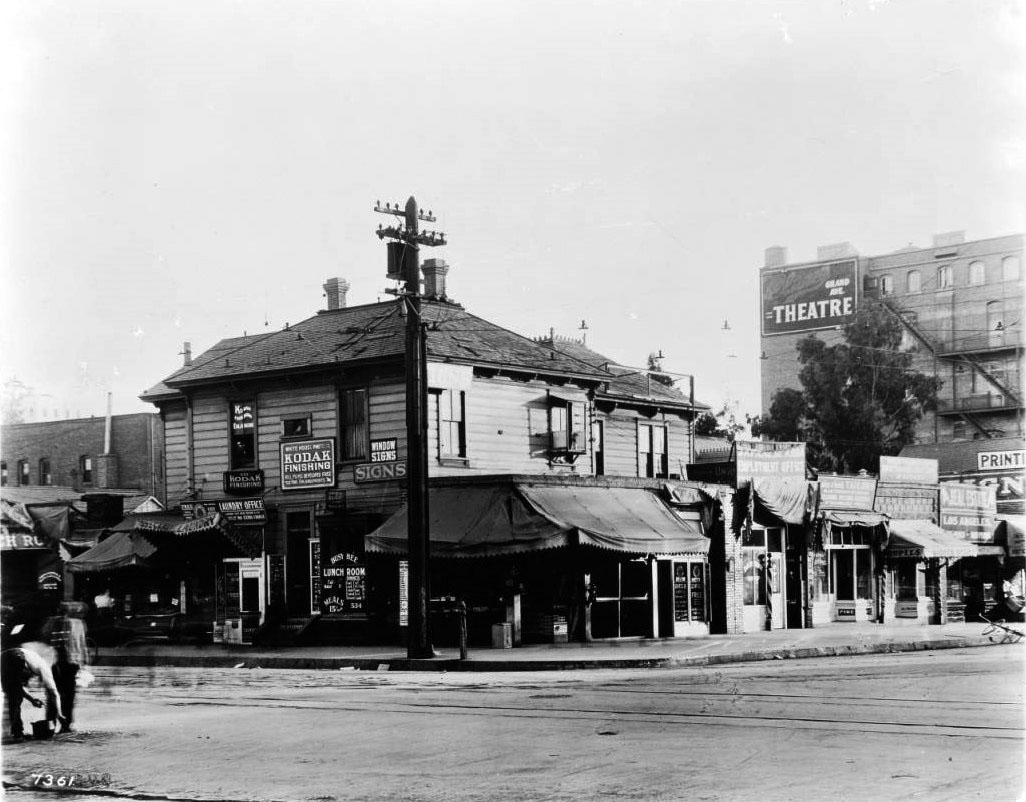 |
|
| (1912)^ - View of a shop on the southeast corner of 7th Street and Grand Street. The two-story shop with clapboard veneer stands is riddled with signs. A cloth canopy extends from its right side, where more shops continue down the sidewalk. Sign on the window reads: “Busy Bee Lunch Room / Fish Halibut 15¢ / Dinner Roast Beef 15¢ Lamb Pot-Pie 15¢ Baked Beans 15¢ Braised Beef 15¢ Stewed Lamb 15¢ / Meals 15¢ and Up" |
* * * * * |
Los Angeles Athletic Club
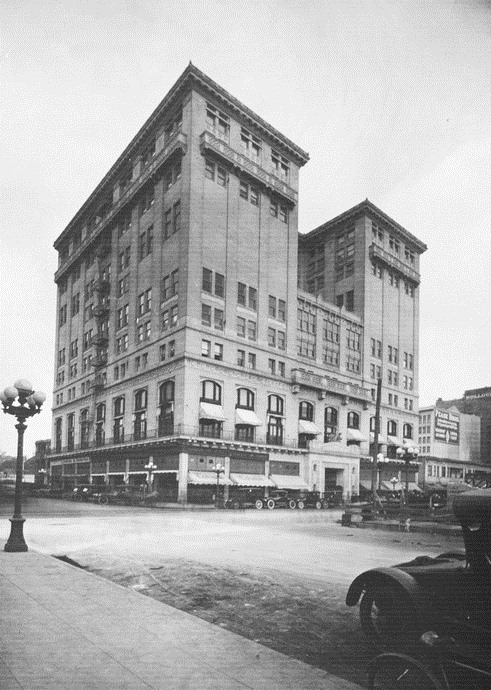 |
|
| (ca. 1912)*^^ - The Los Angeles Athletic Club located on the northeast corner of 7th and Olive at 431 West 7th Street. |
Historical Notes In 1911, construction on a new club building began at Seventh and Olive Streets on the site of the former Hotel Baltimore. John Parkinson and Edwin Bergstrom were the architects. The Beaux Arts building stands twelve stories tall and features pressed brick with a trim of terra cotta. The Los Angeles Athletic Club opened its gym in 1912.***# |
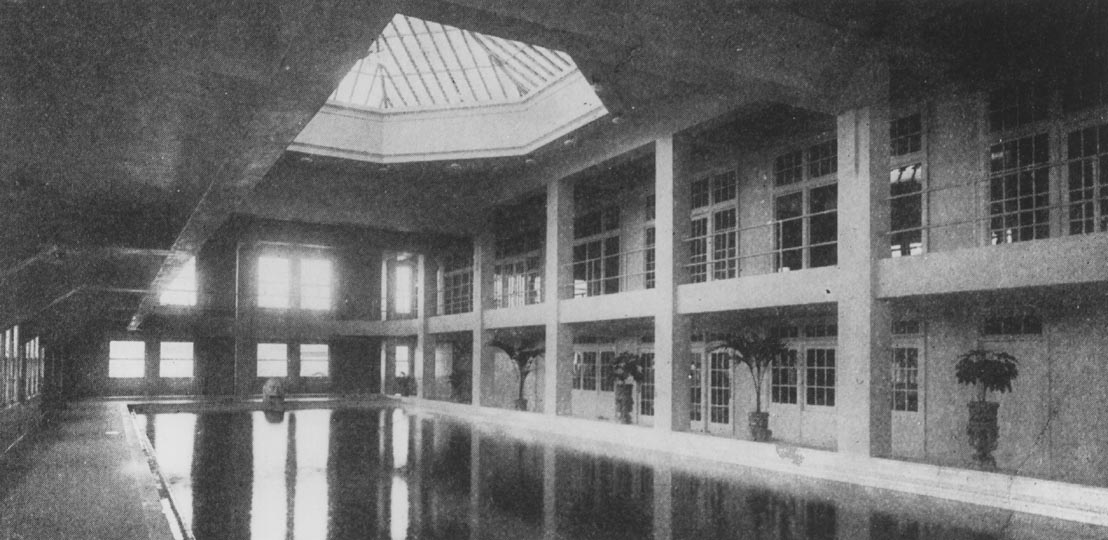 |
|
| (2007)***# - Interior view of the Los Angeles Athletic Club's swimming pool. |
Historical Notes The Los Angeles Athletic Club building was notable at the time for being the first building in Southern California to have a swimming pool on an upper floor. Click HERE to see contemporary view. |
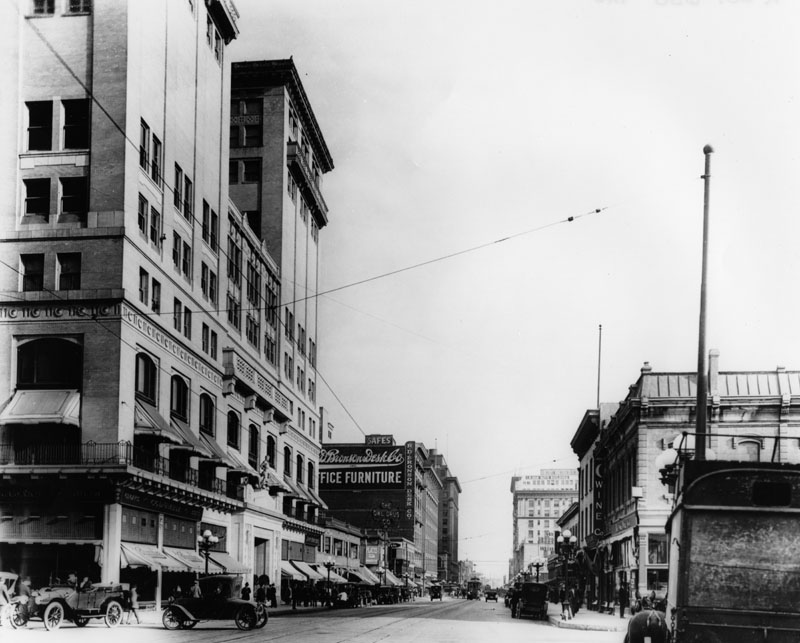 |
|
| (ca. 1912)* - View looking east on 7th Street at Olive Street. The large building to the left is the Los Angeles Athletic Club. |
Historical Notes The Los Angeles Athletic Club (LAAC) was formed back in 1880, its first president being James B. Lankershim, its first headquarters in the Arcadia Building on Spring Street. For most of the decade it was the on the Downey Block, after which it relocated to South Spring Street, first at 226, then at 523 ½. Some of its earlier day members included Harrison Gray Otis, Harry Chandler, Eli Clark, Moses Sherman, Henry Huntington, Edward L. Doheny, Charles Canfield, Senator Stephen White, and Mayor Fred Eaton.***# |
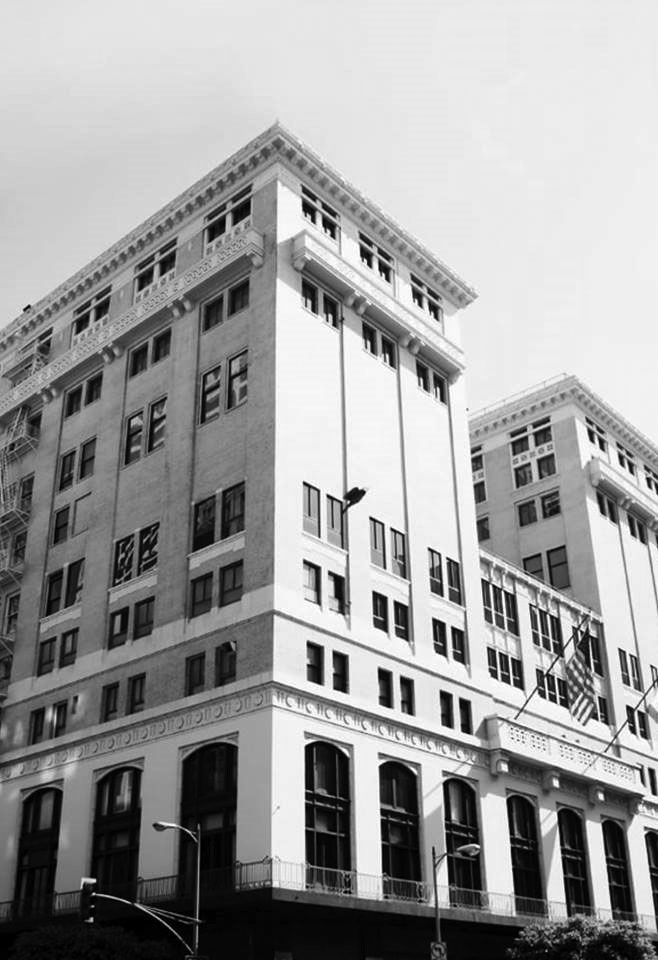 |
|
| (2019)* – View showing the Los Angeles Athletic Club building as it appears today. Photo courtesy of Ray Darluv |
Historical Notes In 1970, the LA Athletic Club Building was designated Los Angeles Historical-Cultural Monument No. 69 (Click HERE to see complete listing). |
* * * * * |
Automobile Club of Southern California
.jpg) |
|
| (1912)* - Auto Club Headquarters, located on the northeast corner 8th and Olive streets. A group of people look on as two men sit in an early model car and pose for the camera. Note that the car is a 'tricycle car' (aka 'trike'). |
Historical Notes The Automobile Club of Southern California is a nonprofit organization founded in 1900 by a group of 10 automobile enthsiasts. Its purpose, in addition to providing a social organization, was to encourage the construction and maintenance of roads suitable for automobile travel, and to protect the interests of automobile owners and drivers. In its early years, the club's first headquarters were rented at 307 O.T. Johnson Building. They remained in that space for approximately two years, but beginning in 1909, the club's rapid growth necessitated a series of moves to larger and larger offices. In 1909, they moved to 323 South Hill Street, and again to 754 South Hill Street in 1910. They relocated again in 1911 to the northeast corner of 8th and Olive Streets, where they remained until 1914, when the club built a completely new facility at 1344 South Figueroa Street. Click HERE to see current headquarters (Figueroa and Adams). Interesting Auto Club Facts: 1900 - The Auto Club was founded. Within a few years, 13 southern counties in California became the Auto Club’s service territory. |
.jpg) |
|
| (1912)* – Close-up view of two men sitting in a car and posing for the camera in front of the Automobile Club Headquarters, 8th and Olive streets, NE corner. |
Historical Notes In 1920, the club recognized that they would continue to need more space, and authorized the purchase of property at the southwest corner of Adams and Figueroa Streets, using funds acquired from the insurance plans offered by the club. The building was designed by architect Sumner P. Hunt in a Spanish baroque style, and was completed in 1923. It became their final headquarters, although it was expanded to double its original size by 1931. |
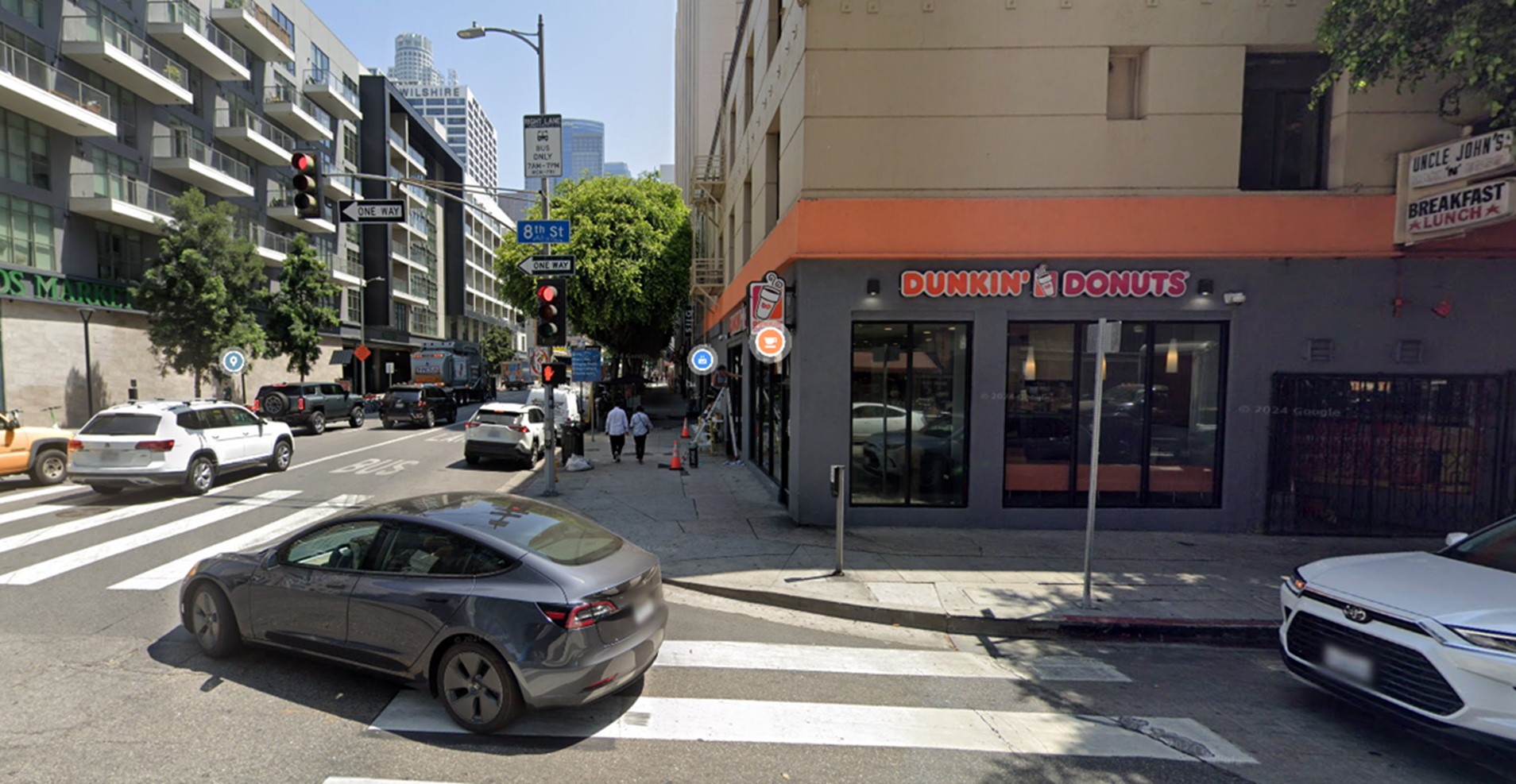 |
|
| (2024)* - View looking at the northeast corner of Olive and 8th Streets, currently the location of Dunkin' Donuts. |
Historical Notes When the Auto Club moved out of the ground floor of the Olive Hotel, it became a succession of restaurants and bars until, in the late 30s, when it became the Crown Grill Cocktail Lounge, reportedly a popular watering hole for the up-and-comers and down-and-outers of the south civic center. Some sources say it is into the Crown that Elizabeth Short appeared on the night of her murder. It is a persistent story which is not supported by the police investigation nor by Larry Harnisch who, is the preeminent authority on the Black Dahlia case. In any event, the Crown Grill Cocktail Lounge lasted into the 60s and is now a Dunkin Donuts. The Olive Hotel is still in business on the upper two floors. And Elizabeth Short's murder remains unsolved. |
Then and Now
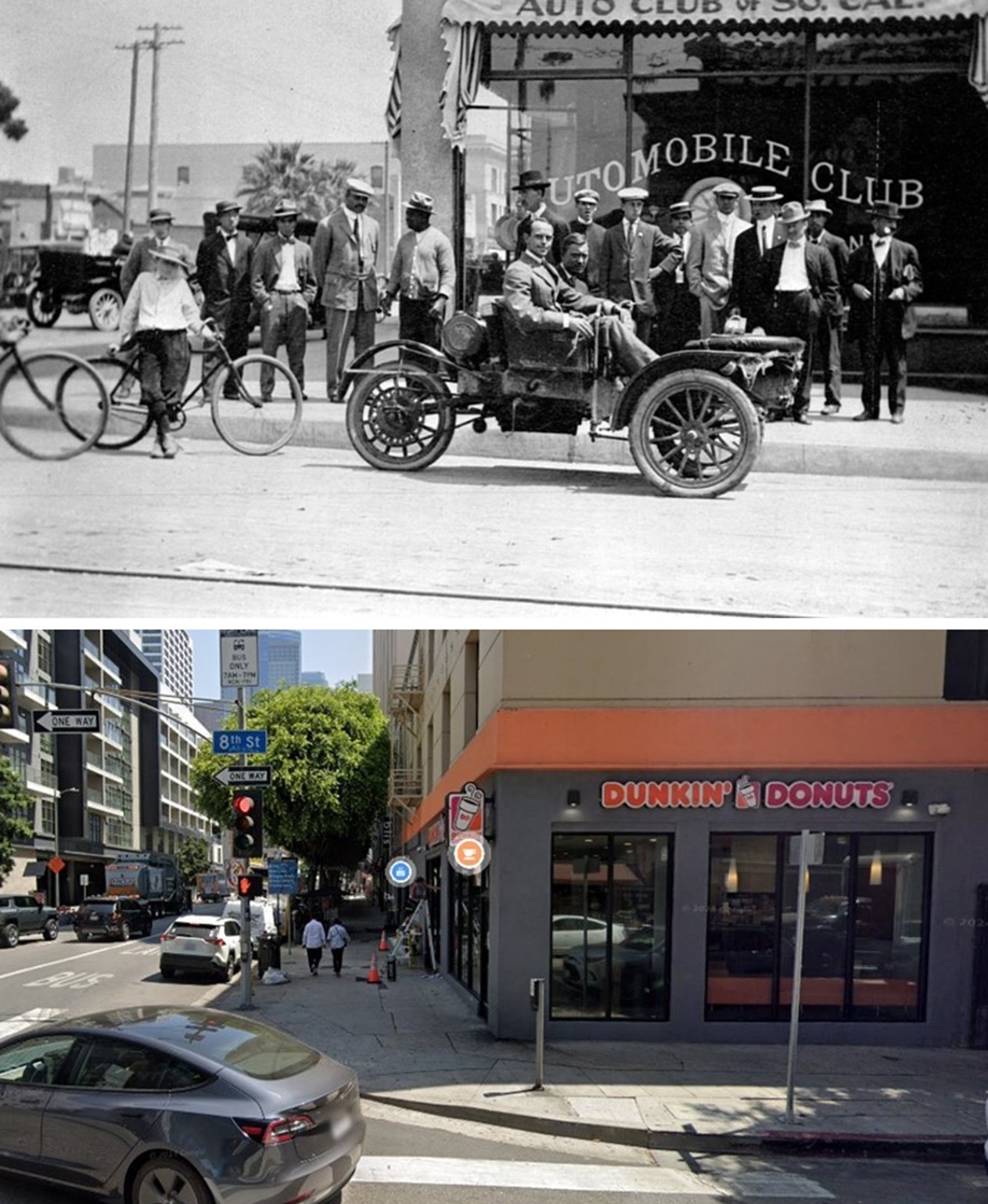 |
|
| (1912 vs. 2024)* - A 'Then and Now' view of the northeast corner of Olive and 8th Streets showing the Auto Club Headquarters, today the location of Dunkin' Donuts. |
* * * * * |
Water Department's Original Building
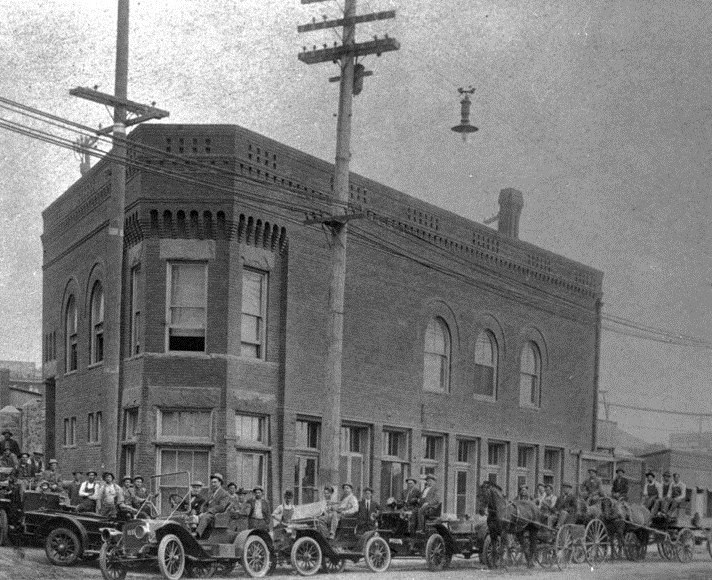 |
|
| (ca. 1912)** - Construction crews in cars and horse-drawn wagons in front of the City's first Water Department building located on the northwest corner of Marchessault and North Alameda streets (across from where Union Staion stands today). |
Historical Notes In 1868, the City of Los Angeles approved a franchise water agreement on a 30 year lease basis with the private Los Angeles City Water Company. In 1899, after the end of the lease, a $2.09 million bond measure for the purchase of LA City Water Co.’s system was approved by city voters by a margin of nearly eight to one. After over two years of litigation the City of Los Angeles finally regained control of its water system on February 13, 1902. A new department was created called the Los Angeles Water Department. Click HERE to see more in Water in Early L.A. |
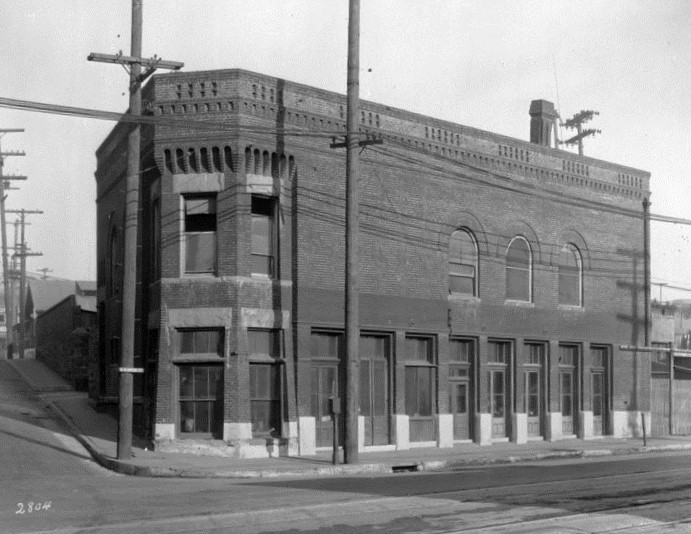 |
|
| (1920s)**- View looking at the northwest corner of Marchessault and Alameda street showing the first home of the Los Angeles Water Department (later DWP). |
Historical Notes The two-story brick building which in 1902 was large enough to house the entire executive and clerical forces of the water works soon was outgrown and the municipal Water Department would move into larger quarters (440 S. Hill Street). As both the City and the utility continued to grow, the Water Department (later DWP) would move several more times until settling into their current home (GOB) in 1965, located at 111 N. Hope Street. Click HERE to see more in Construction of the GOB |
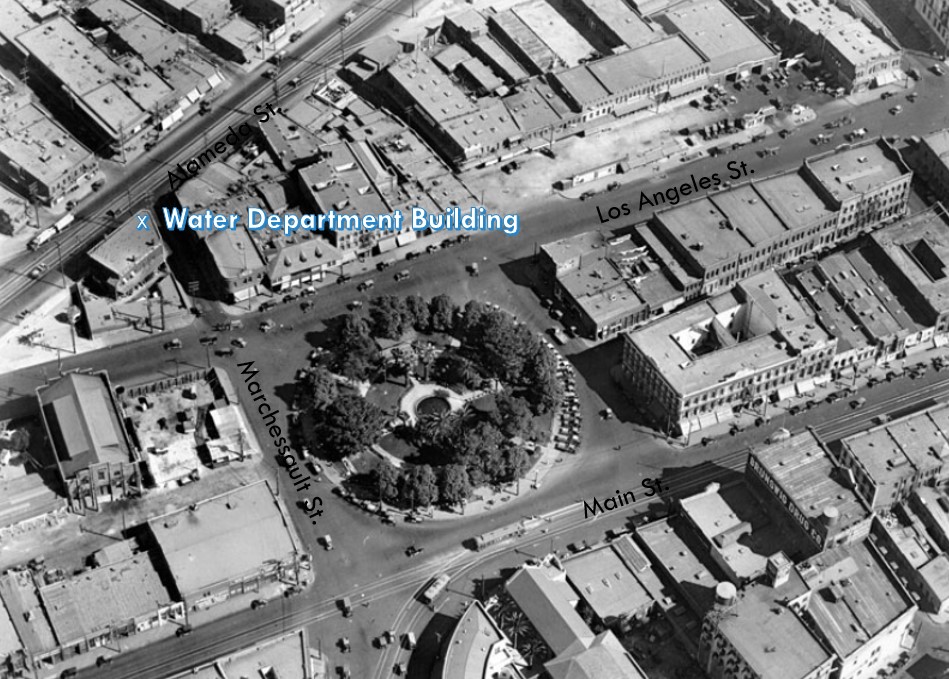 |
|
| (ca. 1924)* - Aerial view of the Los Angeles Plaza and surrounding area annotated to show the Water Department's original building. |
Click HERE to see more in Water Department's Original Office Building |
* * * * * |
El Pueblo Plaza Subtation
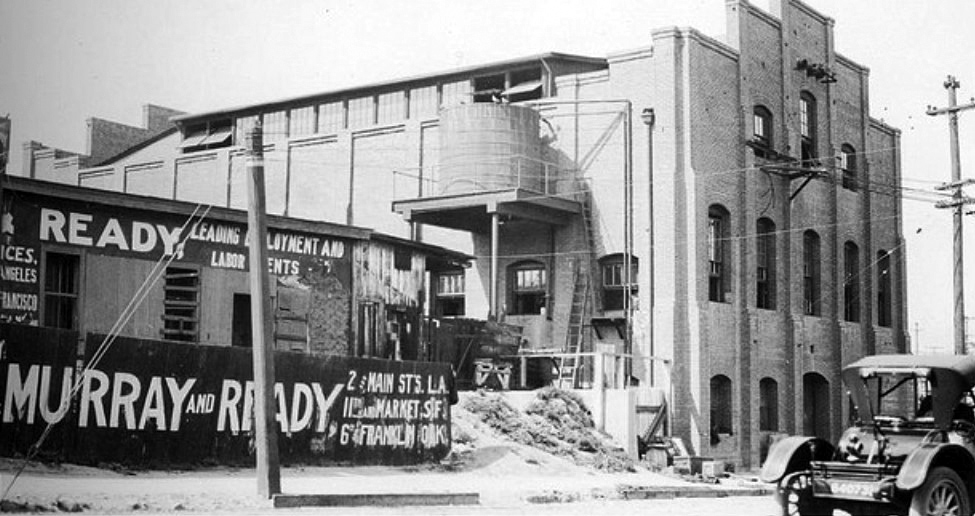 |
|
| (1913)#^** – View of the Los Angeles Railway (LARy) Plaza Substation (Eastside). The other side of the substation building fronts Olvera Street and is adjacent to the Avila Adobe. |
Historical Notes Built in 1903-1904, the Plaza Substation was the first and largest of fourteen substations that supplied electric power to the Los Angeles Railway Company’s yellow streetcars – the first mass transportation for Los Angeles. It was built by Henry Huntington, owner of the Los Angeles Railway Company. The trolleys operated from 1896 to 1960.+^ |
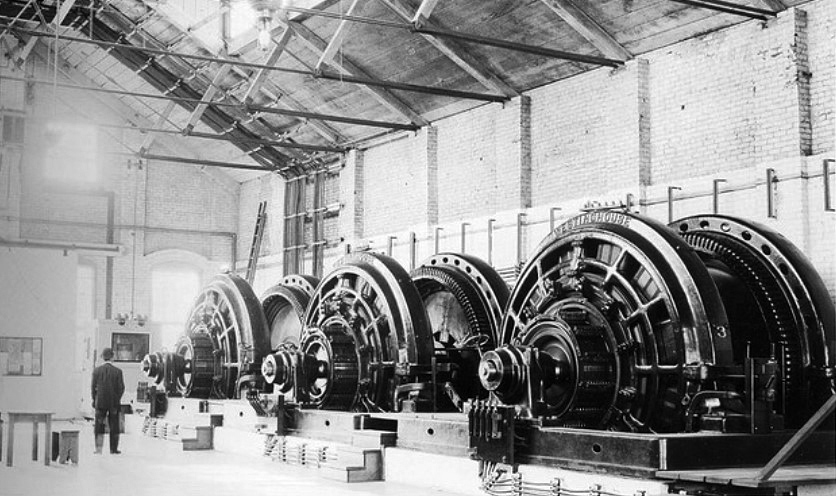 |
|
| (1913)#^** – Interior view of the Plaza Substation showing three motor-generator sets used to provide electricity for the Los Angeles Railway (LARy). |
Historical Notes In May 1903, Henry Huntington, owner of the Los Angeles Railway, announced plans to build a new substation near the old plaza. The Los Angeles Times reported: "Another mammoth electricity substation is to be constructed by the Los Angeles Railway Company. Its location will be on the Plaza, and its completion will mean a long step forward toward the perfection of a system that already is surpassed by few in this country." The substatin was operating by 1905.^ |
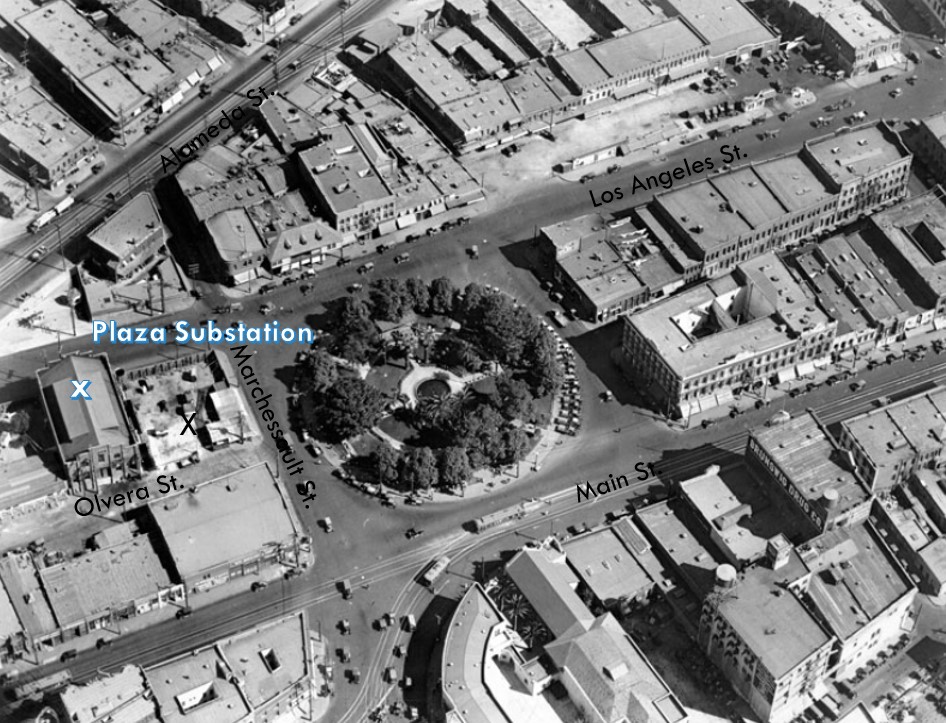 |
|
| (ca. 1924)* - Aerial view of the Los Angeles Plaza and surrounding area annotated to show location of the El Pueblo Plaza Substation. |
Historical Notes The substation is one of the two buildings in the Los Angeles Plaza Historic District that is itself separately listed in the National Register of Historic Places, having been so listed in September 1978 (The Avila Adobe is the other).^ |
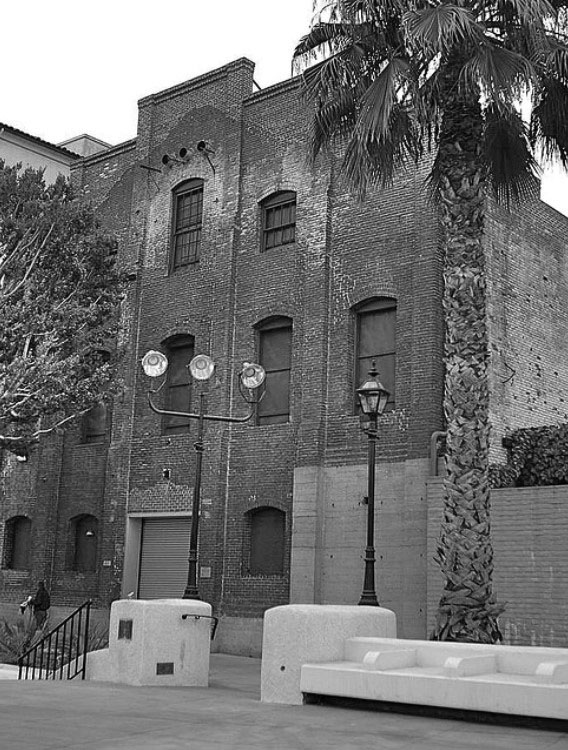 |
|
| (2006)+^ - View showing the front of the El Pueblo Plaza Substation as it appears today. |
Historical Notes After being threatened with demolition in the 1970s, the Plaza Substation was added to the National Register of Historic Places in 1978. Plans now call for the building to become a museum on Los Angeles trolley cars.+^ |
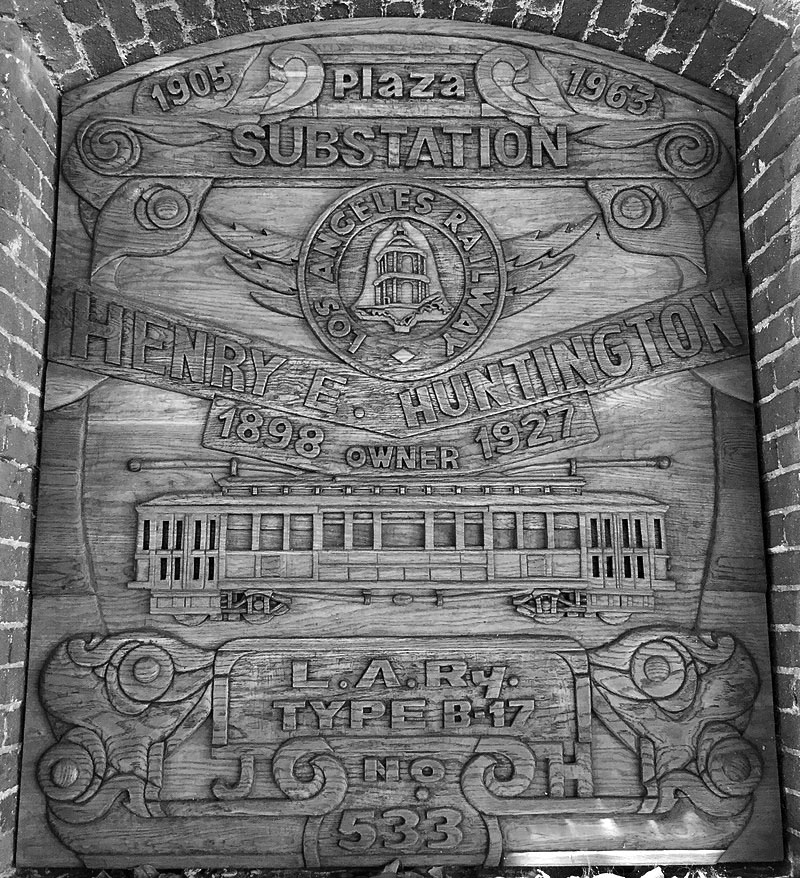 |
|
| (2018)^* - Hand-carved window carving at the Plaza Substation on Olvera Street. |
Click HERE to see more Early Views of the Los Angeles Plaza |
* * * * * |
Beverly Hills Hotel
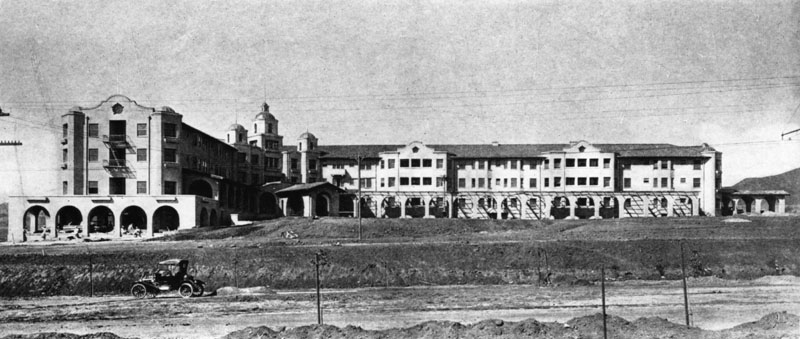 |
|
| (ca. 1912)* - Exterior view of the Beverly Hills Hotel across an unpaved Sunset Boulevard. Workers appear to be putting the finishing touches on the western wing, and the front lawn has yet to be landscaped. This Mission style complex was designed by architect Elmer Grey. |
Historical Notes In September, 1911, work began on the Beverly Hills Hotel. It was opened on May 12, 1912 by Margaret J. Anderson and her son, Stanley S. Anderson, who had been managing the Hollywood Hotel. The LA Times would call it a "monster hostelry" since it cost $300,000. At the time, lots in the area were selling for around $2,000 each.^* From 1928 to 1932, the hotel was owned by the Van Noy Railway News and Hotel Company. Its strict resident owner from 1954 until his death in 1979 was former Detroit real estate magnate Ben L. Silberstein, who took it over from Hernando Courtright, later hotelier at the Beverly Wilshire Hotel. Some of the hotel's owners have been celebrities: Irene Dunne, Loretta Young, and currently Sultan of Brunei.^* |
.jpg) |
|
| (ca. 1914)^ – View showing the Beverly Hills Hotel from the end of its main driveway which is lined by small palm trees. |
Historical Notes Two years before Beverly Hills became an incorporated city, the Beverly Hills Hotel opened on May 12, 1912; the hotel initially included the main building and twenty-three separate bungalows in the Mediterranean Revival style, designed by Elmer Grey.* |
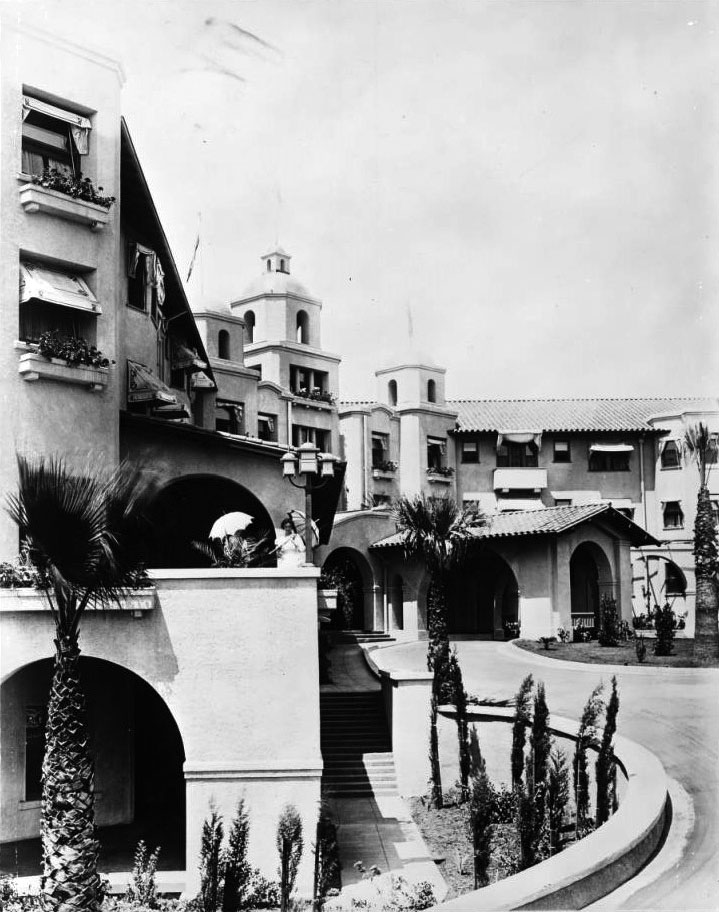 |
|
| (ca. 1918)^ – Close-up view of the entrance to the Beverly Hills Hotel, shown from the left edge of the building. The entrance is pictured in the background to the right, an open-air arcade leading to the front door of the large Spanish Colonial Revival building. |
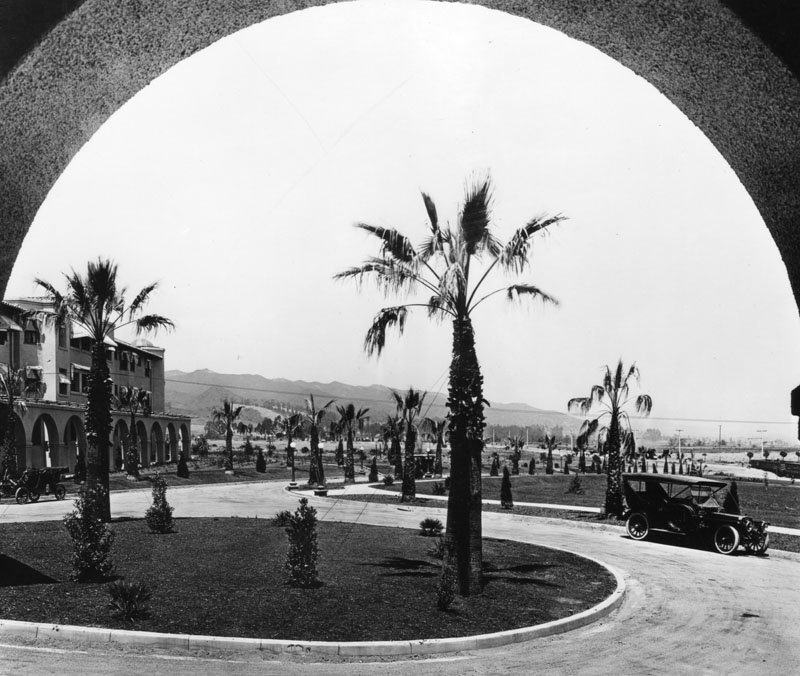 |
|
| (ca. 1918)*^^ - View of the circular driveway in front of the Beverly Hills Hotel. Palm trees abound. |
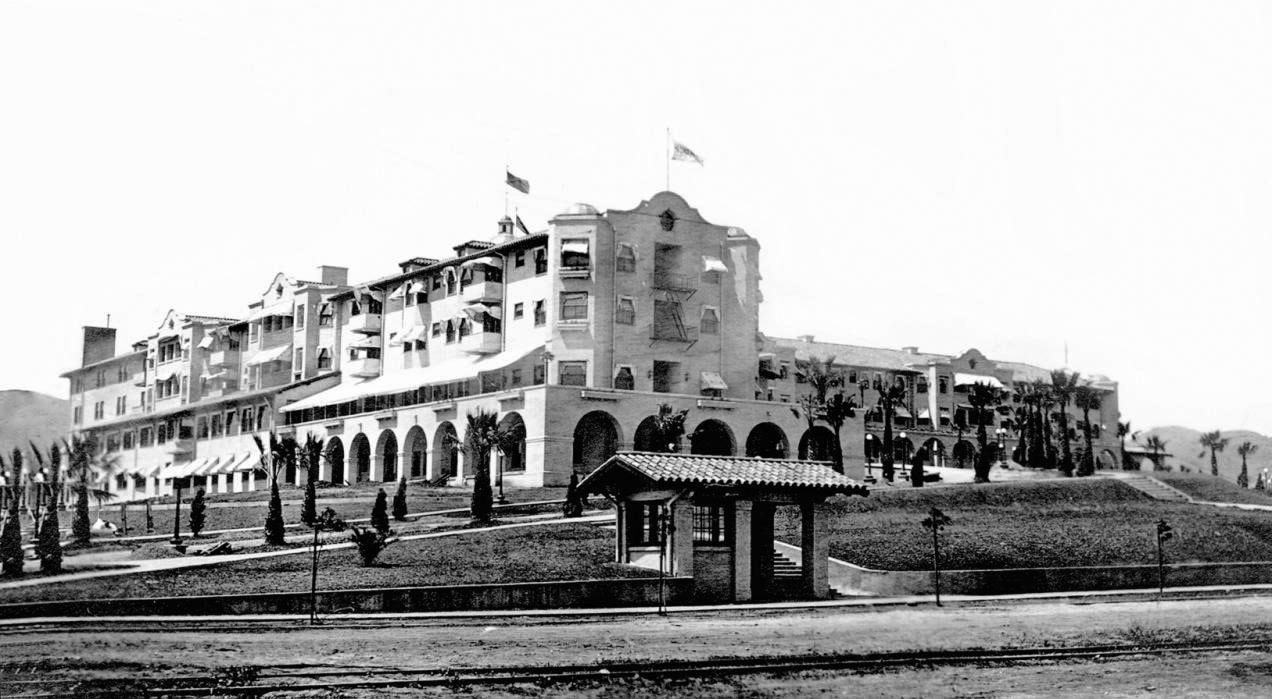 |
|
| (ca. 1918)* - Close-up view of the Beverly Hills Hotel with Pacific Electric station on Sunset Boulevard in the foreground. |
Historical Notes A one-trolley car system known as the “Dinky” conveyed guests from a Pacific Electric station at the southwest corner of Santa Monica Boulevard and Canon Drive up Rodeo Drive to the Hotel. |
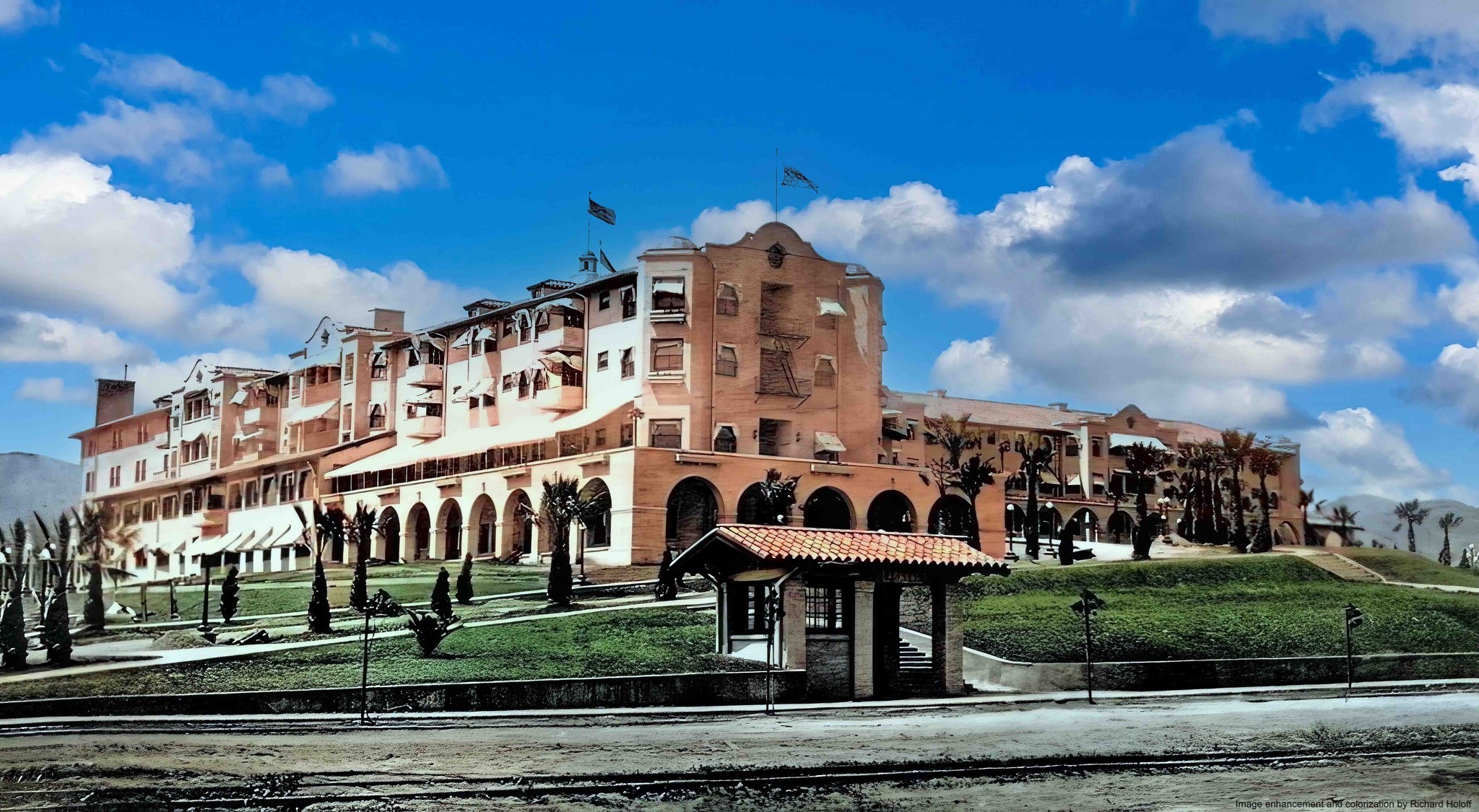 |
|
| (ca. 1918)* - Close-up view of the Beverly Hills Hotel with Pacific Electric station on Sunset Boulevard in the foreground. Image enhancement and colorization by Richard Holoff. |
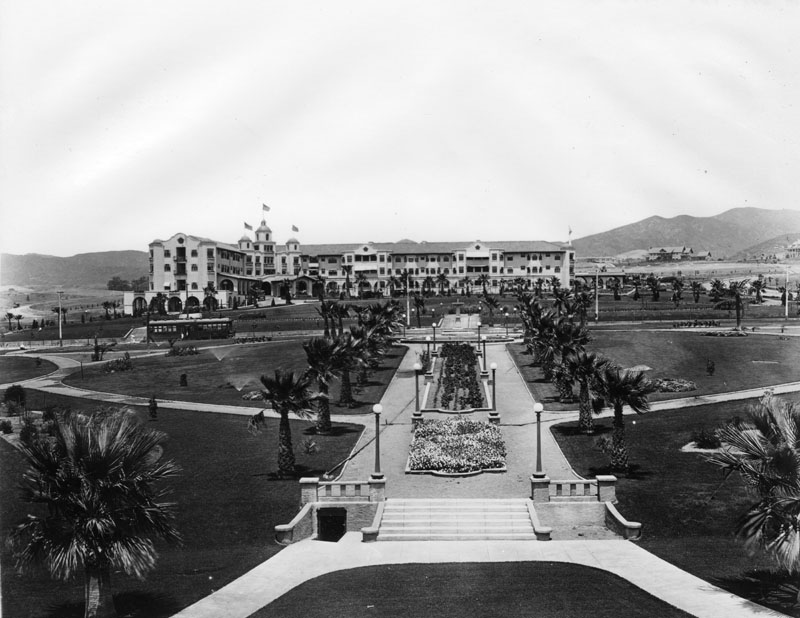 |
|
| (ca. 1918)^ - View of the newly Will Rogers Memorial Park (then called Sunset Park) in front of the Beverly Hills Hotel, designed by Elmer Grey. Neither has mature landscaping at this time. Note the streetcar trolley at center-left. |
Historical Notes Will Rogers Park opened in 1915 as the first municipal park in the Beverly Hills, at that time called Sunset Park. In 1926, entertainer Will Rogers was appointed first "Honorary Mayor" of Beverly Hills and, in 1952, the City renamed the Park, Will Rogers Memorial Park.**^^ |
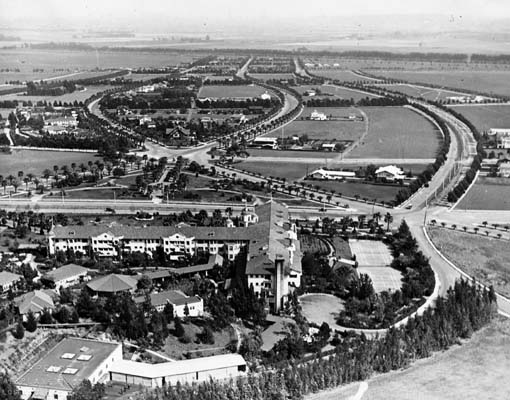 |
|
| (1921)* - Aerial view looking south from a vantage just above the Beverly Hills Hotel showing wide areas of open land in the background. |
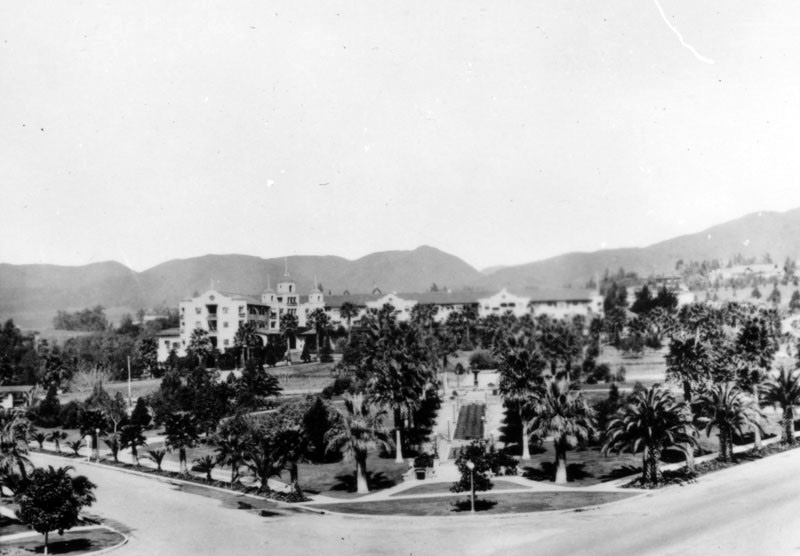 |
|
| (ca. 1924)* - View of the grounds of the Beverly Hills Hotel with the Will Rogers Park, shown in the foreground. |
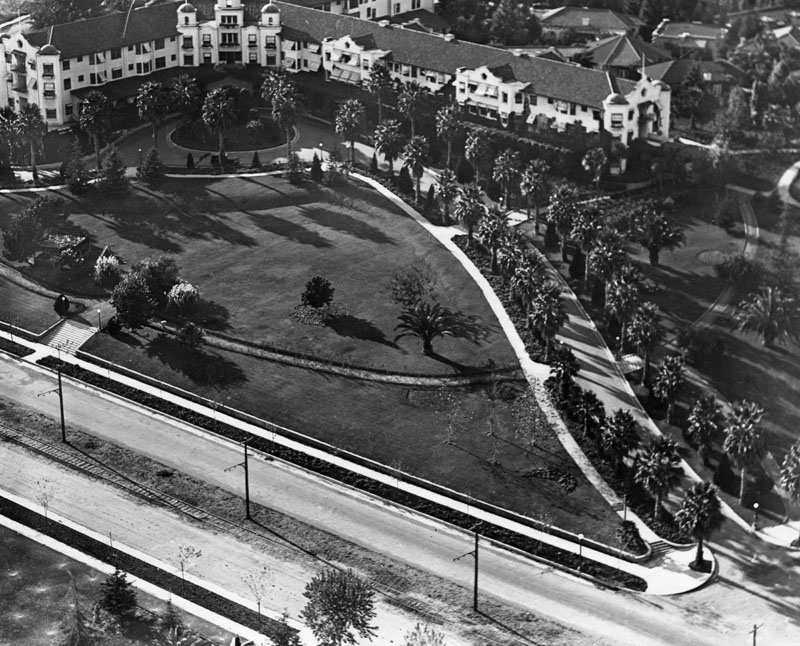 |
|
| (1924)* - Aerial view of the Beverly Hills Hotel and grounds, located at 9641 West Sunset Boulevard. Sunset Blvd. is at bottom of photo. Railroad tracks can be seen running parallel to Sunset. |
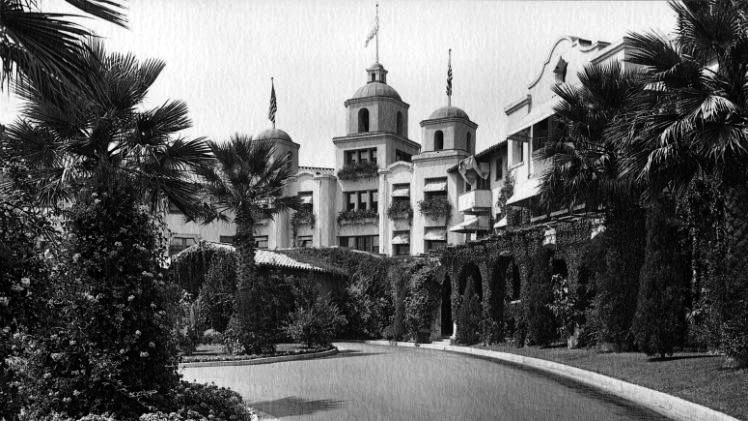 |
|
| (n.d)* - View showing the front entrance to the Beverly Hills Hotel. |
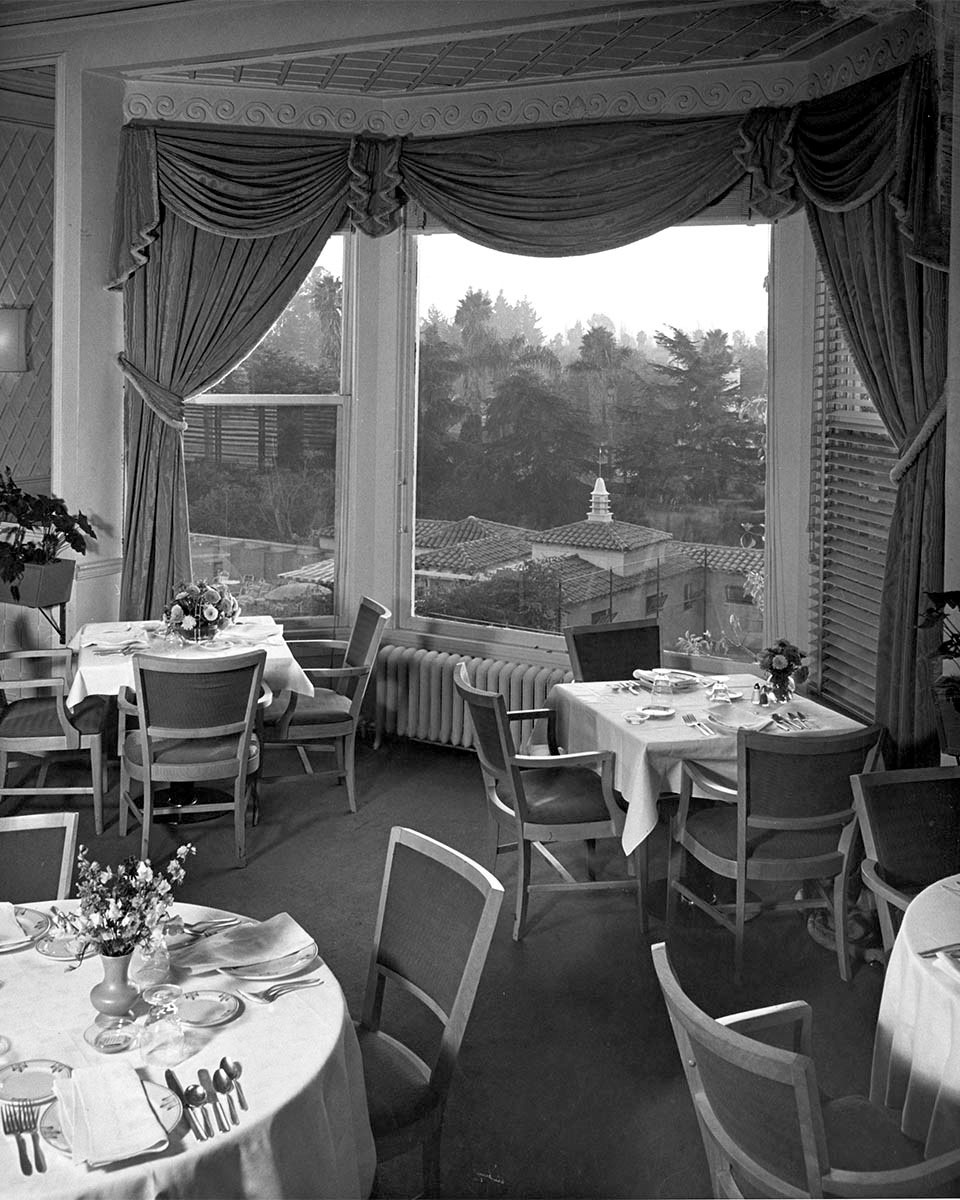 |
|
| (1947)*++ – Dining room with a view at the Beverly Hills Hotel. Photo by Julius Shulman |
 |
|
| (ca. 1980)* - Entrance to the Beverly Hills Hotel, at a point where a new wing was added in the 1940's. Palm trees decorate both sides of the road leading to the entrance of the hotel on Crescent Drive and Sunset Boulevard. Directly behind the hotel sits the huge mansion of late newspaper mogul William Randolph Hearst. |
Historical Notes In the 1940s, a new wing was added to the east side of the main building. Eighty years after it opened, the hotel closed for two and a half years for a complete restoration.* |
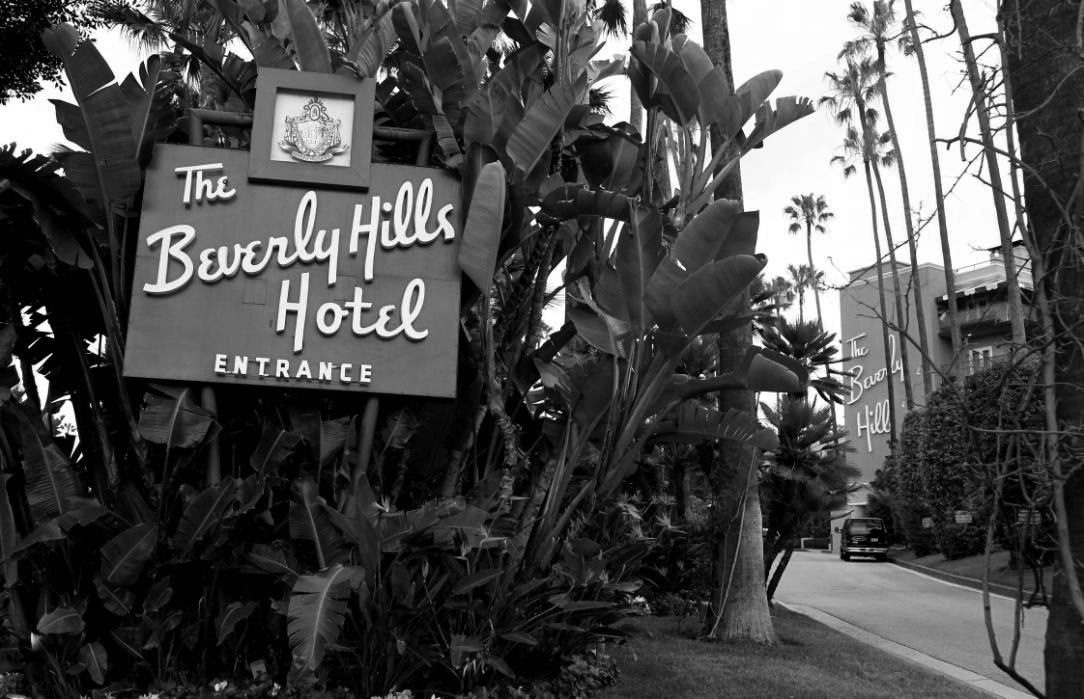 |
|
| (2012)* – View showing the entrance to the Beverly Hills Hotel on its 100 year anniversary. Photo by Matt Sayles |
Historical Notes The hotel was named the first historic landmark in Beverly Hills on September 12, 2012.* Click HERE to see more in Early Views of Beverly Hills. |
* * * * * |
Magic Castle (aka 'Holly Chateau' or Rollin Lane Residence)
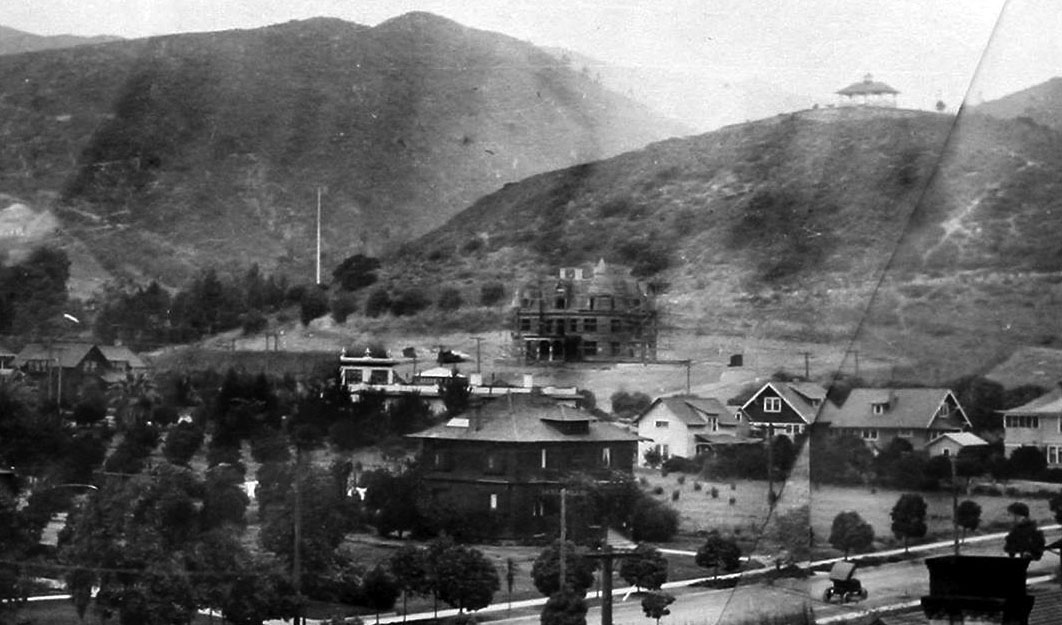 |
|
| (1909)^.^ - View looking northwest from a rooftop near the Hollywood Hotel showing the Rollin Lane house (aka Holly Chateau) under construction in the foothills just above Franklin Avenue. Orchid Avenue, with early model car on it, is seen at lower right. |
Historical Notes The Chateau-style residence was built in 1909 by banker, real estate developer and philanthropist, Rollin B. Lane. The house was designed by architects Lyman Farwell and Oliver Dennis and constructed as a near duplicate of the 1897 Kimberly Crest House and Gardens in Redlands, California that the architects had designed over a decade earlier.^ |
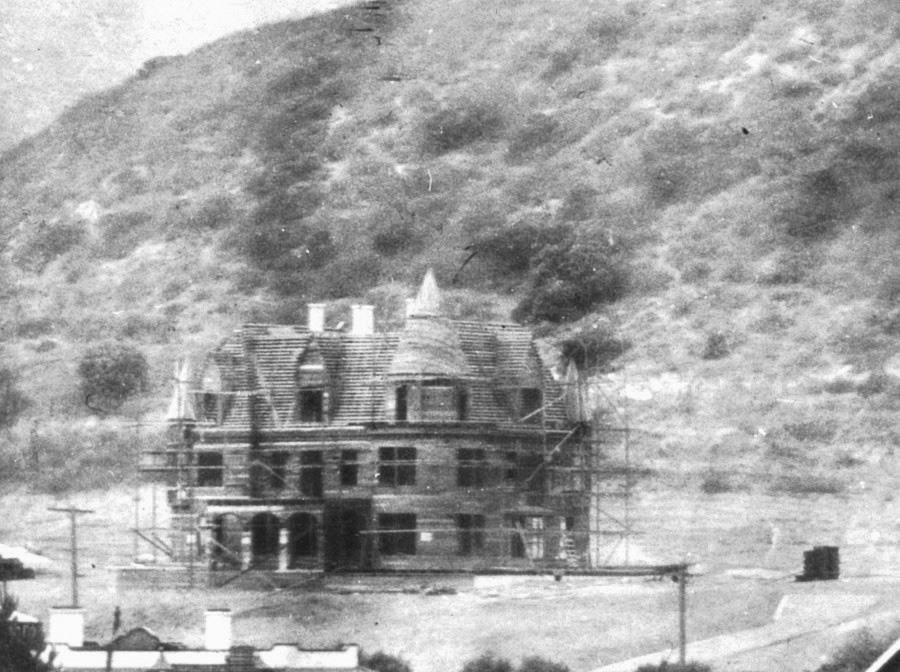 |
|
| (1909)* – Close-up view showing the Lane Residence under construction. Note how barren the hills are behind it. |
Historical Notes The Gothic Renaissance chateau (also referred to as “Holly Chateau”) sits in the middle of what is now historic Hollywood and was originally the personal residence of a wealthy banker, Rollin B. Lane. |
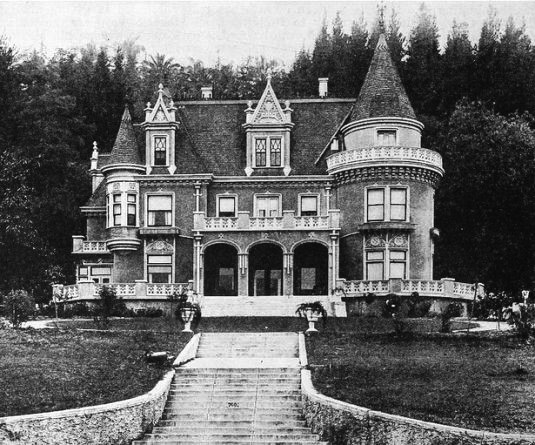 |
|
| (ca. 1910s)^x^ - View showing the 'Holly Chateau' built by Rollin Lane in 1909. This house became the Magic Castle in 1963. |
Historical Notes Rollin Lane was a very successful lawyer, banker and real estate investor who helped build Hollywood through property development and participation on the historic Hollywood Board of Trade. He also invested heavily in the early development of the nearby San Fernando Valley and in California’s San Joaquin Valley. ^ |
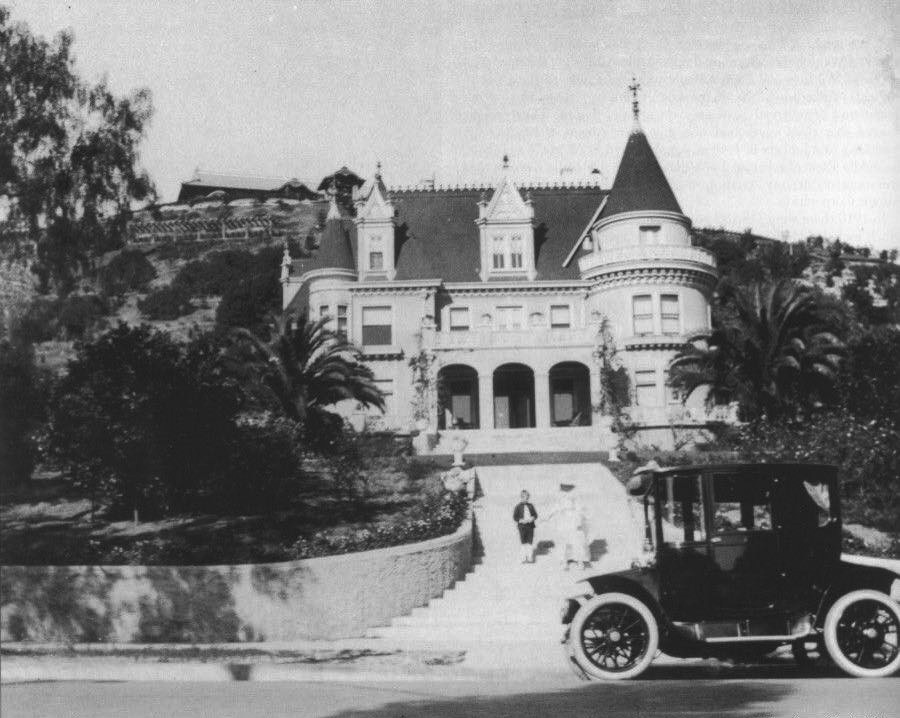 |
|
| (1920)* – A woman and a child stand on the stairs leading up to the Lane Residence. The house in the background on top of the hill is the famous Bernheimer Estate and Gardens (currently Yamashiro Restaurant). Note the early model car in the foreground. |
Historical Notes Katherine Lane (Rollin's wife) was a college graduate, published author, teacher and lecturer who worked to improve the quality of life in Hollywood through various community service organizations, even serving a term as president of the Woman’s Club of Hollywood. Later, working with the Los Angeles Chamber of Commerce and supported by a small army of volunteers, she promoted the planting of the landmark palm trees that line Wilshire Blvd., as well as hundreds of Japanese cherry trees in and around Griffith Park. ^ |
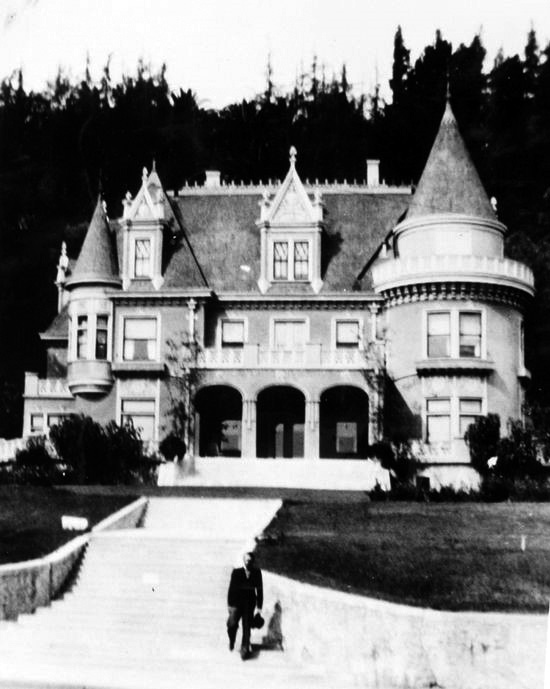 |
|
| (1936)^x^ – View showing a man walking down the front stairs of the Lane residence (aka Holly Chateau) built by Rollin B. Lane. Now home of the Academy of Magical Arts and the Magic Castle. |
Historical Notes Ownership of the building remained in the Lane family until 1955 when it was sold to Thomas O. Glover, whose family still owns the property. |
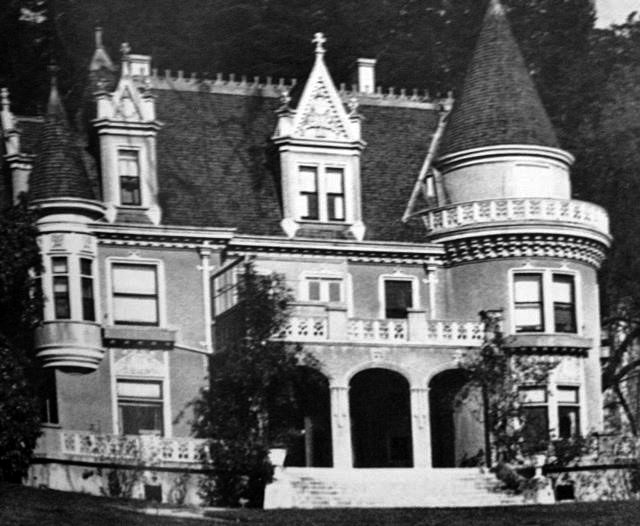 |
|
| (Early 1900s)^x^ – Close-up view of the Victorian-style Rollin B. Lane residence (aka Holly Chateau) located at 7001 Franklin Avenue in Hollywood. |
Historical Notes The Lanes named their home “Holly Chateau” and for thirty years, it was one of the most recognized addresses in Hollywood and a popular location for the area’s social elite. Hundreds of newspaper articles attest to the elegant and elaborate luncheons, teas and musicales held for artists, orphans, community leaders or world travelers, or to raise funds for one of Katherine’s many civic projects. ^ |
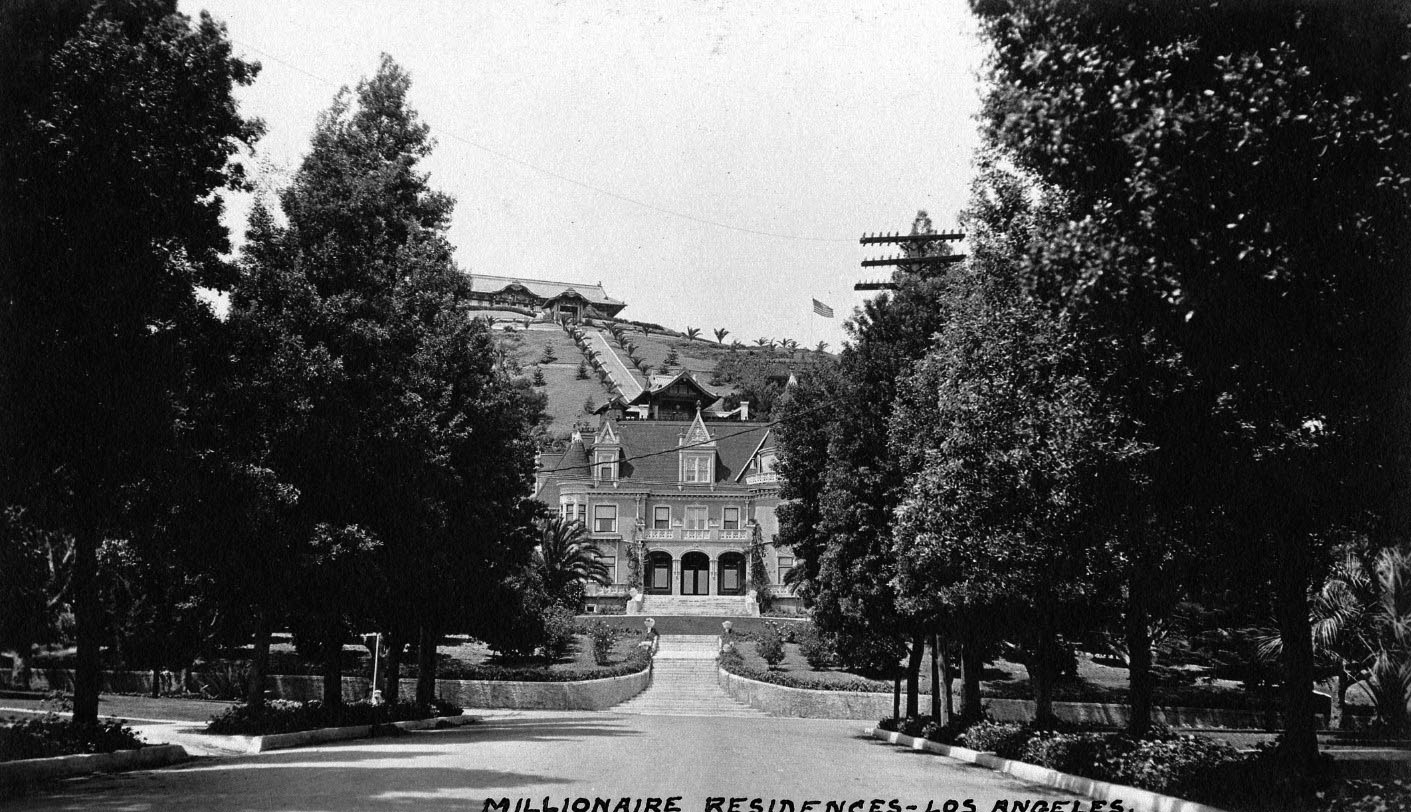 |
|
| (ca. 1915)^* – View looking north on Orange Drive showing the Rollin Lane residence (later Magic Castle) at the T-intersection with Franklin Avenue. The Bernheimer Estate and Gardens (built in 1914) is seen at the top of the hill in the background. |
Historical Notes The 1914 hilltop estate seen behind and above the Lane Residence was built to house the Bernheimers' priceless collection of Asian treasures. In order to have an authentic Japanese design, hundreds of skilled craftsmen were brought from Asia to recreate an exact replica of a palace located in the Yamashiro mountains near Kyoto, Japan. The original Bernheimer structure included a 10-room teak and cedar mansion, where carved rafters were lacquered in gold and tipped with bronze dragons. |
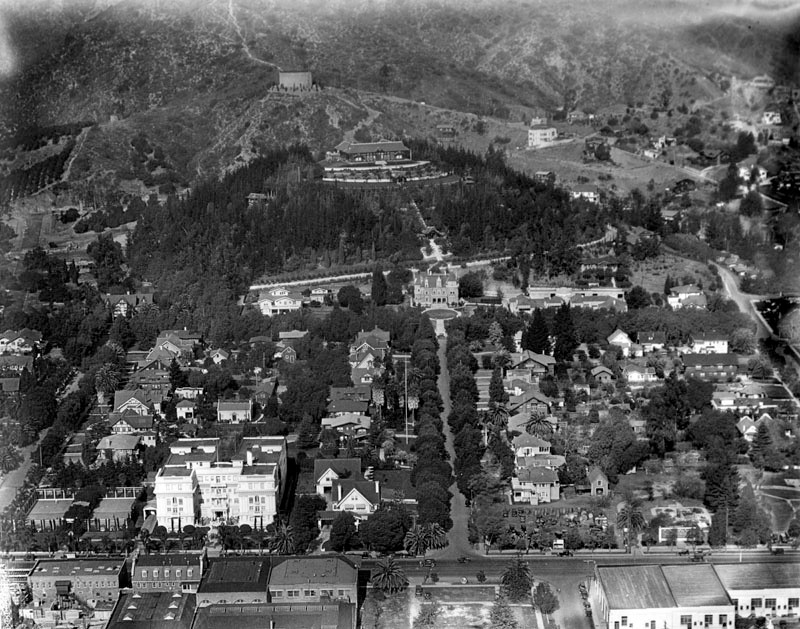 |
|
| (ca. 1924)* - Aerial view looking north on Orange Drive toward Franklin Avenue. The Rollin B. Lane Estate (now Magic Castle) is seen on the north side of Franklin at the end of the T-intersection (center of photo). Hollywood Boulevard runs horizontal in the foreground. The white building at lower-left is the Garden Court Apartments. The building at the top of the hill behind the Lane Estate is the Japanese estate and gardens of brothers Charles and Adolph Bernheimer (Bernheimer Estate and Gardens). |
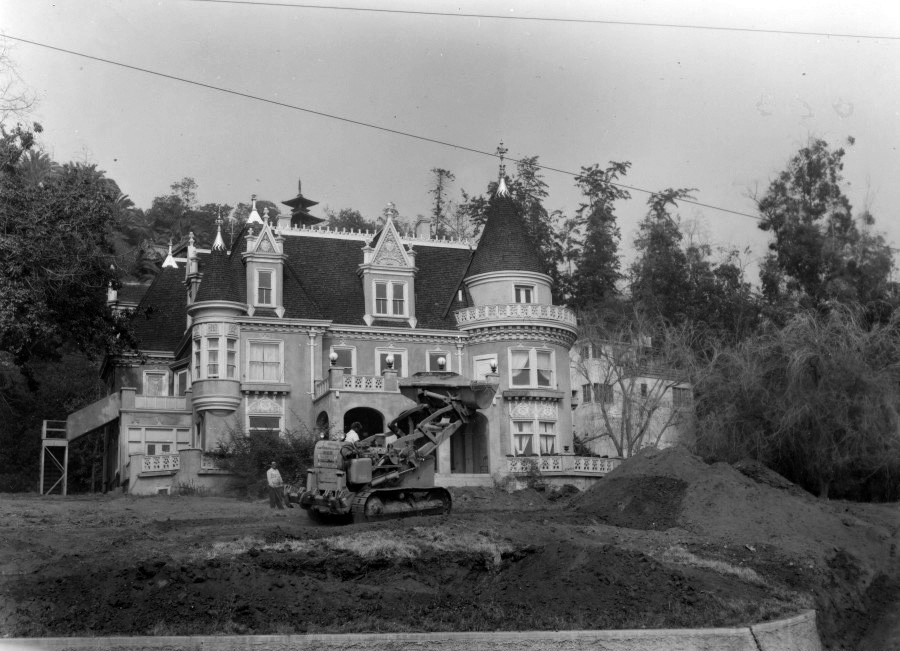 |
|
| (1962)* - Renovations for the Magic Castle begin. |
Historical Notes After the Lanes passed away in the 1940’s, the house was divided into a multi-family home. It then became a home for the elderly and was finally transformed into a maze of small apartments. By 1960, the fate of the building was uncertain. Then Milt Larsen met the owner, Thomas O. Glover. Milt was a writer on the NBC-TV show Truth or Consequences. His office was on the ninth floor of a Hollywood office building that overlooked the Lane residence. Milt’s late father, William W. Larsen Sr., was a renowned magician and had long dreamed of building an elegant private clubhouse for magicians. The Lane residence would become that club. In September 1961, Milt, his brother Bill (an accomplished magician, publisher of Genii Magazine and the Academy’s first President), Irene (Bill’s wife) and a crew of friends and volunteers began the task of returning this run-down apartment building to its glorious past. After months of scraping and sanding, the rich Victorian elegance began to resurface. The Magic Castle opened its doors on January 2, 1963. ^ |
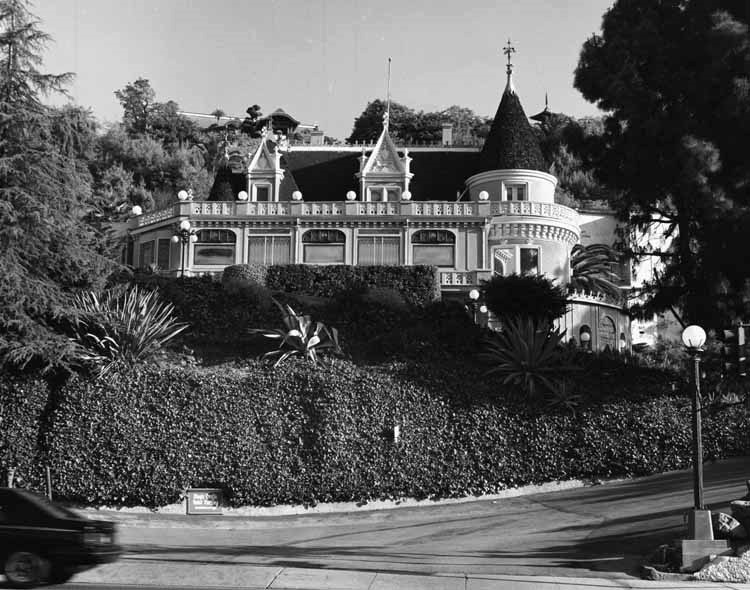 |
|
| (1981)^*# – View looking up from Franklin Avenue showing the Victorian-style "French Chateau" building known as Magic Castle, with turrets and architectural detailing and ivy-covered retaining wall in foreground. |
Historical Notes The Magic Castle was declared Los Angeles Historic-Cultural Monument No. 406 in 1989. |
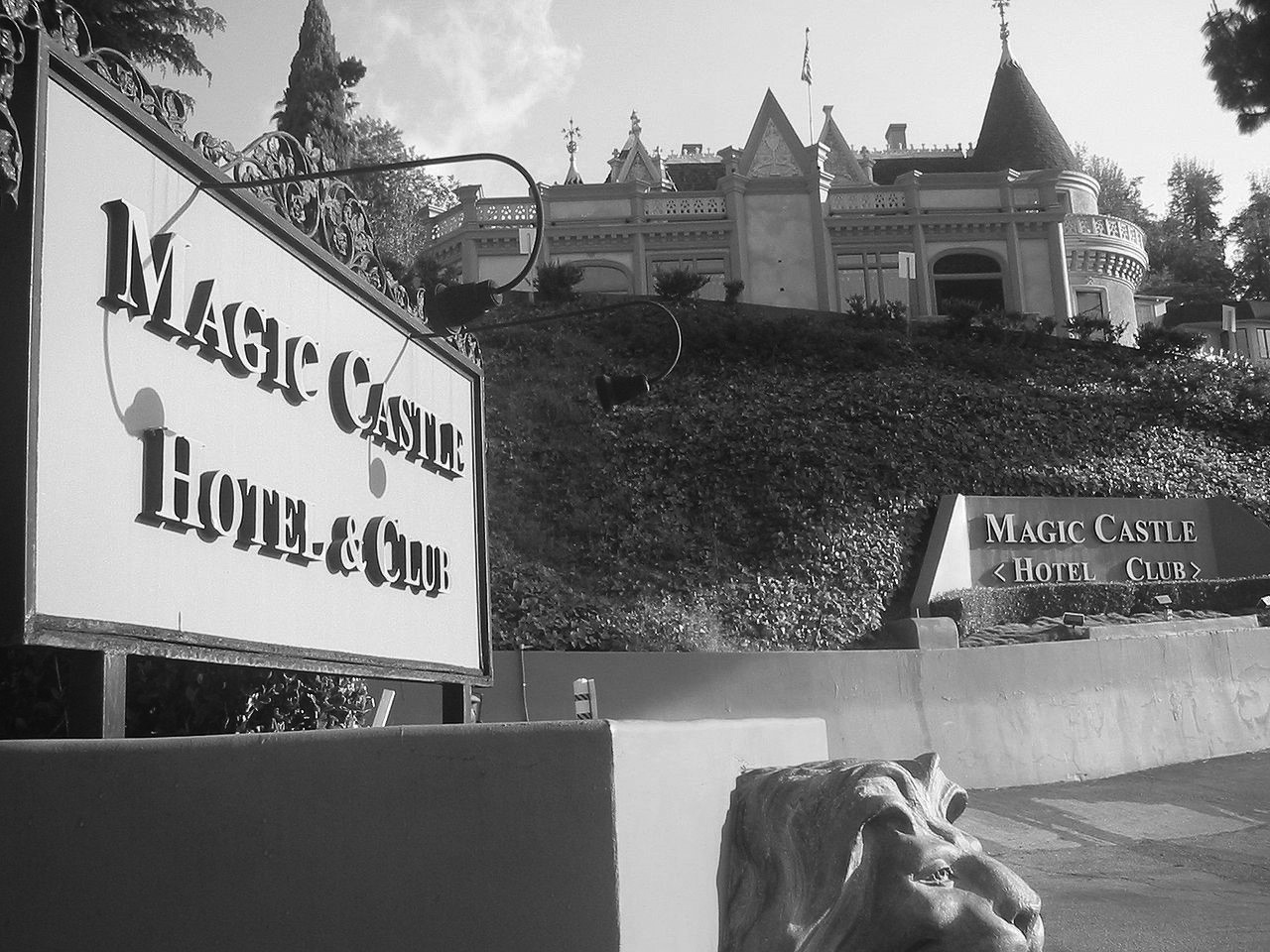 |
|
| (2007)^* - View showing the driveway entrance to the Magic Castle located at 7001 Franklin Avenue in Hollywood. |
Historical Notes Since 1963, the Magic Castle has been a nightclub for magicians and magic enthusiasts, as well as the clubhouse for the Academy of Magical Arts. It bills itself as "the most unusual private club in the world." |
* * * * * |
Glengarry Castle
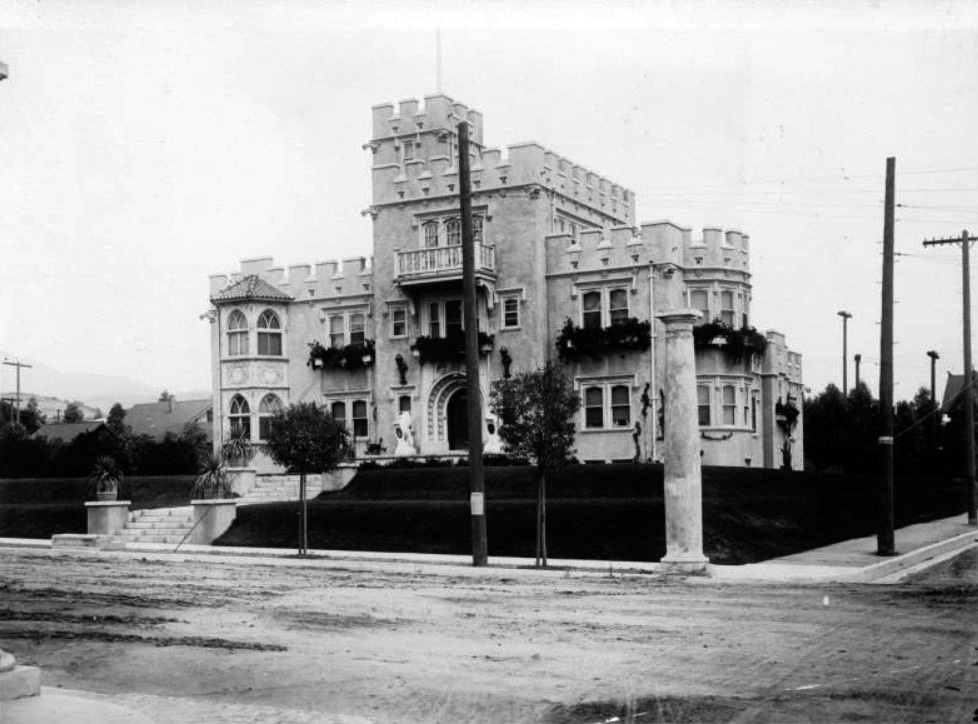 |
|
| (ca. 1912)^^ - View of Glengarry Castle, the residence of Dr. Schlosser in Hollywood. The three-story castle-like building can be seen at center with a tower visible on the roof at center. A balcony is visible on the third story, while a long staircase leads to the arched front entrance. Statues can be seen on either side of the archway, while grass is visible in the front yard. |
Historical Notes At the turn of the century, after striking it rich in the Nevada silver mines, Dr. Schlosser and his family moved to Hollywood, where the doctor built Glengarry, a copy of his wife's ancestral home in Inverness, Scotland. Soon this castle proved too small for his burgeoning social life and medical practice. So in 1912, he built Schloesser Terrace (Castle Sans Souci) on a three-acre plot across the street (NW corner of Argyle and Franklin avenues).*# |
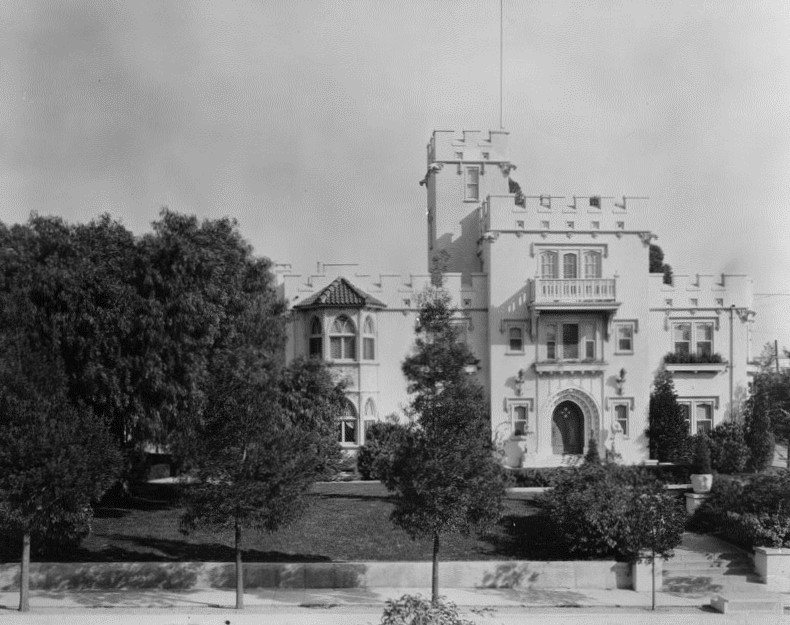 |
|
| (ca. 1913)* - Exterior view of Glengarry Castle (also known as Schlosser Terrace) located on the eastern side of Argyle between Franklin Avenue and Dix Street in Hollywood. |
Historical Notes He was originally called Dr. Alfred Guido Rudolph Schloesser, but during World War I, due to anti-German sentiment, he changed it to Dr. A. G. Castles. |
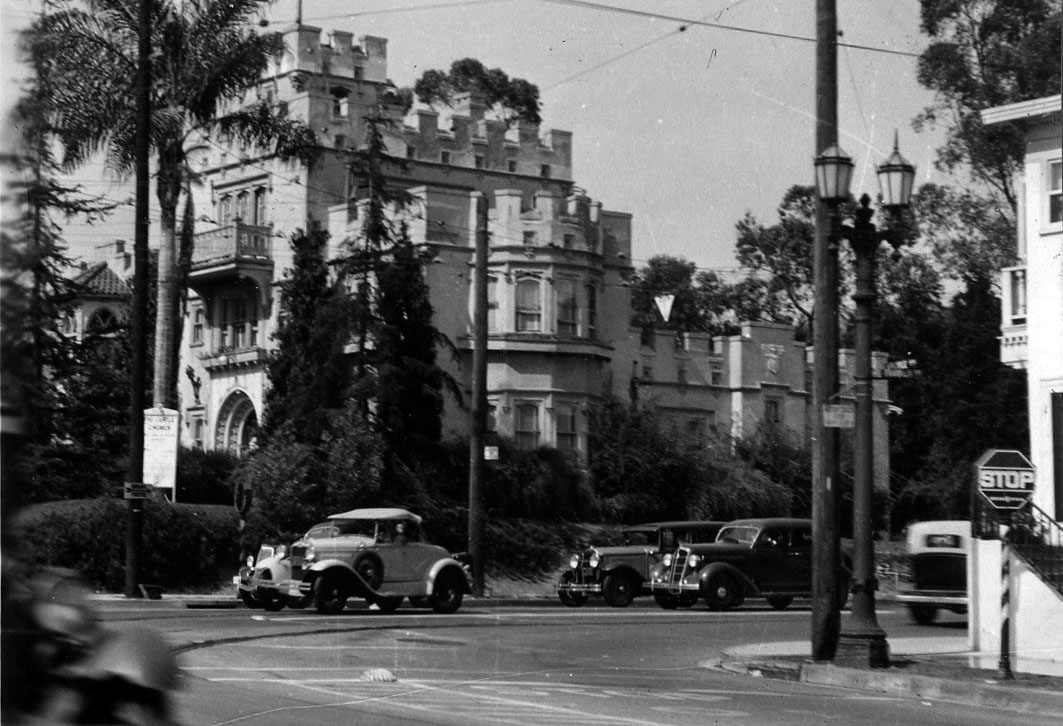 |
|
| (1934)^*# - View showing Glengarry Castle located on the northeast corner of Franklin and Argyle avenues. |
Historical Notes The Glengarry Castle was demolished in 1959.* |
Castle Sans Souci
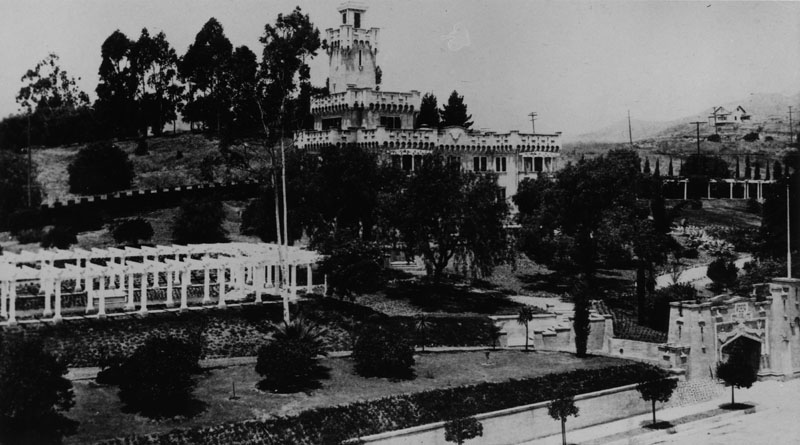 |
|
| (1913)* - Exterior view of Castle Sans Souci, the mansion of Dr. A. G. Castles, located on the northwest corner of Franklin and Argyle avenues, across the street from Glengarry Castle |
Historical Notes Dr. Castles originally lived in Glengarry Castle (NE corner of Argyle and Frnaklin). But that 'home' soon proved too small for his burgeoning social life and medical practice. So in 1912, he built Castle Sans Souci on a three-acre plot across the street (NW corner of Argyle and Franklin). As an investment, the eccentric Dr. Castles, who always wore a frock coat, heavy makeup and top hat, tore down Sans Souci and built Castle Argyle Arms apartments in 1928, attracting a new breed of royalty: movie makers. Guests there over the next two decades were to include Clark Gable, Howard Hughes, Ronald Reagan and Cecil B. DeMille.*# |
* * * * * |
Fremont Hotel
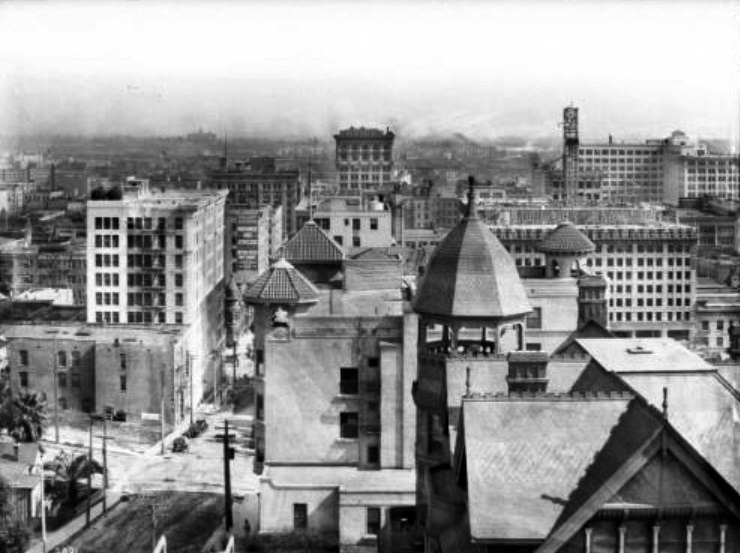 |
|
| (ca. 1913)^ – View looking southeast from Fourth Street and Grand Avenue. Fourth Street runs vertically (at left) with Olive Street intersecting it horizontally (visible at left). In the lower right is the Rose Mansion, on the SE corner of Fourth and Grand. Beyond it is the distinctive multi-turreted roof of the Fremont Hotel, on the SW corner of 4th and Olive. |
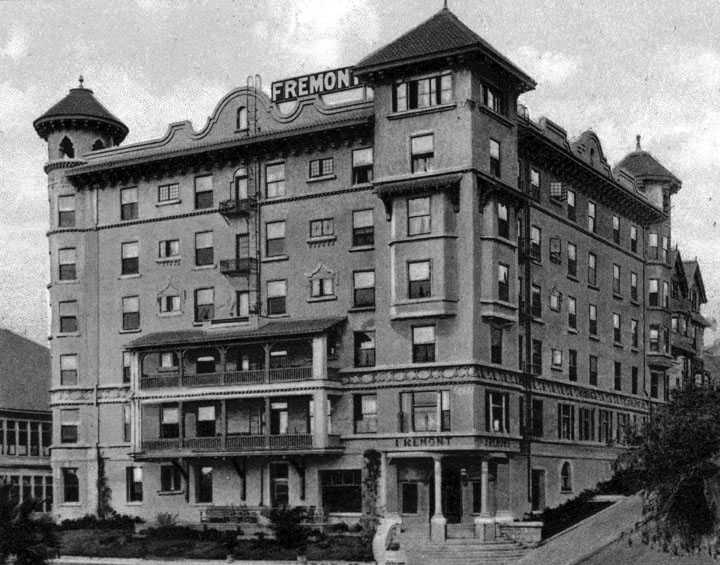 |
|
| (n.d.)* - Postcard view of the Fremont Hotel on the southwest corner of 4th and Olive, showing the 6 story building, with corner turrets and balconies on one side for the 2nd and 3rd floors. Architect, John Austin. |
Historical Notes The Fremont Hotel, located in the Bunker Hill suburb, was built and designed by the architect John C. Austin and developed by Thomas Pascoe. The plans for building the hotel were developed in November 1901 and initially faced resistance from the next door Olive Street School establishment. It was designed by the architect in the Mission style, and had some 100 rooms. It opened on September 9, 1902 and was named after John C. Frémont. When newly built it was billed as "the newest and most elegantly appointed family hotel in Los Angeles.” The hotel also held dinners in tribute to Frémont. Frémont's widow, Jessie, was the first registered guest. She also designed and executed the hotel's crest. Frémont's motto, "Eternal vigilance is the price of safety" was adopted as the hotel's motto, paraphrased into "Eternal vigilance is the price of success in the hotel business". The hotel was demolished in 1955 by the Community Redevelopment Agency, and what remained was only the retaining wall next to the Olive Public School.^* |
* * * * * |
Los Angeles Trust and Savings Bank (later Pacific Southwest Bank)
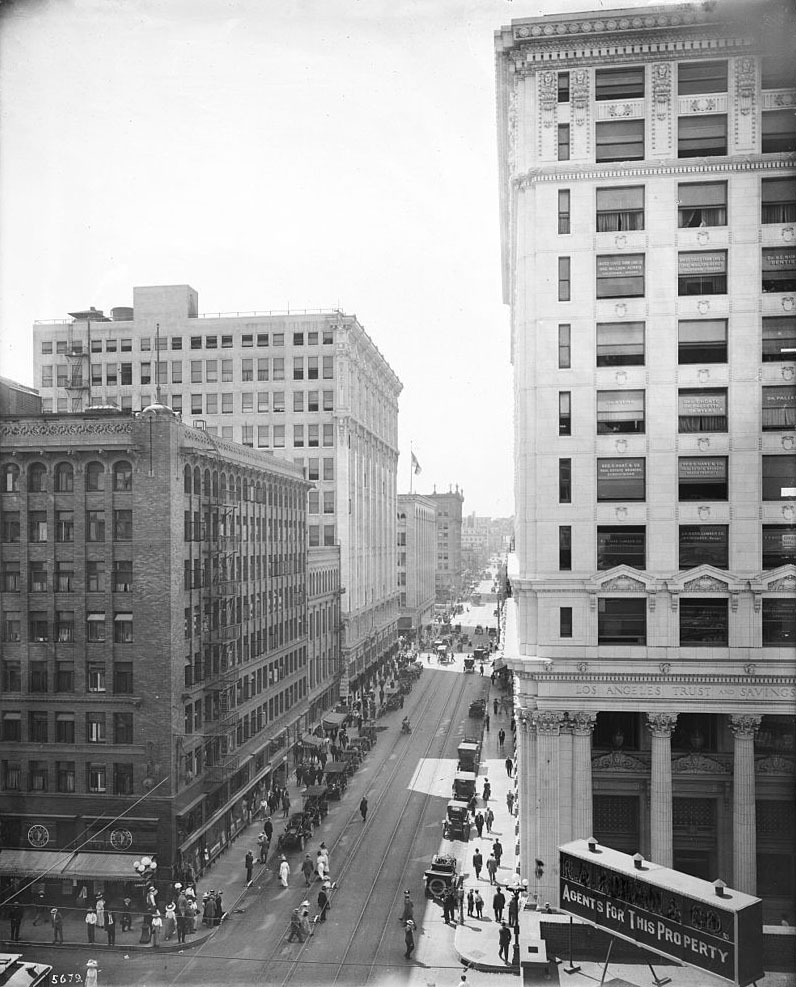 |
|
| (ca. 1910)^* - View looking west on 6th Street from Spring Street. On the northwest corner stands the newly built Los Angeles Trust and Savings Bank. |
Historical Notes Constructed in 1910, the Los Angeles Trust and Savings Bank building stood on the northwest corner of Spring and 6th Streets. The building was designed by John Parkinson and G. Edwin Bergstrom, prolific architects who were responsible for numerous Spring Street financial buildings, including the Security Building and the Los Angeles Stock Exchange Building.^^* In 1922, Los Angeles Trust and Savings Bank changed its name to Pacific Southwest Bank.^^* |
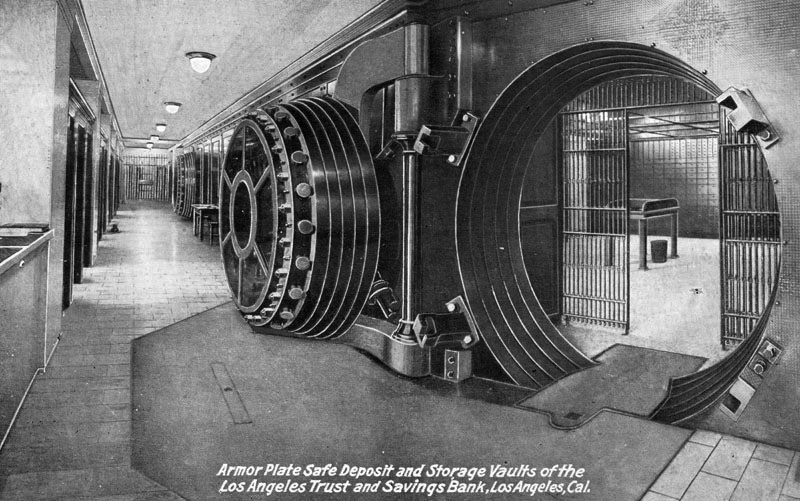 |
|
| (1910s) - Postcard view showing the armor plate safe deposit and storage vaults of the Los Angeles Trust and Savings Bank. |
Historical Notes By 1910, when the Los Angeles Trust and Savings Bank was completed, Spring Street had become the city’s financial and banking center.^^* |
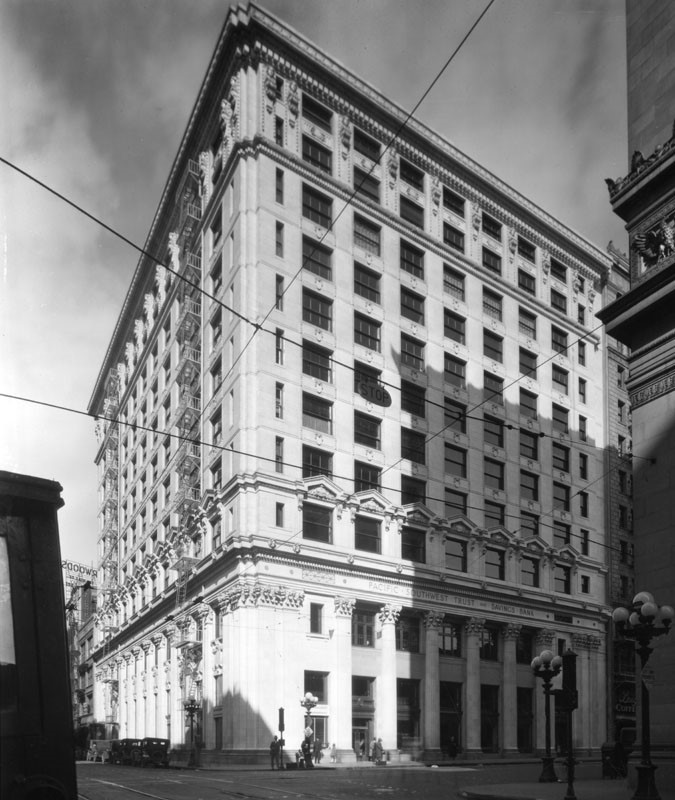 |
|
| (ca. 1924)* - Street view showing the Pacific Southwest Trust and Savings Bank located at 215 W. 6th Street, on the N/W corner of 6th and Spring streets. It was originally the Los Angeles Trust and Savings Bank Building (1910 – 1922). |
Historical Notes In 1922, Los Angeles Trust and Savings Bank changed its name to Pacific Southwest Trust and Savings Bank.^^* |
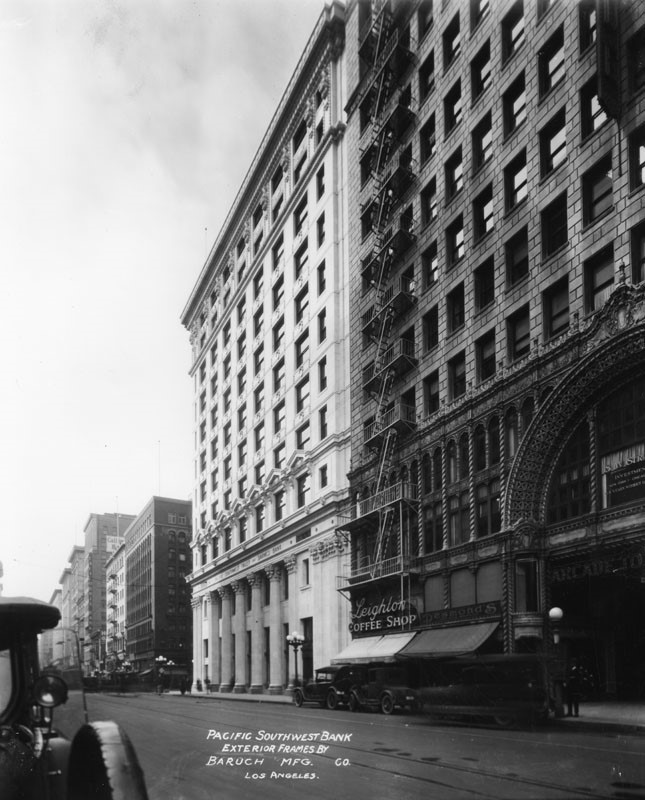 |
|
| (ca. 1924)* – View looking south on Spring Street showing the Pacific Southwest Bank on the N/E corner of 6th and Spring streets. To the right stands the Mercantile Arcade Building with the Leighton Coffee Shop at center. |
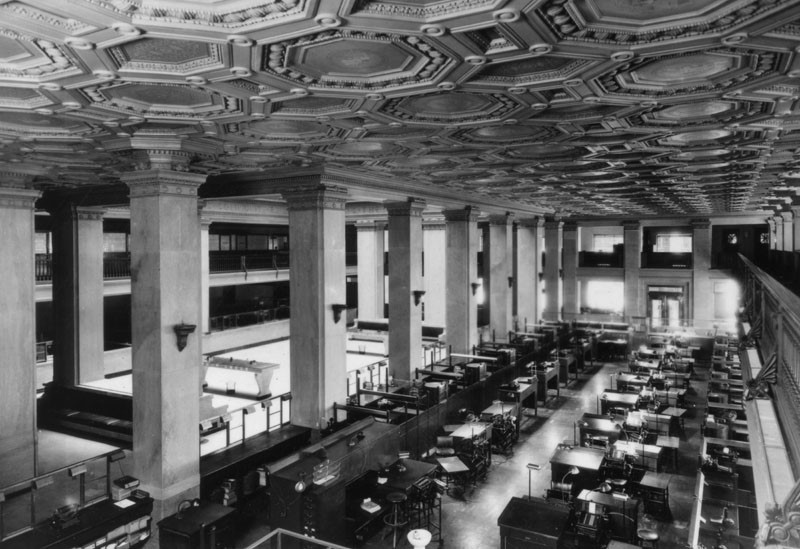 |
|
| (ca. 1924)* - Interior view of Pacific Southwest Trust and Savings Bank at 561 So. Spring Street, in downtown Los Angeles. Note the ornate ceiling. |
.jpg) |
|
| (2008)^* - Pacific Southwest Bank (built 1910), the present day SB Manhattan Lofts (condominiums) — at 215 W. 6th Street, Downtown Los Angeles. |
* * * * * |
Merchants National Bank Building
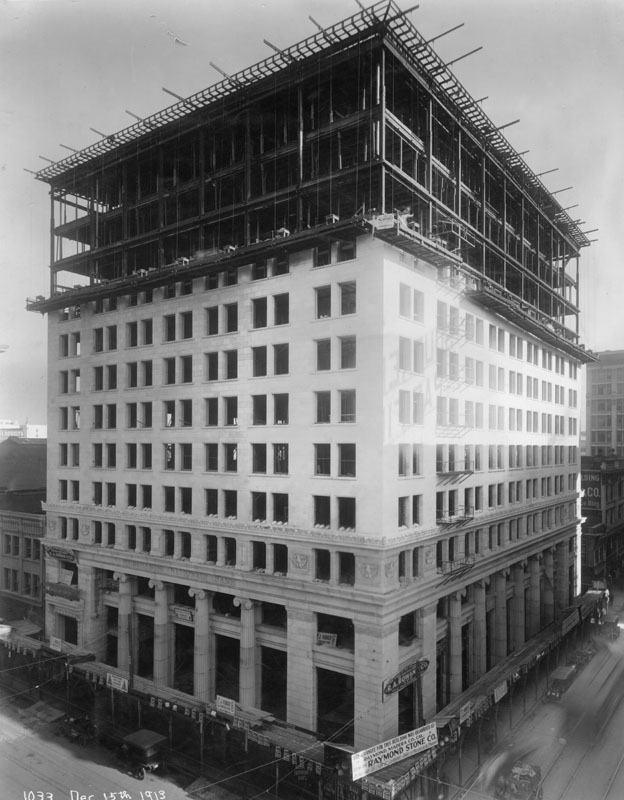 |
|
| (1913)* - An exterior view of 2 sides of the Merchants National Bank building on the NE corner of So. Spring St. & W. 6th St. It is under construction and the exterior is 3/4 finished. There are 2 signs low on the building: one giving the name Raymond Stone Co. and the other (a little higher) R.A. Rowan Co. This was part of the Beaux Arts office block; architects were William Curlett & son. |
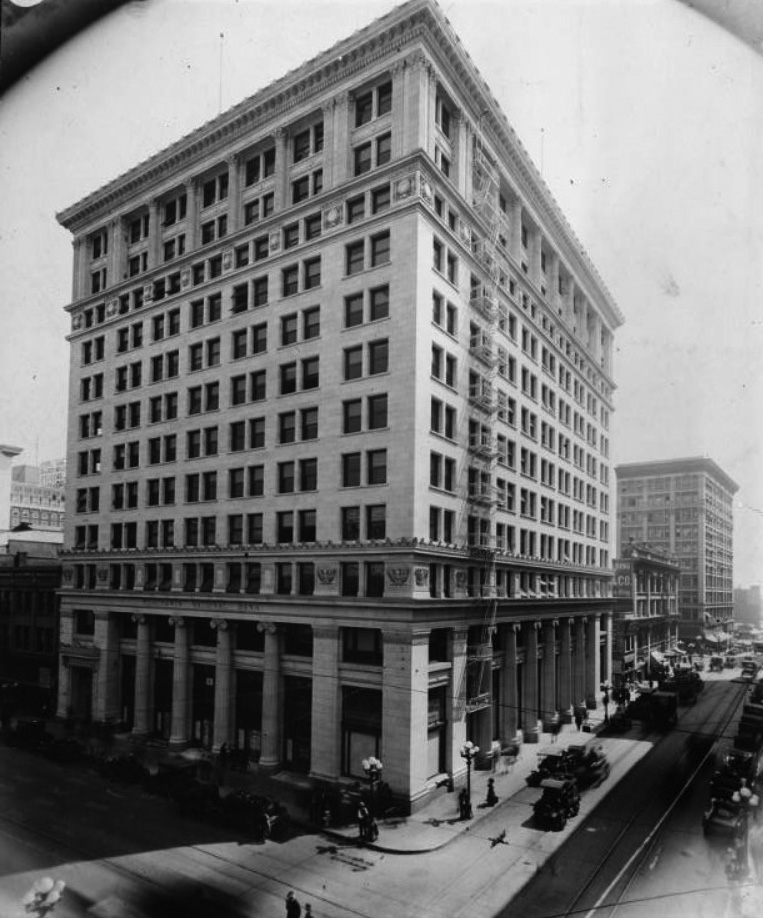 |
|
| (ca. 1920)* - View showing the Merchants National Bank located on the northeast corner of Spring and 6th streets. |
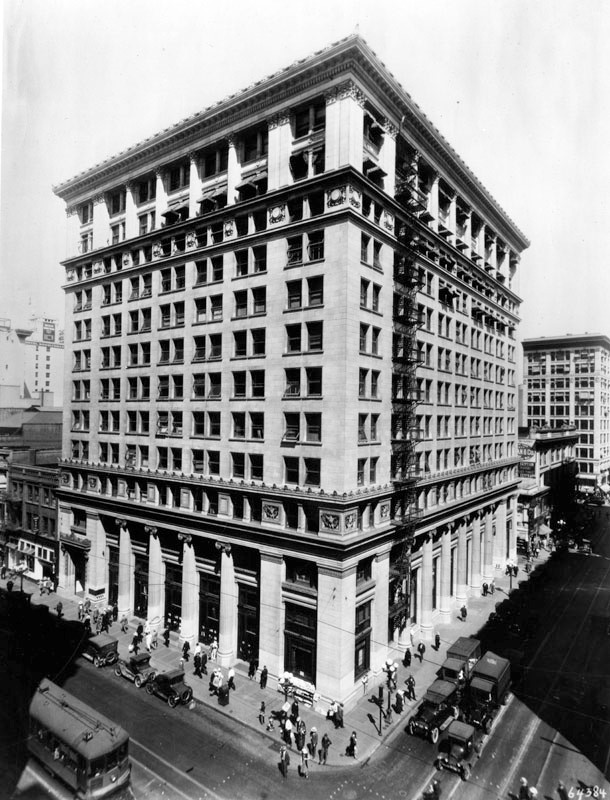 |
|
| (1926)* - Located on the northeast corner of Spring and 6th streets stands the Merchants National Bank Building. |
.jpg) |
|
| (1920s)* – Close-up view of the Merchants National Bank showing four proto-ionic columns, each one situated between doors, providing support for the building. "Merchants National Bank" is engraved into the wall above the columns and just below the cornice and the bank's name is painted on the windows above the entrances. |
* * * * * |
Examiner Building (2nd location)
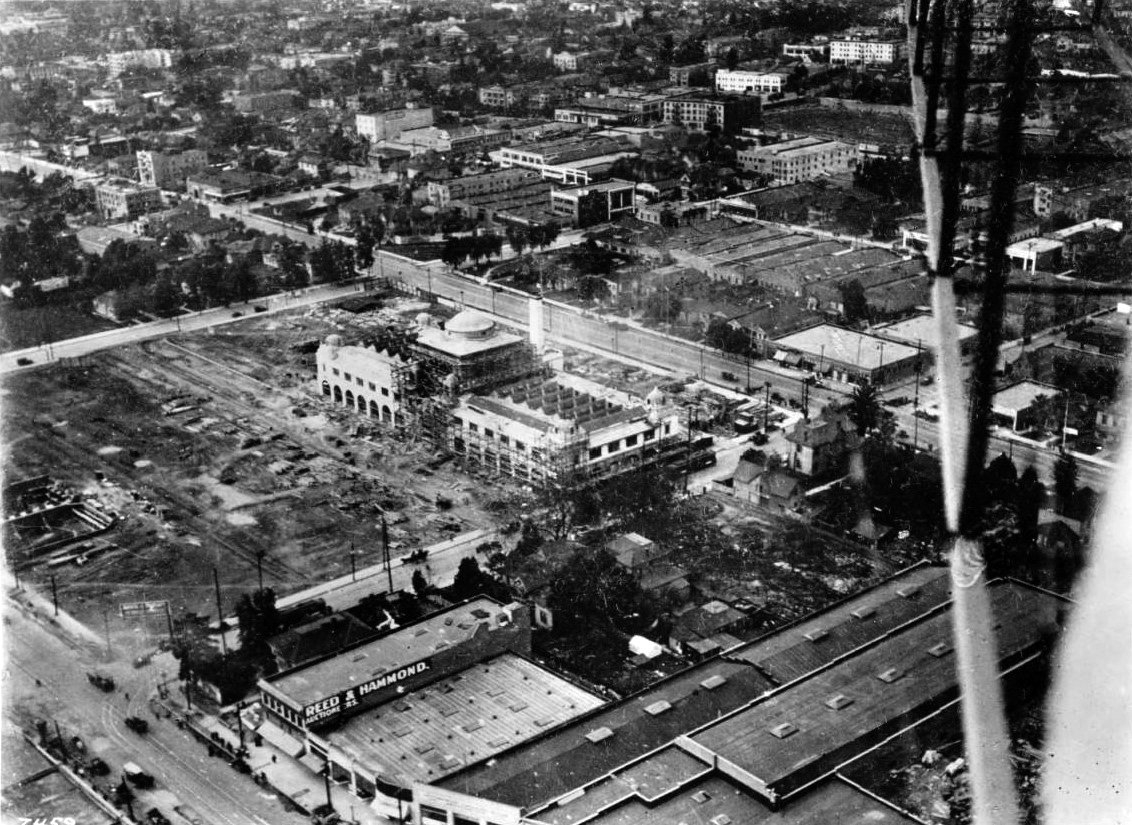 |
|
| (1914)* – Aerial view looking southwest showing the Examiner Building under construction, sections of which are still lined with scaffolding. Main Street runs diagonally at lower-left. Hill Street runs diagonally from upper-left to right-center. 11th Street runs from lower-left to center-right. Broadway (between and parallel to Main and Hill) has yet to be paved and will run directly in front of the Examiner Building. |
Historical Notes In December 1903, William Randolf Hearst commenced publication of the Los Angeles Examiner, the latest in his chain of newspapers. The first home of the LA Examiner was in a building located at 509 S. Broadway (Click HERE to see more of LA Examiner's first building). But, in less than a decade, the first building proved to be too small for the growing newspaper. Hearst commissioned Julia Morgan, best known for her work on the San Simeon estate, and Los Angeles architects Henke and Dodd, to design a new, larger building to house the offices and production of the paper. Construction of the new Examiner Building at 1111 S. Broadway would begin in 1912 and not be completed until 1914. |
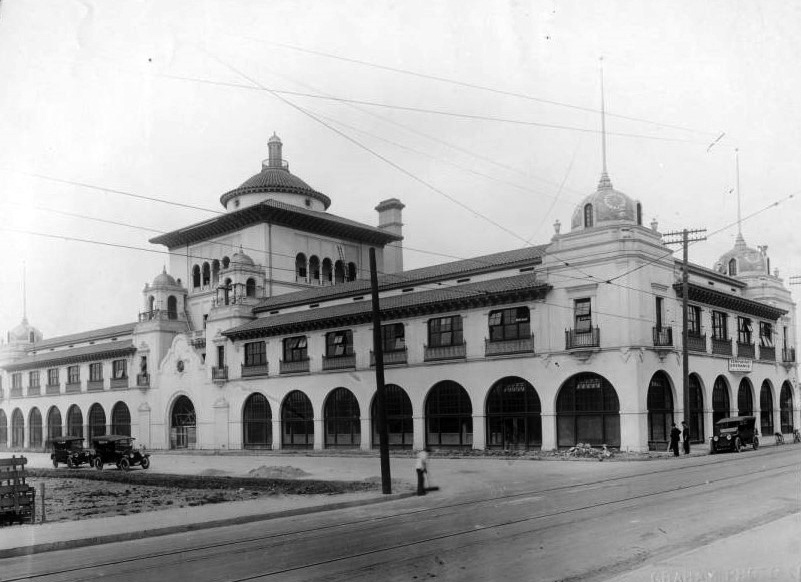 |
|
| (ca. 1914)^ - View looking at the nearly completed Examiner Building located on the southwest corner of Broadway and 11th Street. Many of the building’s second-story windows are open, and a ladder stretches from the second floor roof to the archways of the center section's third floor. A sign on the 11th Street side of the building (right side) reads "Temporary Entrance - All Departments." |
Historical Notes The Los Angeles Examiner Building was built between 1912 and 1914 and designed in Mission Revival and Spanish Colonial Revival styles, largely by San Francisco architect Julia Morgan. The building has a tile dome on each corner and towers flanking the entry. |
.jpg) |
|
| (ca. 1916)* - Postcard view showing the Examiner Building located on the southwest corner of Boadway and 11th Street. A streetcar is seen running south on Broadway. |
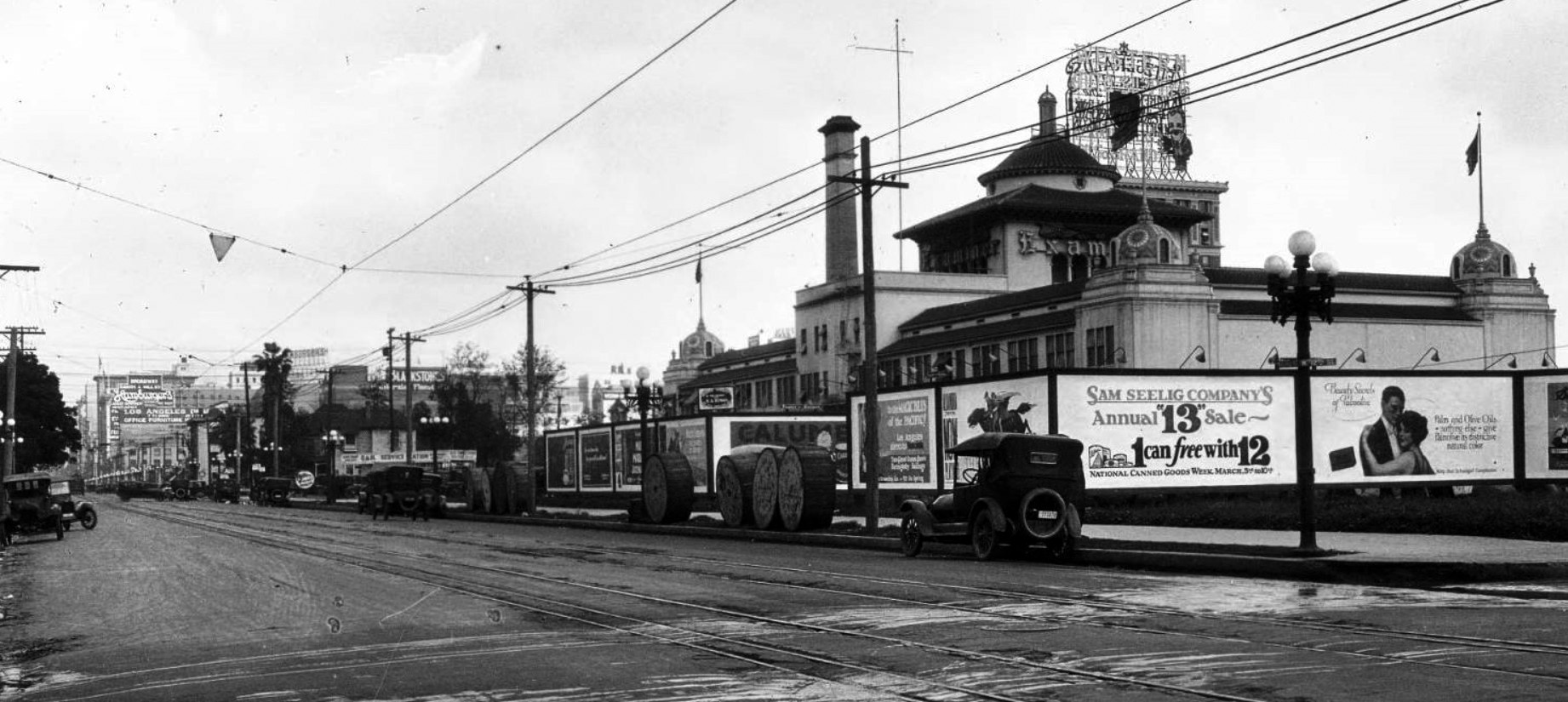 |
|
| (ca. 1923)* – Panoramic view looking north on Hill St. at 12th St. showing the back side of the Examiner Building. An ornate 5-bulb streetlight stands on the northeast corner of 12th and Hill and behind it a series of billboards appear to surround the Mission Revival-Style building. |
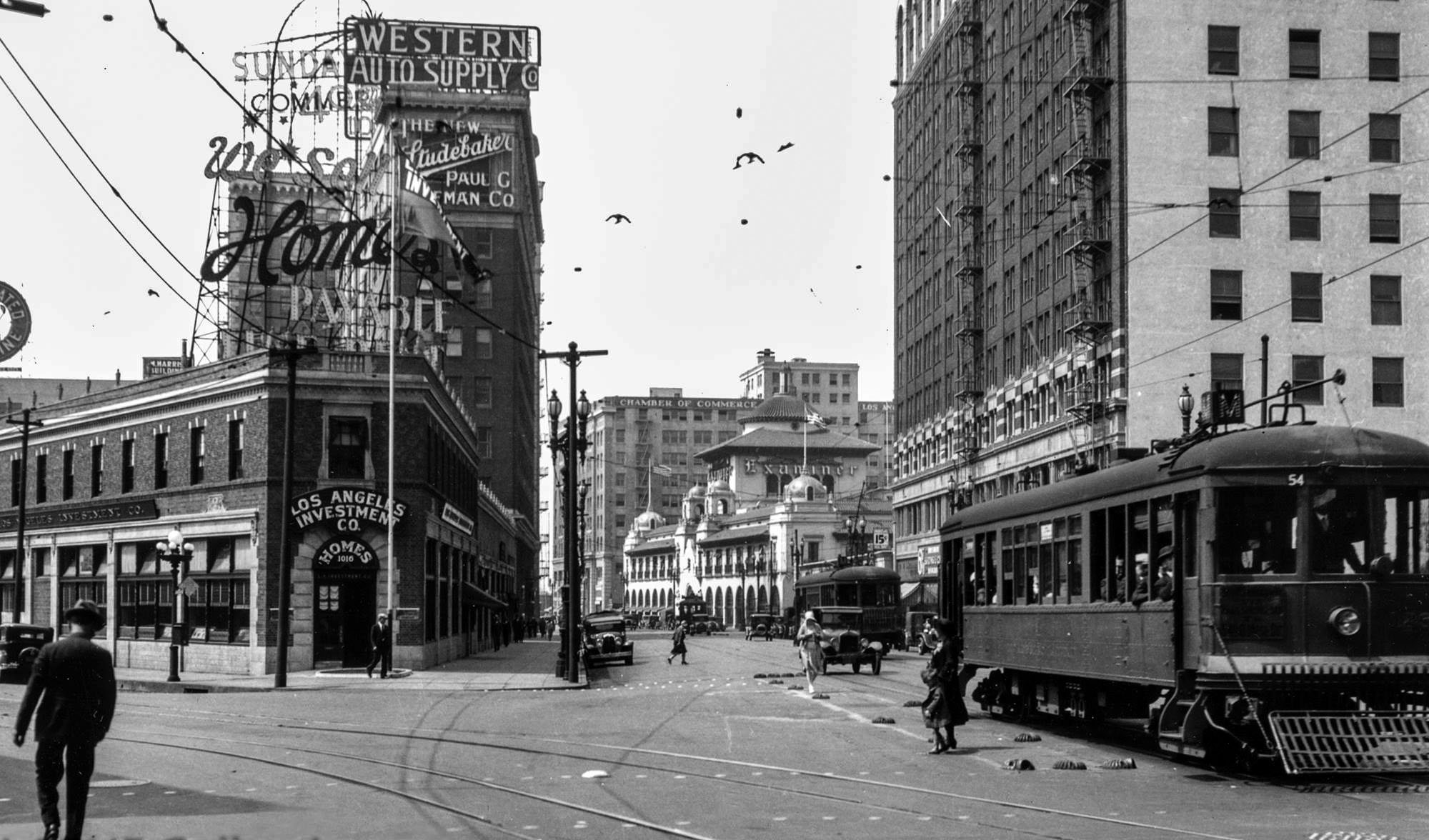 |
|
| (1920s)* - View looking south on Broadway showing two streetcars of the LA Railway's "M Line" with the Examiner Building in the background on the S/W corner of Broadway and 11th Street. The Los Angeles Investment Co. and Western Auto Supply are at left, followed by the Paul G Hoffman Studebaker sales office. Photo courtesy of the Los Angeles Railroad Heritage Foundation. |
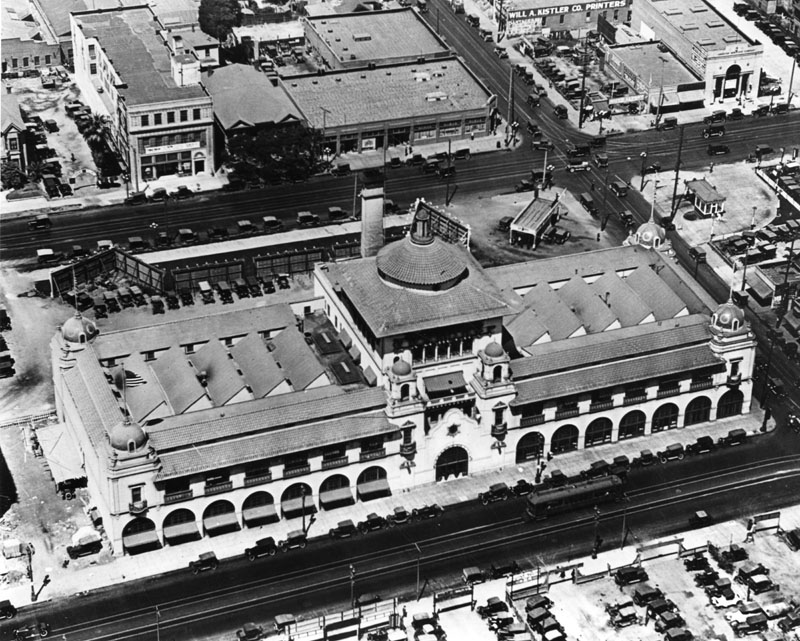 |
|
| (ca. 1925)* - Aerial view showing the Herald-Examiner Building located on the southwest corner of 11th and Broadway (1111 South Broadway). |
Historical Notes Over the years, the Hearst Corporation would acquire the Herald and the Express, merging the two in the 1930s. |
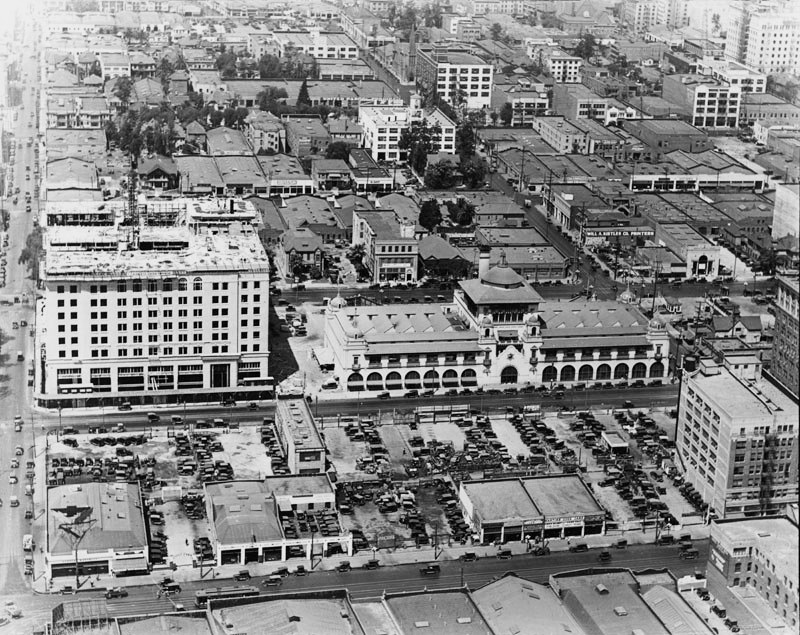 |
|
| (ca. 1926)* - Aerial view of the Examiner Builidng and its surrounding area. The main facade of the building has 7 arches on either sides of the main entrance, and a tower centered atop the middle of the building. The large building to the souh of the Examiner (N/W corner of Broadway and 12th) is the newly constructed Chamber of Commerce Building. |
Historical Notes In 1931, Hearst merged the Los Angeles Daily Herald with the Los Angeles Evening Express to form the Los Angeles Evening Express and Evening Herald, which was then the largest circulating evening newspaper west of the Mississippi. |
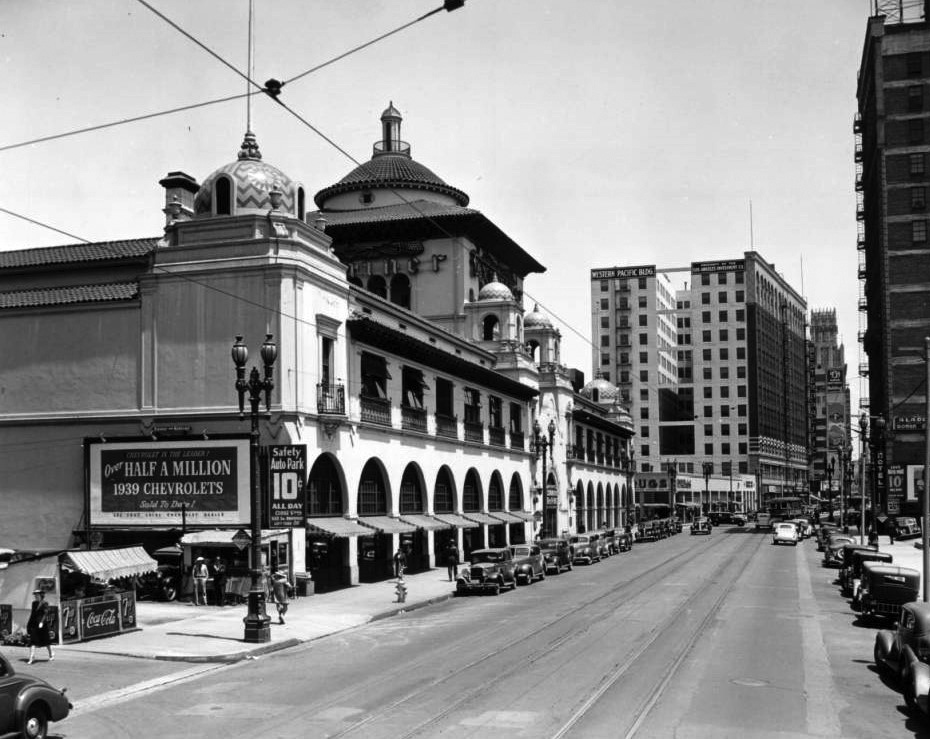 |
|
| (ca. 1939)^ - View looking north along South Broadway towards 11th Street. At left are the offices of the Herald-Examiner newspaper. The Western Pacific Building at 1031 South Broadway is seen one block north. |
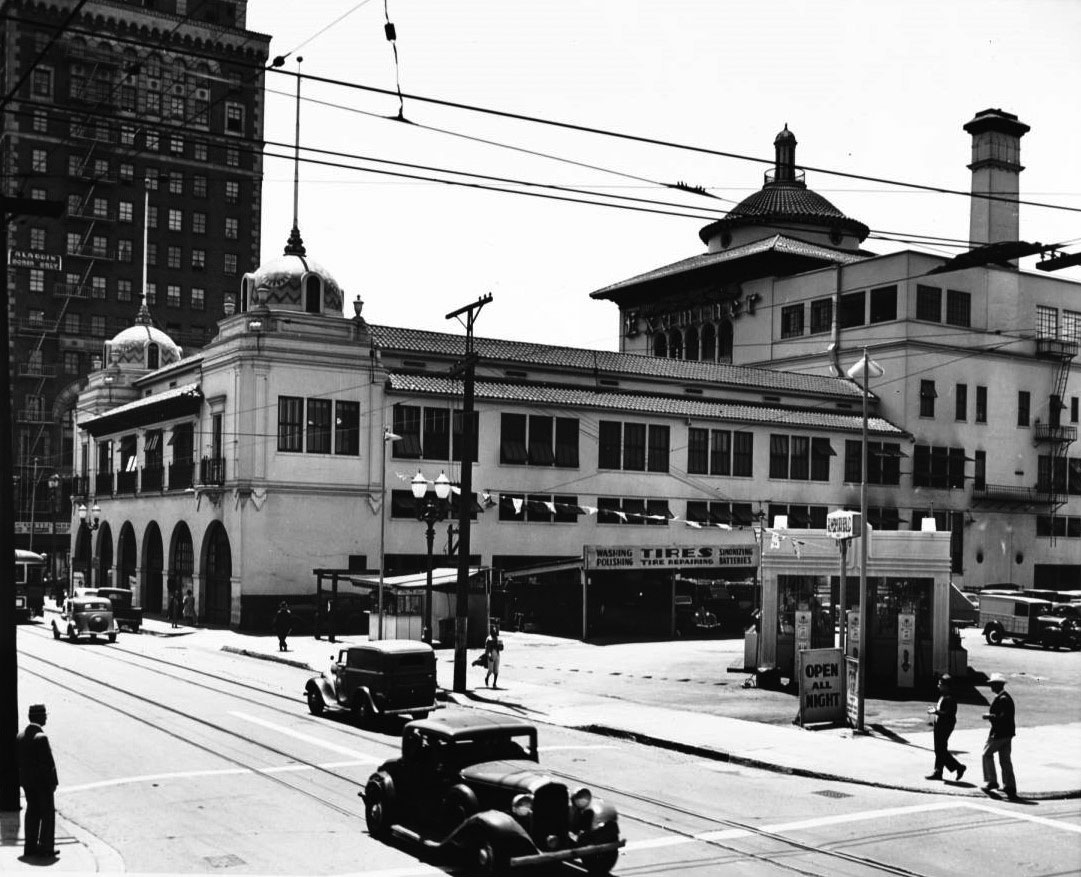 |
|
| (1939)* - View looking east on 11th Street at Hill Street showing the Examiner Building. Across the street is a coffee shop and the Aladdin Hotel for women only. Next door is Richfield Tires and Service Station. Photo by Dick Whittington |
.jpg) |
|
| (1939)^ – Aerial view looking down toward South Broadway showing the beautiful Mission-Revival-Style Examiner Building. Photo by Dick Whittington |
Historical Notes At its peak in 1960, the Examiner had a circulation of 381,037. It attracted the top newspapermen and women of the day. The Examiner flourished in the 1940s under the leadership of City Editor James H. Richardson, who led his reporters to emphasize crime and Hollywood scandal coverage. In 1962 the morning Examiner (founded in 1903) merged with the evening Herald Express (founded approximately 1871) creating the Herald-Examiner newspaper. The Herald-Examiner Building was designated historical landmark #178 on August 17, 1977 (Click HERE to see complete listing). |
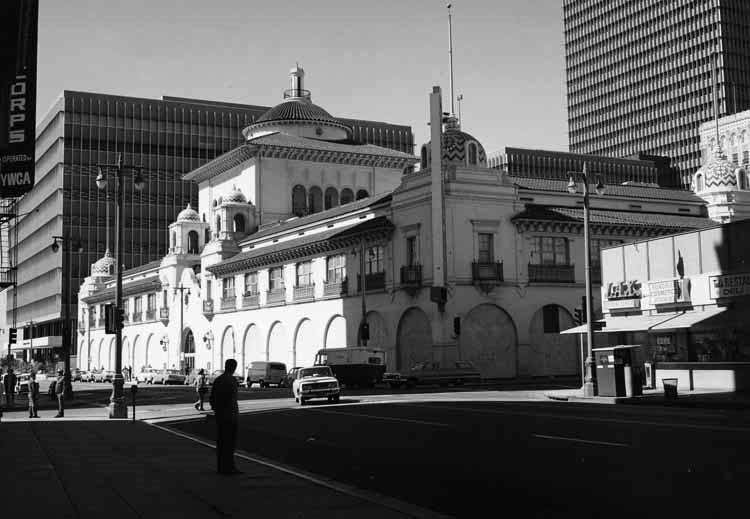 |
|
| (1970)* - View showing a man standing on the curb looking toward the Herald-Examiner Building on the southwest corner of Broadway and 11th Street. Photo by William Reagh. |
Historical Notes On December 15, 1967, Herald Examiner employees began a strike that lasted almost a decade and resulted in at least $15 million in losses. At the time of the labor strike, the paper's circulation was about 721,000 daily and it had 2,000 employees. The strike ended in March 1977, with circulation having dropped to about 350,000 and the number of employees to 700. The paper never recovered from the strike. Many veteran reporters left and never returned. As circulation went into free-fall, advertisers were reluctant to buy space in it, causing revenue to fall even further. The unions campaigned effectively to its working-class readership, urging them to cancel subscriptions. Despite belated efforts to restore some of the paper's luster, the Herald Examiner went out of business November 2, 1989, leaving the Los Angeles Times as the sole city-wide daily newspaper. The San Fernando Valley-based Los Angeles Daily News and a sister San Gabriel Valley publication have tried to fill some of the gap. |
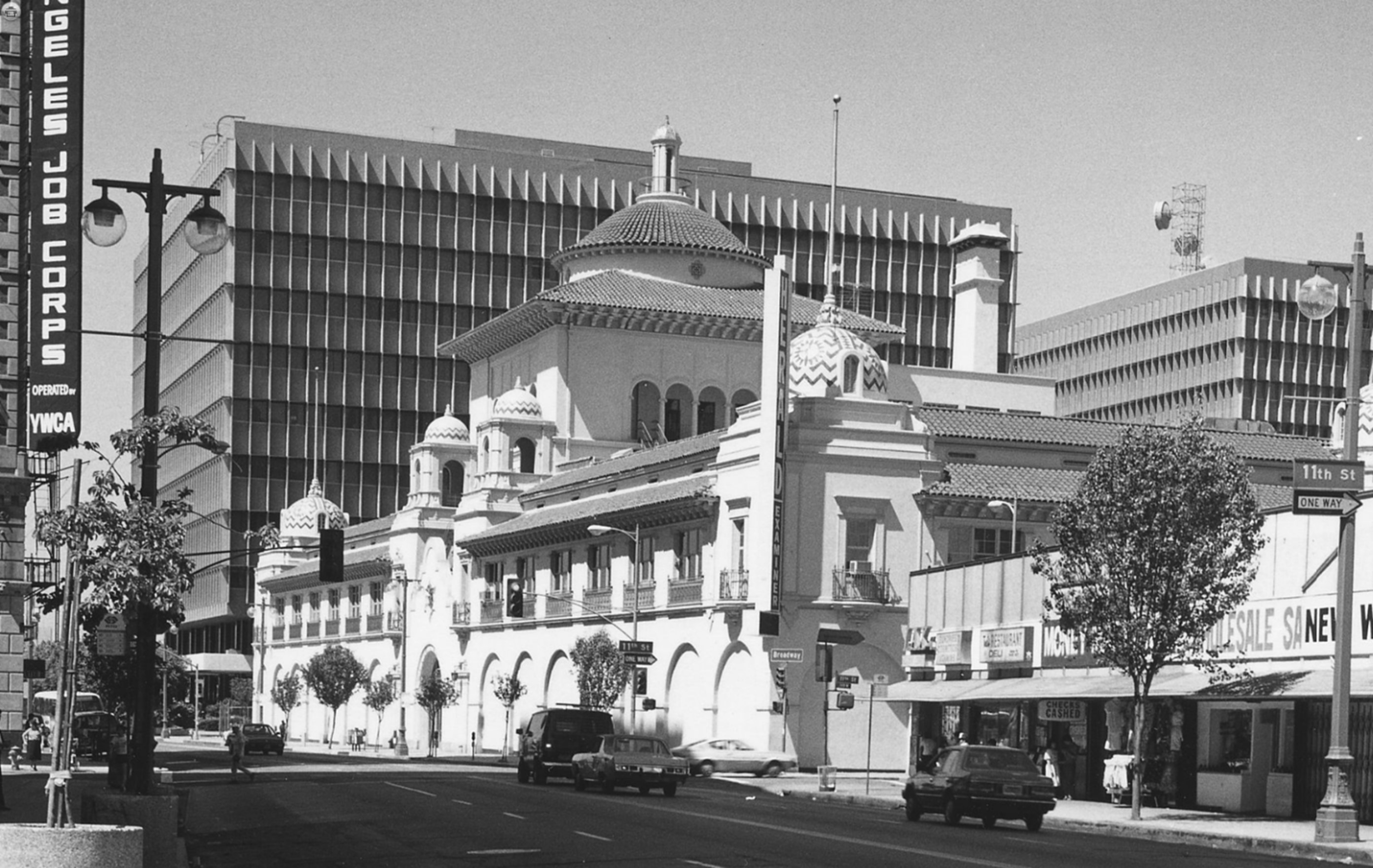 |
|
| (1976)* - View of the Mission Revival style Herald-Examiner Building located at Broadway and 11th Street in downtown Los Angeles, surrounded by other buildings. Photo by William Reagh. |
Historical Notes The ground floor arches of the Herald Examiner Building have a fascinating history of transformation. Originally, these arched street-level windows were sealed off in the 1960s during a labor dispute, remaining boarded up for approximately half a century. This alteration significantly changed the building's appearance and interaction with the street level. However, as part of an extensive $80-million restoration project that began in 2015, these ground floor arches were finally cleared and restored to their original open state. |
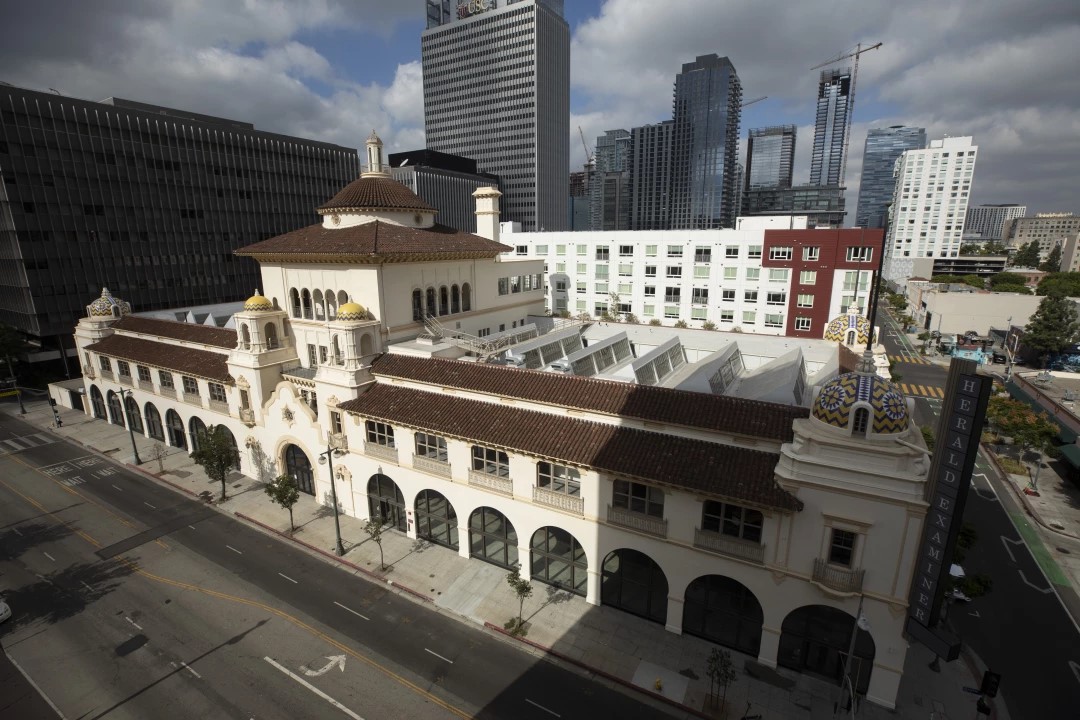 |
|
| (2021)* - The freshly refurbished Herald Examiner building at the corner of Broadway and 11th street in downtown Los Angeles.(Myung J. Chun / Los Angeles Times) |
Historical Notes Completed in 1914, the block-long, Mission Revival structure, with its ornate-to-the-point-of-baroque lobby, represents one of only a handful of L.A. buildings designed by the pioneering architect Julia Morgan — the first woman to be licensed to practice architecture in California. For more than two decades, it was employed primarily as a filming location. “It’s Always Sunny in Philadelphia” and “The Usual Suspects” were among the projects filmed at the site. In 2021, the Herald Examiner building came back from the brink. The building has reopened in a new guise: as a learning center for Arizona State University. |
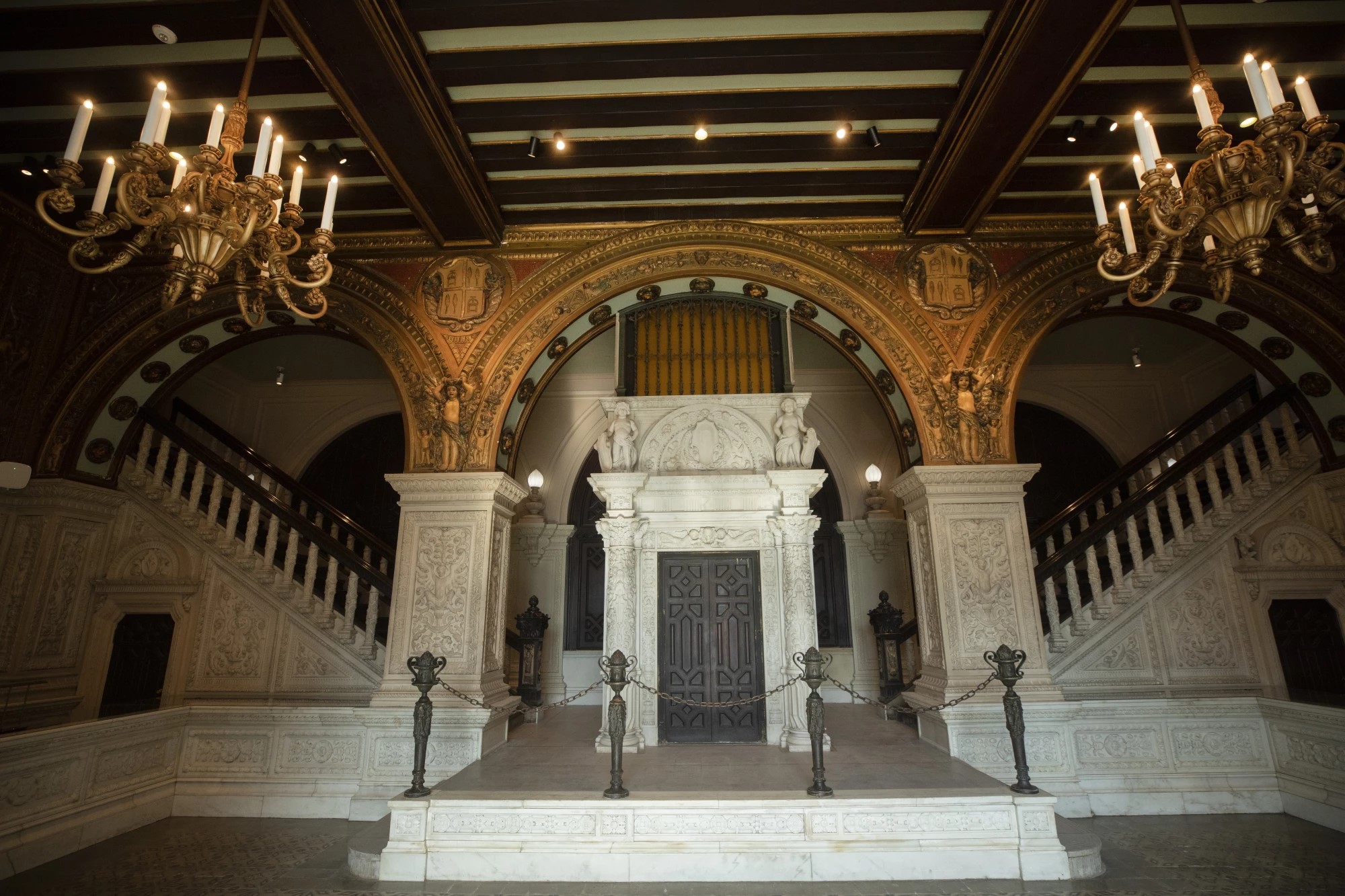 |
|
| (2021)* - Interior view of the building’s exquisite lobby. (Myung J. Chun / Los Angeles Times) |
Historical Notes Architects at Gensler did a thoughtful job of restoring and preserving the building’s iconic portions: the arched facade, the bright, tiled domes that cap the building, the ornate lobby, with the private elevator that once delivered Hearst to his suite. Other areas were revamped to suit contemporary needs.* |
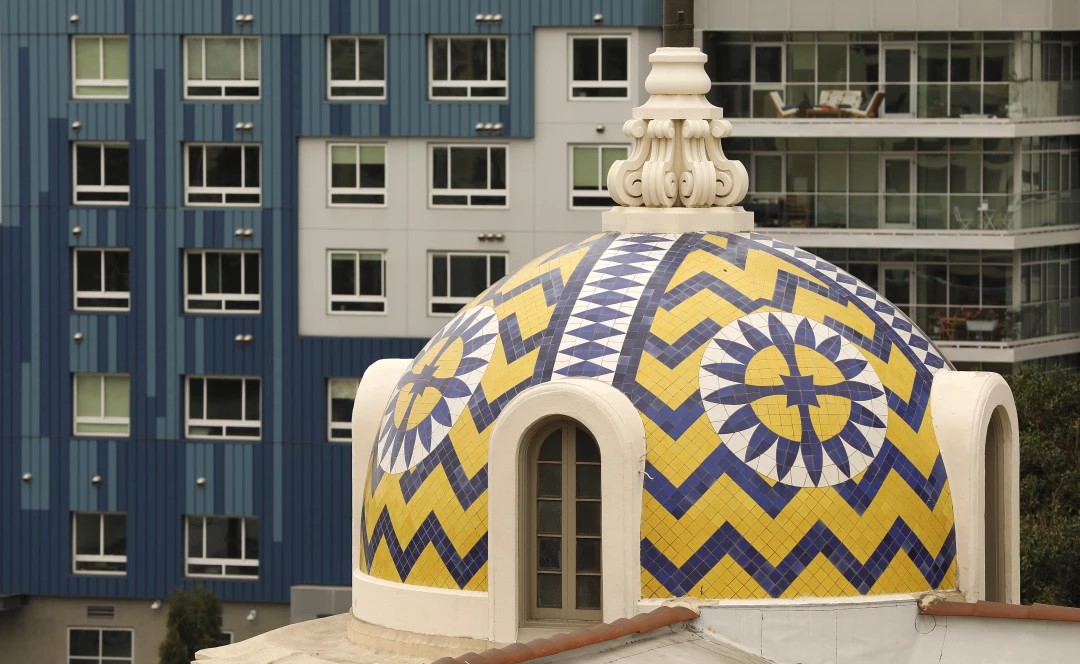 |
|
| (2021)* - Tiled cupolas adorn the roof of the historic Herald Examiner Building located at Broadway and 11th Street in Los Angeles.(Al Seib / Los Angeles Times) |
Then and Now
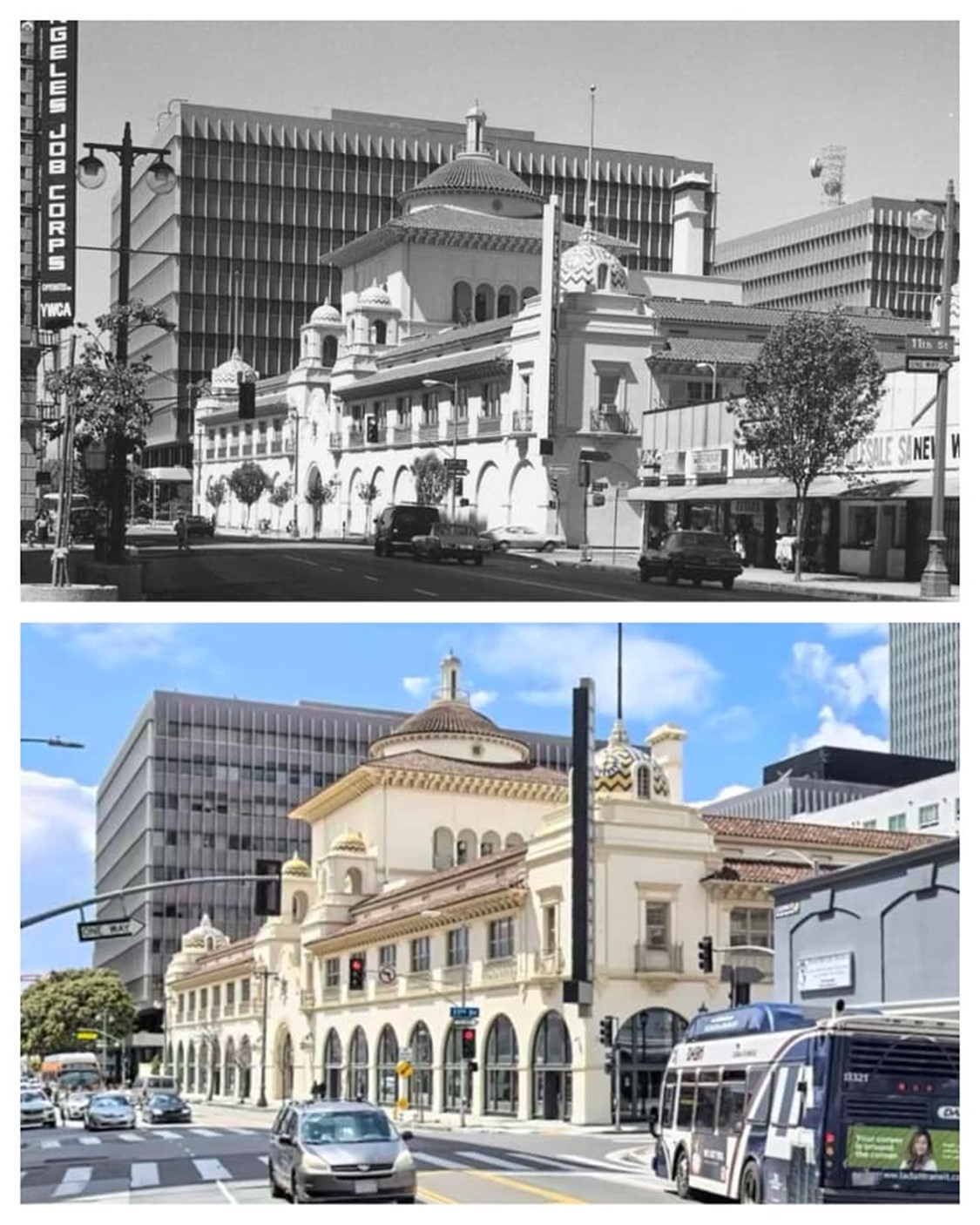 |
|
| (1976 vs 2020s)* – The Examiner Building located at Broadway and 11th Street. Photo comparison by Trey Callaway. |
Historical Notes Completed in 1914, the block-long Herald Examiner Building was commissioned by newspaper magnate William Randolph Hearst to house his Los Angeles Examiner newspaper. Designed by pioneering architect Julia Morgan, the first woman licensed to practice architecture in California, the building blends Mission Revival and Spanish Colonial Revival styles. This project marked the first collaboration between Hearst and Morgan, preceding their more famous work on Hearst Castle in San Simeon. Today, the Herald Examiner Building houses Arizona State University's California Center, along with retail, dining, and event spaces. |
* * * * * |
Trinity Auditorium
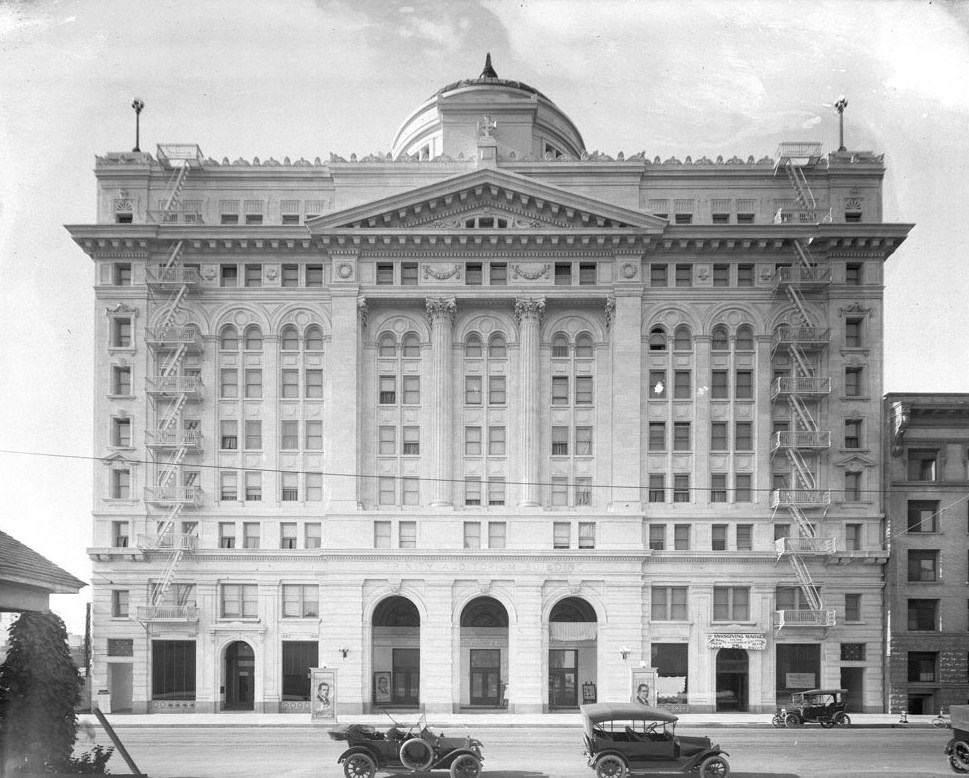 |
|
| (ca. 1914)^ - View of the Trinity Auditorium (later the Embassy Hotel and Auditorium) at 851 S. Grand Avenue. |
Historical Notes The Trinity Auditorium Building opened in 1914. The 9-story Beaux Arts style mixed use hotel, office building and auditorium was designed by architects: Thornton Fitzhugh, Frank G. Krucker and Harry C. Deckbar. The auditorium with a seating capacity of 1,600 to 2,500 featured balconies on three sides and a stained glass ceiling. When it was the Trinity Auditorium Building and being used as a church, three stories of the building were church offices and the hotel portion (325 rooms) was a hotel for men. The auditorium had a huge pipe organ. It was church on Sundays and the auditorium was rented to meetings, conventions, etc. during the week. |
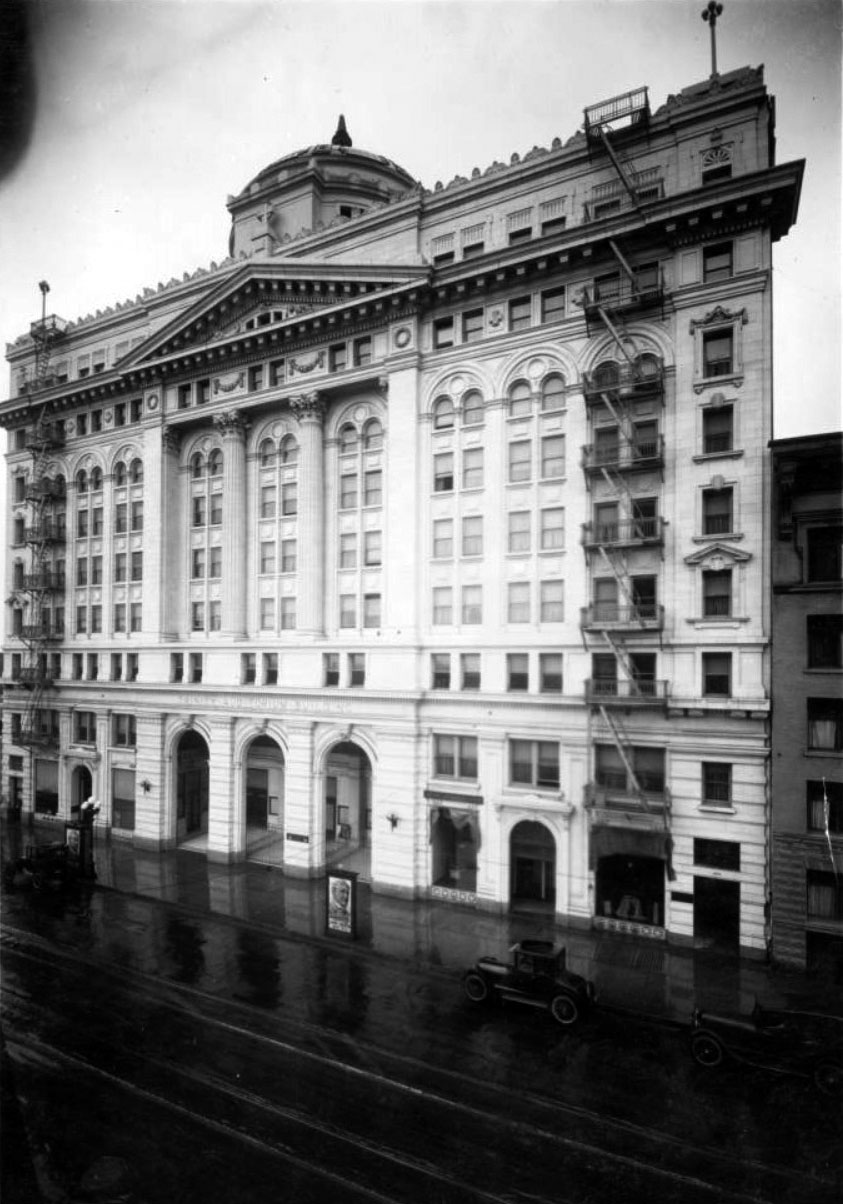 |
|
| (ca. 1914)^ - View showing the Trinity Auditorium, Northwest corner of 9th and Grand. The nine-story Italianate building can be seen with three arches delineating its entrance. A sign stands on the sidewalk in front, featuring a man's face, while two automobiles can be seen farther right, parked on the street. |
Historical Notes The L.A. Philharmonic played their first season here before moving to the Temple Theatre, which they re-christened the Philharmonic Auditorium. When the hotel became the Embassy Hotel, the auditorium was known as the Embassy Auditorium. |
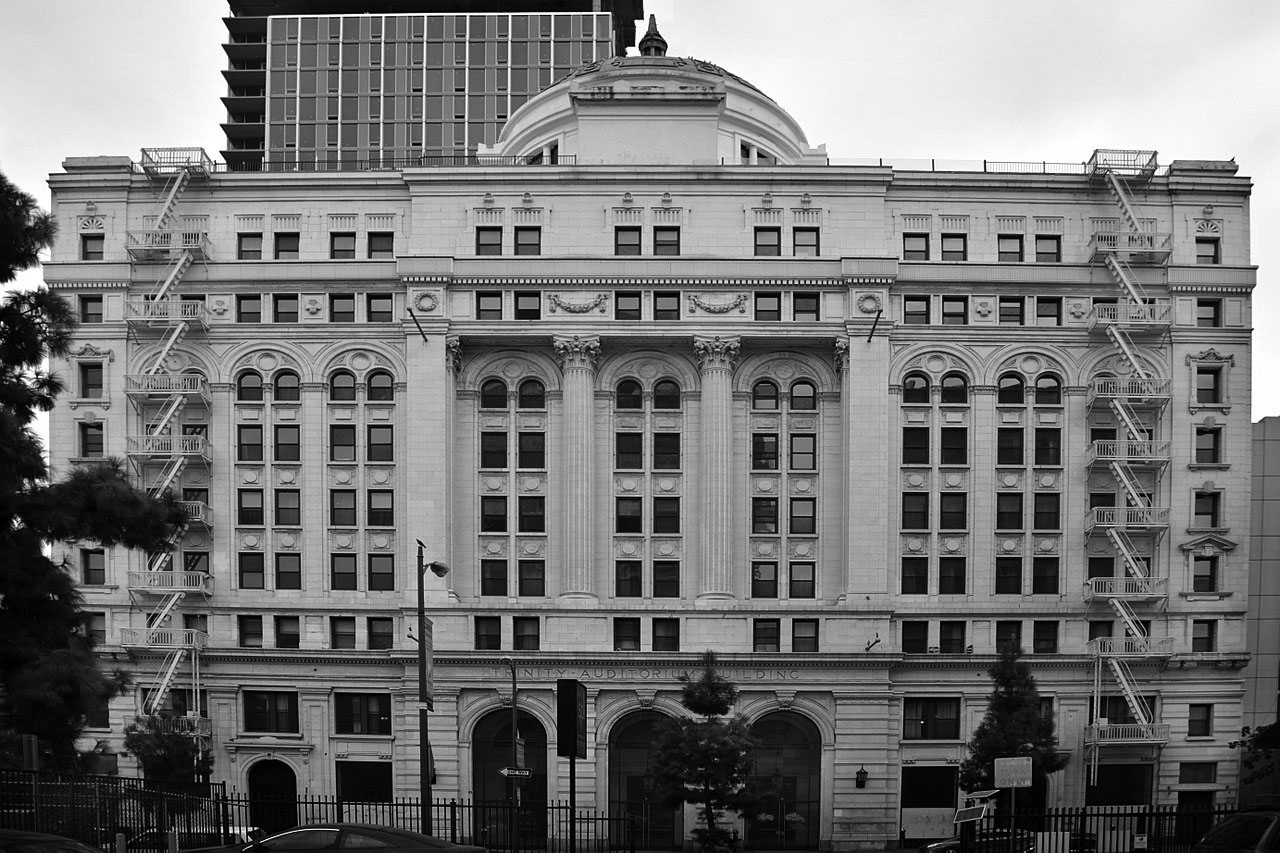 |
|
| (2017)* - Trinity Auditorium, now the Embassy Hotel. Photo by Glenn Francis |
Historical Notes The building was acquired by the University of Southern California in the 1987, when it was used as a residential building and an annex. They sold it to the Chetrit Group, chaired by Joseph Chetrit, in 1998. |
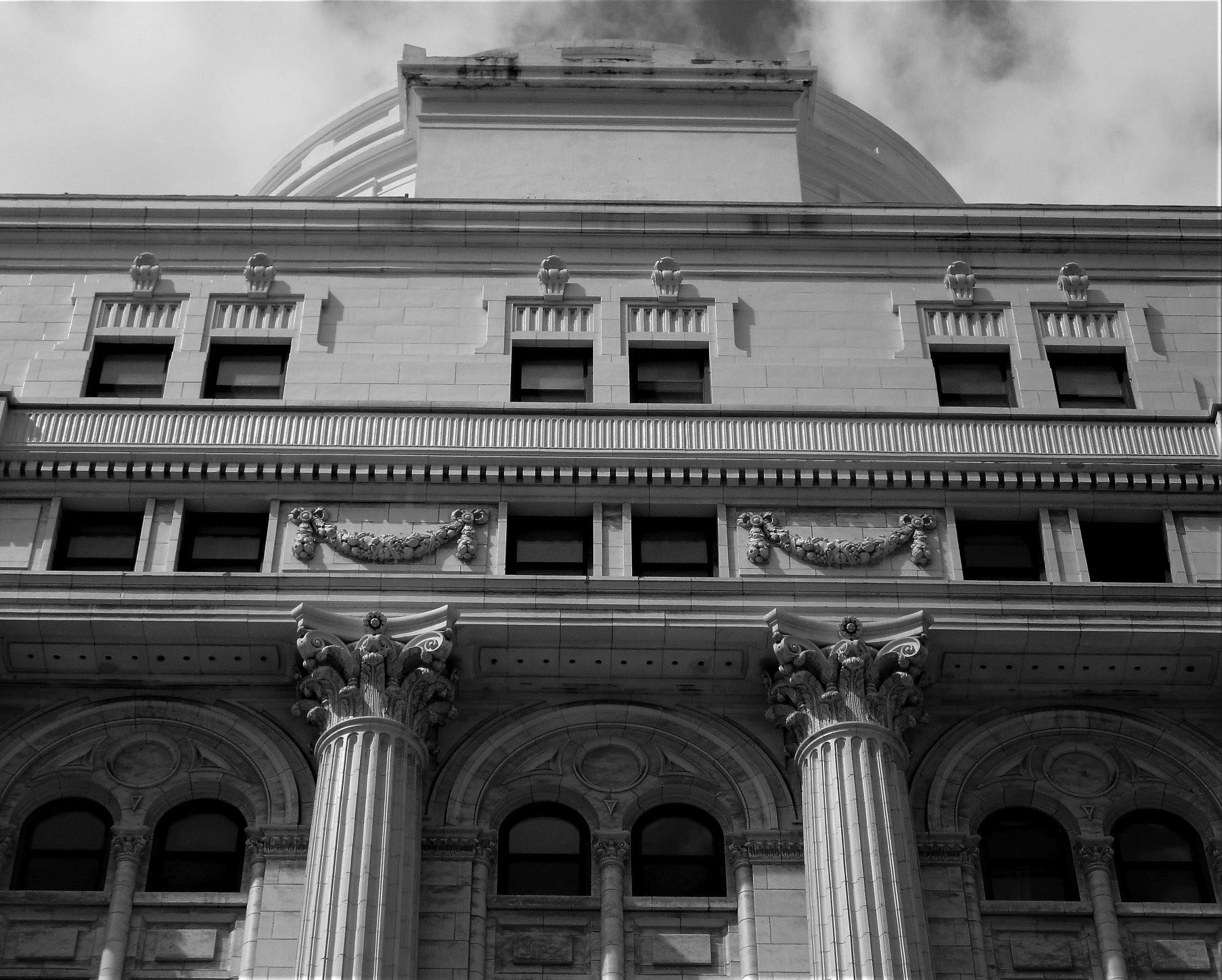 |
|
| (2019)* - Close-up detail view of the Trinity Auditorium as it appears today, 851 S. Grand Avenue. Photo by Howard Gray |
Historical Notes By 2005, the Chetrit Group decided to remodel the building as the Gansevoort West hotel scheduled for 2006. The new hotel was supposed to be an LA version of the Hotel Gansevoort in New York City. However, by 2007, the project had been cancelled. By 2012, the owners decided to turn it into another hotel called the Empire Hotel, with "183 hotel rooms, a groundfloor restaurant, an outdoor garden, a bar, and an entertainment venue." The remodel was still underway in 2014. |
* * * * * |
Southern Pacific Depot (aka Central Station)
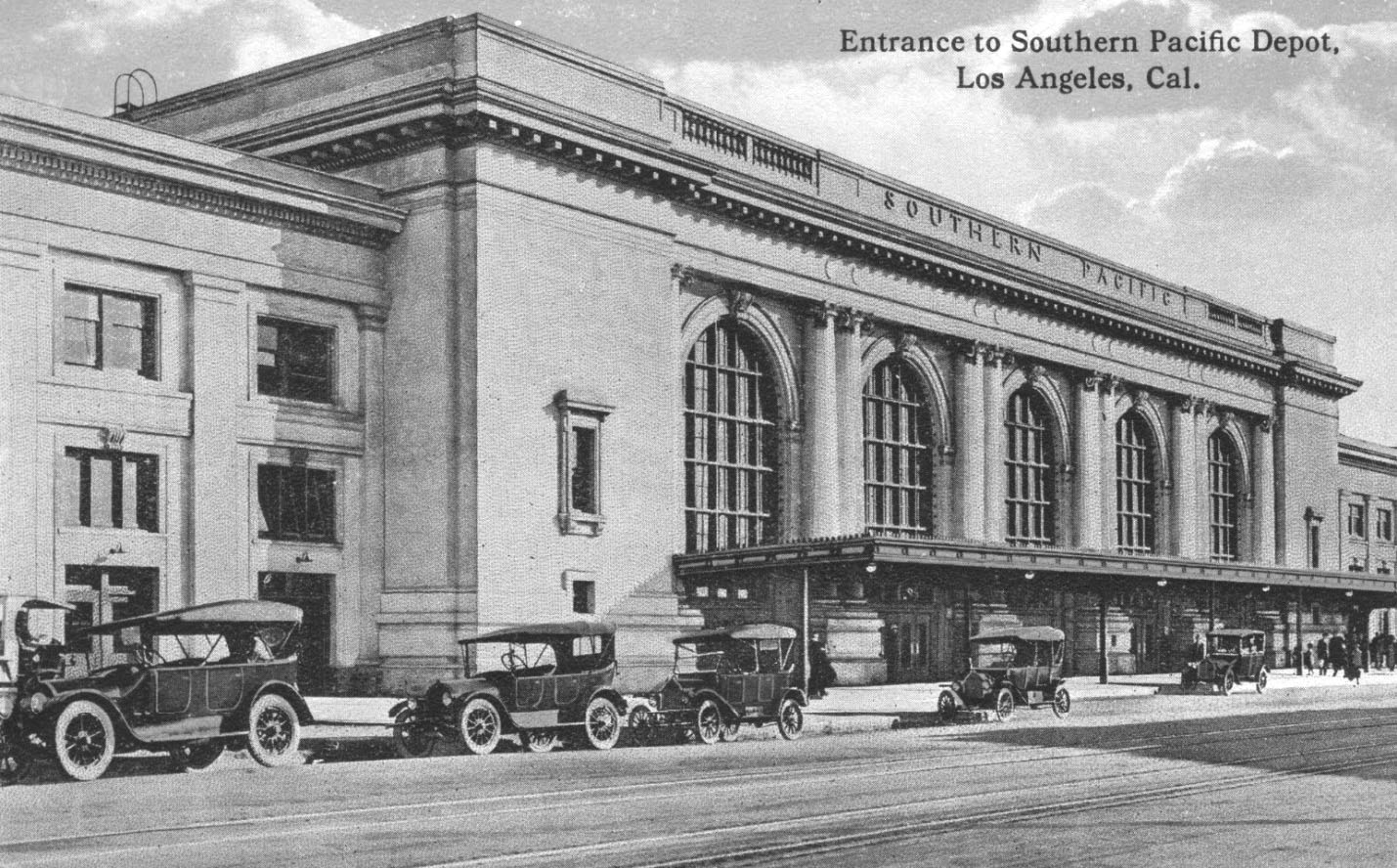 |
|
| (ca. 1915)* – Postcard view showing the entrance to Beaux Arts style Southern Pacific Depot (aka Central Station) located at 5th and Central streets in Downtown LA. |
Historical Notes In 1914, the Southern Pacific Railroad replaced its Arcade Station (built in 1888) with the Central Station, a larger and more modern railroad passenger depot. The Union Pacific Railroad moved its Downtown Los Angeles passenger terminal to Central Station in 1924 after its original passenger depot just south of First Street on the east side of the Los Angeles River was destroyed by fire. |
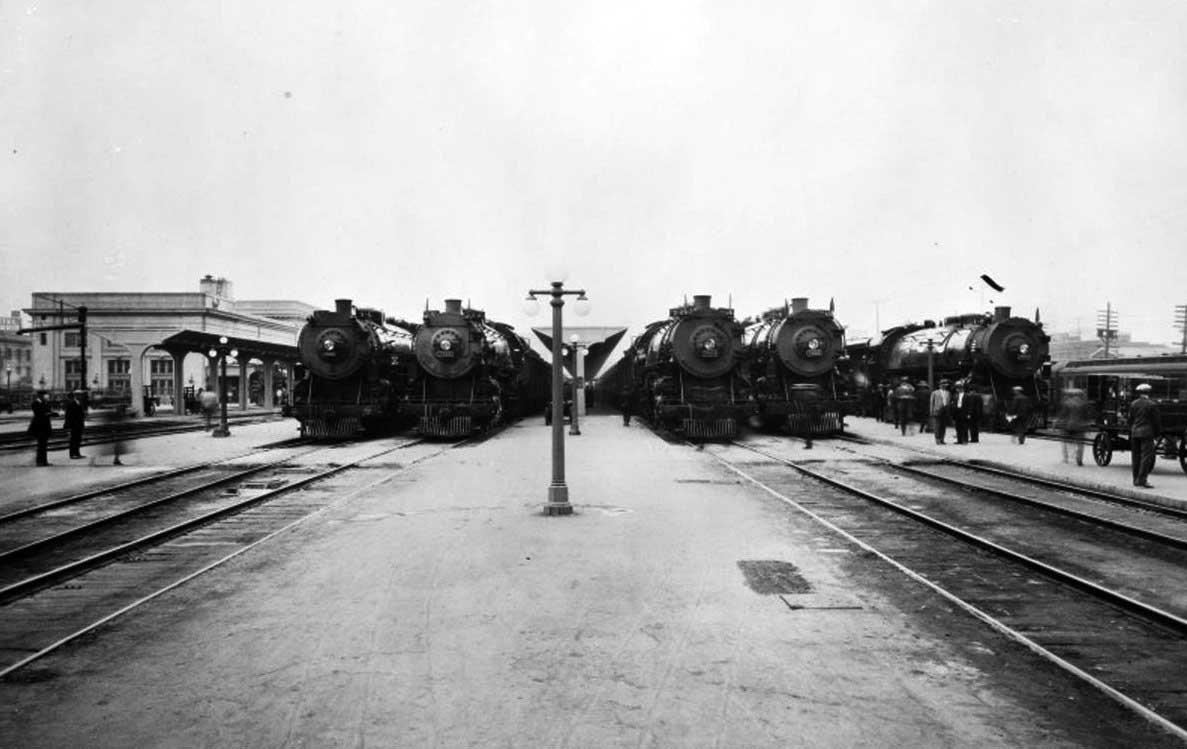 |
|
| (ca. 1920)* – View showing 5 Union Pacific locomotives at Central Station as train passengers wait while railroad employees do their jobs. Across from Central Station, the Hotel Morris can be seen in the distance. |
Historical Notes Central Station was used by Southern Pacific and Union Pacific Railroads, and was located on Central Avenue at the end of 5th Street. |
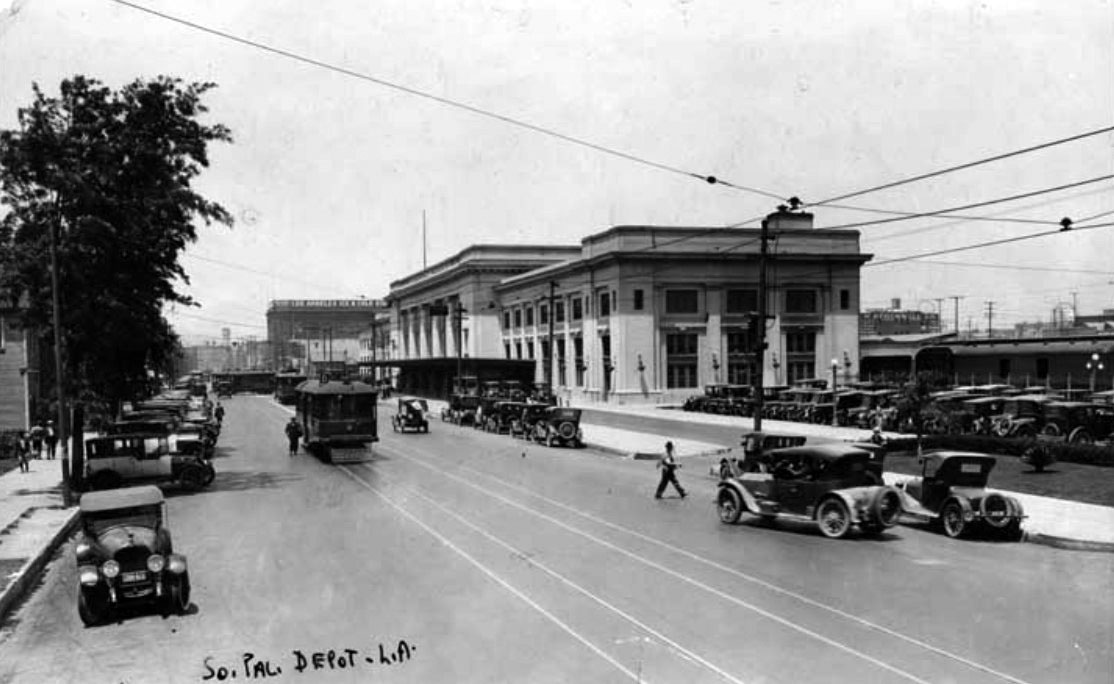 |
|
| (ca. 1924)^ - View looking south on Central showing the Southern Pacific Railroad Depot (aka Central Station) with streetcars and autos sharing the street. Taxi cabs can be seen across the depot (on the left), parked perpendicular to the curb, waiting for passengers to arrive. |
Historical Notes The Southern Pacific depot was one of three railroad depots that served the Los Angeles area before the construction of Union Station in 1939. The Southern Pacific Arcade depot was originally constructed in 1888 at 5th and Central streets. 26 years later, in 1914, the station was rebuilt on an adjoining site, and renamed to Central Station. In 1924, the Union Pacific Railroad moved its Downtown Los Angeles passenger terminal to Central Station after its original passenger depot was destroyed by fire. The Central Station, along with the "La Grande" Santa Fe Railroad Passenger Depot, was replaced in 1939 by Union Station and later demolished. |
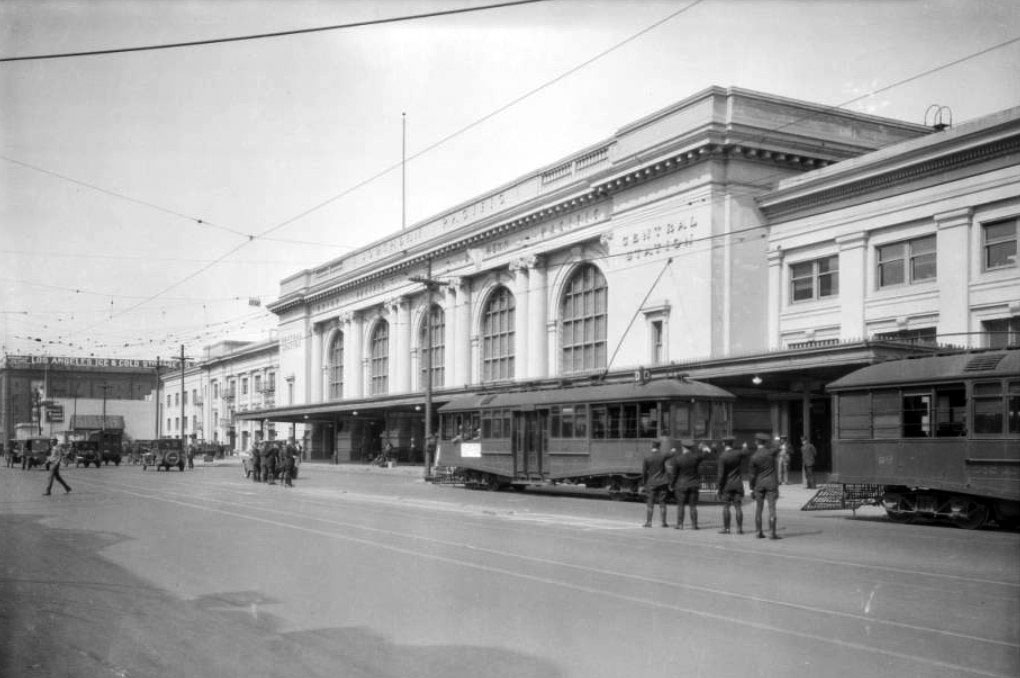 |
|
| (1927)^^ – Streetcars are lined up in front of the Southern Pacific Depot, with what appears to be uniformed porters waiting for passengers to arrive. |
Historical Notes The Southern Pacific depot was one of three railroad depots that served the Los Angeles area before the construction of Union Station in 1939. The Southern Pacific Arcade depot was originally constructed in 1888 at 5th and Central streets. 26 years later, in 1914, the station was rebuilt on an adjoining site, and renamed to Central Station. In 1924, the Union Pacific Railroad moved its Downtown Los Angeles passenger terminal to Central Station after its original passenger depot was destroyed by fire. The Central Station, along with the "La Grande" Santa Fe Railroad Passenger Depot, was replaced in 1939 by Union Station and later demolished. |
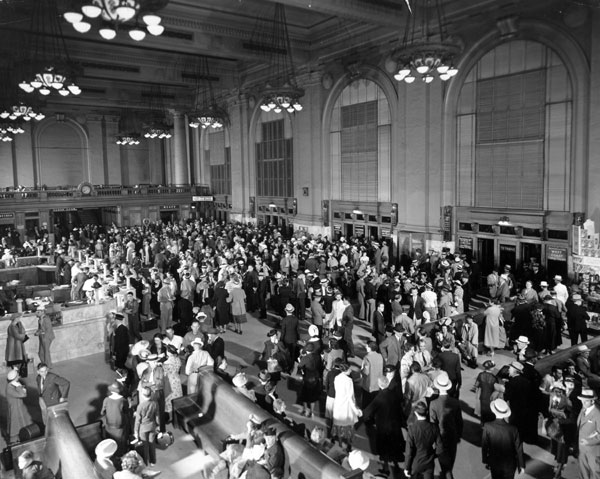 |
|
| (ca. 1920s)^^ - Interior view of the Central Station lobby jam-packed with people. |
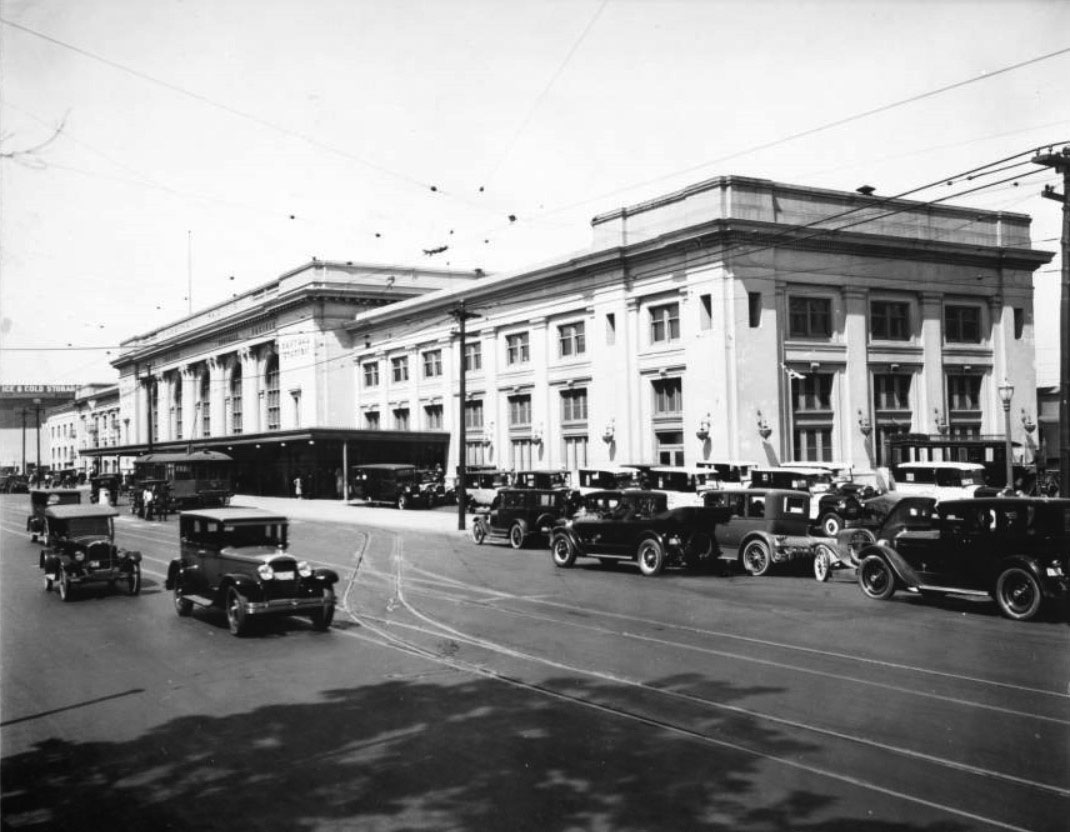 |
|
| (1926)^ - View showing the Southern Pacific depot, located at Fifth Street and Central Street. Text above the entrance of the building reads "Southern Pacific" and "Central Station". A streetcar sits to the left of center, in front of the depot, while parked automobiles line the street in the right foreground. |
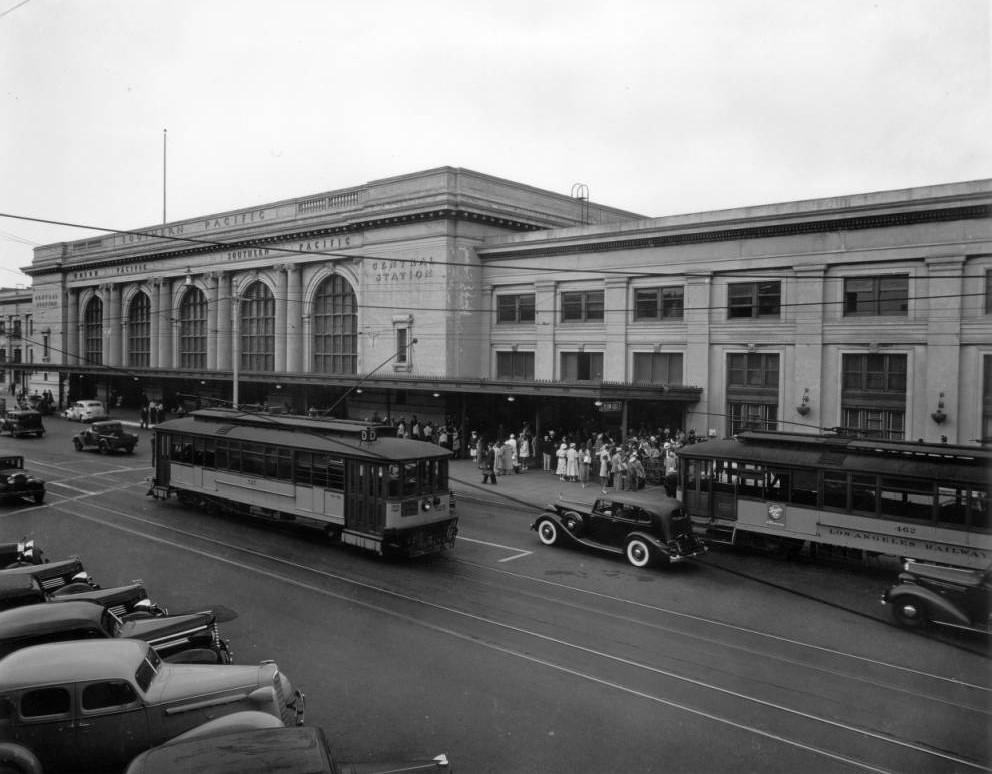 |
|
| (1937)*^ - View showing the Southern Pacific, Union Pacific Central Station located at Central Avenue and 5th Street. |
Historical Notes The Central Station, along with the "La Grande" Santa Fe Railroad Passenger Depot (2nd St. and Santa Fe Ave.), was replaced in 1939 by Union Station and later demolished.^* |
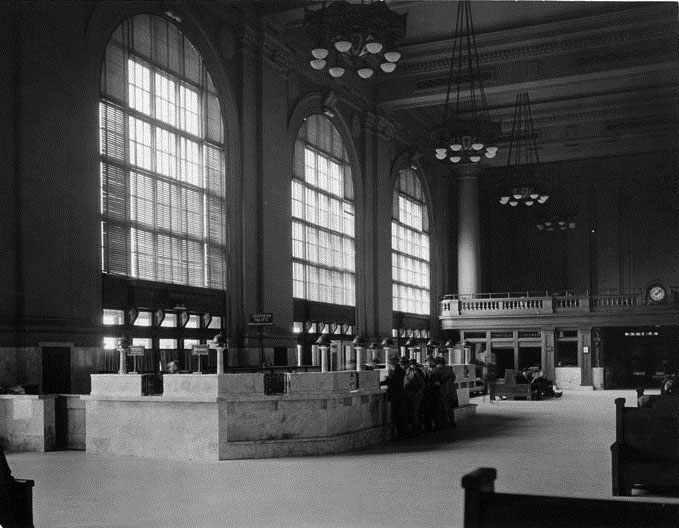 |
|
| (ca. 1930s)*^^ - The interior of Central Station is lit by the sun pouring through the large windows. |
 |
|
| (1937)^.^ – View showing Southern Pacific 4416 “Daylight” at Central Station. |
Historical Notes Southern Pacific trains known as 'Daylights' ran during the daytime between San Francisco and Los Angeles beginning in 1937. The first 'Daylight' train left at 8:15 a.m. In January 1940 the 'Noon Daylight' train was added to accommodate additional passengers; it departed daily at noon. |
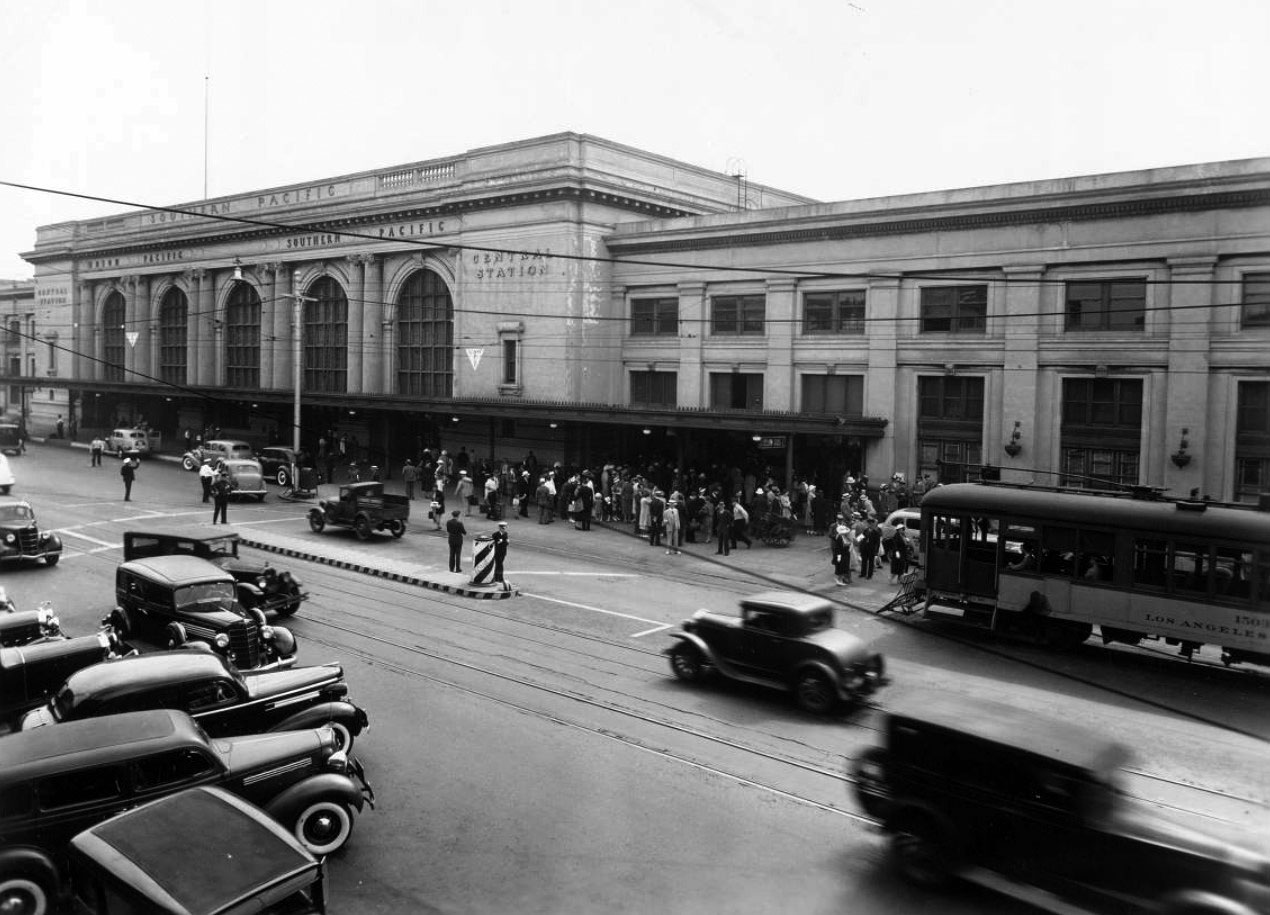 |
|
| (ca. 1937)^^ - A crowd is gathered in front of the Old Central Railroad Station with cars parked on the other side of the street. |
Historical Notes The Central Station, along with the "La Grande" Santa Fe Railroad Passenger Depot (2nd St. and Santa Fe Ave.), was replaced in 1939 by Union Station. The trains moved to Union Staton but the building, with exterior adornments removed, stood until the late 1960s. |
* * * * * |
Robinson's Department Store
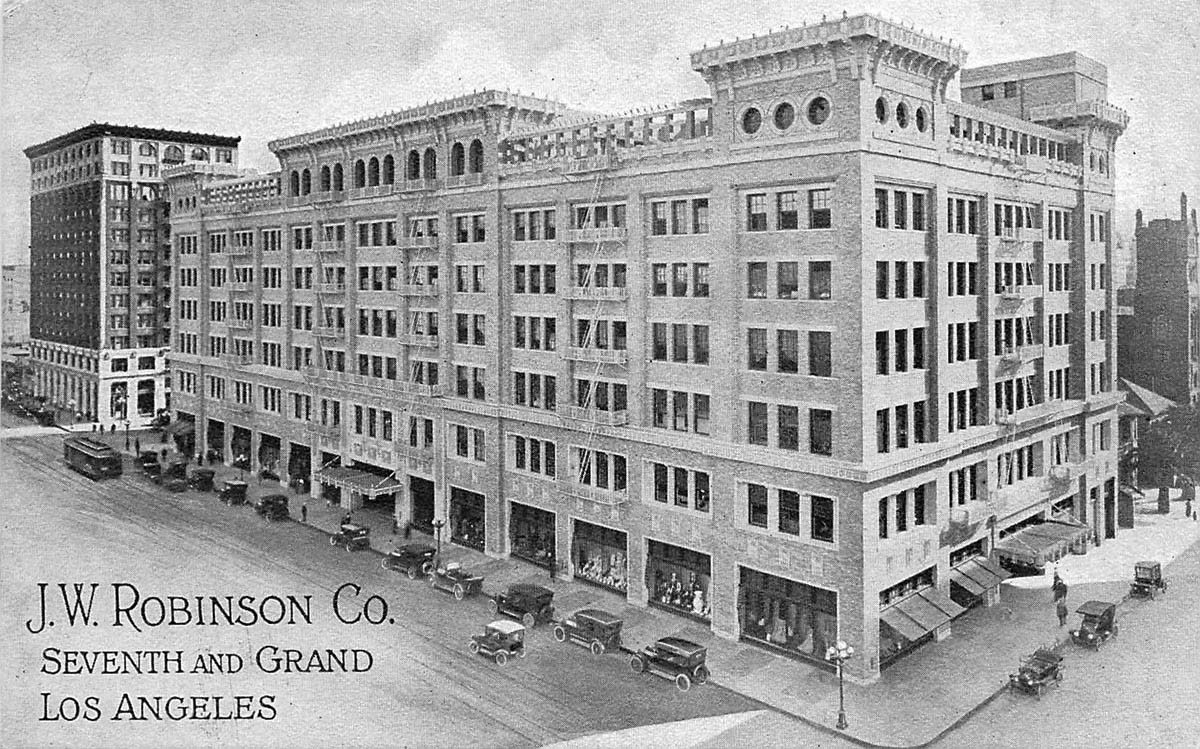 |
|
| (ca. 1915)^ – Postcard view showing the newly constructed J. W. Robinson Co.’s Store on the corner of 7th Street and Grand Avenue. The flipside of the postcard reads: “Where nine acres of floor space, perfectly lighted, equipped with the most modern fixtures and served by ten large passenger elevators, place the convenience and dispatch of the finest Dry Goods Store in America at the disposal of the public.” |
Historical Notes Robinson's Department Store started off life as the Boston Dry Goods Store in 1881 (Boston was a popular name for dry goods stores). It moved from 239 S. Broadway to this location on 7th Street and Grand in 1915 and designed by Noonan and Richards. It was modernized in 1934 by Edward L. Mayberry. Robinson's was acquired by May Department Stores in 1986 and it merged with the May Company in 1993. This store was closed in the early 1990s when Robinson's-MAY was created and moved into the May Company store at Citicorp Plaza. Robinsons-May was bought out by Macy's and this nameplate was retired.* |
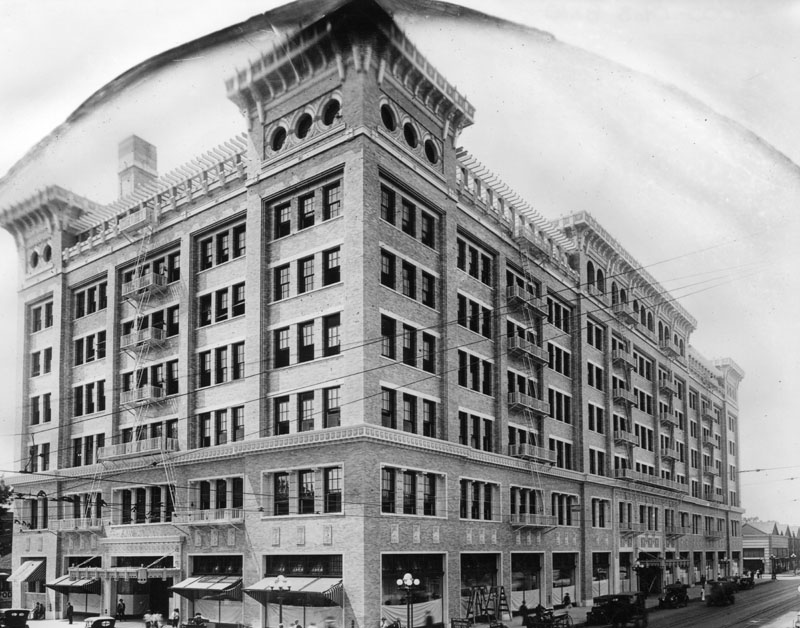 |
|
| (ca. 1915)* - Corrner view of J.W. Robinson's department store at 7th Street and Grand. |
Historical Notes When it opened in September of 1915, the seven-story building of beige pressed brick, trimmed in cream and polychrome terracotta, was described in the press as “a retail palace” with “all the conveniences and attractions of a great club and meeting place.” The distinctive building with its corner towers, deeply projecting cornices, and oculus windows featured 10 passenger elevators for vertical conveyance, and two roof gardens on either side of a seventh-floor dining room approached through a foyer “arranged as a palm room."* |
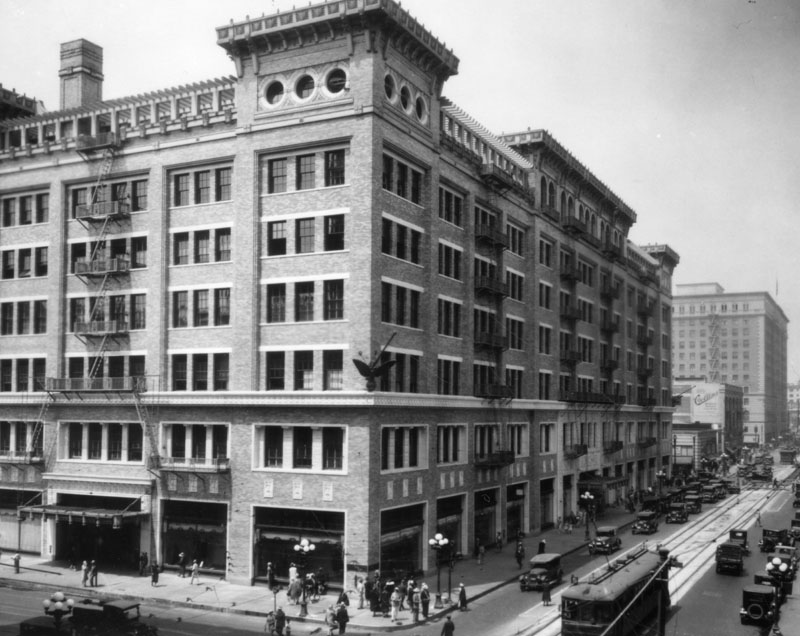 |
|
| (1928)* - Another view of J.W. Robinson department store at 7th and Grand. The brick-faced building is seven stories with pergolas on the roof. Fire escapes descend periodically. Globular street lamps line the sidewalks and there is substantial pedestrian and automobile traffic on the street. |
Historical Notes When the Robinson's Department Store first opened, some voices raised criticism over its out-of-the-way location, but by the time it became established along Seventh Street, it helped to establish a high-class shopping district. Robinson’s prosperity at Seventh and Grand was such that a seven-story addition to the south was constructed in 1923, bringing the store’s square footage up to 624,000 sq. ft.* |
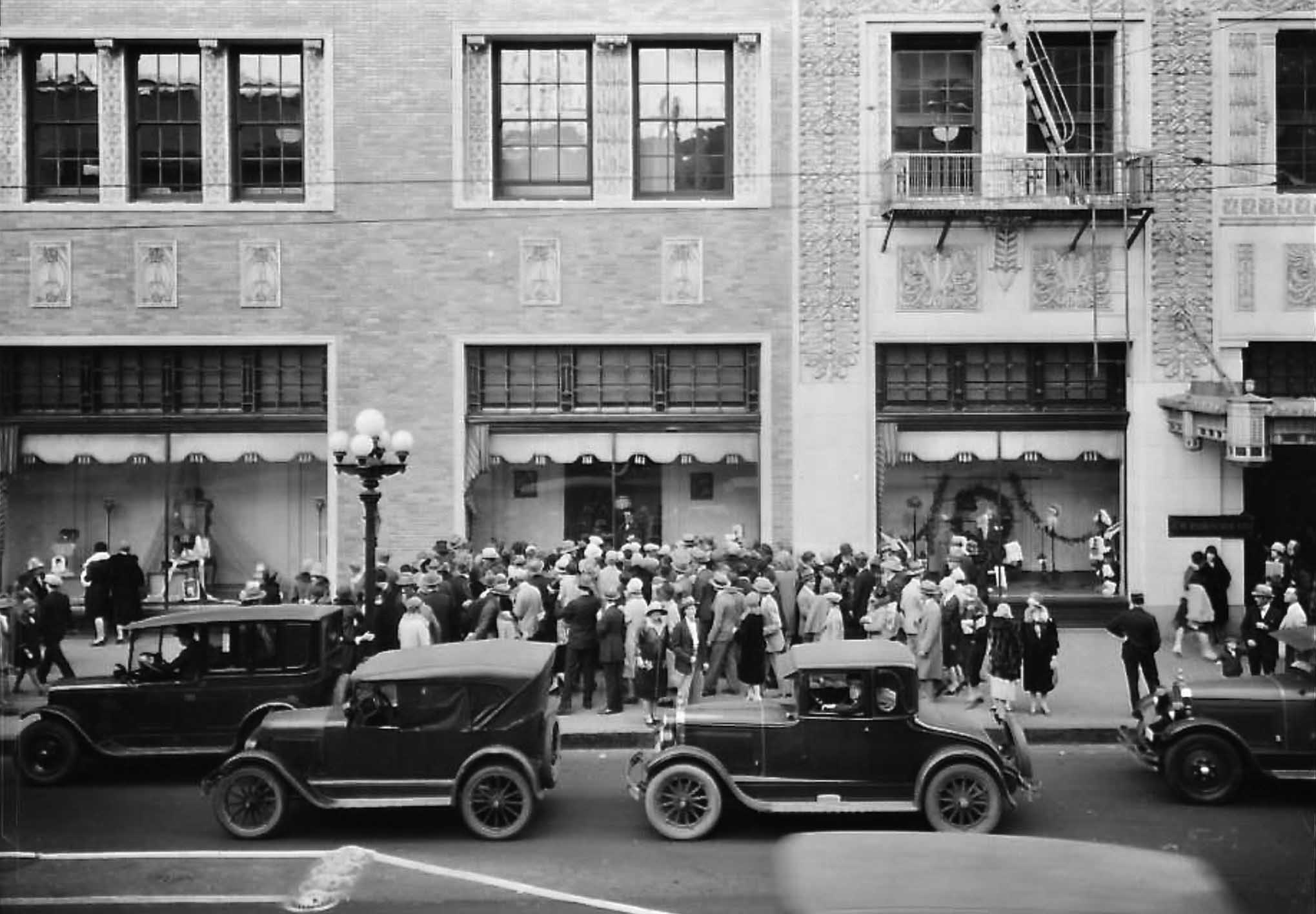 |
|
| (1926)* - J.W. Robinson department store-crowd watching window. |
Historical Notes The front was "Grecian" (Greek Revival) in style, of light cream brick and terra cotta. It featured an elaborate Corinthian-style cornice crowning the façade. Above it rose a high parapet broken by a high-relief entresol panel. All of this was surmounted by elaborate acroteria. 60-foot-long, 19.5-foot-high plate glass windows illuminated the ground floor.^ |
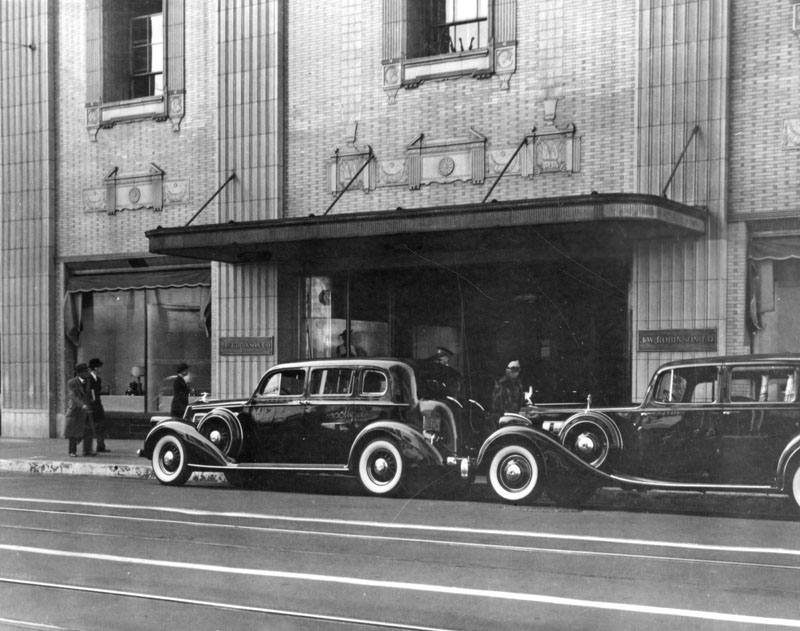 |
|
| (1938)* - Seventh street entrance to the J.W. Robinson department store. A canopy covers the entrance. Two black Rolls-Royce automobiles are parked in front. Second-story windows are recessed and flanked by stylized columns. Friezes with classical Greek themes are above the entrance and display windows. |
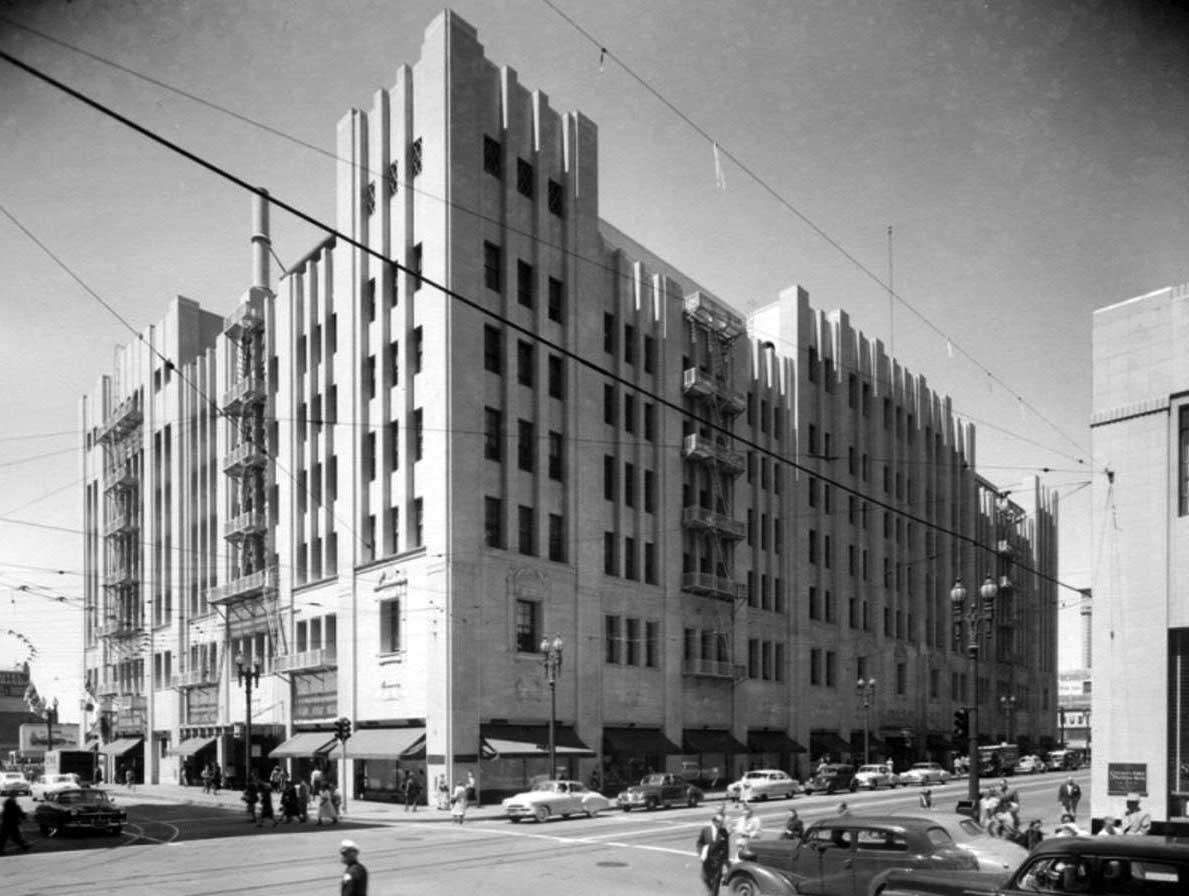 |
|
| (1951)* - A corner view of J.W. Robinson department store at 7th and Grand after remodeling. |
Historical Notes In 1988, the Robinson's Department Store Building was designated LA Historic-Cultural Monument No. 357 (Click HERE to see complete listing). Click HERE to see contemporry view. |
Now and Then
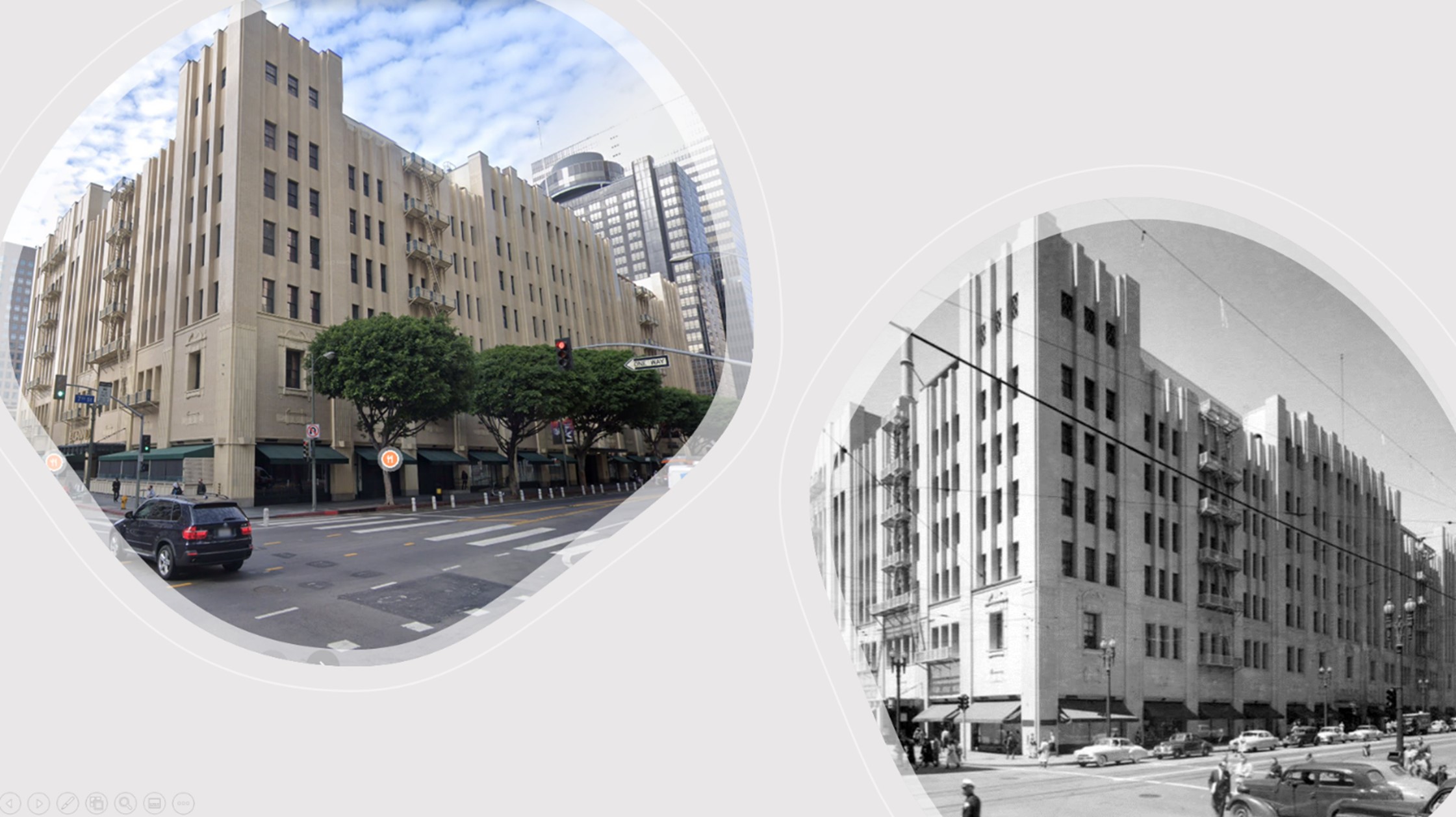 |
|
| (2022 vs. 1951) - Robinson's Department Store Building - Grand and 7th, SW corner. |
Then and Now
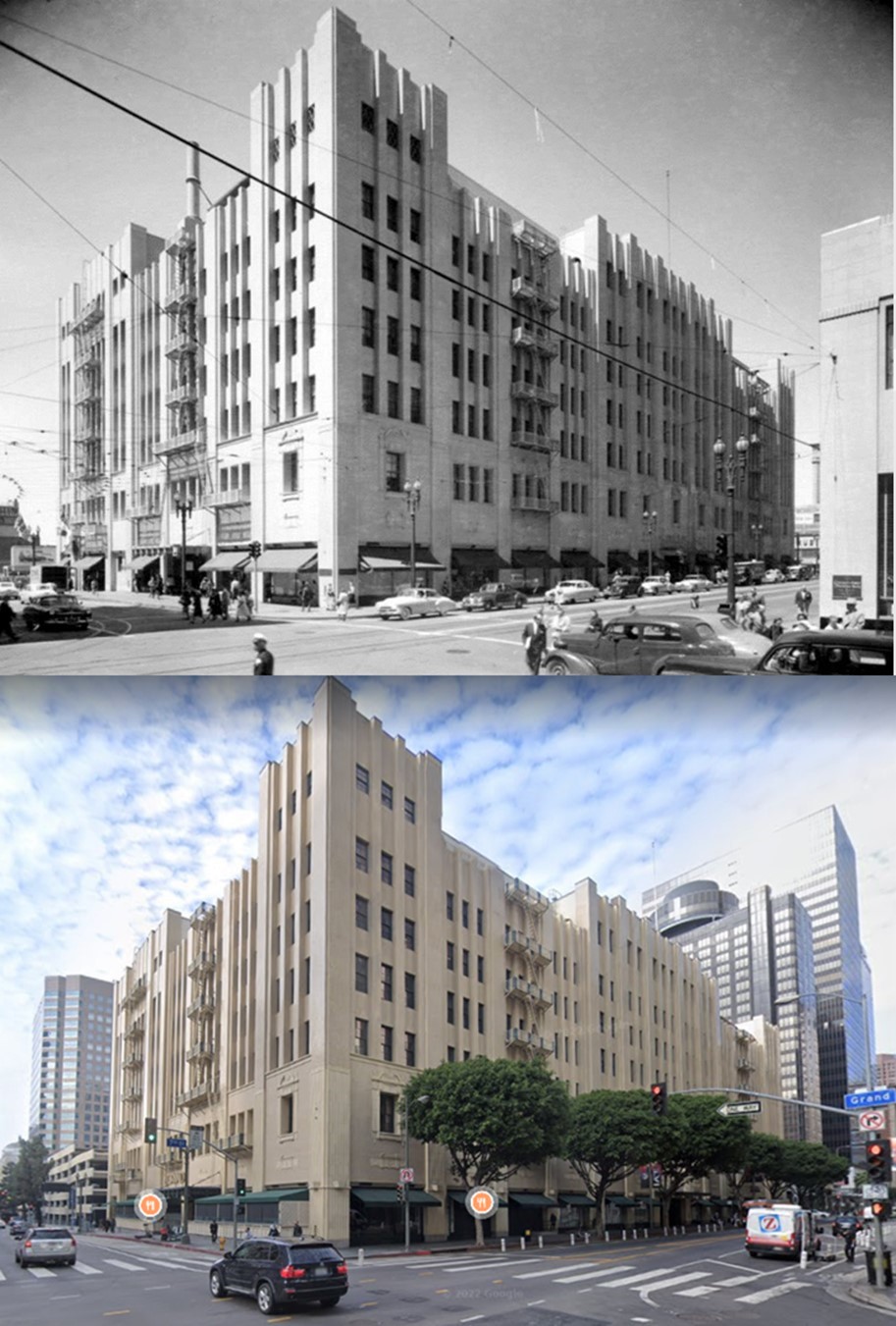 |
|
| (1951 vs. 2022) – Looking at the SW corner of Grand Ave and 7th Street showing the 1915-built J.W. Robinson's Department Store. The original building was remodeled (Arch: Edward L. Mayberry) in 1934 into what you see here, a “restrained Modernistic” exterior. The Robinson's store closed in 1993 and the building, 600 W. Seventh St., currently houses telecommunications (voice, data and internet servers), offices and ground-floor retail. |
* * * * * |
Arroyo Seco Branch Library
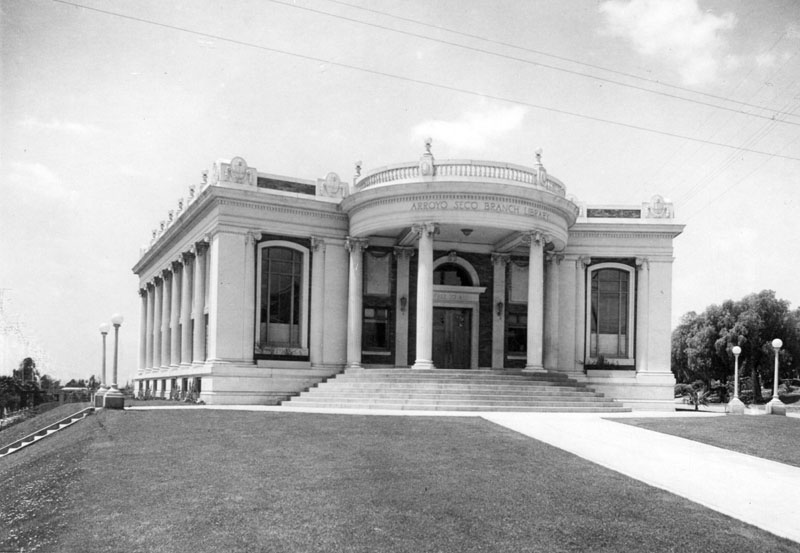 |
|
| (1914)* - View showing the Arroyo Seco Branch Library located at 6145 North Figueroa Street (was 6545 Pasadena Avenue, renamed North Figueroa Street), Highland Park. Note the tall columns that grace a rounded entranceway to the building. |
Historical Notes The Arroyo Seco branch was completed in 1914. It was the second branch built between 1913 and 1916 with a $210,000 Carnegie grant obtained by Los Angeles in 1911 and designated for six branches. All but one included a basement assembly room and an outdoor reading area. |
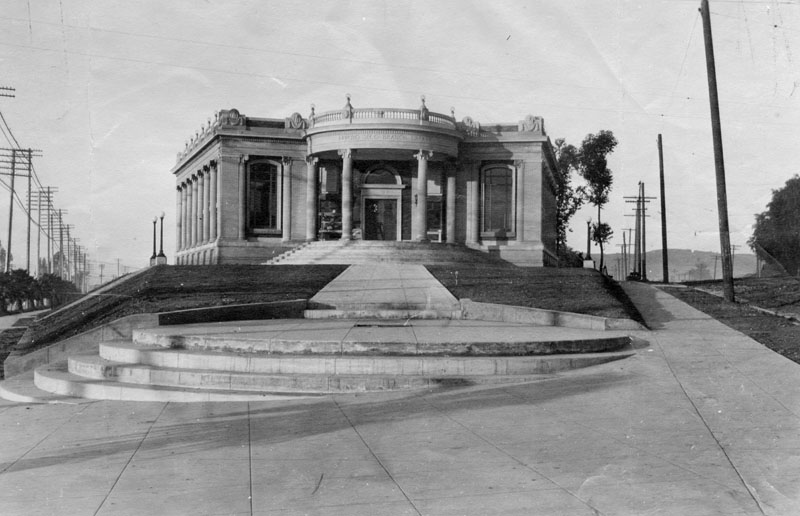 |
|
| (ca. 1916)* - Exterior view of Arroyo Seco Branch Library at 6145 North Figueroa Street. Steps and a flagpole is at the very front of the property. The pole line to the right, on Piedmont St., includes the first power pole installed by the Los Angeles Bureau of Power and Light (later DWP). Click HERE to see more in LA's First Municipal Power Pole. |
Historical Notes The architect, Frederick Ashley, designed the building in the Classical Revival style. The Arroyo Seco branch can be traced back through the old Garvanza and Highland Park branches to the Stimson Memorial Library at Occidental College. The building was demolished in 1959 and the new Arroyo Seco branch built on the same site.* |
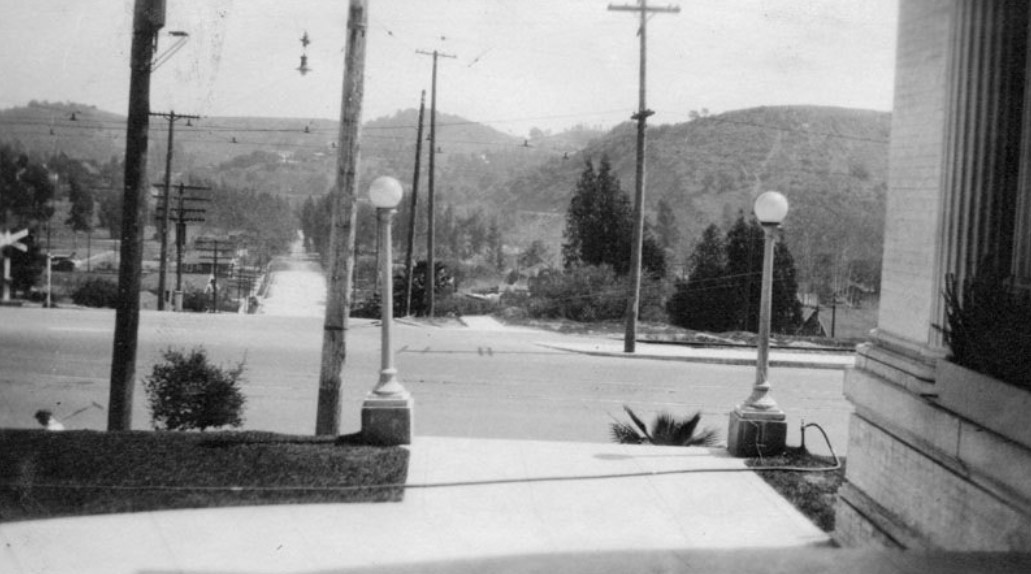 |
|
| (ca. 1920)* - View looking east out from the Arroyo Seco Public Library across North Figueroa Street. |
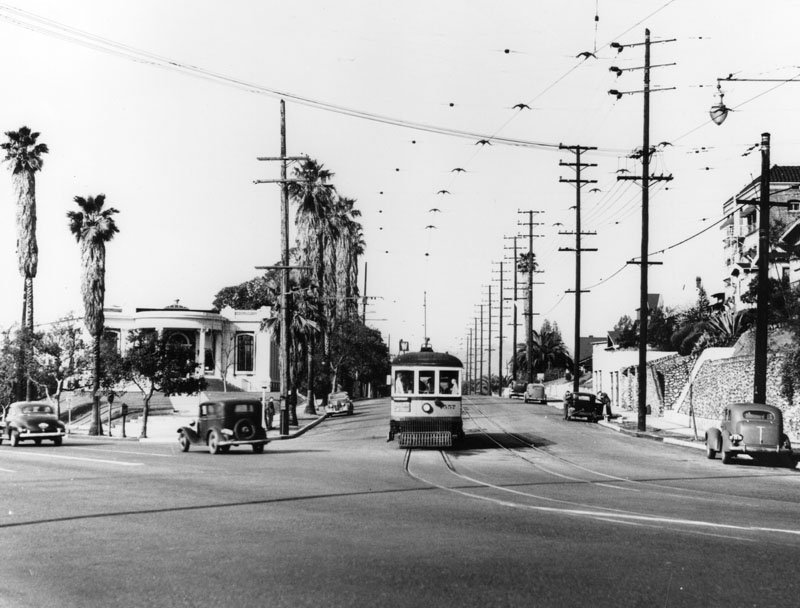 |
|
| (1946)* - View looking southwest on Piedmont Avenue showing streetcar heading towards the bend at N. Figueroa Street. |
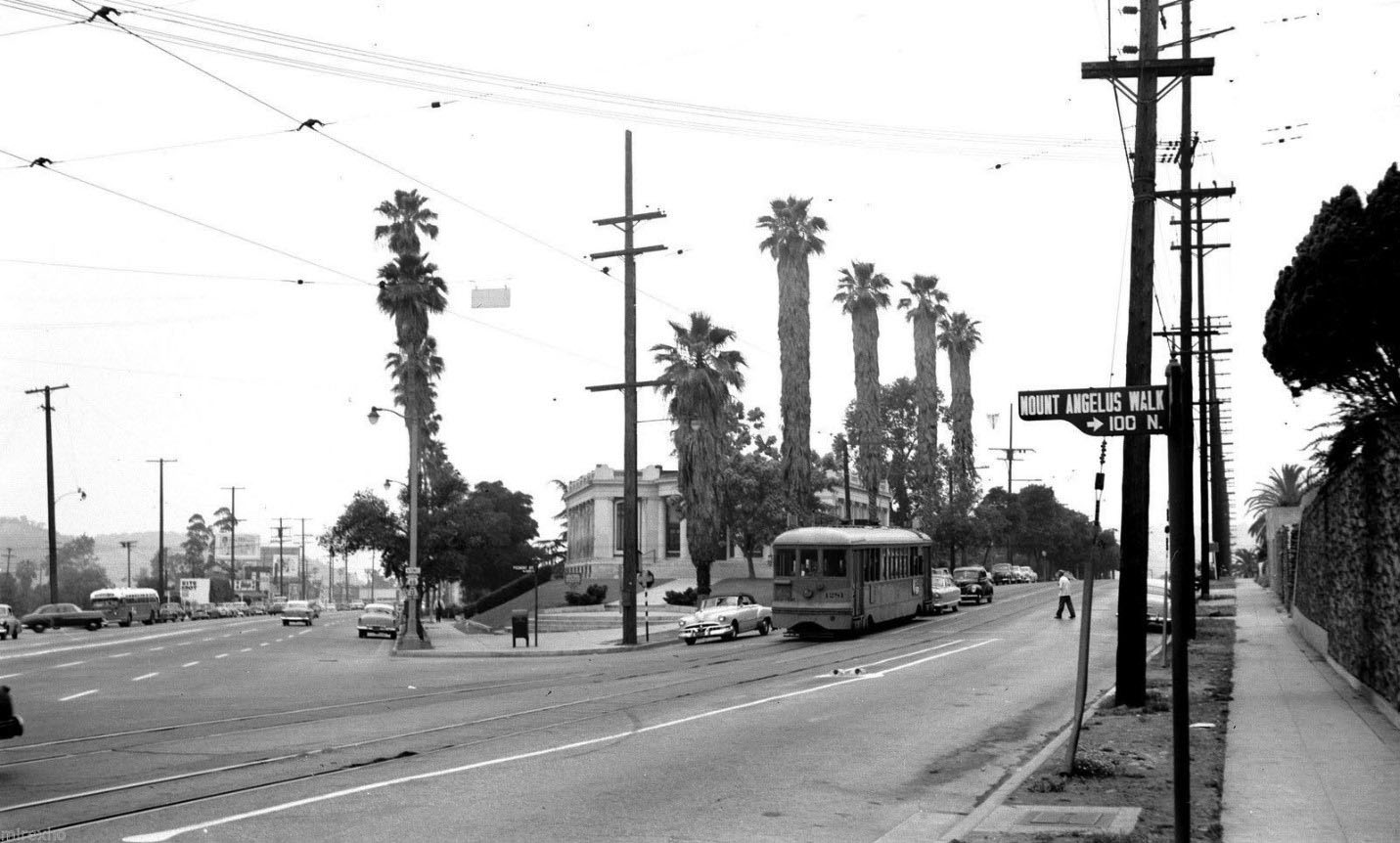 |
|
| (ca. 1951)^* – View showing Los Angeles’ First Municipal power pole standing tall on the corner of Piedmont Avenue and N. Figueroa Street. The pole appears to be lined-up with the palm trees that front the Arroyo Seco Branch Library. Sign on right reads Mount Angeles Walk which is a staired walkway that leads up to Mount Angelus Place. |
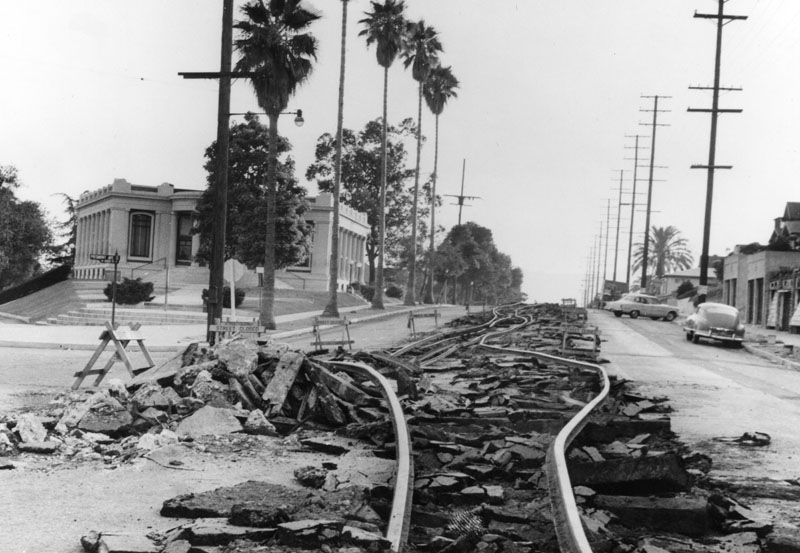 |
|
| (1958)^^ - View showing the old streetcar tracks being torn up on Piedmont Avenue. LADWP's first installed power pole remains standing in its original location on the corner of Piedmont Ave and N. Figueroa St. |
Historical Notes The original Classical Revival style Arroyo Seco Branch Library building was replaced by another library building in 1960 and then again in 2003. |
Then and Now
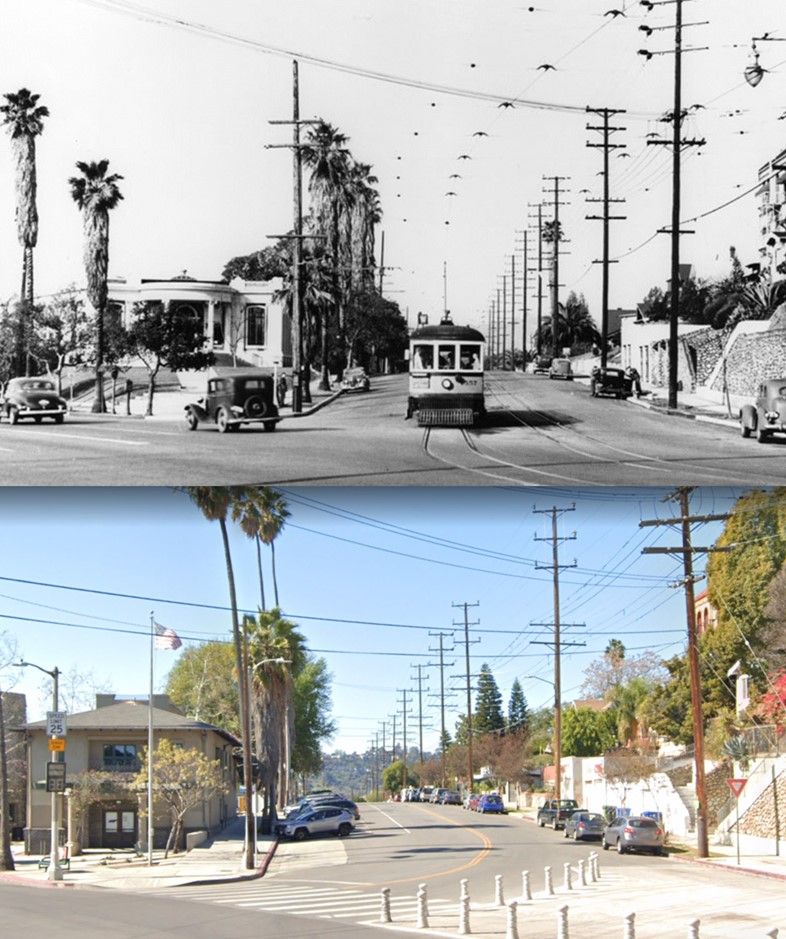 |
|
| (1946 vs. 2021)* - Looking SW on Piedmont Avenue showing a streetcar heading towards the bend at N. Figueroa Street in Highland Park. Both the old and new Arroyo Seco Branch Regional Library are seen on the left. The original 1914-built Classical Revival style Arroyo Seco Library building was replaced by another library building in 1960 and then again in 2003. |
* * * * * |
Exposition Park
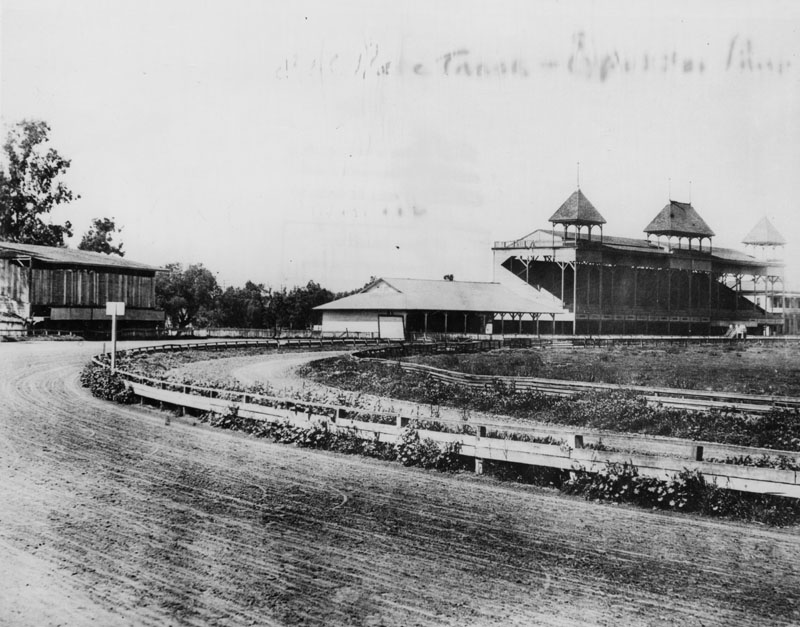 |
|
| (ca. 1900)* - Partial view of the racetrack at Exposition Park in the early 1900s. Photograph shows the grandstand with three open towers, an adjacent smaller structure, possibly a concession stand, and another unidentified structure on the extreme left. |
Historical Notes Originally, this piece of land served as an agricultural fairground from 1871 to 1911. Farmers sold their harvests on the grounds, while horses, dogs, camels, and later automobiles, competed along the racetrack (seen). In the late 1800s and early 1900s, the city's most influential families moved into the neighborhood but did not appreciate the racing and gambling that came with it. As a result, this racetrack was transformed into the now-famous Exposition Park Rose Garden.* November 6, 1913, marked the beginning of a two-week, city-wide celebration that opened Exposition Park and its facilities (also the LA Aqueduct). |
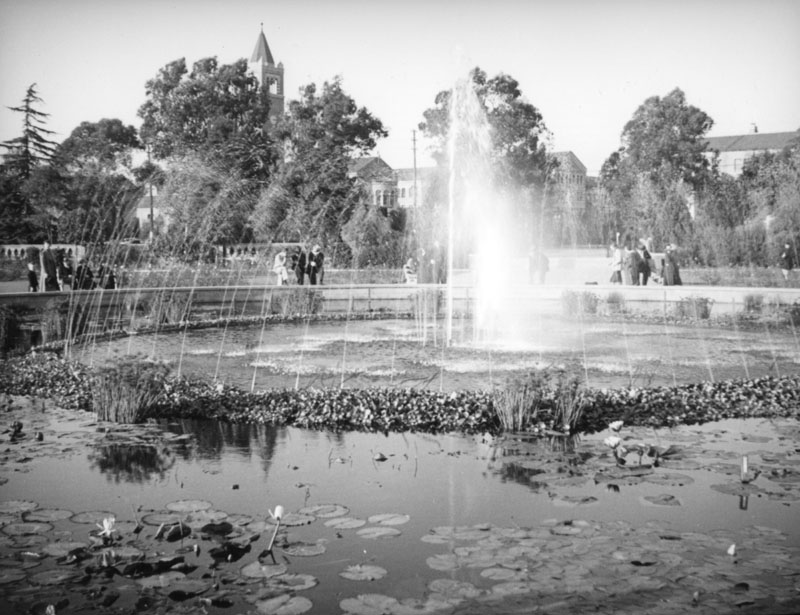 |
|
| (ca. 1930s)* - Jets of water converge in the center of the fountain in Exposition Park which is filled with lily pads. |
Historical Notes On November 6, 1913, Exposition Park was formally dedicated, and became the home to a state Exposition Building and the county Museum of History, Science and Art. Senator John Works dedicated the fountain as a commemoration of the Owens River/Los Angeles Aqueduct whose grand opening coincided with the opening of Exposition Park. As the Senator left the platform, a jet of water shot up 30 feet.* Click HERE to see the Opening Ceremonies of the LA Aqueduct. |
Click HERE to see the Commemorative of the Official Opening of the LA Aqueduct and Exposition Park. |
Natural History Museum
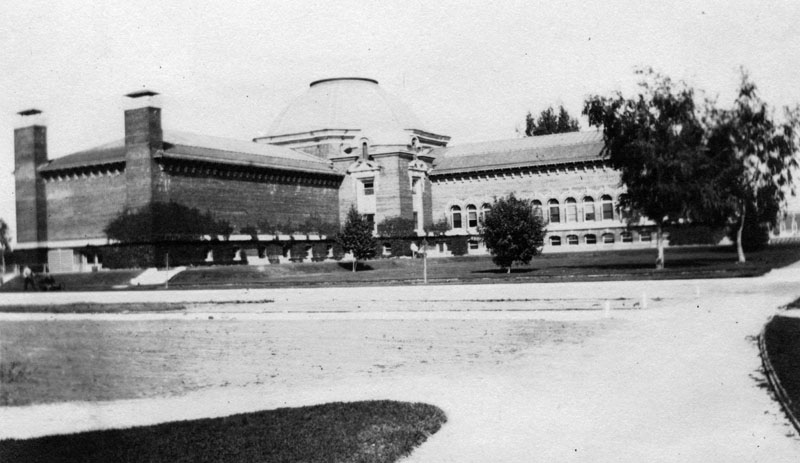 |
|
| (ca. 1915)* - A view of the Los Angeles Museum of History, Science, and Art and its grounds. A driveway in the foreground veers around the museum, a multi-storied, brick building with arms extending from a rotunda. |
Historical Notes The Natural History Museum of Los Angeles County opened in Exposition Park in 1913 as the Museum of History, Science, and Art. The moving force behind it was a museum association founded in 1910. Its distinctive main building, with fitted marble walls and domed and colonnaded rotunda, is on the National Register of Historic Places.^* |
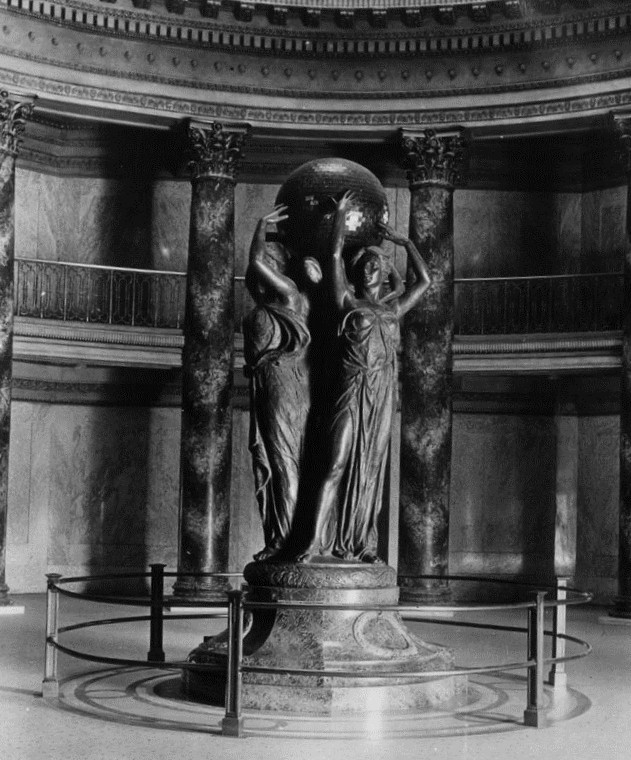 |
|
| (ca. 1915)* - "History, Science and Art Upholding the World"; a bronze sculpture by Julia Bracken Wendt installed in 1914 in the rotunda of the L.A. Museum of History, Science, and Art. Three robed, female figures hold aloft an illuminated globe and stand in the exact center of the rotunda. |
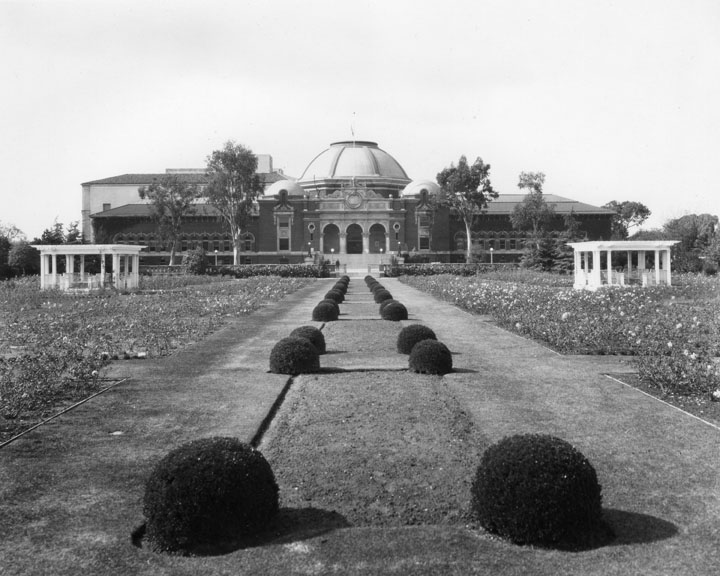 |
|
| (ca. 1915)* - Sunken gardens, also called Rose Garden, at Exposition Park, formerly called Agricultural Park, with museum buildings in the background. This photo shows a view of the History, Science and Art Building. |
Historical Notes Exposition Park, originally named Agricultural Park, was developed in 1876 as a showground for agricultural and horticultural fairs. The property became state land in 1880, but during the 1890s it fell into private hands and became victim to deterioration. Late in the decade, USC law professor William M. Bowen and USC President George Finley Bovard garnered the commitments of city, state, and county to develop the land as a public educational, cultural and recreational center.* |
 |
|
| (ca. 1925)^ – View showing the central fountain (aka "Los Angeles Aqueduct Fountain") in Exposition Park with the domed Natural History Museum in the background. A large main jet of water spouts from the center of the circular fountain while smaller spouts shoot inward to it, surrounded by plant growth. In the foreground, the fountain appears to extend into a lily-pond. |
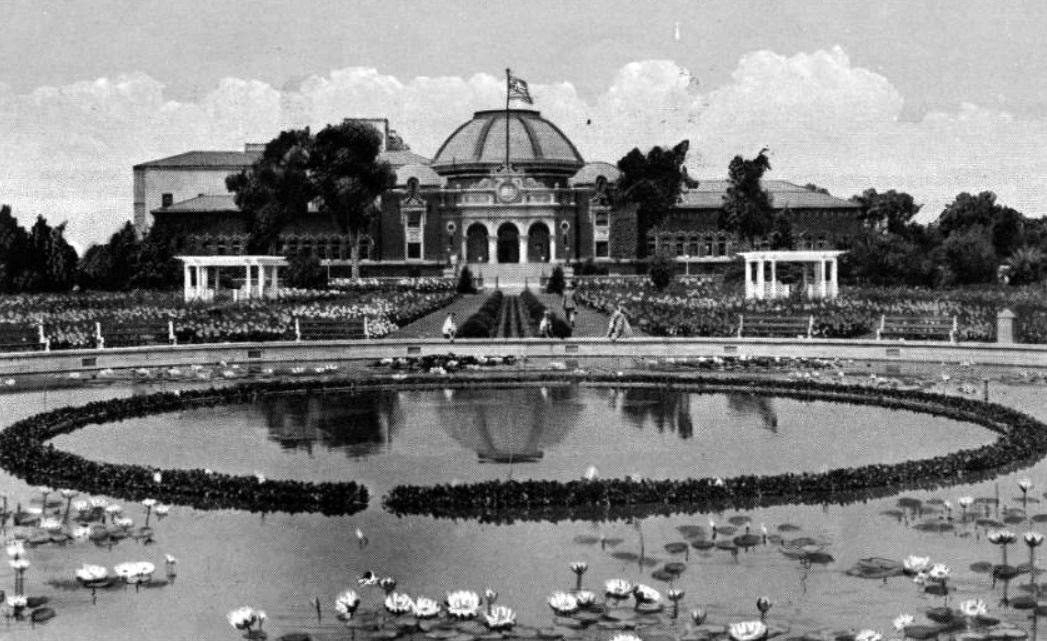 |
|
| (ca. 1929)#^^ – Postcard view showing the Natural History Museum at the end of the Rose Gardens as seen from the other side of the “LA Aqueduct Fountain”. |
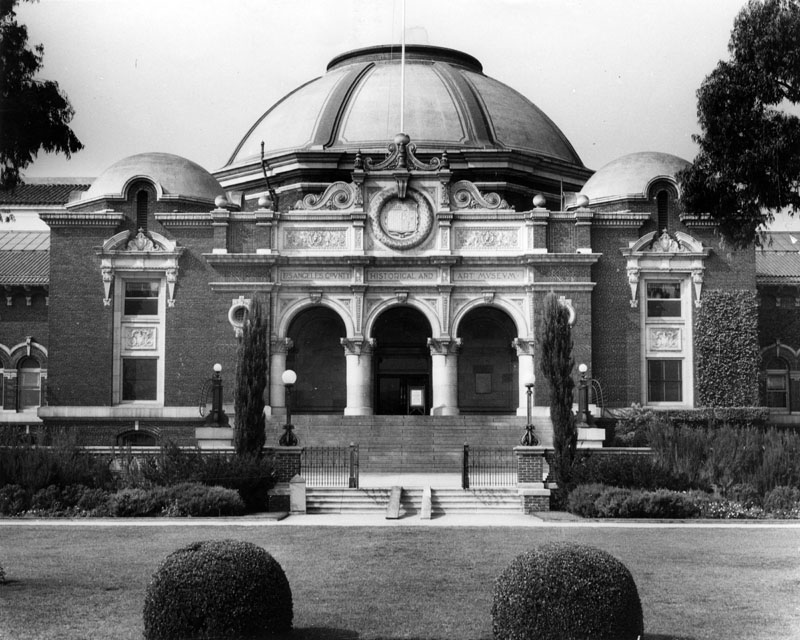 |
|
| (ca. 1915)* - View of the eastern entrance of the Los Angeles Natural History Museum. The Beaux Arts/Romanesque style building features three large stone arches, a large center dome with two smaller ones on either side, terracotta-tiled roof, fancy ornamental moldings and patterns above the portico entry, and several types of bricks and many different brick patterns forming the walls of this three-story building. Above the stone arches the words "Los Angeles County Historical and Art Museum" are etched into the facade. |
Historical Notes On November 6, 1913 the Museum of History, Science, and Art was formally dedicated and opened in Exposition Park. Additional wings of the museum opened in 1925, 1930, 1960, and 1976. In 1961, it was "divided" into the Los Angeles County Museum of History and Science, and the Los Angeles County Museum of Art (known as LACMA, since moved to new quarters on Wilshire Blvd). Years later, the museum was again renamed, becoming the Natural History Museum of Los Angeles County. It is the largest museum in the western United States, with a collection of nearly 33 million specimens and artifacts covering 4.5 billion years of history. The Natural History Museum, located at 900 Exposition Boulevard between Vermont and Figueroa, was added to the National Register of Historic Places in 1975.* |
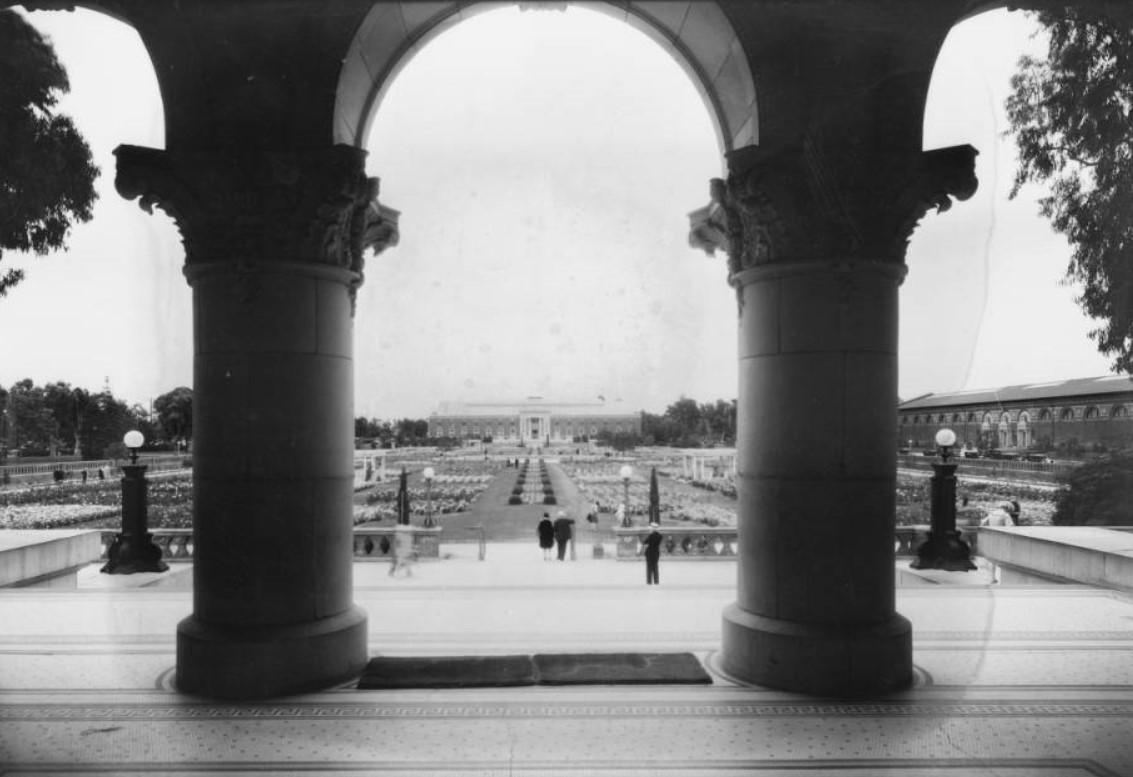 |
|
| (ca. 1929)^ - View looking at the Sunken Gardens at Exposition Park as seen through the columned entrance of the Natural History Museum. In the distance stands the State Armory Building and to the right is the State Exposition Building. |
State Armory Building
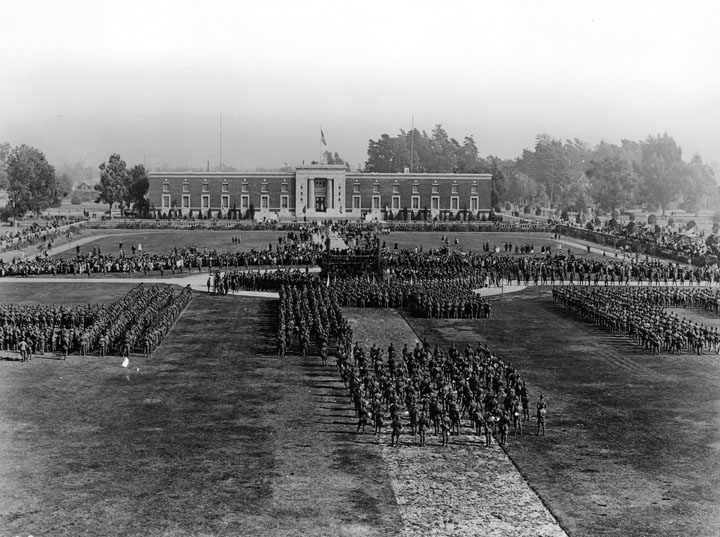 |
|
| (1920)* - Sunken gardens, also called Rose Garden, at Exposition Park, formerly called Agricultural Park, with State Armory Building. This photo shows Pershing Day, Jan. 26, 1920, at the Sunken Gardens at Exposition Park. |
Historical Notes The Armory Building was designed in by State Architect J.W. Woollett for the California National Guard 160th Infantry. The seven and a half acre Rose Garden, also called Sunken Garden, evolved from the redevelopment of Agricultural Park, and was also completed in 1913.* |
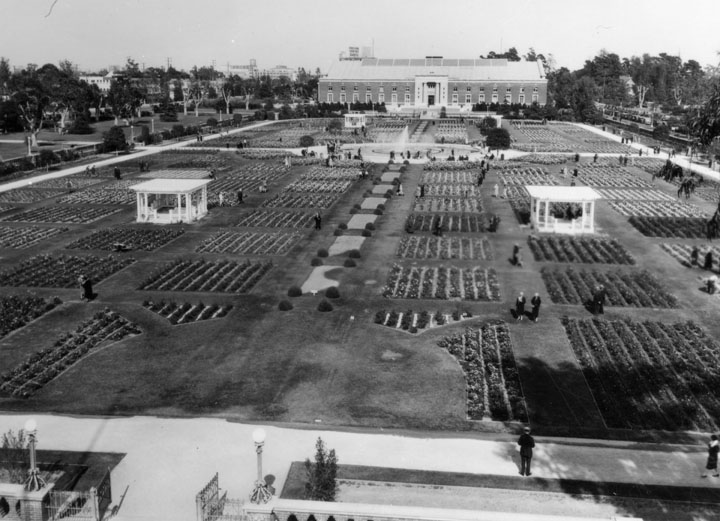 |
|
| (1935)* - View of the Rose Garden, at Exposition Park, formerly called Agricultural Park, with State Armory Building in the background. The photo was taken from the steps of the County Museum of History Science and Art Building. |
Historical Notes Originally named Agricultural Park in 1876, the 160-acre site was developed and served as an agricultural and horticultural fairground until approximately 1910, at which point it was re-named Exposition Park. On November 6, 1913, Exposition Park was formally dedicated, and became the home to a state Exposition Building and the county Museum of History, Science and Art, and was slated to gain a National Guard Armory.* On November 6, 1913, a celebration was held as a joint dedication of both the opening of Exposition Park and the Los Angeles Aqueduct. Click HERE to see more in the Opening of the LA Aqueduct. |
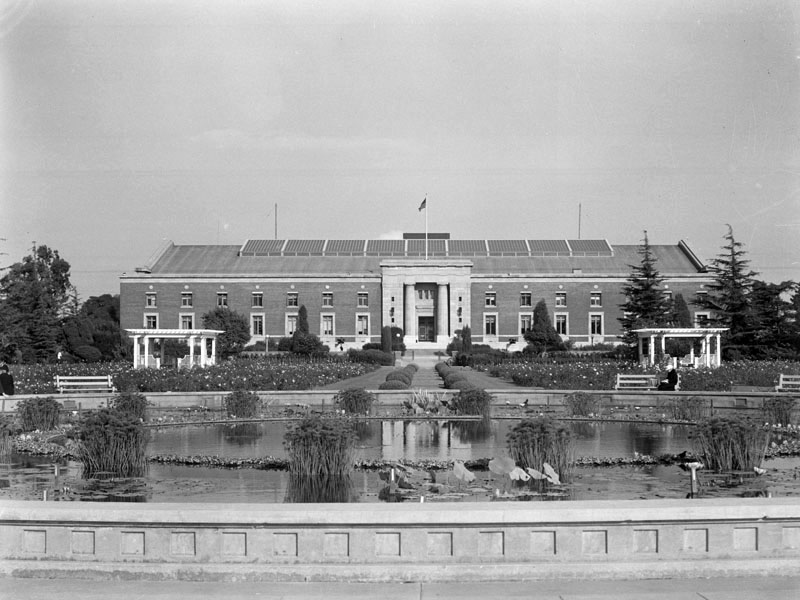 |
|
| (ca. 1936)* - View of the State Armory Building in Exposition Park. The "LA Aqueduct Fountain" stands in the foreground and two gazebos are seen in the Rose Garden between the fountain and the State Armory Buidling. |
Historical Notes In 2003 the California Science Center's Board of Directors voted to rename the historic Armory Building as the Wallis Annenberg Building for Science Learning and Innovation due to contributions toward the renovation and re-invention of the building by architect Thomas Mayne, which reopened in 2004. |
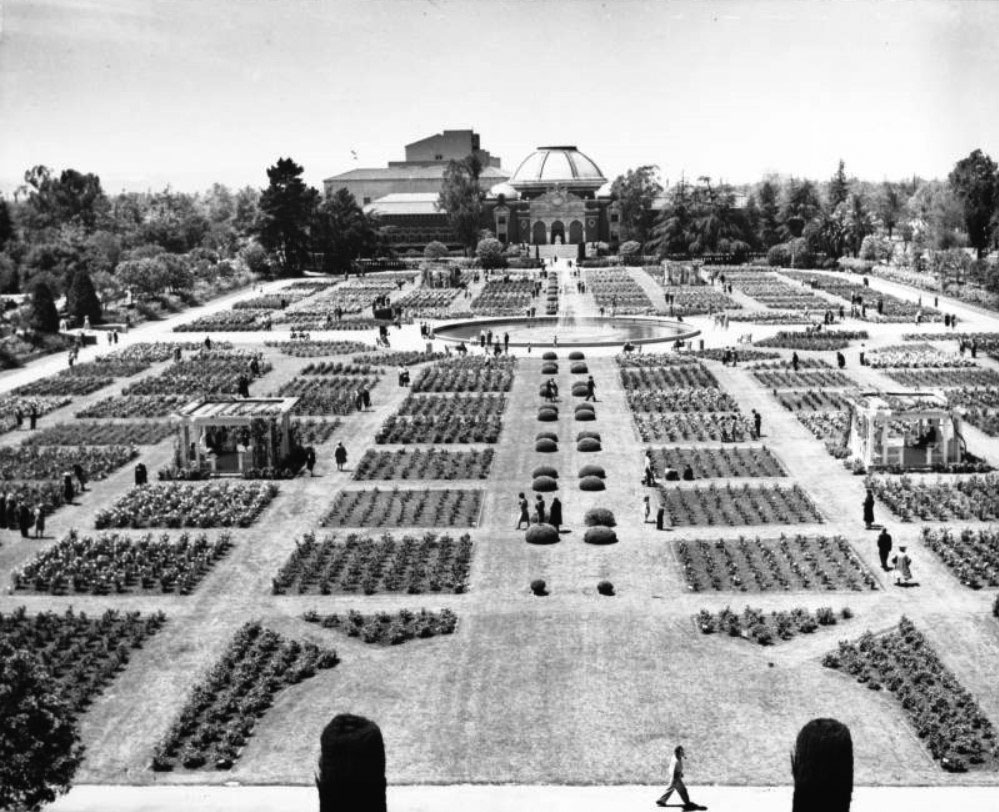 |
|
| (ca. 1950)^ - Birdseye view of the Sunken Rose Garden as seen from the State Armory Building. In the background at center, the large dome and elaborate façade of the Natural History Museum are visible. |
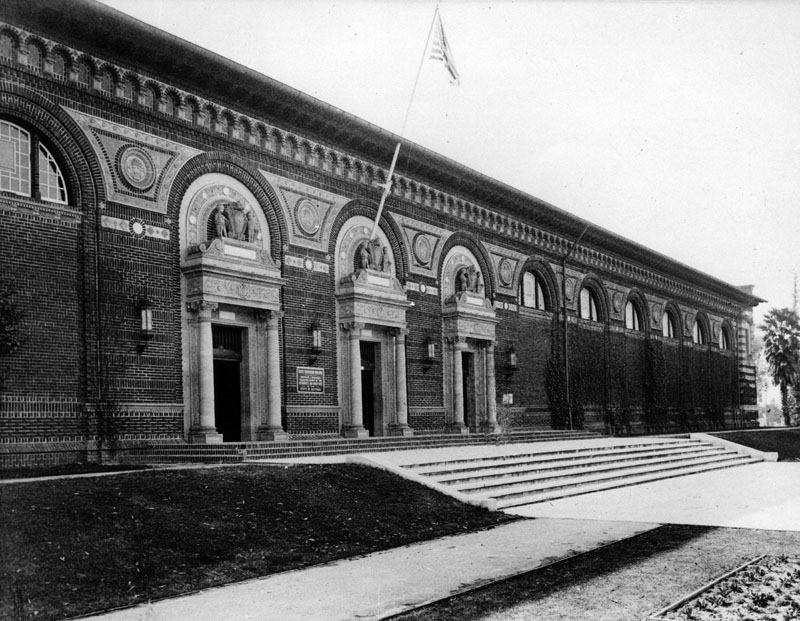 |
|
| (ca. 1925)* - Steps up an embankment lead to the State Exposition Building in Exposition Park in Los Angeles. Arched windows and columned entrances give a classical air to the single-story, brick building. A sign identifying the building is between the two left columned entrances. Cherubs and shields stand over each entrance and the arches are separated by medallions. |
Historical Notes The State Exposition Building, designed by William D. Coates, Jr., state architect, and N. Ellery, state engineer, opened in 1912 and housed simple, agriculturally based displays of natural resources and industrial products from across the state. |
* * * * * |
Christian Science Church (aka Second Church of Christ Scientist)
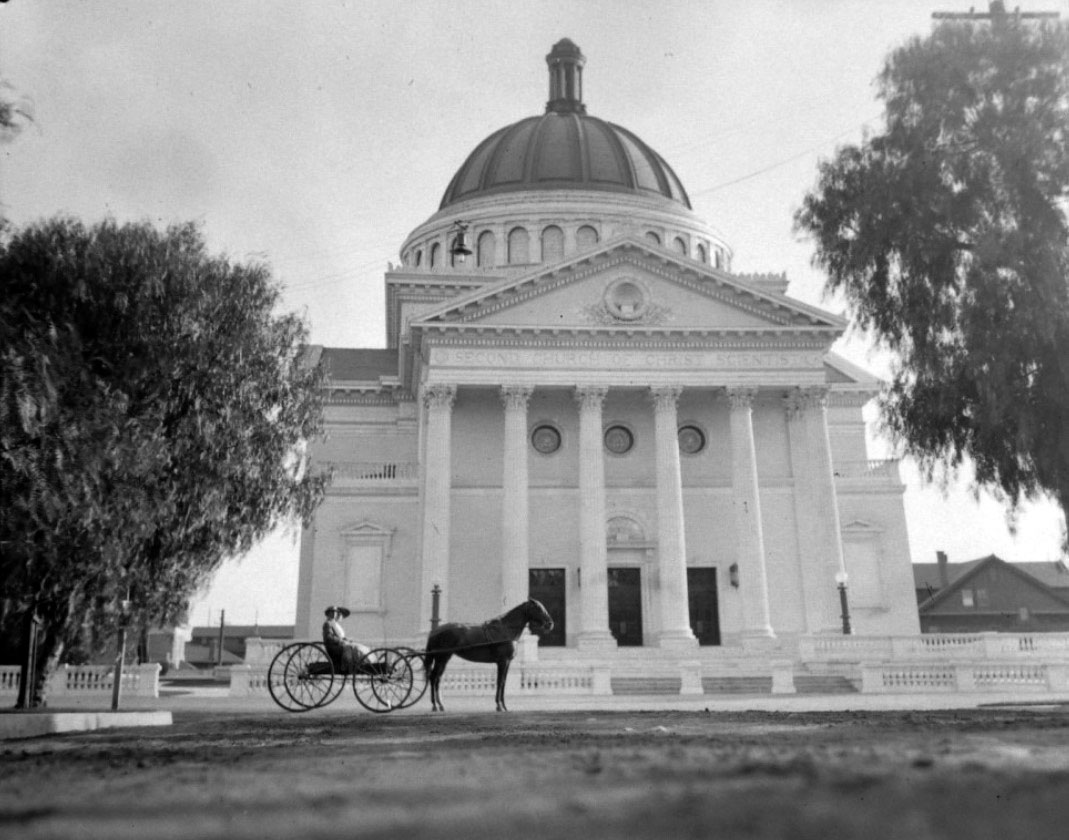 |
|
| (ca. 1910)* – A man and woman in a horse-drawn buggy are stopped in front of the Christian Science Church (aka Second Church of Christ Scientist) located at 948 West Adams Boulevard. |
Historical Notes Built in 1910, the Beaux Arts/Italian-Renaissance style building was designed by Alfred Rosenheim (who also designed the Cameo Theater in 1910 and the Globe Theater in 1913, both on Broadway in downtown Los Angeles. Rosenheim is also responsible for other Los Angeles landmarks, including the nearby Britt Residence, Hamburger’s Department Store, Clune’s Broadway Theatre Building, and the Hellman Building, all of which are LA Historic-Cultural Monuments. |
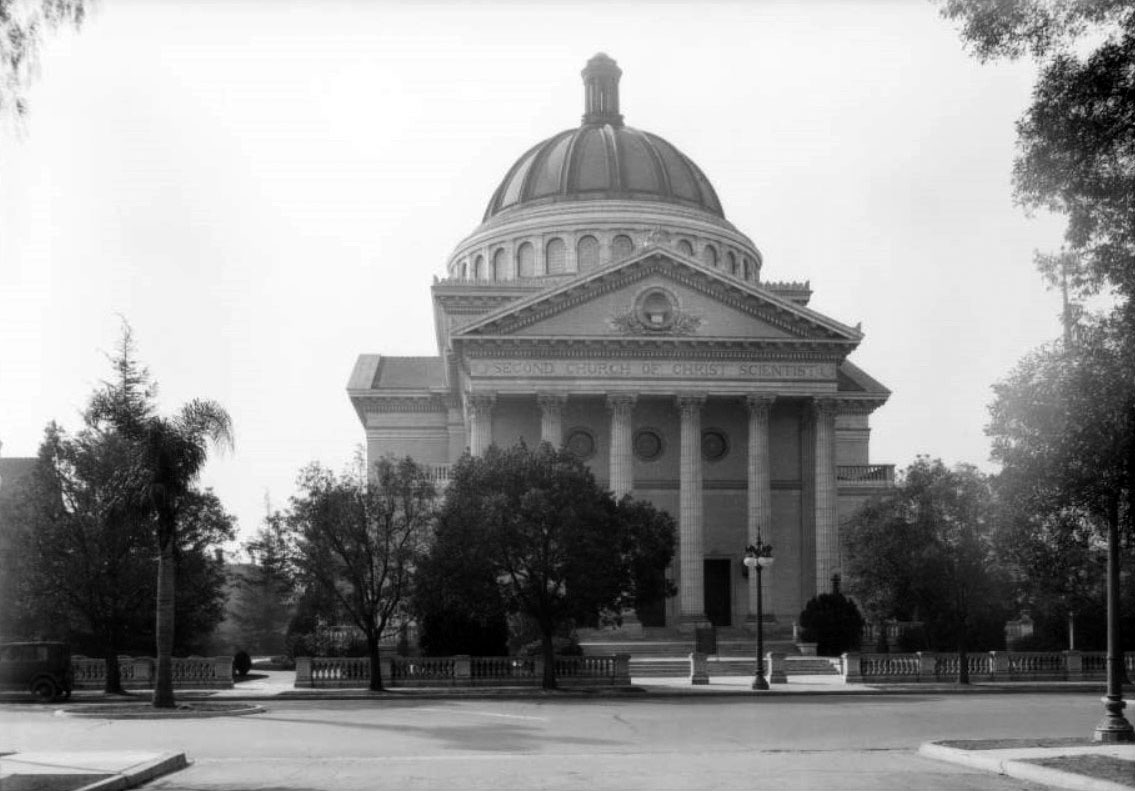 |
|
| (ca. 1928)* - View looking south on Portland Street toward Adams Boulevard. The Second Church of Christ Scientist is seen on the other side of Adams Boulevard at the T-intersection. |
Historical Notes The Church of Christ, Scientist was founded in 1879 in Boston, Massachusetts, by Mary Baker Eddy, author of Science and Health with Key to the Scriptures, and founder of Christian Science. The church is widely known for its publications, especially The Christian Science Monitor, a weekly newspaper published internationally in print and online. Six-globe streetlights (Llewellyn "Chester" Lamps) as seen above were installed in the West Adams district beginning in 1903. |
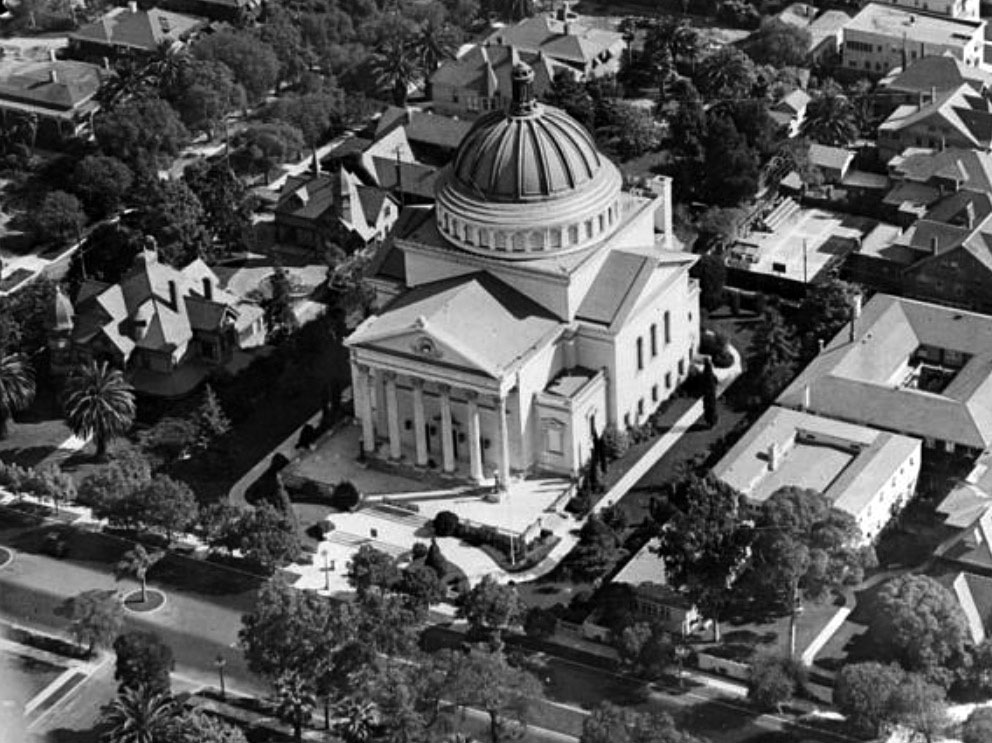 |
|
| (ca. 1928)* – Aerial view showing the Second Church of Christ Scientist on Adams Boulevard at the end of Portland Street. |
Historical Notes The North University Park and Exposition Park Walking Tour brochure describes the architecture of the church as follows: "this Italian Renaissance-style church, with its six magnificent Corinthian columns, evokes the grandeur of the Pantheon. Engineer Albert C. Martin constructed the church's huge copper-clad dome, then the world's largest poured concrete dome. Study the rich details of the exterior decorations, made of white terra cotta ornamentation." The columns are forty feet tall, and the dome, which is seventy feet in diameter, was constructed through a complex design of concrete girders and steel trusses. The church seats more than 1000. |
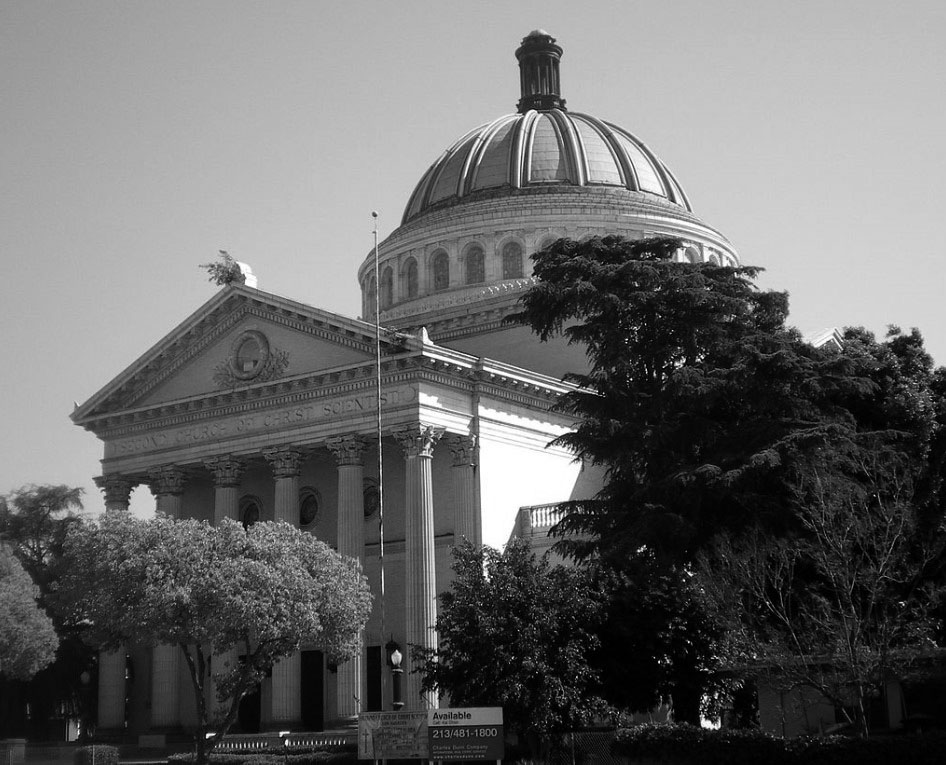 |
|
| (2008)* – View showing the Second Church of Christ Scientist at 948 W. Adams Boulevard as it appeared in 2008. The church is fenced off and for sale. |
Historical Notes In 1968 the building was declared LA Historic-Cultural Monument No. 57 (Click HERE to see complete listing). It was also placed on the National Register of Historical Places in 1987. In late 2009, the Church property was sold to the non-profit Art of Living Foundation. It was restored and is used as a community center, speaking and music venue, and is a center for the Foundation's service work and breathing, meditation, and other programs. While the Art of Living Foundation has been active in Southern California since the late 1980s, it officially opened in this location on April 14, 2010. |
Then and Now
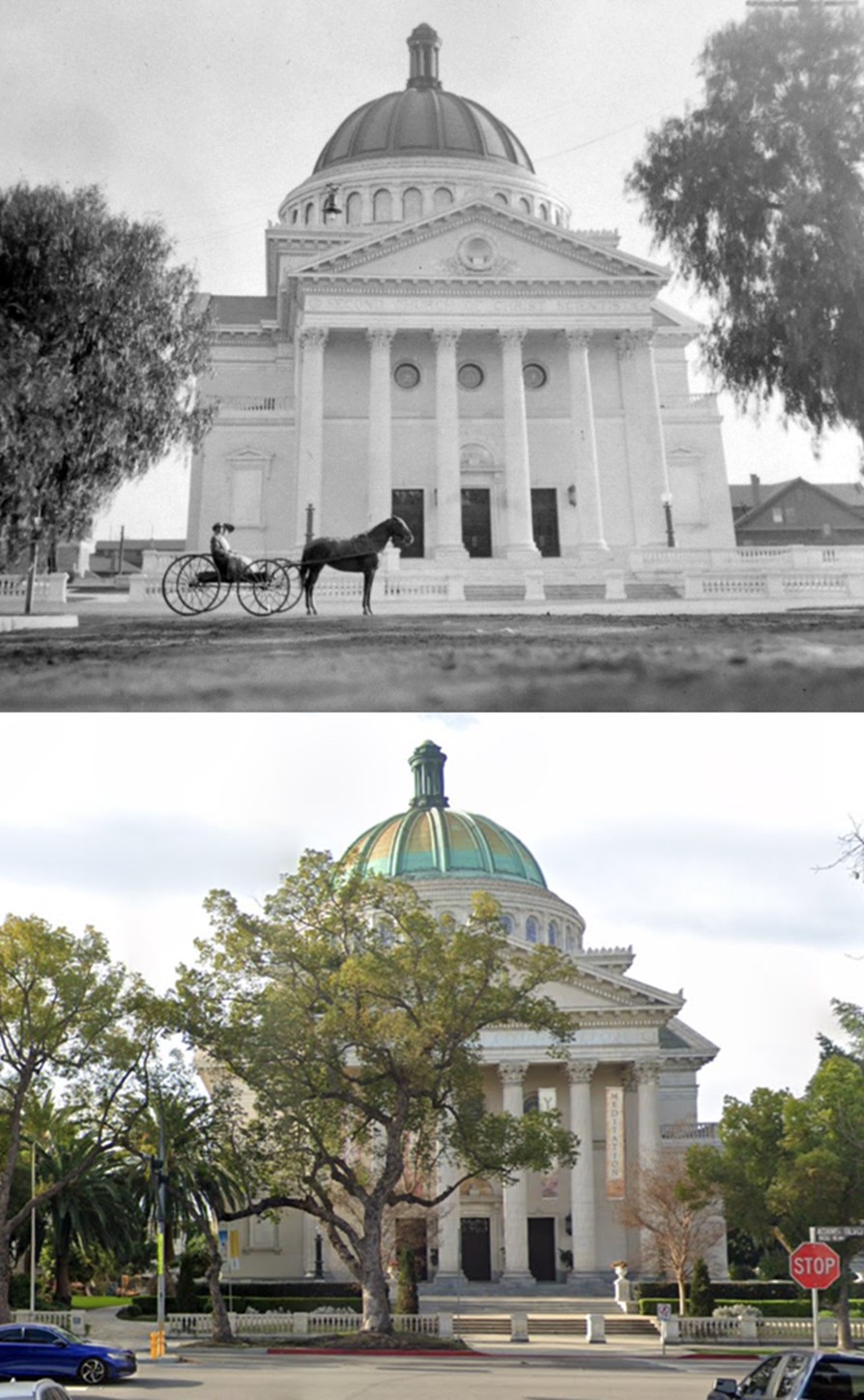 |
|
| (1910 vs. 2022)* – The 1910-built Beaux Arts/Italian Renaissance style building was designed by famed architect Alfred Rosenheim as a Christian Science Church. It is located at 948 West Adams (at Portland Street) and currently serves as home to the Art of Living Foundation. |
* * * * * |
Bryson Apartments
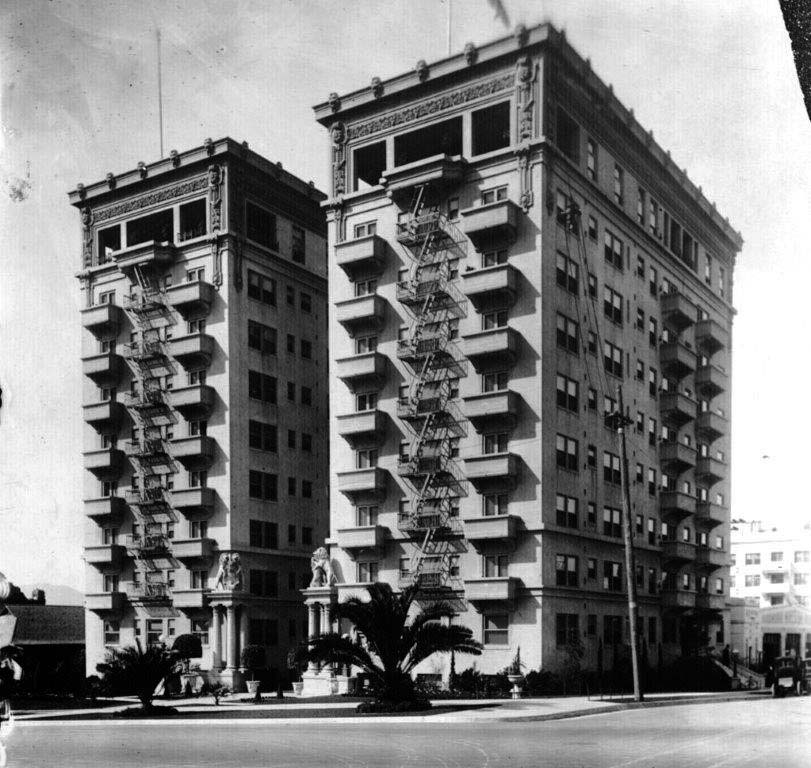 |
|
| (ca. 1913)* – View showing the 10-story Bryson Apartments located at 2701 Wilshire Boulevard. |
Historical Notes The Bryson opened in January 1913 as the newest thing in elegant Los Angeles apartment living. The Los Angeles Times proclaimed the Bryson by far the largest and finest apartment house on the Pacific Coast and on one of the most sightly corners in the fashionable Wilshire-Westlake district. The Bryson's ninety-six apartments featured mahogany woodwork, tile floors in the bath and kitchen, and a built-in cedar chest in each dressing room. Living rooms doubled as bedrooms, with hideaway wall beds in each unit. |
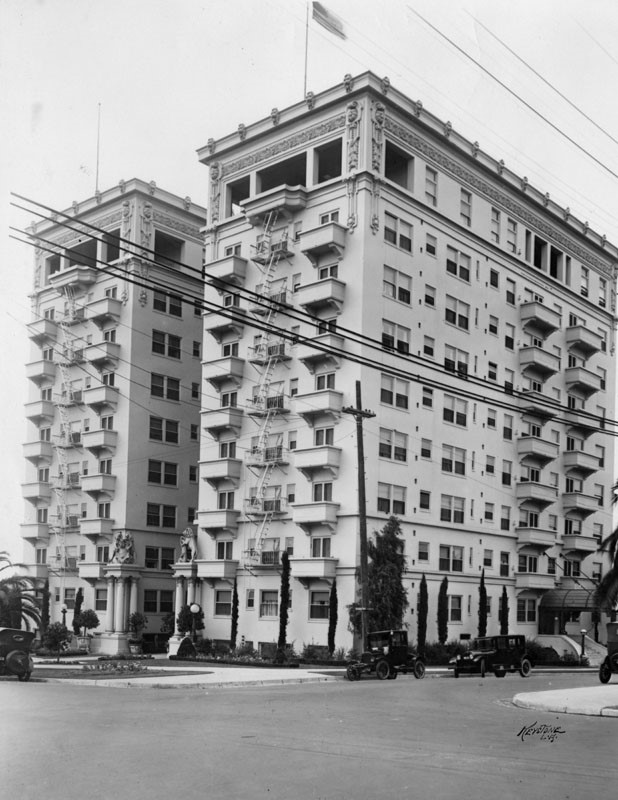 |
|
| (ca. 1920)* – Exterior view of the Bryson Apartments located on the N/W corner of Wilshire and Rampart boulevards. Note the lion sculptures at the entrance. |
Historical Notes Developer Hugh W. Bryson believed in constructing affordable large scale residential developments filled with beauty and taste. Born in Memphis, Tennessee, August 1, 1868, ambitious Bryson strove for excellence from a young age. After graduating from high school, he worked as clerk for a cotton brokers, working in banking, and selling real estate, before arriving in Los Angeles in 1902. Bryson joined leading contractor, F. O. Engstrum Co., and within a few years, married the owner’s daughter, Blanche. He was named a general manager and director of the company in 104, focusing on major projects. Recognizing the large migration of East Coast and Midwest residents to sunny LA, Bryson began financing and his own projects under his Concrete Appliances Company. |
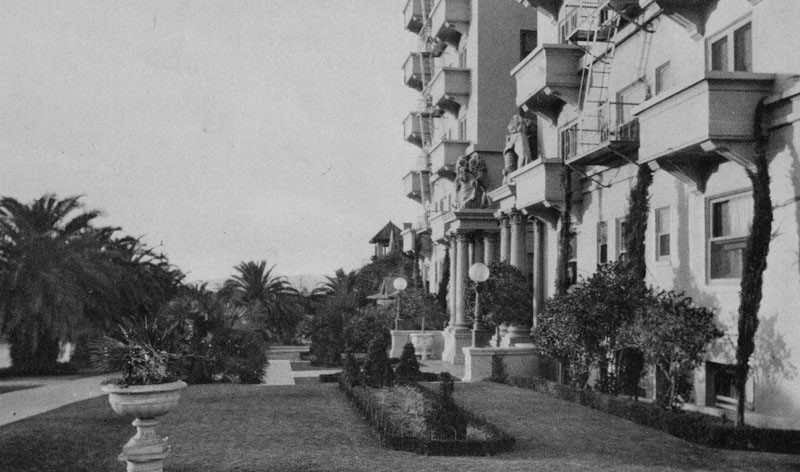 |
|
| (1920s)* – Close-up view showing the entrance to the Bryson Apartments. |
Historical Notes From the beginning, Bryson’s hyperbolic publicity played up the special quality of the building including its classical style entrance, gardens, and fountain. Conveniences and amenities included a ground floor power plant, elevators, staff residences, vacuum and telephone hook-ups in every suite, hot/cold water and steam heat for every apartment, along with maid service. The building contained all luxuries and comforts of a personal residence without maintenance, in a way, an early example of a condominium building. |
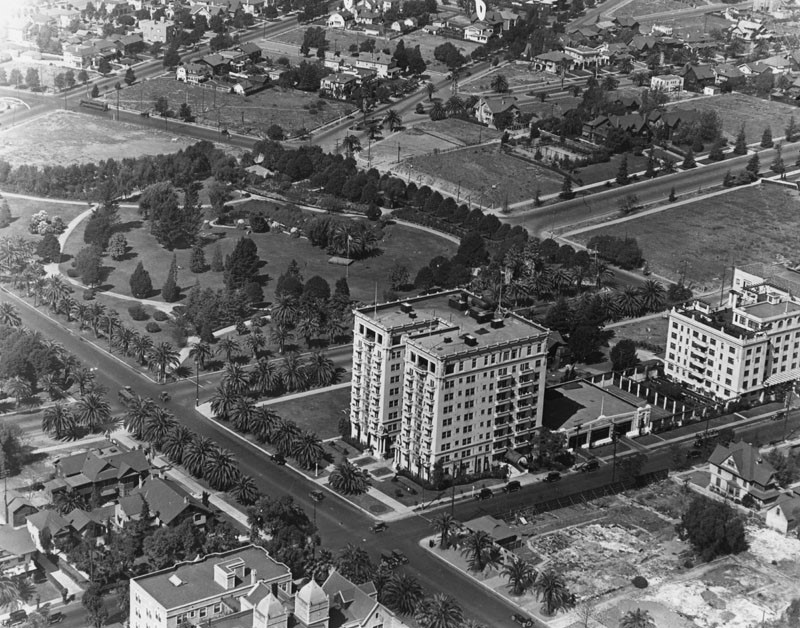 |
|
| (ca. 1920)* - Aerial view looking down at Lafayette Park (previously Sunset Park). Three large apartment buildings can be seen: lower left, Hershey Arms; center, The Bryson on the northwest corner of Wilshire and Rampart Boulevards; and right, Rampart Apartments on the southwest corner of 6th Street and Rampart Boulevard. |
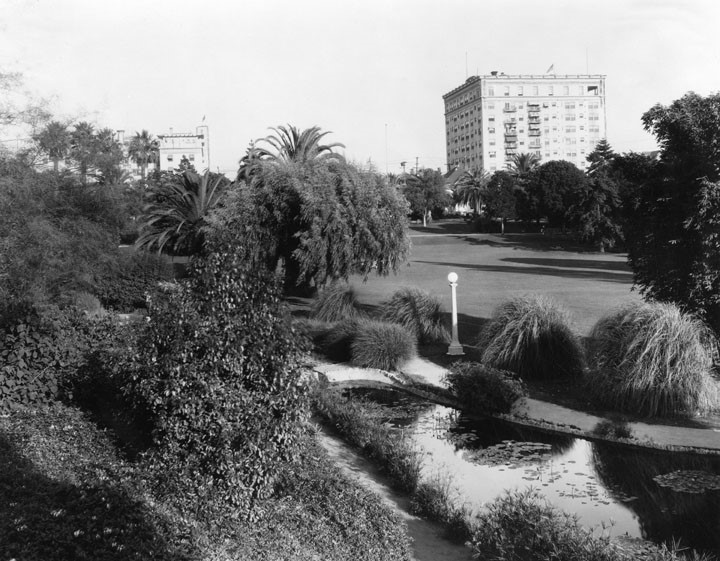 |
|
| (1926)* – View of Lafayette Park, originally named Sunset Park, showing a small pond with footpath in the foreground, the lawn in the middle and the Bryson Apartments. in the background. The Rampart Apartments are seen to the left. |
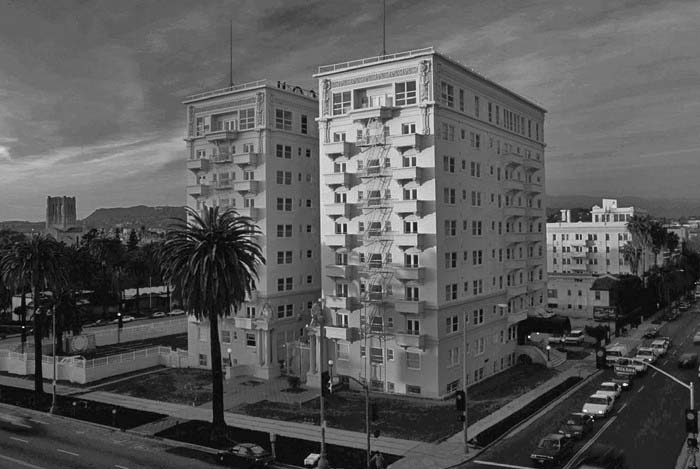 |
|
| (2010s)*– View looking northwest showing the Bryson Apartments at Wilshire and Rampart. The First Congregational Church, 540 S. Commonwealth, is on the left. On the right can be seen the Rampart Apartments on the southwest corner of 6th Street and Rampart Boulevard. |
Historical Notes Actor Fred MacMurray owned the Bryson for many years, and the building has appeared in numerous films. A placard at the locked entry gate refers interested location scouts to the building's Hollywood agent. |
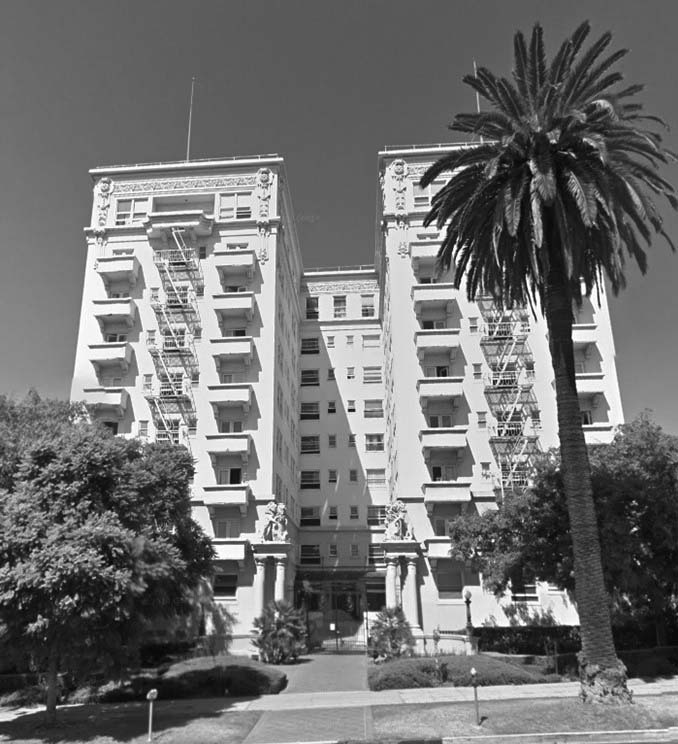 |
|
| (2015)* - Google street view showing the Bryson Apartment Building, 2701 Wilshire Boulevard. |
Historical Notes The 1914 Beaux Arts style Bryson Apartment Hotel was designed by architects F. Noonan and C. H. Kysor. The building was listed on the National Register of Historic Places in 1983 and was designated Los Angeles Historic-Cultural Monument No. 653 in 1998. Click HERE to see complete listing. Since an award-winning restoration by the Los Angeles Housing Partnership in 2001, the Bryson has served as low-income housing. |
* * * * * |
Haggarty Mansion (aka Castle York)
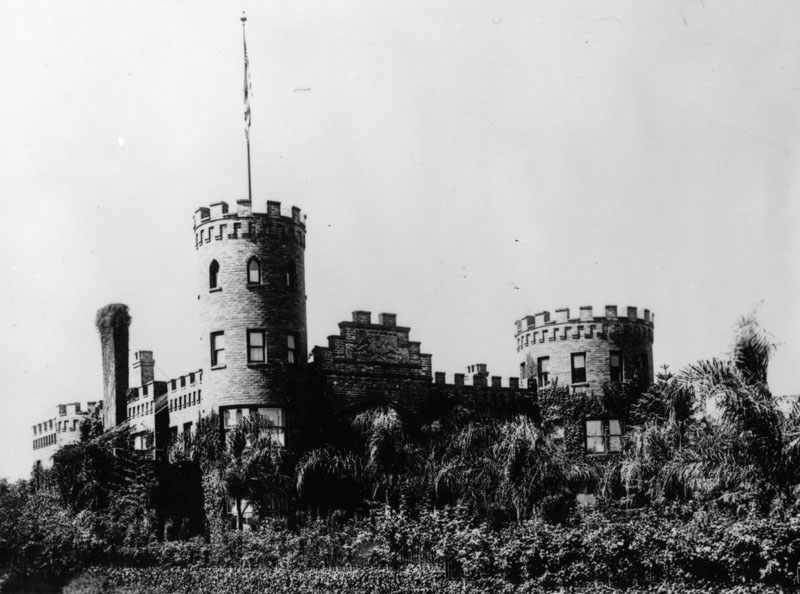 |
|
| (ca. 1915)* - Exterior view of the J. J. Haggarty Mansion, otherwise known as Castle York, was located at 3330 W. Adams Blvd. in the fashionable West Adams section of Los Angeles. |
Historical Notes The J. J. Haggarty Mansion, otherwise known as Castle York, was located at 3330 W. Adams Blvd. in the fashionable West Adams section of Los Angeles. The Castle York, of Norman Gothic architecture, was built at a cost of $100,000. Frontage was of 125 feet on south side of Adams and extended back to a depth of 500 feet. Structure itself was 92x91 feet in size. A tower planned after one of the famous towers of Windsor castle, stood forty feet in height and twenty feet in diameter rising at the northwest corner of the building. A second tower, twelve feet in diameter and fifty feet high, at the northeast corner, was copied after a famous castle in Yorkshire. |
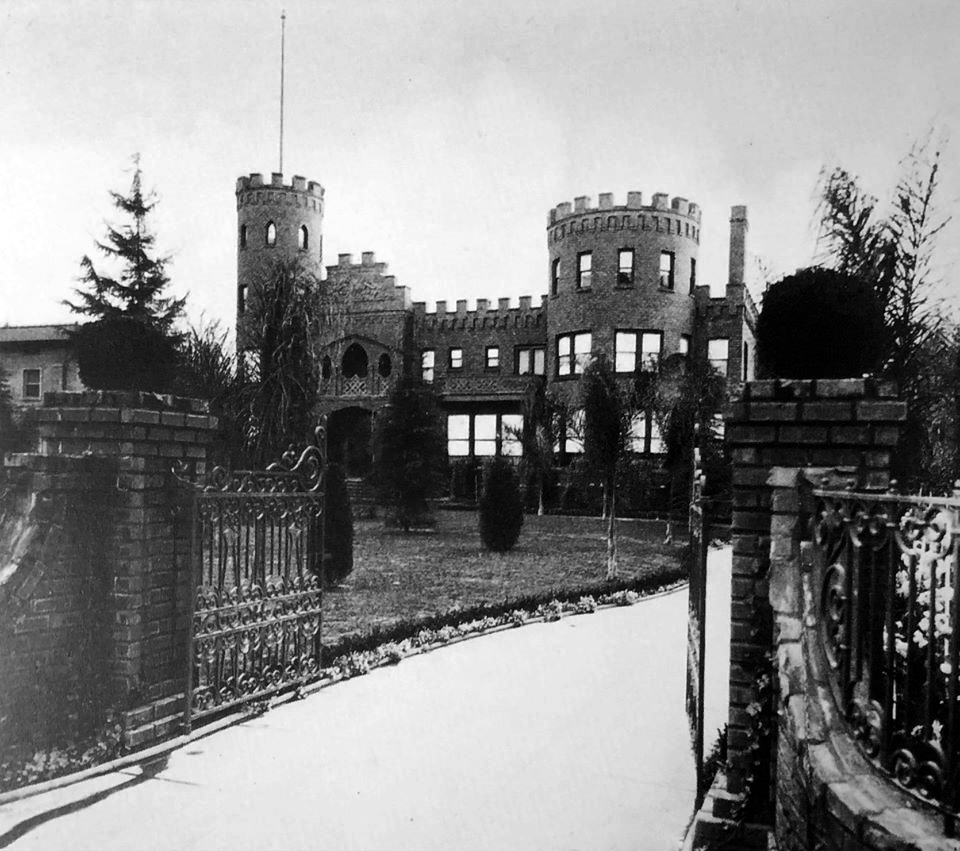 |
|
| (1915)* - View showing Castle York, built by JJ Haggarty, as seen from W. Adams Blvd. |
Historical Notes After arriving in the U.S. in 1887 from his native land of England, John Joseph Haggarty worked as a buyer for several gament department stores in Missouri and Minnesota. In 1902 the promise of Southern California appealed to him and Haggarty relocated to Los Angeles. He immediately became associated with Jacoby Brothers as buyer and manager of their garment department. In a little over three years, he built up a tremendous business in his particular line and saved enough money to go into business for himself on a small scale. |
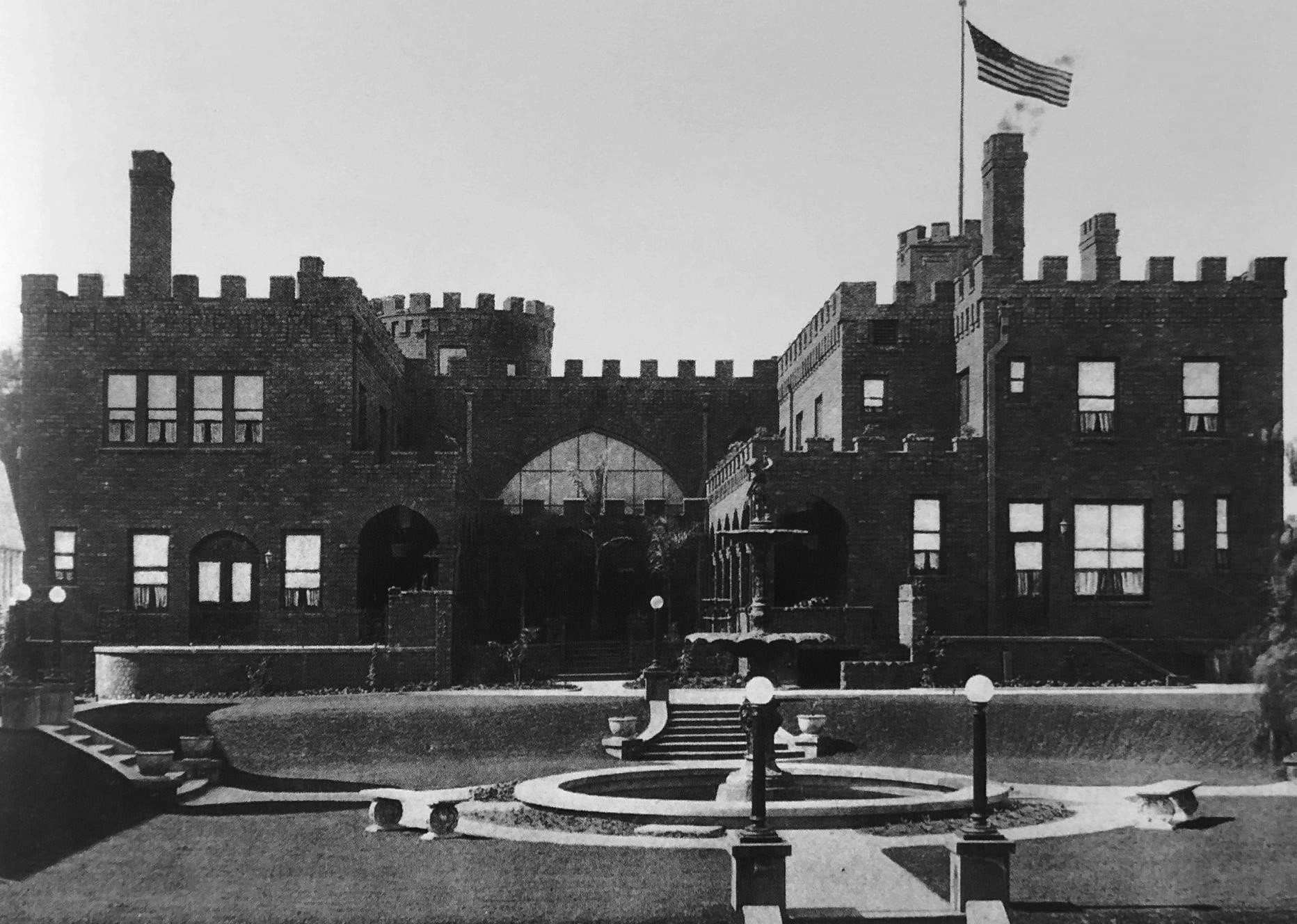 |
|
| (1915)* - Castle York as seen from the rear with sunken garden and fountain seen in foreground. |
Historical Notes Haggarty secured a building on Broadway, in the center of the Los Angeles business district, and there laid the foundation for one of the most successful businesses in the commercial history of the city. He called his store the New York Cloak and Suit House, an incorporated institution, in which he was President and chief stockholder. The business was started on a comparatively small investment, but within a short time it had leaped to a leading position in the business life of the city. He also purchased a controlling interest in another large house known as the Paris Cloak and Suit House. He would later open the high-end department store that would carry his name, J.J. Haggarty. |
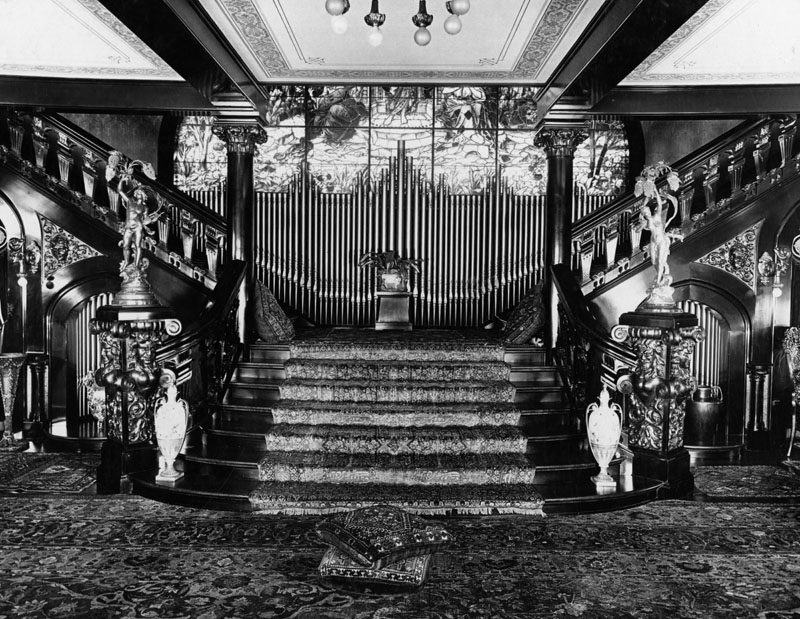 |
|
| (n.d.)* - Interior view of the J.J. Haggarty residence also known as the "Castle”. |
Historical Notes The interior of J. J. Haggarty's Castle consisted of a living room, organ loft, dining room, billiard room, sixteen bedrooms, servants' quarters, kitchens, pantries and china closets, along with numerous porches, balconies, gardens, and barns. |
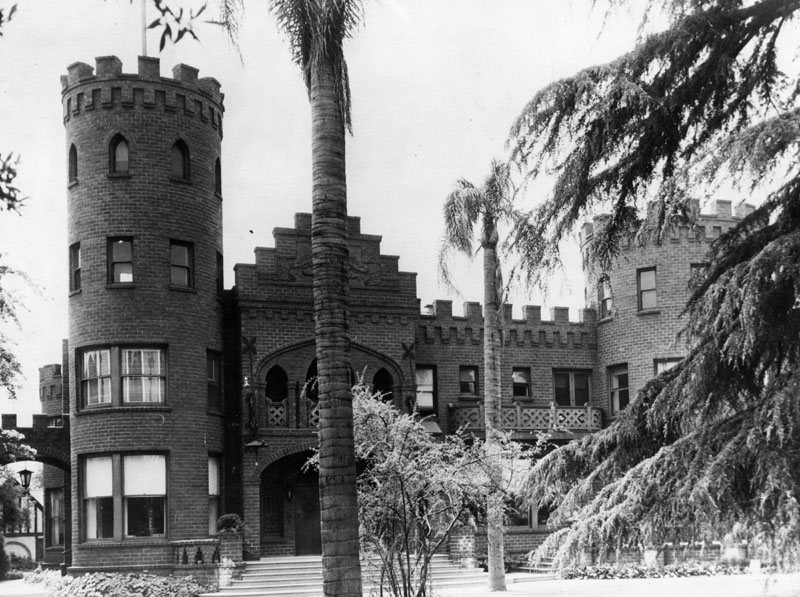 |
|
| (ca. 1930s)* - Exterior view of the J.J. Haggarty residence (the "Castle") as it appeared circa 1930s, fronted by several palm trees. Location: 3330 W. Adams Boulevard. |
Historical Notes The Castle was located at the foot of Fourth Avenue, where the Holman United Methodist Church parking lot is now. It suffered a major fire in 1951. The main building was torn down in 1971. |
* * * * * |
Darby Hotel (Currently the Grace Apartment Hotel)
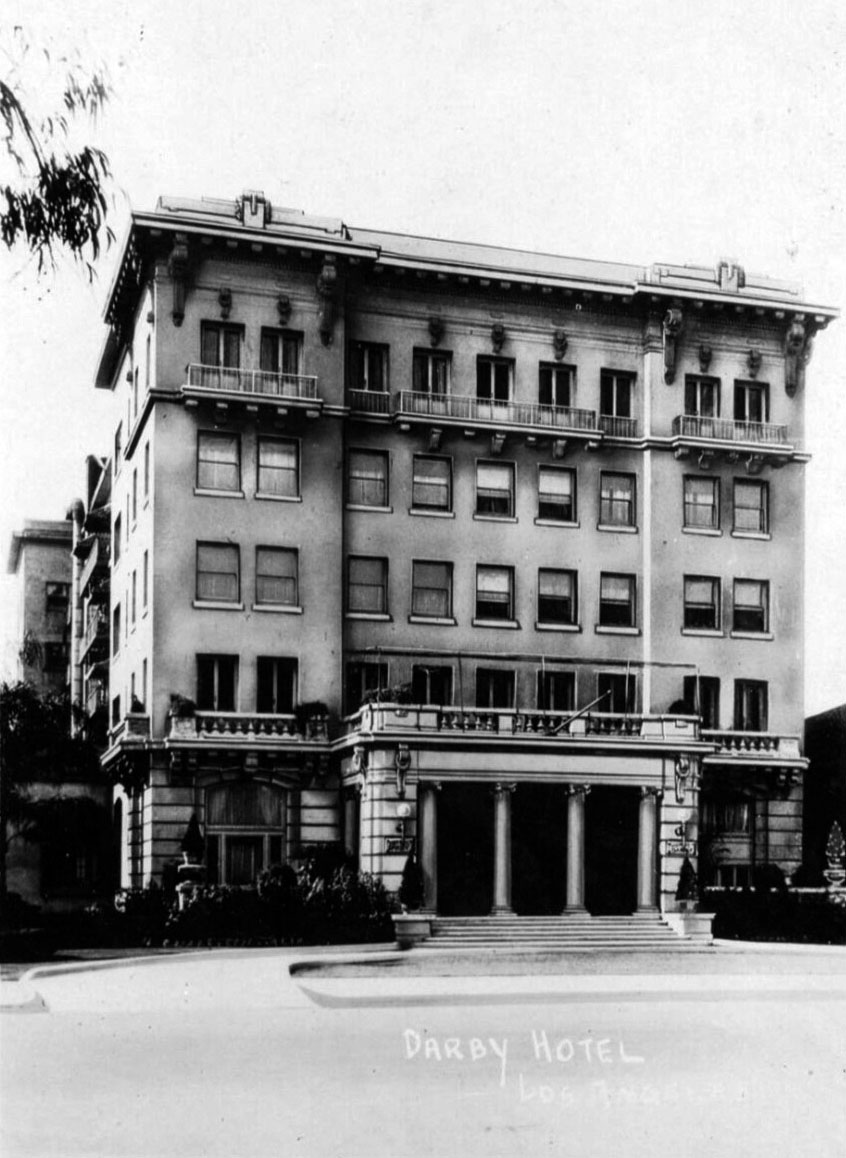 |
|
| (ca. 1920s)* - Exterior view of the Darby Hotel located on the south side of Adams east of Grand Ave. |
Historical Notes In 1909, altering the neighborhood permanently, real estate developer Wesley C. Clark, picked up his house at 234 Adams and trucked it one block to 340 W. Adams. Clark immediately redeveloped the vacated lot with a five-story, 70-foot-high apartment building named the Darby, after his mother's family, which stands today as the Grace Apartment Hotel. |
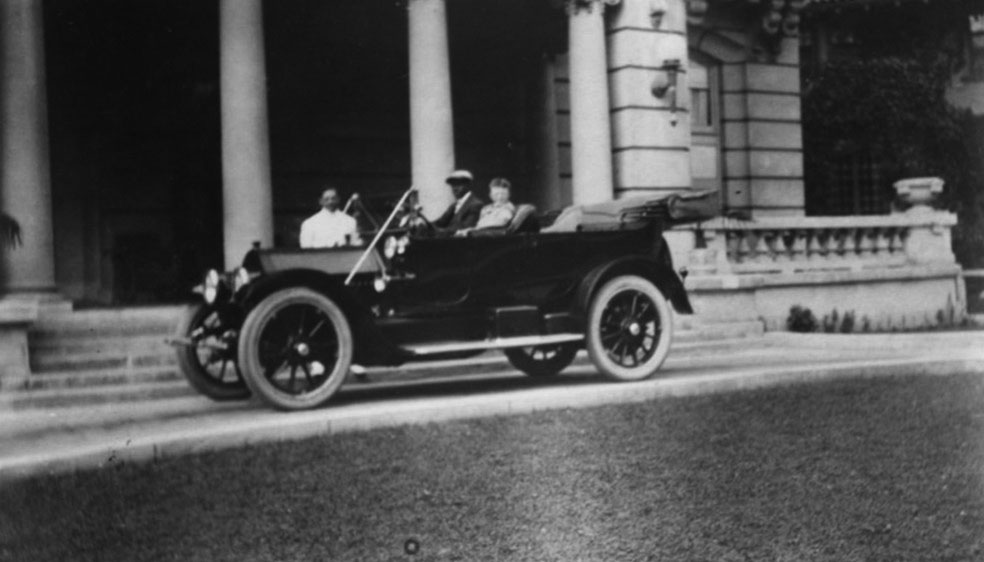 |
|
| (1920s)* - Standing behind the car is Ray I. Matthews. In the car is Charles Blodgett & 1 other person. They are in front of the Darby Hotel, built by Blodgett, a black contractor. Presently this building is known as the Grace Apartments |
Historical Notes The Darby's architect was John C. Austin. The "old family residence" at 234 W. Adams, owned by Wesley C. Clark, was moved to 340 W. Adams, where it remained until at least 1950. |
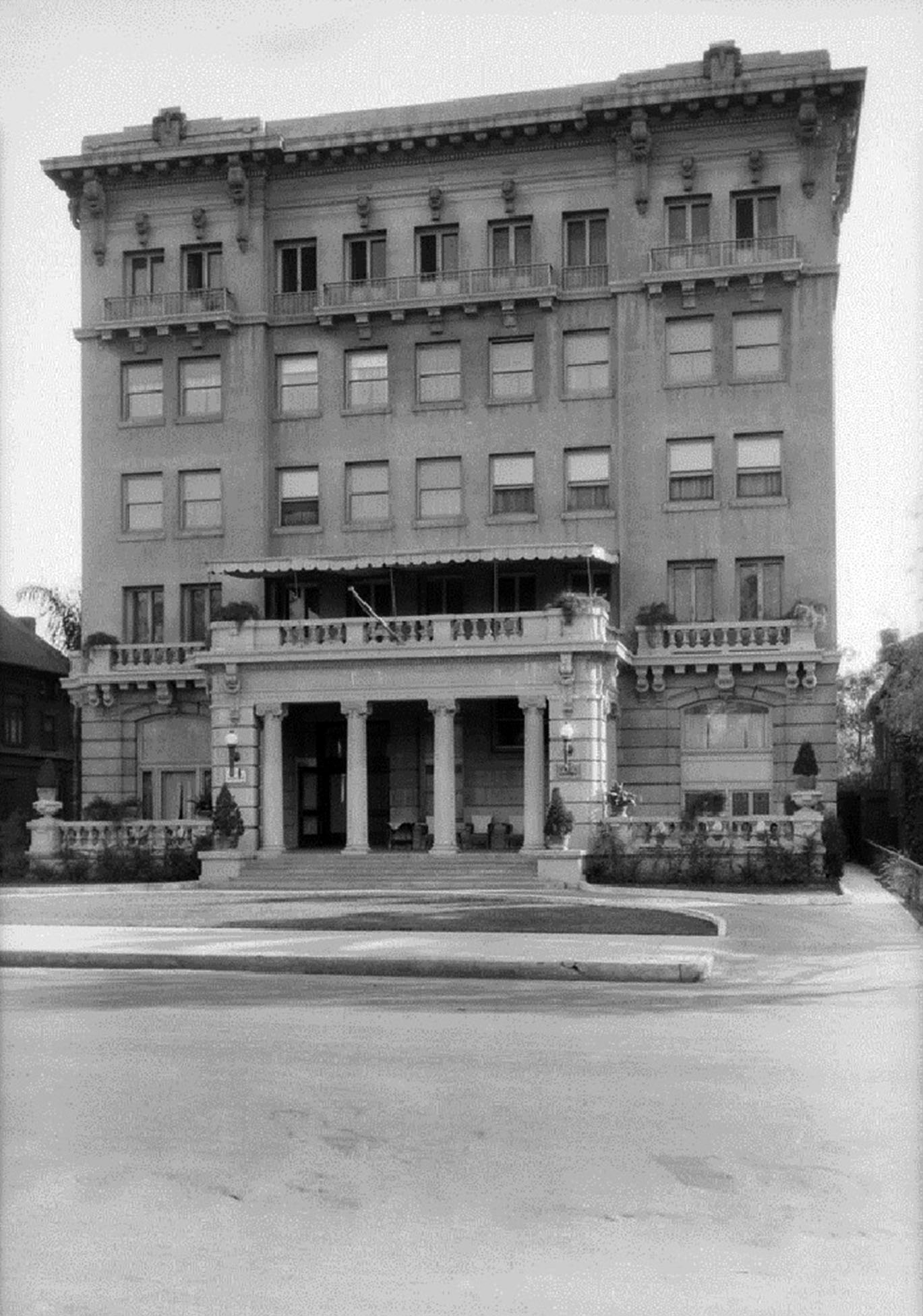 |
|
| (ca. 1930s) – The Darby Hotel, located at 234 West Adams Boulevard (near Grand). Photo Dick Whittington. |
Historical Notes While Wesley Clark's Hotel Darby was strictly genteel, its bulk and transient nature were harbingers of change in West Adams from a thoroughfare of expensive single-family residences to one of boarding establishments from which the affluent would have fled in force by the Depression. |
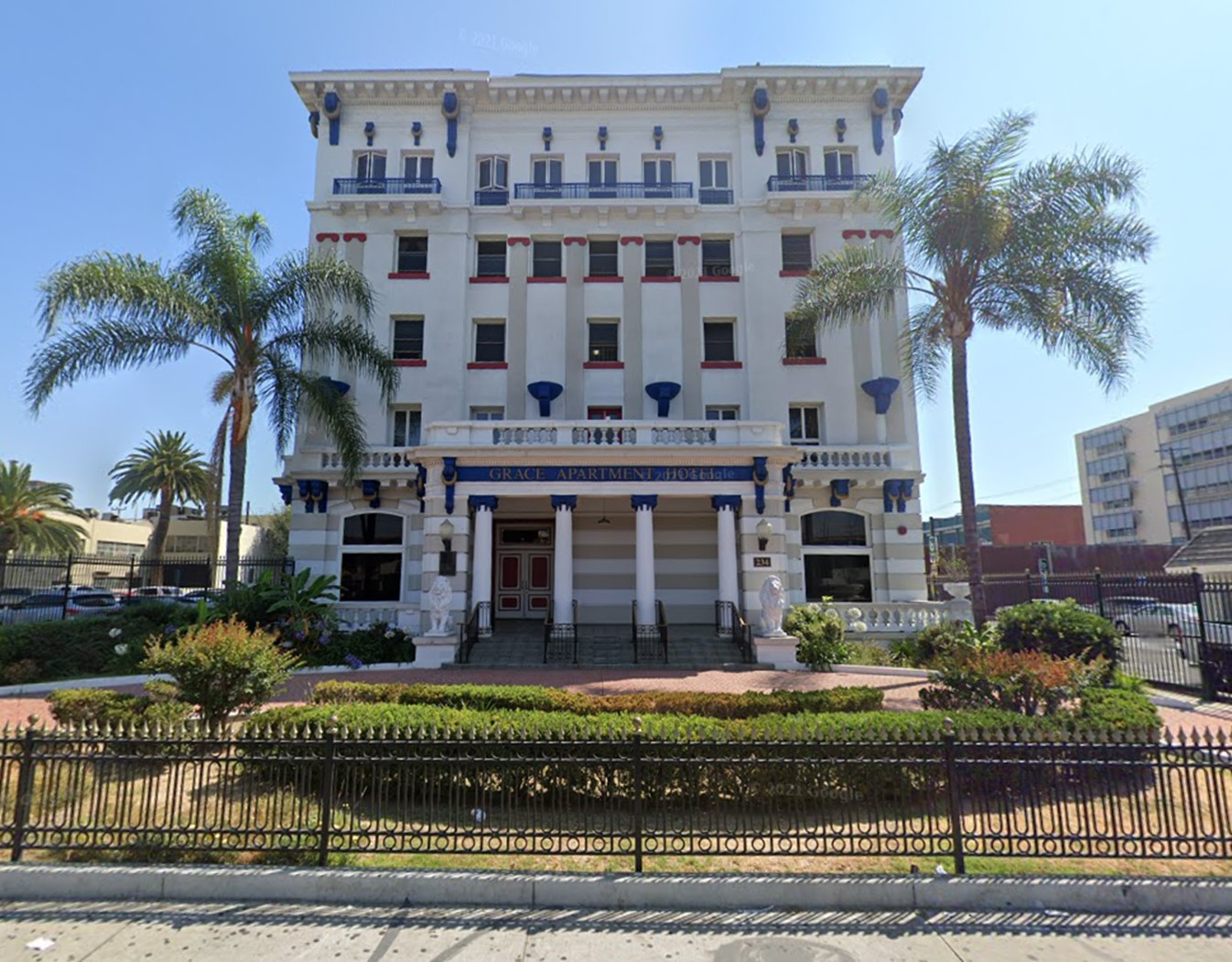 |
|
| (2021)* – Contemporary view of the Grace Apartment Hotel located at 234 W. Adams. |
Historical Notes At some point between 1943 and 1950, the name changed to the Grace Apartment Hotel. The front has lost some windows but gained some ornamental detail. |
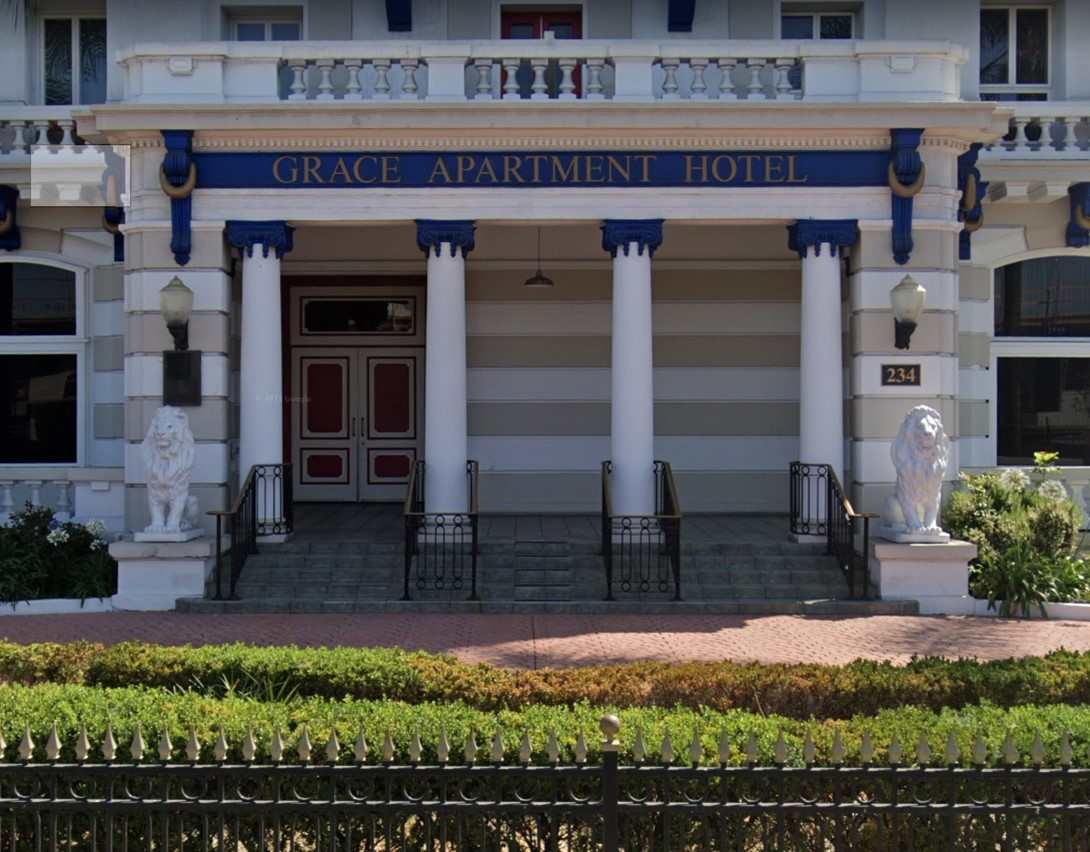 |
|
| (2021)* – Close-up view of the Grace Apartment Hotel (originally Darby Hotel). |
* * * * * |
Barlow Sanatorium
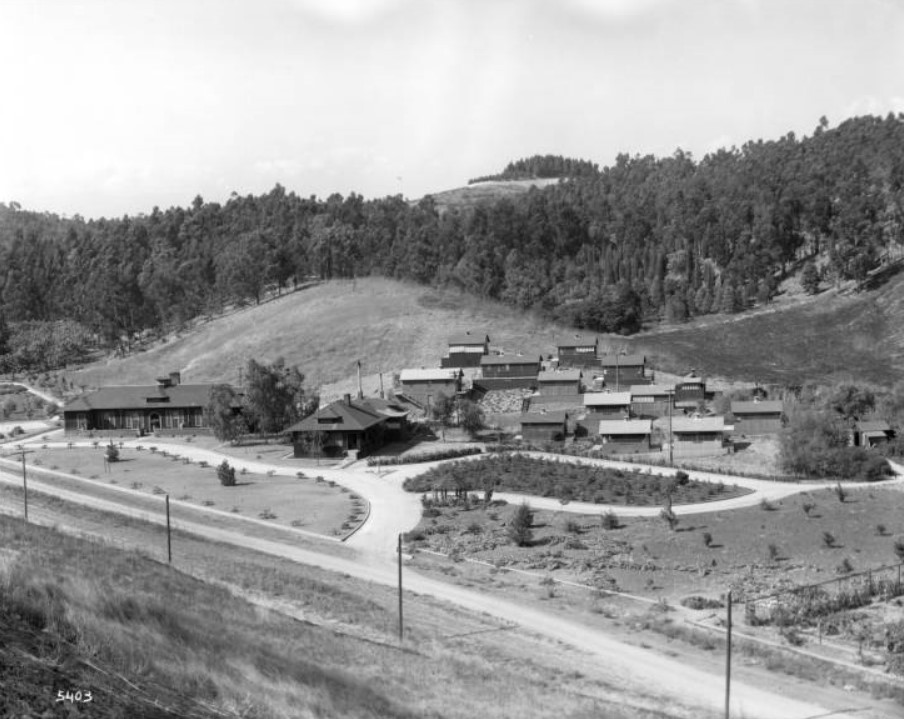 |
|
| (1915)^ - Panoramic view of the Barlow Sanatorium in its early days, Elysian Park. The sanatorium is comprised of a dozen cottages at right. At center, several small single-story buildings are visible. To the far left, is the main 13-room infirmary building. Roads circle around the compound and allow access to the main road. Surrounding grasslands, lawns, and courtyards are well maintained. Utility poles line the main road. Thick forests of trees are visible in the hilly background. |
Historical Notes In 1902 Dr. Barlow founded The Barlow Sanatorium "to care for the indigent tuberculous of Los Angeles county; those who have been residents of the county for one year and who are in no condition for active work." He and his wife had spent many days driving around the Los Angeles area in their horse-drawn carriage until they discovered what looked like the ideal location. It was 25 acres of untouched meadowland set among the rolling hills next to the city-owned Elysian Park on Chavez Ravine Road. The site turned out to be more ideal for the purpose than was initially apparent. The configuration of the hills in the area is such that clean air always sweeps across Barlow's land, even when Los Angeles itself is plagued with smog - a fortunate climatic quirk that met the fresh air needs of the patients. Dr. Barlow purchased the 25 acres from J. B. Lankershim for $7,300. He convinced Lankershim to donate back $1,000 of the purchase price, received $1,300 from Alfred Solano, who with his wife (Marion Barlow's remarried mother) would become legendary supporters of the institution, and chipped in the balance of $5,000 himself. In addition to his practice and his sanitorium, Dr. Barlow was professor of clinical medicine at the Los Angeles Medical Department of the University of California and was dean of the school from 1908 to 1914. In 1906 he established the Barlow Medical Library at Los Angeles to aid people of limited means to obtain a medical education and in 1934 donated the property and volumes to the Los Angeles County Medical Society. |
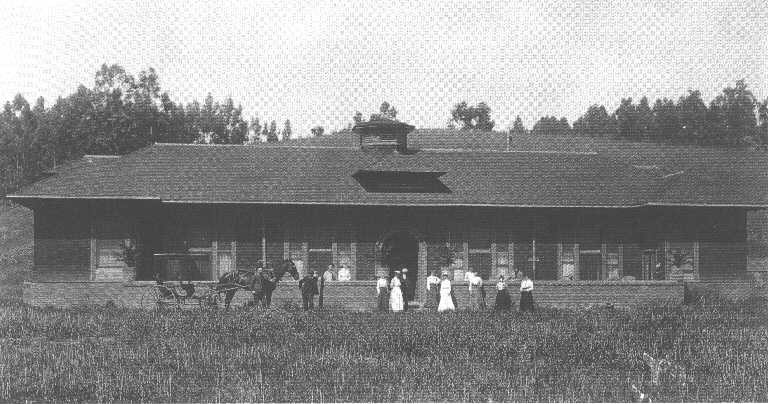 |
|
| (ca. 1903)* - View showing about a dozen people and one horse-drawn wagon in front of the thirteen room permanent cottage, designed to become Barlow's future infirmary for the more advanced cases. It was contributed by Mr. and Mrs. Alfred Solano. Later, a sixty-foot passage-way would connect it with the administration building. |
Historical Notes In 1903, the original hospital of the Barlow Sanatorium was a permanent cottage with 13 rooms, two baths and 12 patient beds. It was built with donations from Mr. and Mrs. Alfred Solano, and was consequently named the Solano Infirmary. In September 1925, the Solano Infirmary burned down. Thankfully, no one died. In 1927 Alfred's wife, Mrs. Ella Brooks Solano, provided for the creation of a new infirmary, the Ella Brooks Solano Infirmary, a building that is still in use as the main hospital today. |
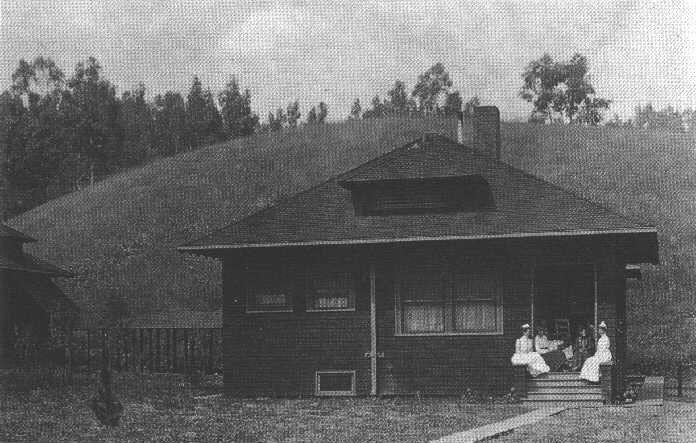 |
|
| (ca. 1903)* – View of the Administration Building, donated by Mrs. W. Jarvis Barlow. It was one of the first four structures that constituted the newly opened Barlow Sanitorium. |
Historical Notes Originally tuberculosis patients lived in tent cottages in order to be constantly exposed to free flowing air. As time went on permanent cottages were added to the campus by various donors. The style of these cottages reflected the popular trends of Los Angeles of the time. The architecture of the bungalows is in the California bungalow style. During World War I many servicemen contracted tuberculosis and were sent to the Barlow Sanatorium. Because of this the Los Angeles Chapter of the American Red Cross built and furnished four four-room cottages for military patients, some of which are still in use today. |
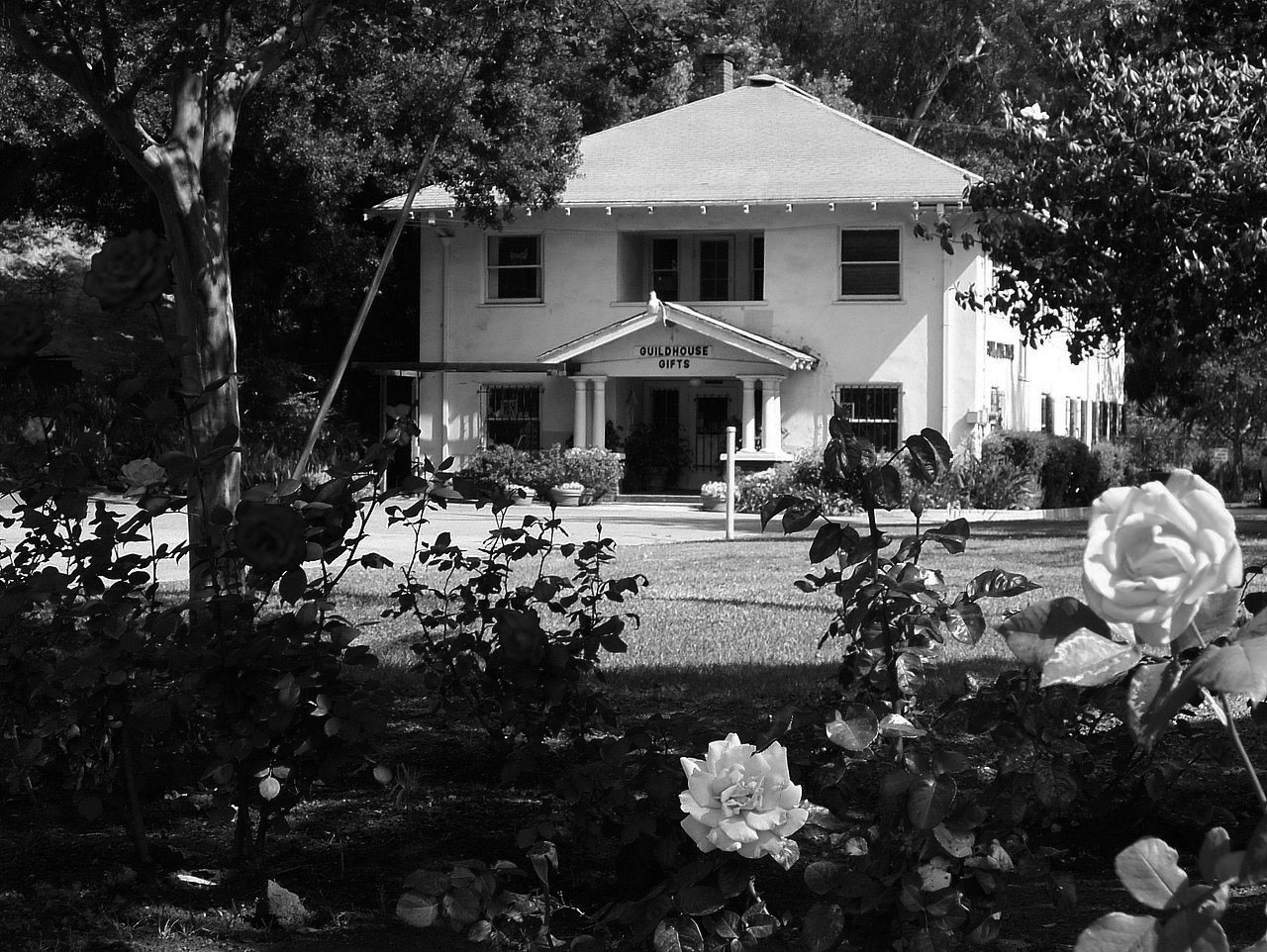 |
|
| (2009)* – View of the Barlow Respiratory Hospital Guild House in Elysian Park at 2000 Stadium Way, near Dodger Stadium. |
Historical Notes The Guildhouse was originally the "Men’s Help" quarters, where the men working in the hospital would live. In 1975 the old building was converted into a gift and plant shop. This was funded by the Barlow Guild, a large group of ex-patients dedicated to philanthropy, and the Guildhouse opened in April of that year. Originally a tuberculosis sanatorium, Barlow Respiratory Hospital, today is a long-term acute care facility that specializes in respiratory diseases and also treats related secondary ailments. The hospital treats approximately 750 patients a year and sets the national benchmark in ventilator weaning at nearly 50%. In 1990, Barlow Sanitorium was deisgnated Los Angeles Historic-Cultural Monument No. 504 (Click HERE to see complete listing). |
* * * * * |
Southwest Museum
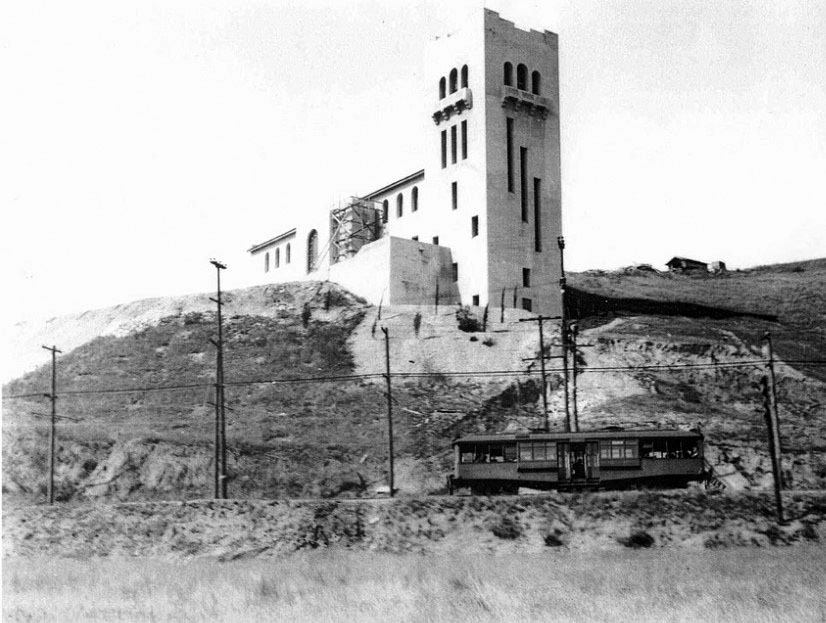 |
|
| (1914)#^** - View showing the Southwest Museum during the time of its construction. The Los Angeles Railway (LARy) W Line can be seen in the foreground. |
Historical Notes Perched on the hills of the Arroyo Seco, the Southwest Museum opened its doors to the public in 1914. It was Los Angeles’ first world-class museums that had an immense collection of Native-American and Pre-Columbian artifacts (collected by Charles Lummis during his travels throughout the Southwest and South America) that rivaled anything in the U.S. #^ |
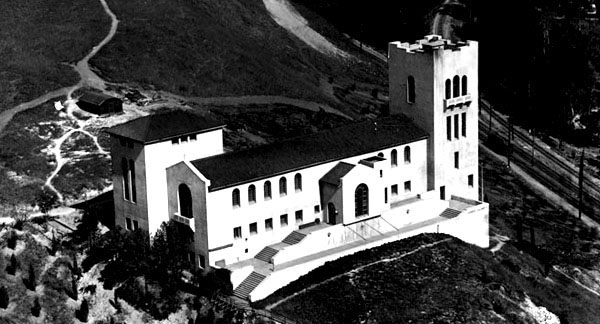 |
|
| (1914)#^ - Aerial view of the Southwest Museum shortly after it opened. |
Historical Notes Charles Fletcher Lummis was an anthropologist, historian, journalist, and photographer who created the Southwest Society, which was the western branch of the Archaeological Institute of America. He gained the support of city leaders, and with the financial backing of attorney Joseph Scott and opened the Southwest Museum in 1907. The museum moved from Downtown Los Angeles to its current location in Mt. Washington in 1914, and has been there ever since.^* |
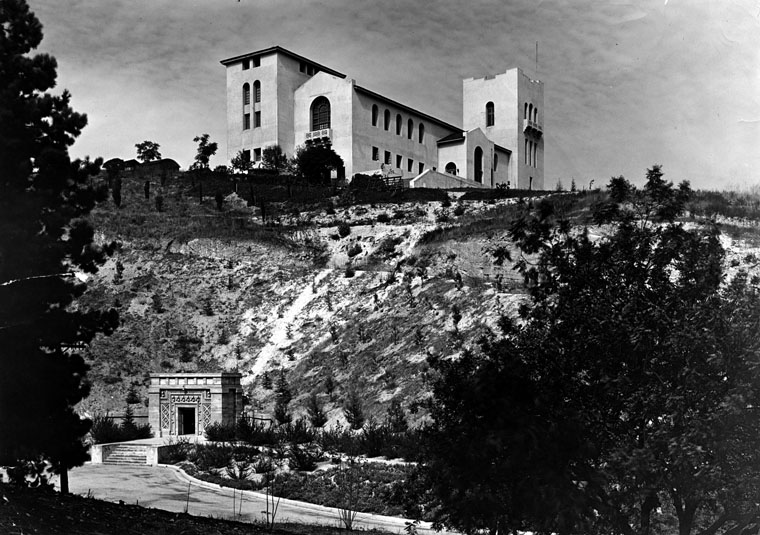 |
|
| (ca. 1915)* - The Southwest Museum, viewed through trees from the street below, sits on top of the hill at 234 Museum Drive on Mt. Washington. The main building is flanked by two towers. At the bottom of the hill is the Casa Adobe (not visible in this angle). |
Historical Notes The 1914 building was designed by architects Sumner P. Hunt and Silas Reese Burns. Later additions to the museum include the Caroline Boeing Poole Wing of Basketry (completed 1941), by architect Gordon B. Kaufmann, and the Braun Research Library (1971), by architect Glen E. Cook.^* |
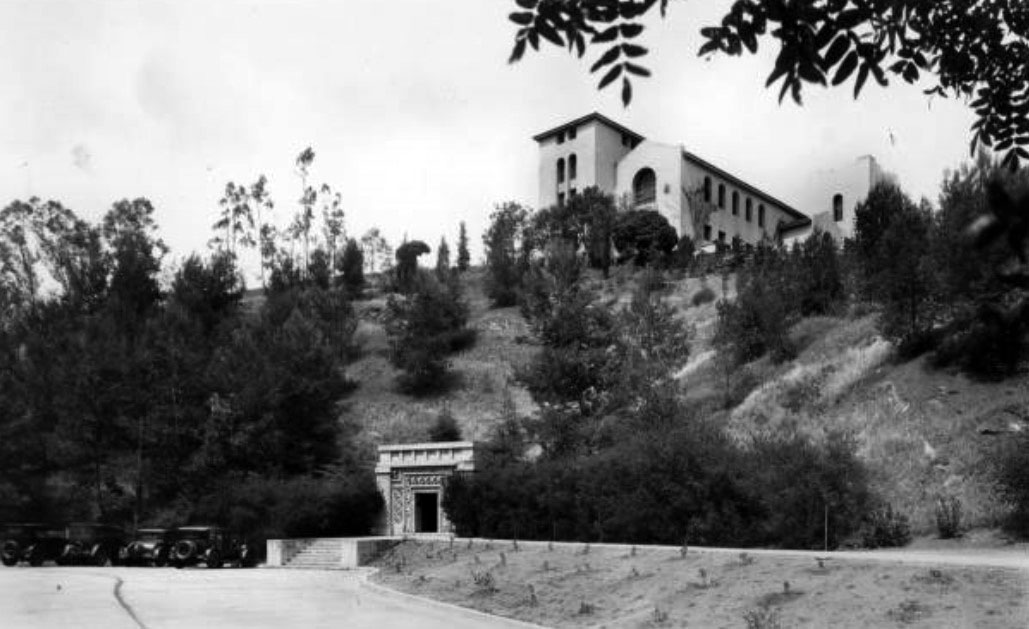 |
|
| (1931)###^ – Postcard view showing early model cars parked next to the tunnel entrance of the Southwest Museum. |
Historical Notes Due to its steep incline and lack of a driveway, a Mayan-inspired entrance was constructed on Museum Drive, which made the Museum accessible via a tunnel and elevator. Set into the walls of the portal tunnel are dioramas illustrating various ways of Native American life. |
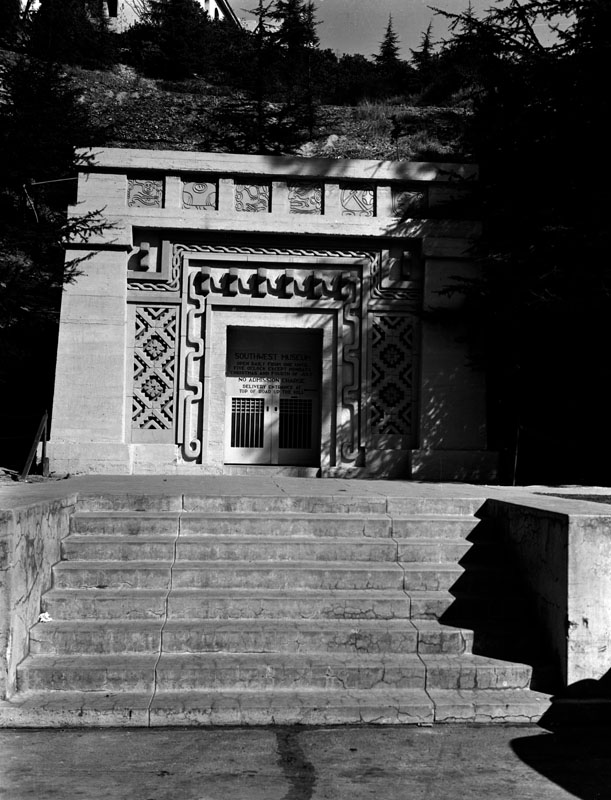 |
|
| (n.d.)* - Southwest Museum exterior showing the ornate Art Deco style tunnel entrance at the bottom of the hill. |
Historical Notes In January 2016, an exhibition of contemporary artwork opened in the building's tunnel entrance. |
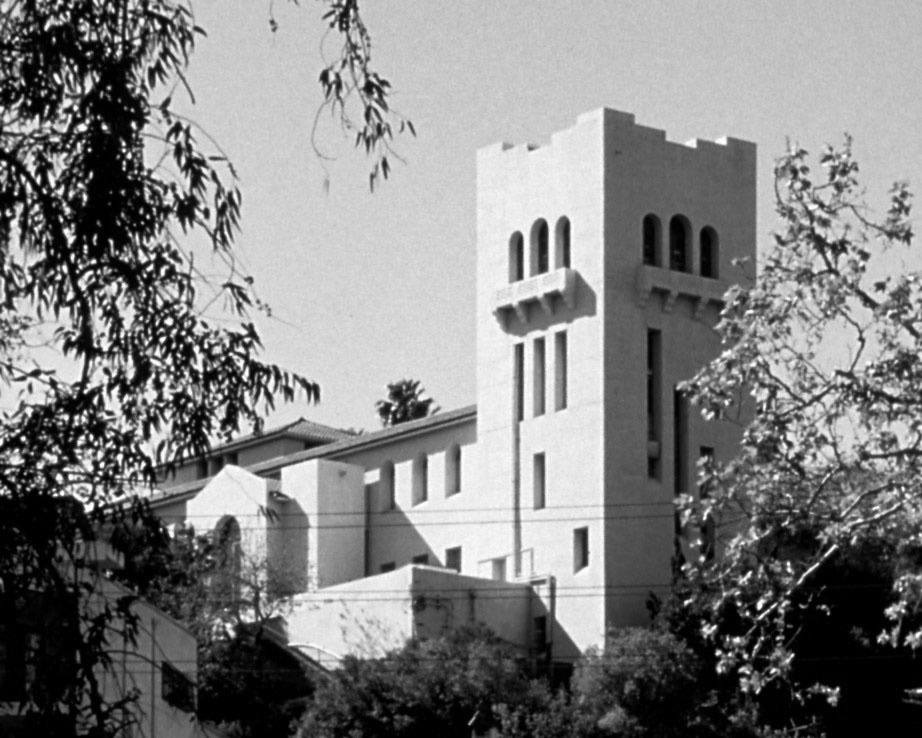 |
|
| (2015)^* - View showing the Southwest Museum as it appears today. |
Historical Notes The museum occupies 17 acres overlooking Sycamore Grove on the northwest side of the Arroyo Seco Valley. It was dedicated as LA Historic-Cultural Monument No. 283 in 1984 and became part of the Autry National Center in 2004. The Southwest Museum was also added to the National Register of Historic Places on March 11, 2004. |
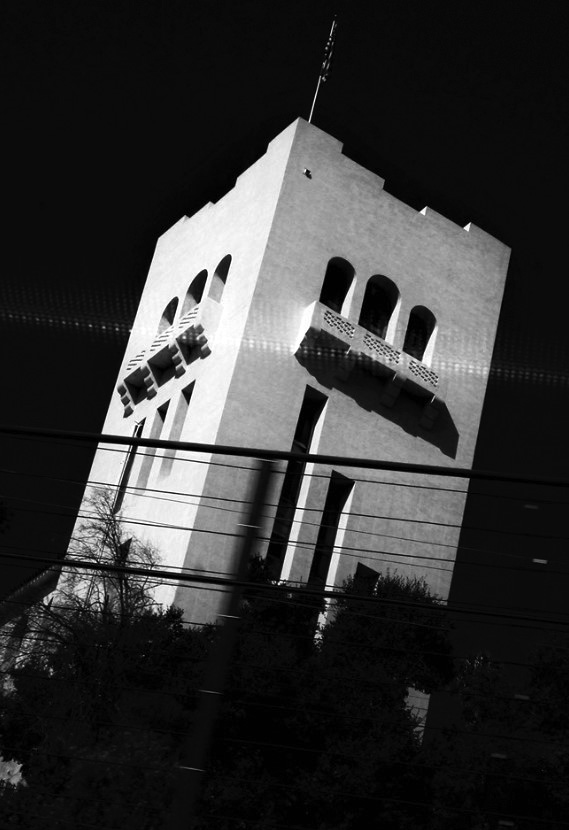 |
|
| (2019)* - View of the Southwest Museum as as seen from the Gold Line train. Photo by Howard Gray |
Historical Notes The building is now owned by the Autry National Center and houses an archaeological research center, an extensive collection of local historical artifacts, and the Braun Research Library, which contains all of Lummis' writings. |
* * * * * |
Majestic Theatre
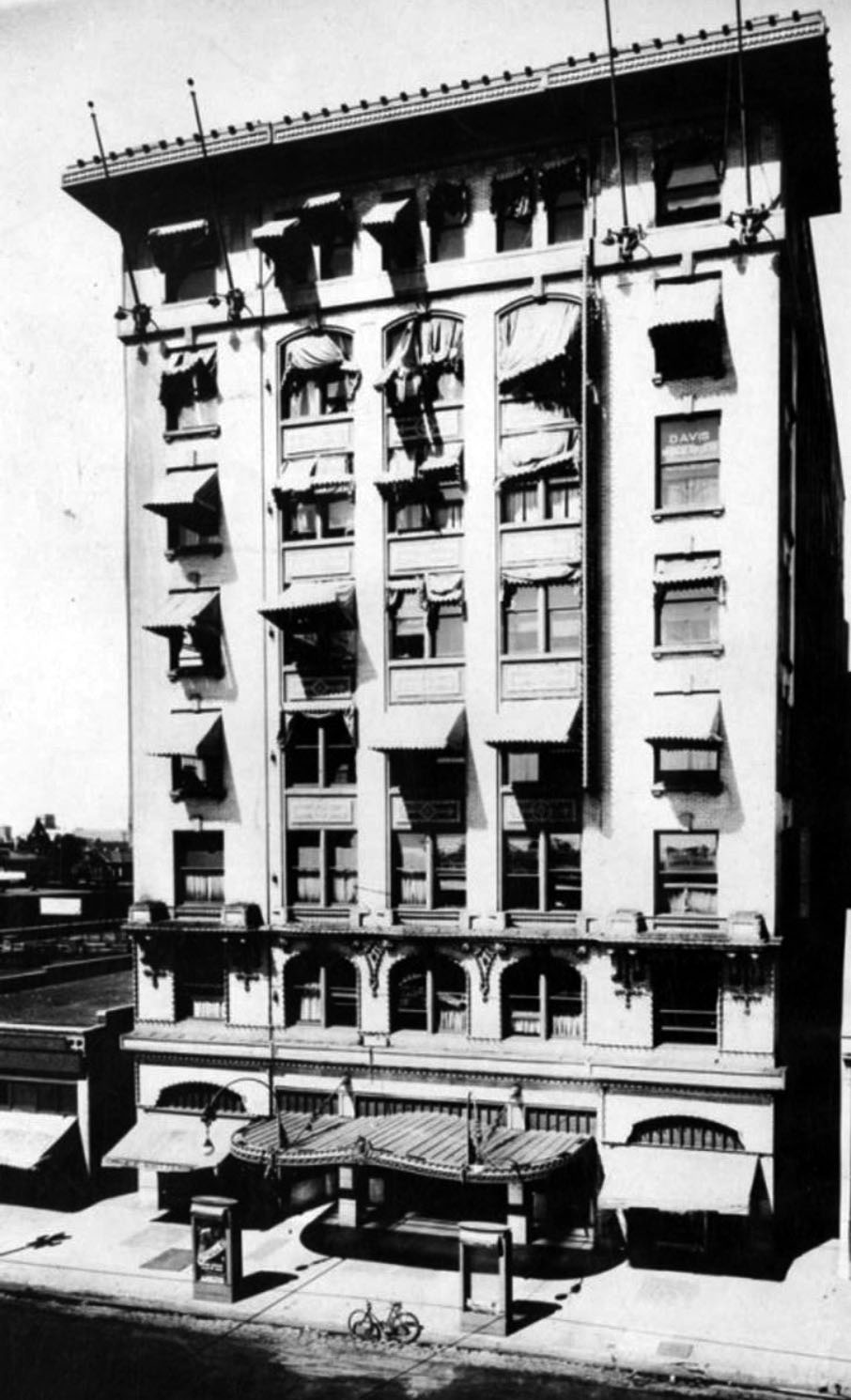 |
|
| (ca. 1910s)* – View showing a bicycle parked by the curb in front of the Majestic Theatre located at 845 South Broadway. |
Historical Notes Opened on November 23, 1908 as Hamburger's Majestic with Oliver Morosco as lessee. Morosco was earlier the tenant of the Burbank Theatre on Main St. and in 1913 would move up the street to the Morosco Theatre, a building now known as the Globe. The opening attraction at the Majestic was a Shubert production of "The Land of Nod." Morosco liked the Majestic name as he had a half interest in a successful theatre called the Majestic in San Francisco. Architects Abraham M. Edelman and Leo W. Barnett of the firm Edelman & Barnett designed the building. Edelman also designed the Belasco/Follies on Main St. and the Empress Theatre, right behind it, on Spring. He was also involved in early phases of the Shrine Auditorium project. Structural engineering for the Majestic was by the firm of Mayberry & Parker. F.O. Engstrum was the contractor. |
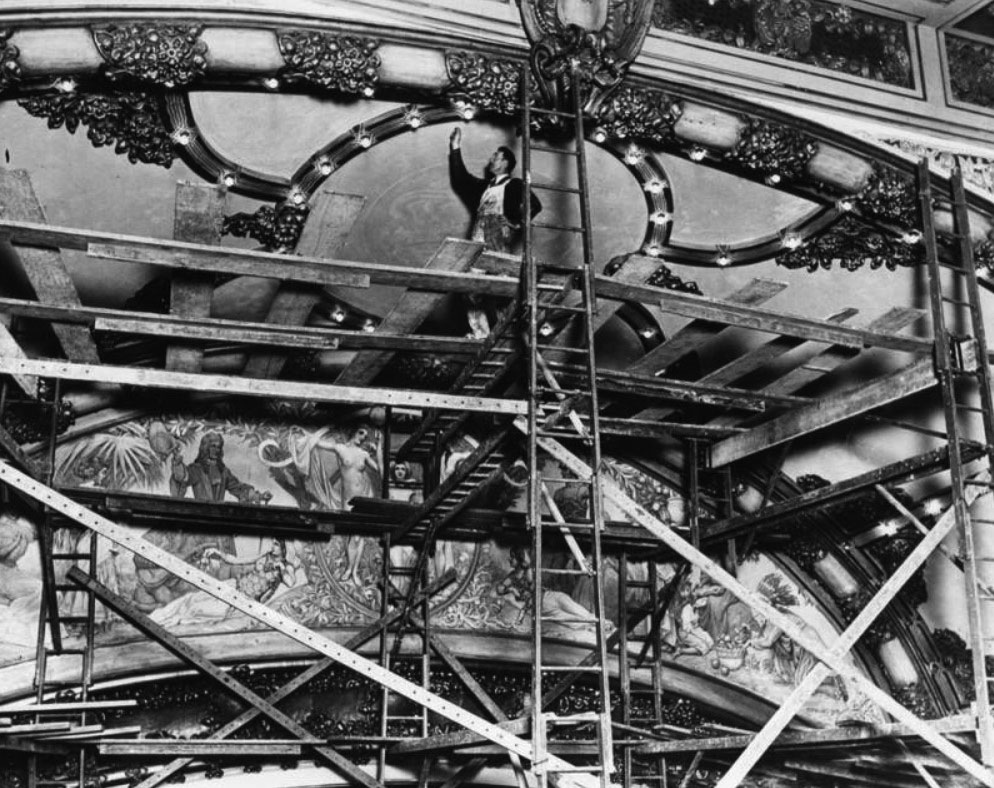 |
|
| (ca. 1910s)* - Interior view of the Majestic Theater at 845 South Broadway with scaffolding under the auditorium ceiling and the top of the proscenium. A man is seen standing on the scaffolding while working on the ceiling. |
Historical Notes Dutch artist Antoon Molkenboer was responsible for the Majestic's proscenium mural as well as decorations elsewhere in the theatre and its basement cafe. Molkenboer's mural above the proscenium was titled "Cast of Characters" and portrayed sixteen figures in a scale larger than life. |
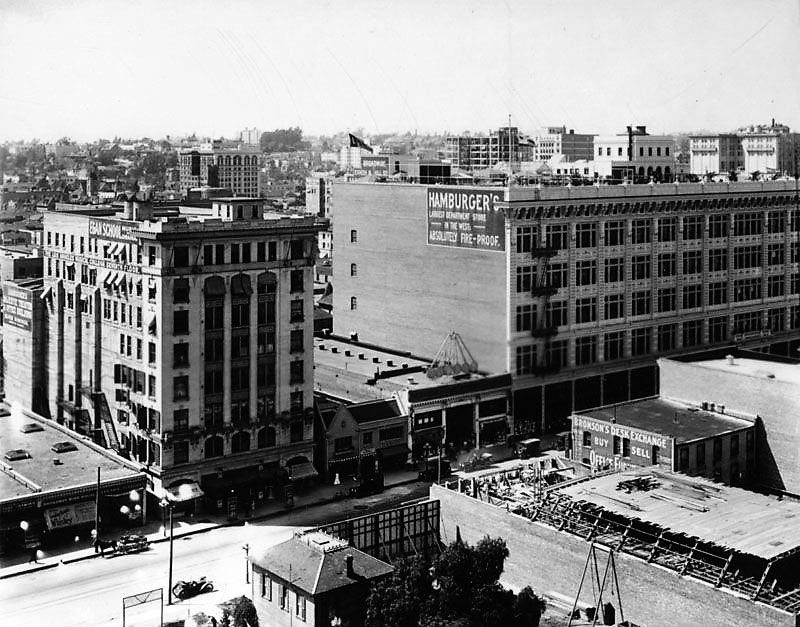 |
|
| (1913)* - View toward the Majestic facade and, adjacent to Hamburger's Department Store, Tally's New Broadway Theatre. In the lower right the Woodley Theatre is under construction. It opened in September 1913 and in 1920 got renamed the Mission. Note that the Majestic still didn't have a vertical sign. |
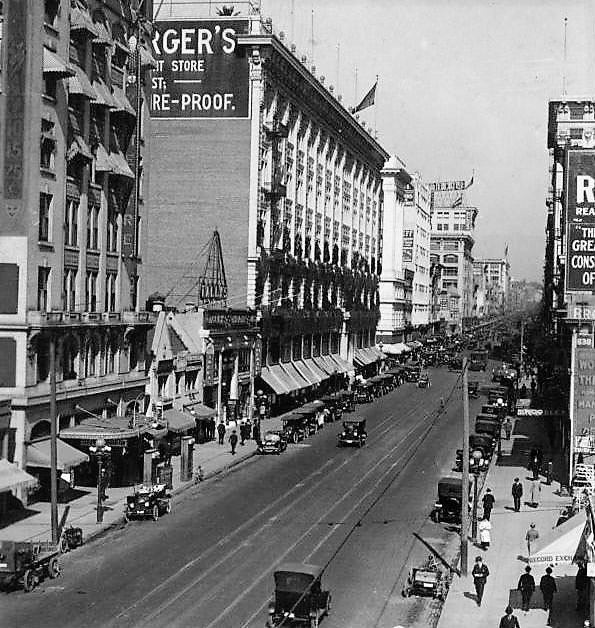 |
|
| (ca. 1916)* – View looking north on Broadway towards 8th Street showing the Majestic Theatre at left. Also seen is Tally's New Broadway Theatre just south of Hamburger's Department Store which located the SW corner of Broadway and 8th Street. |
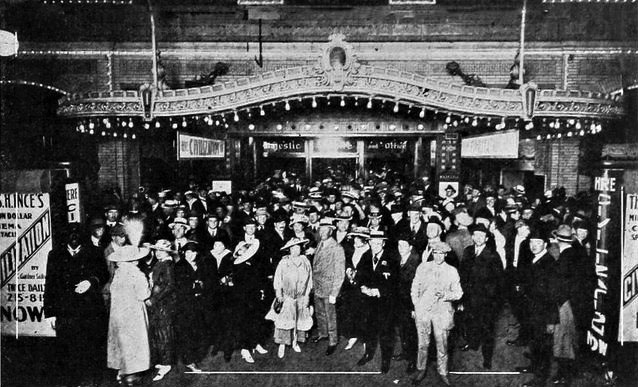 |
|
| (1916)* - View showing a crowd gathered for the April 17 opening of the Thomas Ince film "Civilization." |
Historical Notes Civilization is a 1916 American pacifist allegorical drama film produced by Thomas H. Ince, written by C. Gardner Sullivan and Edward Sloman, and directed by Ince, Reginald Barker and Raymond B. West. The story involves a submarine commander who refuses to fire at a civilian ocean liner supposedly carrying ammunition for his country's enemies. The film was a big-budget spectacle that was compared to both Birth of a Nation and the paintings of Jean-François Millet. The film was a popular success and was credited by the Democratic National Committee with helping to re-elect Woodrow Wilson as the U.S. President in 1916. The film was also one of the first to depict Jesus Christ as a character in a motion picture, leading some to criticize the depiction as in "poor taste." Civilization is sometimes viewed as one of the first anti-war films. In 1999, it was selected for preservation in the United States National Film Registry by the Library of Congress as being "culturally, historically, or aesthetically significant". |
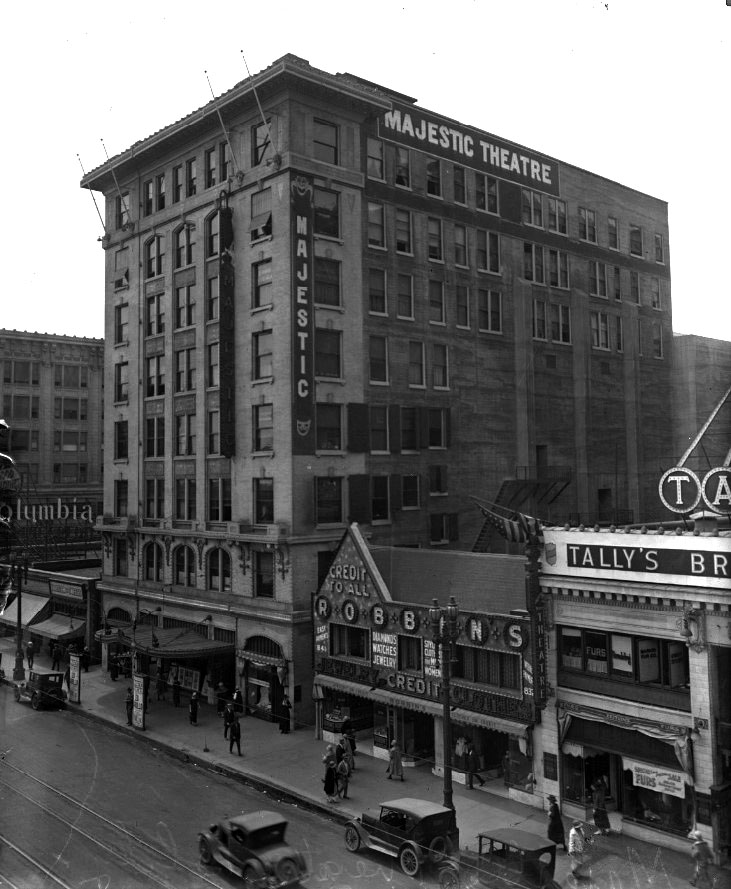 |
|
| (ca. 1920)* - View looking southwest showing the Majestic Theatre at 845 S. Broadway. Tally's New Broadway Theatre is seen on the right. |
Historical Notes Originally leased by Oliver Morosco, the 1700-seat Majestic quickly became the preferred home-away-from-home to many national touring musical and dramatic productions from Broadway. Future silent film star Ramon Navarro’s first show biz job was as an usher there. In 1910, the Majestic was the local performance venue of choice for a versatile, LA-based stage performer named Lon Chaney, later dubbed “The Man of a Thousand Faces". |
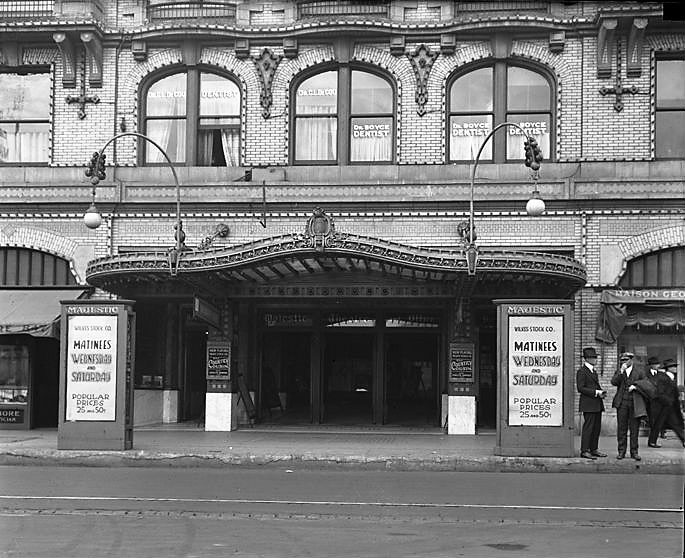 |
|
| (1920)* - An entrance view with posters advertising the Wilkes Stock Co. in "The Country Cousin" with Evelyn Varden and Edward Everett Horton. The production opened in January. Note the dentists’ offices on the 2nd floor. |
Historical Notes In April 1913, during the Majestic’s opening night of the Kolb and Dill show, managed by famous actor Lon Chaney, his wife, Cleva, attempted suicide, ingesting mercury dichloride and running onstage from the wings. She survived but was never able to sing again. The scandal forced Chaney out of live theater and into silent films. There he specialized in creating such fearsome characters as Quasimodo in The Hunchback of Notre Dame and the Phantom in The Phantom of the Opera. Chaney divorced Cleva; his son subsequently took on the name Lon Chaney, Jr. On the verge of making a successful transition into talking pictures, Lon Chaney died on August 26, 1930, of a bronchial hemorrhage. Meanwhile, the bad publicity resulting from Cleva’s suicide attempt knocked the Majestic out of favor with mainstream touring acts from Broadway. In 1926, the Majestic partnered with Orange Grove Theatre (later the Grand) in the presentation of risqué vaudeville and burlesque shows. Over the next half-dozen years, the theater was subjected to constant police raids for violation of the city’s Indecent Show ordinance. It was forced to close in 1931, when a police raid results in a number of patrons being trampled.. |
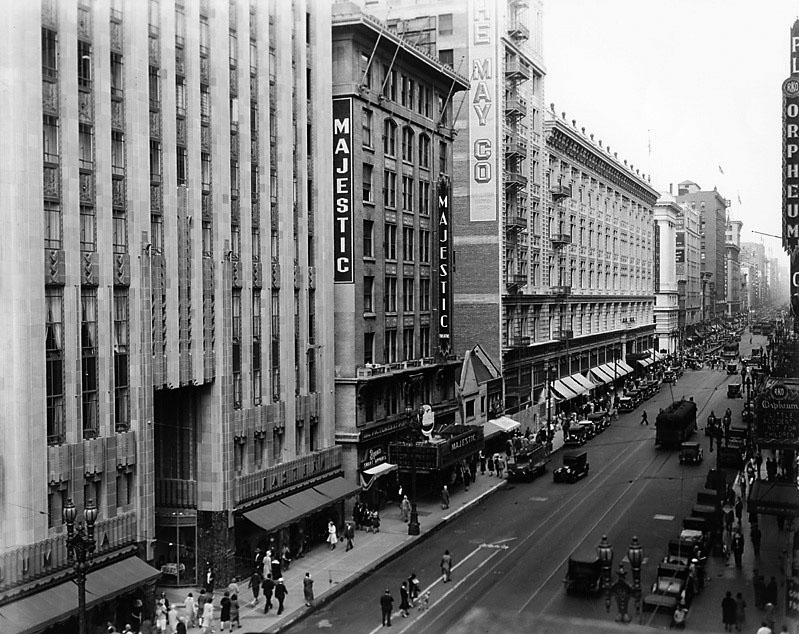 |
|
| (1930)* – View of Broadway looking north from 9th Street with the Majestic Theatre seen at center. The newly opened Eastern Columbia Building is on the left. The Majestic is running "Top Speed" with Joe E. Brown, an August release. Just beyond, note that Tally''s Broadway is no gone. The The May Company was still working on the storefronts of the addition on the Tally's site. At the Orpheum Theatre (on the right) it's "Little Accident," a July release with Douglas Fairbanks, Jr. and Anita Page. |
Historical Notes In 1933, the Majestic was demolished to make way for a parking lot, which eventually becoame the three-story garage that stands on the site today. Click HERE for contemporary view. |
* * * * * |
Quinn's Superba Theatre
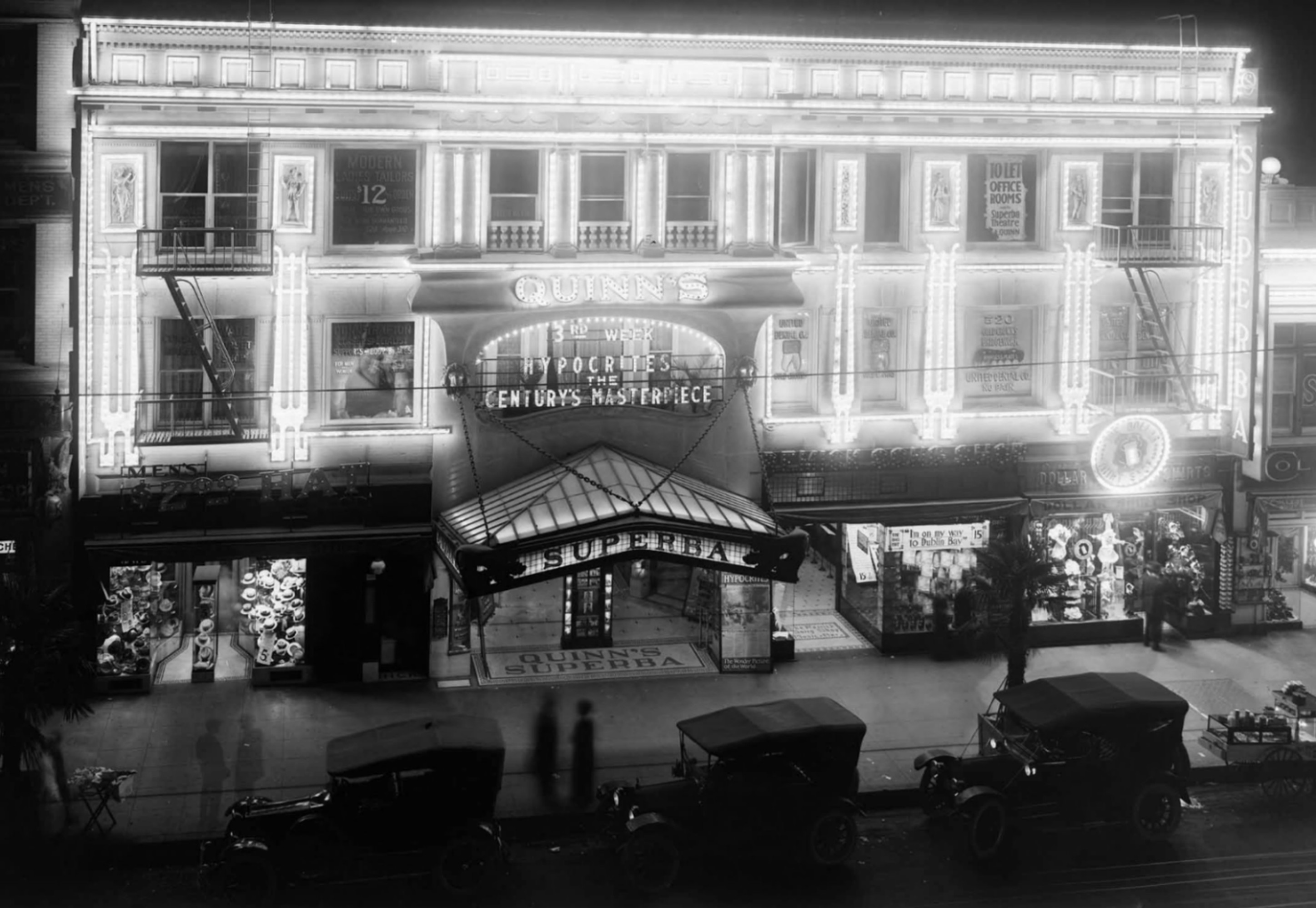 |
|
| (1915)* - Quinn’s Superba Theatre blazing on Broadway — 3rd week of ‘Hypocrites'. |
Historical Notes This dazzling nighttime view captures the Superba during its third week showing Hypocrites, the controversial silent film by pioneering female director Lois Weber. Opened July 30, 1914, Quinn’s Superba featured a glowing unicorn-lit marquee, 1,600 seats, a marble-and-onyx lobby, and a 12-piece orchestra. One of the earliest "movie palaces" in Los Angeles, it drew over 12,000 patrons during a single 24-hour run in 1915. The theater closed in 1922, was briefly reused as a coffee house, and was demolished in 1931 to make way for the Roxie Theatre. |
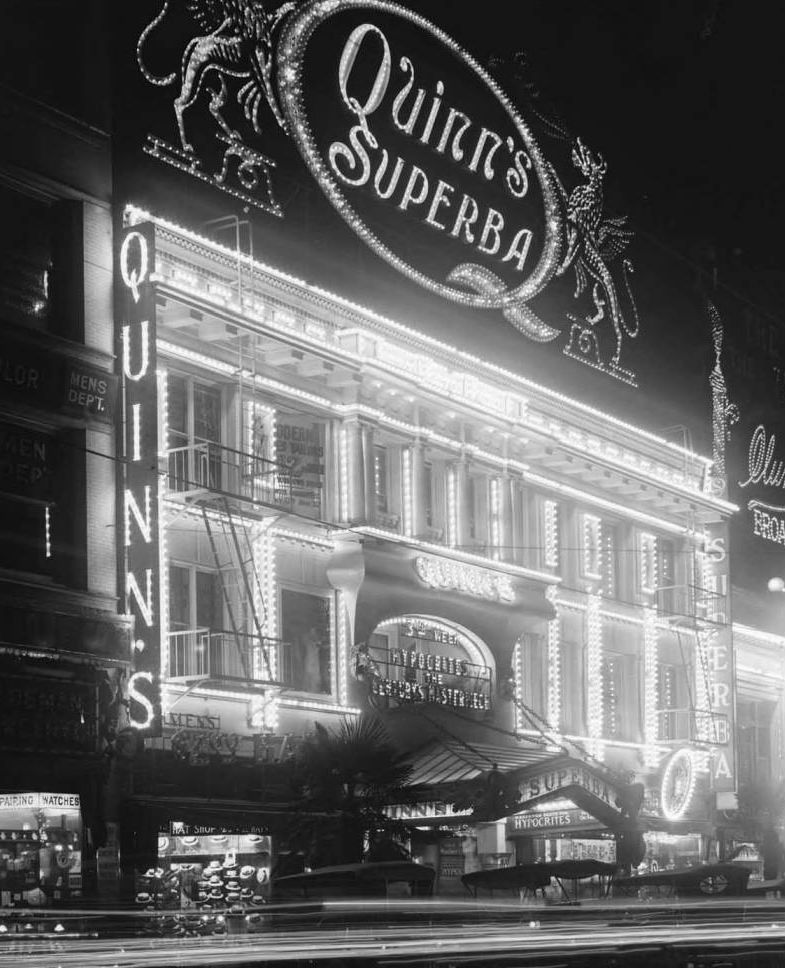 |
|
| (1915)* - Quinn’s Superba Theatre, 518 S. Broadway — nighttime brilliance. |
Historical Notes John A. Quinn’s vision brought theatrical elegance to early cinema. This view shows the elaborate façade, trimmed with electric lights, drawing Angelenos into one of the city’s most lavish silent-era venues. Quinn had previously operated theaters across downtown, including the Banner, Garrick, and Tally’s, before establishing the Superba as his crown jewel. The building occupied a prime spot on Broadway’s booming theater corridor. |
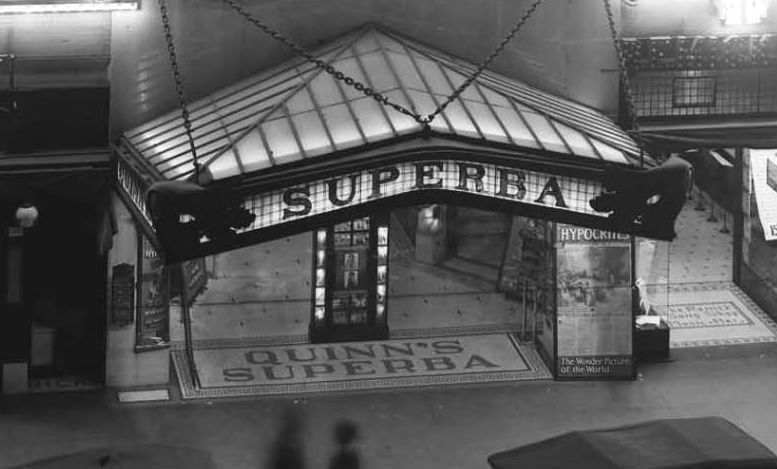 |
|
| (1915)* - Main entrance of Quinn’s Superba — detail view. |
Historical Notes The entrance to Quinn’s Superba was framed by a glass-and-metal canopy with glowing vertical signage and elegant box office windows. Its interior featured mahogany paneling and mirrored walls, reflecting the grandeur associated with early motion picture exhibition. The venue played a critical role in elevating moviegoing into a mainstream cultural experience. |
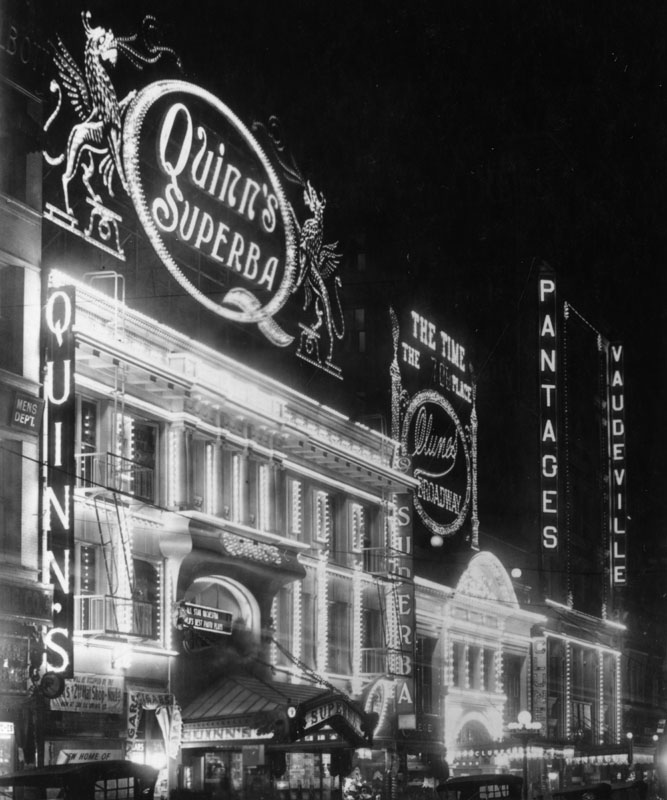 |
|
| (ca. 1915)* - Superba on Broadway — part of the theater row, |
Historical Notes This street-level view places the Superba in its theatrical context—nestled beside Clune’s Broadway (later the Cameo) and the original Pantages Theatre. These early landmarks helped establish South Broadway as Los Angeles’ new entertainment district. The Superba stood on the site later occupied by the Roxie Theatre, the last picture palace built on Broadway. |
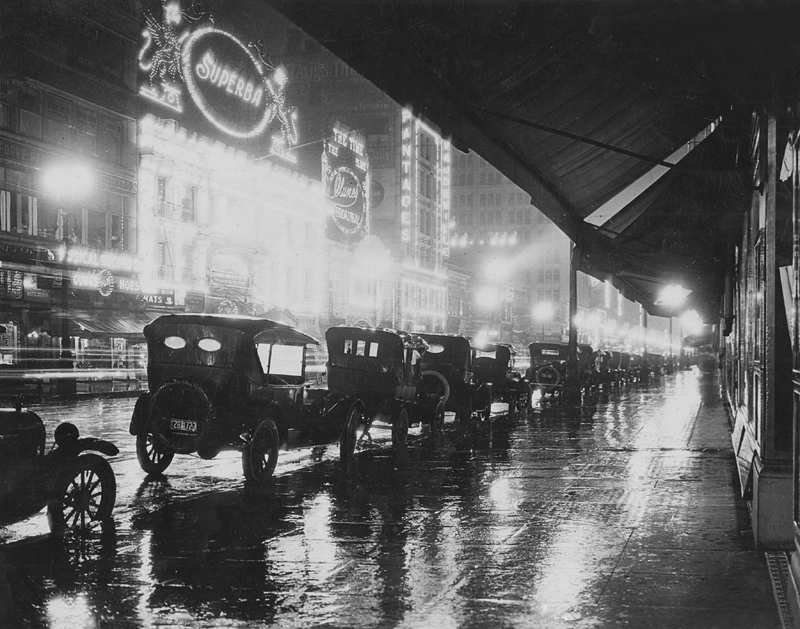 |
|
| (1920)* - Broadway’s rainy night — Superba, Clune’s, Pantages glow. |
Historical Notes Seen here from across the street on a rain-slicked night, the Superba, Clune’s, and Pantages glow beneath the streetlamps and marquees. By 1922, the Superba was sold and repurposed as a coffee shop. It was demolished in mid-1931 to make room for the Roxie Theatre, an Art Deco masterpiece that marked the end of Broadway’s theater-building boom. |
* * * * * |
Pantages Theatre (1st Pantages)
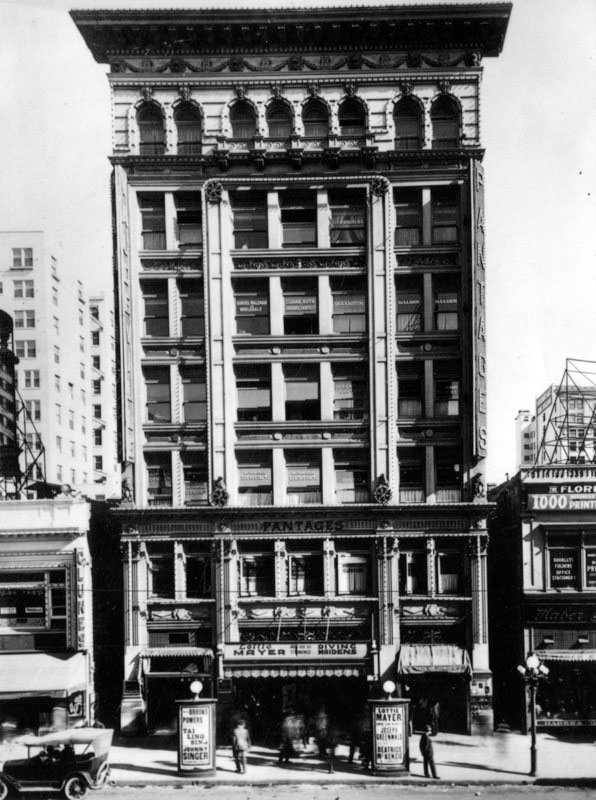 |
|
| (ca. 1917)* – View showing the first Pantages Theatre, located at 534 S. Broadway in Downtown Los Angeles. Clune's Broadway Theatre is seen on the left. |
Historical Notes Designed by Morgan & Walls, this theater opened on September 26, 1910 as a vaudeville theatre for Alexander Pantages. After Pantages moved to his new theater at 7th and Hill streets in 1920, this theater was renamed Dalton's. Eight years later, it was renamed Arcade in honor of the popular Arcade Building. In the 1940s it was known as the Telenews and the Teleview. It has been closed since 1992. |
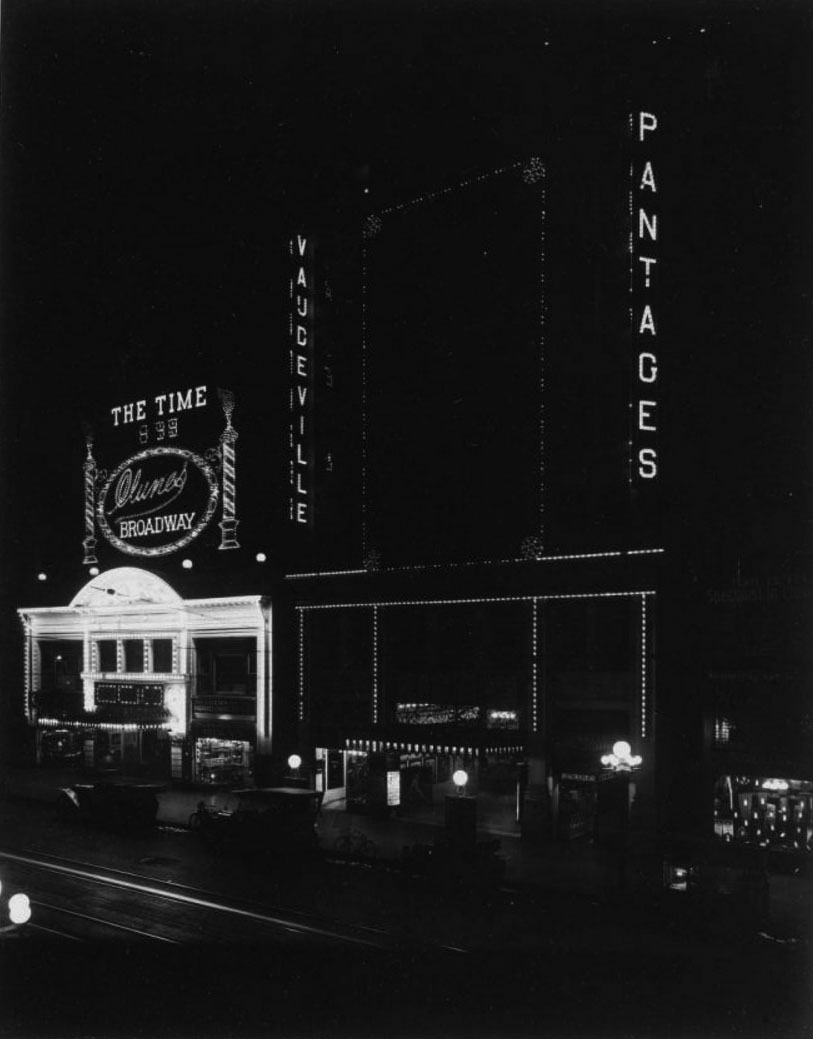 |
|
| (1913)* – Night view showing the Pantages Theatre all lit up with the Clune's Broadway Theatre on the left. |
 |
|
| (ca. 1915)* - View looking at the east side of Broadway between 5th and 6th streets, showing the Quinn's Superba, Clune's, and the first Pantages Theater. |
Historical Notes The Pantages Theatre (1910), Clune's Broadway (1910), and Quinn's Superba (1914), along with the 1911 Orpheum Theatre (now the Palace) and Tally's New Broadway (1910), put Broadway on the map as the new entertainment street in Los Angeles. |
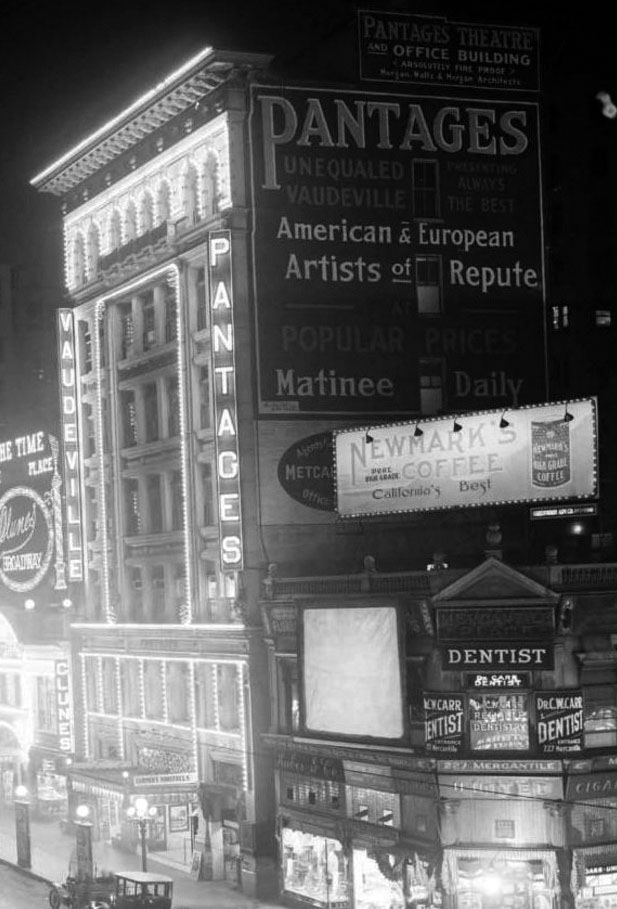 |
|
| (1916)* - Night view of the Pantages Theatre at 534 N. Broadway. The building with the dentist office on the right is where the Arcade Building would be built in 1924. |
Historical Notes After Pantages Theatre moved to its new location at 7th and Hill streets in 1920, this theater was renamed Dalton's. Eight years later, it was renamed Arcade in honor of the popular Arcade Building. |
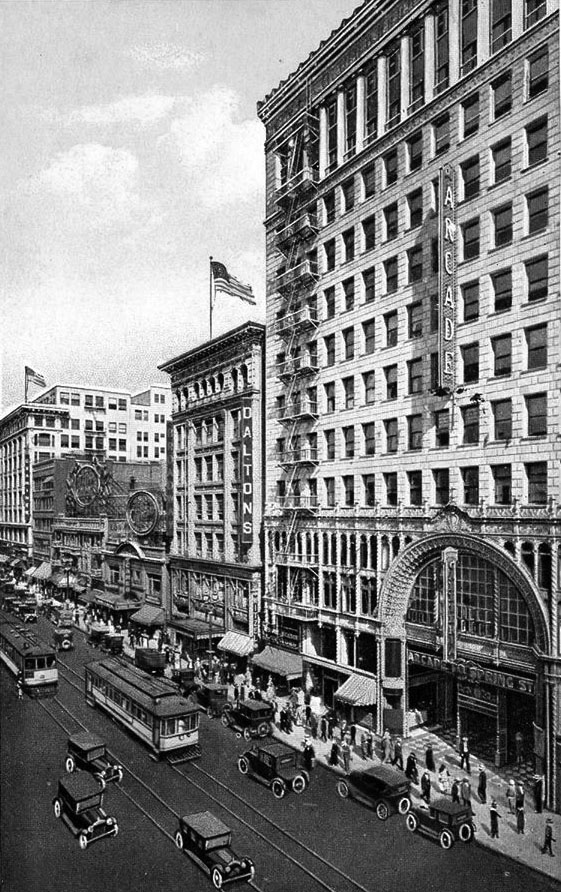 |
|
| (ca. 1924) – Postcard view looking north on Broadway from near 6th Street showing from right to left: the Arcade Building (built in 1924), Dalton’s Theatre (previously Pantages Theatre), Clune's Broadway Theatre, and Quinn's Superba Theatre. |
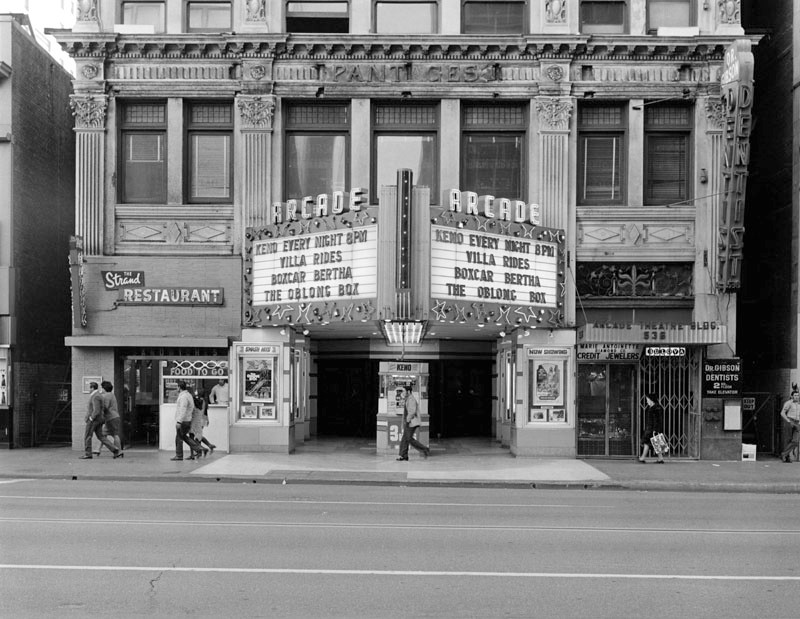 |
|
| (1983)* – View of the Arcade Theatre, formerly the 1st Pantages Theater. The marquee advertises Keno every night. Next door is the Strand Restaurant and the Marie Antoinette Diamond Company Credit Jewelers, in the Arcade Theater Building. Dr. Gibson Dentist is on the second floor. |
Historical Notes In 1928 the theatre was given the name Arcade to capitalize on the popularity of the Arcade Building nearby. The current marquee is on the building dates from around 1935 when S. Charles Lee did a facade renovation. |
* * * * * |
Clune's Broadway Theatre (later Cameo Theatre)
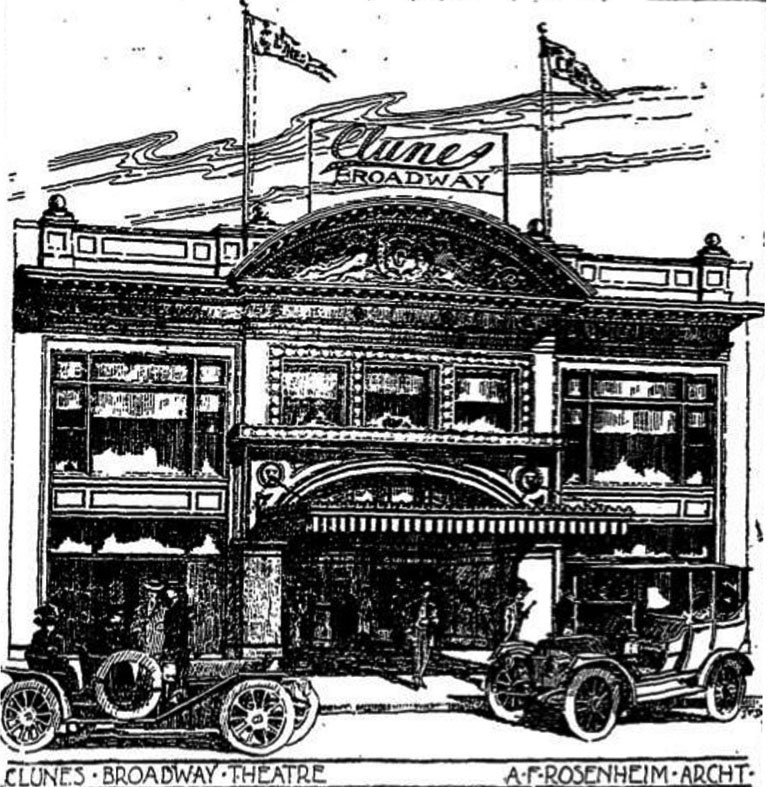 |
|
| (ca. 1910)++^ – Sketch showing the Clunes Broadway Theatre located at 528 S. Broadway. Los Angeles Times, July 17, 1910. |
Historical Notes Architect: Alfred F. Rosenheim, a leading Los Angeles architect, who became the first president of the LA chapter of the American Institute of Architects. Among other projects, Rosenheim had done the Arrow Theatre (inside Hamburger's Department Store (1908) and later did the Morosco/Globe (1913). The theatre was built on a lot owned by Eva Fenyes, a Pasadena resident with fingers in a number of theatrical interests, including once having D.W. Griffith shoot a film on her estate. W. H. Clune (Billy) was a pioneer exhibitor and filmmaker. The Clune Studios in Hollywood at Melrose and Bronson still exists -- known today as the Raleigh Studios. ++^ |
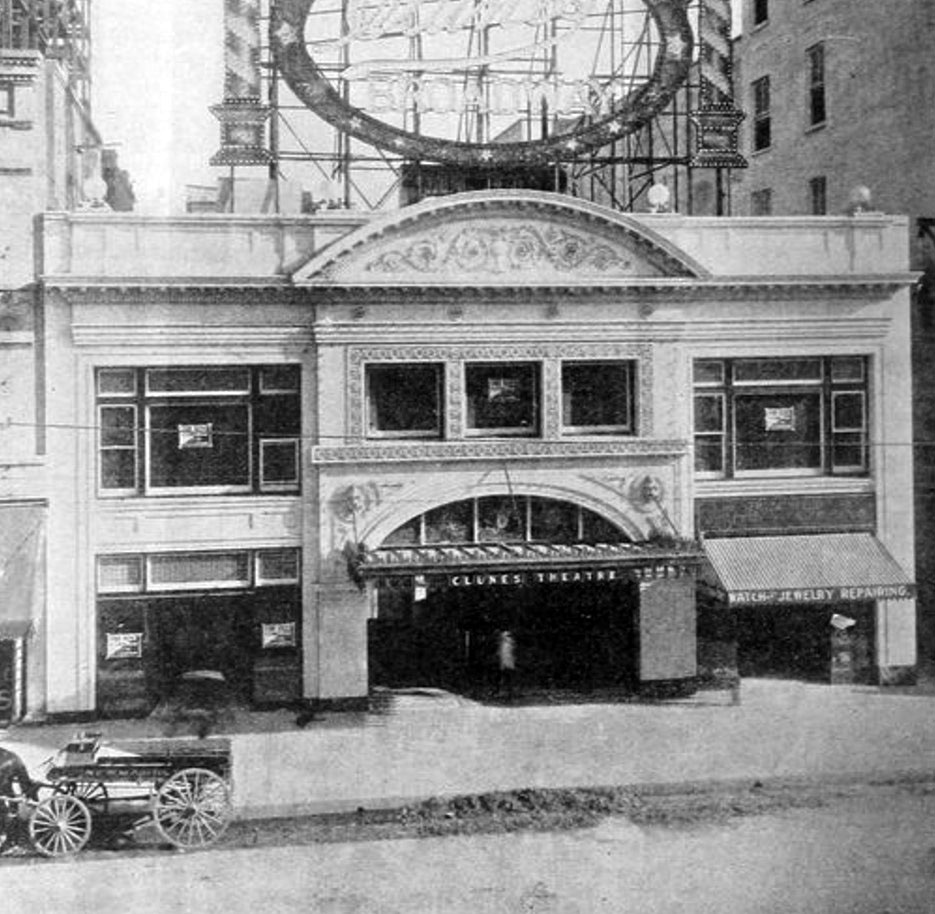 |
|
| (1910)^^^* – View showing Clune’s Broadway Theatre shortly after it was completed with horse-drawn wagon parked in front. “For Rent” signs are still on the windows of one of the storefronts adjacent to the theater entrance and the upstairs offices. |
Historical Notes Opened as Clune’s Broadway Theatre October 10, 1910, it was an original nickelodeon theatre and is a rare example to survive today almost unaltered. Its operator William H. (Billy) Clune was an early pioneer film producer and exhibitor. Architect Alfred F. Rosenheim designed a Beaux-Arts interpretation of Italian Renaissance Revival style. Its original roof-top electric sign and ‘digital’ clock were Downtown landmarks for many years. In 1921 it was equipped with a Wurlitzer organ Style 185, Opus 397. In 1925 until 1926 it was operated by Universal Pictures chain and renamed Cameo Theatre. In the late-1920’s it was operated by H.L. Gumbiner (who soon was to build the Tower Theatre and Los Angeles Theatre further along South Broadway) who replaced the sign and clock with a large 24-sheet billboard. ^^^* |
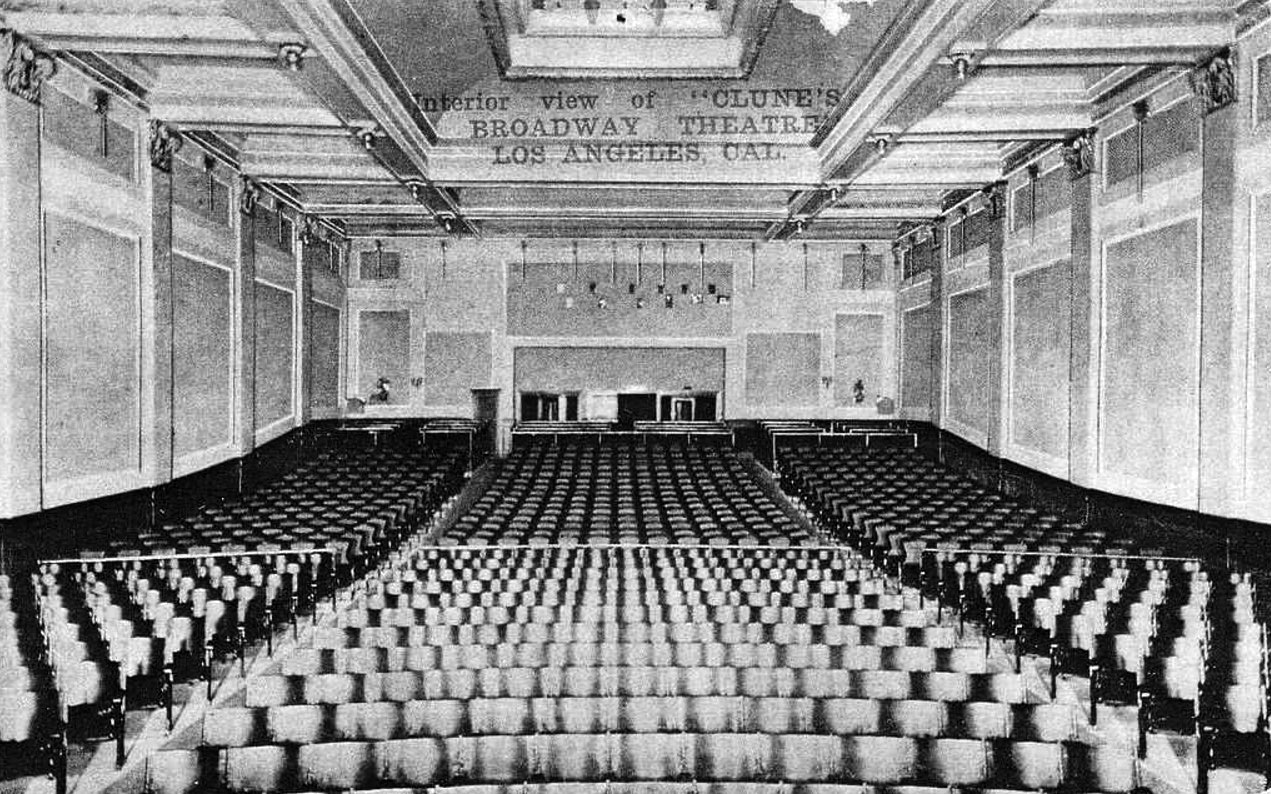 |
|
| (ca. 1910s)++^ – Postcard view showing the interior of Clune’s Broadway Theatre. |
Historical Notes The interior of the building was specifically designed as a ‘picture playhouse’ and had decorations which featured marble, plaster, leaded glass and a profusion of electric lights. A 1912 ad for Clune's boasted "When one speaks of low-priced theater attractions the name CLUNE comes first to the mind because it is an uncontested fact that the CLUNE THEATERS in Los Angeles and Pasadena set the pace in these popular public attractions." ++^ |
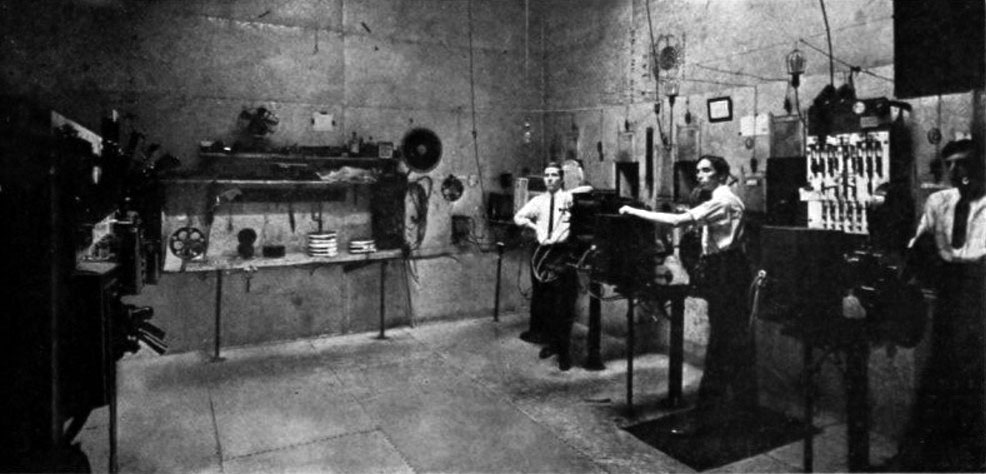 |
|
| (1911)++^ - A photo of the Clune's projection booth from Moving Picture World in 1911. Note the open front switchboard on the booth's front wall. |
Historical Notes The Clune's Broadway had an orchestra of 10 pieces to accompany the films. |
 |
|
| (ca. 1915)* - View looking at the east side of Broadway between 5th and 6th streets, showing the Quinn's Superba, Clune's Broadway, and the first Pantages Theatre. |
Historical Notes The 1910 Pantages Theatre, 1910 Clune's Broadway, and 1914 Quinn's Superba, along with the 1911 Orpheum Theatre (now the Palace) and 1910 Tally's New Broadway, put Broadway on the map as the new entertainment street in Los Angeles. |
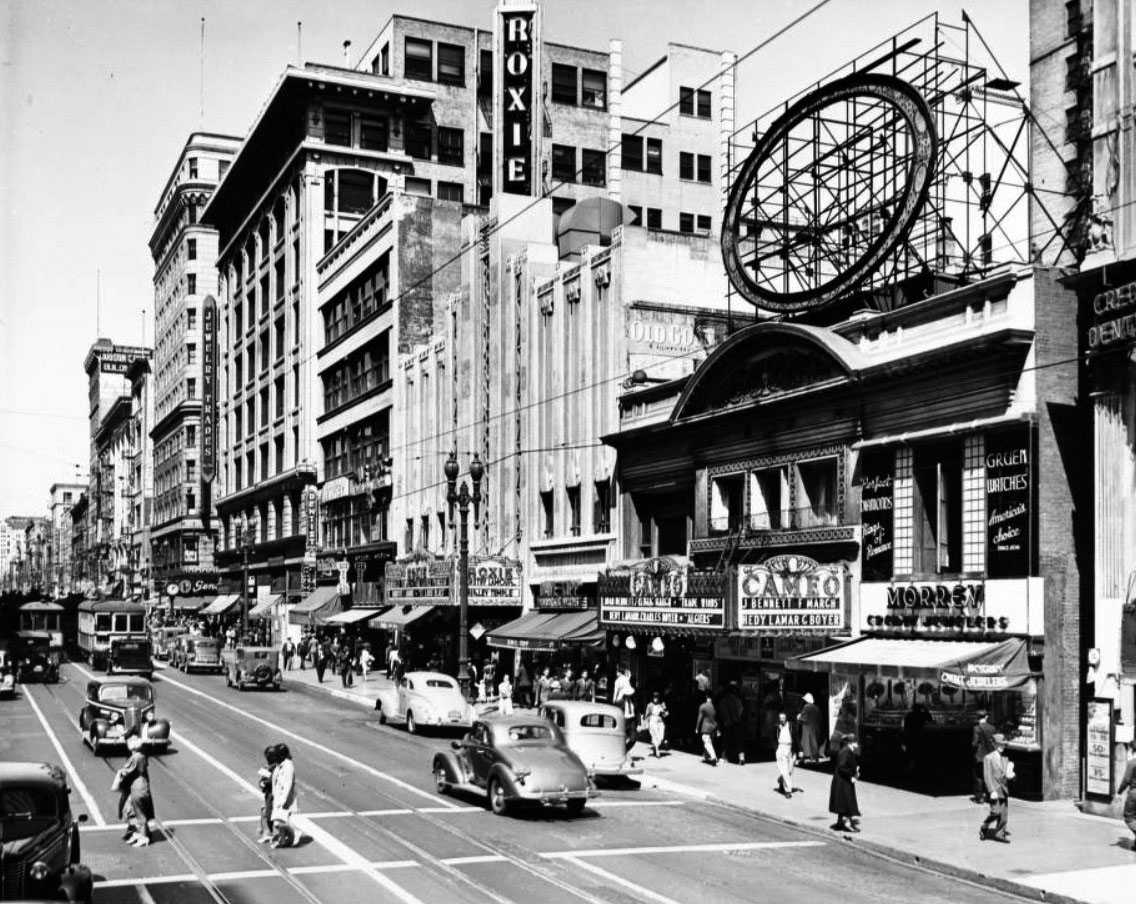 |
|
| (1939)^ – View looking north on Broadway with the Cameo Theatre (previously Clune’s Broadway Theatre) seen on the right. Further north is the Roxie Theatre which was built in 1931 on the same site as Quinn's Superba Theatre. |
Historical Notes In 1925 until 1926 Clune’s Broadway Theatre was operated by Universal Pictures chain and renamed Cameo Theatre. The Clune’s Broadway Theatre's original roof-top electric sign and ‘digital’ clock were Downtown landmarks for many years. In 1921 the theatre was equipped with a Wurlitzer organ Style 185, Opus 397. In the late-1920’s it was operated by H.L. Gumbiner (who soon was to build the Tower Theatre and Los Angeles Theatre further along South Broadway) who replaced the sign and clock with a large 24-sheet billboard. ++^ |
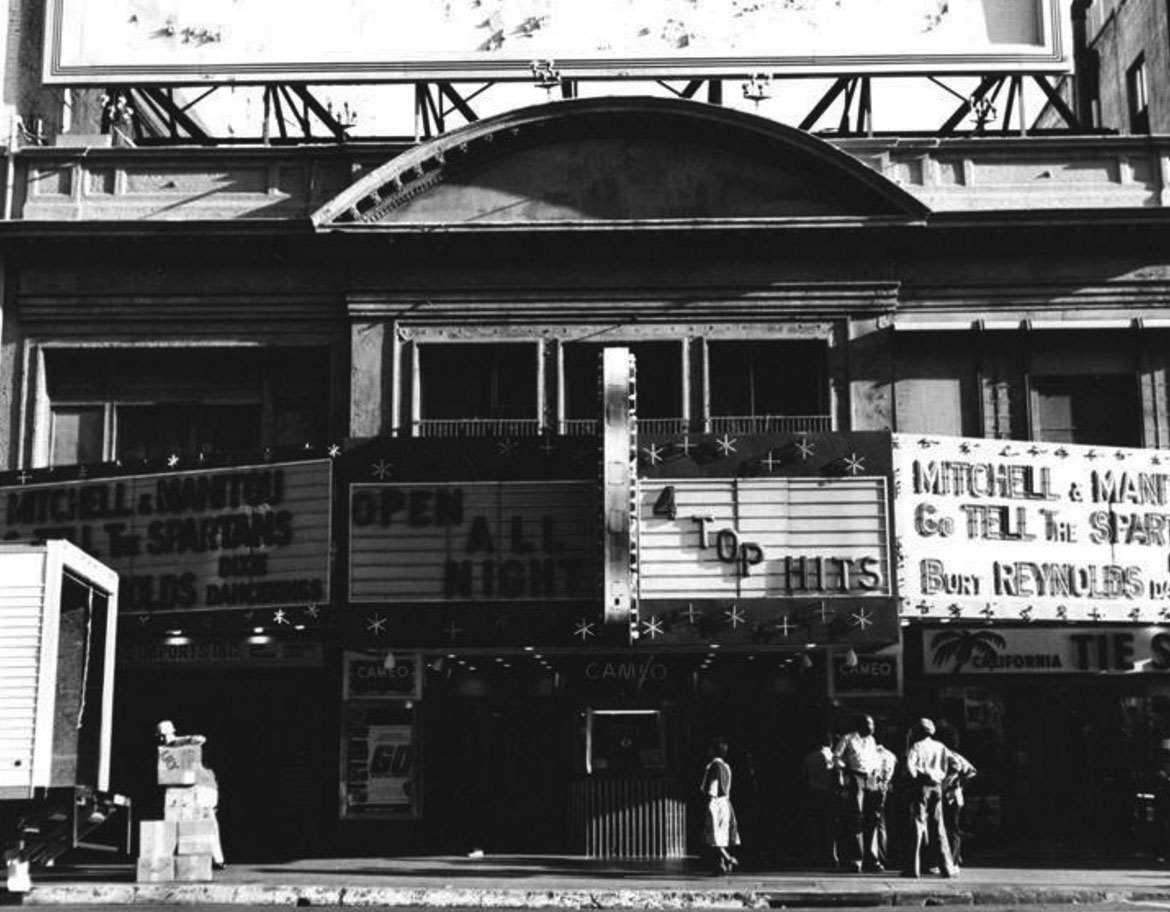 |
|
| (1978)^*# - View showing the front of the Cameo Theatre, now open all night, at 528 S. Broadway. Photo by Tom Zimmerman. Click HERE to see contemporary view. |
Historical Notes Minor alterations were carried out by architect Simeon Charles Lee in 1949. In 1987 it was repainted and redecorated by the then owners Metropolitan Theatres. In its later years it was screening Kung-Fu and exploitation films and was closed in 1992. It was the longest continually operating movie theatre in California at that time. The front entrance has been converted into retail use, while the auditorium is used for storage. ^^^* In 1991, the Cameo Theatre (formerly the Clune's Broadway Theatre) was designated LA Historic-Cultural Monument No. 524. Click HERE to see complete listing. |
* * * * * |
Paramount-Famous-Lasky Corporation West Coast Studios
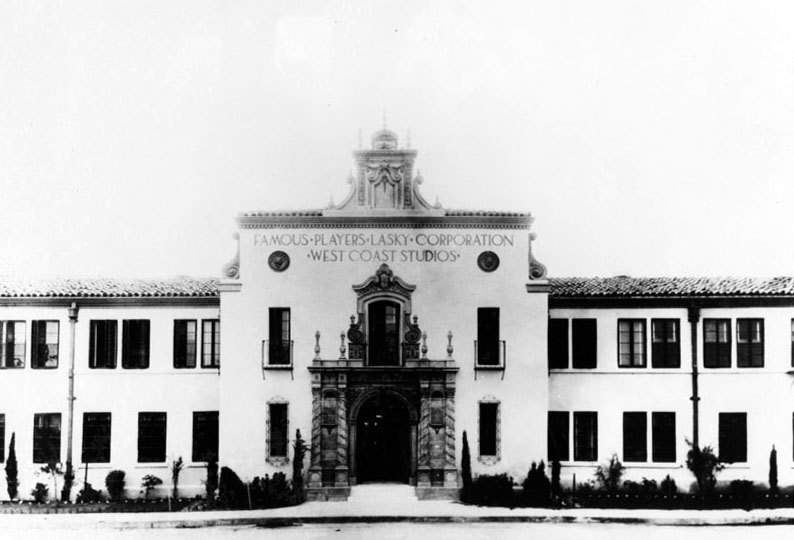 |
|
| (ca. 1916)* - Entrance to the Famous Players-Lasky Corporation West Coast Studios located at 5555 Melrose Avenue before Paramount was added. |
Historical Notes Paramount Pictures dates its existence from the 1912 founding date of the Famous Players Film Company. Founder Hungarian-born Adolph Zukor, who had been an early investor in nickelodeons, saw that movies appealed mainly to working-class immigrants. With partners Daniel Frohman and Charles Frohman he planned to offer feature-length films that would appeal to the middle class by featuring the leading theatrical players of the time (leading to the slogan "Famous Players in Famous Plays". By mid-1913, Famous Players had completed five films, and Zukor was on his way to success. In 1916, Zukor maneuvered a three-way merger of his Famous Players, the Lasky Company, and Paramount. The new company Lasky and Zukor founded, Famous Players-Lasky Corporation, grew quickly, with Lasky and his partners Goldwyn and DeMille running the production side, Hiram Abrams in charge of distribution, and Zukor making great plans. Famous Players-Lasky and its "Paramount Pictures" soon dominated the business.^* |
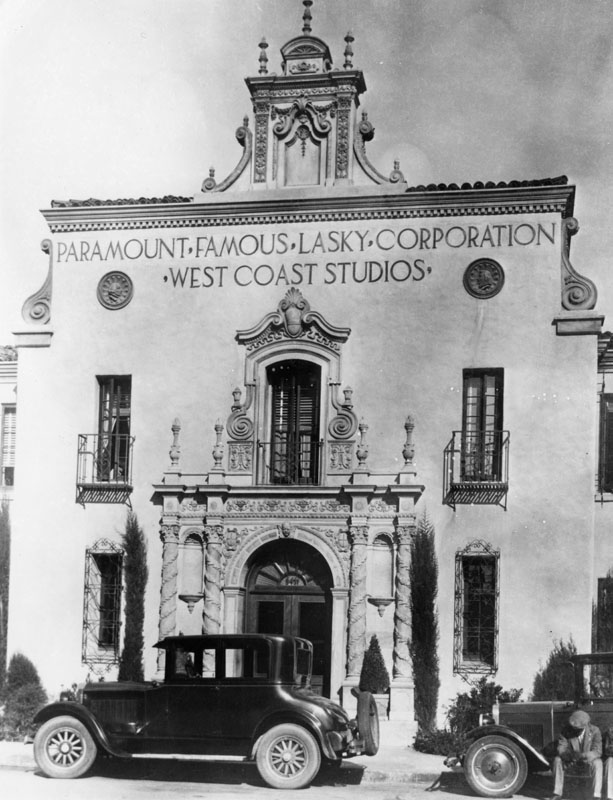 |
|
| (ca. 1930s)* - View of the Paramount-Famous-Lasky Corporation West Coast Studios building. |
Historical Notes Zukor signed and developed many of the leading early stars, including Mary Pickford, Marguerite Clark, Pauline Frederick, Douglas Fairbanks, Gloria Swanson, Rudolph Valentino, and Wallace Reid. With so many important players, Paramount was able to introduce "block booking", which meant that an exhibitor who wanted a particular star's films had to buy a year's worth of other Paramount productions. It was this system that gave Paramount a leading position in the 1920s and 1930s, but which led the government to pursue it on antitrust grounds for more than twenty years.^* |
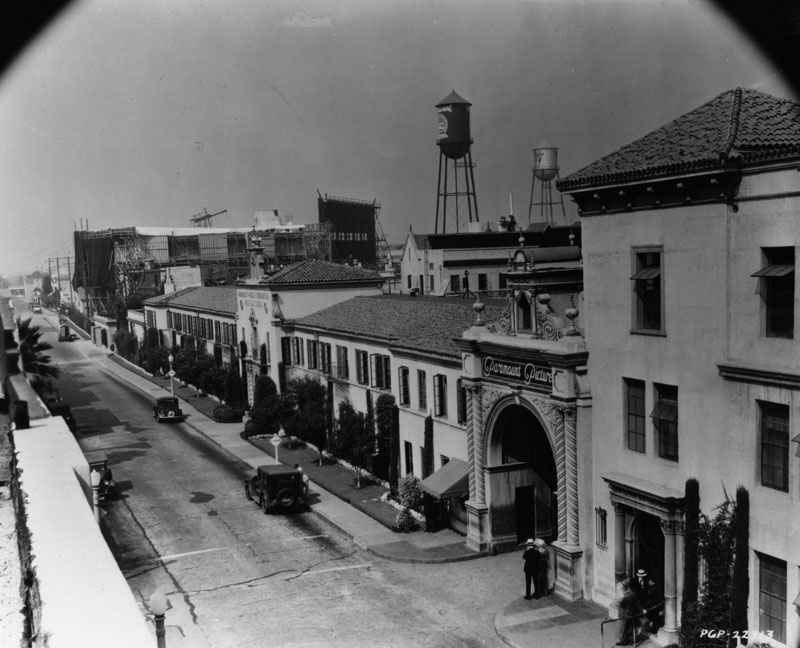 |
|
| (1936)* - View looking west on Melrose Avenue showing the Paramount Studios corporate office building at center-left and one of the entrance gates in the foreground. |
Historical Notes Paramount films emphasized stars; in the 1920s there were Swanson, Valentino, and Clara Bow. By the 1930s, talkies brought in a range of powerful new draws: Miriam Hopkins, Marlene Dietrich, Mae West, W.C. Fields, Jeanette MacDonald, Claudette Colbert, the Marx Brothers (whose first two films were shot at Paramount's Astoria, New York, studio), Dorothy Lamour, Carole Lombard, Bing Crosby, band leader Shep Fields, famous Argentine tango singer Carlos Gardel, and Gary Cooper among them. In this period Paramount can truly be described as a movie factory, turning out sixty to seventy pictures a year. In 1933, Mae West would also add greatly to Paramount's success with her suggestive movies She Done Him Wrong and I'm No Angel. However, the sex appeal West gave in these movies would also lead to the enforcement of the Production Code, as the newly formed organization the Catholic Legion of Decency threatened a boycott if it was not enforced.^* |
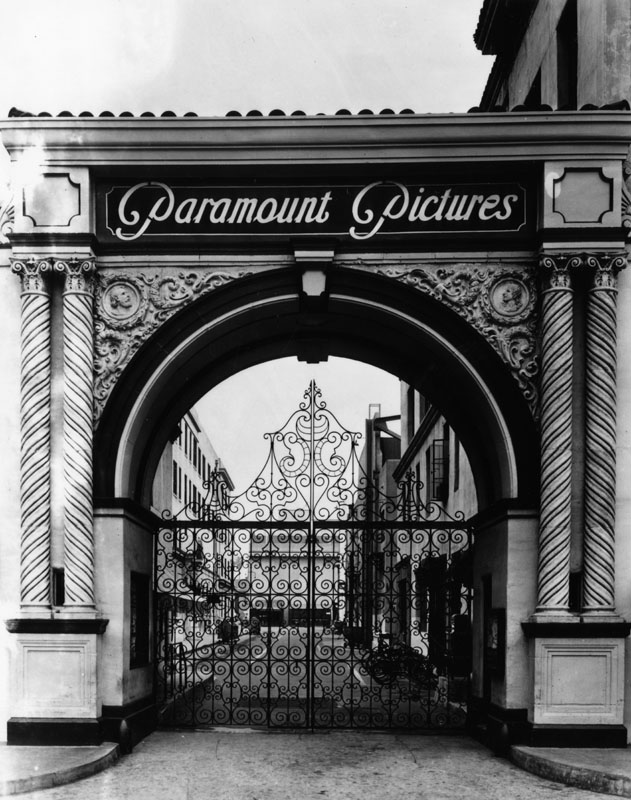 |
|
| (1957)* - View of the ornate entrance to Paramount Studios in Hollywood. |
Historical Notes Paramount is the fifth oldest surviving film studio in the world behind Universal Studios, Nordisk Film, Pathé, and Gaumont Film Company. It is the last major film studio still headquartered in Hollywood. |
* * * * * |
Merritt Building
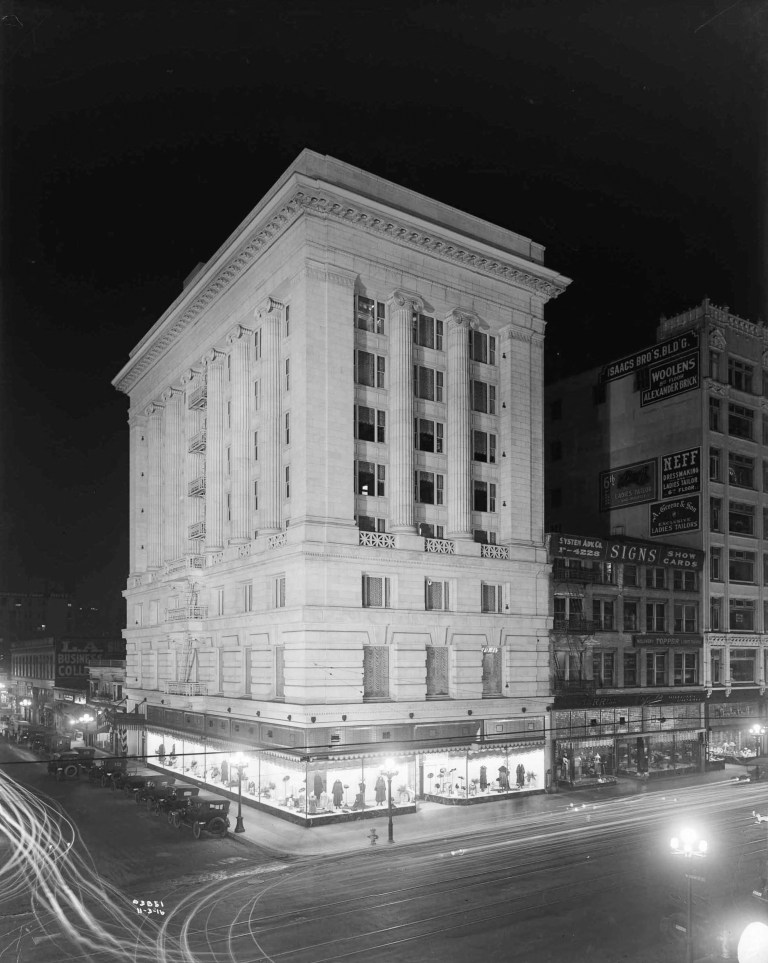 |
|
| (1916)* – View of the Merritt Building located at 8th and Broadway in downtown Los Angeles. |
Historical Notes Hulett C. Merritt, described by the Dec. 11, 1910 Los Angeles Herald as a "millionaire and financier" in an article about the planned Merritt Building in downtown Los Angeles. At the time, Merritt was pushing city leaders to waive building height restrictions from 180 feet to 233 feet. Merritt is reported as saying he would scrap plans for the Italian Renaissance-style monument to his family unless he was allowed the height variance, otherwise "its beauty will be marred and I want to build for the artistic value more than for any profit I may get out of it." Originally from Minnesota, Merritt had sold his interests in the Merritt - Rockefeller syndicate in 1891 for more than $81 million. When the Merritt Building opened in 1915 it looked quite nice. Merritt’s request to construct a 23-story edifice was turned down by the City Council. He scaled back his plans and ended up with a ten-story design that set a rendition of Minerva's Temple on top of a three-story base. |
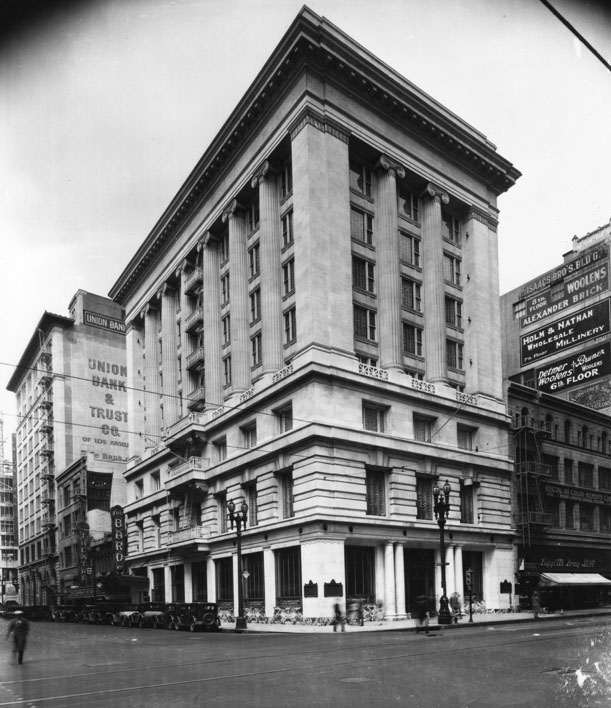 |
|
| (1931)* - View of the northwest corner of 8th Street and Broadway showing the Merritt Building. The Pan American Bank of California is housed in the building with the Union Bank & Trust Co. in the tall building to the left on 8th St. |
Historical Notes The Merritt Building housed various retail stores on its ground floor and offices above, with the top floor set aside for Mr. Merritt himself. |
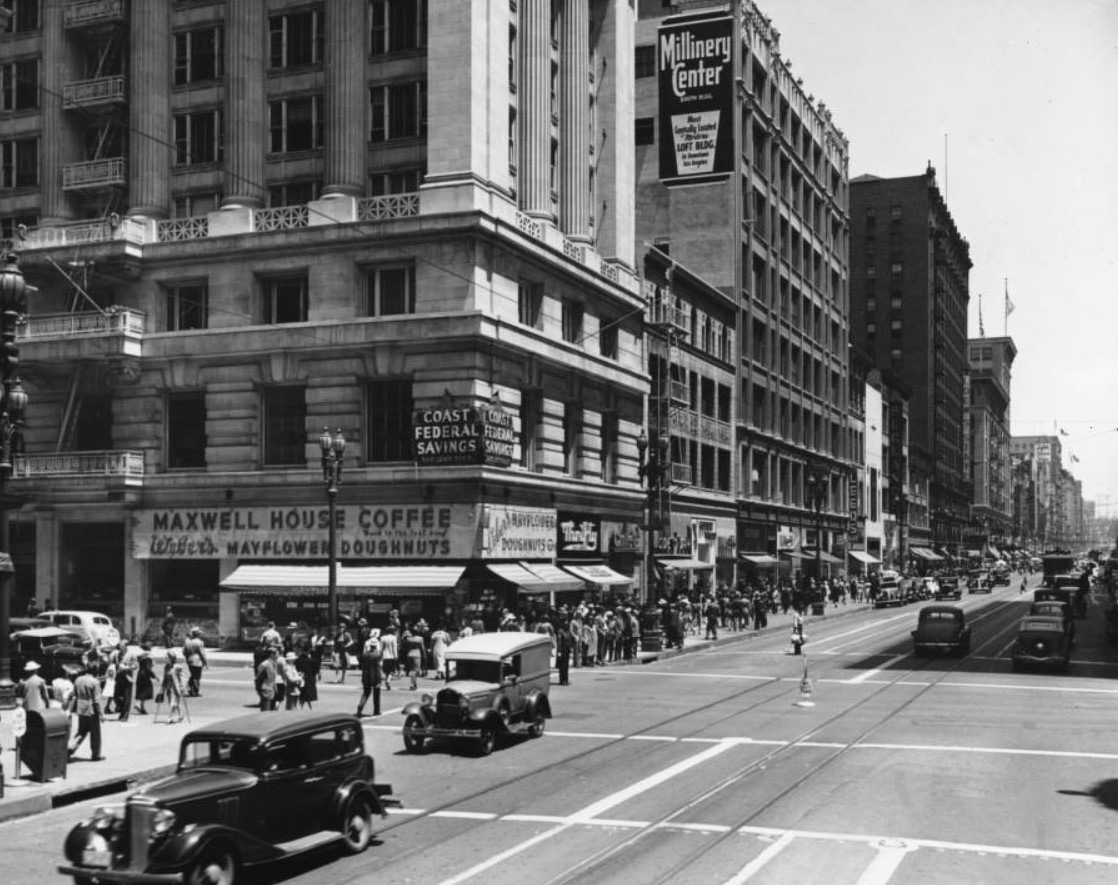 |
|
| (1939)* – View looking north on Broadway at 8th Street showing the Merritt Building on the NW Corner. On the ground floor can be seen Maxwell House Coffee with Mayflower Doughnuts and Thrifty. Sign on corner of building reads Coast Federal Savings. |
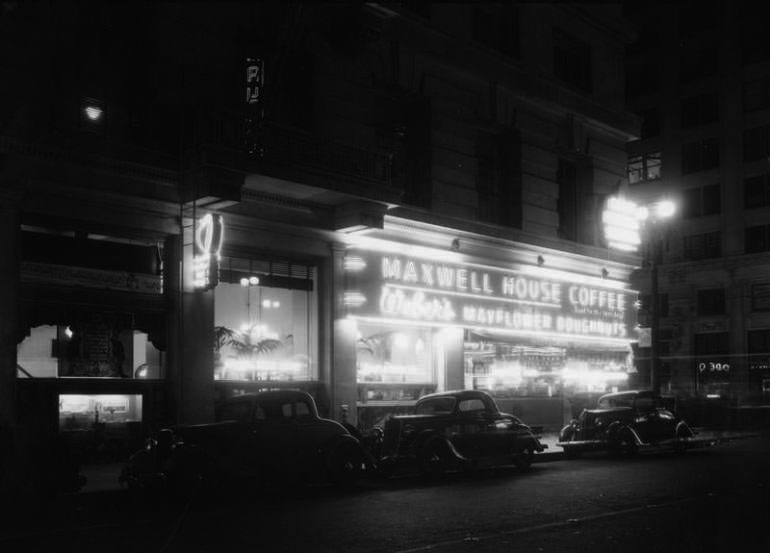 |
|
| (1930s)* – Night view showing cars parked in front of the Merritt Building. Store sign advertises Maxwell House Coffee. |
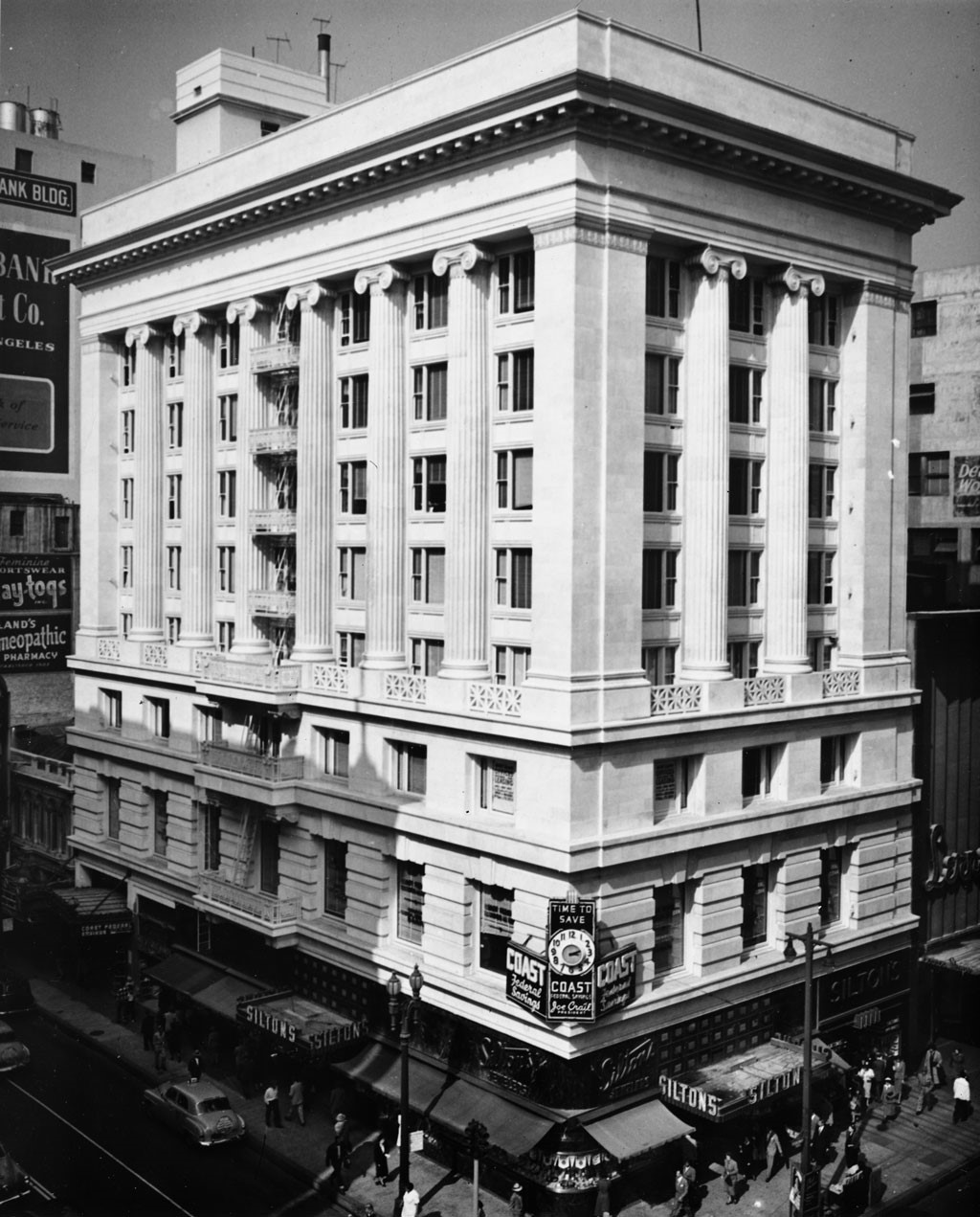 |
|
| (ca. 1957)^ – View of the Merritt Building which houses Siltons, located on the northwest corner of 8th Street and Broadway in downtown Los Angeles. The clock on the building reads "Time to save" an ad for Coast Federal Savings. On the left side of the photo, a couple of billboards can be seen on the next building, including an ad for the Burbank Company, and one for a homeopathic pharmacy. The building was later occupied by Home Savings and Loan Office. |
Historical Notes In 1957, the Merritt Building would see a change. Home Savings & Loan Association had bought the building in December of 1956 and had plans for a redesign. They took out many of the building's lower windows and created an ornate entrance on Broadway. The view above is the building before the change. The new look was designed by artist Millard Sheets, the man responsible for the look of many Home Savings branches over the years (later Washington Mutuals). |
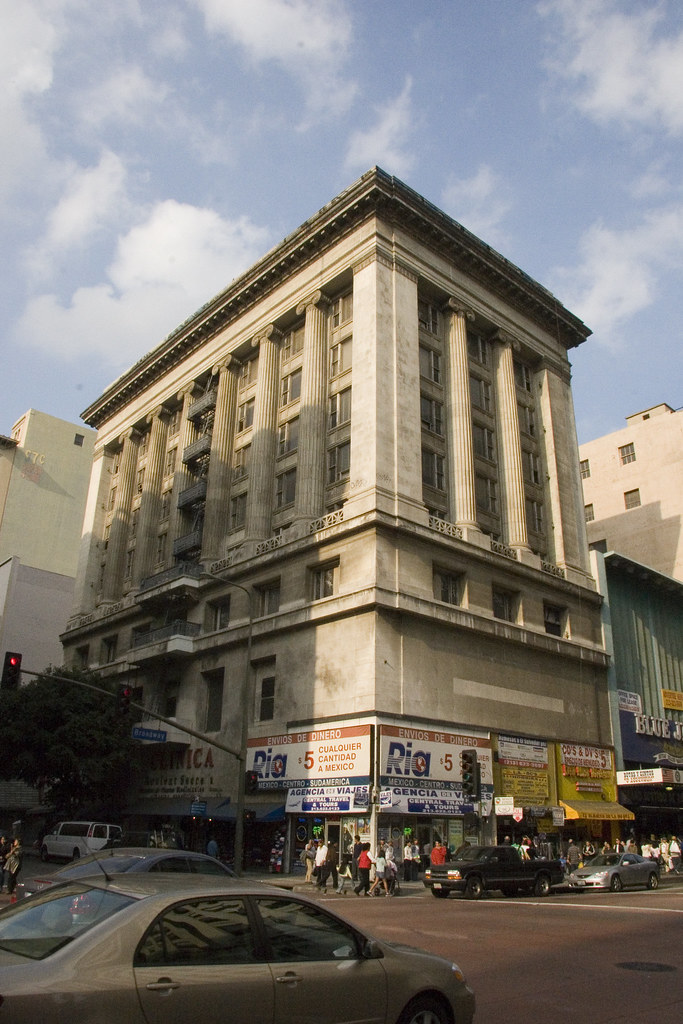 |
|
| (2006)* - View of the Merritt Building from ground level, located at 761 S. Broadway. |
Historical Notes After being purchased by Bonnis Properties in 2016 for $24 million, the building underwent a significant restoration that was completed in 2021. This renovation preserved its original architectural features, including the iconic Yule Marble facade and ionic columns, while transforming the upper levels into 40,000 square feet of modern office space and retaining 6,000 square feet for ground-floor retail. New amenities such as a rooftop deck, gym, and lounge were also added. The Merritt Building is recognized as a contributing property in the Broadway Theater and Commercial District, which is listed on the National Register of Historic Places, making it a notable landmark. |
* * * * * |
John's Pipe Shop
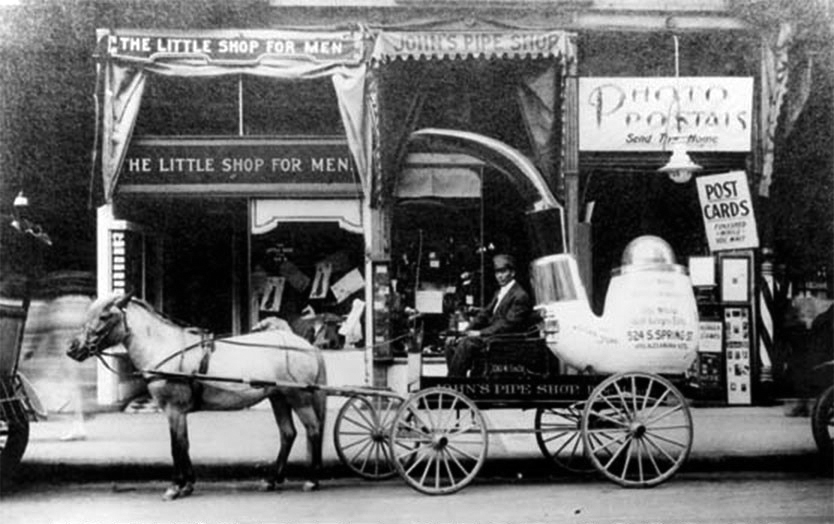 |
|
| (ca. 1916)* - View showing a man sitting on a horse-drawn carriage parked at the curb in front of John’s Pipe Shop at 524 S. Spring Street in the heart of downtown Los Angeles. In the back of the carriage is an oversized pipe with writing on its side advertising the shop. |
Historical Notes John’s Pipe Shop was open for decades, starting in 1908 and lasting well into the 1980’s. They had pipes made for them by European companies, one of which was Comoy’s. Their “Exclusive Brands” included Wilshire, Rosemore, Extra, Fairmont, Silvermont and Avalon. There were two shops, one at 524-524 1/2 S. Spring Street and the other at 6725 Hollywood Blvd. To further advertise his goods, “John” had a little cart in the shape of a meerschaum pipe, drawn by a diminutive pony, which paraded the streets of Los Angeles, frequently giving away samples of new tobacco, as well as cards containing the name and address of his shop. |
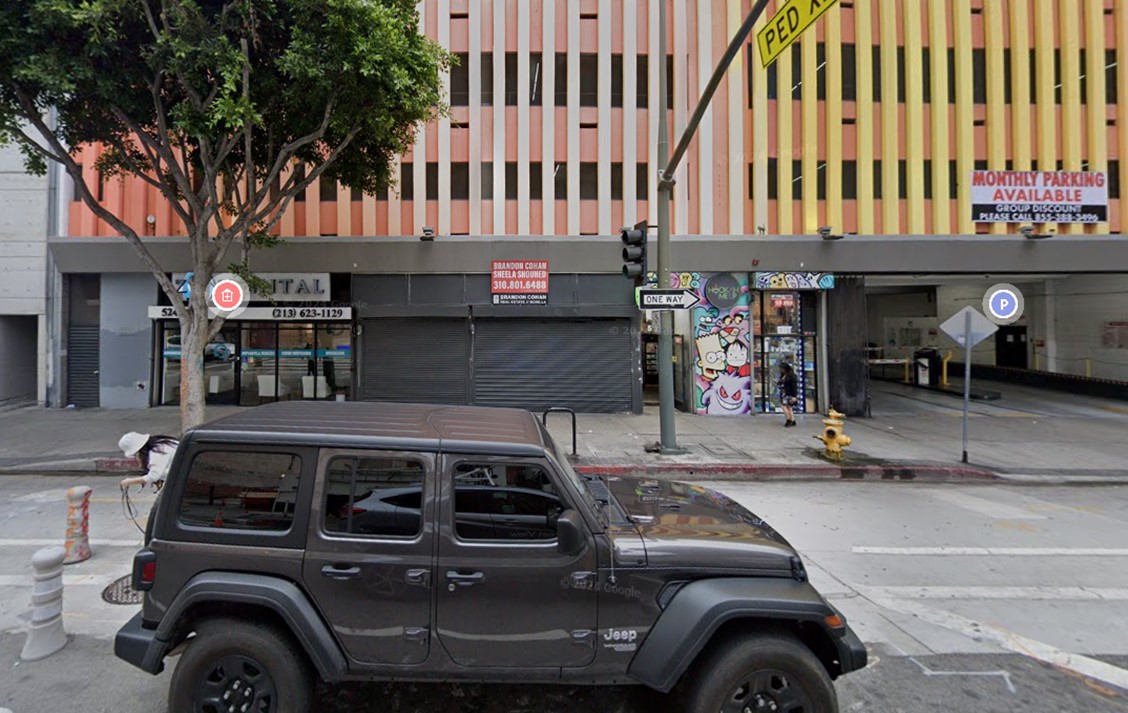 |
|
| (2024)* – Contemporary view of the building at 524 S. Spring Street, the former location of John’s Pipe Shop. |
Then and Now
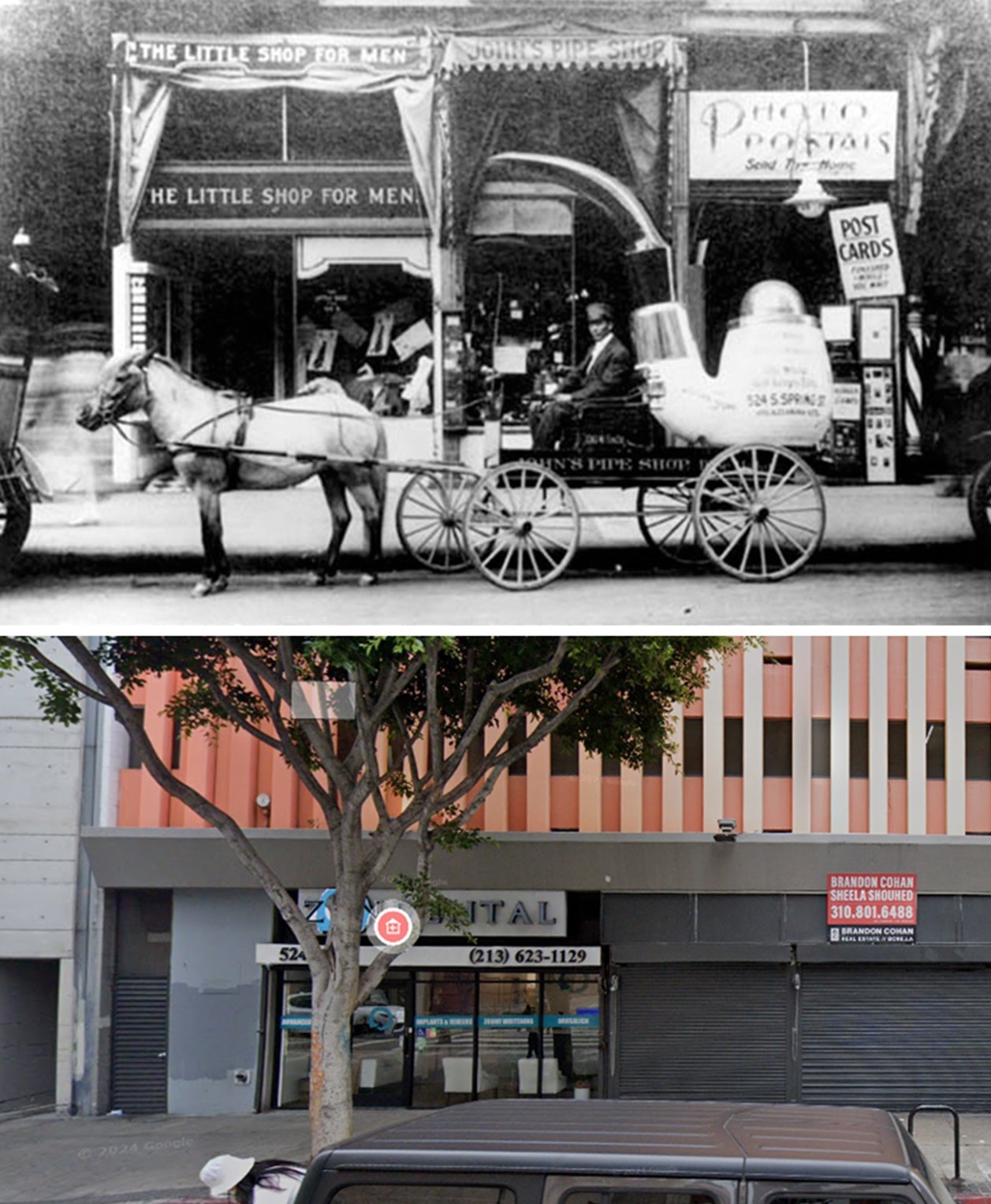 |
|
| (1916 / 2024)* – Then and Now view of John’s Pipe Shop at 524 S. Spring Street, now the location of Zen Dental Office. |
* * * * * |
S. Peluffo's Stores - New High and Ord Streets
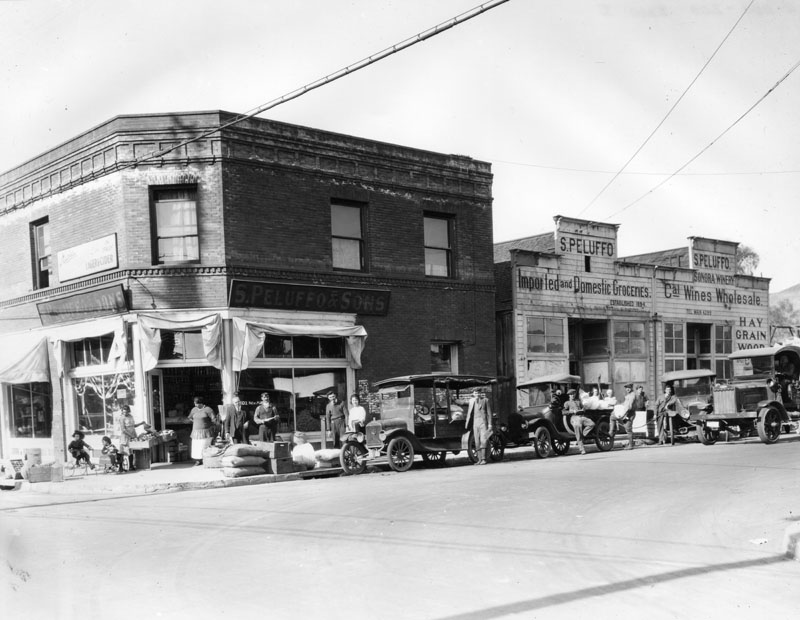 |
|
| (1917)* - View of the southeast corner of New High and Ord streets, showing the fronts of S. Peluffo's stores, founded in 1894. This is the location of a former Sonora Town brothel. |
Historical Notes One store is on the ground floor of a two-story, brick building. The other store, a one-story, wooden structure, is next door. The storefront advertises California wines as well as imported and domestic groceries. The store's telephone number is prominently displayed. Early automobiles, one a Peluffo delivery car, and a truck are parked in front and pedestrians, customers and drivers are all posing for the camera. Two children, one on a tricycle and the other in a toy car, are playing while a watchful adult shops. Sacks and cartons of merchandise lie at the curb. |
* * * * * |
Huntington Hotel (Pasadena)
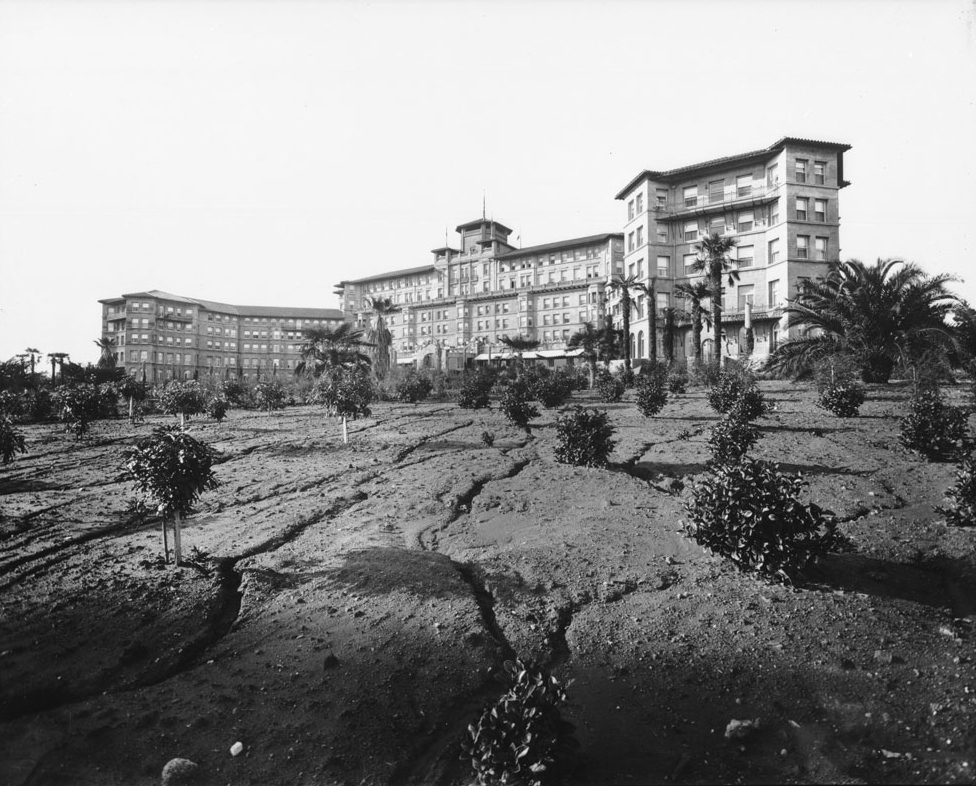 |
|
| (ca. 1917)**# - Exterior view of the rear of the Huntington Hotel in Pasadena, showing the newly landscaped gardens. |
Historical Notes The Huntington Hotel was built in 1906 by General Wentworth, a Civil War veteran, and designed by Charles Frederick Whittlesey in Spanish Mission Revival-style. It opened in February 1907 as the Hotel Wentworth, but closed its doors after its first season. It was purchased by Henry E. Huntington in 1911 and reopened in 1914 as The Huntington Hotel after redesign by the architect Myron Hunt. The hotel remained under Huntington's management until 1918.^* |
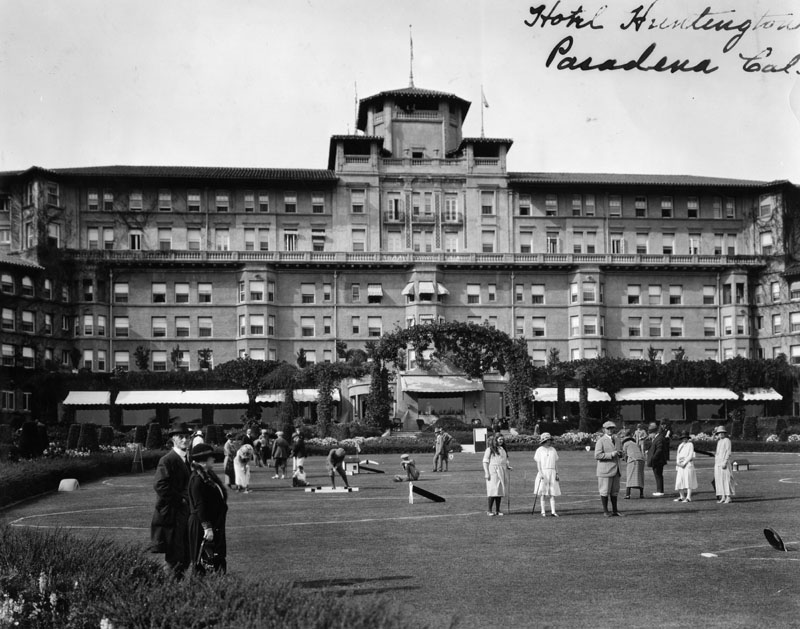 |
|
| (ca. 1920)* - Exterior view of the Huntington Hotel in Pasadena. Guests are playing on the famous obstacle golf course in front of the hotel. |
Historical Notes California's first outdoor Olympic-size swimming pool was added in 1926, when the hotel, formerly a winter resort, began opening year-round. The hotel was later owned by Stephen W. Royce, who sold it to the Sheraton Corporation in 1954. It was subsequently renamed The Huntington Sheraton.^* |
Click HERE to see more in Early Views of Pasadena |
* * * * * |
Hollywood Fire/Police Station
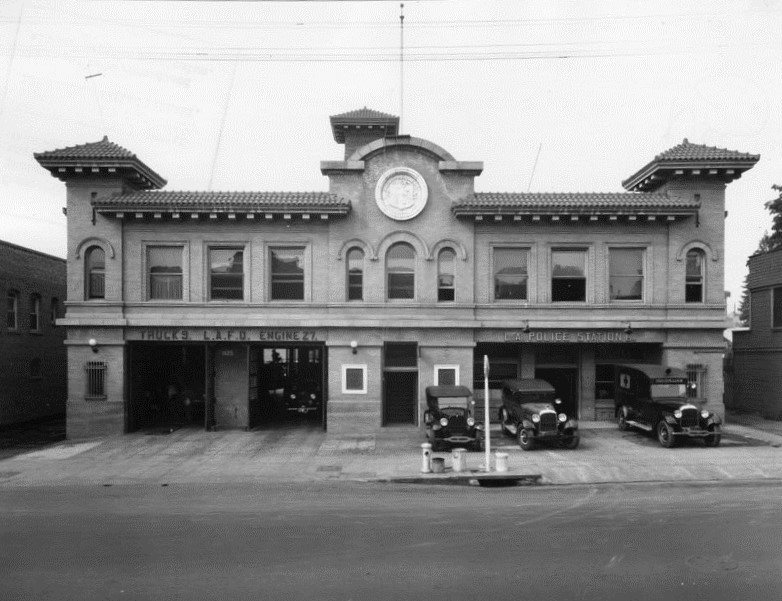 |
|
| (1916)* - Exterior view of the L.A.F.D. Fire Department, Engine 27, and the L.A. Police station, sharing the same building at 1629 Cahuenga Avenue in Hollywood. |
 |
|
| (1924)* - Police officers stand on the street outside of the Hollywood police station, Division 6, located at 1629 Cahuenga Avenue, just north of Selma Avenue. Neighboring businesses, a hotel (left) and a shoe shop (right), are also captured in the image. |
Click HERE to see more Early Views of Hollywood |
* * * * * |
Cahuenga Branch Library
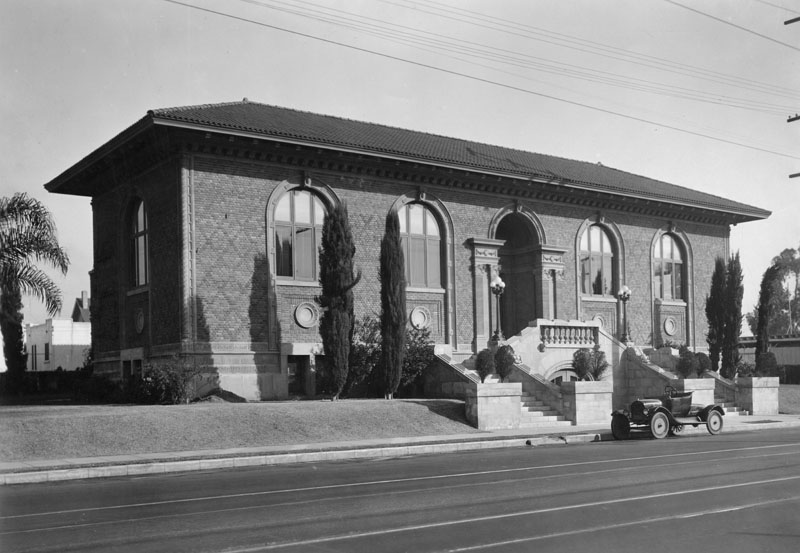 |
|
| (ca. 1916)* - Exterior view of Cahuenga Branch of the Los Angeles Public Library, located at 4591 Santa Monica Boulevard. It opened in 1916 and was intended, at the time, to serve a community of workers in the then nearby orange and avocado groves and wheat fields. |
Historical Notes Cahuenga Branch is the third oldest branch library in the Los Angeles Public Library system. Located at 4591 Santa Monica Boulevard in the East Hollywood section of Los Angeles, it was built in 1916 with a grant from Andrew Carnegie. Architect C.H. Russell designed this Italian Renaissance style building. He was also associated with Norman F. Marsh in building the Venice canals.^* One of three surviving Carnegie libraries in Los Angeles, it has been designated as Historic-Cultural Monument No. 314 and listed in the National Register of Historic Places. Click HERE to see the complete list of LA Historical Cultural Monuments. |
* * * * * |
Metro-Goldwyn-Mayer Studios
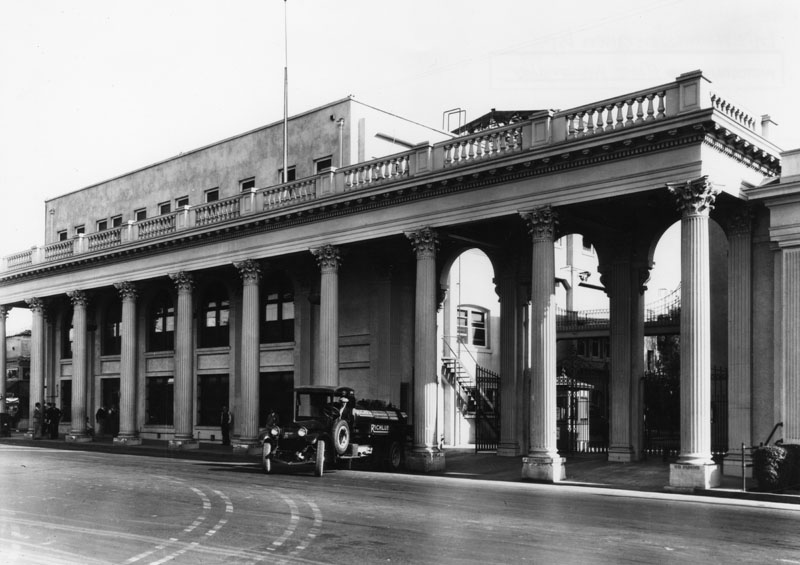 |
|
| (1916)* - Exterior view of the Triangle at Metro-Goldwyn-Mayer Studios, located at 10202 Washington Boulevard in Culver City. A Richfield gasoline truck is seen in front of the columned building. |
Historical Notes In 1924, movie theater magnate Marcus Loew had a problem. He had bought Metro Pictures Corporation (founded in 1916) and Goldwyn Pictures (founded in 1917) to provide a steady supply of films for his large theater chain, Loew's Theatres. However, these purchases created a need for someone to oversee his new Hollywood operations, since longtime assistant Nicholas Schenck was needed in New York to oversee the theaters. Loew addressed the situation by buying Louis B. Mayer Pictures on April 16, 1924. Because of his decade-long success as a producer, Mayer was made a vice-president of Loew's and head of studio operations in California, with Harry Rapf and Irving Thalberg as heads of production. For decades MGM was listed on movie title cards as "Controlled by Loew's, Inc."^* Click HERE to see more Early Views of Metro-Goldwyn-Mayer Studios. |
* * * * * |
Bureau of Power and Light Distribution Station
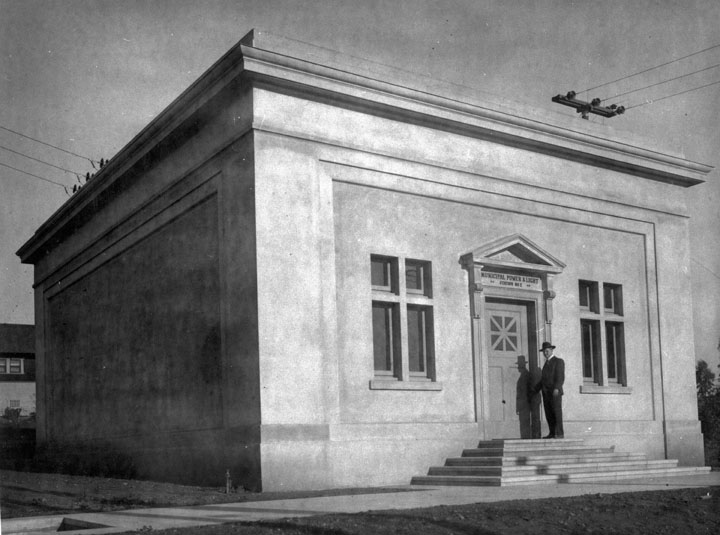 |
|
| (1916)** - LA Bureau of Power and Light (now DWP) Distribution Station No. 2 - Electric power was distributed to residents in the Highland Park-Garvanza areas of Los Angeles in 1916 from this Distributing Station located at 225 N. Avenue 61. |
Historical Notes In 1916, the first electrical energy sold and distributed by the Los Angeles Bureau of Power and Light was obtained from the Pasadena municipal system. Things would change quickly, though. In 1917, the San Francisquito Canyon Power Plant No. 1 was completed. It harnessed the energy from water running down the recently completed LA Aqueduct and generated enough power to meet the needs of the fast growing City of Los Angeles. There was also enough excess power that now could be sold back to the City of Pasadena (Click HERE to see more in Electricity on the Aqueduct). The first operator at Distribution Station No. 2 was B. F. Goodwin. |
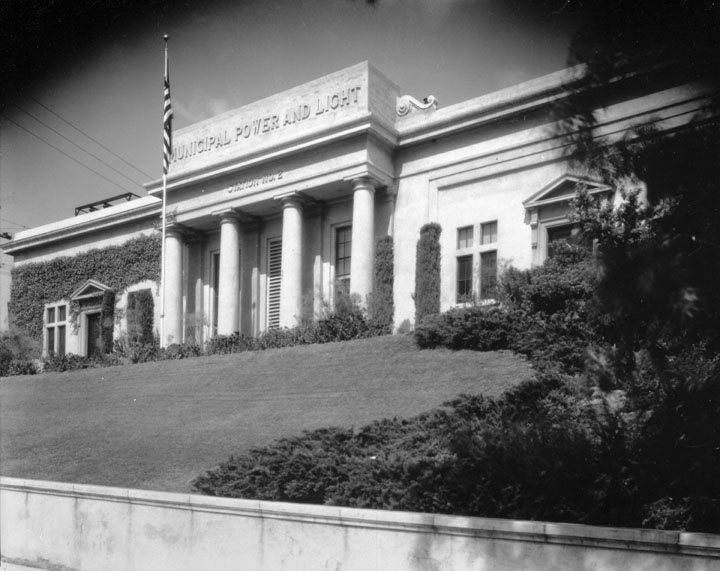 |
|
| (ca. 1920s)** - View of Distribution Station No. 2 after it was expanded. The sign on the front face of building now reads Municipal Power and Light. The Los Angeles Department of Water and Power went through six names changes since the Water Department was established in 1902. Click HERE to see Name Change Chronology of DWP. |
Historical Notes On April 21, 1962, Distribution Station No. 2 was designated Los Angeles Historical-Cultural Monument No. 558 (Click HERE to see complete listing). |
* * * * * |
San Francisquito Power Plant No. 1
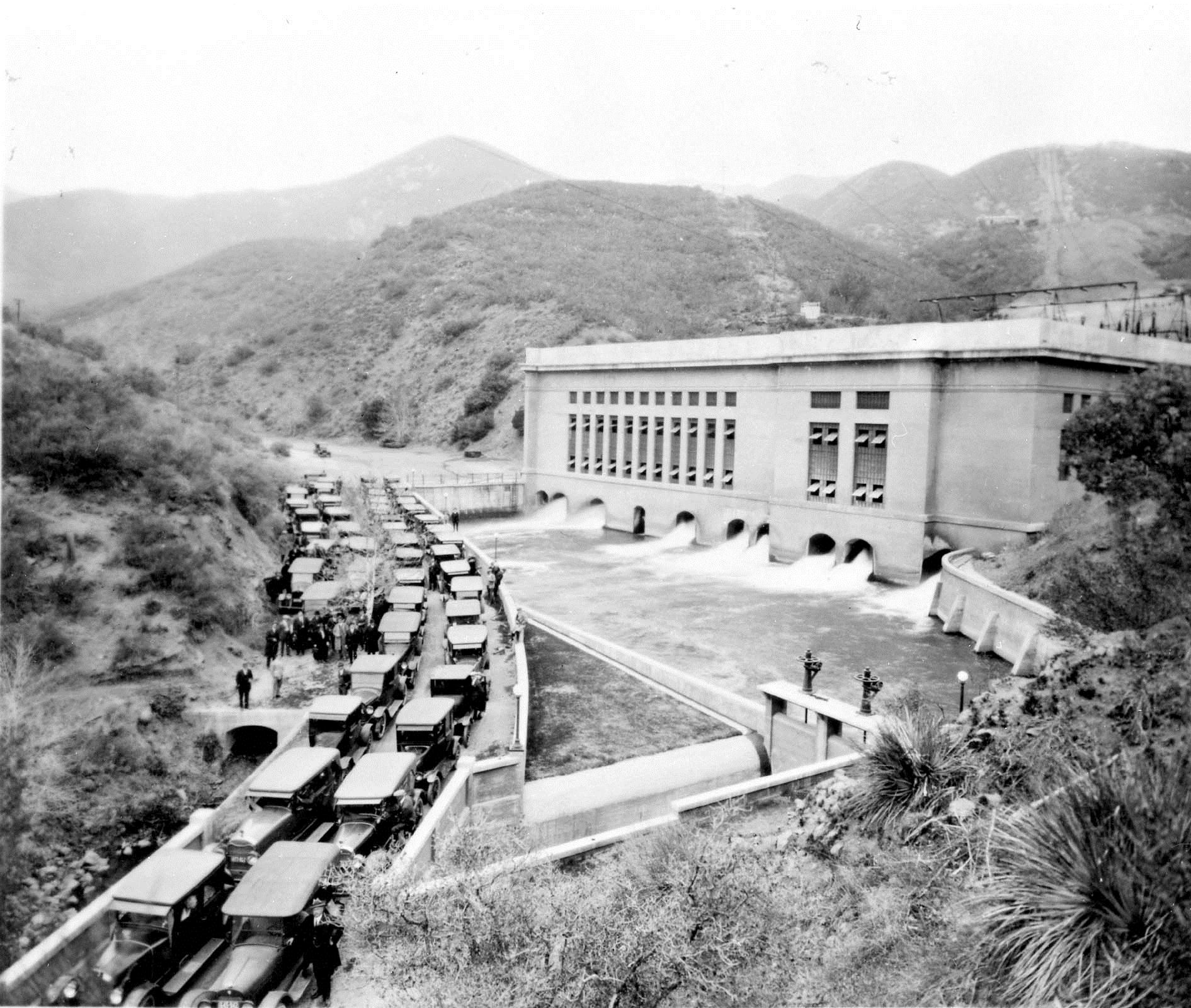 |
|
| (1917)** - Opening of the San Francisquito Power Plant No. 1 on March 18, 1917. Construction of the plant began six years earlier in 1911. |
Historical Notes On March 18, 1917 the San Francisquito Power Plant No. 1, Unit 1 was placed in service and energy was delivered to Los Angeles over a newly constructed 115 kV transmission line. The 200 kilowatts generated by Unit 1 were the first commercial kilowatts generated by the Los Angeles Bureau of Power and Light. The LA Bureau of Power and Light now had a source of low cost electricity and more than enough power to meet the City's needs. It would sell its excess San Francisquito generated power to Pasadena over two newly constructed 34 kV lines between the two cities. By 1917, World War I had forced the price of fuel oil to rise making the new lower cost hydroelectric power extremely desirable. |
Click HERE to see more in Early Power Generation |
* * * * * |
Church of the Open Door (Bible Institute - Biola University)
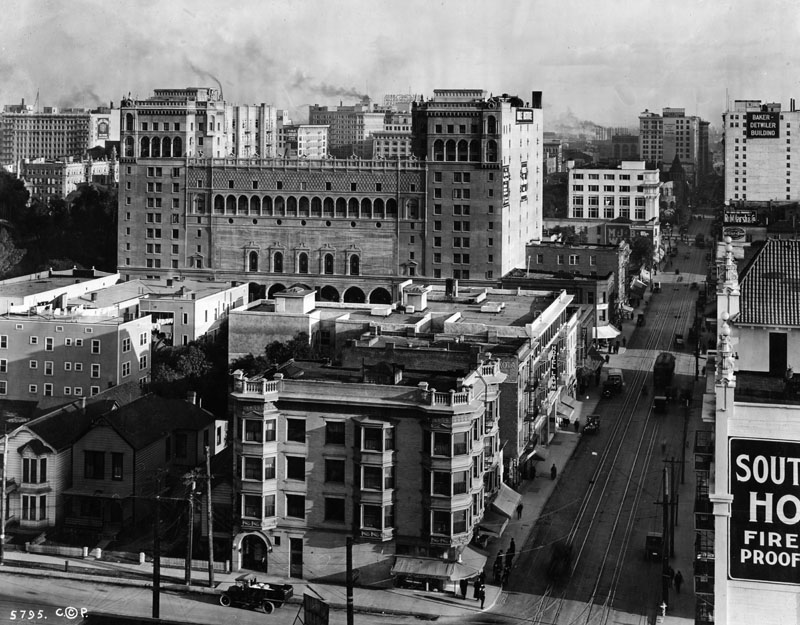 |
|
| (1916)* - View looking east along 6th Street from Flower Street. Large structure on Hope Street is the Church of the Open Door/Bible Institute. |
Historical Notes Biola University was founded in 1908 as the Bible Institute Of Los Angeles by Lyman Stewart, president of the Union Oil Company of California (subsequently known as Unocal and later purchased by the Chevron Corporation), Thomas C. Horton, a Presbyterian minister and Christian author, and Augustus B. Prichard, also a Presbyterian minister.^* In 1912, the school appointed R. A. Torrey as dean, and in 1913 began construction on a new building at the corner of Sixth and Hope St., in downtown Los Angeles, which included a 3,500-seat auditorium, two large neon signs on top of the building proclaiming "Jesus Saves", and a set of eleven bells on which hymns were played three times each day.^* |
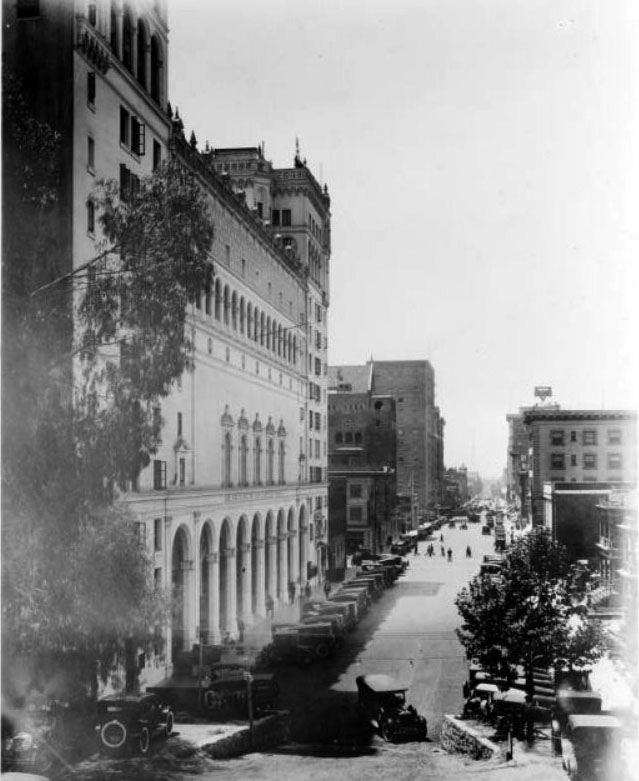 |
|
| (ca. 1920)^ - View of Hope Street looking south from the future site of the Los Angeles Central Library. The Church of the Open Door/Bible Institute is seen standing tall on the left. |
Historical Notes The Central Library was built between 1924 and 1926 on the site once occupied by the State Normal School (which evolved into UCLA). |
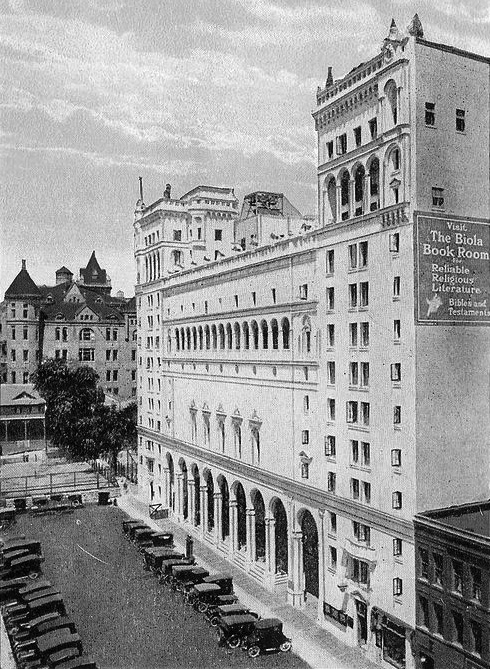 |
|
| (1924)##+ – Postcard view of the Bible Institute of Los Angeles looking north on Hope Street with the State Normal School (1831-1924) seen in the background. |
Historical Notes The State Normal School was demolished in 1924 to make room for the Los Angeles Central Library (completed in 1926). |
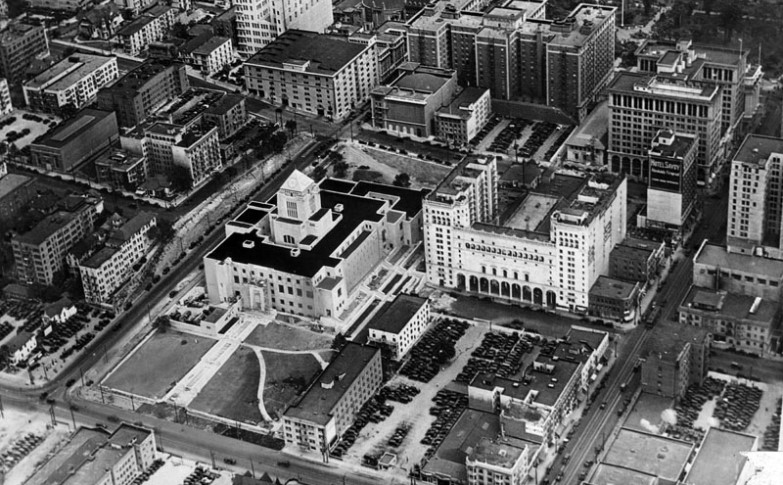 |
|
| (ca. 1926)* - Aerial view showing the area surrounding the newly completed Central Library. The Bible Institute stands at 555 S. Hope Street, adjacent to the library. |
Historical Notes Originaly financed by Union Oil magnate Lyman Stewart, the Bible Institute Church was to be strictly non-denominational, though Evangelical. Stewart also founded the Pacific Gospel Mission (now the Union Rescue Mission) in 1891.^* |
 |
|
| (1926)^ - Exterior view of the Bible Institute as seen from the front of the Central Library's South entrance. The light-colored building has two bookend towers and a row of archways across its center. The name of the institute appears over the entryway. |
Historical Notes The Bible Institute building was designed by Walker & Vawter in Renaissance Revival style and had an auditorium that seated 3,500. It was flanked by two thirteen-story dormitories. A large 1935 neon sign which says, "Jesus Saves," sits at the top of the building. The building was constructed in 1915 and demolished in the late 1980s after the church moved to Glendora (1985).* |
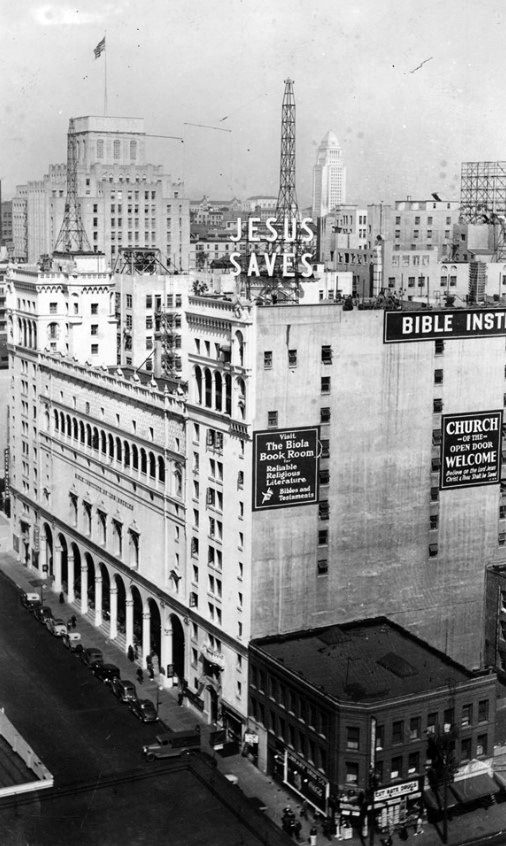 |
|
| (ca. 1939)^.^ - Bible Institute of Los Angeles (6th & Hope). Photo E.F. Mueller. |
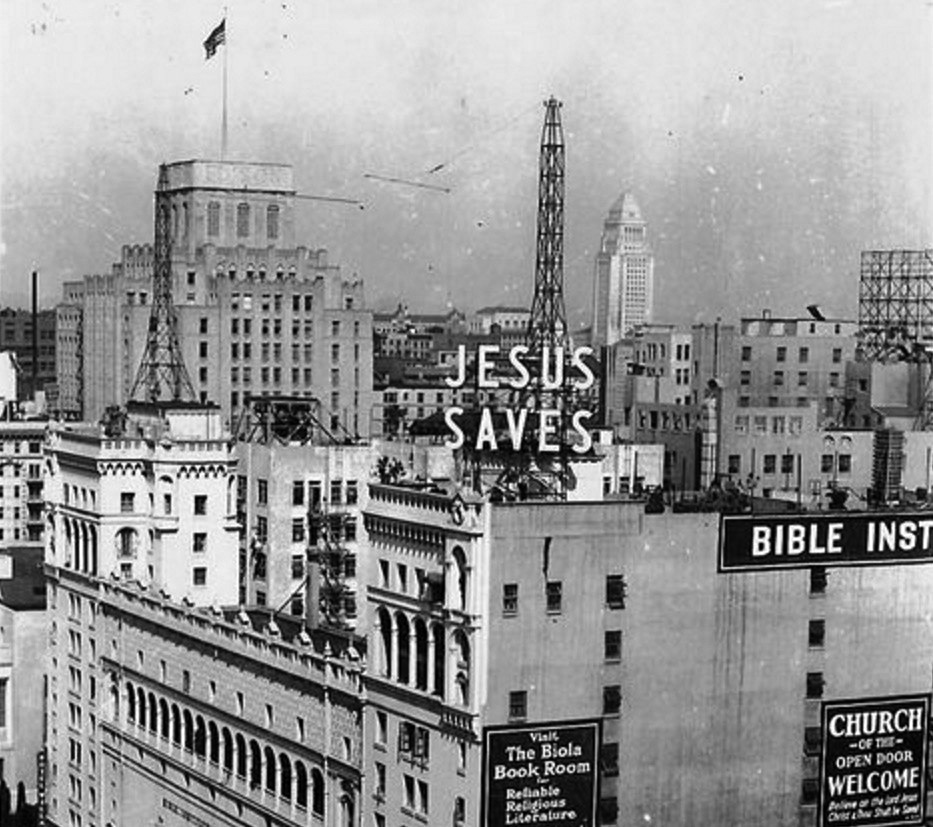 |
|
| (ca. 1939)##+ – Rooftop view looking northeast showing the Bible Institute from the corner of Hope and 6th streets. In the distance can be seen the Edison Building (top left) and City Hall (top center-right). Note the two radio towers on top of the Bible Institute building. |
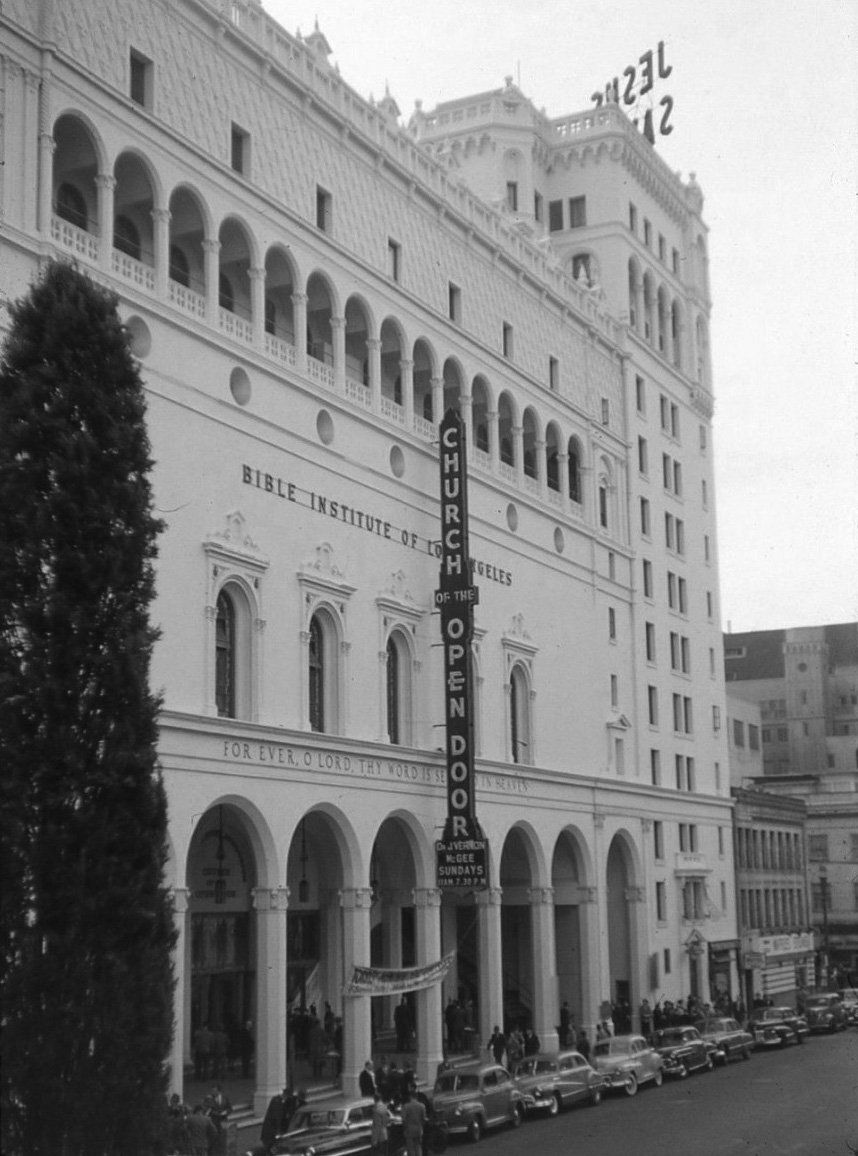 |
|
| (1950)**# - View looking southeast showing the front of the The Bible Institute of Los Angeles (Church of the Open Door) on Hope Street as seen from the Central Library . |
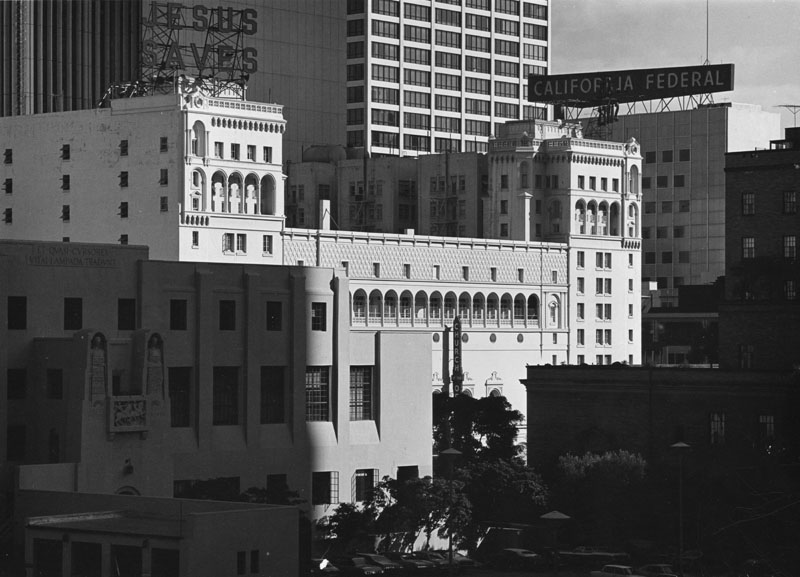 |
|
| (1980)* - Exterior view of Church of the Open Door (The Bible Institute), at 555 South Hope Street, with Central Library (West entrance) and parking area (presently the Maguire Gardens) in the foreground. |
Historical Notes Despite efforts led by the late William Eugene Scott to prevent the building from being sold to developers and to have the building saved as a historic landmark, the building could not be saved because it was so damaged in the 1987 Whittier Narrows earthquake that it was declared unsafe and the cost of repairs deemed prohibitive. The historic "Jesus Saves" sign from the original building can now be seen atop the Los Angeles University Cathedral. It was relocated there by the late William Eugene Scott, the owner of the building at the time of earthquake, who took it with him when his church relocated following the earthquake.^* |
* * * * * |
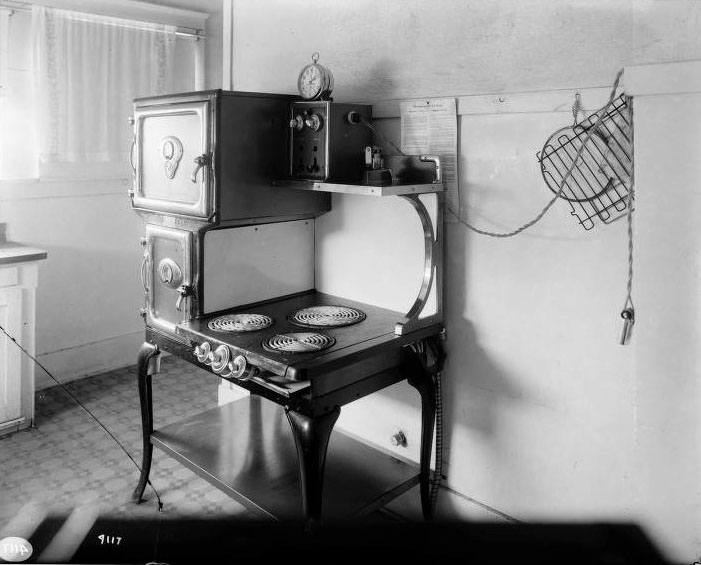 |
|
| (ca. 1917)*^*# - THE LATEST IN KITCHEN APPLIANCES. Westinghouse Electric range (with iron in upper corner and an electric timing device) at a home in Van Nuys.*^^^ |
Historical Notes In 1917, Westinghouse introduced its first all-electric kitchen range. It advertised its new ranges as follows: These are full size cooking ranges for domestic use, and have reached their high perfection in convenience and economy through many years of experimenting and experience. In addition to the cleanliness, safety, saving in food, and general desirability of cooking with electricity, they have the further advantage of saving a great deal of care, trouble and expense by the aid of the Westinghouse exclusive economical features of full automatic control by attached clock and thermostats.*#*^ |
* * * * * |
Breed Street Shul
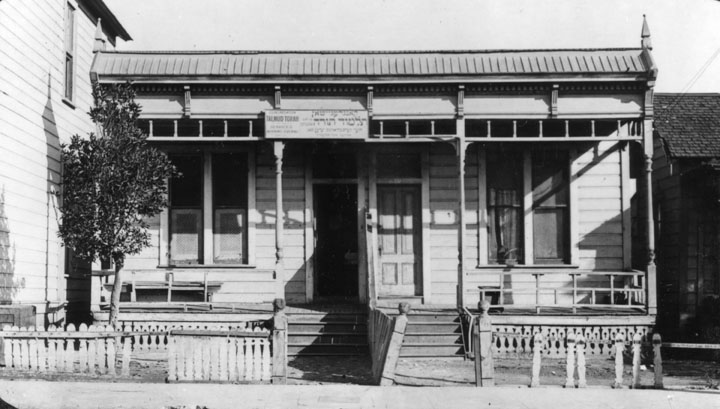 |
|
| (1917)* - Talmud Torah Synagogue was located in a smaller wooden building about the size of a single story apartment house at 114 Rose Street in Boyle Heights. |
Historical Notes Congregation Talmud Torah Synagogue (also known as Breed Street Shul) is in the Boyle Heights section of Los Angeles. It was the largest Orthodox synagogue in the western United States from 1915 to 1951, and is listed in the National Register of Historic Places. The Congregation began in Downtown Los Angeles in 1904 but moved to Boyle Heights in 1913 as large numbers of Jews settled there. In 1915, a wood-framed building was dedicated for use as a school and chapel and became known as the "Breed Street Shul." The Jewish population grew from a few hundred in 1910 to 10,000 in 1930.^ |
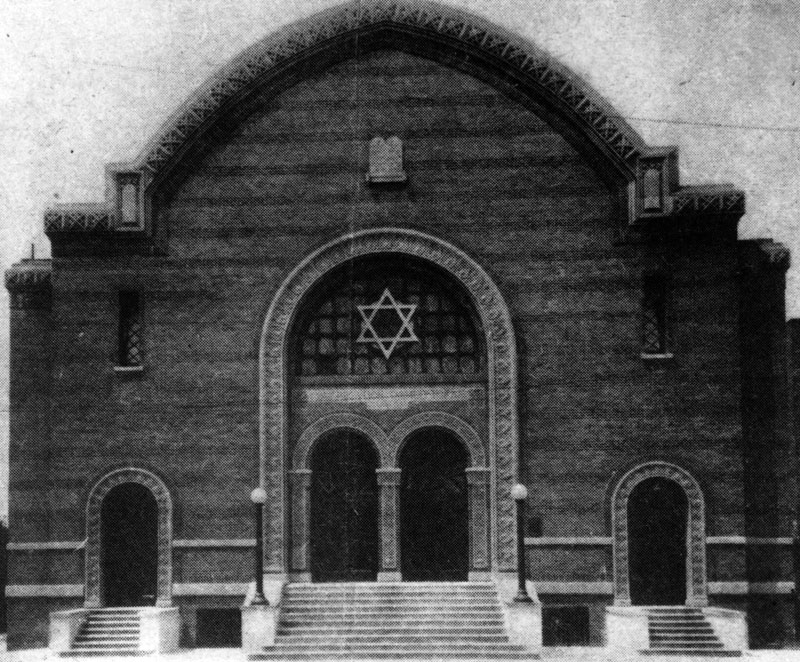 |
|
| (ca. 1920s)* - Exterior view shows the entrance of the Talmud Torah Synagogue, located at 247 N. Breed St. in Boyle Heights. |
Historical Notes As the size of the Talmud Torah congregation grew, a new synagogue was built, designed by the architectural firm of Edelman and Barnett. The original wood structure was moved to the back of the lot to make room for the new brick structure which opened in 1923. The new synagogue was built from unreinforced masonry with veneer brick and cast stone embellishments on the facade. The facade includes alternating bands of dichromatic brickwork, "dense prickly foliage carving, other organic motifs and Stars of David in bas relief cast stone detail.^ |
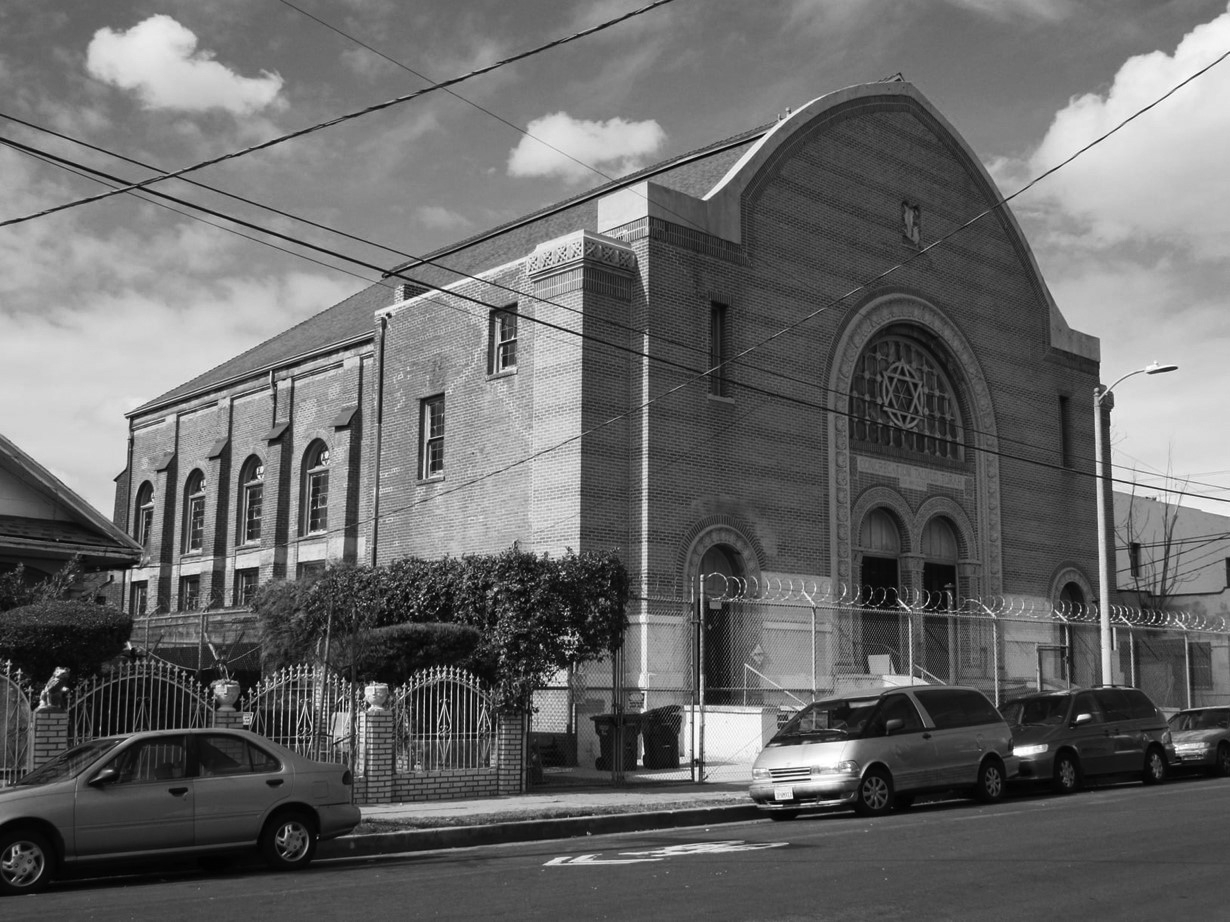 |
|
| (2021)* - Breed Street Shul as it appears today, with barbed-wird fence surrounding it. |
Historical Notes The main brick building was vacated in the mid-1980s due to seismic retrofit requirements. Services were moved to the original wooden structure at the rear of the lot for several years, by 1996 services ceased at Breed Street Shul, and the buildings have been vacant since that time In 1988, the building was designated as Los Angeles Historic-Cultural Monument No. 359 (Click HERE to see complete listing). The building fell into disrepair in the 1990s, the City of Los Angeles foreclosed on the property after recording an assessment for barricading and protection. In 1998, Hillary Clinton visited the Shul as part of her Save America's Treasures campaign. In July 2000, the City quitclaimed the property to Breed Street Shul Project, Inc., a subsidiary of the Jewish Historical Society of Southern California. The organization plans to rehabilitate the buildings as a county museum, educational and cultural center. It was listed on the National Register of Historic Places in 2001..^ |
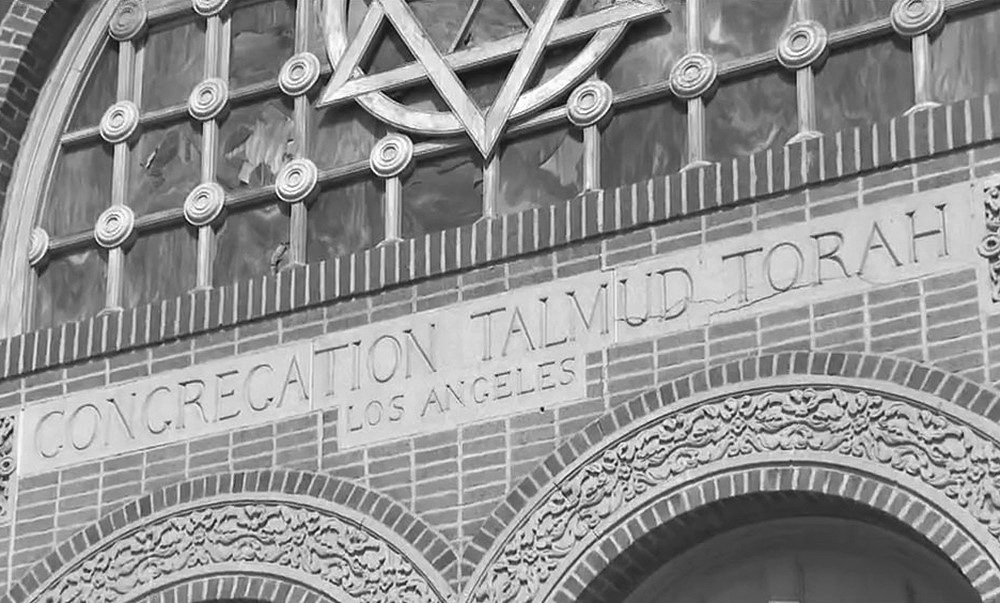 |
|
| (2021)* - Detailed view of the facade over main entrance of the Talmud Torah Synagogue, located at 247 N. Breed St. in Boyle Heights. |
Historical Notes The century-old Breed Street Shul in Boyle Heights is getting a new lease on life thanks to millions in dollars championed by California’s Jewish and Latino lawmakers to renovate the historic landmark. Nearly $15 million in state funding was announced on August 10th, 2021 to transform the historic, cultural monument into a multipurpose space and highlight the rich and diverse immigrant history of the Latino and Jewish communities in the Boyle Heights neighborhood.* |
* * * * * |
Ville de Paris Department Store (later B.H. Dyas Co.)
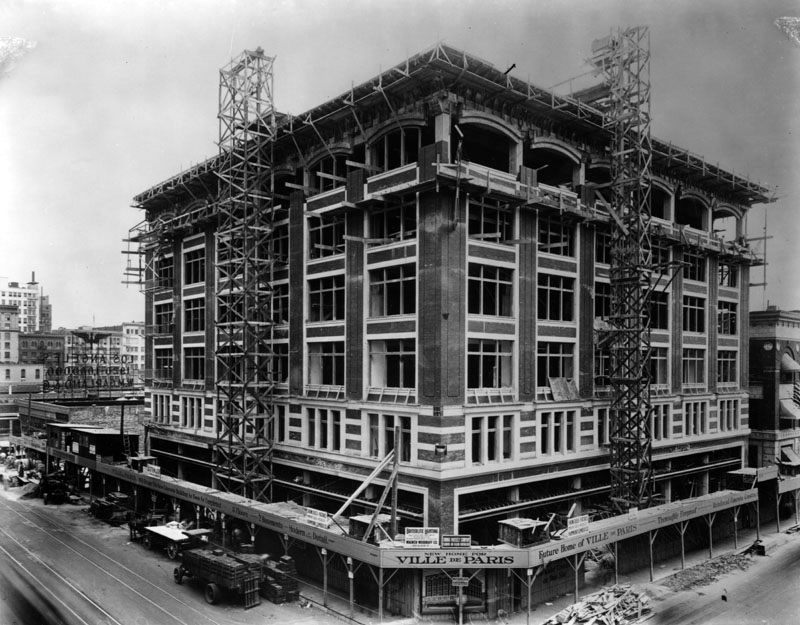 |
|
| (1917)* - Construction of the Ville de Paris department store at the corner of 7th and Olive. The store later became B. H. Dyas Co. |
Historical Notes Bernal H. Dyas was born in New York in 1883 and his family wound up in Los Angeles in 1907. In 1919 he purchased Los Angeles’s largest department store, Ville de Paris, at Seventh and Olive Streets and it became the home of the B. H. Dyas Company with 21,000 square feet of floor space.*#** |
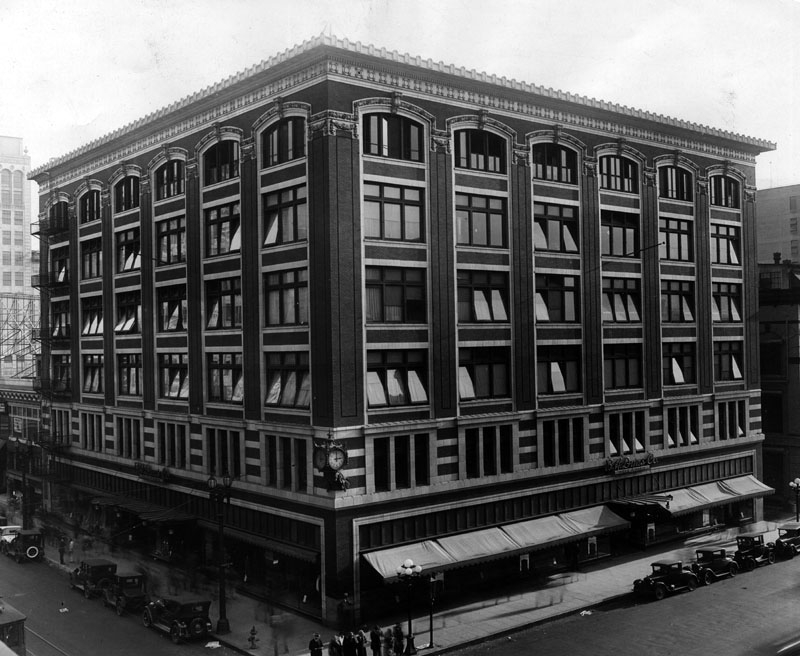 |
|
| (1931)* - Exterior of B. H. Dyas Co. store at Seventh and Olive streets, the second and fifth floors of which have been remodeled. |
Historical Notes The Seventh and Olive street store, referred to as a “sportsman’s paradise” included a rifle range, handball court, and log cabins. At the time, B. H. Dyas Company was the largest west of Chicago. In 1928, Dyas opened a second store in Hollywood, however, the company could not survive the effects of the Depression.*#** |
* * * * * |
Rosslyn Hotel
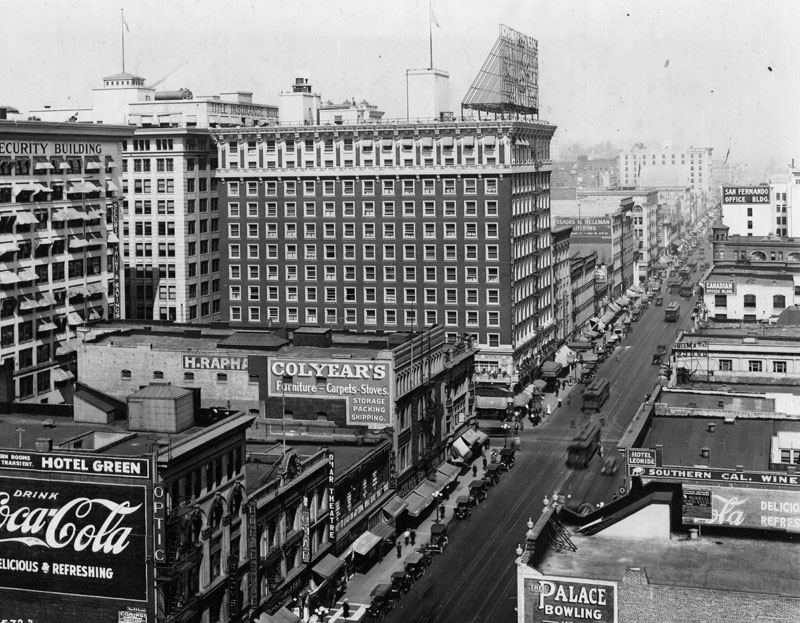 |
|
| (1917)* - View looking north on Main Street near 6th Street. The Rosslyn Hotel with the large sign on roof is on the northwest corner of Fifth and Main Streets (451-459 South Main Street). |
Historical Notes In 1913 the Rosslyn Hotel constructed its new building at the northwest corner of 5th and Main Streets, a major expansion of the hotel from its earlier home on Main Street between 4th and 5th Streets. The Hotel Rosslyn has a history unique in all of the city of Los Angeles. Once the tallest building in LA, the 12-story Rosslyn boasted in it's large rooftop sign as being the "Fireproof Million Dollar Hotel." At that time, the area around Main Street was truly the center of Los Angeles. Through the teens and twenties, the financial, commercial, and entertainment center of Southern California was based in Downtown Los Angeles, and the Rosslyn Hotel was one of its premier destinations.**## |
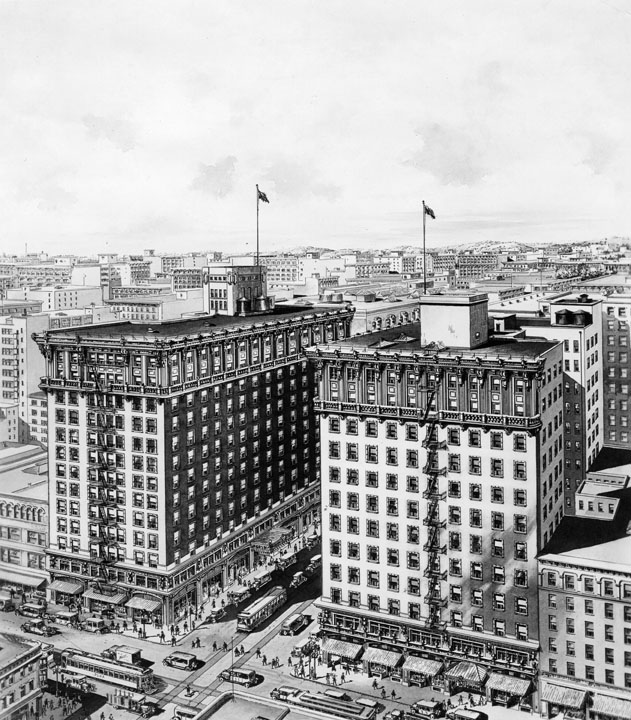 |
|
| (ca 1923)* - Rendering as seen from the air of the Rosslyn Hotel and Annex, also showing neighboring buildings. |
Historical Notes In 1923, as a result of the prosperity enjoyed by the Rosslyn and the surrounding district, the Rosslyn Annex was built across 5th Street, and today is still called the Rosslyn Hotel. The two buildings were connected by an underground marble tunnel, portions of which survive to this day.**## |
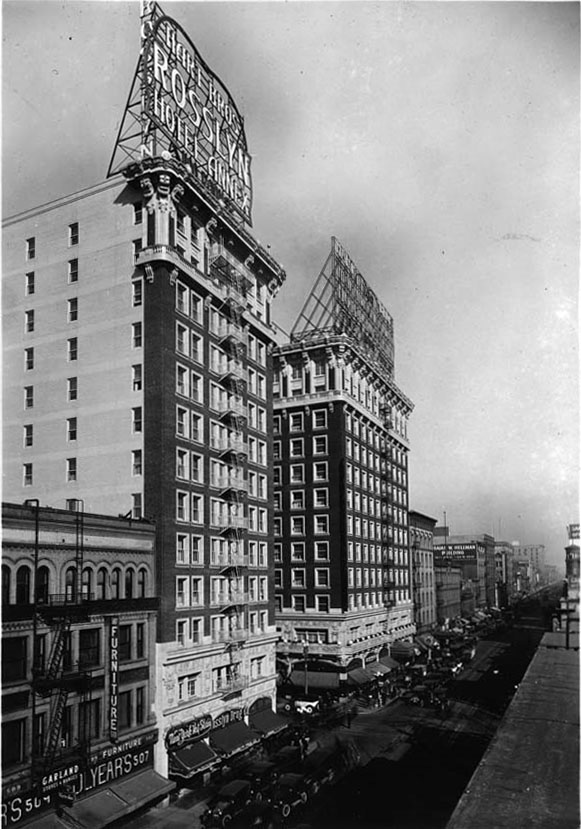 |
|
| (ca. 1923)^*# - View looking north on Main Street showng the Rosslyn Hotel and Rosslyn Annex shortly after they were built on the intersection with 5th Street. |
Historical Notes The Hotel Rosslyn Annex was built in 1923 across the street from the original 800-room Rosslyn Hotel built in 1914. Designed as a twin, both were topped by mammoth glowing signs featuring the names surrounded by a heart, the shape acknowledging the Hart brothers who owned the hotels.^* |
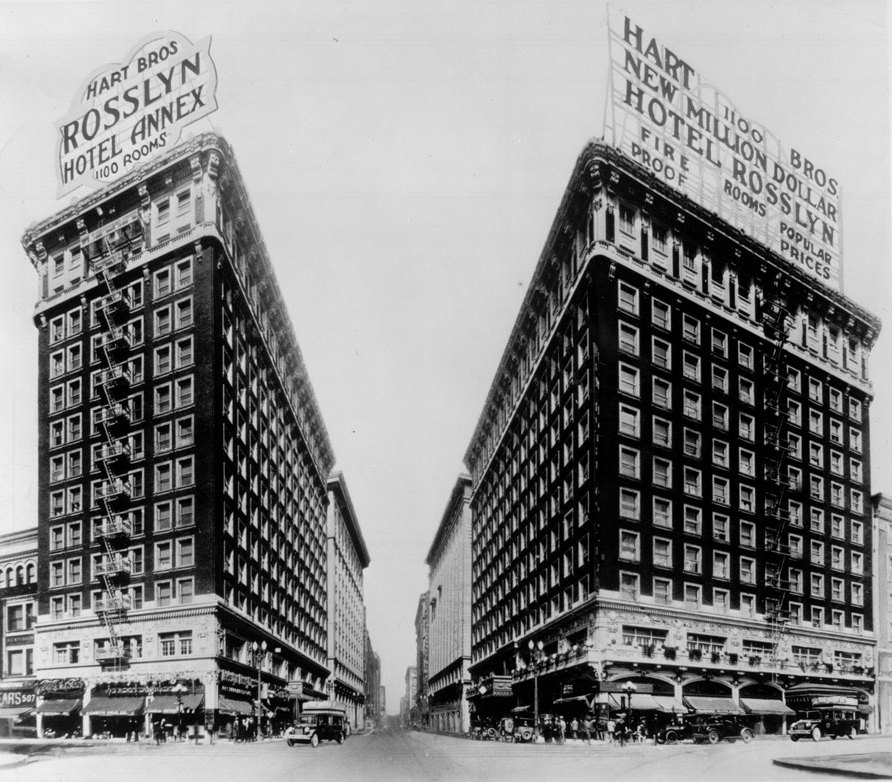 |
|
| (1924)* - View looking west on 5th Street at Main Street showing both the Hotel Rosslyn and Hotel Rosslyn Annex with their massive roof-mounted signboards. |
Historical Notes Both buildings were designed by architect John Parkinson, who was one of the most prolific architects in Downtown Los Angeles, responsible for much of the area's finest architecture, including Union Station, Bullock's Wilshire, the Title Guarantee Building, the Continental Building, the Alexandria Hotel, the Los Angeles Athletic Club, Security Bank (now the Los Angeles Theatre Center), the Los Angeles Memorial Coliseum, and Los Angeles City Hall.**## |
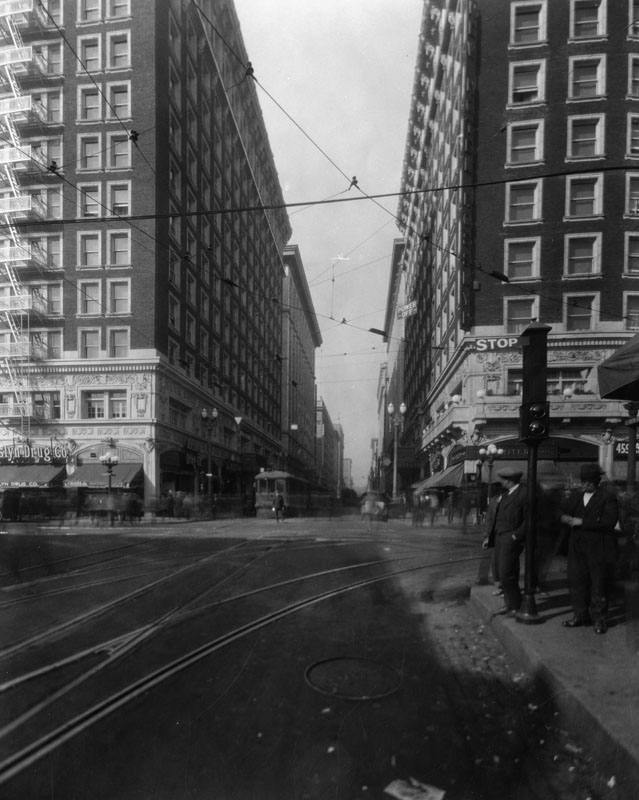 |
|
| (1930)* - View of looking west on 5th Street at Main Street showing the Rosslyn Hotel and Annex on the west side of Main. |
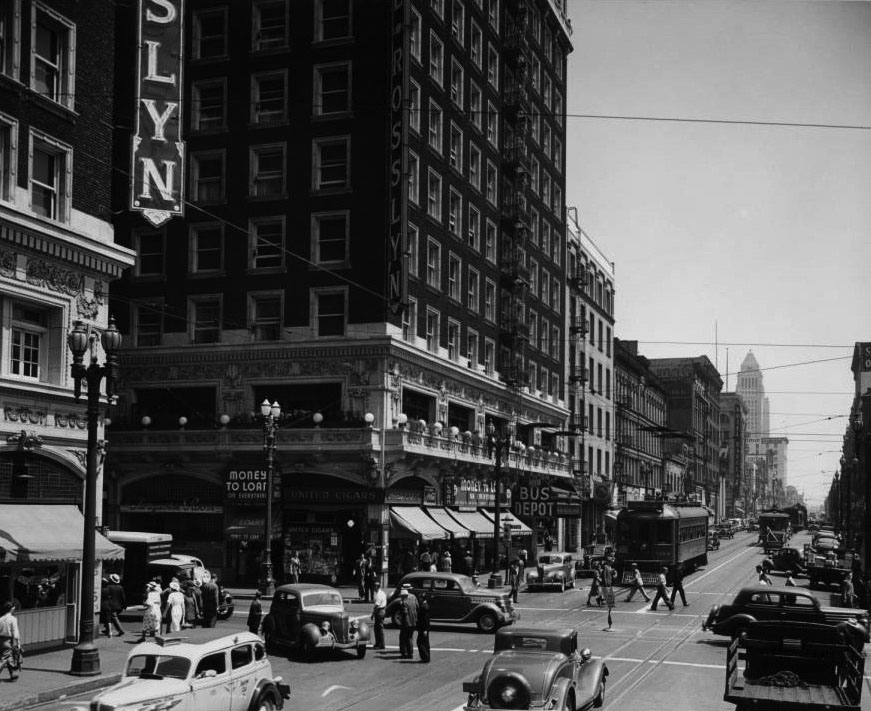 |
|
| (1939)^ - View looking north on Main Street at 5th Street. The two Hotel Rosslyn buildings are on the southwest and northwest corners. Several of the legible signs read: United Cigars, "Money to Loan", All-American Lines Bus Depot, Turquoise Room, and Hotel Barclay. City Hall can be seen in the distance. |
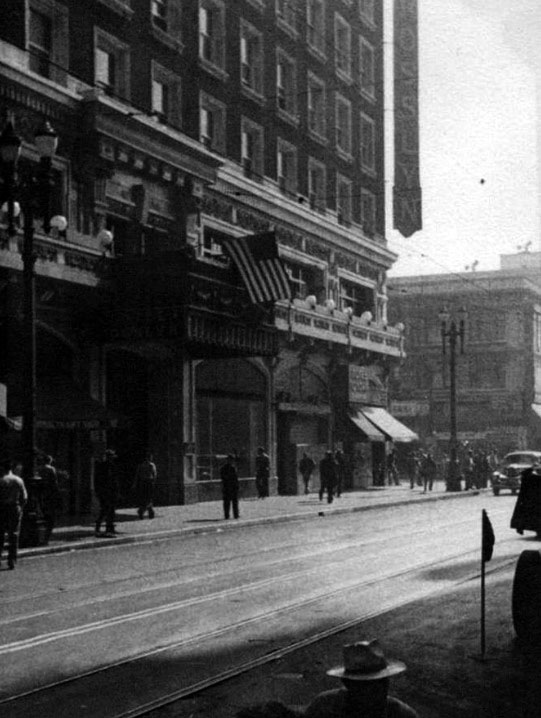 |
|
| (1940s)^*^# - Close-up view showing the entrance to the Rosslyn Hotel as seen from across Main Street. |
Historical Notes The New Rosslyn went into decline and closed in 1959. It reopened in 1979 as two hotels, the Rosslyn on the south side, and the Frontier on the north side. |
Then and Now
 |
|
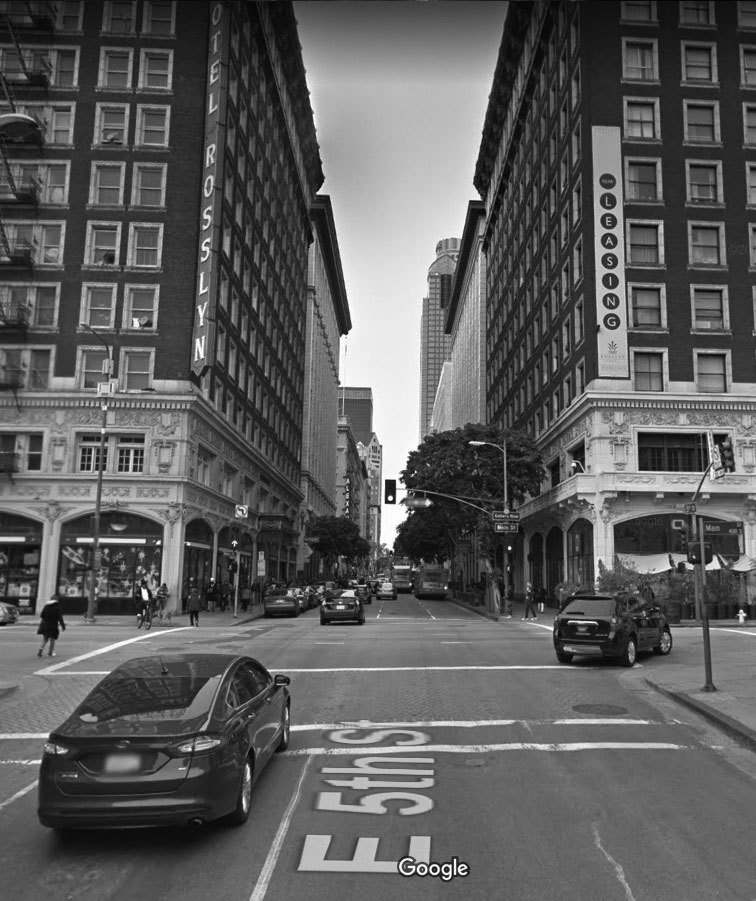 |
| (1930) vs. (2018)* - Rosslyn Hotel and Annex at 5th and Main streets. |
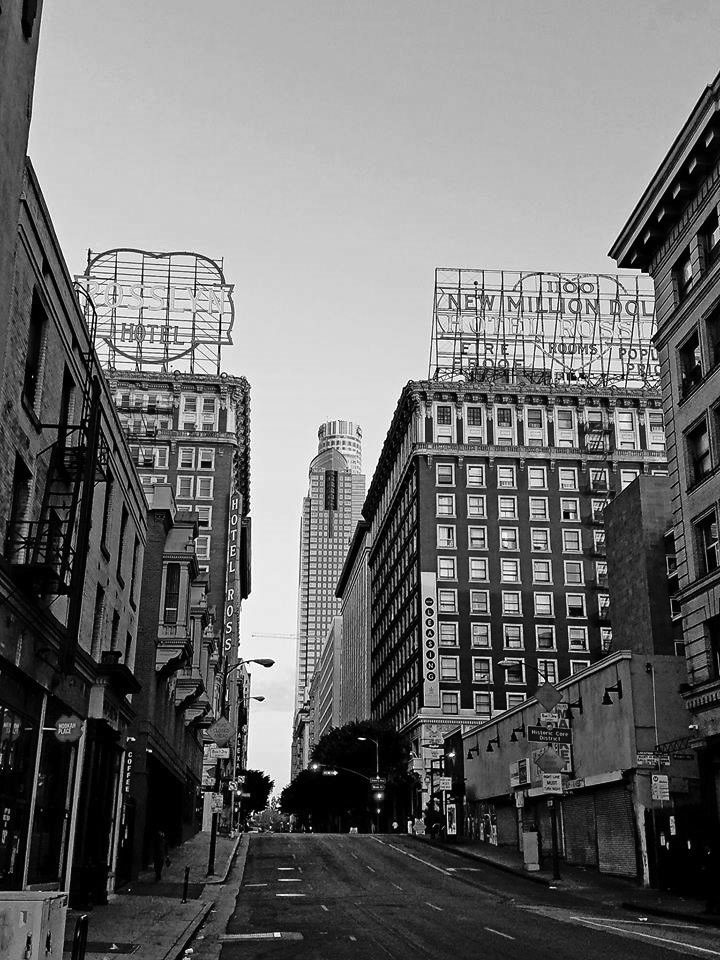 |
|
| (ca. 2018)^.^ - View looking west on 5th Street toward Main Street showing the Rosslyn Lofts (formerly the Rosslyn Hotel and Annex) as they appear today. The U.S. Bank Tower and Gas Company Tower are seen in the background. Photo courtesy of James J. Chun |
Historical Notes Renamed the Rosslyn Lofts in 2006, it currently provides both market-rate lofts and low-income housing. |
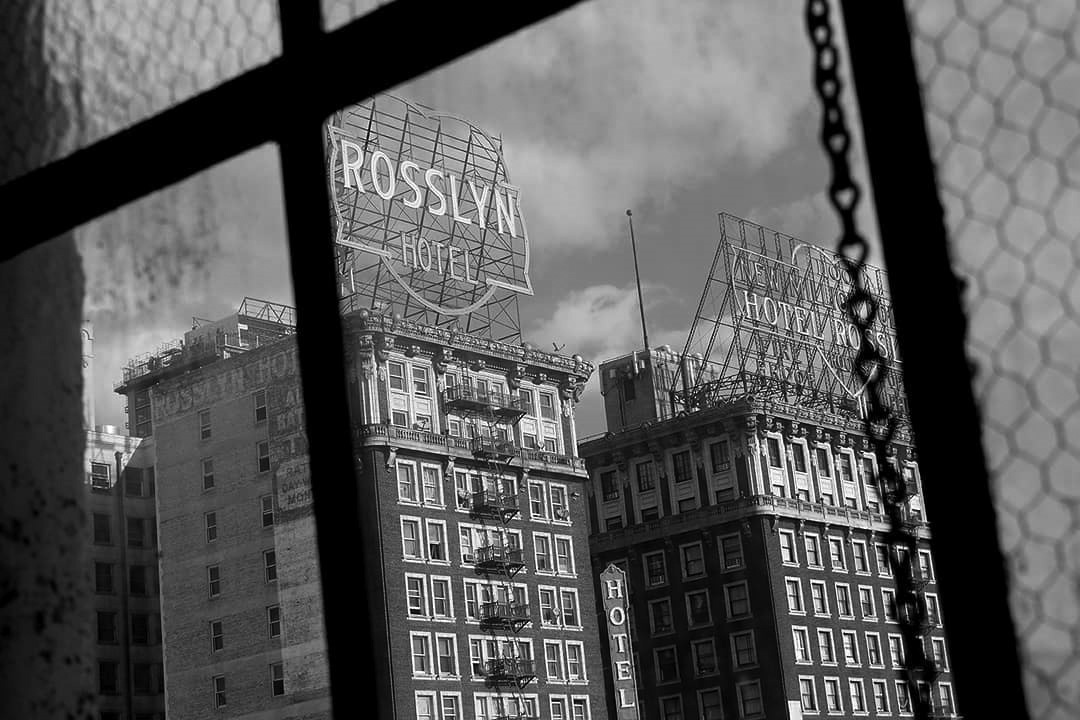 |
|
| (2020)^.^ - View looking at the Rosslyn Hotel and Annex (Rosslyn Lofts) as seen from the window of a nearby building. Photo by Kelly Wine |
Historical Notes Both the Hotel Rosslyn and Hotel Rosslyn Annex are topped by mammoth glowing signs featuring the names surrounded by a heart, the shape acknowledging the Hart brothers who owned the hotels.* |
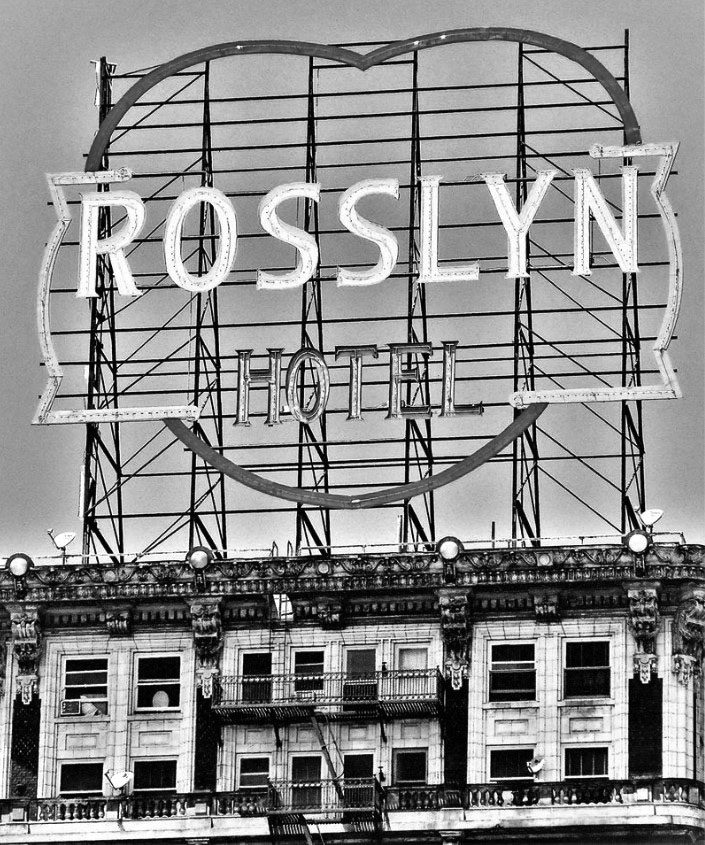 |
|
| (2019)^.^ – Close-up view of the iconic Rosslyn Hotel roof-mounted sign. Photo by Howard Gray |
* * * * * |
Million Dollar Theatre (aka Grauman's Theatre, aka Edison Building and later Metropolitan Water District Building)
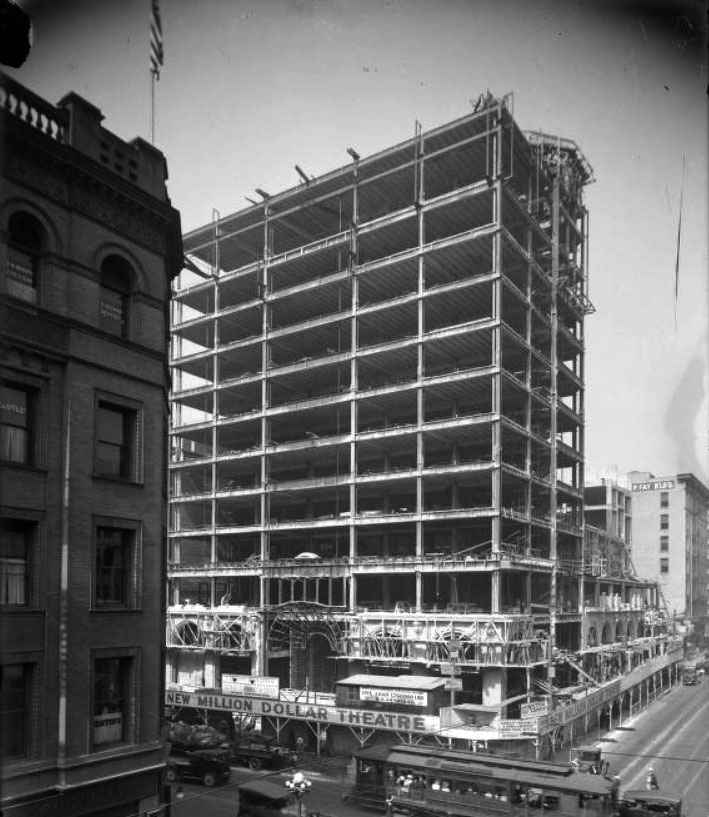 |
|
| (1917)#^* – View showing the Million Dollar Theatre under construction on the corner of 3rd Street and Broadway. Photo Date: 9-7-17 |
Historical Notes The Million Dollar Theater at 307 S. Broadway in downtown Los Angeles is one of the first movie palaces built in the United States. It opened in February 1918. It is the northernmost of the collection of historical movie palaces in the Broadway Theater District and stands directly across from the landmark Bradbury Building.* |
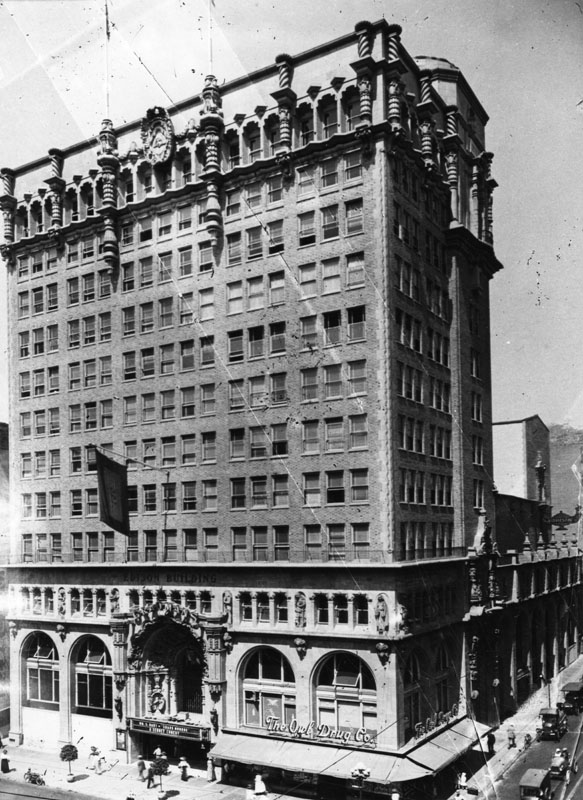 |
|
| (1918)* - Exterior view of a building on the corner of Third Street and Broadway was the home of Edison, Grauman's Theater - later to become the Million Dollar Theater - and the Owl Drug Company. Showing at the theater is a film with William S. Hart, "Shark Control," and a comedy by Sennet. |
Historical Notes The Million Dollar was the first movie house built by entrepreneur Sid Grauman. Grauman was later responsible for Grauman's Egyptian Theatre and Grauman's Chinese Theatre, both on Hollywood Boulevard, and was partly responsible for the entertainment district shifting from downtown Los Angeles to Hollywood in the mid-1920s.* |
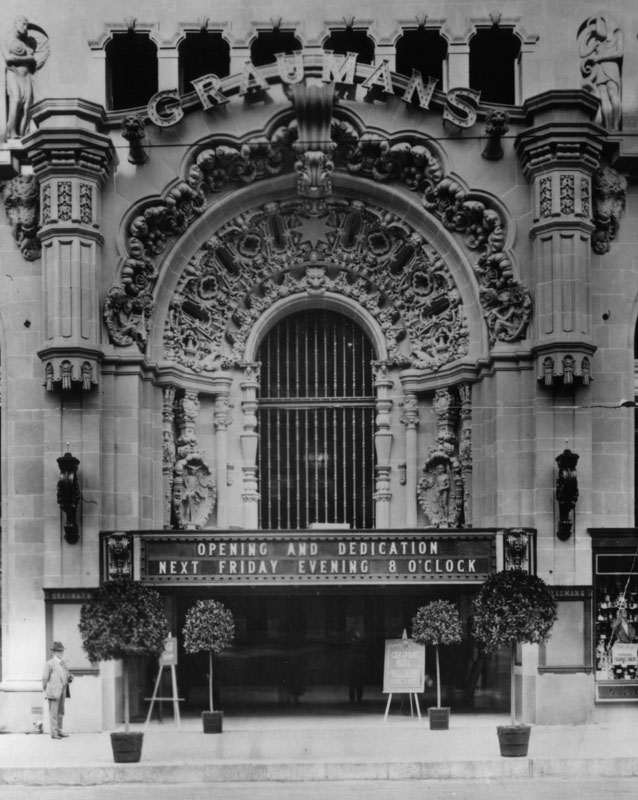 |
|
| (1918)* - View of the original marquee and main entrance of the Grauman's Theater (later Million Dollar Theater), located at 307 S. Broadway. |
Historical Notes Among the famous names who attended the opening night were: Jesse L. Lasky, Thomas Ince, Mack Sennett, Hal Roach, Cecil B. DeMille, D.W. Griffith, Mary Pickford, Douglas Fairbanks, Charlie Chaplin and Roscoe ‘Fatty’ Arbuckle.* |
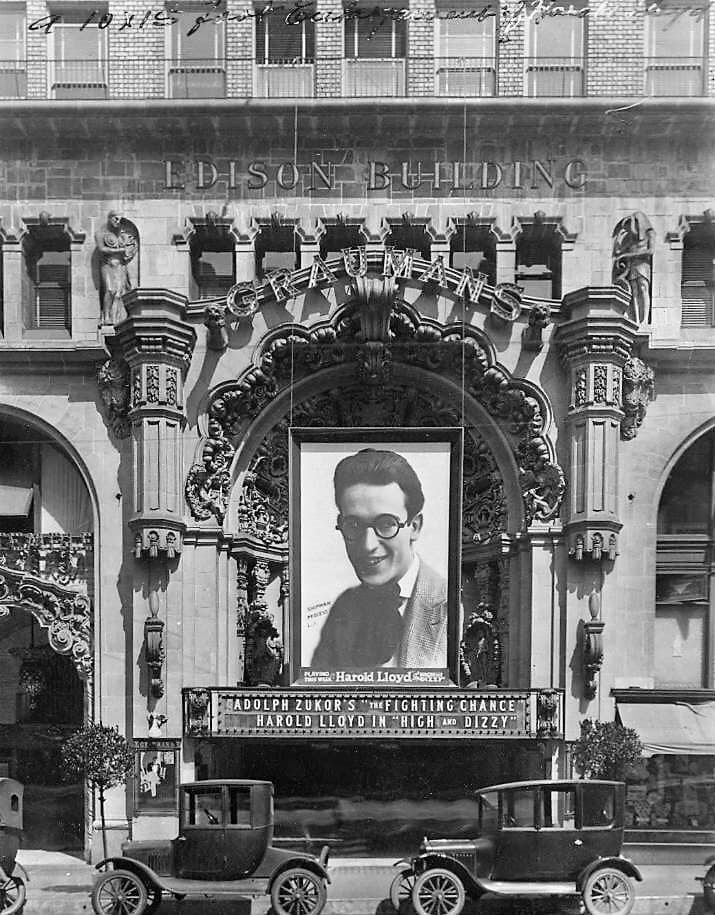 |
|
| (1920)^.^ - View showing the front entrance to the Grauman's Theater (later Million Dollar Theater) now showing the comedy film High and Dizzy starring Harold Lloyd. Note the sign above Grauman's reads 'Edison Building'. |
Historical Notes The initial tenant of the office building was the Edison Co. Later the Metropolitan Water District occupied the office building. |
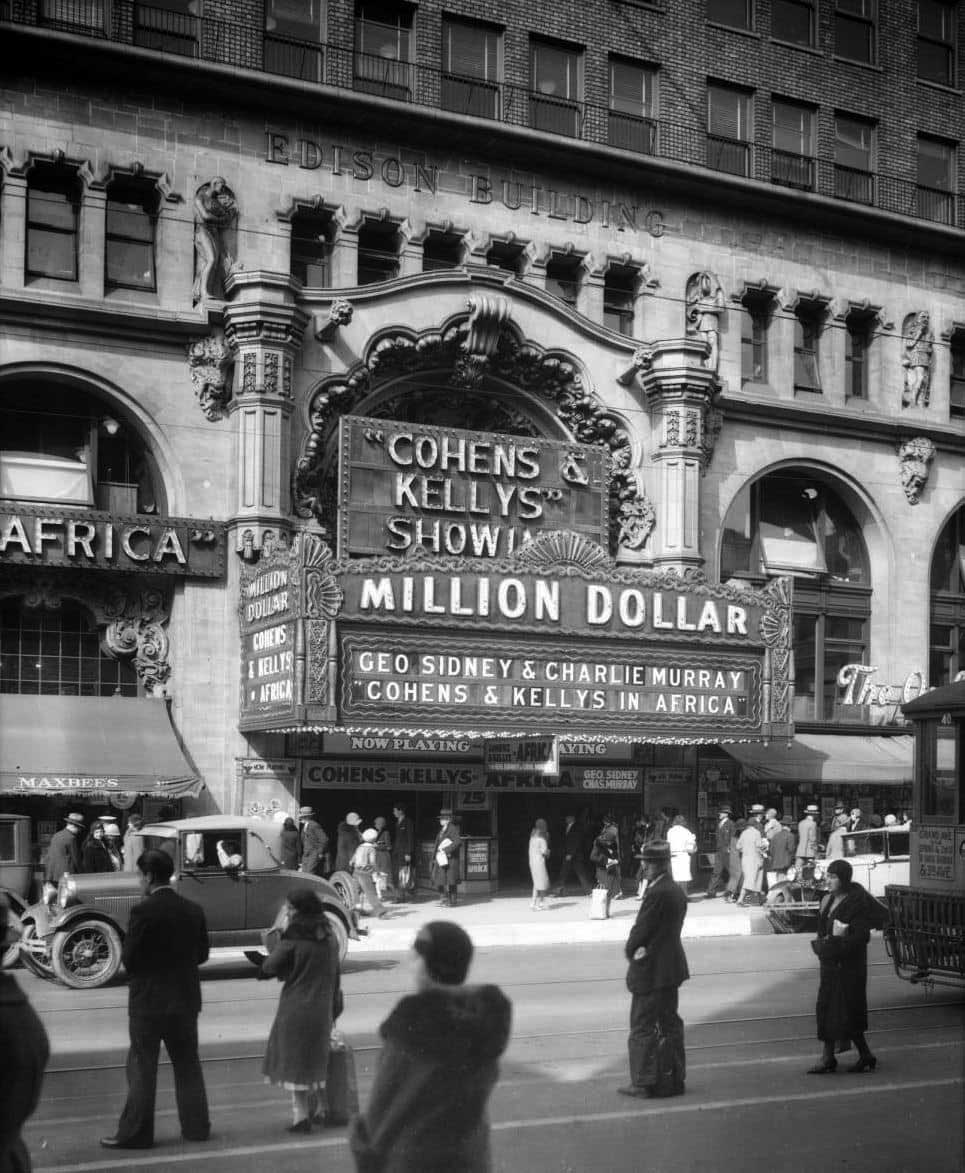 |
|
(1931)* - Million Dollar Theatre located at 307 S. Broadway in Downtown LA. It was one of the first movie palaces built in the United States. |
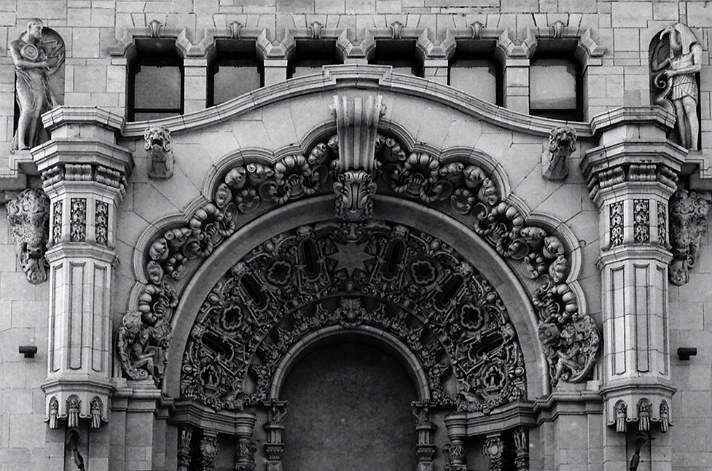 |
|
| (2012)^ - View of the ornate Churrigueresque front entry facade of the Million Dollar Theater. The lavish exterior terra-cotta ornamentation by Joseph Mora includes bison heads, longhorn skulls and allegorical figures representing the arts. |
Historical Notes Sculptor Joseph Mora did the elaborate and surprising exterior Spanish Colonial Revival ornament, including bursts of lavish Churrigueresque decoration, multiple statues, longhorn skulls and other odd features. The auditorium architect was William L. Woollett, and the designer of the twelve-story tower was Los Angeles architect Albert C. Martin, Sr. (also designed the Liberty Theatre).* |
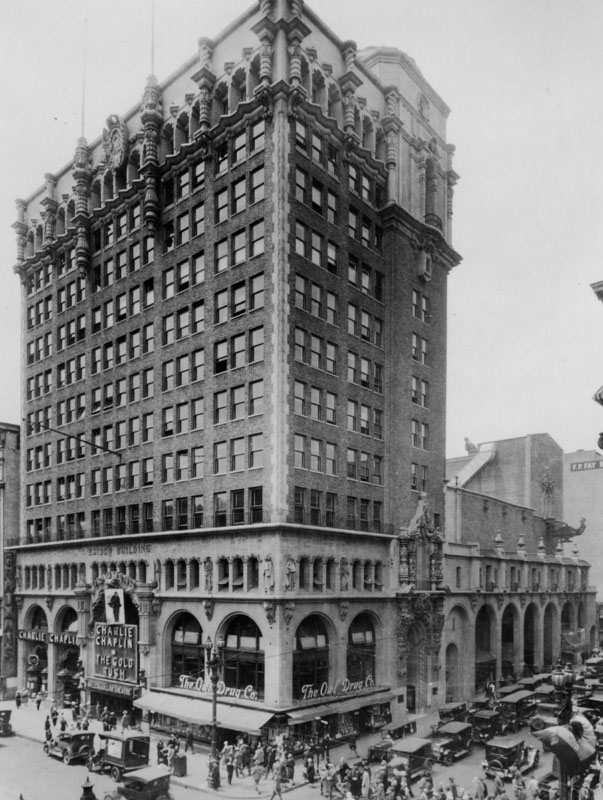 |
|
| (ca. 1925)* - View looking at the SW corner of Third Street and Broadway showing the Million Dollar Theater building. The marquee indicates that Charlie Chaplin's 1925 film Gold Rush is playing at the theater. |
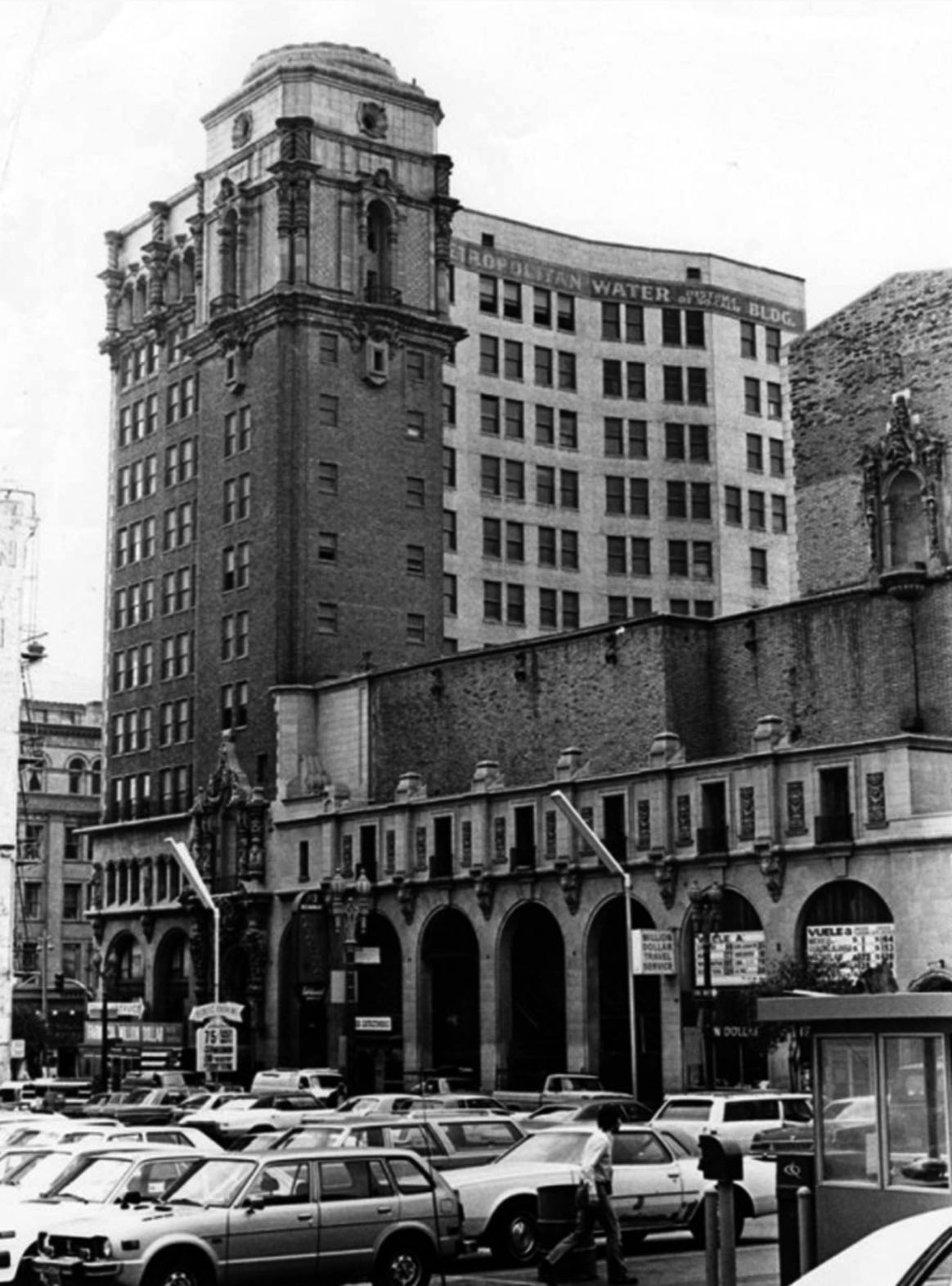 |
|
| (1982)* - View looking at the Million Dollar Theater building and former headquarters of the Metropolitan Water District of Southern California, located at 307 So. Broadway as seen from the Third Street side. |
Historical Notes For many years the office building housed the headquarters of the Metropolitan Water District of Southern California. The building also housed the Municipal Water Department of the City of Los Angeles, predecessor to the Los Angeles Department of Water and Power (DWP) as well as housing offices of William Mulholland. |
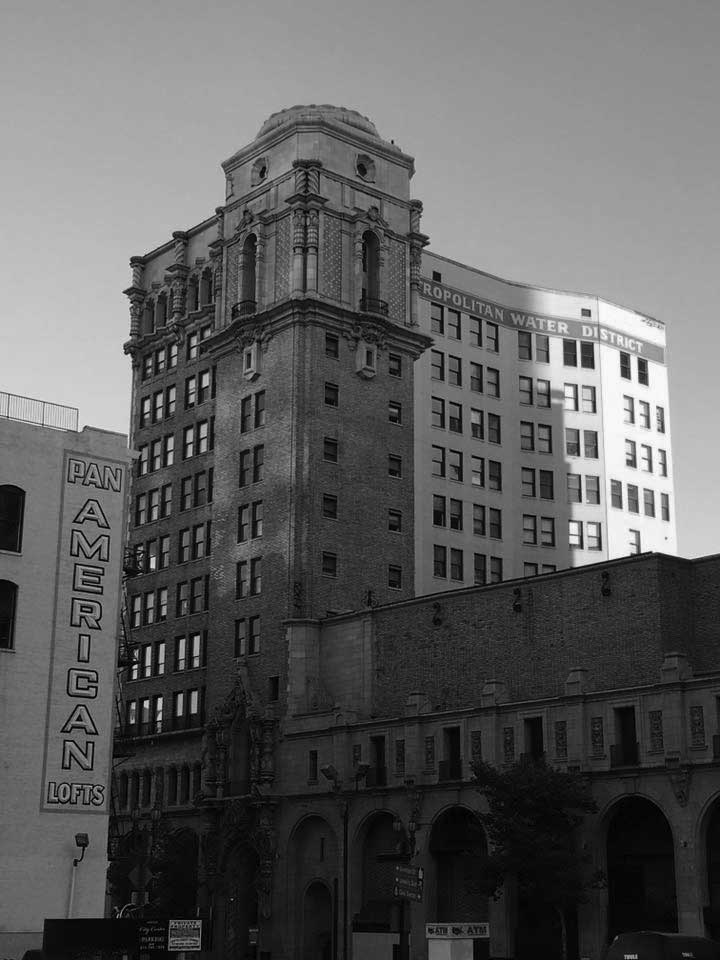 |
|
| (n.d..)^ – Closer view showing the backside of the Million Dollar Theater from 3rd Street. William Mulholland’s office was on the top floor, southwest corner when the building was occupied by the Municipal Water Department (prior to Metropolitan Water District). |
Historical Notes After serving as the home of a Spanish-speaking church for some years, as of 2006 the Million Dollar theater was empty, although the office building had been recently renovated and converted to residential space. In February 2008, the theater re-opened, once again showing live Spanish theatre. It continues to draw large crowds, and there are plans to begin screening major motion picture premieres.* |
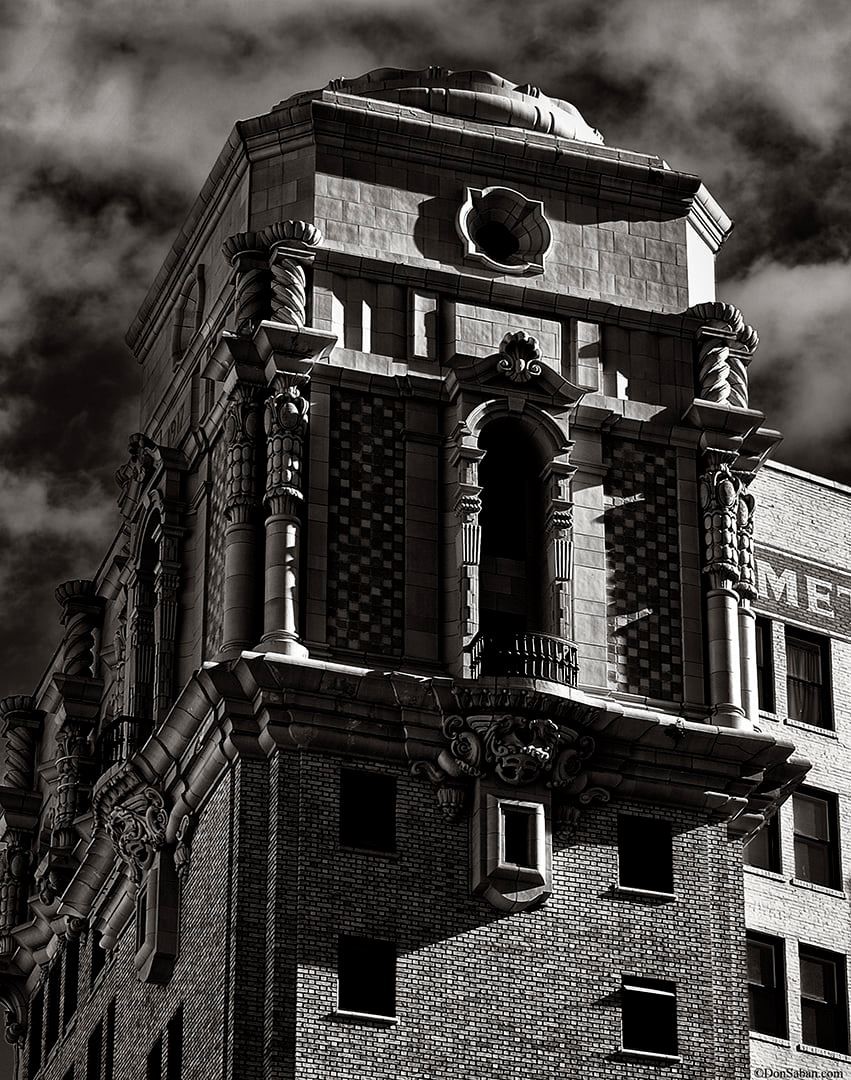 |
|
| (2021)^ – Close-up view of the top of Metropolitan Water District Building (aka Million Dollar Building) with its ornate Churrigueresque-style design. Photo by Don Saban |
Historical Notes The twelve-story building was designed by Albert C. Martin, Sr., one of the most important architects in Los Angeles at the time and founder of one of the city’s most prominent architectural firms. The exterior of the building exemplifies the elaborate Churrigueresque (chur-rig-ur-esk) style, named after the eighteenth-century Spanish church architect and sculptor Jose de Churriguera, whose designs favored this type of architectural embellishment.* |
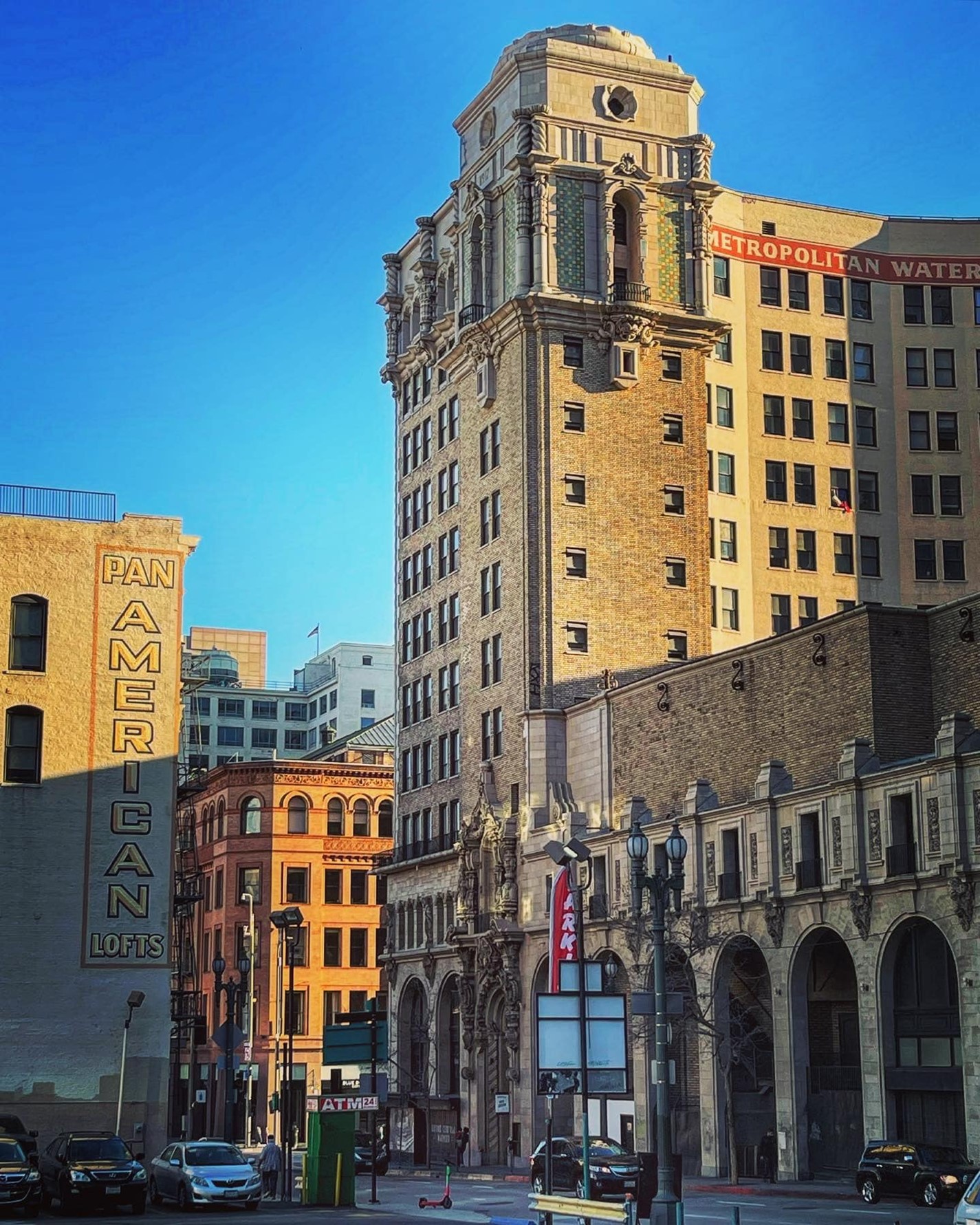 |
|
| (2022)^ - Million Dollar Theater as seen from 3rd Street. The building also housed the Municipal Water Department of the City of Los Angeles, predecessor to the Los Angeles Department of Water and Power (DWP) as well as housing offices of William Mulholland. The Bradbury Building can be seen across the street (SE corner of Broadway and 3rd). |
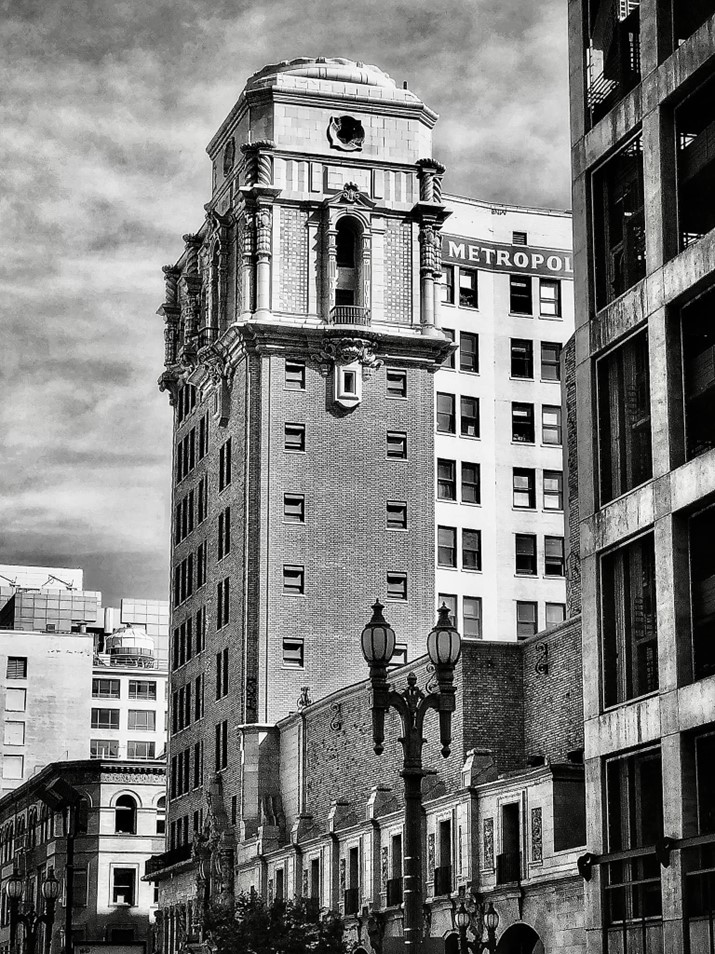 |
|
| (2022)^ - Million Dollar Theater as seen from 3rd Street (aka Grauman's Theatre, aka Edison Building and later MWD Building). Located on the SW corner of Broadway and 3rd Street. Photo by Carlos G. Lucero |
* * * * * |
Hellman Building (2nd and Broadway)
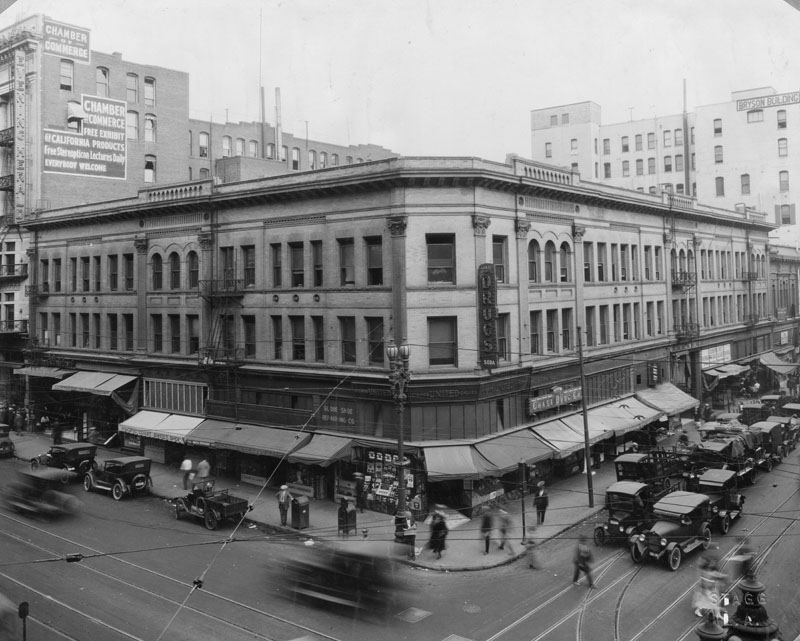 |
|
| (1918)* - Exterior view of the Hellman Building in 1918, located on the northeast corner of 2nd Street and Broadway. Coast Drug Company is on the first floor, along with several small shops. |
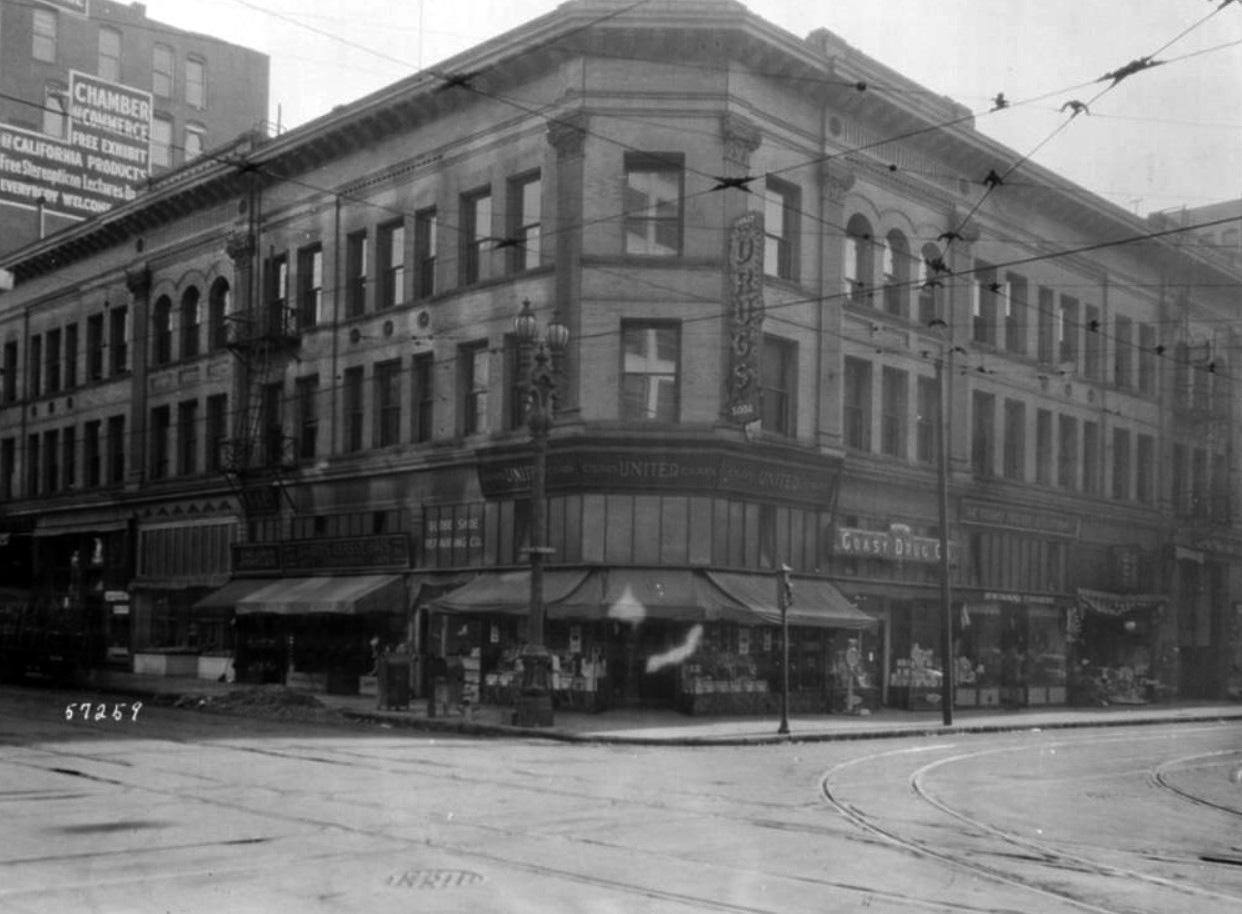 |
|
| (1922)* - View showing the Hellman Building located on the NE corner of 2nd and Spring. |
Historical Notes In 1957 it was owned by the L.A. Times who demolished it in March 1959. In the 1980's this corner held the Times Mirror garage. Building architects, Morgan & Walls. |
* * * * * |
Foy Residence
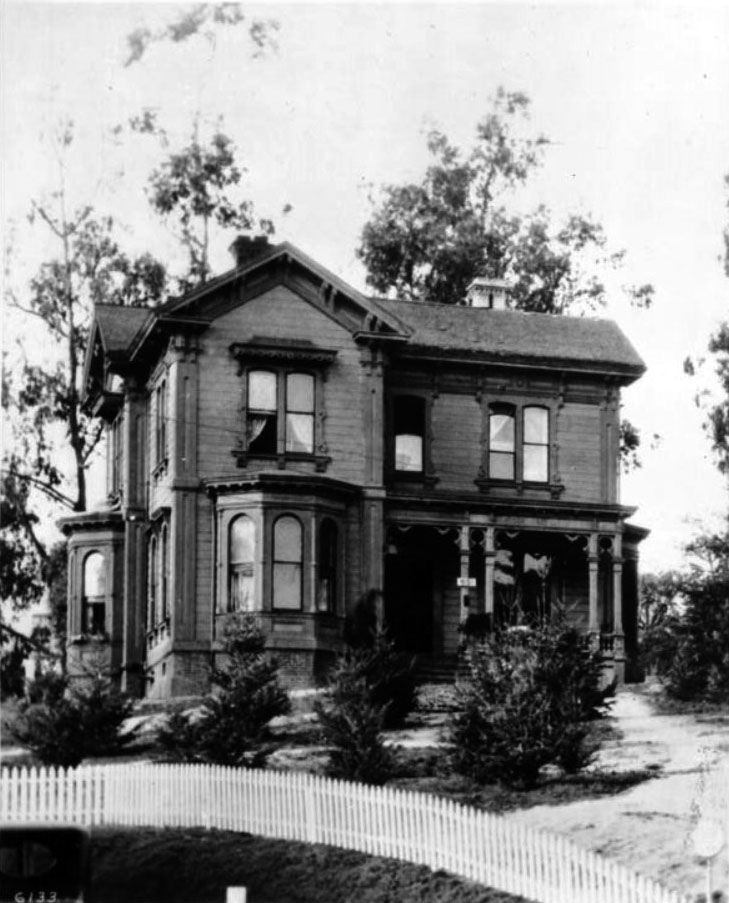 |
|
| (ca. 1918)^ - Close-up view of the Foy residence on the northwest corner of Figueroa Street and 7th Street. The two-story house features several cant windows, a covered porch, walls constructed of shingled wood, and two chimneys jutting above the inclined roof. Short trees cover the yard surrounded by a picket fence and taller trees are seen in the background. "651", the house's street address, is displayed on a placard on a post in front of the house. |
Historical Notes In 1872, Samuel Calvert Foy purchased the property from Los Angeles Mayor Thomas Foster for $1,000. Foy moved to Los Angeles in 1854 and operated a successful harness business at 217 Los Angeles Street, which was the oldest business establishment in the city at the time of his death. Foy also served as the city's Chief of Police for a time. He built the Foy House at the corner of Grasshopper (now Figueroa) and 7th Streets in either 1872 or 1873, and it was there that Foy and his wife, Lucinda Macy Foy, raised their son and four daughters. The house was reportedly "the first three-story building in the city." At the time the Foys built their house, the site was considered to be "way out in the country." Foy's daughter, Mary Foy, was the city's first woman librarian from 1880-1884, a leader in the California Women's suffrage movement, a leader of the Democratic Party, and the first woman to be a member of one of the major parties' national committees.^* Today, the Wilshire Grand Hotel is located at this site. |
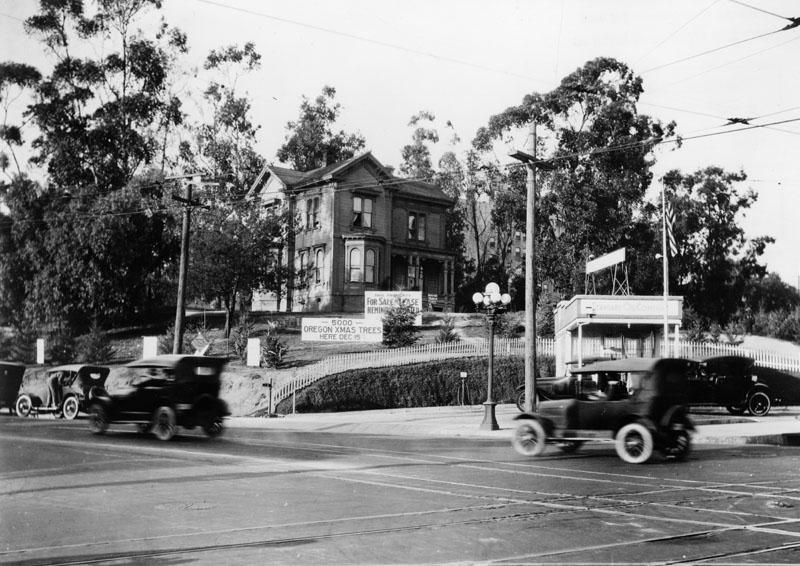 |
|
| (1919)* - View looking toward the northwest corner of Figueroa and 7th streets showing the Samuel Calvert Foy property on December 20, 1919. The lot is being used to sell Christmas trees with a large sign reading: 5000 Oregon Christmas Trees Here Dec. 15. Another large sign reads: FOR SALE or LEASE. A small Standard Oil Company gas station is on the corner, next to a multi-globe street light. |
Historical Notes In December 1919, the Foy family sold the property for a consideration reported to be approximately $600,000. At the time of the property's sale in 1919, the new owner announced its plan to start construction immediately of a six- or seven-story structure on the site at a cost of $450,000. Though there are varying accounts as to the exact date, the Foy House was moved to its second site on 631-633 South Witmer Street, just north of Wilshire Boulevard and across from Good Samaritan Hospital.^* |
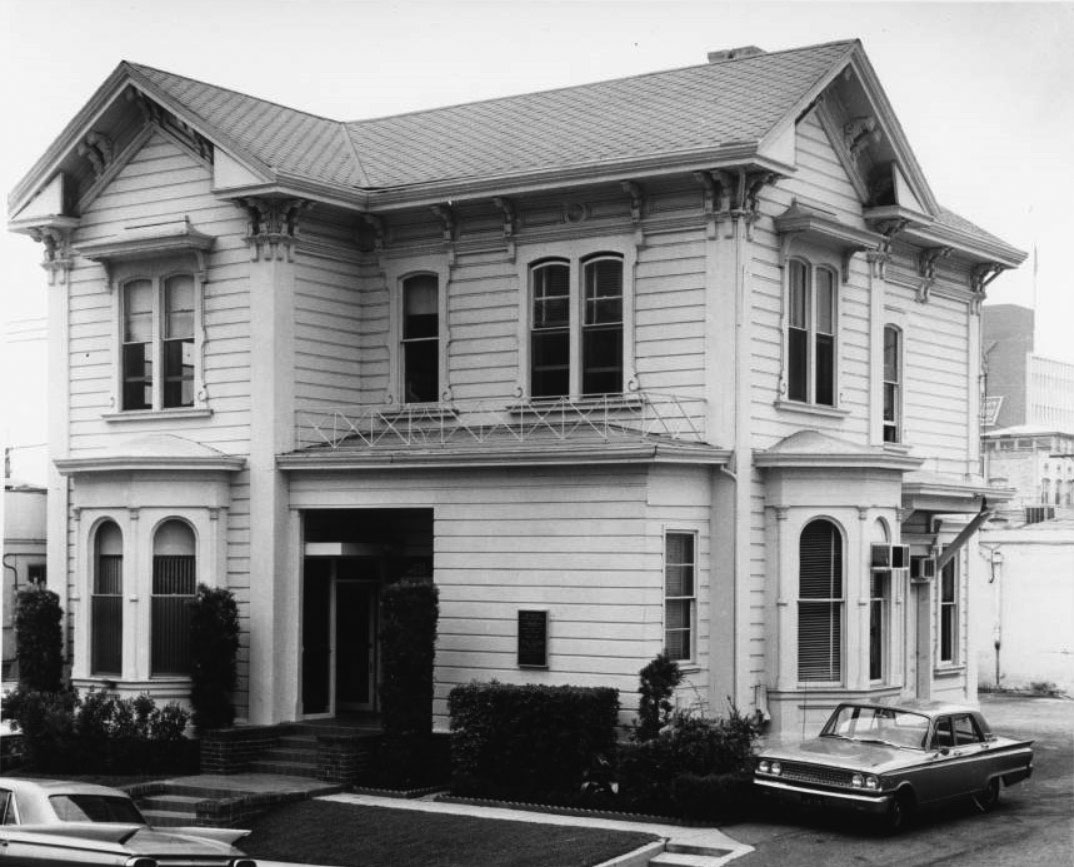 |
|
| (1960s)^ – View showing the historic Samuel Calvert Foy home at 631 S. Witmer Street (near the Good Samaritan Hospital). |
Historical Notes In December 1992, the house was moved to its third location at 1337 Carroll Avenue. The Foy House was the seventh house to be moved to Angelino Heights, the first and largest historic preservation zone in the City of Los Angeles. |
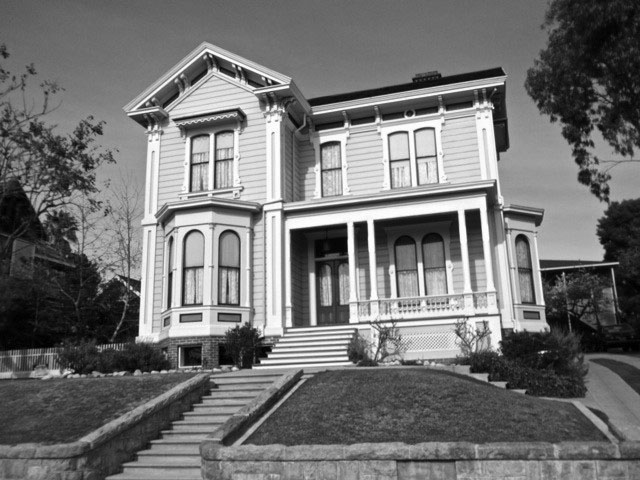 |
|
| (ca. 2012)#+ – View showing the 1872-built Foy House at its third location, in the Angelino Heights Historic Preservation Overlay Zone at 1337 Carroll Avenue. |
Historical Notes The current owner has faithfully reconstructed elements lost during the multiple moves, such as the exterior window canopy. The sky-blue paint on the porch ceiling is typical of Victorian homes; some say this treatment discourages birds from nesting by mimicking the sky. |
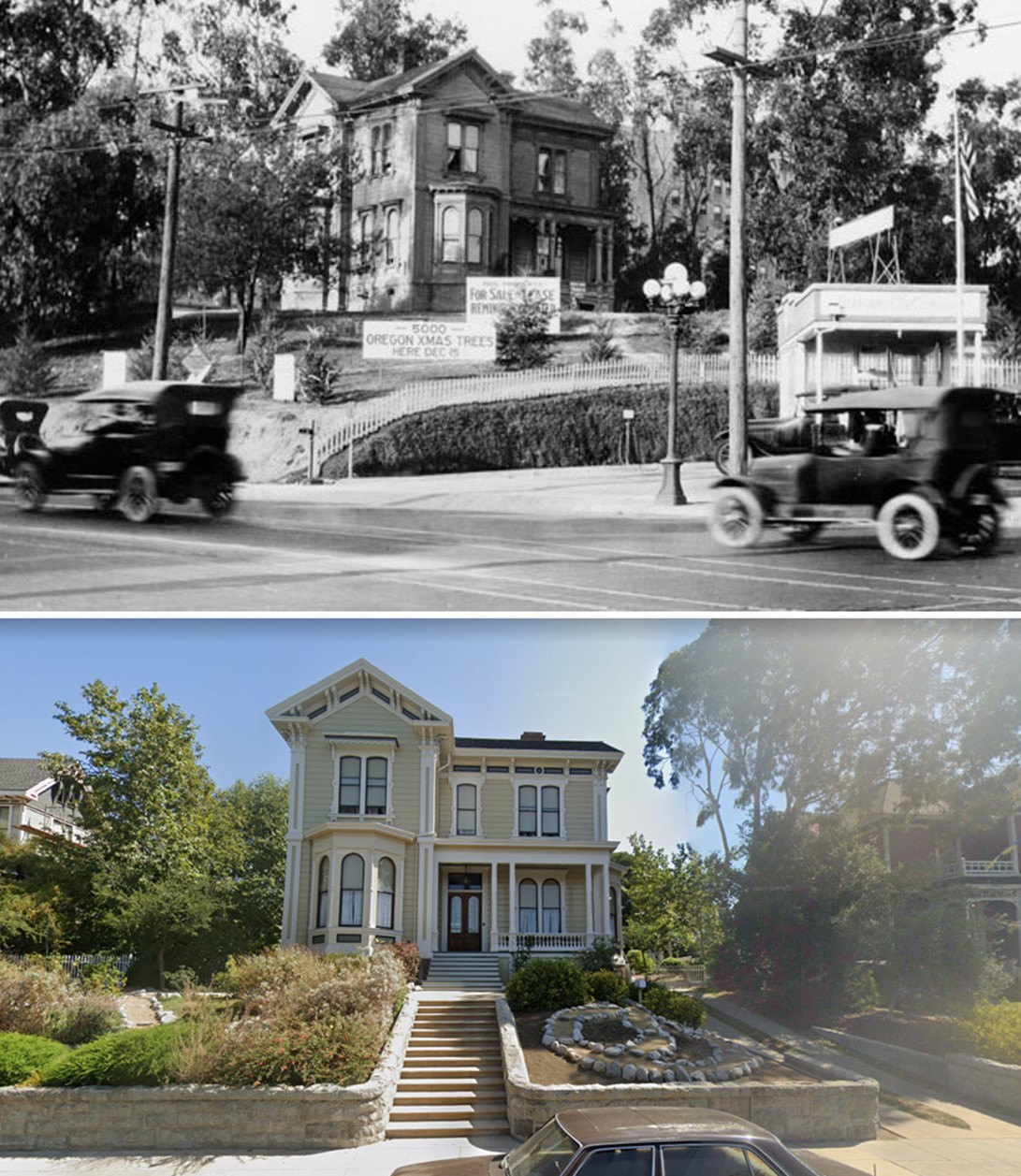 |
|
| (1919 vs 2022)* - Looking at the Foy Residence at its original location in 1919, near the NW corner of Figueroa and 7th Street in DTLA. Bottom photo shows the same house at its current location at 1337 Carroll Avenue (3rd location). Note the Xmas Tree sale sign in front, the small gas station on the corner, and the ornate 5-globe streetlight in the early photo. |
Historical Notes The Foy House is listed as Los Angeles Historic-Cultural Monument No. 7 (Click HERE to see complete listing). |
* * * * * |
Southern Pacific River Station
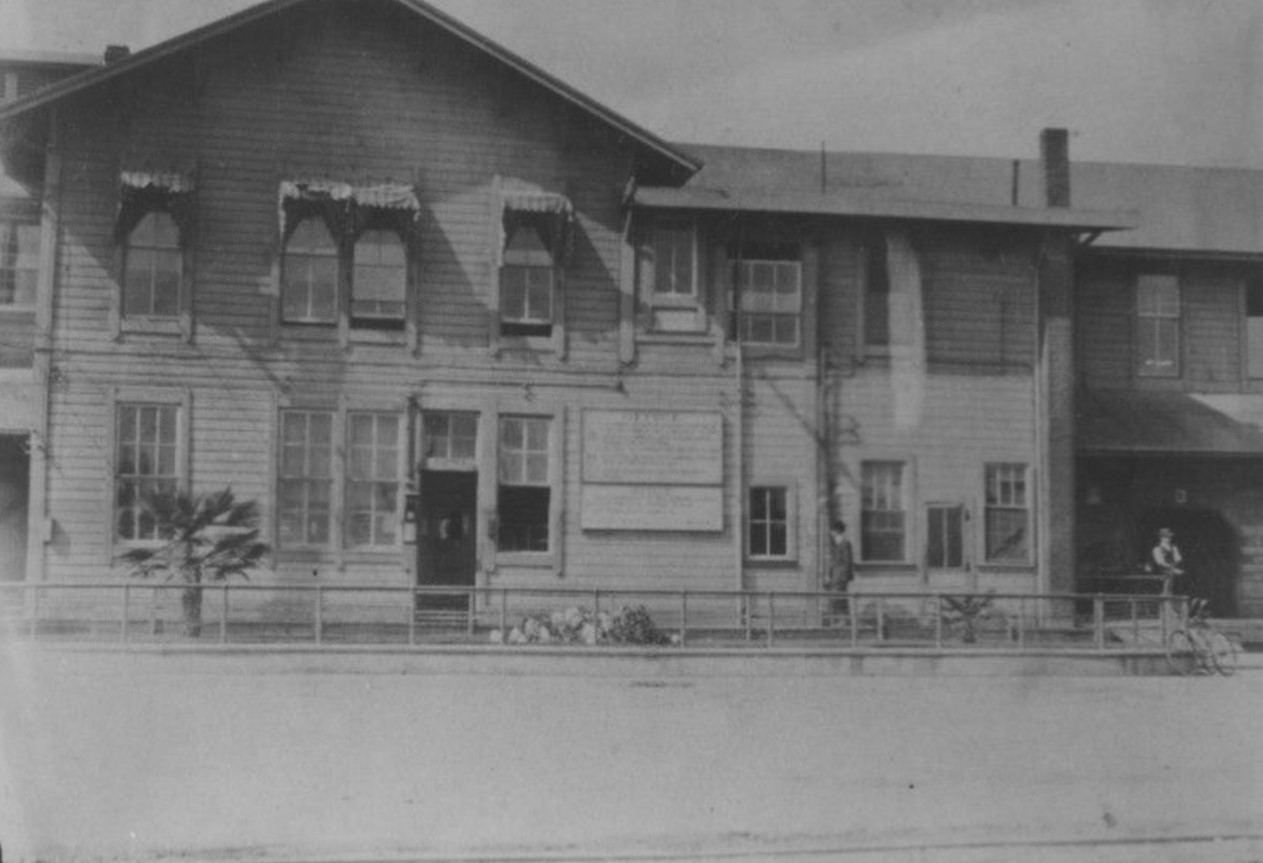 |
|
| (ca. 1880s)* - Looking at he LA River Station located at 1501 San Fernando Street (now N. Spring Street). San Fernando Street was renamed North Spring Street sometime in the 1910s |
Historical Notes The River Station, also known as the Los Angeles Junction Station, was established in 1876 by the Southern Pacific Railroad. It was located on the west side of North Spring Street, in an area northeast of downtown Los Angeles that is now part of Los Angeles State Historic Park, formerly known as "The Cornfield". This station was the first of four passenger stations eventually used by Southern Pacific in Los Angeles and served as the city's first transcontinental railroad depot and freight yard. The original structure was a two-story wooden building that offered separate waiting rooms for ladies and gentlemen. |
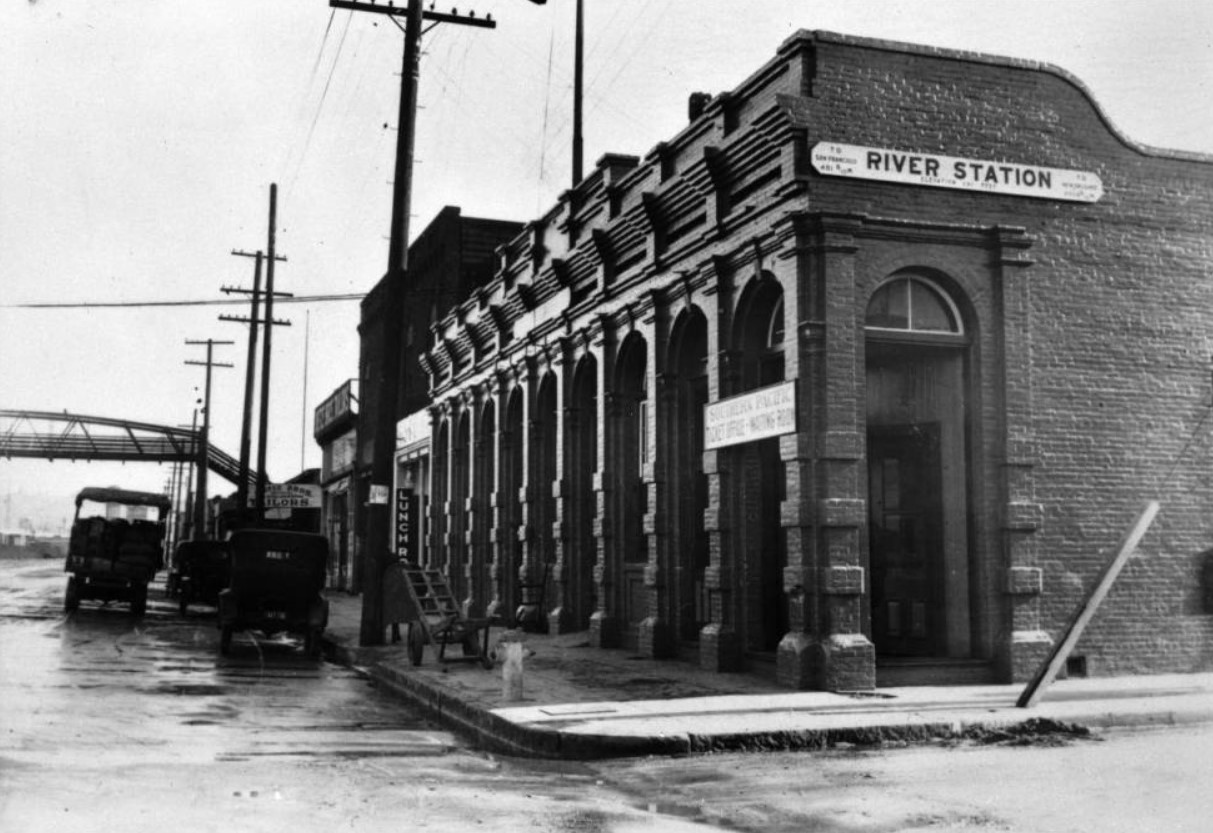 |
|
| (ca. 1910s)* - View showing the Southern Pacific River Station on San Fernando Road (later North Spring). This was the River Station's 2nd building. The station was Los Angeles' first Southern Pacific station and was built in 1887. The Southern Pacific River Station was located at 1501 San Fernando Street (San Fernando Street was renamed North Spring Street sometime in the 1910s) |
Historical Notes In 1887, a second River Station was built on the site of the demolished original structure. This new station was a brick Romanesque Revival style building, reflecting the growing importance of the railway to the city. The railroad also upgraded the facility over time, adding amenities such as a hotel and restaurants. |
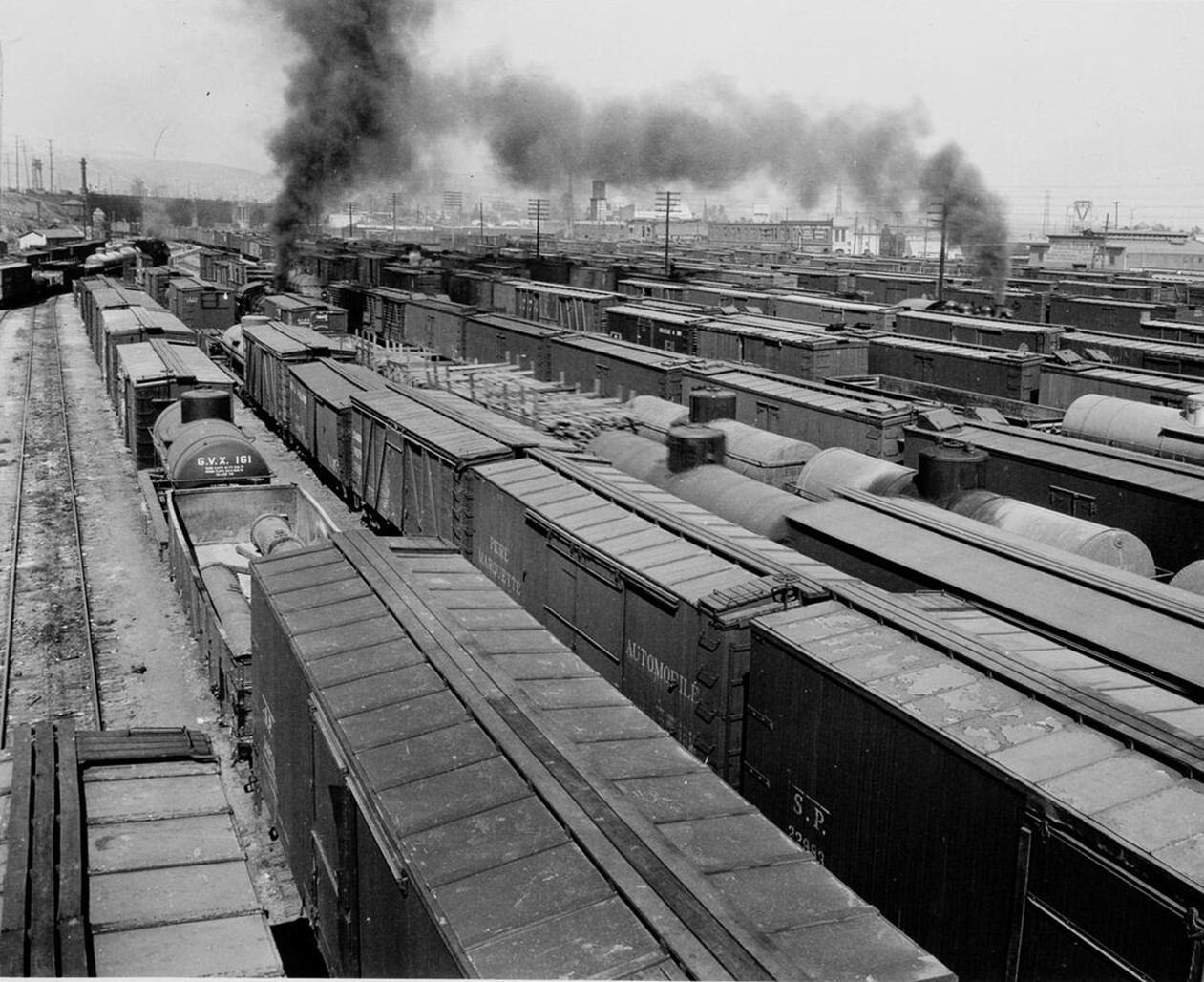 |
|
| (1930)* - View showing the River Station railroad freight yard near North Broadway, moving freight to Los Angeles Harbor. Hundreds of dark freight cars sit on parallel tracks across the yard at center. Smoke stacks billow over the background. |
Historical Notes Though the River Station welcomed many of those drawn by the land boom of the mid-1880s, its location came to be seen as less than ideal. It was surrounded by the Southern Pacific's freight yards and, as the city's Anglo population shifted south of the historic plaza into the new central city, it was situated far from many passengers' ultimate destinations. Later depots, beginning with the Southern Pacific's Arcade Station, would be located to the south. |
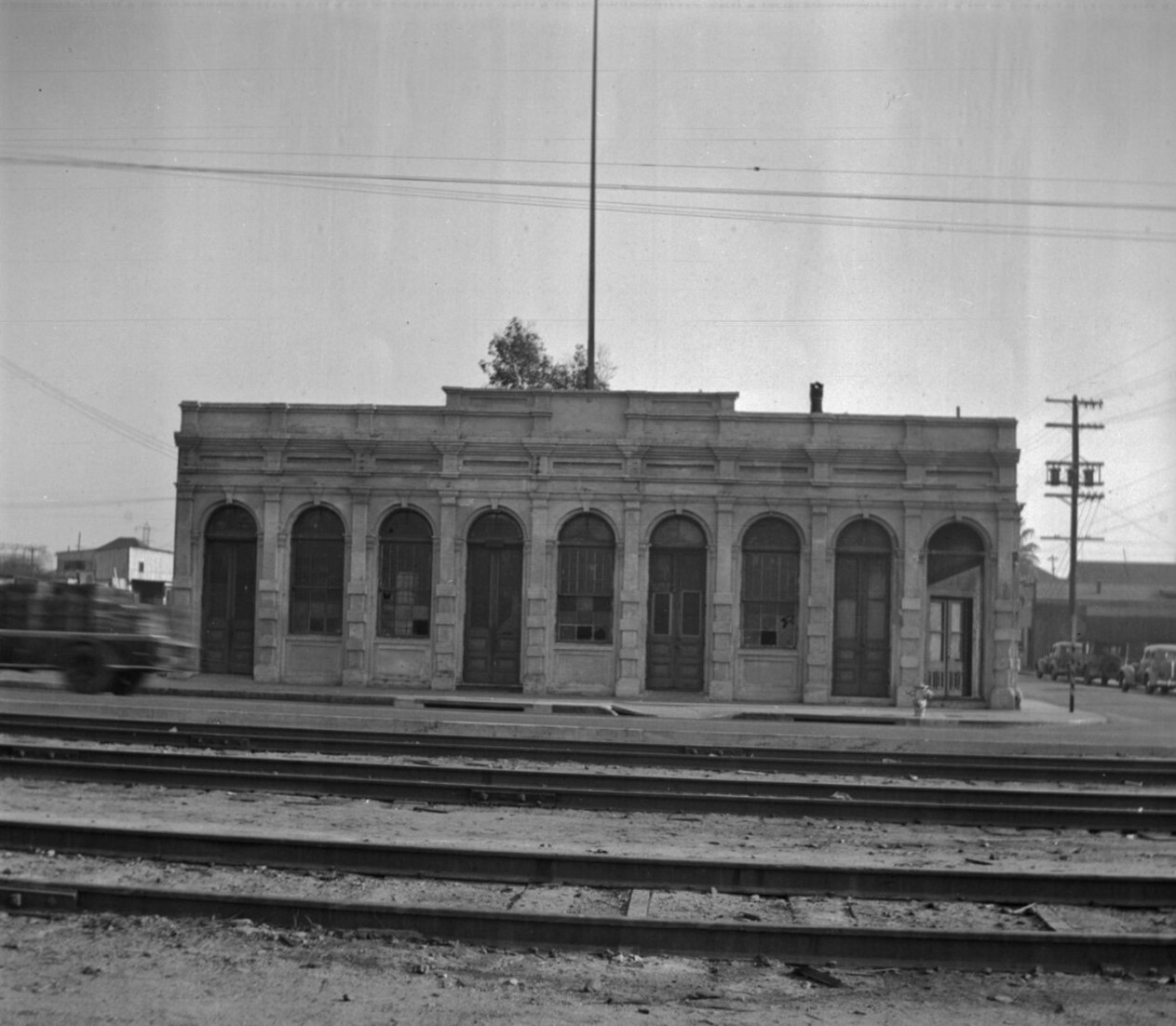 |
|
| (1940)* - Former River Station depot for the Southern Pacific Railroad, viewed from the front. |
Historical Notes Despite its initial importance, River Station's prominence began to wane as the city grew and new stations were built in more central locations. In 1888, Southern Pacific opened the Arcade Station at Fourth and Alameda, which was closer to the new central city. Today, the site of River Station is part of Los Angeles State Historic Park, preserving this important piece of the city's railway history. The area contains vestiges of 19th-century railroading, including freight yards, warehouses, tracks, switch houses, docks, and cobblestone pavement. The River Station area was declared Historic Cultural Monument No. 82 by the City of Los Angeles, recognizing its significance in shaping the city's development and growth. Click HERE to see more on the Los Angeles State Historic Park. |
* * * * * |
St. Elmo Hotel
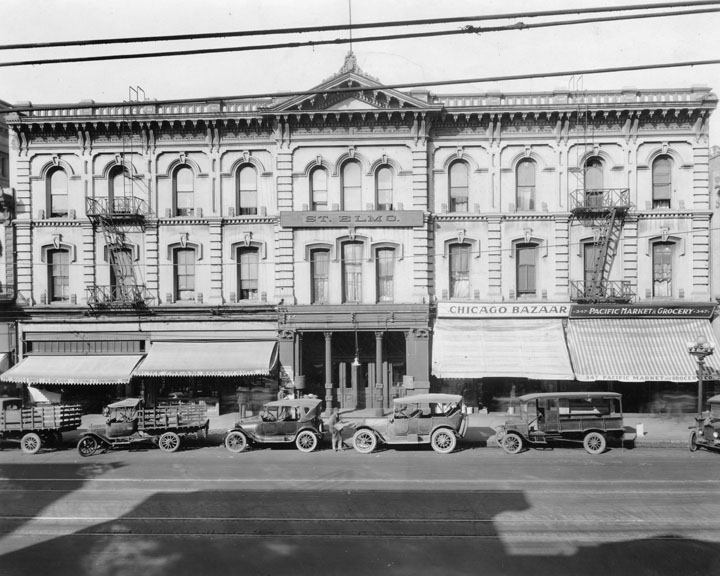 |
|
| (1920)* - St. Elmo Hotel was first named Lafayette Hotel and renamed the Cosmopolitan. Here the hotel is viewed from across the street, with a line of cars parked at the curb in front of the various ground floor businesses. |
* * * * * |
Bella Union Hotel
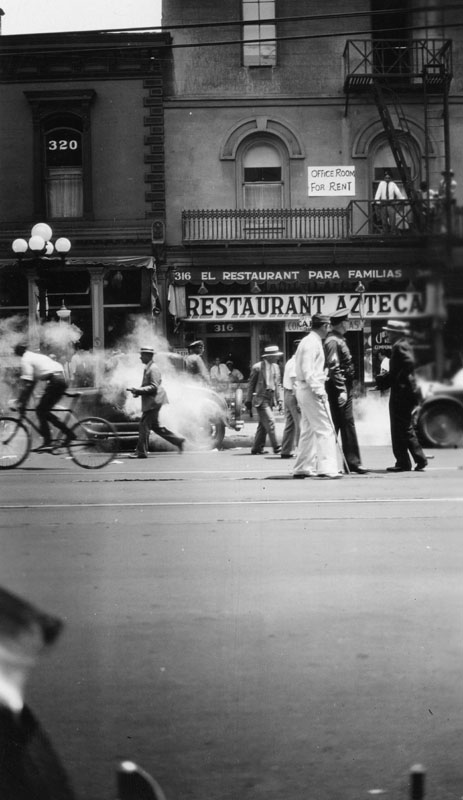 |
(ca. 1920)* - View of a busy North Main Street in front of the Azteca Restaurant as seen from across the street. The restaurant is located on the street floor of the old Bella Union Hotel. A sign on the second floor reads: Office Room For Rent.
|
Historical Notes Constructed in 1835, the Bella Union Hotel has a long, rich history. It served as the County Courthouse until October 1851, and in 1860 was the location of a champagne fete celebrating the connection of San Francisco and Los Angeles by telegraph.^ |
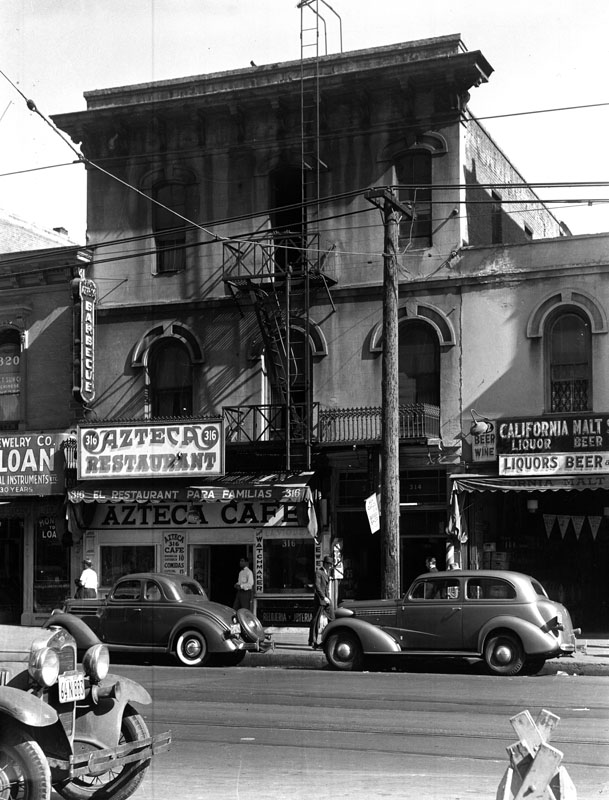 |
|
| (1939)* - Exterior view of the old Bella Union Hotel, located at 314 North Main Street. Taken on May 4, 1939, the hotel had become a shadow of its former self. |
Historical Notes The Bella Union Hotel is considered to be the first hotel in Los Angeles. The building no longer exist, however the site it stood on was designated California Historical Landmark No. 656 (Click HERE to see more in Califronia Historical Landmarks in LA). Below is what the hotel looked like in the 1860s. |
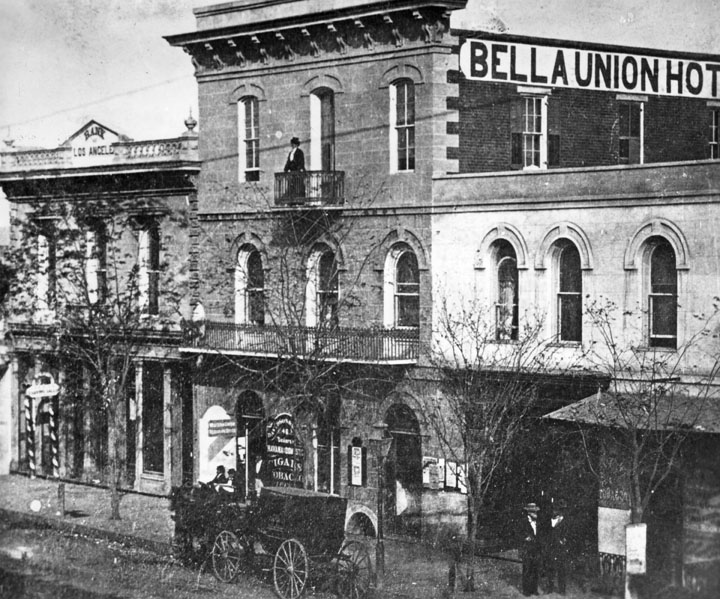 |
|
| (ca. 1867)* - The Bella Union at 314 N. Main St. later became the St. Charles Hotel. To the left is the original home of Farmers and Merchants Bank, later merged into Security Pacific Bank. Standing on the balcony is Mrs. Margarita Bandini Winston, owner of the hotel. |
Click HERE to see more in Early LA Buildings (1800s) |
* * * * * |
Federal Building and Post Office
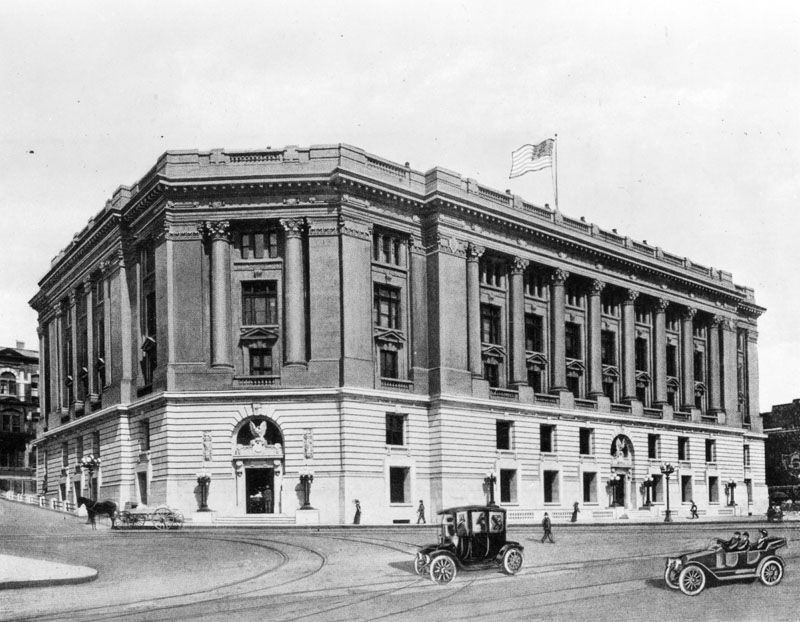 |
|
| (ca. 1910)* - Photo of a sketch showing the Los Angeles Civic Center Federal Building and Post Office, northwest corner of Temple Street and Main Street (former site of the Downey Block). |
 |
|
| (ca. 1910)* - View showing Temple Street at the junction of Spring and Main Streets. The newly constructed Federal Building and Post Office is seen at the northwest corner of Temple and North Main streets across the street from the International Bank Building. An early open car and a trolley car are seen on the street. |
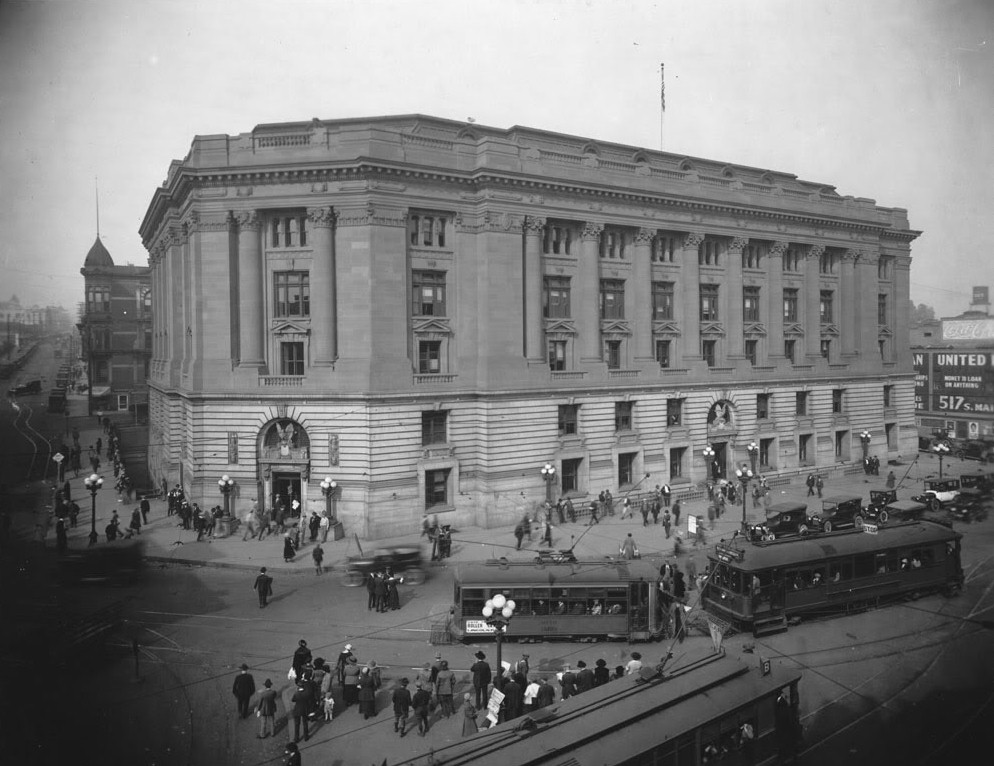 |
|
| (ca. 1920)^ - Exterior view the old Federal Building and Post Office on the corner of Temple Street and Main Street. Pedestrians can be seen walking near the base of the structure, while several early automobiles are parked at right. Three streetcars can be seen in the foreground at center. Note the beautiful streetlights surrounding the building. |
Historical Notes Constructed between 1906 and 1910, the five-story Romanesque building housed the post office, U.S. District Court, and various federal agencies, but it soon proved inadequate. |
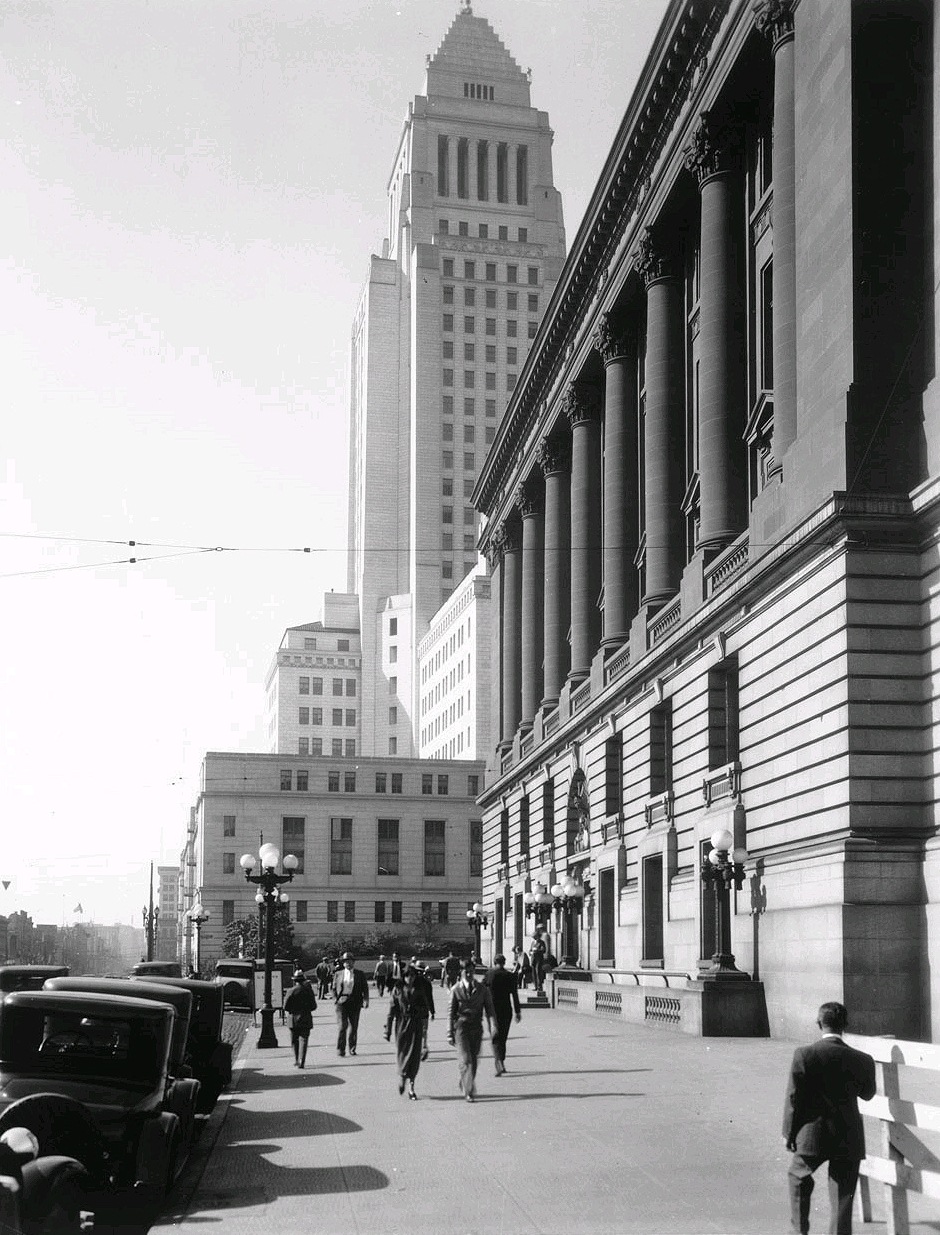 |
|
| (1931)**# - Looking south on Main Street across Temple at the old Federal Building/Post Office and City Hall. Ornate 5-lamp streetlights can be seen in front of the Federal Building (Click HERE to see more in Early Streetlights of LA). |
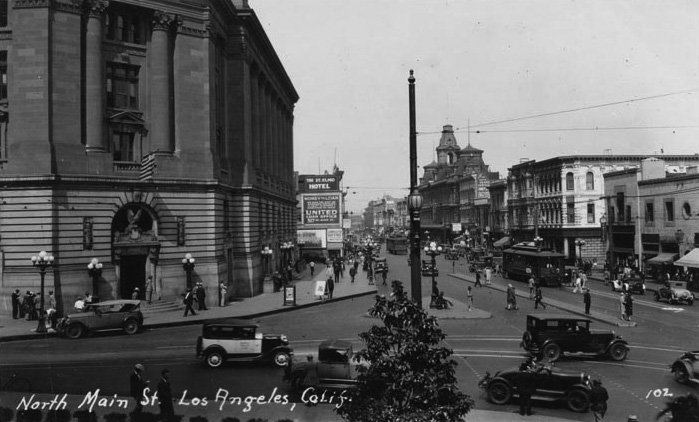 |
|
| (1932)^*# - Postcard view of North Main Street as seen from the base of Los Angeles City Hall at Temple Street. The entire 300 block of N. Main Street, from Baker Block to the Ducommun Building, can be seen here. The old Federal Building and Post Office stands on the northwest corner. |
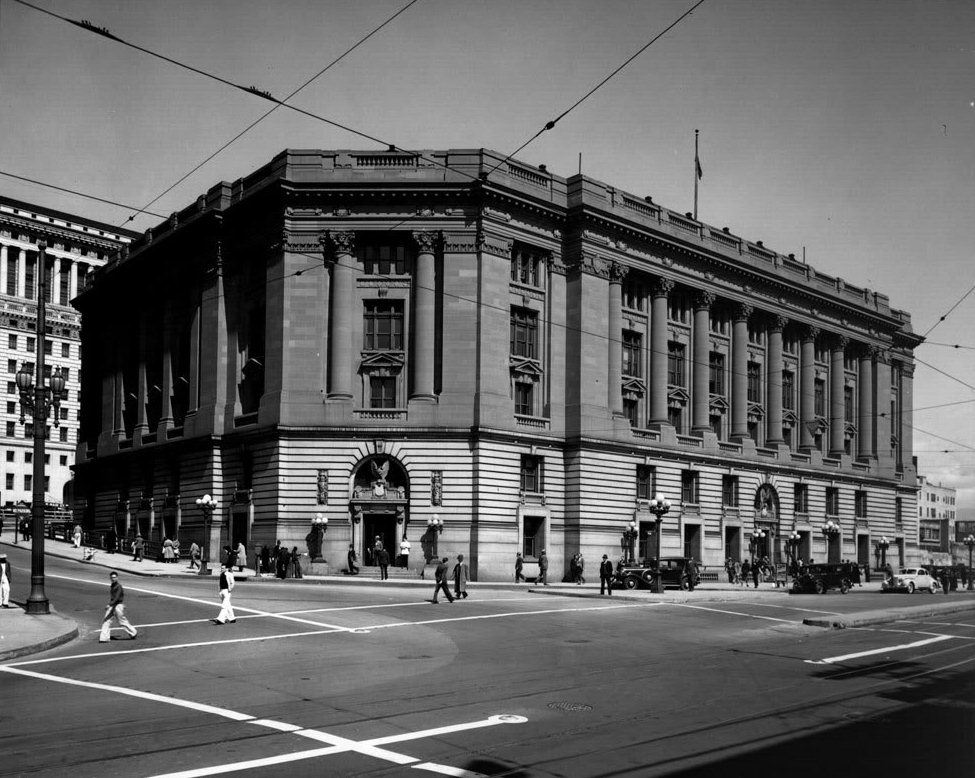 |
|
| (ca. 1930s)^ - A later view the old Federal Building and Post Office on the corner of Temple Street and Main Street. A portion of the new Hall of Justice (built 1928) can be seen at left. |
Historical Notes The population of Los Angeles grew rapidly in the early part of the twentieth century, and a larger building was needed to serve the courts and federal agencies. The Federal Building was razed in 1937 to clear the site for the existing U.S. District Courthouse. |
* * * * * |
Automobile Club of Southern California
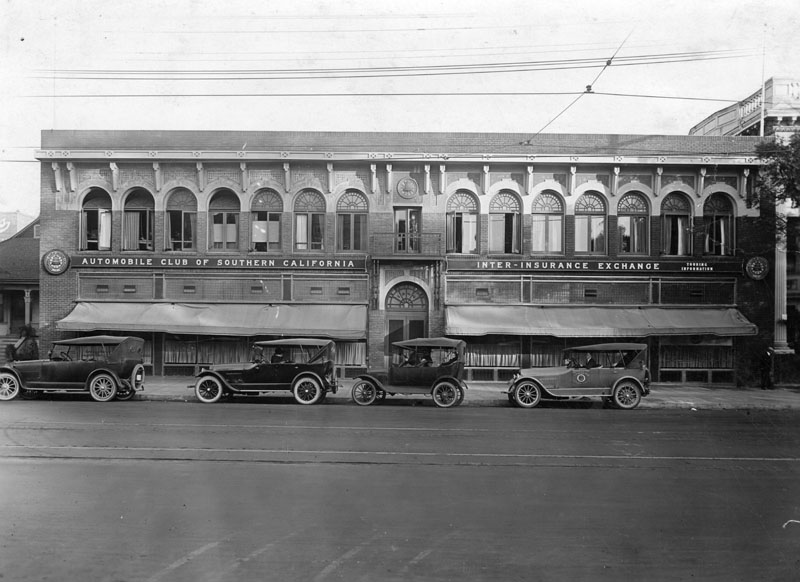 |
|
| (ca. 1920)* - Exterior view of the first location of the Automobile Club of Southern California, located at 1344 South Figueroa Street. One of the cars parked outside the entrance belongs to the Auto Club's Insurance Department. Pacific Electric train tracks are visible in the foreground. |
Historical Notes The Automobile Club of Southern California, one of the nation's first motor clubs dedicated to improving roads, proposing traffic laws, and improvement of overall driving conditions, was founded on December 13, 1900 in Los Angeles. The Auto Club was responsible for producing state road maps, as well as posting thousands of porcelain-to-steel traffic signs throughout the state to create a uniform signing system - which it continued to do until the task was taken over by the State of California in the mid-1950s.* |
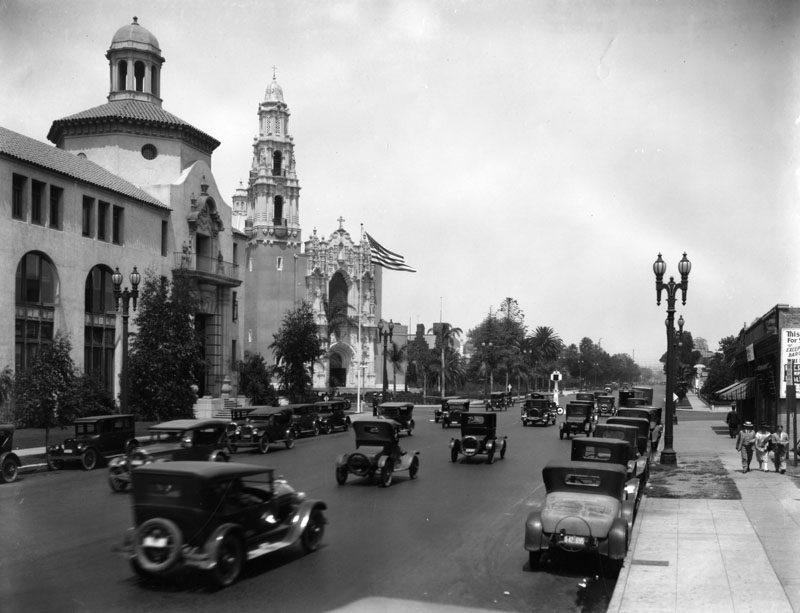 |
|
| (1926)* - Figueroa Street looking northwest toward West Adams Boulevard. On the left is the Automobile Club of Southern California and St. St. Vincent Catholic Church. |
Historical Notes The building pictured here originally served as the Auto Club's main office. It was built between 1922-1923 by architects, Sumner P. Hunt, Silas R. Burns, and Roland E. Coate in the Spanish Colonial Revival style. Today, this building serves as the Los Angeles district office, but the administrative offices are now located in Costa Mesa.* |
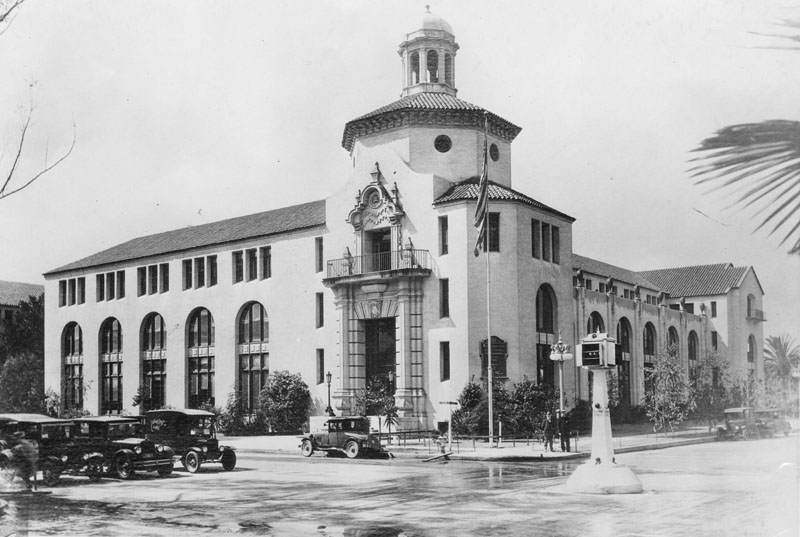 |
|
| (1930)* - Exterior view of the Automobile Club of Southern California, located at 2601 S. Figueroa St. on the southwest corner of Adams and Figueroa. Three cars can be seen waiting for the traffic signal (located in the center of the intersection) to change. |
Historical Notes The Automobile Club of Southern California, one of the nation's first motor clubs dedicated to improving roads, proposing traffic laws, and improvement of overall driving conditions, was founded on December 13, 1900 in Los Angeles. The Auto Club was responsible for producing state road maps, as well as posting thousands of porcelain-to-steel traffic signs throughout the state to create a uniform signing system - which it continued to do until the task was taken over by the State of California in the mid-1950s.* The Automobile Club Building was designated LA Historic-Cultural Monument No. 72 (Click HERE to see complete listing). |
* * * * * |
USC
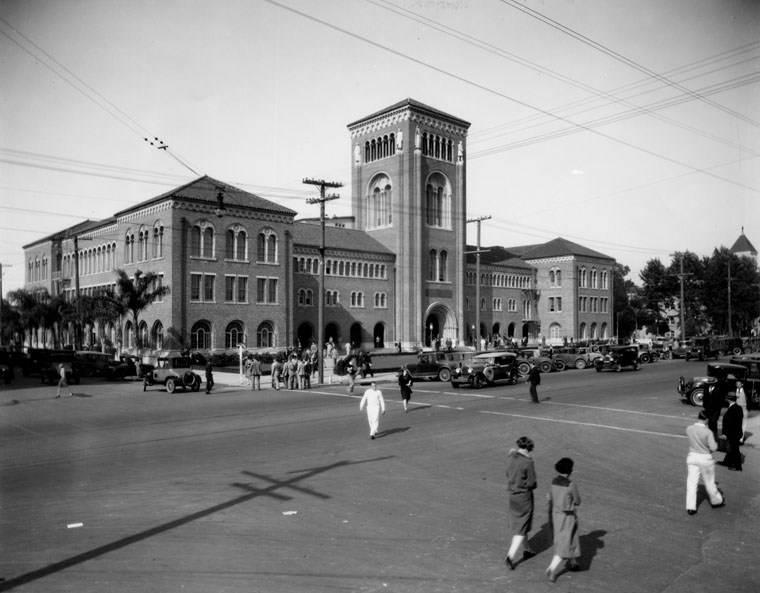 |
|
| (1920s)* - Exterior view of Bovard Hall, U.S.C.'s Administration building. Note the arch over the entrance and windows, the architectural designs on the building and carved statues on the tower. Students may be seen coming and going in front of the hall. |
Historical Notes George Finley Bovard Administration Building was dedicated the week of June 19, 1921. John Parkinson, architect. The building cost $620,000, the organ in the auditorium cost $35,000.*^# |
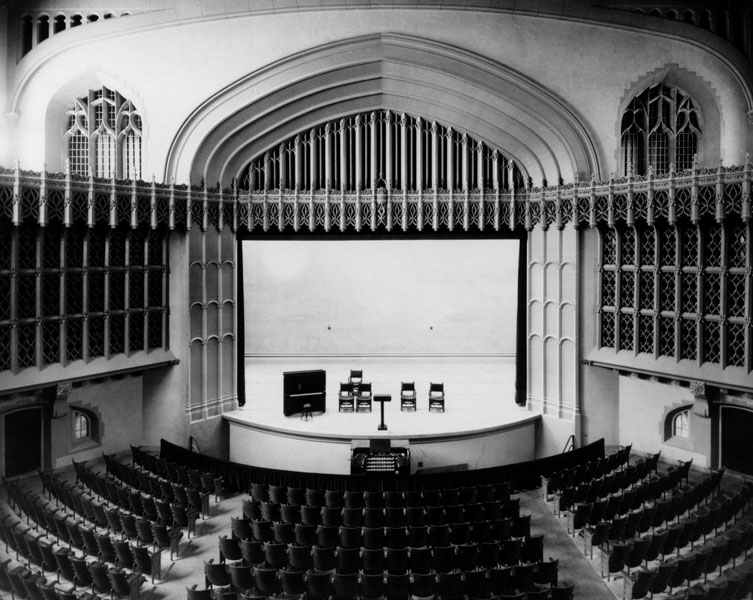 |
|
| (ca. 1920s)* - Interior view of Bovard Auditorium at U.S.C. Building was built in 1920-21, in neo-gothic elements of interior contrast with northern Italian Romanesque Revival style, designed by architects John and Donald Parkinson. |
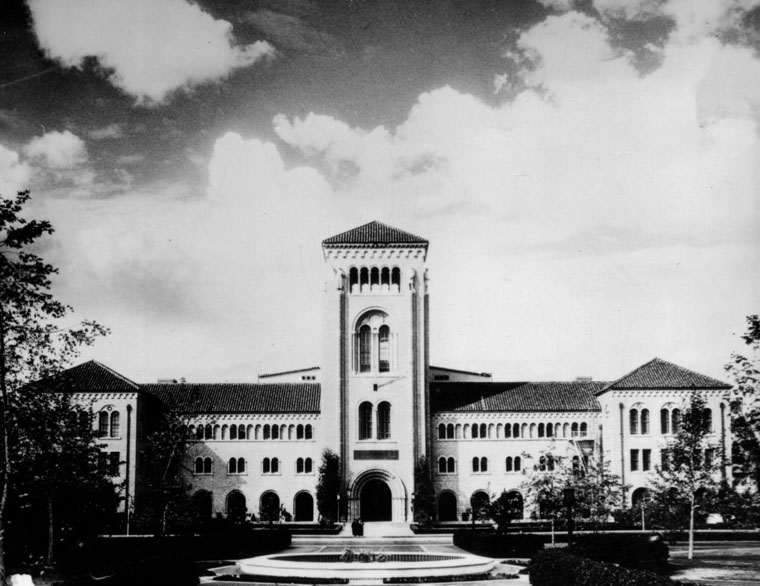 |
|
| (ca. 1920s)* - Exterior view of the front entrance of Bovard Hall at U.S.C. Building contains Bovard Auditorium, seating 2000 persons, offices of administration and various headquarters of the Trojan's 24 schools and colleges. |
Click HERE to see more in Early Views of U.S.C. |
* * * * * |
Lanfranco Building
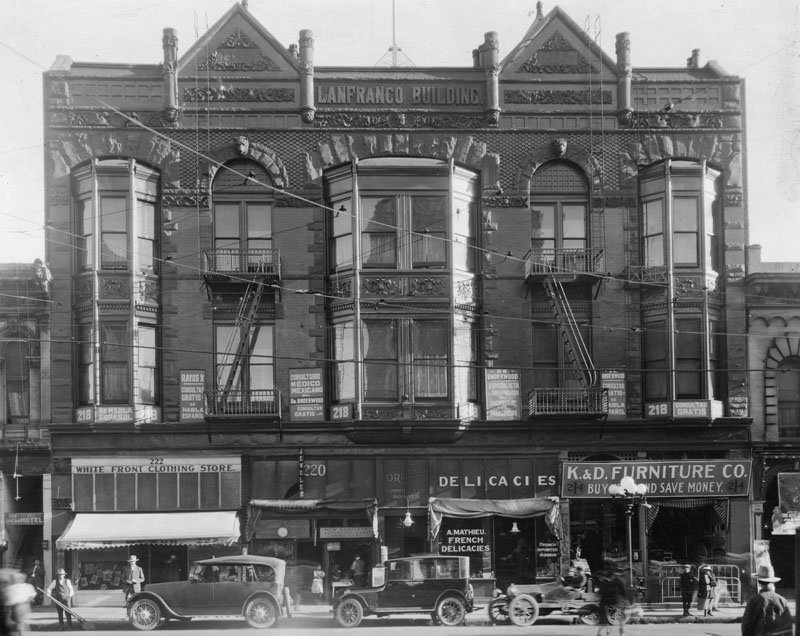 |
|
| (ca. 1920)* - Exterior view of the Lanfranco Building circa 1920. Stores include White Front Clothing Store, Hatchen Jewelry, New Sanitary Hat and Suit Cleaners, A. Mathieu French Delicacies, and K. & D. Furniture Co. On the second floor are the offices of Dr. Underwood, whose signs are totally in Spanish. |
* * * * * |
Finkle Building
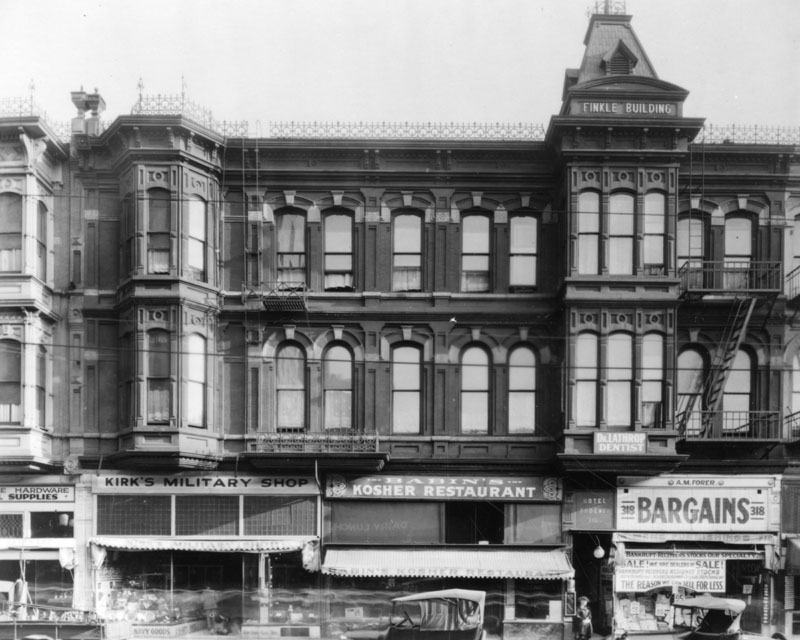 |
|
| (ca. 1920)* - Finkle Building, 316 South Spring Street, Los Angeles, California about the year 1920. Stores include a hardware and supply store, Kirk's Military Shop, and a Kosher restaurant. |
* * * * * |
Hollenbeck Hotel
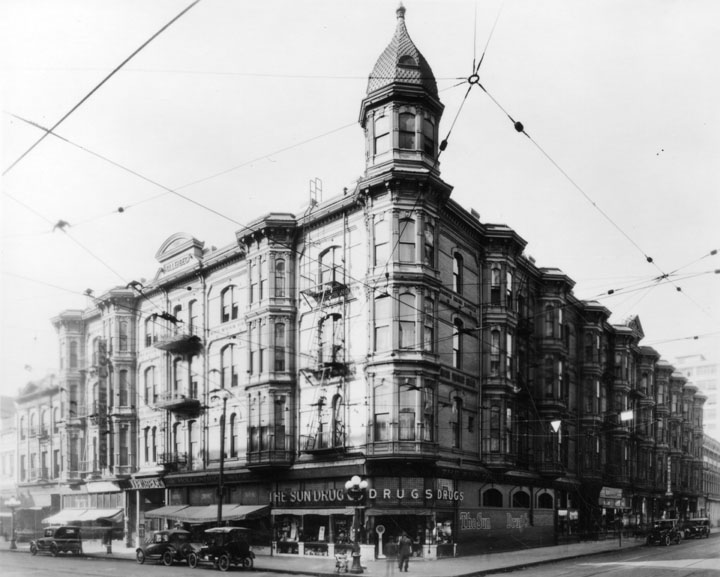 |
|
| (ca. 1920)* - The Hollenbeck is seen standing regally on the southwest corner of Spring and Second behind some trolley lines crossing in front and extending down the streets. Cars can be seen in the street and some people. A drug store now occupies the street level corner of the building. Hotel architect, Robert B. Young. |
* * * * * |
Temperance Temple
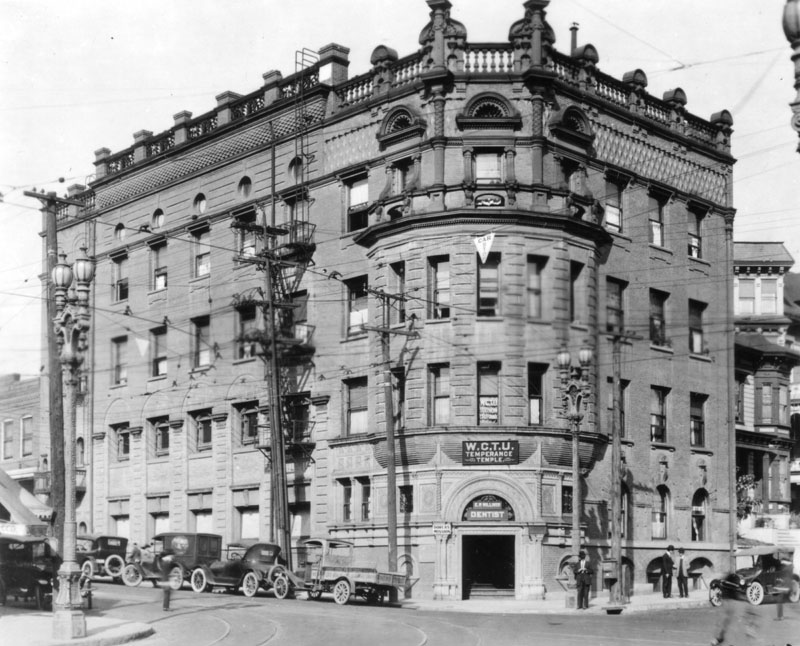 |
|
| (ca. 1920)* - View of the Temperance Temple of the Women's Christian Temperance Union (WCTU), located at 301 N. Broadway at Temple Street. |
Historical Notes The Women's Christian Temperance Union (WCTU) stands for the complete abstinence from alcohol, tobacco, and all harmful drugs and protection of the home. As the membership of the WCTU grew throughout the U.S, a call went out from May Gould, a resident of Los Angeles, to Frances Willard to organize a local group in Southern California. On September 20 and 21, 1883, the first State Convention was called and the WCTU of Southern California was organized at the First Presbyterian Church, 2nd and Fort (now Broadway) Streets, Los Angeles. This temple was dedicated in 1889 after money had been donated for its construction in 1886. The Frances E. Willard Home For Girls was housed on the 4th floor from its inception in 1919 until 1933, when the Long Beach Earthquake severely damaged the building. The County of Los Angeles took the site by eminent domain and constructed a power plant where the venerable Temperance Temple once stood in 1947. When the Temple was completely razed in 1950, its corner stone was presented to the WCTU.* |
* * * * * |
Garnier Block
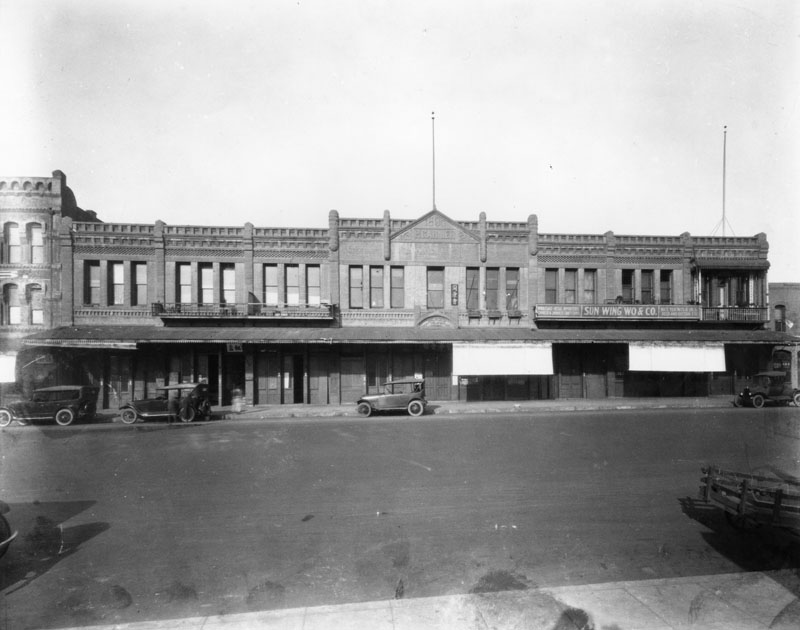 |
|
| (ca. 1920)* - P. Garnier is chiseled in the stonework of the Garnier Block at 415 N. Los Angeles Street. The building was used by Chinese merchants at the time of this photograph. |
Historical Notes The Garnier Building was built in 1890, by Philippe Garnier, a French settler who arrived in Los Angeles in 1859 at the age of eighteen. Philippe Garnier and his brothers, Eugene, Abel, and Camille, owned the 4,400 acre Rancho Los Encinos in the San Fernando Valley where they raised sheep. Despite losing a considerable sum of money in the wool market crash in 1872, the Garniers were financially well off and remained influential in local commerce. Philippe Garnier served as a bank director on the Board of the Farmers and Merchants Bank from 1879 to 1891 and is believed to have constructed several other buildings in Los Angeles.^#^^ |
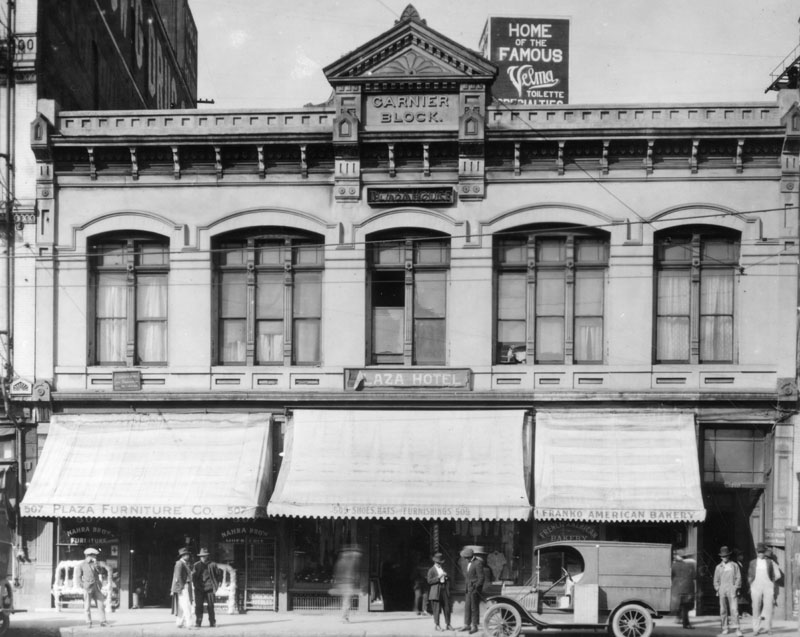 |
|
| (ca. 1920)* - Garnier Block, formerly known as the Plaza House had shops on the ground level and the Plaza Hotel on the second floor. A short distance to the right (out of view) sits the Old Plaza Firehouse. |
Historical Notes The Garnier Building was designed primarily for Chinese commercial tenants. It is the oldest building in Los Angeles exclusively and continuously inhabited by Chinese immigrants from the time of its construction in 1890 until the State took it over in 1953. The building was the headquarters of major Chinese American organizations and housed businesses, churches, and schools. It was an important structure in the original Los Angeles Chinatown.^#^^ |
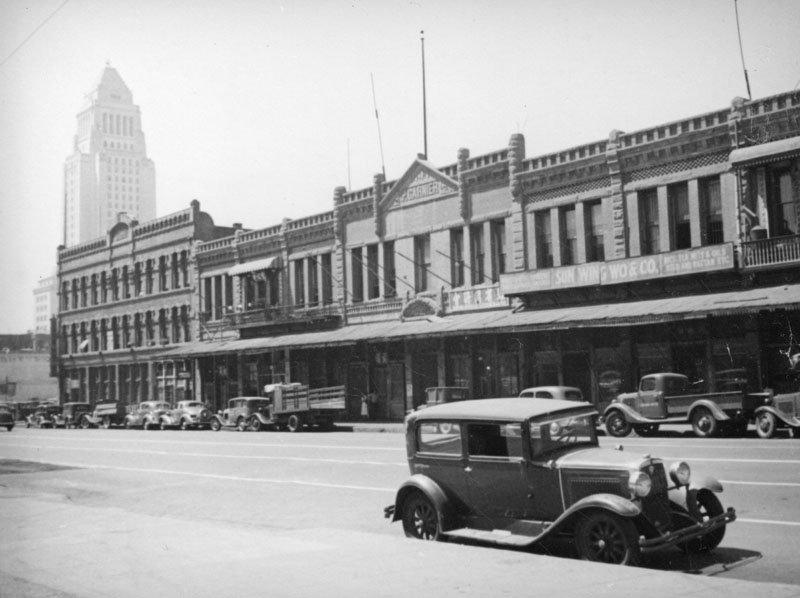 |
|
| (ca. 1930s)* - View of Garnier Block with City Hall in the background. Photo by Herman Schultheis. |
Historical Notes The construction of the #101 Freeway (Hollywood Freeway) took away everything to the left of (south of) the Garnier Building, an area referred to as the Jennette Block. The Old Plaza Firehouse is to the right of the Garnier Building.* |
Click HERE to see more Early Views of the LA Plaza |
* * * * * |
Jennette Block
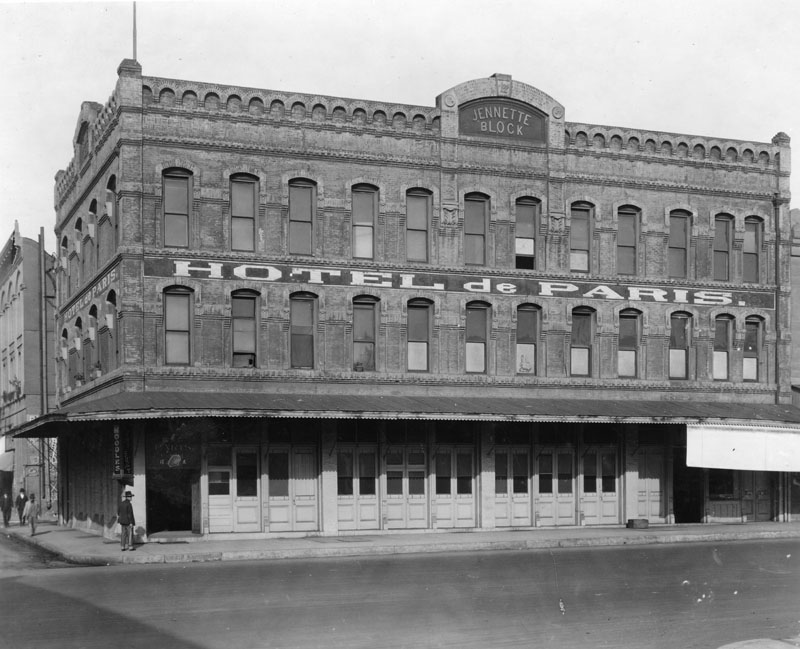 |
|
| (ca. 1920)* - Exterior view of the Jennette Block on the northwest corner of Los Angeles and Arcadia Streets, with the Hotel del Paris on the second floor. |
Historical Notes The Jennette Block sat adjacent (south of) the Garnier Block. It, along with part of the Garnier Block, was demolished to make room for the #101 Freeway.* The Jennette Block was built circa 1888 and the Garnier Building in 1890.* |
* * * * * |
Temple Block
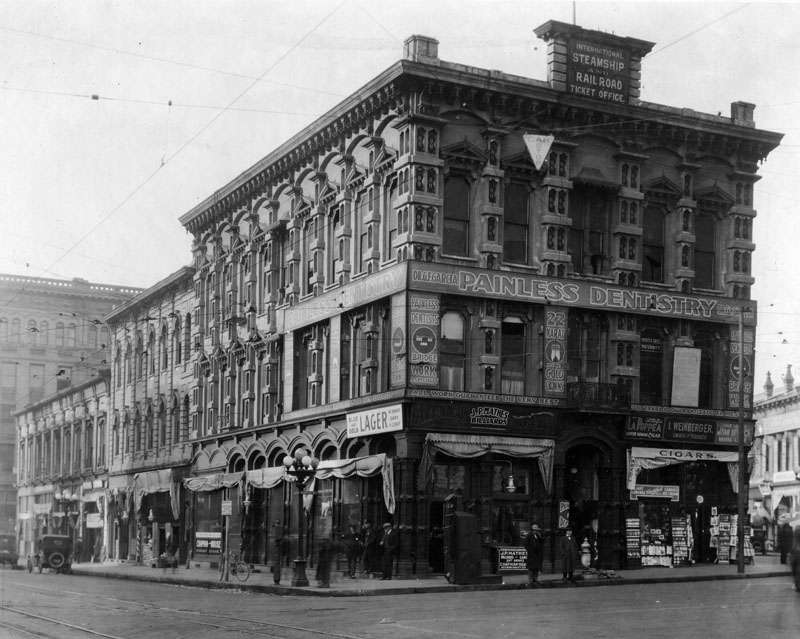 |
|
| (ca. 1920)* - Temple Block, junction of Main, Spring and Temple streets; Spring Street at left, Main Street at right, Temple Street in foreground. Photograph shows a large commercial building with sign on top reading: "INTERNATIONAL STEAMSHIP AND RENTAL TICKET OFFICE" and another sign on the middle facing reading: "PAINLESS DENTISTRY". |
Historical Notes In 1827, Jonathan Temple moved to the Pueblo de Los Angeles, where he opened the pueblo's first store, a business he operated for almost thirty years. Temple was also one of Los Angeles’ first developers, constructing such landmarks as the original Temple Block and the Market House, which later served as city and county administrative headquarters, contained the county courthouse, and featured the first true theater in southern California. He also served as the first alcalde (or mayor) of Los Angeles after capture of the pueblo by the United States during the Mexican-American War and served on the first American-period common (city) council. Temple Street was developed by Johnathan Temple as a modest one-block dirt lane in the 1850s.^* Temple Block was razed to make room for the current City Hall, built in 1928. |
* * * * * |
Sunbeam Theatre (Highland Park)
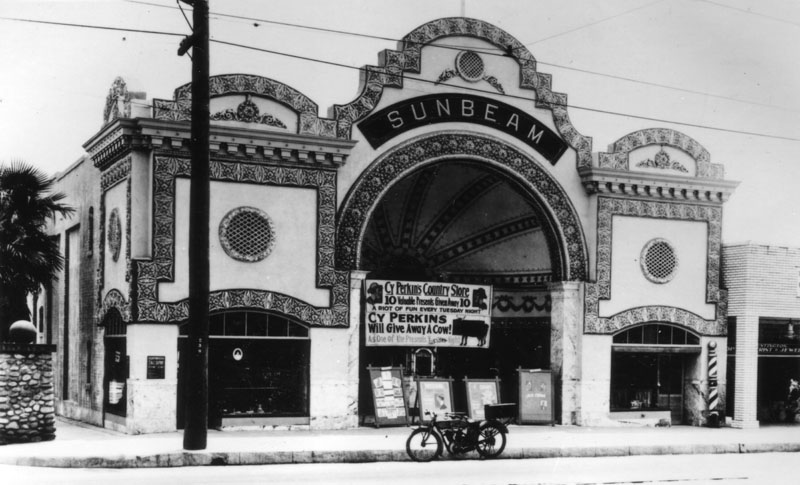 |
|
| (ca. 1920)* - Exterior view of the Sunbeam Theater in Highland Park, with a sign advertising a promotion by Cy Perkins Country Store. The theater, located at 5722 N. Figueroa Street (previously Pasadena Avenue), was designed by A. Lawrence Valk. |
Historical Notes The Sunbeam Theatre was a 1296 seat theater built in 1914. It was purchased by the owners of the Highland Park Theater and closed to remove competition. After that it was re-purposed for a variety of businesses. In the late 1980s, part of it was utilized by the theater group Outback Theater. The space is still occasionally used for events.***^ |
* * * * * |
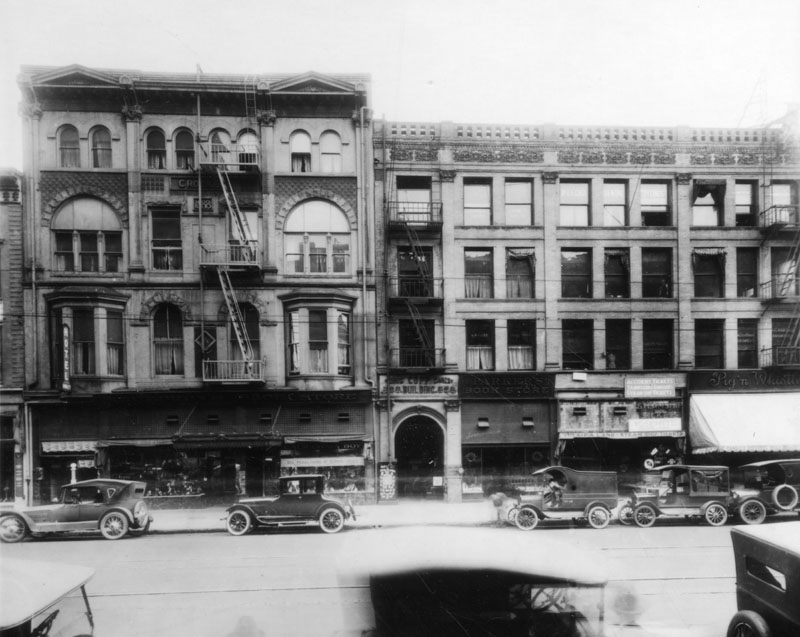 |
|
| (ca. 1920)* - East side of Broadway between 2nd and 3rd Streets around 1920. On the left, Crocker Building, 212 S. Broadway; on the right, Copp Building, 218 S. Broadway. A number of automobiles are parked along the street in front of the various shops and stores. |
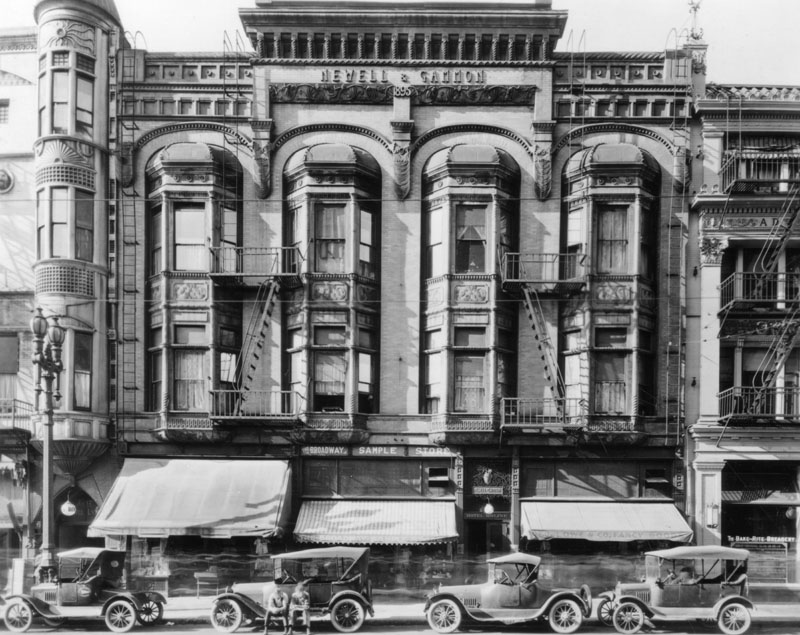 |
|
| (ca. 1920)* - Newell and Gammon Building, 131 South Broadway. Two men are sitting on a car's runner board. |
* * * * * |
Toonerville Trolley Sandwich Shop
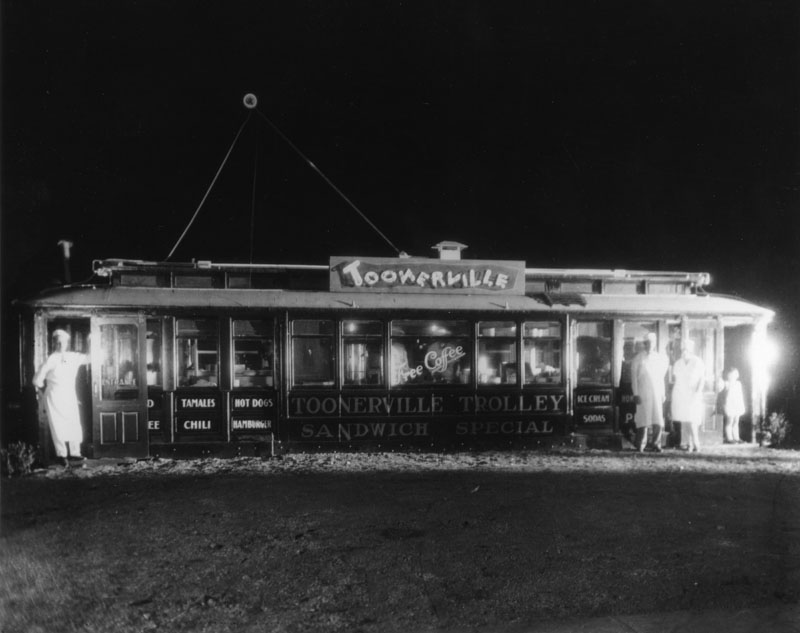 |
|
| (1920)* - View of the Toonerville Trolley sandwich shop located at 1635 W. Manchester Avenue. Sign reads: 'Sandwich Special' and 'Free Coffee' |
Historical Notes In the 1920s, as the automobile was becoming the default way to get around Los Angeles, buildings and structures in the area became more unique, often resembling the merchandise or services they hawked. These “hey-you-can’t miss-me!” buildings (referred to as Novelty or Programmatic Architecture) were made to pull automobile drivers right off the road. Click HERE to see more examples of Programmatic Architecture. |
* * * * * |
Wrigley Residence (Catalina Island)
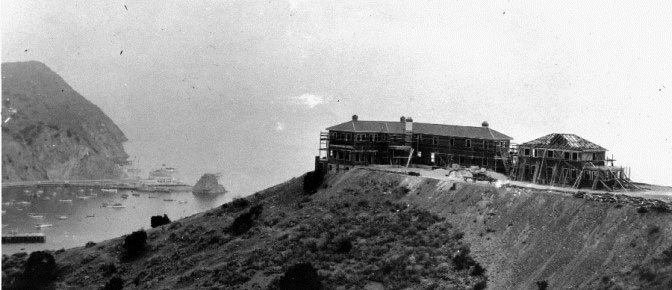 |
|
| (1919)**#^ – View of the Wrigley residence under construction on top of Mt. Ada, overlooking Avalon Bay. In the distance is Sugarloaf Point and a new casino located on the spot where “Big" Sugarloaf once stood. |
Historical Notes First built as the vacation home of William Wrigley Jr., Mt. Ada was constructed in 1919 and finished in 1922. Wrigley reportedly chose this particular location for its unsurpassed views of Avalon Bay with magnificent surroundings and because it received the first sunlight of the morning and the last sunlight of the late evening.**#^ |
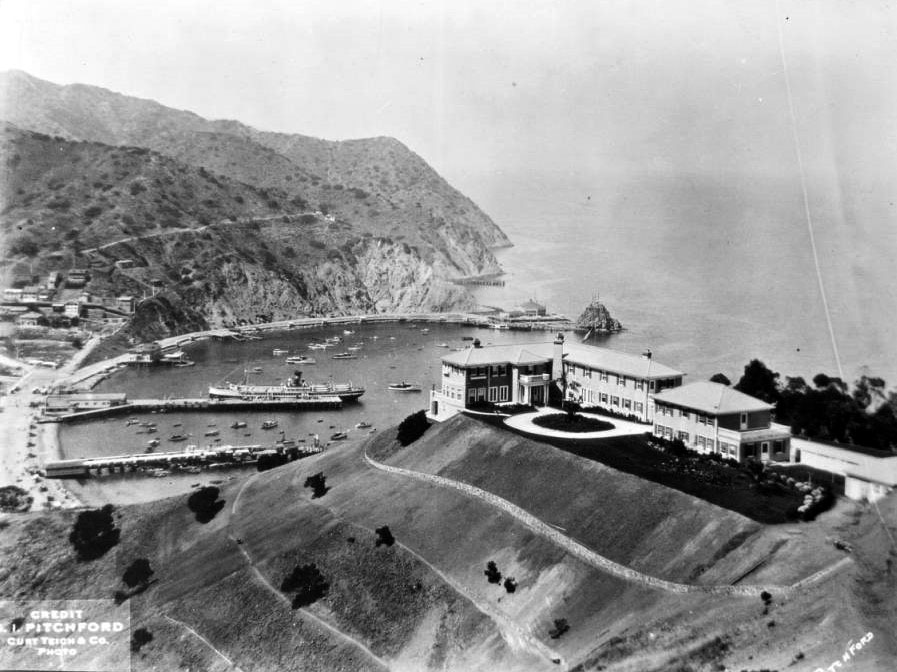 |
|
| (ca. 1922)^ - Birdseye view of Avalon Bay with the William Wrigley house in the foreground. The house can be seen on a steep hill in the foreground at right and is a large, two-story building with dark grass all around. The hillside at left is sparsely covered with small, thick trees. The harbor can be seen in the background at left. A large steamship can be seen at a dock, while many smaller vessels are moored in the harbor. “Little” Sugarloaf rock can be seen in the background at center next to Avalon’s first Casino, right where “Big” Sugarloaf rock once stood. |
Historical Notes The Wrigley home was designed and built by David M. Renton, general manager of the Santa Catalina Island Company at the time. Renton, who was influential in the early development of Catalina Island, also managed construction of the Catalina Casino Ballroom and was known for the development of Craftsman-style homes in Pasadena, among many other local projects.**#^ |
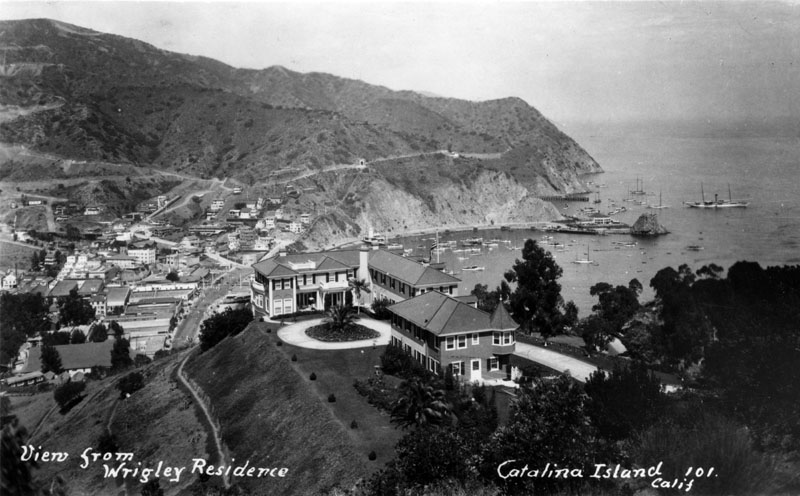 |
|
| (1920s)* - View of William Wrigley's beautiful two-story, L-shaped home resting atop a grassy hill, overlooking Avalon and beyond. Small houses as well as various tourist-oriented businesses, office buildings and several larger apartment complexes are nestled in the hills. The first Catalina Casino, Sugarloaf Casino, and numerous small boats are visible at the edge of the bay on the right, surrounded by the sea on three sides. |
Historical Notes The home stood 350 feet above the ocean and provided expansive views of Avalon Bay, the town of Avalon itself, and the mainland off in the distance. The Wrigleys reportedly made two annual visits to Catalina Island in the summer and winter, with each visit lasting between four and ten weeks. Many distinguished guests of that time period enjoying visiting with the Wrigley family, including Herbert Hoover, Calvin Coolidge, and the Prince of Wales.**#^ |
.jpg) |
|
| (n.d.)* - View showing the stairway leadig to William Wrigley's house on top of Mt. Ada (named after Mrs. Wrigley). The sprawling residence boasts numerous windows, each facing magnificent views of the island, several dormers, a number of balconies, and lush landscape. |
Historical Notes After Mr. Wrigley’s death in 1932, Mrs. Wrigley continued to visit their treasured home regularly until 1947 when she suffered a stroke. She died in 1958 and the property was then managed by the Santa Catalina Island Company and occasionally used for meetings and events by local organizations. In 1978, the property was donated to the University of Southern California and was used by the University as a conference center for the next several years.**#^ |
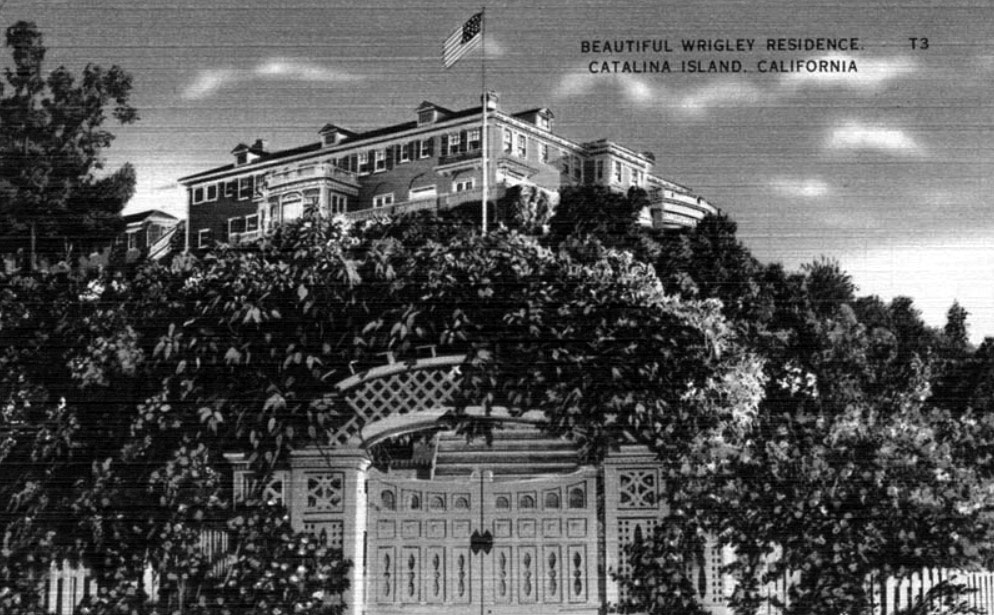 |
|
| (n.d.)**#^ - Postcard view of the Wrigley Residence on Mt. Ada, Catalina. Built between 1922-24 and designed by David M. Renton. |
Historical Notes In 1985, the home was leased to its present operators and became The Inn on Mt. Ada. The residence was carefully restored in an effort to bring the property up to current building standards and to provide the amenities of a luxurious inn. Many celebrities have stayed at the Inn including Barbara Streisand, Molly Ringwald, and Billy Zane. The most requested suite is the two-room Grand Suite which includes a private terrace. Mt. Ada is open to the public every December for the Catalina Island Museum’s Annual Open House. The home was placed on the National Register of Historic Places in 1985.**#^ |
Click HERE to see more in Early Views of Catalina |
* * * * * |
Please Support Our CauseWater and Power Associates, Inc. is a non-profit, public service organization dedicated to preserving historical records and photos. We are of the belief that this information should be made available to everyone—for free, without restriction, without limitation and without advertisements. Your generosity allows us to continue to disseminate knowledge of the rich and diverse multicultural history of the greater Los Angeles area; to serve as a resource of historical information; and to assist in the preservation of the city's historic records.
|
For more Historical Los Angeles Views click one of the following:
For Other Historical Views click one of the following:
See Our Newest Sections:
To see how Water and Electricity shaped the history of Los Angeles click one of the following:
Water:
Power:
* * * * * |
References and Credits
* LA Public Library Image Archive
**DWP - LA Public Library Image Archive
*^Oviatt Library Digital Archives
^^ Daily Breeze: Los Angeles Motordome
+^Flickr.com: City Project: El Pueblo de Los Angeles
*# LA Times: Hollywood Castles and Curious Cures
+#Urban Diachrony: East side of North Main Street south of Arcadia Street
#+LA Architecure Tours: Carroll Avenue
#^ KCET: Southwest Museum of the American Indian; Lost Train Depots of LA
^^*Early Downtown Los Angeles - Cory Stargel, Sarah Stargel; Los Angeles Trust and Savings Bank
*^#Publicartinla.com - Bovard Hall
#^*Huntington Digital Library Archive
^*#California State Library Image Archive
^##Library of Congress: Los Angeles Herald
***Los Angeles Historic - Cultural Monuments Listing
*^*California Historical Landmarks Listing (Los Angeles)
*#^The Department Store Museum: J. W. Robinson's
^#*Historic Hotels of Los Angeles and Hollywood (USC - California Historic Society): St. Elmo Hotel; Tally's Broadway Theatre
*^^Nuestra Señora la Reina de los Ángeles: losangelespast.com
**#Noirish Los Angeles - forum.skyscraperpage.com; Engine Company No. 23; Westmoore Hotel; J.W. Robinson Store; Bible Institute of Los Angeles
+#+Southern California Arcthitectural History
+++Facebook.com – Los Angeles Heritage Railroad Museum
++^Historic Los Angeles Theaters: Clune's Broadway Theatre/Cameo Theatre
**^Historical LA Theatres: The Philharmonic Auditorium; Downtown Theatres; Mason Theatre; Trinity Auditorium; Quinn's Superba; Liberty Theatre; Palace Theatre
***^Highland Park - amoeba.com
*^^^San Fernando Valley Historical Society/Facebook.com: Westinghouse Electric Range
^^^*Cinema Treasures: Quinn's Superba Theatre; LIberty Theatre; Cameo Theatre
^^^+Los Angeles Housing Partnership
^+^+The Daily Mirror: Bryson Apartments
^***West Adams Avenues Blogspot
^^**Flickr.com: Bonfilio Residence - Floyd B. Bariscale; Million Dollar Theater - Ryan Vaarsi
*^*^Big Orange Landmarks: Los Angeles Athletic Club
*^*#Huntington Digital Library Archive
*^^#The Barlow Sanitorium - barlowgenealogy.com
^#^^El Pueblo de Los Angeles Historical Monuments; Garnier Building
*#*^Openlibrary.or: Westinghouse Automatic Electric Range
*^#*Blogdowntown.com: Merritt Building
**##History of the Rosslyn Hotel
*#**B. H. Dyas Co.
^##*Los Angeles Fire Department Historical Archive
*##^Flickr.com: Michael Ryerson
^*^#Facebook.com - Bizarre Los Angeles
#^*^Facebook.com: Photos of Los Angeles
#+++Yahoo.com: Beverly Hills Hotel
^^^#California Hospital Medical Center Foundation
#^**Flickr.com: Metro Library and Archive
#^^#Beforeusc.com: Church of Christ, Scientist
###^Pomona Public Library Poscard Collection
^*^*^Denver Public Library Image Archive
^***^Facebook.com: Garden of Allah Novels
**^**Los Angeles City Historical Society
^* Wikipedia: Leonis Adobe; Occidental College; Beverly Hills; Beverly Hills Hotel; Huntington Hotel; Bank of Italy; Van de Kamp's Holland Dutch Bakeries; Rose Bowl Stadium; Los Angeles Memorial Coliseum; Farmers and Merchants Bank of Los Angeles; Los Angeles Biltmore Hotel; Jonathan Club; Los Angeles Plaza Historic District; St. Vincent Church; The Benevolent and Protective Order of Elks; Park Plaza Hotel; YMCA; San Pedro; Venice; Subway Terminal Building; St. Vincent Hospital; Los Angeles Herald-Examiner; Cahuenga Branch Library; Foy House; Frederick Hastings Rindge House; Los Angeles High School; MGM; Breed Street Shul; Natural History Museum of Los Angeles County; Jonathan Temple; Highland Park Masonic Temple; Egyptian Theatre; Phineas Banning; Eagle Rock; Hollywood Masonic Temple; Sawtelle Veterans Home; Downtown, Los Angeles; Robinson's Department Store; International Savings & Exchange Bank Building; Quinn's Superba Theatre; Million Dollar Theater; Los Angeles Athletic Club; Harris Newmark; Fire Station No. 23; Church of the Open Door; Lyman Stewart; Biola University; Paramount Studios; Fremont Hotel; Barlow Respiratory Hospital; Shrine Auditorium; Second Church of Christ, Scientist 2008/1928; Hotel Rosslyn Annex; Plaza Substation
< Back
Menu
- Home
- Mission
- Museum
- Major Efforts
- Recent Newsletters
- Historical Op Ed Pieces
- Board Officers and Directors
- Mulholland/McCarthy Service Awards
- Positions on Owens Valley and the City of Los Angeles Issues
- Legislative Positions on
Water Issues
- Legislative Positions on
Energy Issues
- Membership
- Contact Us
- Search Index